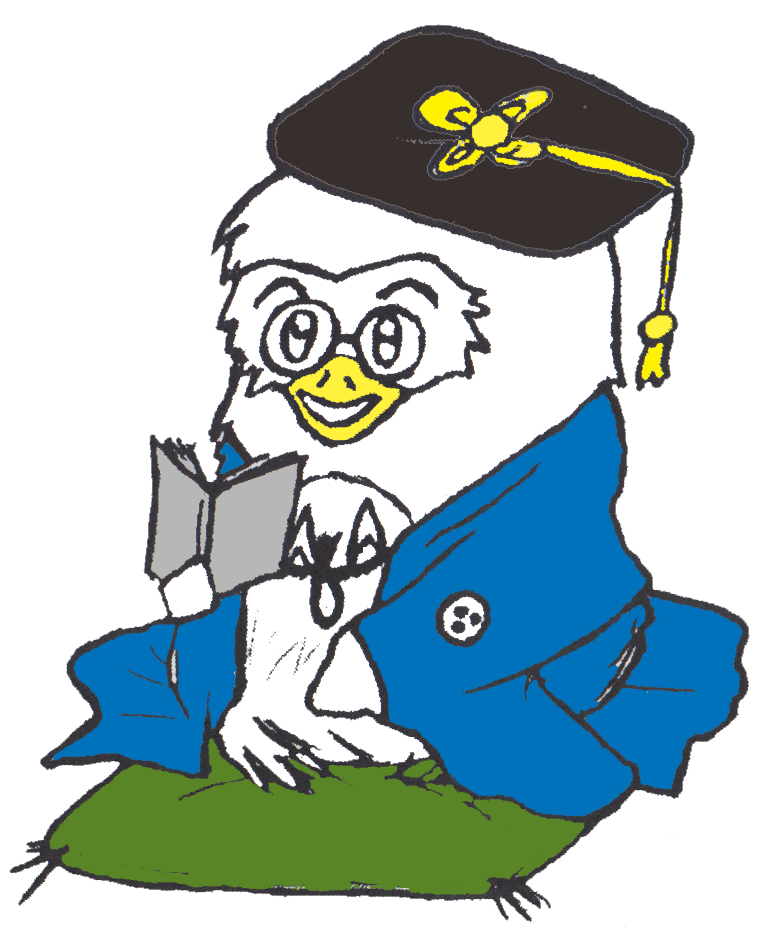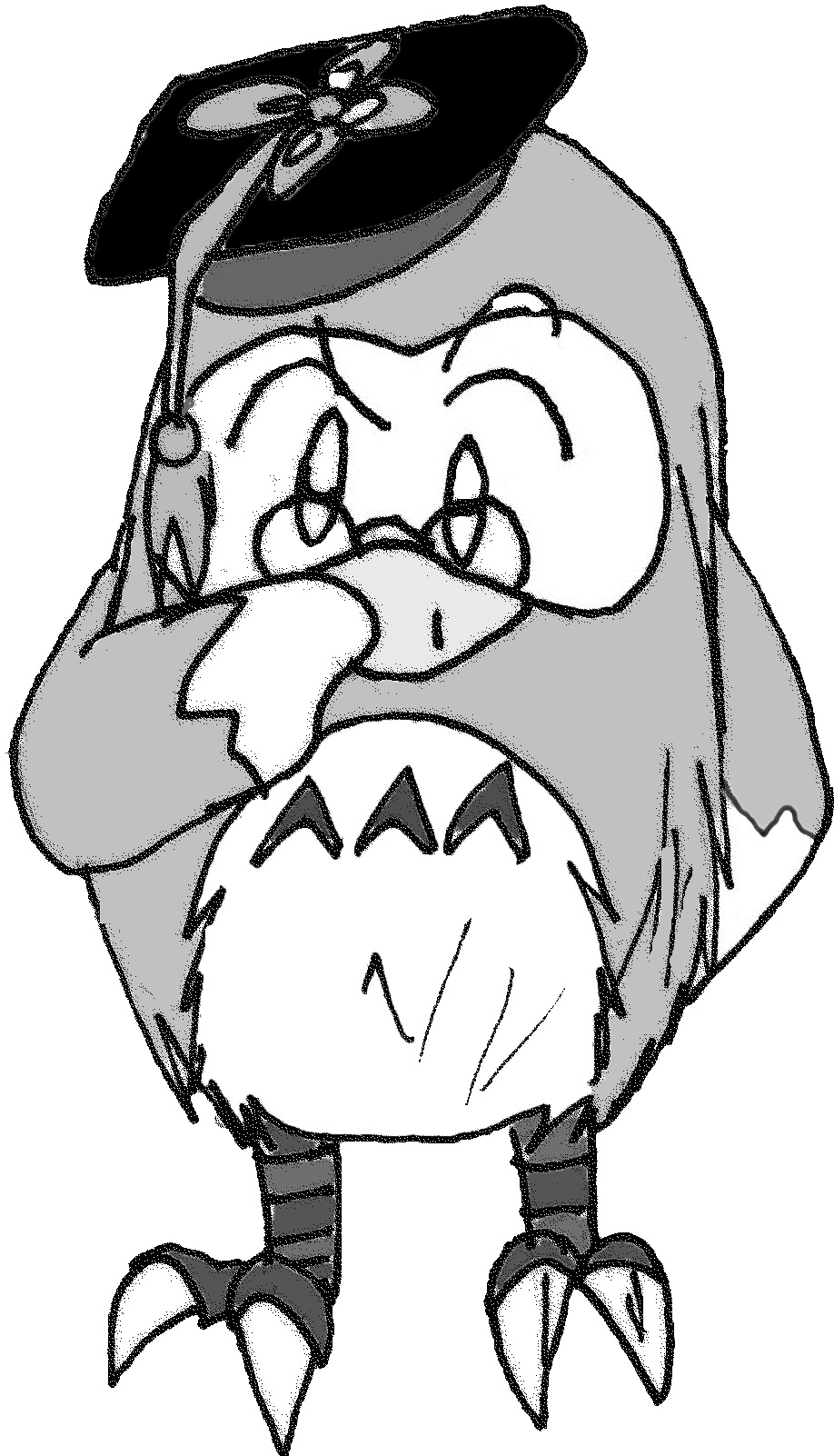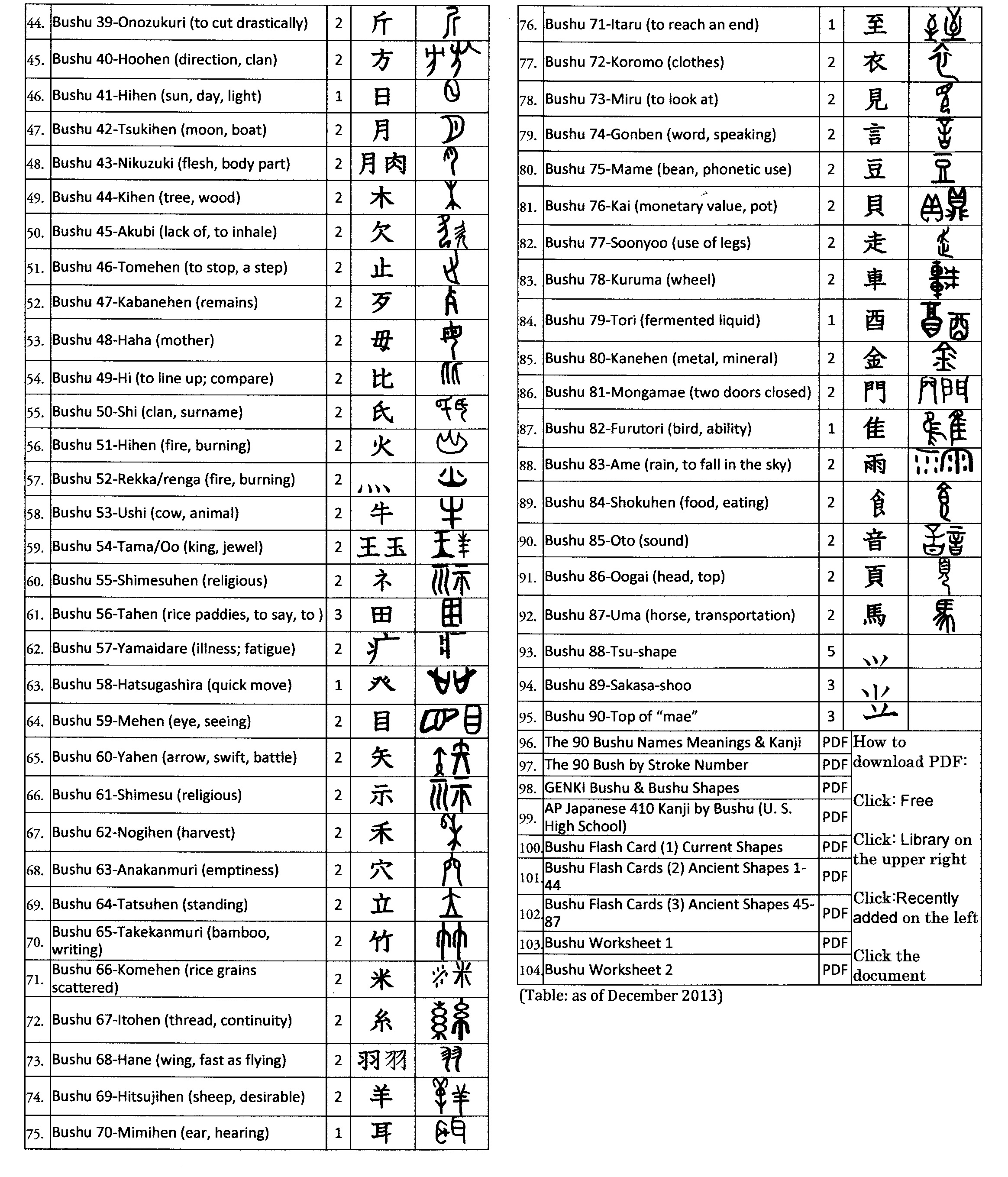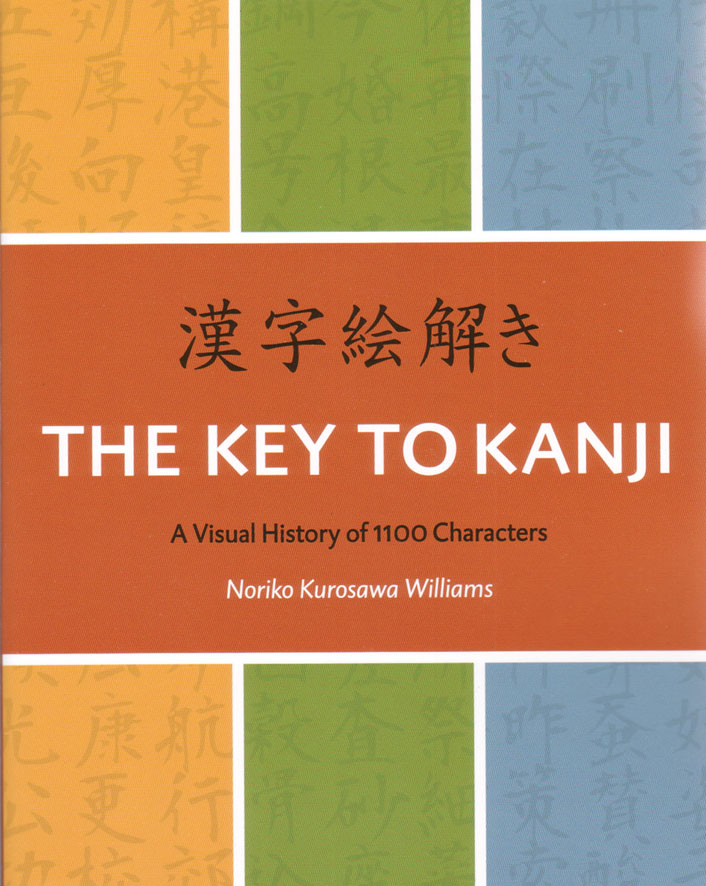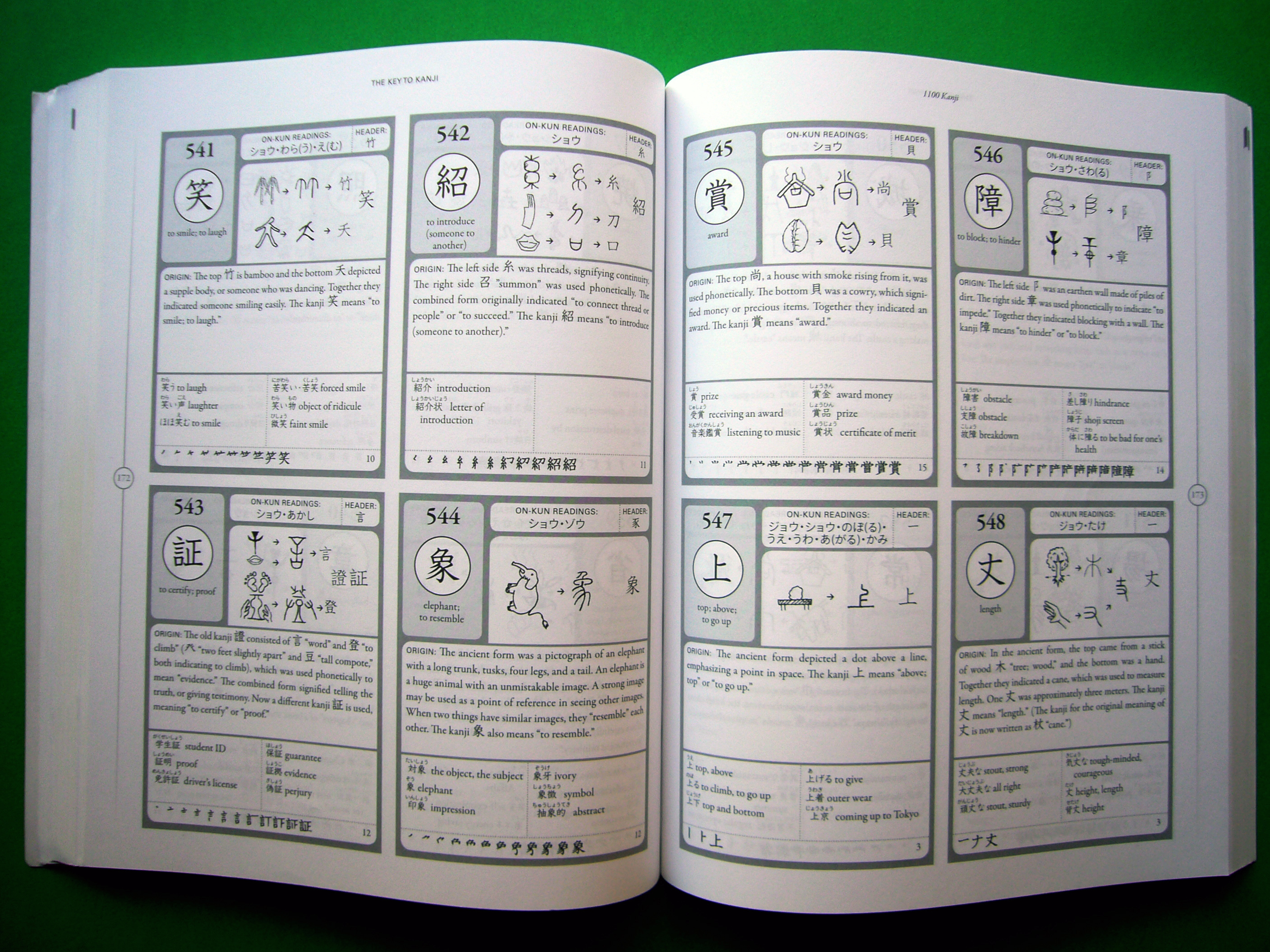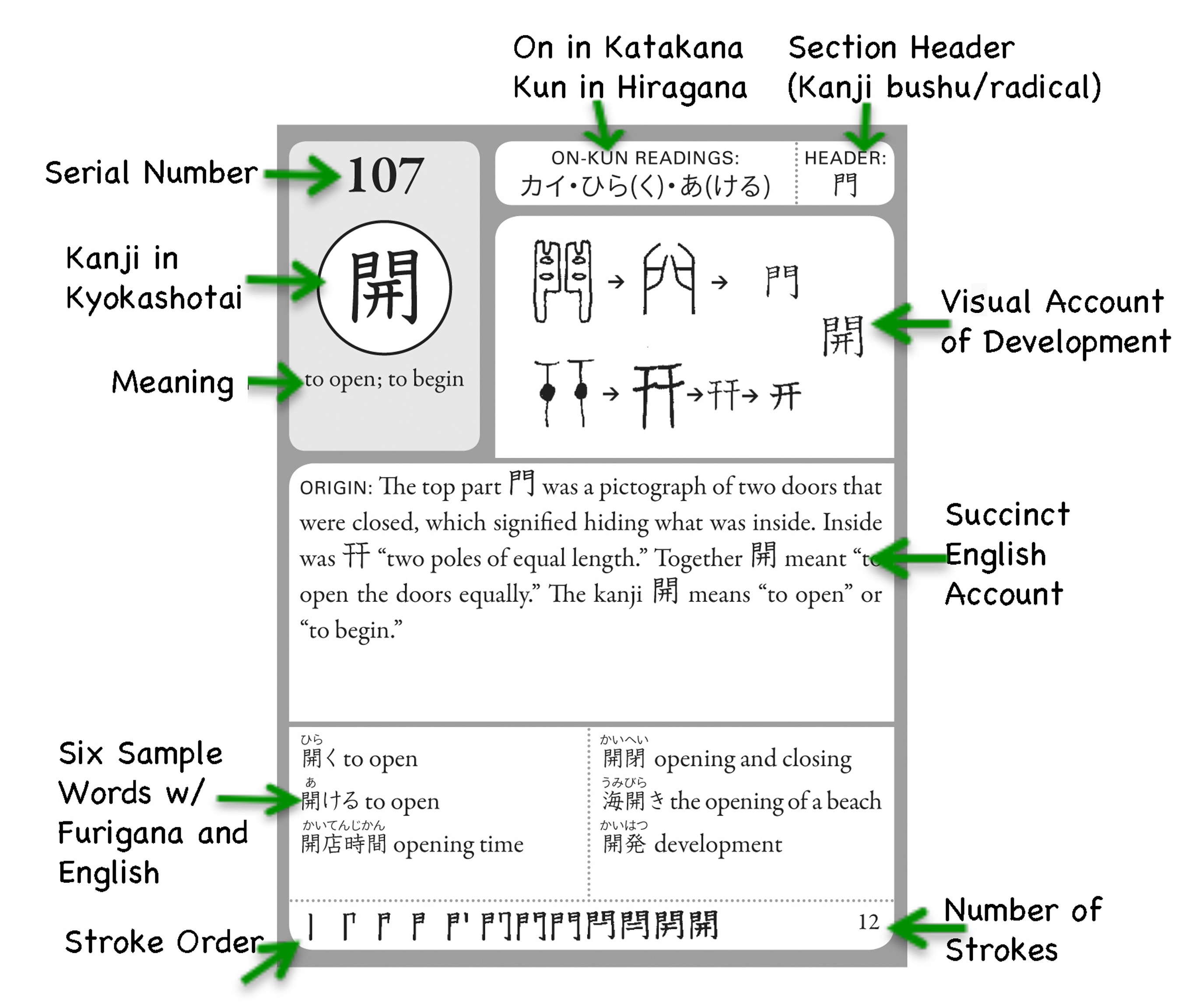This is the third post on kanji that originated from “fire.” We continue with kanji with a bushu rekka/renga 照黒点黙墨薫勲 and discuss other kanji 赤栄労営蛍.
- The kanji 昭 and 照 “to shine”
Before we look at the kanji 照, which has a bushu rekka/renga, let us look at its top, which is the kanji 昭.
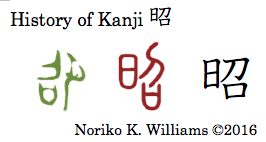 The kanji 昭 –The right side of the kanji 昭 is 召 “to summon; invite,” from a person and a mouth, and was used phonetically for /sho’o/ to mean “bright.” The bronze ware style writing, in green, had 召 on the left and the right side was another person. In ten style, in red, the position was reversed and the person was replaced by the sun. Together they meant “bright.”
The kanji 昭 –The right side of the kanji 昭 is 召 “to summon; invite,” from a person and a mouth, and was used phonetically for /sho’o/ to mean “bright.” The bronze ware style writing, in green, had 召 on the left and the right side was another person. In ten style, in red, the position was reversed and the person was replaced by the sun. Together they meant “bright.”
The imperial era name 昭和 (“Showa era (1926-1989)” /shoowa; sho’owa/) is about the only use of 昭 other than for a personal name. In Japan when an emperor passes away a new era is named immediately, usually taken form a classical Chinese text, and the new imperial era name begins the following day. The Showa emperor passed away on January 7, 1989, and the new era name 平成 (“Heisei” /heesee/) was announced by the government. So someone who was born on January 7, 1989, is 昭和64年生まれ (“born on Showa 64” /sho’owa rokujuuyonen-u’mare/), and someone who was born on the next day, January 8, is 平成元年生まれ (“born on Heisei 1” /heeseegannen-u’mare/). The (imperial) era name is used on all documents, governmental or non-governmental.
The kanji 照 “to shine; illuminate”
 For the kanji 照, in ten style the left side had the sun and a fire. The right side was used phonetically for /sho’o/. Both the sun and a fire illuminate the surroundings. Together they meant “to shine.” In kanji, the fire was moved to the bottom and became a bushu rekka/renga. It meant “to shine, illuminate.”
For the kanji 照, in ten style the left side had the sun and a fire. The right side was used phonetically for /sho’o/. Both the sun and a fire illuminate the surroundings. Together they meant “to shine.” In kanji, the fire was moved to the bottom and became a bushu rekka/renga. It meant “to shine, illuminate.”
The kun-yomi /te/ is in 照る(“to shine” /teru/), an intransitive verb, 照らす (“to illuminate” /terasu/), a transitive verb. The on-yomi /sho’o/ is in 日照時間 (“hours of sunlight” /nisshooji’kan/), 照明器具 (“lighting apparatus” /shoomeeki’gu/), 照合する (“to verity; collate with” /shoogoo-suru/), 参照する (“to refer to; compare with” /sanshoo-suru/).
A fire not only gives heat and light but also creates smoke and soot. The next six kanji, 黒点黙墨薫勲, all come from that.
- The kanji 黒 “black”
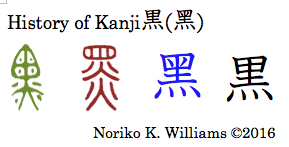 For the kanji 黒, in bronze ware style, in green, the top was a chimney with black soot (the dots were deposits), a bag to collect black soot, or a bag of stuff wrapped around to be smoked to dye fabric. The bottom was a burning fire. From black soot created by a fire, it meant “black; dark.” In ten style, it had a chimney or a bag, and two fires. In kyujitai, in blue, black dots for soot were still present, and the towering fire became a bushu rekka/renga. In shinjitai, the top became 里.
For the kanji 黒, in bronze ware style, in green, the top was a chimney with black soot (the dots were deposits), a bag to collect black soot, or a bag of stuff wrapped around to be smoked to dye fabric. The bottom was a burning fire. From black soot created by a fire, it meant “black; dark.” In ten style, it had a chimney or a bag, and two fires. In kyujitai, in blue, black dots for soot were still present, and the towering fire became a bushu rekka/renga. In shinjitai, the top became 里.
The kun-yomi 黒 /ku’ro/ means “black” and is in 黒い (“black; dark” /kuro’i/), 黒ずむ (“to blacken; become dark” /kurozu’mu/), and 黒っぽい (“blackish; dark” /kuroppo’i/). The on-yomi /ko’ku/ is in 黒板 (“blackboard” /kokuban/) and 暗黒 (“darkness; blackness” /ankoku/).
- The kanji 点 “dot; speckle; point; mark”
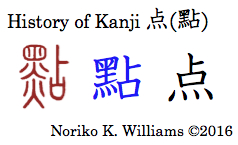 For the kanji 点, in ten style, the left side was the same as 黒 in 2, which had a chimney or a bag with specks of black soot at the top, and two fires. The right side 占 was used phonetically. They meant “small dot; point; to add a small note.” The kyujitai consisted of 黒 and 占. In shinjitai only the fire for 黒 was kept as a bushu rekka/renga below 占.
For the kanji 点, in ten style, the left side was the same as 黒 in 2, which had a chimney or a bag with specks of black soot at the top, and two fires. The right side 占 was used phonetically. They meant “small dot; point; to add a small note.” The kyujitai consisted of 黒 and 占. In shinjitai only the fire for 黒 was kept as a bushu rekka/renga below 占.
There is no kun-yomi. The on-yomi 点 /ten/ means “dot; point; mark,” and is in 弱点 (“weak point” /jakute’n), 盲点 (“blind spot” /mo’oten/), 欠点 (“shortcoming” /kette’n/), 疑問点 (“question; questionable point” /gimo’nten/), 合点が行く (“to understand” /gaten-ga-iku/) and 点数 (“point; mark” /tensu’u/).
- The kanji 墨 “ink”
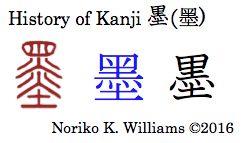 For the kanji 墨, the top of the ten style writing was the same as 黒 in 1, and the bottom was “soil; dirt.” Black deposits from smoke was collected in a bag and got mixed with dirt-like powdery materials to make a ball of ink. The ink was used to write on materials such as silk cloth, bamboo sticks and wood. The kanji 墨 means “ink.”
For the kanji 墨, the top of the ten style writing was the same as 黒 in 1, and the bottom was “soil; dirt.” Black deposits from smoke was collected in a bag and got mixed with dirt-like powdery materials to make a ball of ink. The ink was used to write on materials such as silk cloth, bamboo sticks and wood. The kanji 墨 means “ink.”
The kun-yomi 墨 /sumi’/ means “ink,” and is in 墨絵 (“ink painting” /sumie/). The on-yomi /bo’ku/ is in 水墨画 (“painting in black ink” /suibokuga/) and 墨汁 (“liquid ink” /bokujuu/).
- The kanji 薫 “aroma; fragrance”
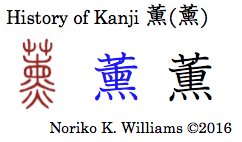 For the kanji 薫, the ten style had “plants” at the top, below that were a bag that was tied with strings in the middle and fires at the bottom – “to fume.” (In this writing, the strings were explicit.) Together they signified that plants were yielding agreeable scent, and from that 薫 meant “fragrance; aroma.” The kanji 薫 is often used for the non-Joyo kanji 燻 “to moulder,” because 燻 is not a Joyo kanji.
For the kanji 薫, the ten style had “plants” at the top, below that were a bag that was tied with strings in the middle and fires at the bottom – “to fume.” (In this writing, the strings were explicit.) Together they signified that plants were yielding agreeable scent, and from that 薫 meant “fragrance; aroma.” The kanji 薫 is often used for the non-Joyo kanji 燻 “to moulder,” because 燻 is not a Joyo kanji.
The kun-yomi /kaori/ means “fragrance.” The on-yomi /ku’n/ is in 薫陶 (“educational nurturing; moral instruction” /kuntoo/) and 薫製 (“smoked (food)” /kunsee/).
- The kanji 勲 “merit”
 For the kanji 勲, the old style writing, in purple, and the ten style writing were historically used interchangeably (Shirakawa). The right side of both writings had a plough, but the origin is not clear. The kanji 勲 meant “merit.”
For the kanji 勲, the old style writing, in purple, and the ten style writing were historically used interchangeably (Shirakawa). The right side of both writings had a plough, but the origin is not clear. The kanji 勲 meant “merit.”
There is no kun-yomi. The on-yomi /kun/ is in 勲章 (“decoration; order; medal” /kunshoo/), 叙勲 (“decoration; bestowal of an order” /jokkun/), and 元勲 (“outstanding statesman; an elder statesman” /genkun/).
- The kanji 黙 “to mute; silence”
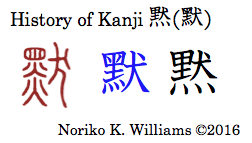 The kanji 黙 consists of 黒 and 犬. It is a very puzzling makeup and there are different views on its origin —A dog chasing a person (Setsumon): 黒, phonetically used to mean “not to say,” and a dog with his mouth closed together meant “to mute” (Kadokawa); “dark, unknown” from 黒 and a dog together signified “not known,” because if something is unknown, it keeps “silence” (Kanjigen). In place of mourning during which silence was expected for three years, a sacrificial dog was buried as a stand-in (Shirakawa). I do not have a preference on which one makes sense. The kanji 黙 means “to mute; silence.”
The kanji 黙 consists of 黒 and 犬. It is a very puzzling makeup and there are different views on its origin —A dog chasing a person (Setsumon): 黒, phonetically used to mean “not to say,” and a dog with his mouth closed together meant “to mute” (Kadokawa); “dark, unknown” from 黒 and a dog together signified “not known,” because if something is unknown, it keeps “silence” (Kanjigen). In place of mourning during which silence was expected for three years, a sacrificial dog was buried as a stand-in (Shirakawa). I do not have a preference on which one makes sense. The kanji 黙 means “to mute; silence.”
The kun-yomi 黙る /dama’ru/ means “to become silent; shut one’s mouth,” and is in 黙って使う (“to use something without telling or asking” /dama’tte tsukau/). The on-yomi /mo’ku/ is in 沈黙 (“silence” /chinmoku/), 黙殺する (“mokusatsu-suru” /not to adopt; ignore/), 黙秘権 (“a right of silence; the privilege against self-incrimination” /mokuhi’ken/).
- The kanji 赤 “red”
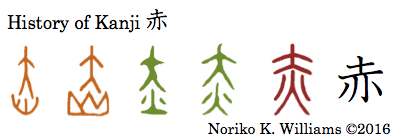 From oracle bone style, in brown, through ten style, the top was a “person” and a the bottom was “fire.” For this combination it is generally viewed that the top was “large” and the bottom was “fire” and that the color of a large fire was “red.” It meant “red.” Shirakawa gives a different explanation – there might have been a ritual in which a fire purified a person. A fire leaves completely nothing. His view explains words such as 赤貧 (“extreme poverty” /sekihin/) and 赤裸々な (“frank; unvarnished” /sekirara-na/).
From oracle bone style, in brown, through ten style, the top was a “person” and a the bottom was “fire.” For this combination it is generally viewed that the top was “large” and the bottom was “fire” and that the color of a large fire was “red.” It meant “red.” Shirakawa gives a different explanation – there might have been a ritual in which a fire purified a person. A fire leaves completely nothing. His view explains words such as 赤貧 (“extreme poverty” /sekihin/) and 赤裸々な (“frank; unvarnished” /sekirara-na/).
The kun-yomi 赤 /a’ka/ means “red,” and is in 真っ赤な (“very red” /makka’-na/), 赤ん坊 (“baby” /akanboo/) 赤字 (“deficit” /akaji/) from a bookkeeping practice of writing the deficit in red ink, as contrasted to 黒字 (“surplus; positive balance” /kuroji/). The on-yomi /se’ki/ is in 赤道 (“the equator” /sekidoo/). Another on-yomi /sha/ is in 赤銅色 (“brick red”/shakudooiro/).
(The kanji 赦 — I was planning to discuss the kanji 赦 in connection with 赤 in this post. After going over the references and ancient writings I feel more research is needed. So, I will come back to this kanji later.)
When two 火 were placed on top of the other, it was “flame” 炎. On the other hand when two 火 were placed side by side on stands, they meant “bonfire; beacon fire.” The kanji 栄 and 営 were discussed a couple of years ago in A Bonfire for “Prosperity” – 栄 on March 7, 2014.
- The kanji 栄 “flourishing; prospering”
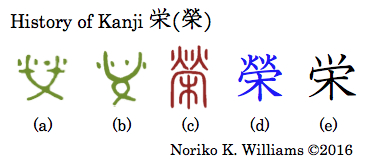 For the kanji 栄, the bronze ware style writings, (a) and (b), had two intersecting stands holding beacon fires. The ten style writing had beacon fires at the top but the stands became a boundary around trees. Brisk, intense flames of beacon fires illuminated a large property with lot of trees. From that it meant “flourishing; prospering.” The kyujitai, (d), reflected ten style (c). In shinjitai, (e), the two 火 side by side were reduced to a katakana ツ /tsu/ shape. For sample words please refer to the earlier post.
For the kanji 栄, the bronze ware style writings, (a) and (b), had two intersecting stands holding beacon fires. The ten style writing had beacon fires at the top but the stands became a boundary around trees. Brisk, intense flames of beacon fires illuminated a large property with lot of trees. From that it meant “flourishing; prospering.” The kyujitai, (d), reflected ten style (c). In shinjitai, (e), the two 火 side by side were reduced to a katakana ツ /tsu/ shape. For sample words please refer to the earlier post.
- The kanji 労 “trouble; labor; to reward for one’s service”
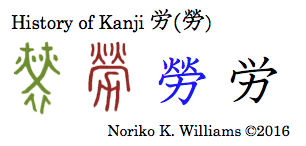 The kanji 労 also had a bronze ware style writing, which was very similar to 栄 – two beacon fires with long stands that intersected, signifying “vigorous; energetic.” Underneath was a collar that signified a person. Together, a person working energetically meant “trouble; labor; to reward for one’s service.” In ten style, a collar was replaced by a plough, which signified hard work in the field. The Kadokawa dictionary gives a different explanation — people working hard at night under light gave the meaning “to work hard.” The kyujitai reflected ten style. “It also meant “to reward for one’s service.”
The kanji 労 also had a bronze ware style writing, which was very similar to 栄 – two beacon fires with long stands that intersected, signifying “vigorous; energetic.” Underneath was a collar that signified a person. Together, a person working energetically meant “trouble; labor; to reward for one’s service.” In ten style, a collar was replaced by a plough, which signified hard work in the field. The Kadokawa dictionary gives a different explanation — people working hard at night under light gave the meaning “to work hard.” The kyujitai reflected ten style. “It also meant “to reward for one’s service.”
The kun-yomi 労う /negira’u/ means “to reward one’s service.” Another kun-yomi /itawa’ru/ means “to treat kindly.” The on-yomi /ro’o/ is in 苦労する (“to experience difficulties; have a hard time” /kuk’roo-suru/”), 労働 (“work force; labor force” /roodoo/), 疲労 (“fatigue” /hiroo/), 労をとる (“to take trouble” /ro’o-toru/).
- The kanji 営 “to conduct business”
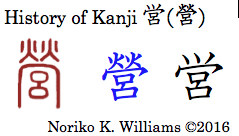 The kanji 営 must have been created later than the previous two kanji because the earliest writing was in ten style. In ten style, the top had fires and a boundary around the property. Inside the boundary were two connected houses (呂). Together they meant “military encampment.” Business was conducted there, and it meant “to conduct business or live one’s life.” For sample words, please refer to the earlier post.
The kanji 営 must have been created later than the previous two kanji because the earliest writing was in ten style. In ten style, the top had fires and a boundary around the property. Inside the boundary were two connected houses (呂). Together they meant “military encampment.” Business was conducted there, and it meant “to conduct business or live one’s life.” For sample words, please refer to the earlier post.
12. The kanji 蛍 “firefly”
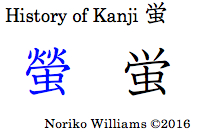 One last kanji for our three posts on “fire” is the kanji 蛍 “firefly.” There is no ancient writing for 蛍. The kyujitai is 螢. The top had two fires and a boundary together phonetically for /kei/ and signifying “lights circling around.” The bottom was 虫 “bug; worm; insect.” An illuminating bug that circles around is a firefly. The kanji 蛍 means “firefly.”
One last kanji for our three posts on “fire” is the kanji 蛍 “firefly.” There is no ancient writing for 蛍. The kyujitai is 螢. The top had two fires and a boundary together phonetically for /kei/ and signifying “lights circling around.” The bottom was 虫 “bug; worm; insect.” An illuminating bug that circles around is a firefly. The kanji 蛍 means “firefly.”
The kun-yomi is 蛍 (“firefly” /hotaru/). The on-yomi /ke’i/ is in 蛍光灯 (“florescent light” /keekootoo/).
In the next several posts we continue kanji for nature. [June 4, 2016 Japan time]
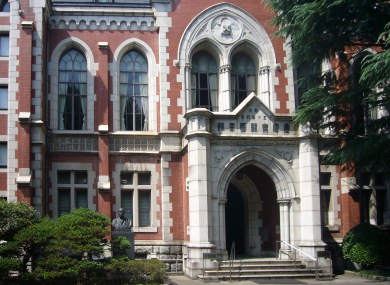
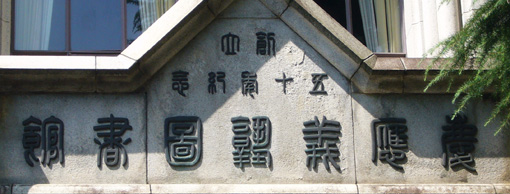
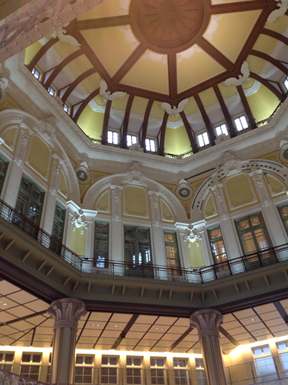
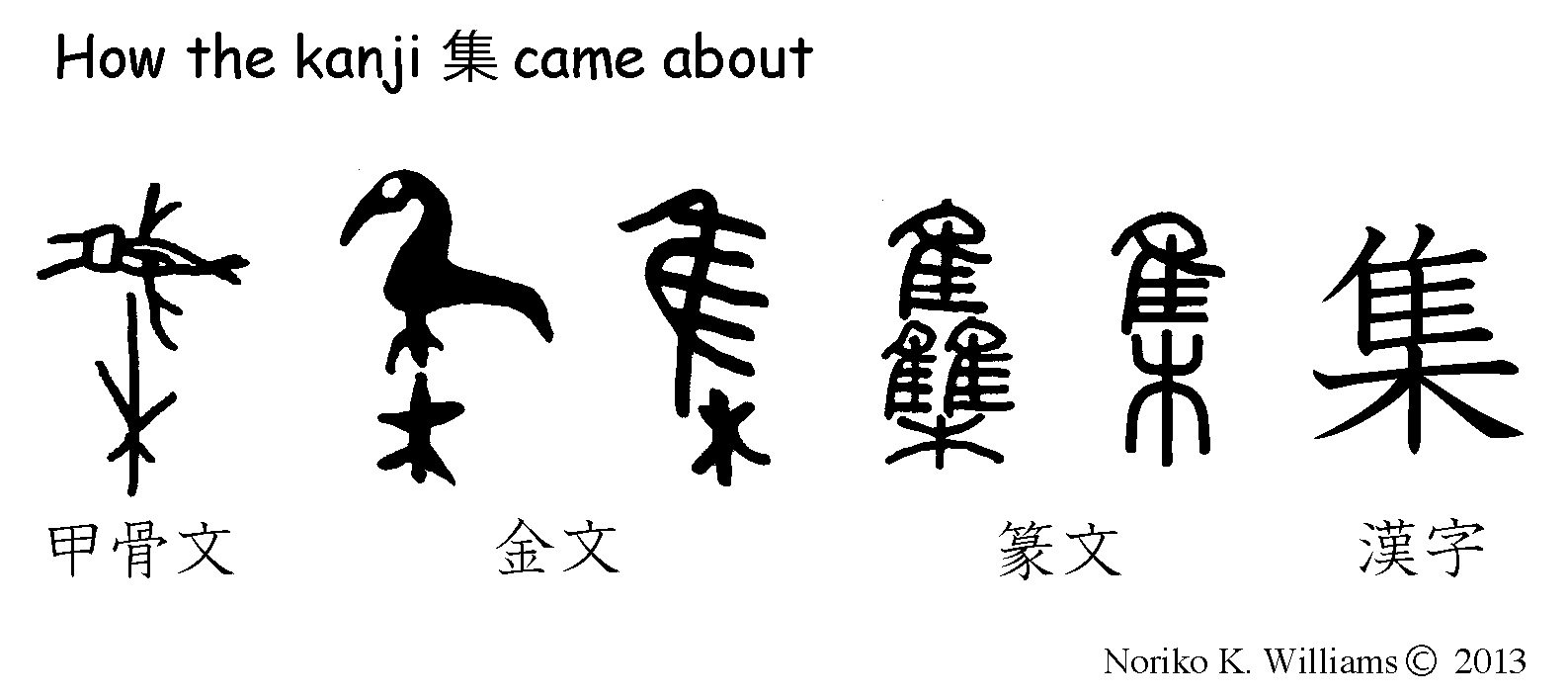
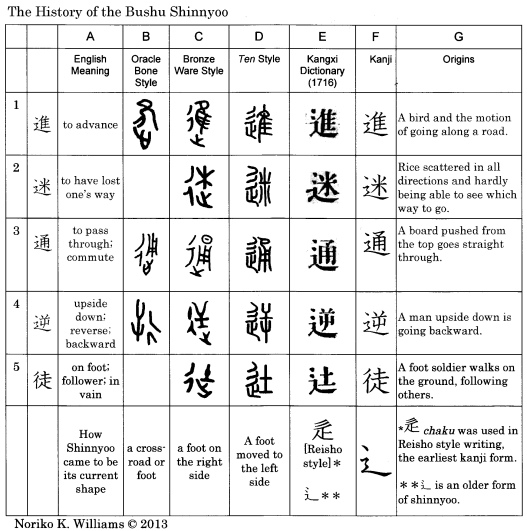

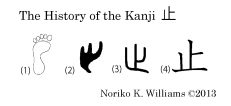



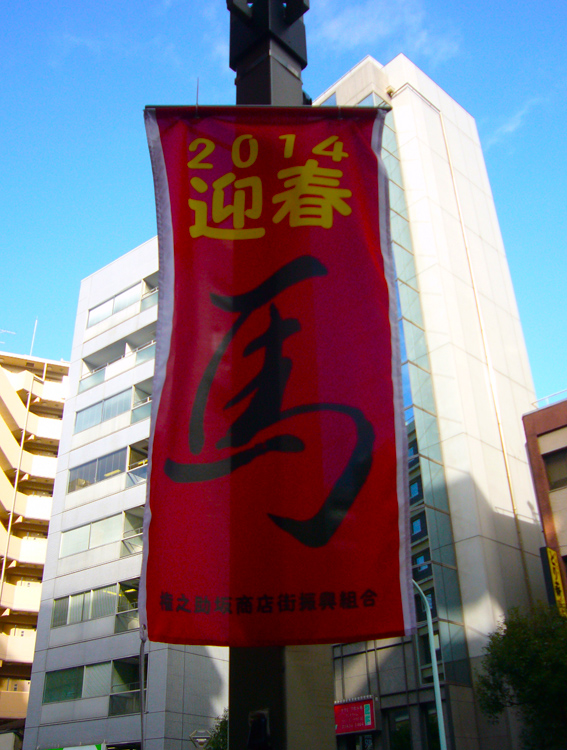
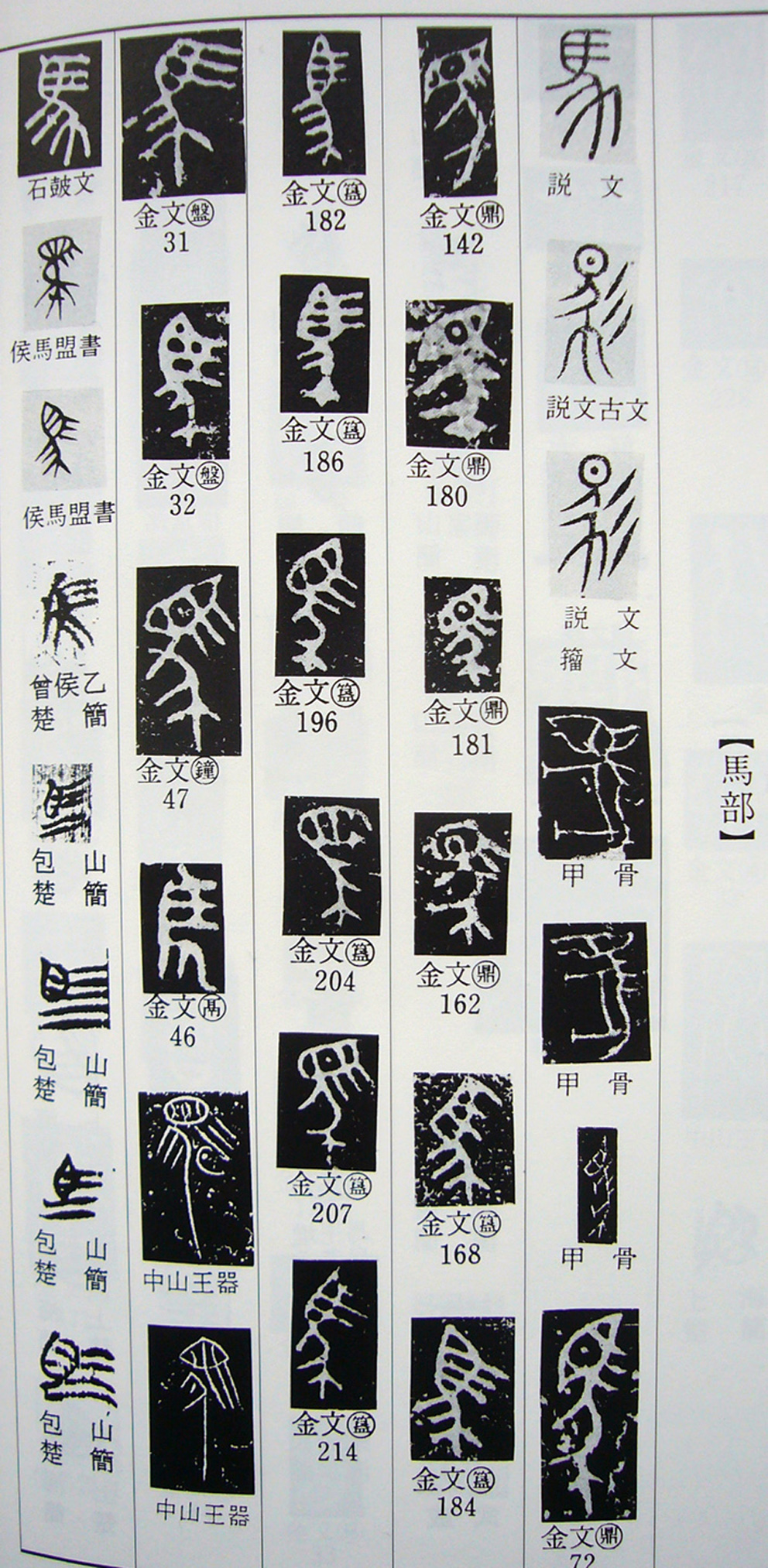
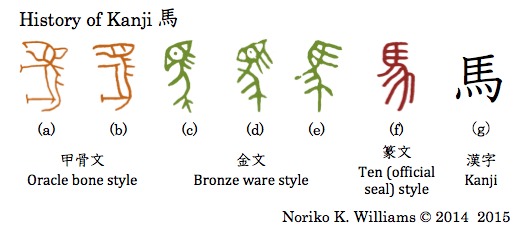

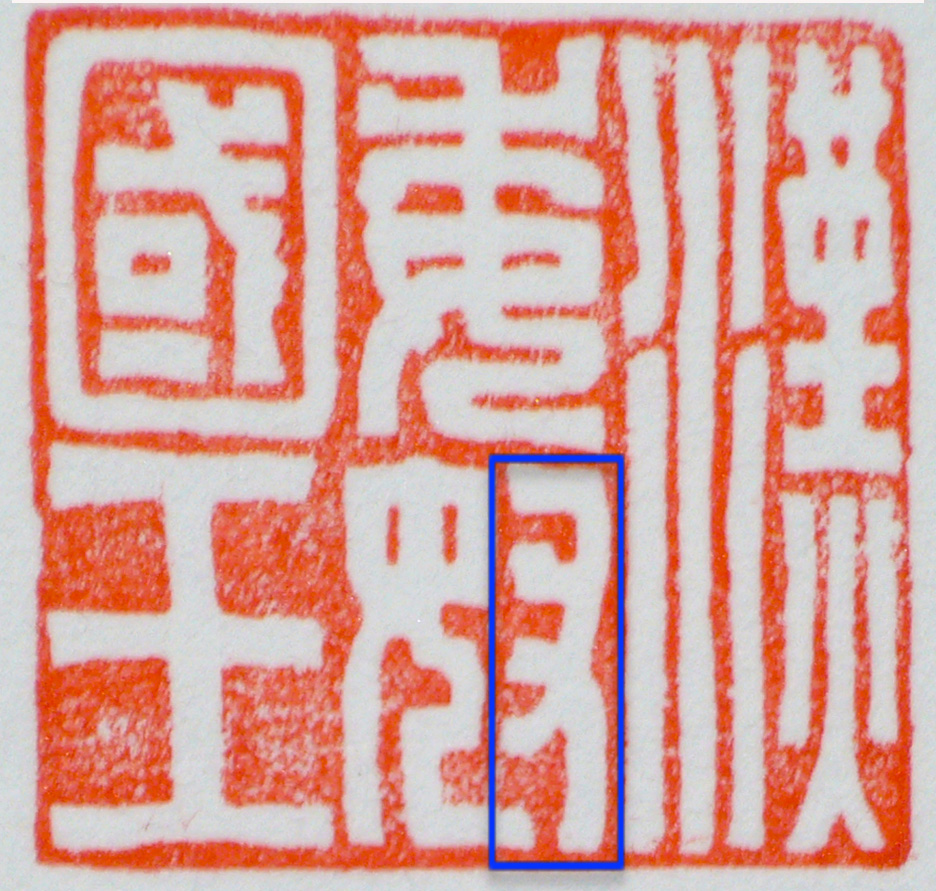
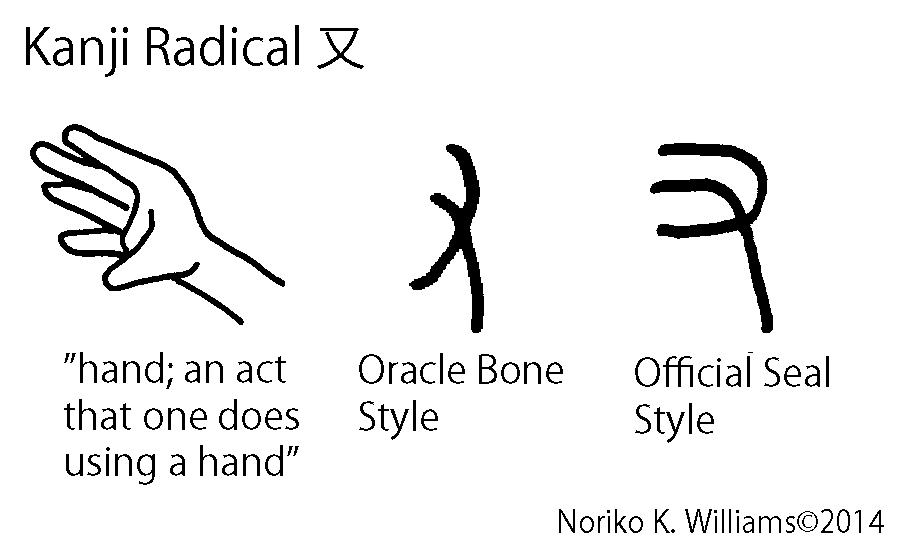
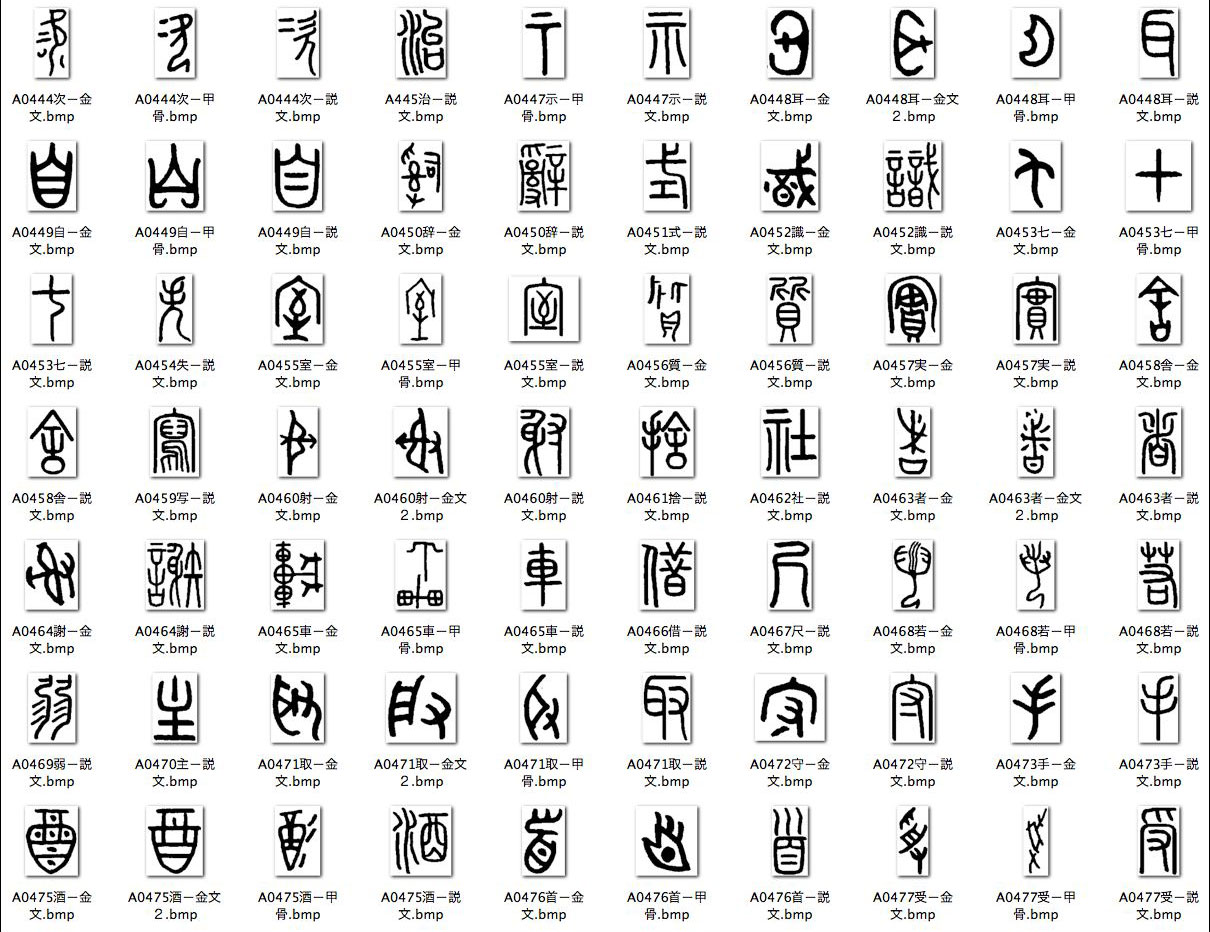
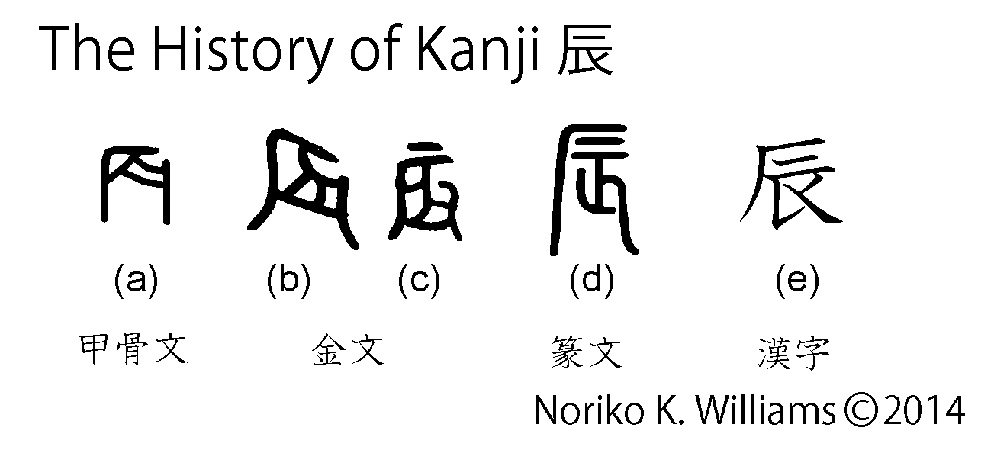
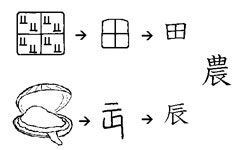
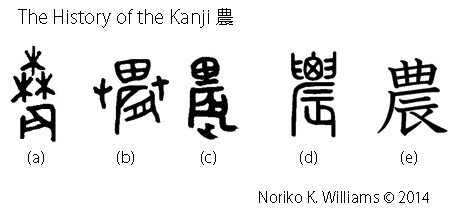
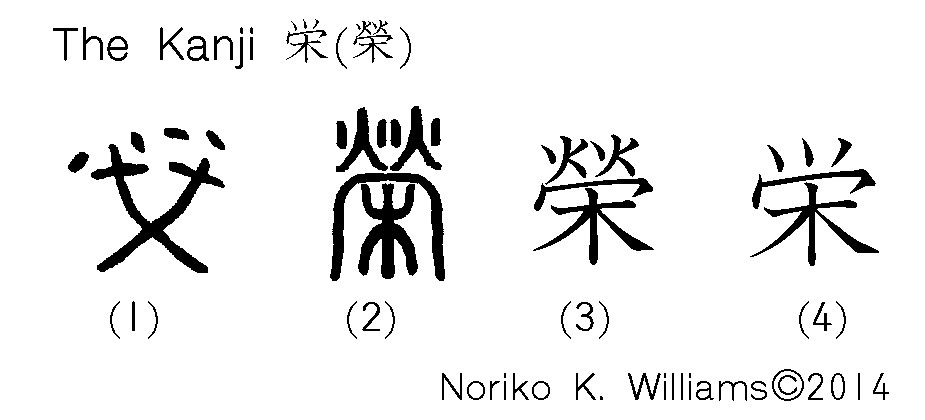
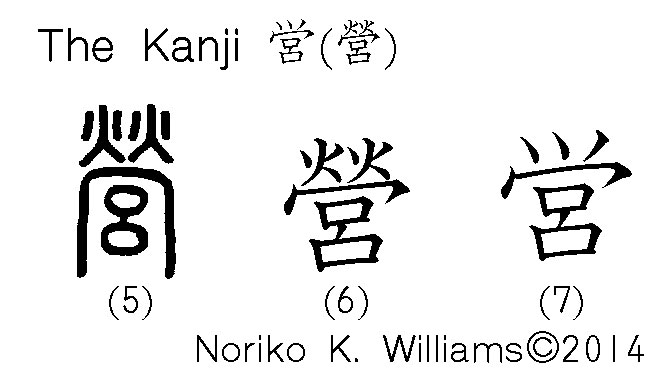
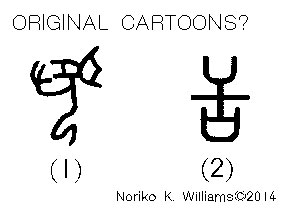
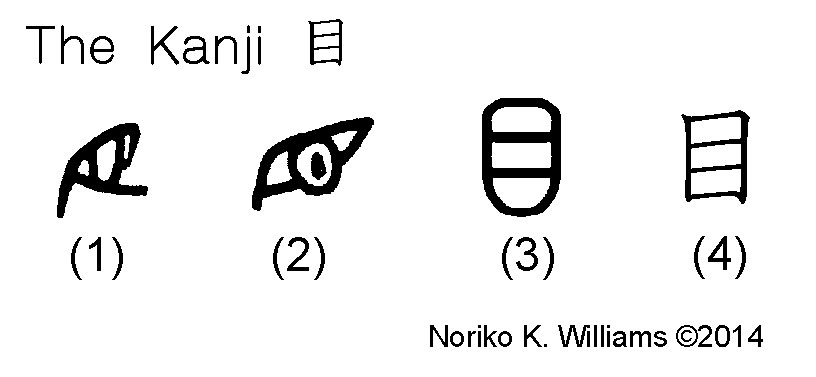
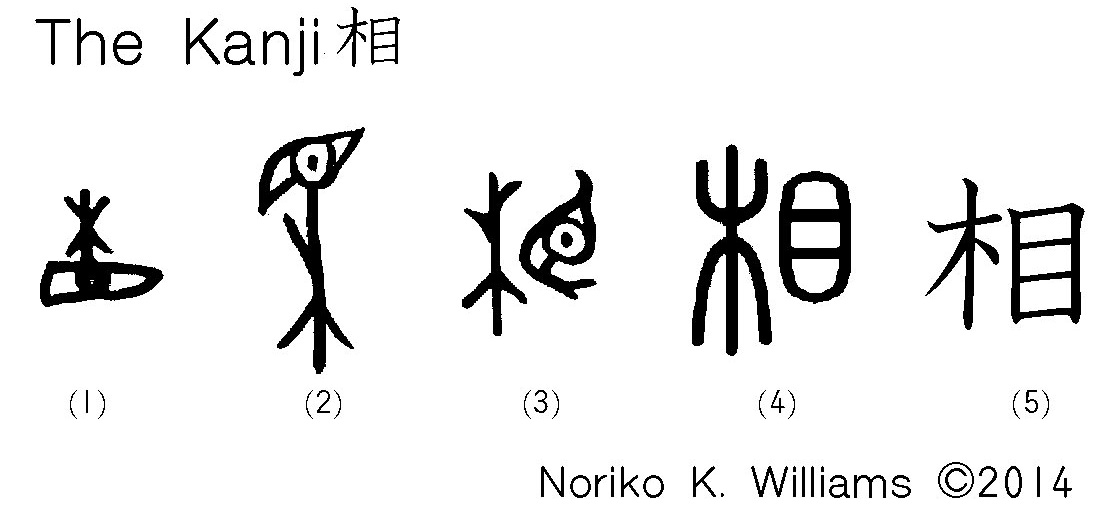
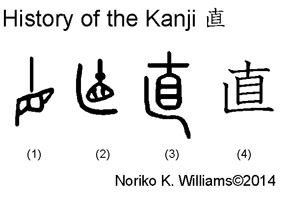
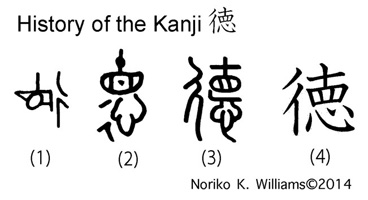
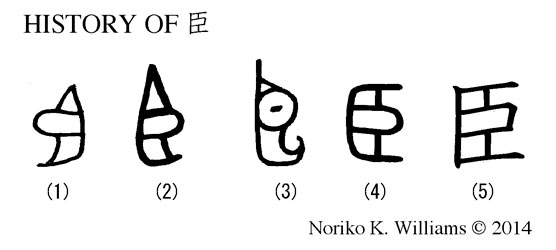
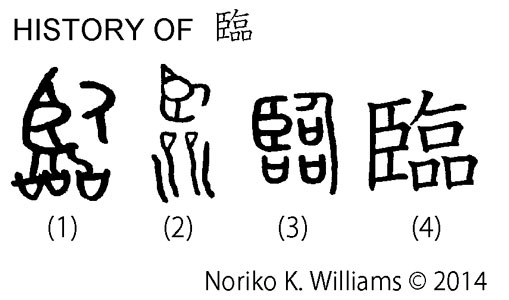

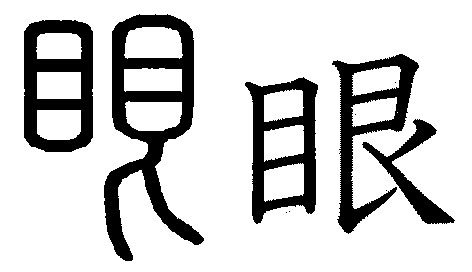
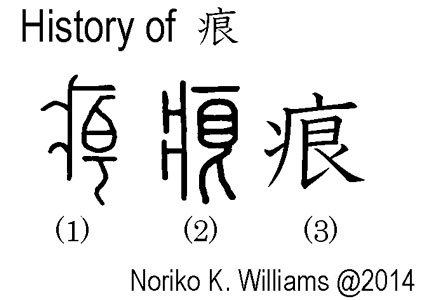
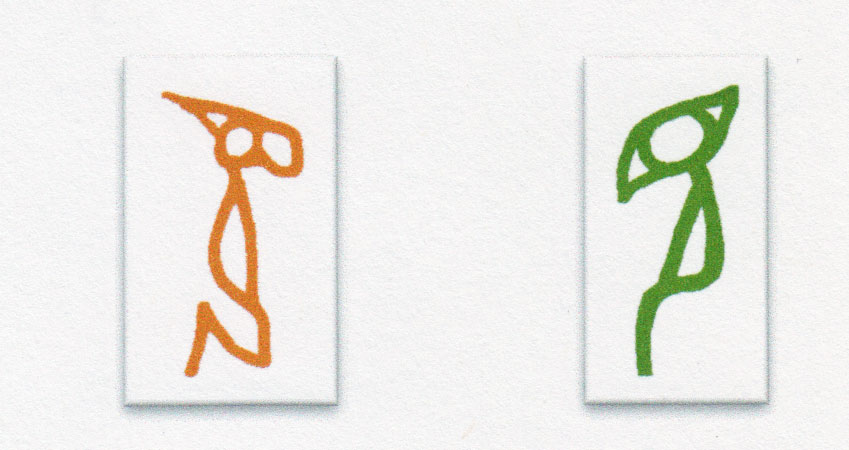
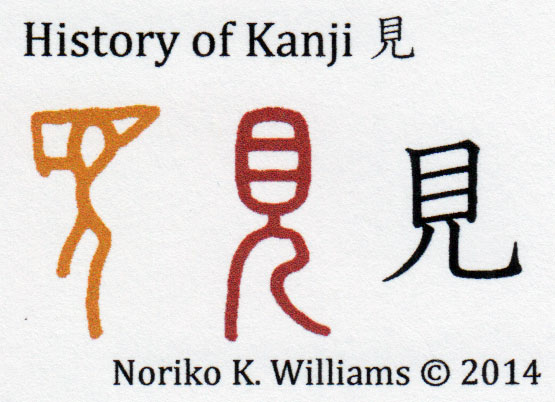
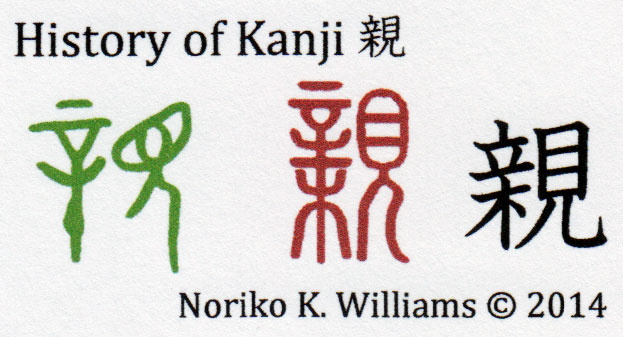
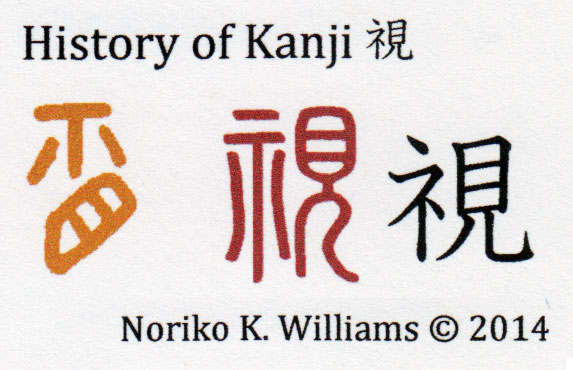
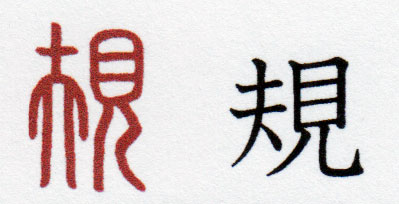
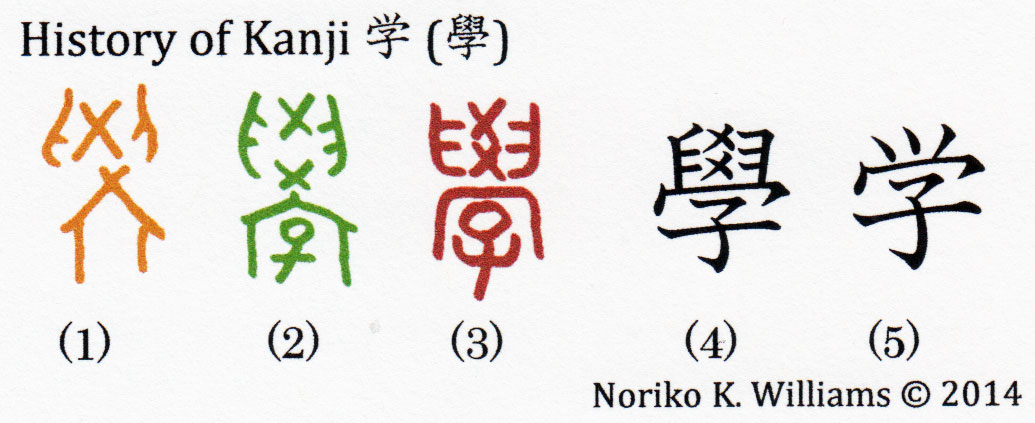

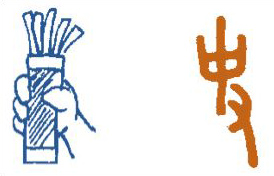
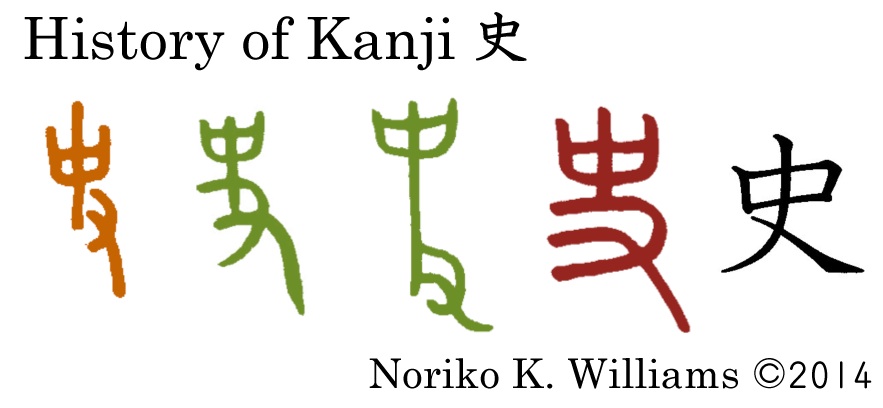
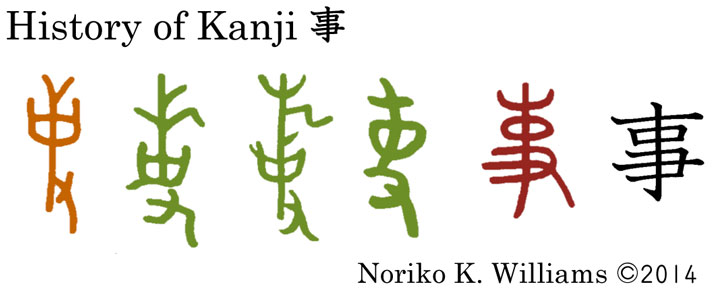

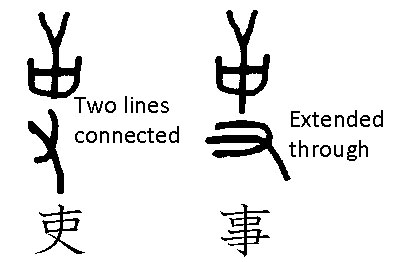
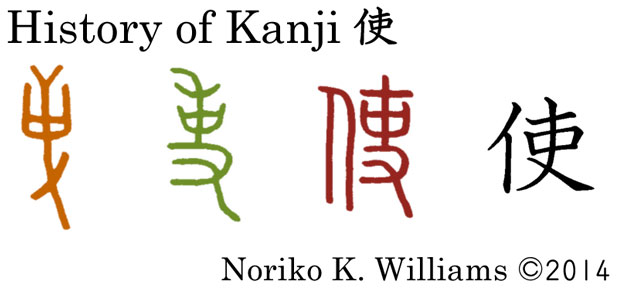

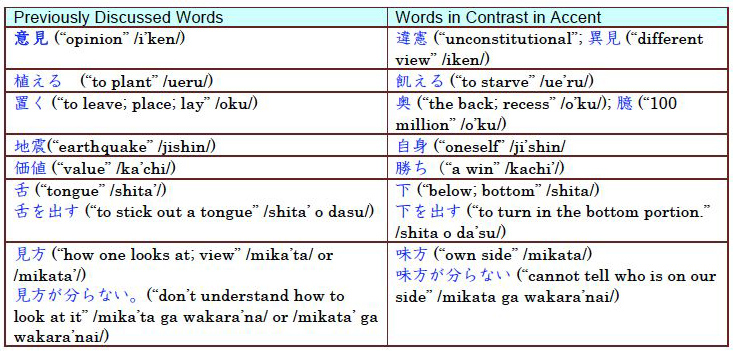
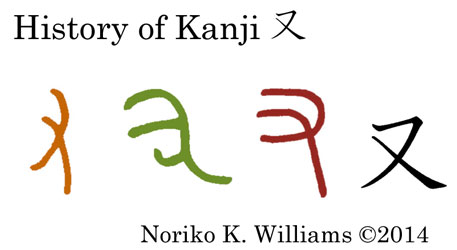
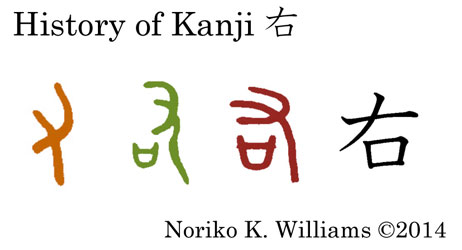


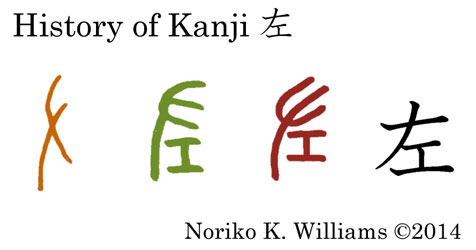


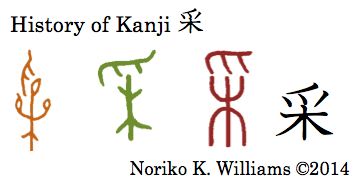
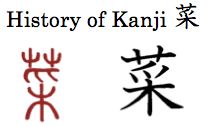
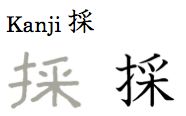
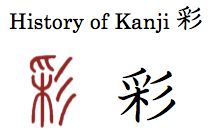
![筆順クイズ[右有左友]](files/2014/05/e7ad86e9a086e382afe382a4e382ba2.jpg)
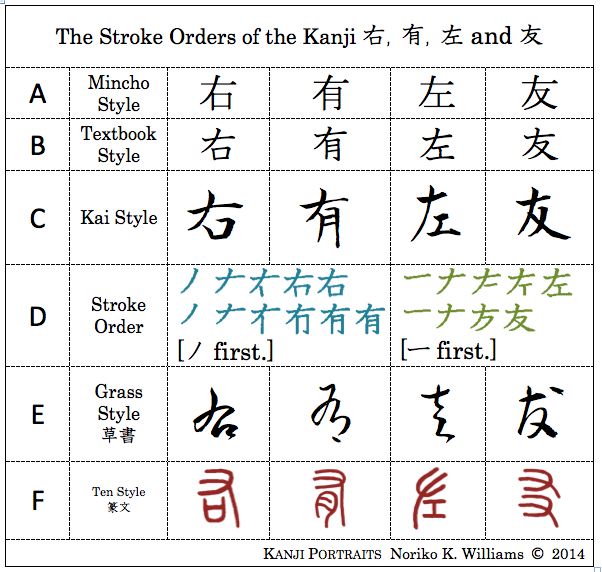 Row A (Mincho Style): The horizontal lines in all the four kanji look identical and the slanted strokes toward the left are also identical in length and angle, except in kanji (2) 有. Mincho style is a printer’s typeface for the maximum use of an imaginary square for each kanji. Strokes are elongated to fill every corner. The lines are straight and a thin horizontal line has serifs on the right end. It is used in books, magazines, computer screens, etc. where available space is more import consideration than esthetics.
Row A (Mincho Style): The horizontal lines in all the four kanji look identical and the slanted strokes toward the left are also identical in length and angle, except in kanji (2) 有. Mincho style is a printer’s typeface for the maximum use of an imaginary square for each kanji. Strokes are elongated to fill every corner. The lines are straight and a thin horizontal line has serifs on the right end. It is used in books, magazines, computer screens, etc. where available space is more import consideration than esthetics.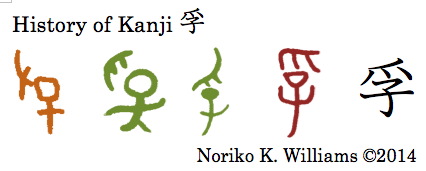
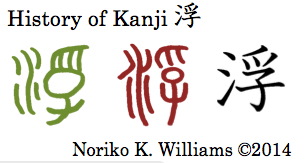

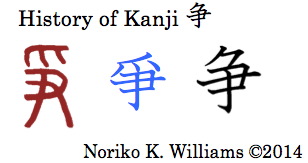
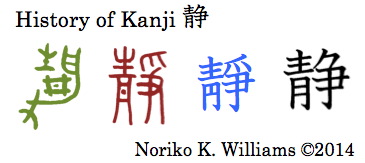
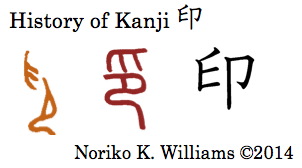
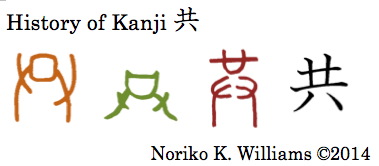
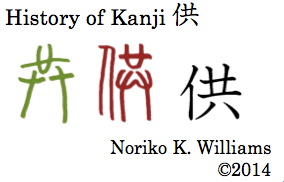
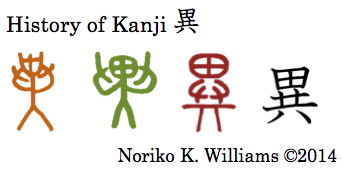
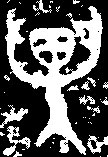

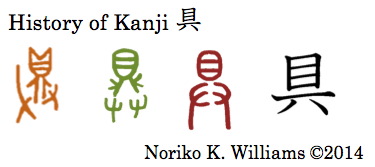

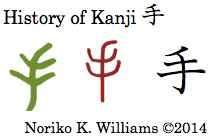
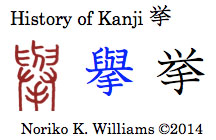




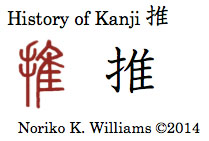
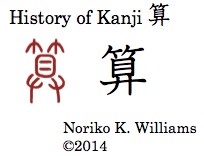

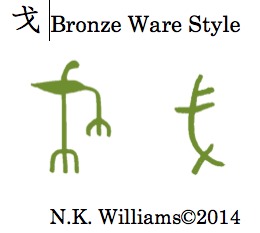
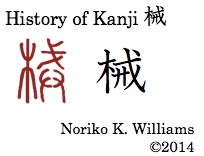
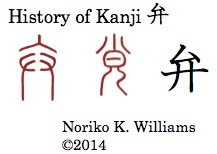
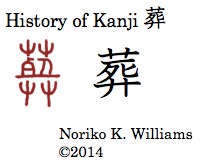
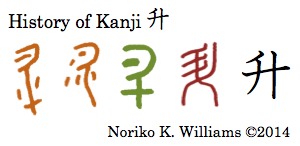
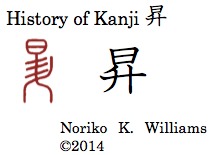

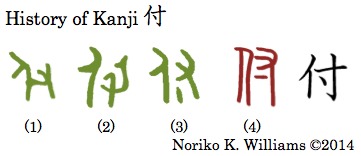

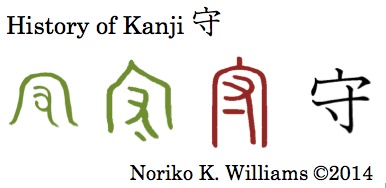

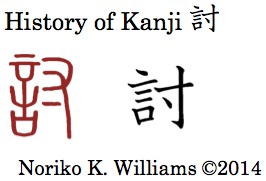
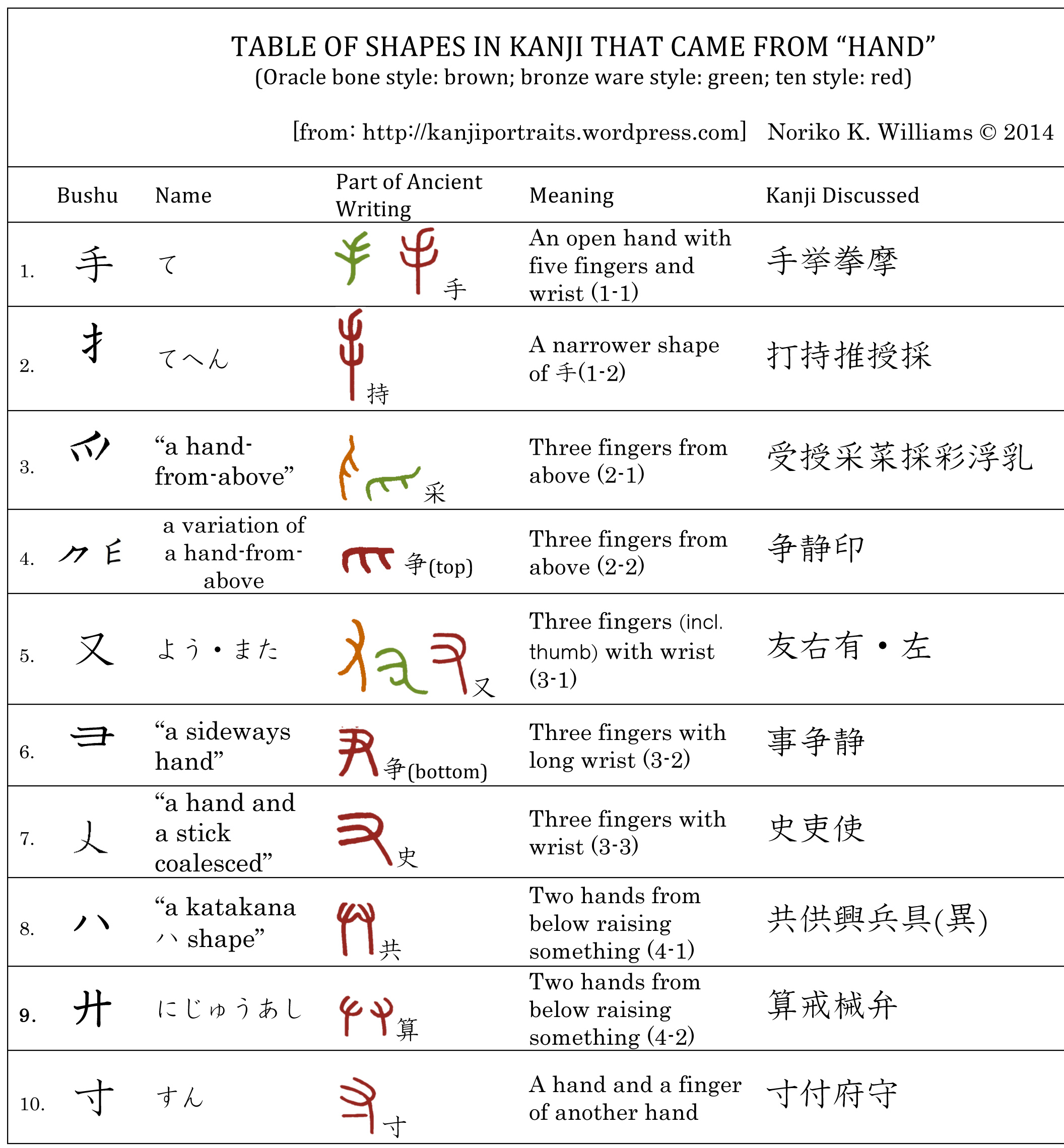
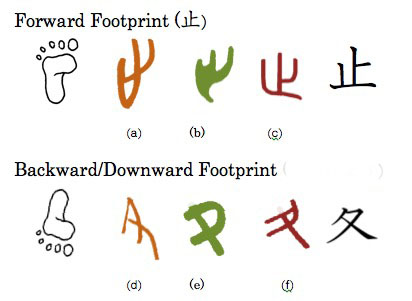 Direction of footprints: How did ancient creators of writing in China differentiate the two directions of walking? In the table on the left, the top row shows the development of forward footprint shapes, and in the bottom row for a backward or downward footprint. I am assuming that where two lines crossed was where the toe was. Based on that assumption we can say that the kanji 止 was a left foot and the bushu chi 夂 was a right foot.
Direction of footprints: How did ancient creators of writing in China differentiate the two directions of walking? In the table on the left, the top row shows the development of forward footprint shapes, and in the bottom row for a backward or downward footprint. I am assuming that where two lines crossed was where the toe was. Based on that assumption we can say that the kanji 止 was a left foot and the bushu chi 夂 was a right foot.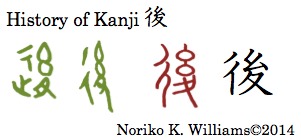 For the kanji 後, the top of the first bronze ware style on the left had a crossroad (彳) and short threads (幺) and the bottom had a forward footprint (止) and a backward footprint (夂). But the forward footprint was not in the second sample nor in ten style. Short threads meant smallness. By waking in small steps one became behind and arrived later. From that the kanji 後 meant “behind; back; later; late.” In ten style, 夂 “backward foot” became 夊 “dragging foot,” but in kanji it became 夂. It seems that even though夂 “backward foot” and夊 “dragging foot” had different meanings, sometimes they were used interchangeably.
For the kanji 後, the top of the first bronze ware style on the left had a crossroad (彳) and short threads (幺) and the bottom had a forward footprint (止) and a backward footprint (夂). But the forward footprint was not in the second sample nor in ten style. Short threads meant smallness. By waking in small steps one became behind and arrived later. From that the kanji 後 meant “behind; back; later; late.” In ten style, 夂 “backward foot” became 夊 “dragging foot,” but in kanji it became 夂. It seems that even though夂 “backward foot” and夊 “dragging foot” had different meanings, sometimes they were used interchangeably.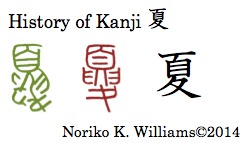 In the kanji 夏, in bronze ware style the top was the head of an official with a headdress on, which appears in many kanji related to a head, including 頭 “head” and 顔 “face.” Below that he had some adornments in his hands and a downward foot at the bottom. He was dancing in a festival showing off fancy step work and hand movements. From a festival in summer it meant “summer.” In kanji, the two hands were dropped and fancy footwork remained. The kun-reading is in 真夏 (“midsummer” /manatsu/), 夏場 (“during summer” /natsuba/). The on-reading /ka/ is in 立夏 (“beginning of summer on calendar”/ri’kka/).
In the kanji 夏, in bronze ware style the top was the head of an official with a headdress on, which appears in many kanji related to a head, including 頭 “head” and 顔 “face.” Below that he had some adornments in his hands and a downward foot at the bottom. He was dancing in a festival showing off fancy step work and hand movements. From a festival in summer it meant “summer.” In kanji, the two hands were dropped and fancy footwork remained. The kun-reading is in 真夏 (“midsummer” /manatsu/), 夏場 (“during summer” /natsuba/). The on-reading /ka/ is in 立夏 (“beginning of summer on calendar”/ri’kka/).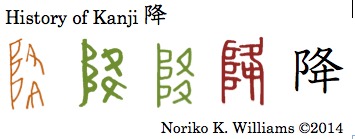 For the kanji 降, in all of the ancient writing, the left side had a pile of dirt raised high, indicating a high place. A dirt wall served as a boundary. This bushu is called kozatohen, and it meant “ladder, boundary, high land.” The right side, in both oracle bone style and bronze ware style were two footsteps facing downward- a right footprint (the top) and a left footprint (the bottom). In ten style, the bottom footprint was placed more sideways. This shape appears in 韋, a component of the kanji 偉, 違 and 圍 (囲), which we will look at in the next post. So, with a kozatohen and two downward footprints coming down from the high place, the kanji 降 meant “to fall (from the sky)” and “to descend.”
For the kanji 降, in all of the ancient writing, the left side had a pile of dirt raised high, indicating a high place. A dirt wall served as a boundary. This bushu is called kozatohen, and it meant “ladder, boundary, high land.” The right side, in both oracle bone style and bronze ware style were two footsteps facing downward- a right footprint (the top) and a left footprint (the bottom). In ten style, the bottom footprint was placed more sideways. This shape appears in 韋, a component of the kanji 偉, 違 and 圍 (囲), which we will look at in the next post. So, with a kozatohen and two downward footprints coming down from the high place, the kanji 降 meant “to fall (from the sky)” and “to descend.” In the oracle bone style of the kanji 麦, the top was a barley plant, and the bottom was a downward footprint. In all the styles through the time of kyujitai before the post-war language reform, a barley plant and a downward footprint in the shape of a katakana /ta/ were recognizable. Barley plants grow early and in early spring a farmer treads on the seedlings that pushed up from the ground. In Japanese it is called 麦踏み (treading on barley) and in haiku tradition, it signifies early spring. A downward/backward walk signified that a farmer walked back and forth.
In the oracle bone style of the kanji 麦, the top was a barley plant, and the bottom was a downward footprint. In all the styles through the time of kyujitai before the post-war language reform, a barley plant and a downward footprint in the shape of a katakana /ta/ were recognizable. Barley plants grow early and in early spring a farmer treads on the seedlings that pushed up from the ground. In Japanese it is called 麦踏み (treading on barley) and in haiku tradition, it signifies early spring. A downward/backward walk signified that a farmer walked back and forth.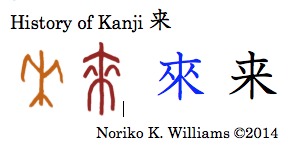 Speaking of a barley plant, all three styles of ancient writing for the kanji 来 were a barley plant. If you compare with those for 麦, you would think that having downward footprints makes more sense for the meaning “to come,” because someone is coming toward you. Apparently very early on in ancient time, those two writings got mixed up and switched the use of!
Speaking of a barley plant, all three styles of ancient writing for the kanji 来 were a barley plant. If you compare with those for 麦, you would think that having downward footprints makes more sense for the meaning “to come,” because someone is coming toward you. Apparently very early on in ancient time, those two writings got mixed up and switched the use of!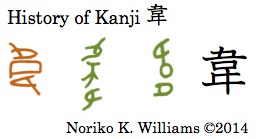

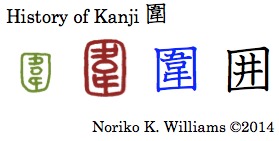
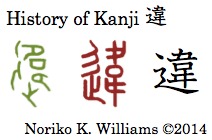
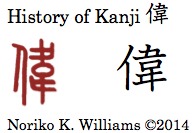
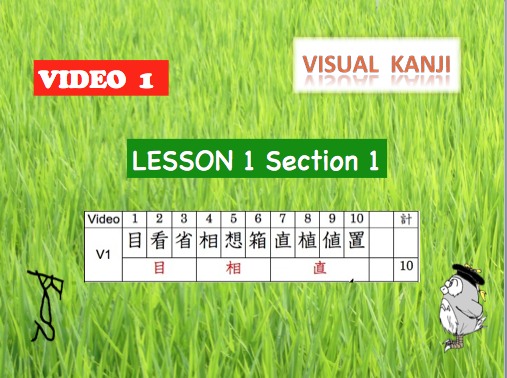
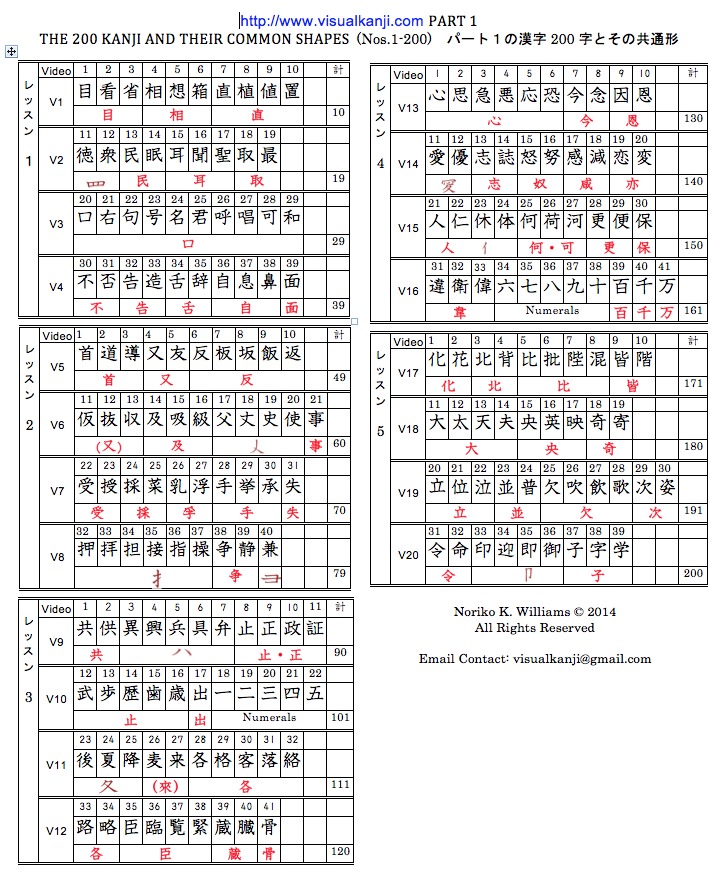
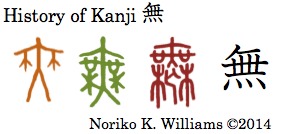
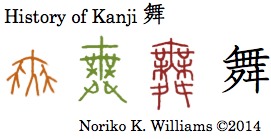
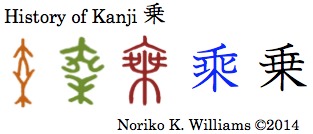
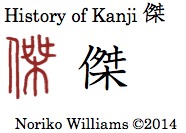
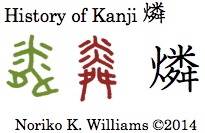
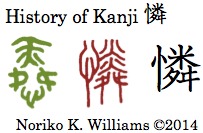
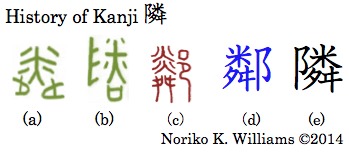
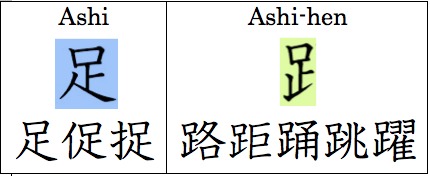

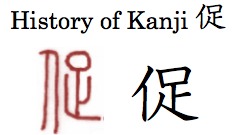
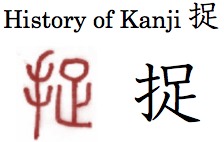
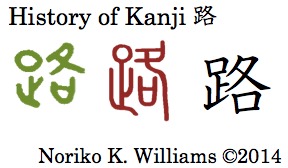
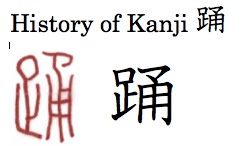
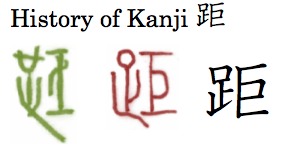
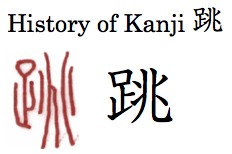
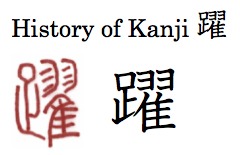
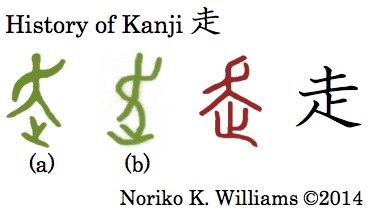
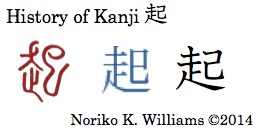
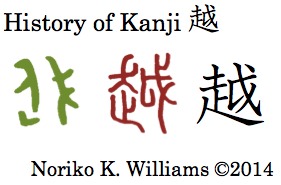
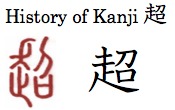

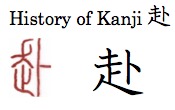

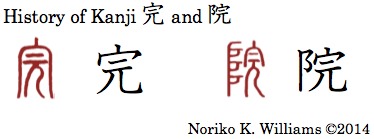
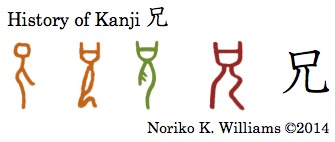
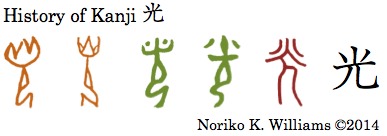
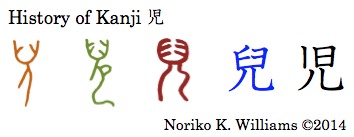
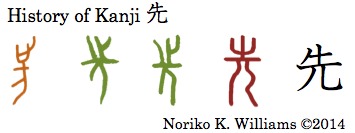
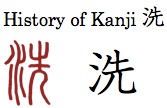
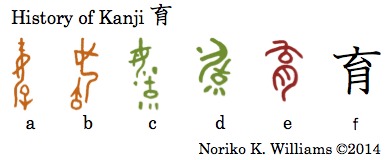
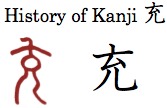
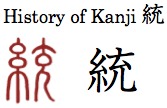
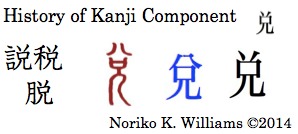
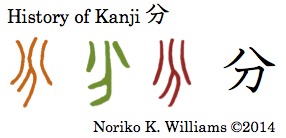
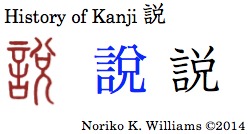
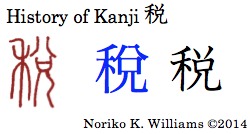
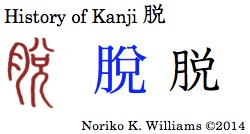
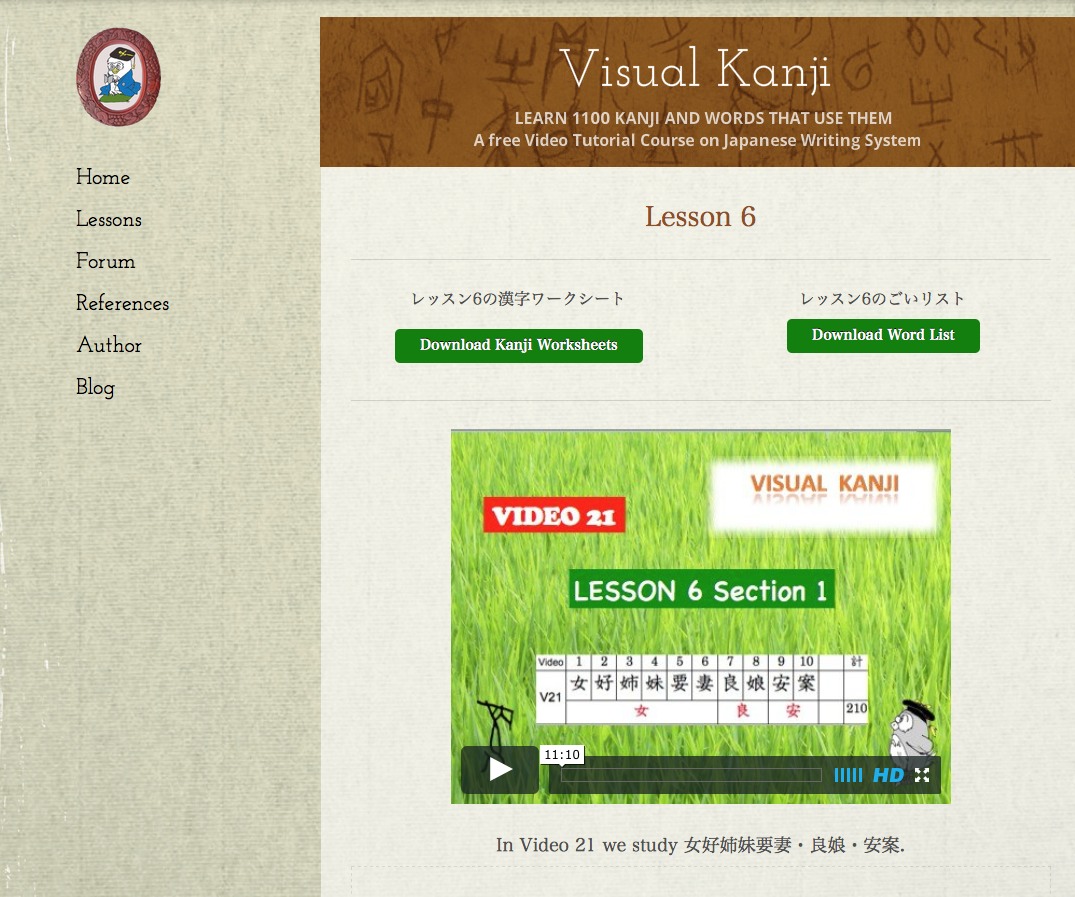

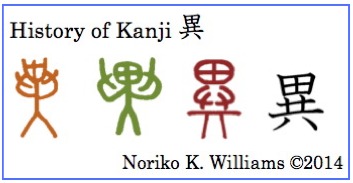
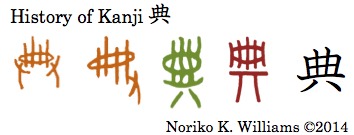
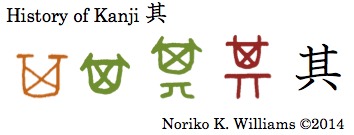
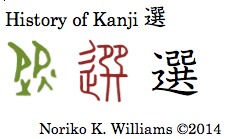

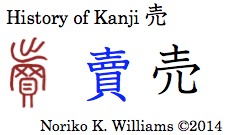

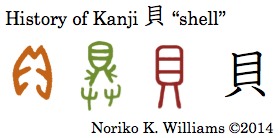
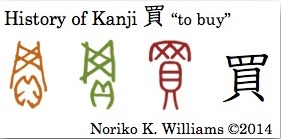
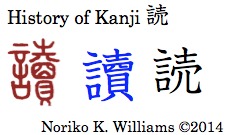

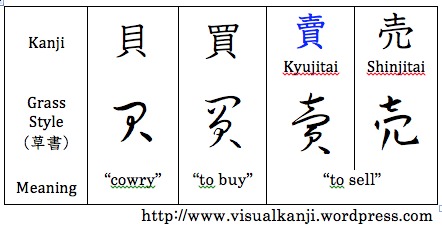
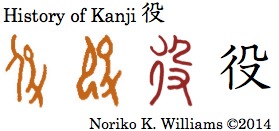
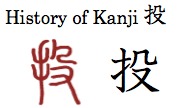

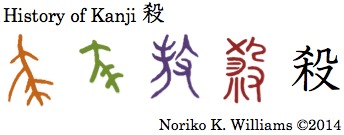
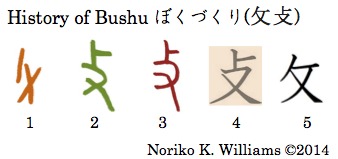
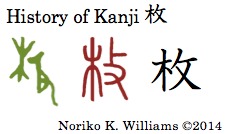
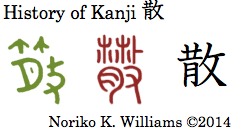
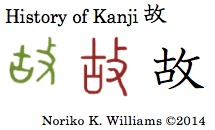
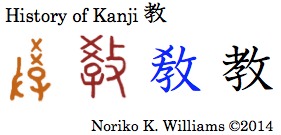
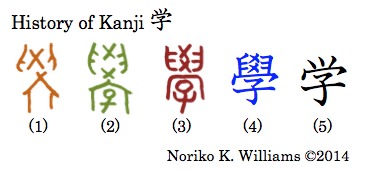


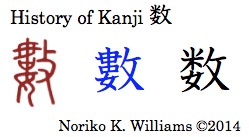
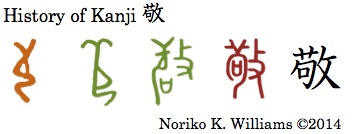
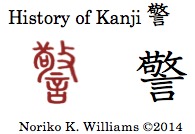
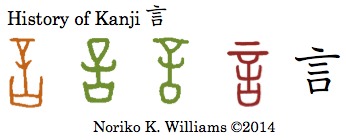
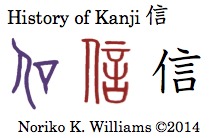
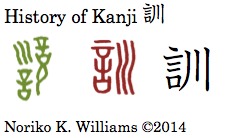
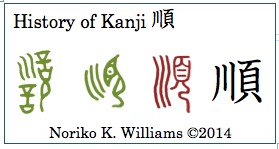
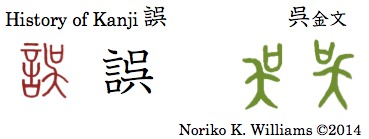
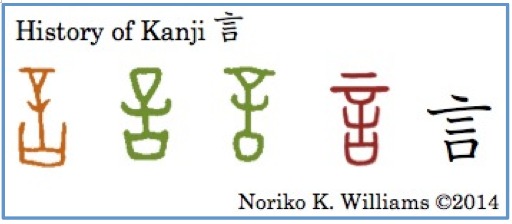
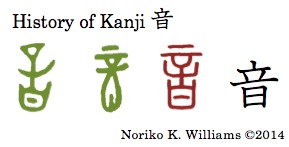
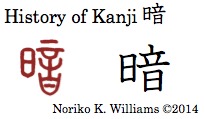
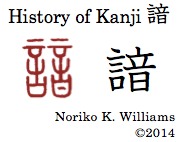
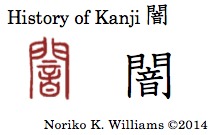

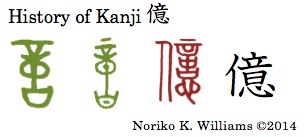
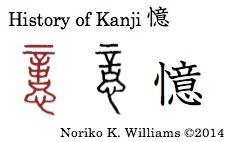
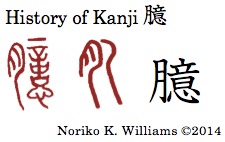
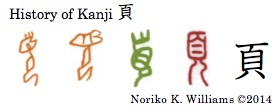


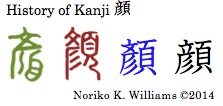
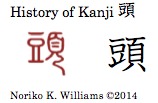
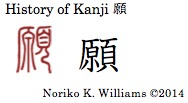
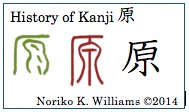
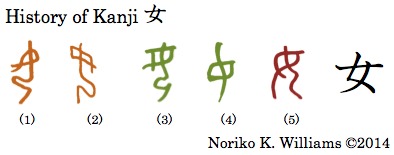
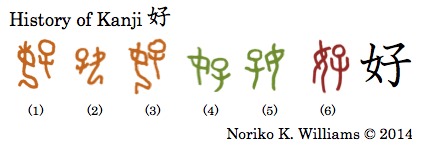
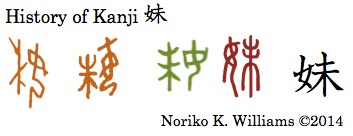
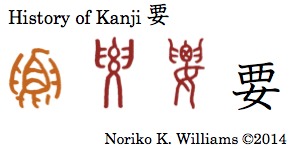
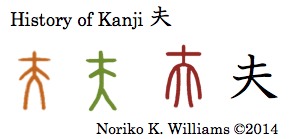
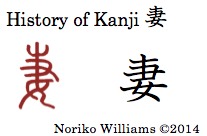
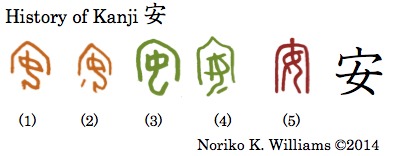
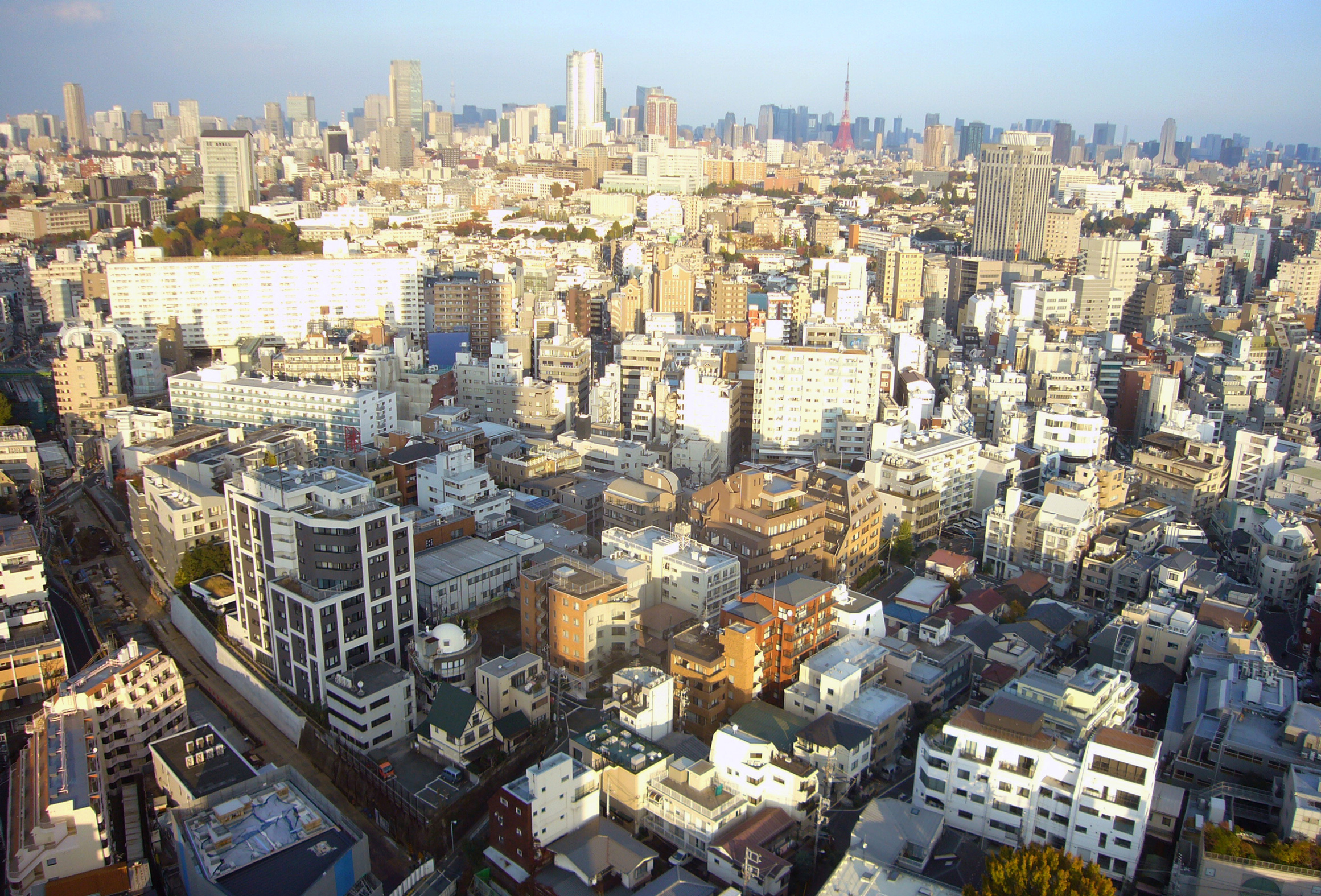
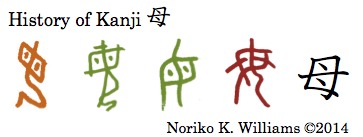

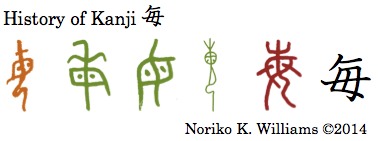
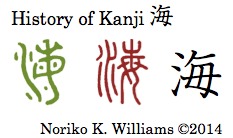 In the kanji 海, the left side was a bushu sanzui “water” and the right side 毎 was used phonetically to mean “dark; unknown.” From unknown water it meant “ocean; sea.” The kun-yomi /u’mi/ is in 荒海 (“rough sea” /araumi/) and 海や山 (“the sea and mountains” /u’mi ya yama/).
In the kanji 海, the left side was a bushu sanzui “water” and the right side 毎 was used phonetically to mean “dark; unknown.” From unknown water it meant “ocean; sea.” The kun-yomi /u’mi/ is in 荒海 (“rough sea” /araumi/) and 海や山 (“the sea and mountains” /u’mi ya yama/).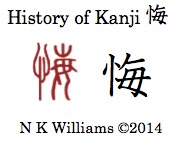


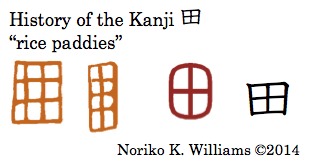
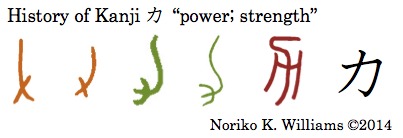
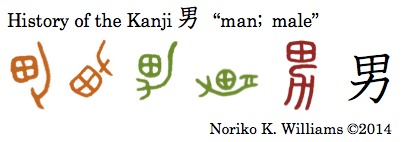
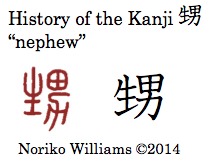
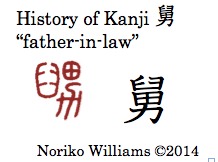
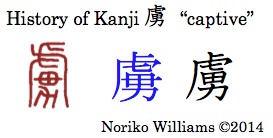
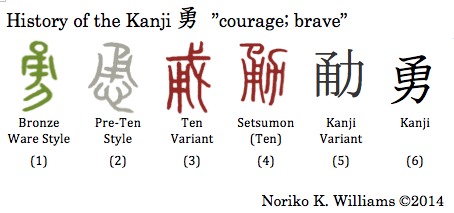
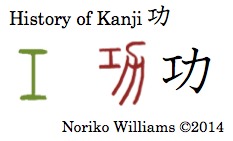
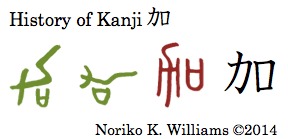
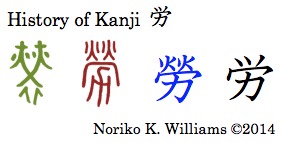
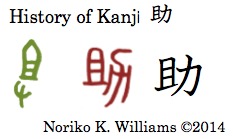
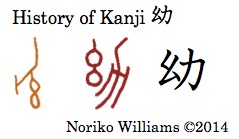
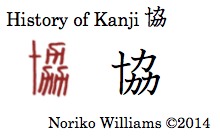

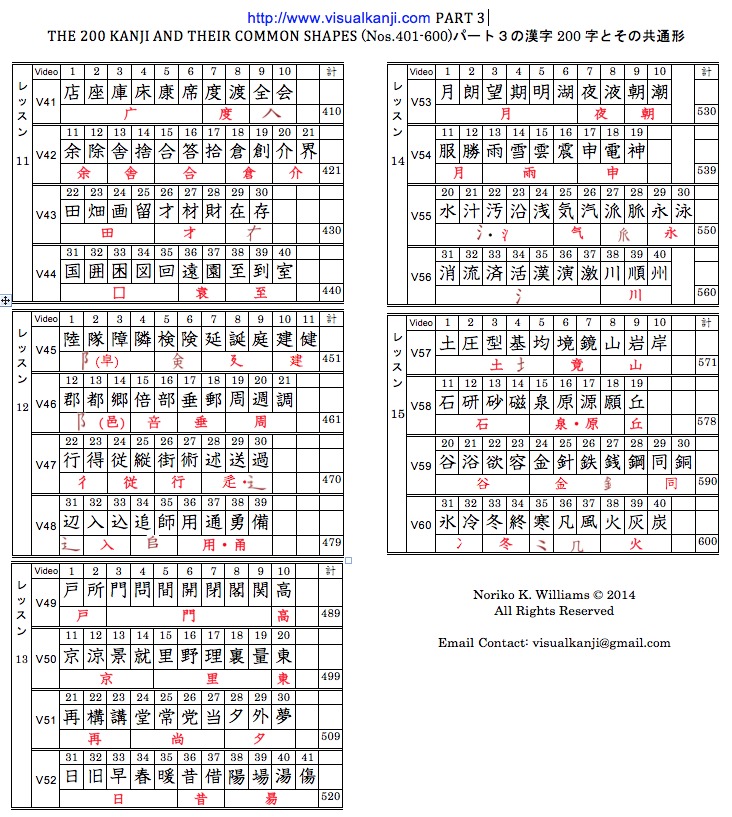
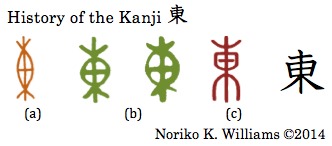

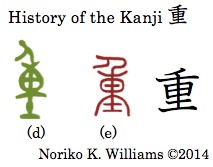
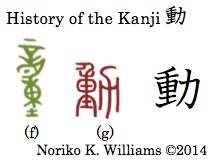
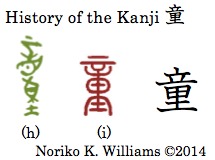
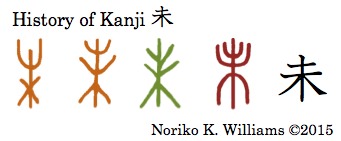
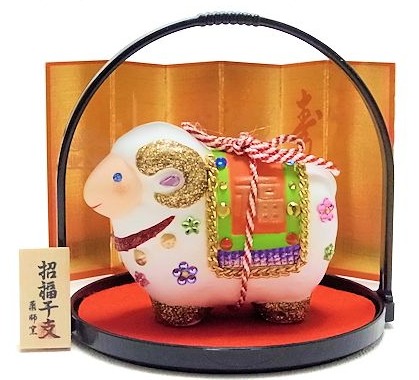
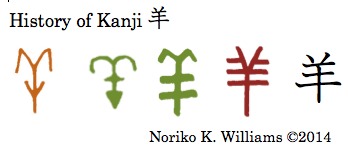
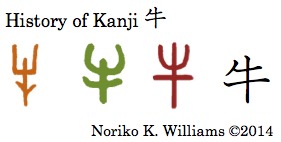
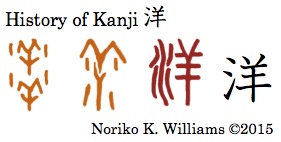
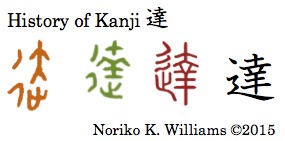

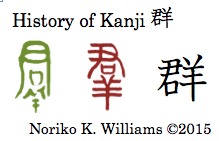
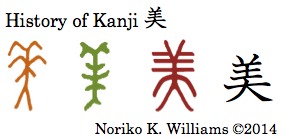
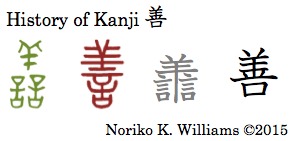

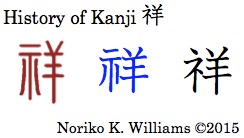

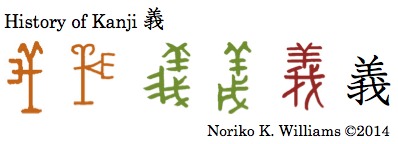
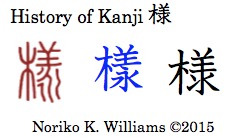
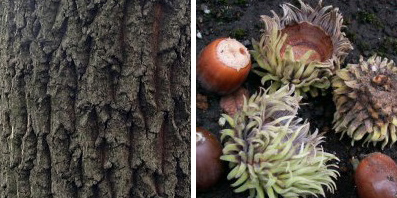
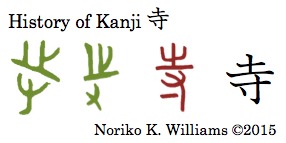
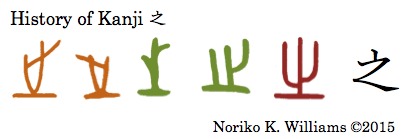
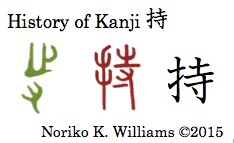

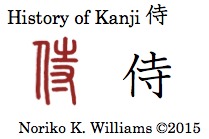
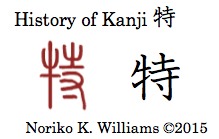
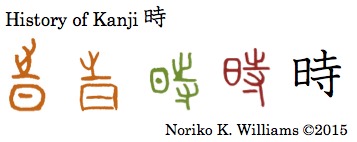
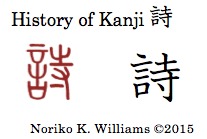
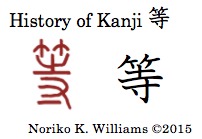

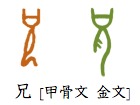
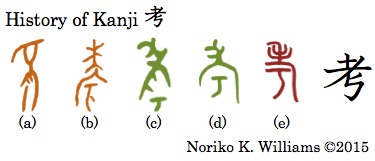
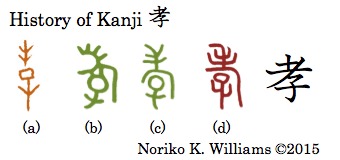
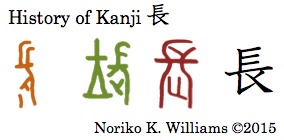
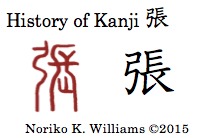
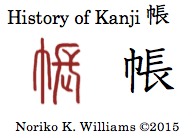
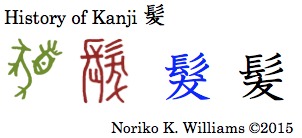

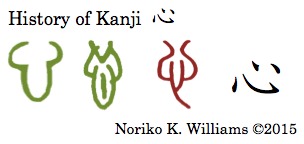

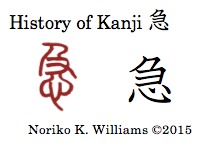
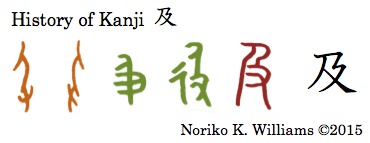
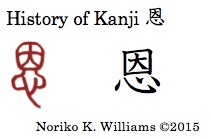
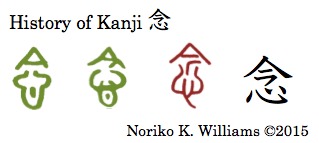
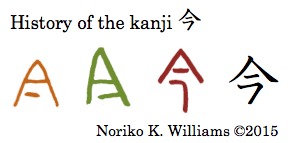

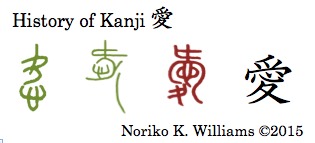
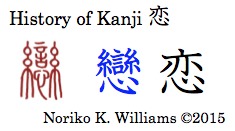
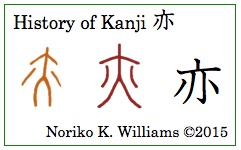
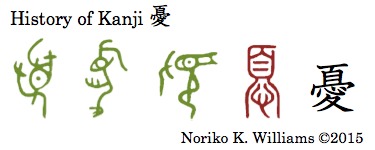 Since we have covered two important kanji 愛 and 恋 for Valentine’s Day today, we move on to a couple of kanji that are closely related to the kanji 愛. The two kanji 愛 and 憂 share the same components with “a heart inside” and “a “backward foot.”
Since we have covered two important kanji 愛 and 恋 for Valentine’s Day today, we move on to a couple of kanji that are closely related to the kanji 愛. The two kanji 愛 and 憂 share the same components with “a heart inside” and “a “backward foot.”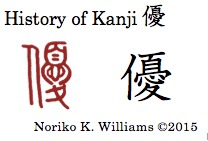
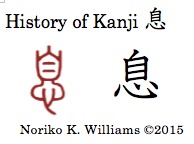
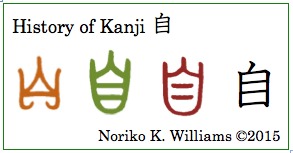
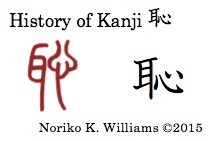
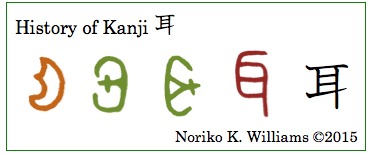
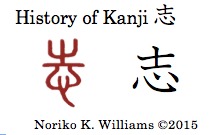
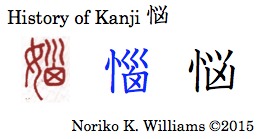
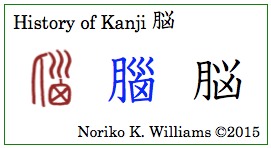
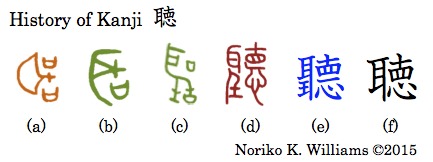
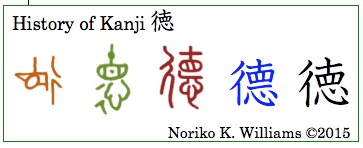
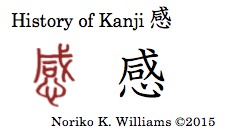
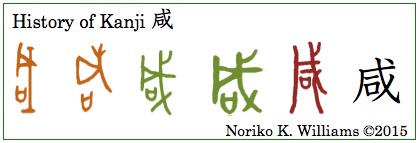

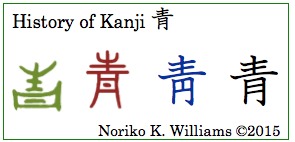
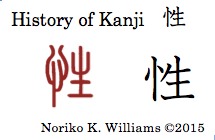
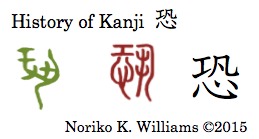
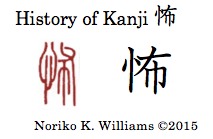

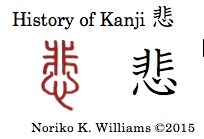
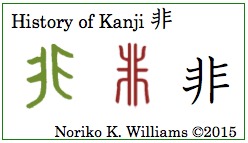
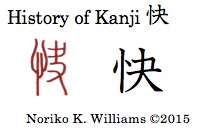
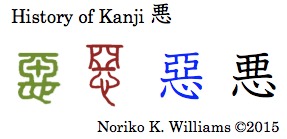
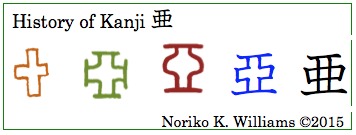
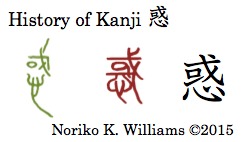
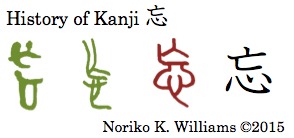
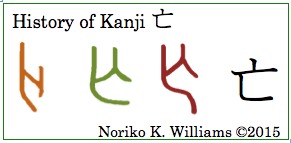
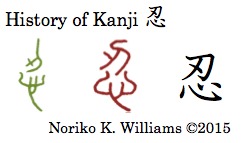
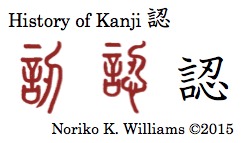
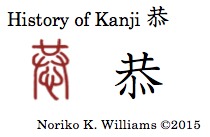
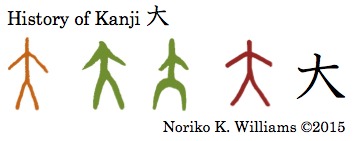
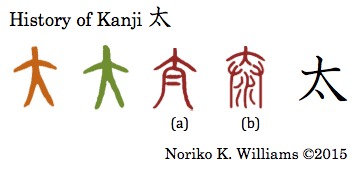
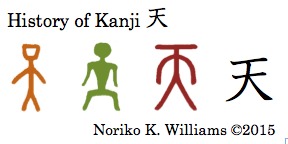

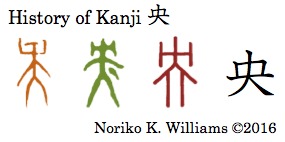 The next three kanji 央 英 and 映 have 央 in common. In the oracle bone style of the kanji 央, it was a man facing front with a yoke around his neck, which meant “bad luck.” Then its original meaning had been dropped and it was used to mean “center; central,” from the fact that the neck was the center of the body. The bronze ware style writing had a short stroke under an arm, but what it signified is not clear. In ten style we see that the shape for “person” was the same as that for 夫. In kanji in both 夫 and 央, “person” returned to the shape 大, in which is easier for us to see the original meaning being “person.”
The next three kanji 央 英 and 映 have 央 in common. In the oracle bone style of the kanji 央, it was a man facing front with a yoke around his neck, which meant “bad luck.” Then its original meaning had been dropped and it was used to mean “center; central,” from the fact that the neck was the center of the body. The bronze ware style writing had a short stroke under an arm, but what it signified is not clear. In ten style we see that the shape for “person” was the same as that for 夫. In kanji in both 夫 and 央, “person” returned to the shape 大, in which is easier for us to see the original meaning being “person.”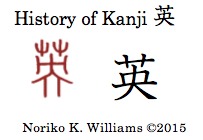
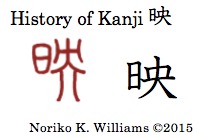
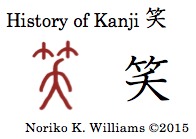
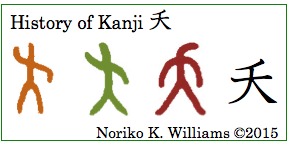
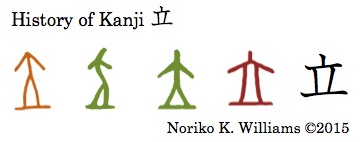
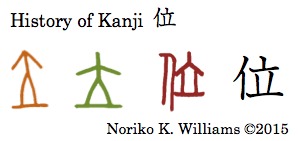
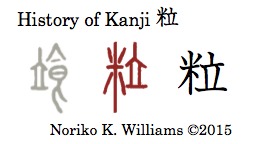
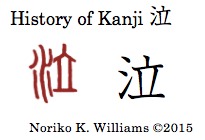
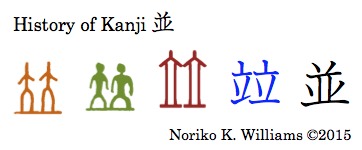
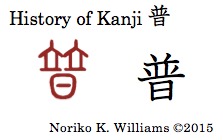
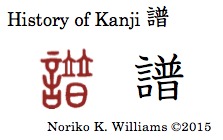
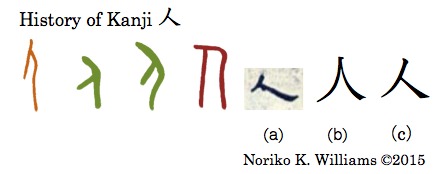
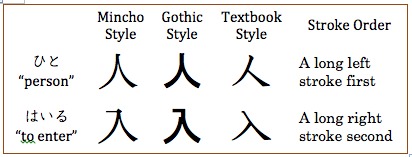
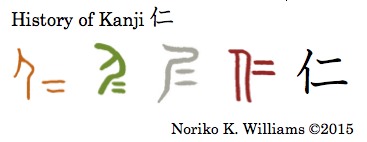
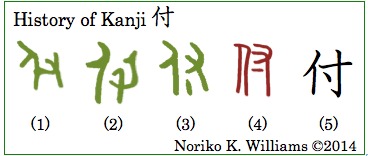
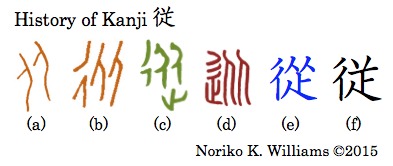
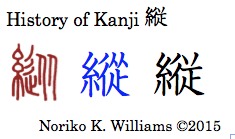

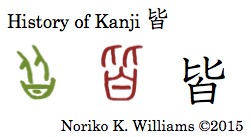
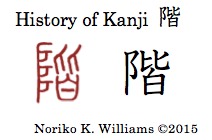
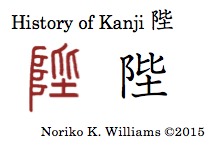
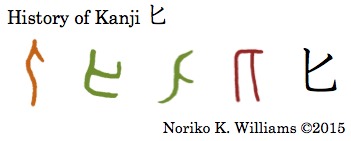
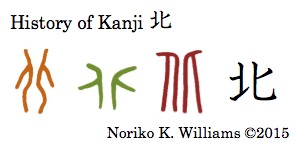
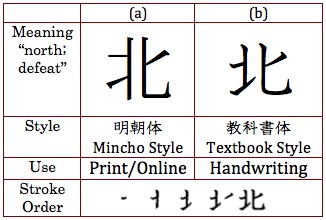
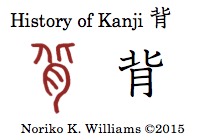
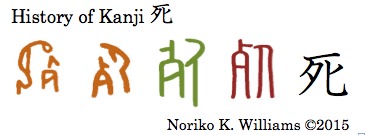
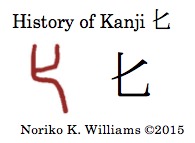
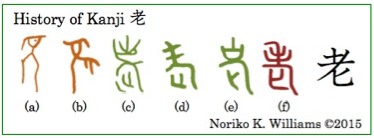
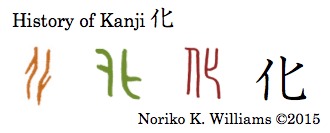
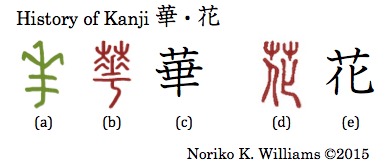
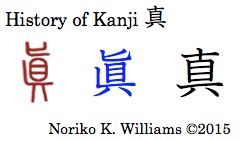
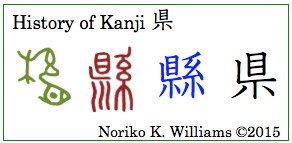
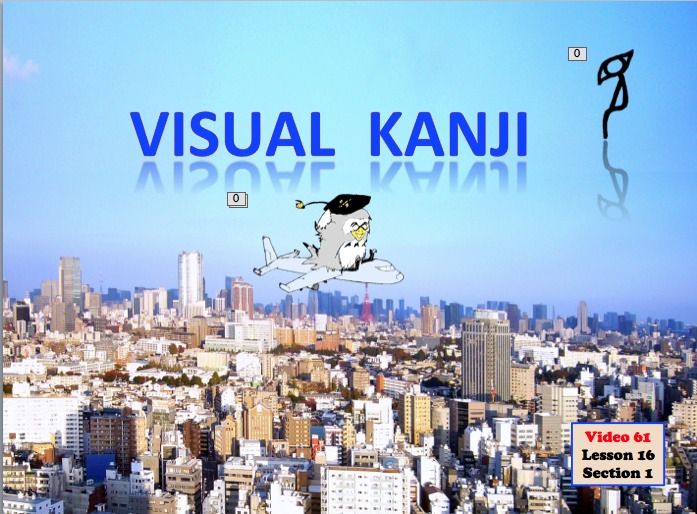

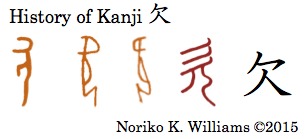
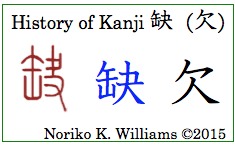
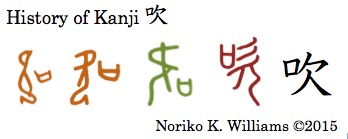
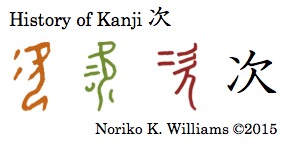
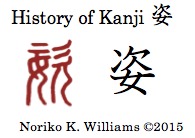
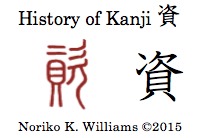
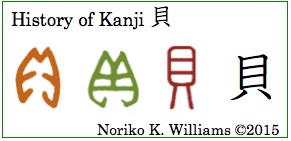
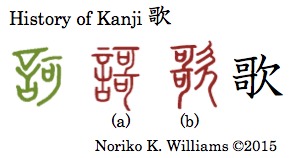
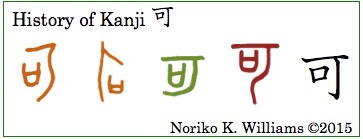

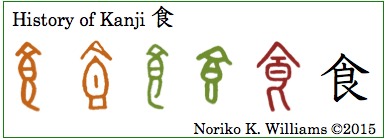
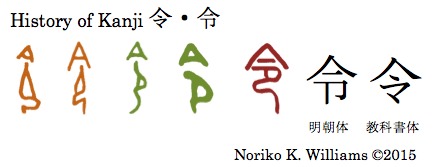
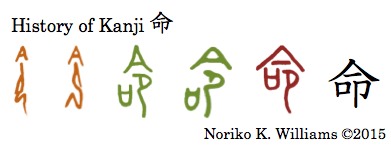
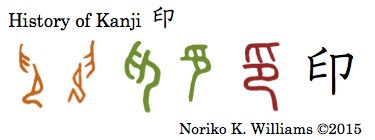
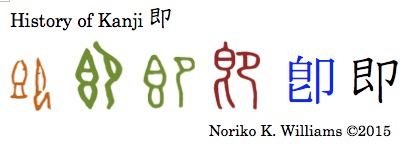

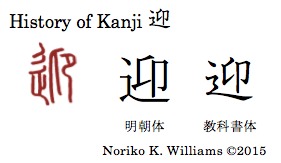
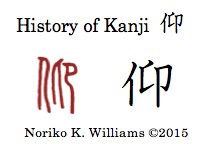

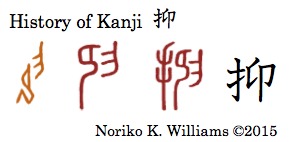
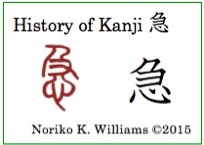
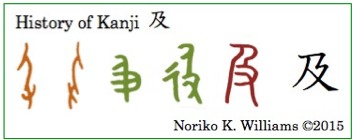
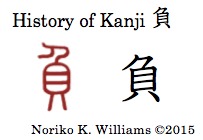
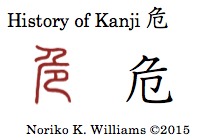
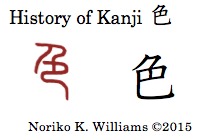
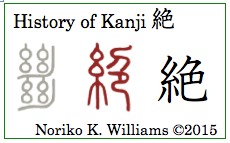
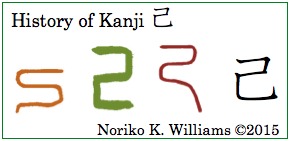
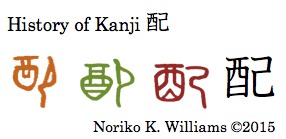
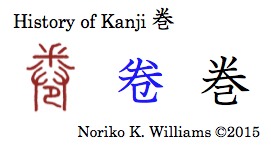
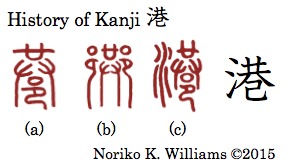

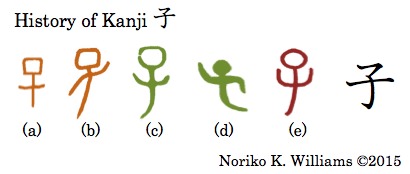
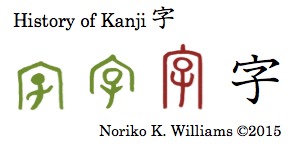

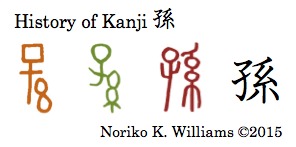
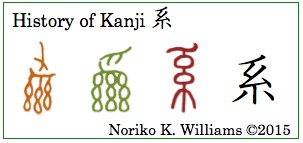
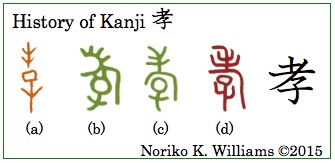
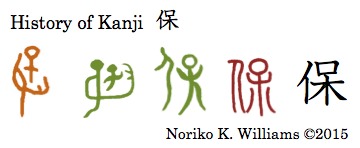
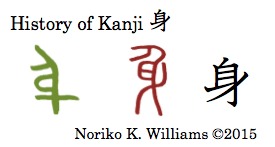
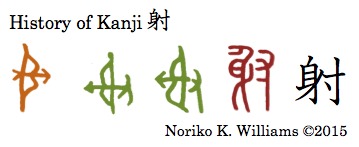

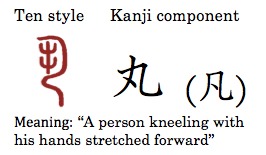
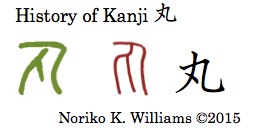
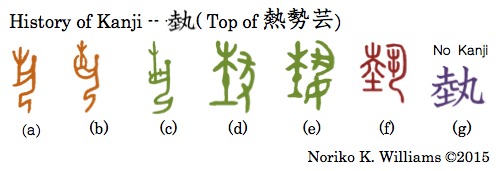
 “to take care of a young plant carefully.” From sample (d) on, the plant was placed on the ground (土) directly. The bulge we see under a plant in (d) signified a lump of soil to celebrate the god of the earth, as shown in the development of the kanji 土 shown on the right. The right side of (d) looks similar to a “dog” in ancient writing, but I cannot find any explanation in the references. In (e), the upper right was a crouched body with two hands and the lower right was a woman. In ten style, (f), the right side went back to having just a crouching person with two hands. In kanji shape, (g), the plant became 土 and ハ. So the component A consist of 土, ハ, 土 and 丸 in kanji. It meant “to nurse a plant” and “hand skills to grow plants; hand skills.”
“to take care of a young plant carefully.” From sample (d) on, the plant was placed on the ground (土) directly. The bulge we see under a plant in (d) signified a lump of soil to celebrate the god of the earth, as shown in the development of the kanji 土 shown on the right. The right side of (d) looks similar to a “dog” in ancient writing, but I cannot find any explanation in the references. In (e), the upper right was a crouched body with two hands and the lower right was a woman. In ten style, (f), the right side went back to having just a crouching person with two hands. In kanji shape, (g), the plant became 土 and ハ. So the component A consist of 土, ハ, 土 and 丸 in kanji. It meant “to nurse a plant” and “hand skills to grow plants; hand skills.”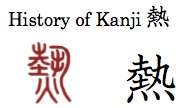
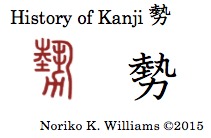


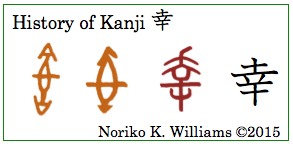
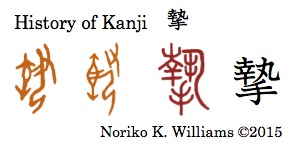

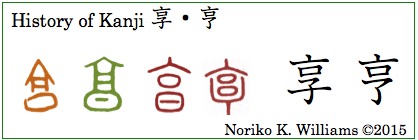
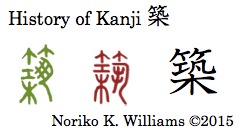
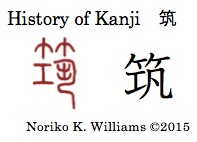
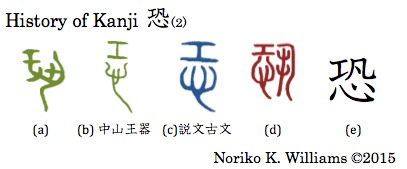
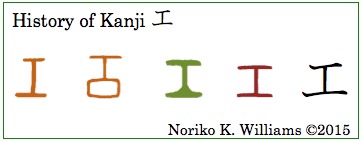
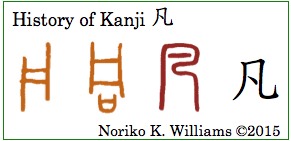

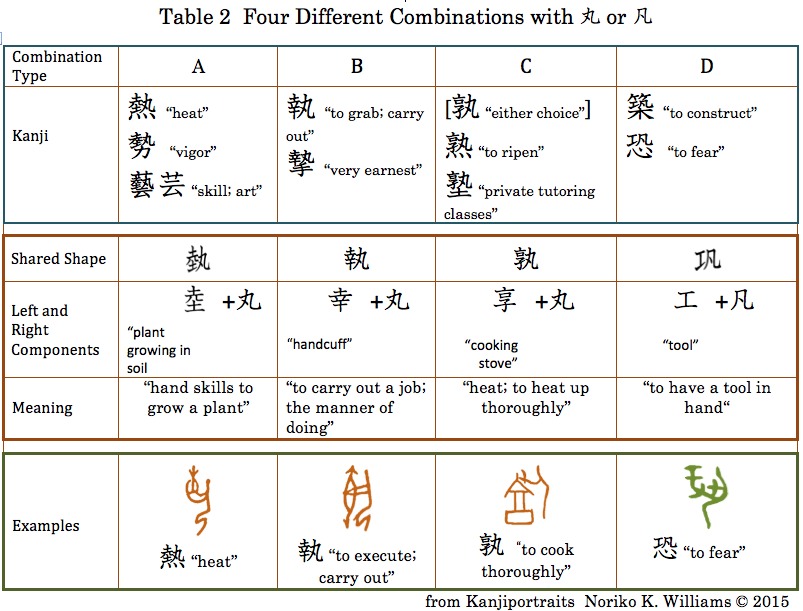
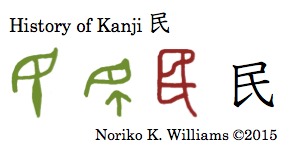
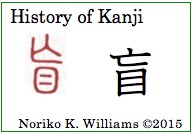

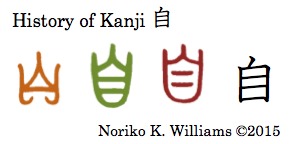
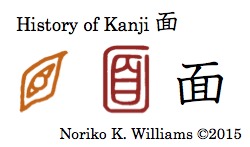

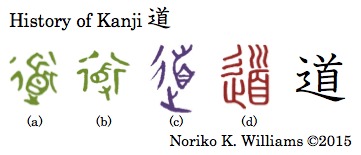
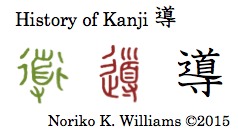
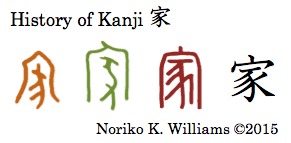
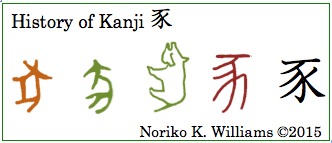
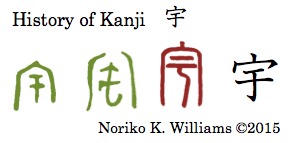
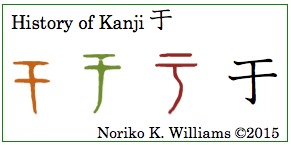
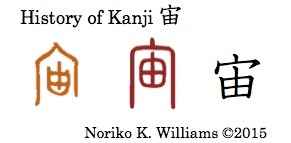
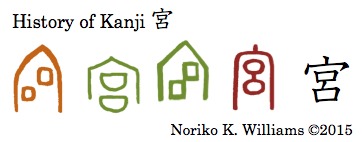
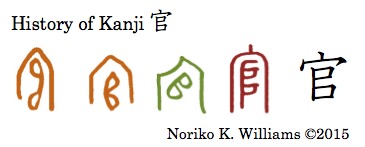
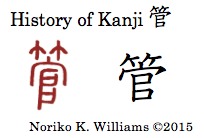
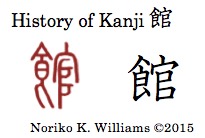
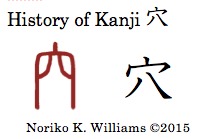
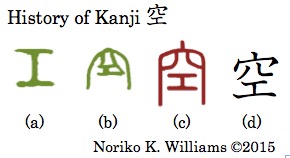
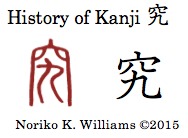
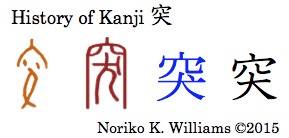
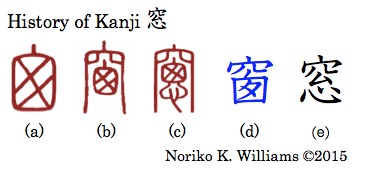
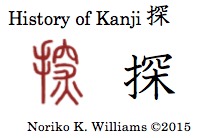
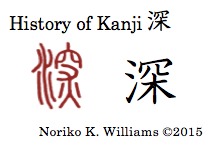
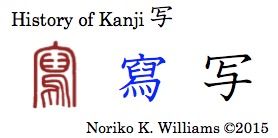

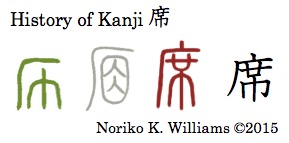
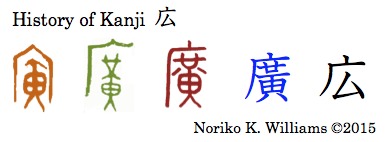
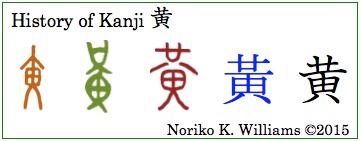
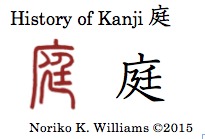
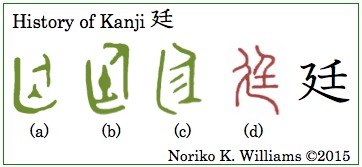
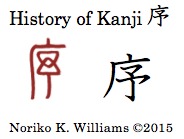
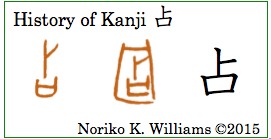
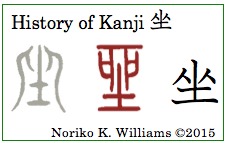
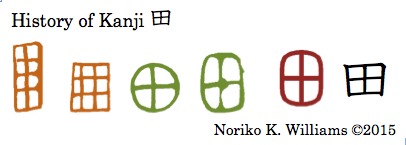
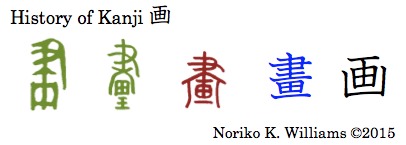
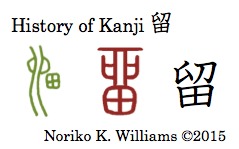

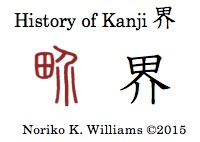
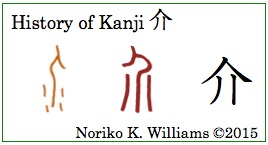
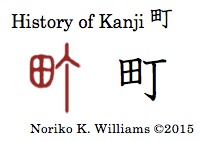
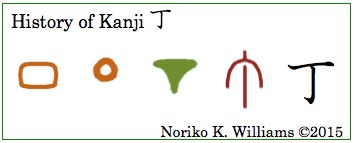
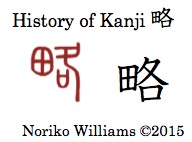
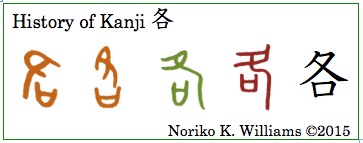
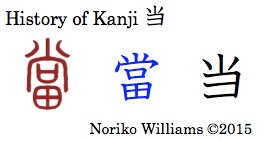
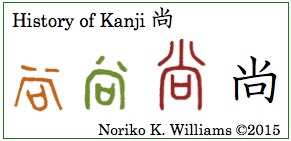
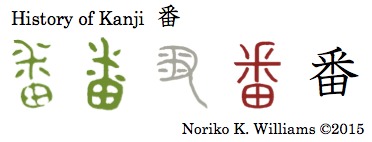
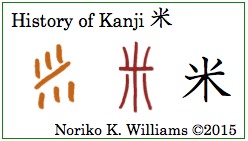
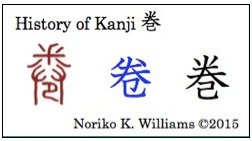
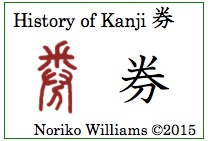
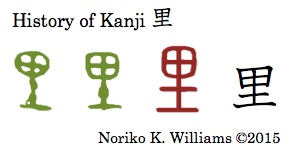
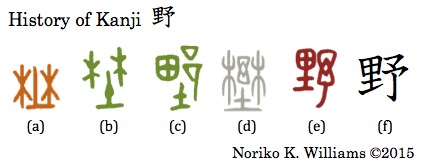
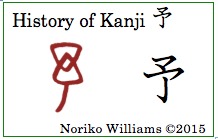
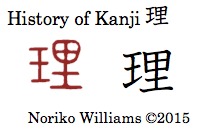
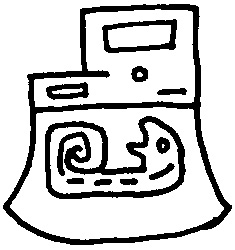
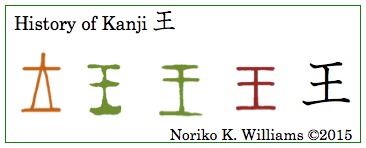
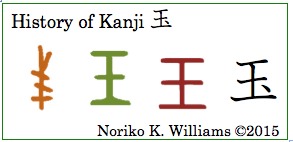
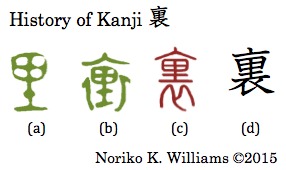
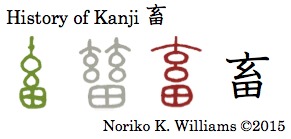


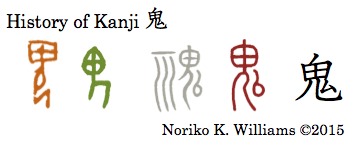
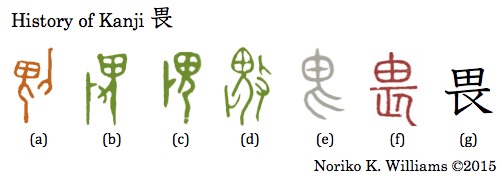
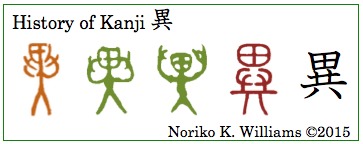

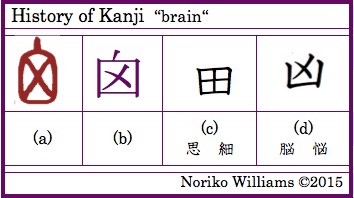
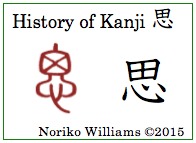
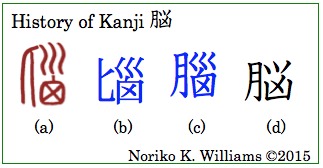
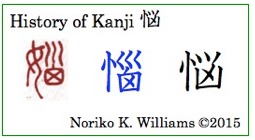
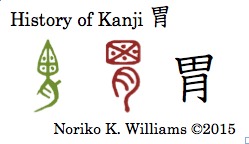
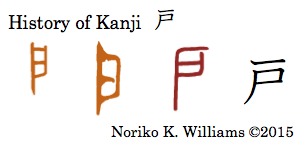
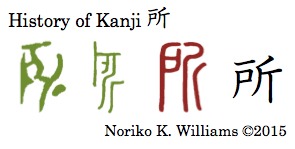

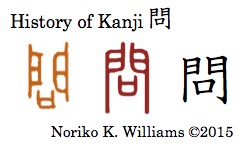
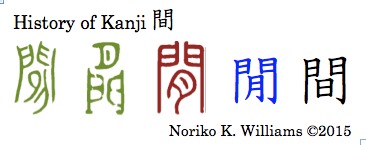
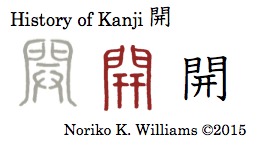
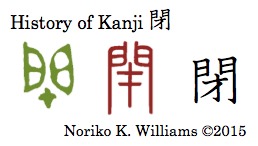
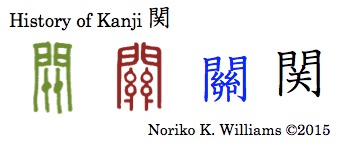
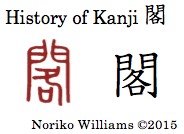
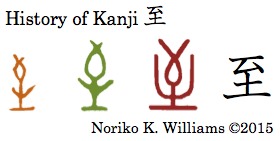

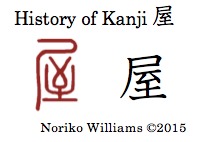
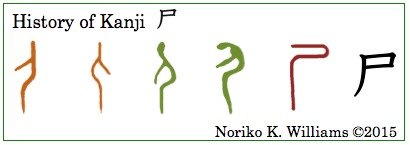
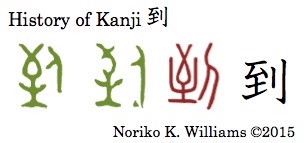
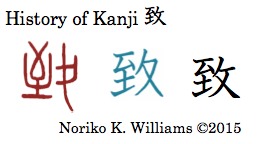
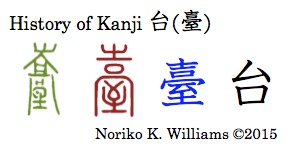

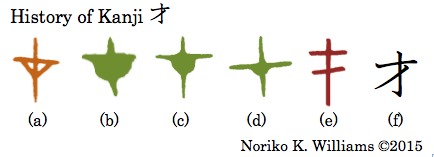
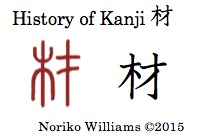
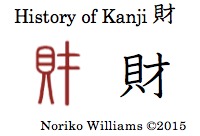



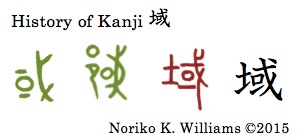
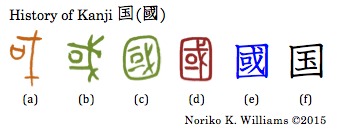
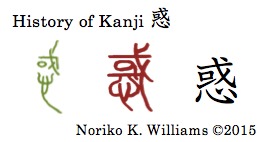
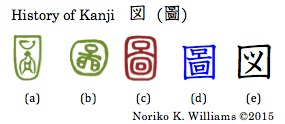
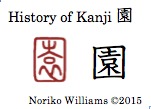

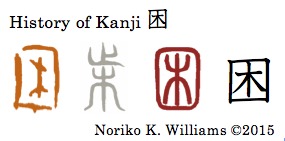
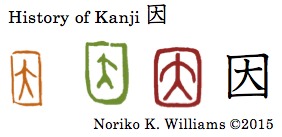
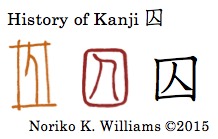
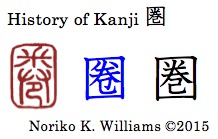

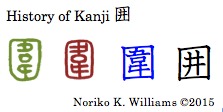
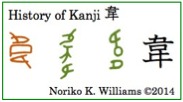
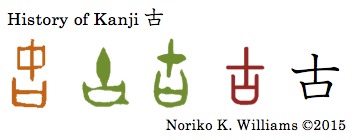
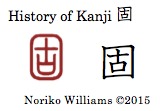
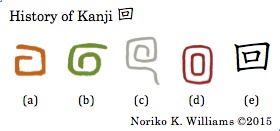
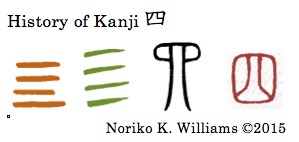

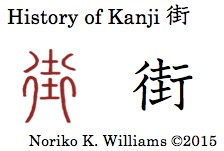
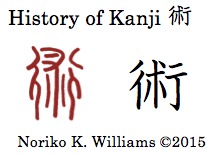
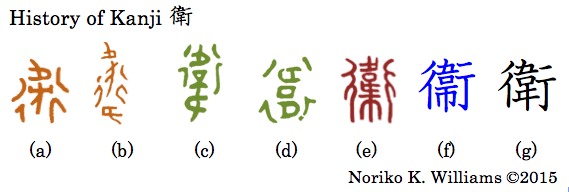

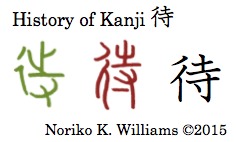

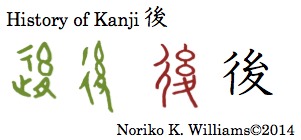

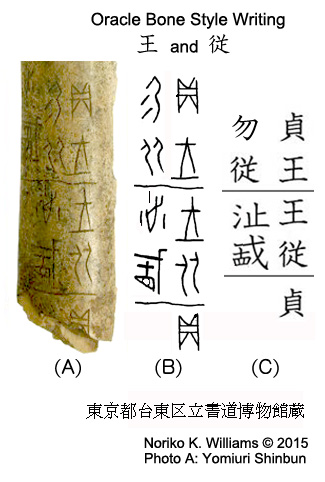 On the right, (A) is a piece of an animal bone with oracle bone writing carved, taken from the article in Yomiuri Shinbun (October 20, 2015). (B) is what I reproduced from the photo. The left side may be incomplete because it is not legible. (C) is the kanji based on my reading with the help of the accompanying article in the paper. (This exhibit did not give out any literature that I was able to bring home.) It reads vertically from the right top to the left bottom. It says “The king (王) asked for a forecast (貞) on whether he would make a certain tribe chief (sanzui and 止) follow (従) him or not.” A new sentence starts from the third writing 王, 従, then moves to the left writing. Even in this tiny piece of cow’s bone (the piece is only one inch-wide), we see two samples of the kanji 従 – They were two people standing, one following another.
On the right, (A) is a piece of an animal bone with oracle bone writing carved, taken from the article in Yomiuri Shinbun (October 20, 2015). (B) is what I reproduced from the photo. The left side may be incomplete because it is not legible. (C) is the kanji based on my reading with the help of the accompanying article in the paper. (This exhibit did not give out any literature that I was able to bring home.) It reads vertically from the right top to the left bottom. It says “The king (王) asked for a forecast (貞) on whether he would make a certain tribe chief (sanzui and 止) follow (従) him or not.” A new sentence starts from the third writing 王, 従, then moves to the left writing. Even in this tiny piece of cow’s bone (the piece is only one inch-wide), we see two samples of the kanji 従 – They were two people standing, one following another.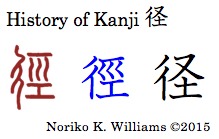
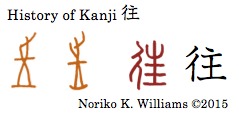

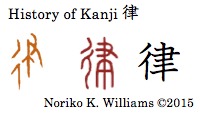
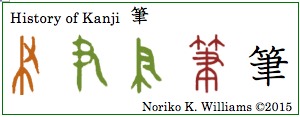
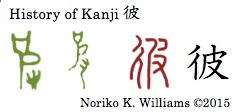


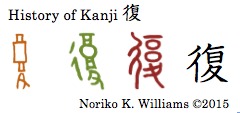
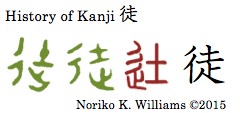
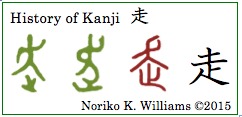
 Bushu Oozato and Kozatohen: The two three-stroke bushu oozato and kozatohen look very much alike or even identical in kanji. The only difference is the position – An oozato appears on the right side whereas a kozatohen appears on the left side (thus, /-hen/). The two bushu, however, came from very different origins, as shown in the samples of the oldest style, oracle bone style (甲骨文), in brown on the left.
Bushu Oozato and Kozatohen: The two three-stroke bushu oozato and kozatohen look very much alike or even identical in kanji. The only difference is the position – An oozato appears on the right side whereas a kozatohen appears on the left side (thus, /-hen/). The two bushu, however, came from very different origins, as shown in the samples of the oldest style, oracle bone style (甲骨文), in brown on the left. The kanji 邑 (/yu’u/ in on-yomi; /mura’/ in kun-yomi) and a bushu oozato share the same origin. The history of the kanji 邑 was well-documented, as shown on the left. In oracle bone style (a), in brown, the square at the top signified an area or a wall surrounding a town, and the bottom was a person who was kneeling, just a person. Together an area where people were meant “village.” In the three bronze ware style samples (b), (c) and (d), in green, we can see how a simplification took place. (d) showed a close connection to the current shape of an oozato. Then in ten style (e), in red, it went back to the shape in which the two original components, an area and a kneeling person, became more recognizable. The bottom shape in (e) in ten style became 巴 in kanji (f). We have seen that a kneeling person undergoing the same development ended up in the shape 卩, a bush hushizukuri, in the earlier post [
The kanji 邑 (/yu’u/ in on-yomi; /mura’/ in kun-yomi) and a bushu oozato share the same origin. The history of the kanji 邑 was well-documented, as shown on the left. In oracle bone style (a), in brown, the square at the top signified an area or a wall surrounding a town, and the bottom was a person who was kneeling, just a person. Together an area where people were meant “village.” In the three bronze ware style samples (b), (c) and (d), in green, we can see how a simplification took place. (d) showed a close connection to the current shape of an oozato. Then in ten style (e), in red, it went back to the shape in which the two original components, an area and a kneeling person, became more recognizable. The bottom shape in (e) in ten style became 巴 in kanji (f). We have seen that a kneeling person undergoing the same development ended up in the shape 卩, a bush hushizukuri, in the earlier post [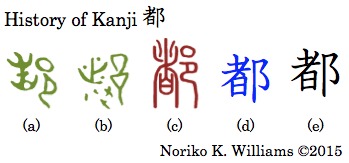 For the kanji 都, we have two samples in bronze ware style here, (a) and (b). The explanation of the left side of these two shapes may be a little peculiar until you see the same shape 者 repeatedly in other kanji. The top was many twigs or wooden writing tablets gathered, and the bottom was a stove to burn them. I imagine that the scattered dots in (b) must be sparks of a fire. Gathering many twigs and things signified “many,” and was used phonetically. The right side was an area and a person, which signified a “village.” The right side of (b) had the same shape as (d) in the kanji 邑 in 1. From “an area where many people live,” it meant “capital” and also “all.”
For the kanji 都, we have two samples in bronze ware style here, (a) and (b). The explanation of the left side of these two shapes may be a little peculiar until you see the same shape 者 repeatedly in other kanji. The top was many twigs or wooden writing tablets gathered, and the bottom was a stove to burn them. I imagine that the scattered dots in (b) must be sparks of a fire. Gathering many twigs and things signified “many,” and was used phonetically. The right side was an area and a person, which signified a “village.” The right side of (b) had the same shape as (d) in the kanji 邑 in 1. From “an area where many people live,” it meant “capital” and also “all.”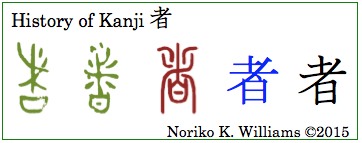 The Kanji 者– The left side of the kanji 都 also appears in a number of kanji, including 者・緒・諸・署・暑・著. The history of 者 is shown on the right. In bronze ware style, the top was sticks or things such as writing tablets gathered, and the bottom was a stove to burn them. The meaning as “person” for 者 was borrowed. In fact in most kanji, this shape was merely used phonetically and had little correspondence to the original meaning. I do wonder if the extra dot in the kyujitai 者, in blue, was a remnant of a spark. All of the kyujitai for 者 as a component had a dot in the middle.
The Kanji 者– The left side of the kanji 都 also appears in a number of kanji, including 者・緒・諸・署・暑・著. The history of 者 is shown on the right. In bronze ware style, the top was sticks or things such as writing tablets gathered, and the bottom was a stove to burn them. The meaning as “person” for 者 was borrowed. In fact in most kanji, this shape was merely used phonetically and had little correspondence to the original meaning. I do wonder if the extra dot in the kyujitai 者, in blue, was a remnant of a spark. All of the kyujitai for 者 as a component had a dot in the middle.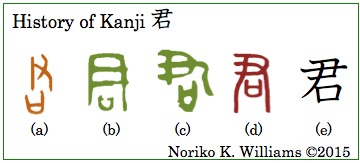 The kanji 君 “lord; you”— In oracle bone style, (a), the top was a hand holding a stick to command, and the bottom was a mouth, signifying “speaking.” Together they originally signified a “tribal chief.” In bronze ware style, in (b) a hand and a stick appeared to coalesce and are hard to make out, but in (c) a hand and a stick were recognizable. In ten style (d), the commanding stick became longer. Someone whose words command people to follow means “lord; sovereign.” It is also used as suffix in addressing someone who is equal or junior to you by a male speaker.
The kanji 君 “lord; you”— In oracle bone style, (a), the top was a hand holding a stick to command, and the bottom was a mouth, signifying “speaking.” Together they originally signified a “tribal chief.” In bronze ware style, in (b) a hand and a stick appeared to coalesce and are hard to make out, but in (c) a hand and a stick were recognizable. In ten style (d), the commanding stick became longer. Someone whose words command people to follow means “lord; sovereign.” It is also used as suffix in addressing someone who is equal or junior to you by a male speaker.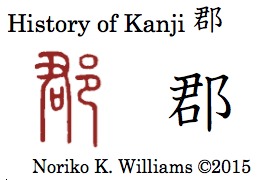 Now back to the kanji 郡. In ten style, the left side 君 was a “chief” or “lord.” The right side had an area with a person or people, which signified a village. Together they signified “an area where a local lord 君 governs.” From that it means a smaller jurisdiction or “county.” In Japan, 郡 /gu’n/ is a consolidation of 町 (“town” /machi’/) and 村 (“village” /mura’/) under the supervision of 県 (“prefecture” /ke’n) and does not have a legal power. There are one 都 /to/ (which is the Tokyo motropolis), forty three 県 /ke’n/, two 府 /hu/ (Osaka and Kyoto 大阪府 京都府) and one 道 /do’o/ (Hokkaido 北海道). In school, children are taught to recite 1都1道2府43県 /i’tto ichi’doo ni’hu yo’njuu sa’nken/ in the order of the size of the jurisdiction 都道府県 /todoohu’ken/.
Now back to the kanji 郡. In ten style, the left side 君 was a “chief” or “lord.” The right side had an area with a person or people, which signified a village. Together they signified “an area where a local lord 君 governs.” From that it means a smaller jurisdiction or “county.” In Japan, 郡 /gu’n/ is a consolidation of 町 (“town” /machi’/) and 村 (“village” /mura’/) under the supervision of 県 (“prefecture” /ke’n) and does not have a legal power. There are one 都 /to/ (which is the Tokyo motropolis), forty three 県 /ke’n/, two 府 /hu/ (Osaka and Kyoto 大阪府 京都府) and one 道 /do’o/ (Hokkaido 北海道). In school, children are taught to recite 1都1道2府43県 /i’tto ichi’doo ni’hu yo’njuu sa’nken/ in the order of the size of the jurisdiction 都道府県 /todoohu’ken/. The kanji 群 — Since we have just seen the kanji 郡 with 君, we add another kanji that contains 君– 群. The top of two bronze ware style samples on the right were the same as (b) for 君, and was used phonetically. It originally was a hand holding a stick and a mouth underneath. The bottom was “sheep.” Sheep stay in a flock, and it signified “to flock.” The kanji 群 meant “group; throng; herd; flock.”
The kanji 群 — Since we have just seen the kanji 郡 with 君, we add another kanji that contains 君– 群. The top of two bronze ware style samples on the right were the same as (b) for 君, and was used phonetically. It originally was a hand holding a stick and a mouth underneath. The bottom was “sheep.” Sheep stay in a flock, and it signified “to flock.” The kanji 群 meant “group; throng; herd; flock.”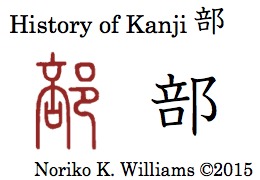 For the kanji 部, the left side was used phonetically to mean “to divide.” The right side had an area and a person, that is, a village. Together they signified “to divide a village into parts.” From that it meant “part; portion” of a whole or “department; section” of a larger organization.
For the kanji 部, the left side was used phonetically to mean “to divide.” The right side had an area and a person, that is, a village. Together they signified “to divide a village into parts.” From that it meant “part; portion” of a whole or “department; section” of a larger organization.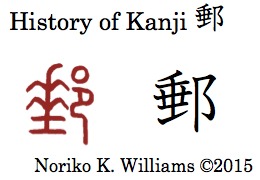 For the kanji 郵, the left side 垂 had the meaning “frontier; peripheral area.” The right side was an area and a person, signifying “village.” Together they signified “postings along the road to the frontier that a messenger passed.” It meant “post; postal service.”
For the kanji 郵, the left side 垂 had the meaning “frontier; peripheral area.” The right side was an area and a person, signifying “village.” Together they signified “postings along the road to the frontier that a messenger passed.” It meant “post; postal service.”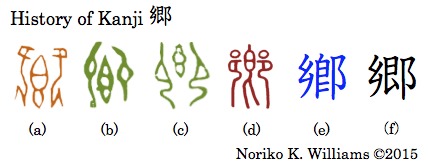 For the kanji 郷, in oracle bone style (a) it had two people sitting, facing each other with food in a bowl in the middle. It signified a “feast.” In bronze ware style (b) and (c) the components were the same. In ten style, however, above each of the two people, an area was added making it to 邑 “village” in mirror images. In the center was the shape we see in the kanji 食 “food in a bowl” (食 has a cover over the food). So, in ten style “feast” seemed to have expanded to the whole village! Having a feast for people was an important event for a village. It meant “hometown.” I like the story behind those ancient writings from (a) through (d) much better than just a sort of confusing shape of the kanji 郷.
For the kanji 郷, in oracle bone style (a) it had two people sitting, facing each other with food in a bowl in the middle. It signified a “feast.” In bronze ware style (b) and (c) the components were the same. In ten style, however, above each of the two people, an area was added making it to 邑 “village” in mirror images. In the center was the shape we see in the kanji 食 “food in a bowl” (食 has a cover over the food). So, in ten style “feast” seemed to have expanded to the whole village! Having a feast for people was an important event for a village. It meant “hometown.” I like the story behind those ancient writings from (a) through (d) much better than just a sort of confusing shape of the kanji 郷.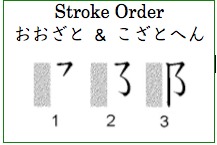 The stroke order of oozato and kozatohen is unusual, or “counter intuitive” as my former students used to complain in their kanji quizzes. The vertical line is the last stroke, as shown on the left. In the next two posts, we are going to look at kanji with a kozatohen. [November 8, 2015]
The stroke order of oozato and kozatohen is unusual, or “counter intuitive” as my former students used to complain in their kanji quizzes. The vertical line is the last stroke, as shown on the left. In the next two posts, we are going to look at kanji with a kozatohen. [November 8, 2015]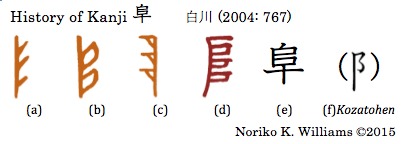 The three different views on what a kozatohen originally signified can be summarized as follows:
The three different views on what a kozatohen originally signified can be summarized as follows: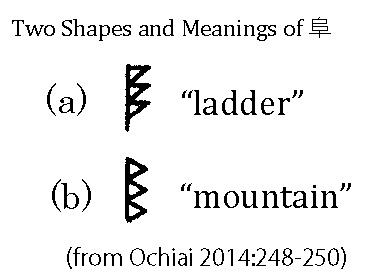 [B. A mountain or hills] This explanation was found in the account in Setsumon. It was the image of a mountain range or hills that was placed vertically. According to Ochiai (2014) there originally existed two different shapes and meanings, as shown on the right. (a) was a “ladder” and (b) was a “mountain,” but the distinction got lost later on. Ochiai has dealt with a large pool of oracle bone style writings, so I assume that he came to this conclusion based on them. Even though I was not able to find any example of (b) among oracle bone style writings that I collected from Akai (2010), some bronze ware style samples may be interpreted as (b).
[B. A mountain or hills] This explanation was found in the account in Setsumon. It was the image of a mountain range or hills that was placed vertically. According to Ochiai (2014) there originally existed two different shapes and meanings, as shown on the right. (a) was a “ladder” and (b) was a “mountain,” but the distinction got lost later on. Ochiai has dealt with a large pool of oracle bone style writings, so I assume that he came to this conclusion based on them. Even though I was not able to find any example of (b) among oracle bone style writings that I collected from Akai (2010), some bronze ware style samples may be interpreted as (b).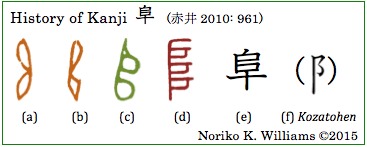 [C. A pack of dirt or soil raised high] The third meaning is what the samples listed in Akai shown on the right signified — two oblong shapes stacked up. (The shapes (a), (b) and (c) appear in other kanji and are interpreted differently. We will look at these shapes at a later time.) The Kanjigen dictionary by Todo and et. al. took the view that a kozatohen came from “round shaped dirt that were piled up.” In the Key to Kanji, I used this explanation in some kanji.
[C. A pack of dirt or soil raised high] The third meaning is what the samples listed in Akai shown on the right signified — two oblong shapes stacked up. (The shapes (a), (b) and (c) appear in other kanji and are interpreted differently. We will look at these shapes at a later time.) The Kanjigen dictionary by Todo and et. al. took the view that a kozatohen came from “round shaped dirt that were piled up.” In the Key to Kanji, I used this explanation in some kanji. The kanji 降 was discussed earlier in connection with two downward-facing feet (a right and left foot) [in
The kanji 降 was discussed earlier in connection with two downward-facing feet (a right and left foot) [in 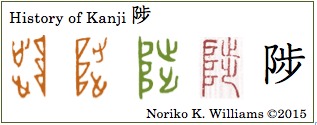 On the right side is the history of the kanji 陟 /cho’ku/, a kanji that is no longer used in Japanese, but meant “to climb up.” The right side of 陟 was 步, the kyujitai for 歩, which originated from two forward-facing (or upward-facing) footprints. In contrast the right side of the kanji 降 had two downward-facing footprints. So the difference is that one (陟) was two feet of a person climbing up the ladder whereas the other (降) was two feet of climbing down. I find this contrast very amusing. The kanji 降 has many meanings — please read the earlier post.
On the right side is the history of the kanji 陟 /cho’ku/, a kanji that is no longer used in Japanese, but meant “to climb up.” The right side of 陟 was 步, the kyujitai for 歩, which originated from two forward-facing (or upward-facing) footprints. In contrast the right side of the kanji 降 had two downward-facing footprints. So the difference is that one (陟) was two feet of a person climbing up the ladder whereas the other (降) was two feet of climbing down. I find this contrast very amusing. The kanji 降 has many meanings — please read the earlier post.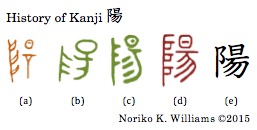 For the kanji 陽 in oracle bone style the left side was “mountains” (Kadokawa dictionary) or a ladder for a god (Shirakawa). In oracle bone style (a), the top of the right side 昜 was “the sun” and the bottom was a “raised altar table,” together signifying “the sun rising high.” Both sides together, “the sun rising high and hitting the mountains” meant “being bright with the sun.” In bronze ware style the line in (b) and the three slanted lines in (c) were the rays of the sun. In ten style (d), the left side became the stylized shape that appeared in all ten style kozatohen. In kanji (e), the kozatohen is squeezed into a narrower space, and the first two strokes become smaller than a oozato, thus ko-zato-hen. The kanji 陽 means “sunny; cheerful; positive.”
For the kanji 陽 in oracle bone style the left side was “mountains” (Kadokawa dictionary) or a ladder for a god (Shirakawa). In oracle bone style (a), the top of the right side 昜 was “the sun” and the bottom was a “raised altar table,” together signifying “the sun rising high.” Both sides together, “the sun rising high and hitting the mountains” meant “being bright with the sun.” In bronze ware style the line in (b) and the three slanted lines in (c) were the rays of the sun. In ten style (d), the left side became the stylized shape that appeared in all ten style kozatohen. In kanji (e), the kozatohen is squeezed into a narrower space, and the first two strokes become smaller than a oozato, thus ko-zato-hen. The kanji 陽 means “sunny; cheerful; positive.” The kanji 場 “place”: The component 昜 “to rise high” also appears in the kanji 場. The left side was a mound of soil or ground (土). 昜 was phonetically used. Both sides together they meant a place where the sun shined. The meaning of a sunny place became expanded to mean a “place” in general. The ten style of 場 is shown on the right. As we can see the kanji 陽 had oracle bone style and bronze ware style whereas 場 did not. It tells us that the kanji 場 was a kanji that appeared much later than 陽.
The kanji 場 “place”: The component 昜 “to rise high” also appears in the kanji 場. The left side was a mound of soil or ground (土). 昜 was phonetically used. Both sides together they meant a place where the sun shined. The meaning of a sunny place became expanded to mean a “place” in general. The ten style of 場 is shown on the right. As we can see the kanji 陽 had oracle bone style and bronze ware style whereas 場 did not. It tells us that the kanji 場 was a kanji that appeared much later than 陽.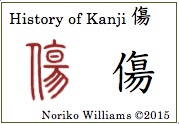 The kanji 傷 “injury”: The kanji 傷 (/kizu/ “injury and /sho’o/ in on-yomi) is among the educational kanji, so let us look at it in connection with 昜. In ten style and kanji it consists of a ninben “person” and a cover on top of 昜 “rays of the sun; bright.” Many scholars view that 昜 was used purely phonetically and has no relation to its original meaning. On the other hand Shirakawa explained that 昜 consisted of a jewel placed on a table that emitted rays. The top of the right side of 傷 was a cover over the jewel. The cover prevented the power of the jewel to work in a religious rite, thus “harm; damage.” With a ninben, it meant an injury on a person.
The kanji 傷 “injury”: The kanji 傷 (/kizu/ “injury and /sho’o/ in on-yomi) is among the educational kanji, so let us look at it in connection with 昜. In ten style and kanji it consists of a ninben “person” and a cover on top of 昜 “rays of the sun; bright.” Many scholars view that 昜 was used purely phonetically and has no relation to its original meaning. On the other hand Shirakawa explained that 昜 consisted of a jewel placed on a table that emitted rays. The top of the right side of 傷 was a cover over the jewel. The cover prevented the power of the jewel to work in a religious rite, thus “harm; damage.” With a ninben, it meant an injury on a person.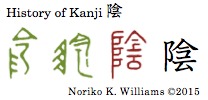 The kanji that makes a contrast with 陽 is the kanji 陰. The two kanji make up the widely recognizable phrase, even in the west, “ying and yang” 陰陽. We notice that both have a kozatohen. The history of the kanji 陰 is shown on the left. In the two bronze ware style samples the left sides showed very different shapes of a kozatohen. The right side consisted of a “cover” above a “cloud.” With mountains on the left side (kozatohen), 陰 meant the dark side of mountain where clouds covered. It means “shadow; shade; gloomy; wily.”
The kanji that makes a contrast with 陽 is the kanji 陰. The two kanji make up the widely recognizable phrase, even in the west, “ying and yang” 陰陽. We notice that both have a kozatohen. The history of the kanji 陰 is shown on the left. In the two bronze ware style samples the left sides showed very different shapes of a kozatohen. The right side consisted of a “cover” above a “cloud.” With mountains on the left side (kozatohen), 陰 meant the dark side of mountain where clouds covered. It means “shadow; shade; gloomy; wily.”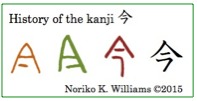 The kanji 今 and 雲 (云) The right side of the kanji 陰 consisted of two kanji, 今 and cloud 云. The kanji 今 means “present time” now, but it was borrowed from the shape that was “a cover or stopper/plug of a bottle”.
The kanji 今 and 雲 (云) The right side of the kanji 陰 consisted of two kanji, 今 and cloud 云. The kanji 今 means “present time” now, but it was borrowed from the shape that was “a cover or stopper/plug of a bottle”.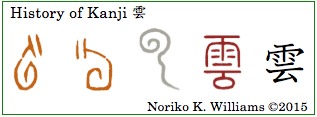 For the kanji 雲 “cloud,” the two oracle bone style samples shown on the right were the mirror images of each other in which a cloud was rising. The shape in gray on the right was given in Setsumon as a 古文. In ten style, a bushu amekanmuri “rain; meteorological phenomenon” was added. The kanji 雲 means “cloud.”
For the kanji 雲 “cloud,” the two oracle bone style samples shown on the right were the mirror images of each other in which a cloud was rising. The shape in gray on the right was given in Setsumon as a 古文. In ten style, a bushu amekanmuri “rain; meteorological phenomenon” was added. The kanji 雲 means “cloud.”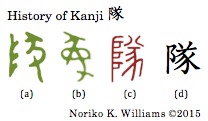 For the kanji 隊 in bronze ware style, (a) had a kozatohen, while (b) did not. The right side was a fat pig with big ears. Shirakawa viewed that the pig was a sacrificial animal placed in front of a ladder for a god. He cited that in Setsumon there was no 隊 but 墜 was used. 墜 had soil (土) at the bottom and meant “falling from a high place to the ground.” In other views, including the Kadokawa dictionary and Kanjigen, a pig was used phonetically and meant something bulky and heavy like a pig. A “band of people” was an extended meaning.
For the kanji 隊 in bronze ware style, (a) had a kozatohen, while (b) did not. The right side was a fat pig with big ears. Shirakawa viewed that the pig was a sacrificial animal placed in front of a ladder for a god. He cited that in Setsumon there was no 隊 but 墜 was used. 墜 had soil (土) at the bottom and meant “falling from a high place to the ground.” In other views, including the Kadokawa dictionary and Kanjigen, a pig was used phonetically and meant something bulky and heavy like a pig. A “band of people” was an extended meaning. For the kanji 陸 we have three samples of bronze ware style here. The shapes of a kozatohen in (a) and (b) may be appropriate to view as mountains or hills (placed vertically), whereas in (c) it is hard to see mountains in the shape. In (b) the mountain shape appeared on both sides. Then what was the right side in (a) and (c) or the middle in (b)? In The Key to Kanji I treated them as “two tent-like structures and a mound of earth.” I based this on (c) with Shirakawa’s account in mind. In the absence of a better explanation, we can leave it as it is. The kanji 陸 means “land.”
For the kanji 陸 we have three samples of bronze ware style here. The shapes of a kozatohen in (a) and (b) may be appropriate to view as mountains or hills (placed vertically), whereas in (c) it is hard to see mountains in the shape. In (b) the mountain shape appeared on both sides. Then what was the right side in (a) and (c) or the middle in (b)? In The Key to Kanji I treated them as “two tent-like structures and a mound of earth.” I based this on (c) with Shirakawa’s account in mind. In the absence of a better explanation, we can leave it as it is. The kanji 陸 means “land.”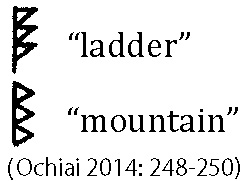 We are looking at kanji with a kozatohen, keeping in mind that each may have originated from three different meanings and, possibly, shapes. Ochiai (2014) gave two different original shapes of a kozatohen in which the three triangles were placed differently – one with a horizontal line at the top (for a “ladder”), and the other with a peak of each of three triangles being in the center if you look at them sideways (for “mountains; hills”). He said that these two shapes converged into one. We have also seen the third meaning, “a stack of soil raised high.” Over the last couple of weeks as I looked at these three different shapes and meanings, they started to mingle together and the lines among them became blurred in my mind. A ladder suggests something “high.” A ladder could be flights of dirt stairs. An undulating line of mountains or hills suggests ground that is high and low. Hills are mounds of soil, etc. Keeping all these – a ladder, stairs, mountains/hills, high ground- in mind – we move on to look at more kanji.
We are looking at kanji with a kozatohen, keeping in mind that each may have originated from three different meanings and, possibly, shapes. Ochiai (2014) gave two different original shapes of a kozatohen in which the three triangles were placed differently – one with a horizontal line at the top (for a “ladder”), and the other with a peak of each of three triangles being in the center if you look at them sideways (for “mountains; hills”). He said that these two shapes converged into one. We have also seen the third meaning, “a stack of soil raised high.” Over the last couple of weeks as I looked at these three different shapes and meanings, they started to mingle together and the lines among them became blurred in my mind. A ladder suggests something “high.” A ladder could be flights of dirt stairs. An undulating line of mountains or hills suggests ground that is high and low. Hills are mounds of soil, etc. Keeping all these – a ladder, stairs, mountains/hills, high ground- in mind – we move on to look at more kanji. For the kanji 阪, the left side of the bronze ware style, in green, would be a good candidate for the interpretation “hills placed vertically.” It gave the meaning that is something to do with soil. The right side 反 is a familiar shape in many kanji, such as 反阪坂返板叛版, all of which have the sound /ha’n/ or /he’n/, and form semantic-phonetic composite kanji. Let us look at the kanji 反 first.
For the kanji 阪, the left side of the bronze ware style, in green, would be a good candidate for the interpretation “hills placed vertically.” It gave the meaning that is something to do with soil. The right side 反 is a familiar shape in many kanji, such as 反阪坂返板叛版, all of which have the sound /ha’n/ or /he’n/, and form semantic-phonetic composite kanji. Let us look at the kanji 反 first.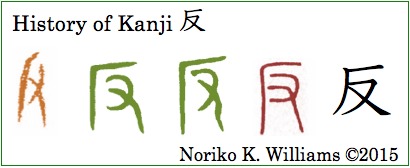 The Kanji 反: In the Key to Kanji I explained that it was “a hand pushing back a piece of cloth, indicating ‘to push back, to roll back or to reverse.’” The Kadokawa dictionary, Kanjigen and Shin-Kangorin (2011) all take this view. The history of the kanji 反 is shown on the right. Now looking at the earlier shapes in oracle bone style, in brown, and bronze ware style, I wonder if the upper left shape really looks like a hanging cloth. Usually the upper left (厂), a bushu gandare in kanji, is viewed as a “cliff.” If we take it as a “cliff,” what does “a hand under or against a cliff” mean? Shirakawa’s explanation is that putting hands against a sacred area to climb in was sacrilege or disrespect, thus it meant “against.” I need to see more examples for this view to make sense. So, in the mean time, I just leave my explanation in the book as it is.
The Kanji 反: In the Key to Kanji I explained that it was “a hand pushing back a piece of cloth, indicating ‘to push back, to roll back or to reverse.’” The Kadokawa dictionary, Kanjigen and Shin-Kangorin (2011) all take this view. The history of the kanji 反 is shown on the right. Now looking at the earlier shapes in oracle bone style, in brown, and bronze ware style, I wonder if the upper left shape really looks like a hanging cloth. Usually the upper left (厂), a bushu gandare in kanji, is viewed as a “cliff.” If we take it as a “cliff,” what does “a hand under or against a cliff” mean? Shirakawa’s explanation is that putting hands against a sacred area to climb in was sacrilege or disrespect, thus it meant “against.” I need to see more examples for this view to make sense. So, in the mean time, I just leave my explanation in the book as it is.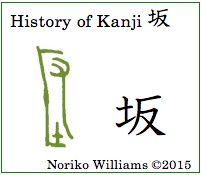 The kanji 坂 “slope”: In Japanese for the kanji that means “slope” we use the kanji 坂, with a bushu tsuchihen (土) “soil.” The kanji 坂 is newer kanji and was not included in Setsumon Kaiji. But, interestingly, Akai (2010) gave the bronze ware style sample shown on the right. (I do not know from which source this shape was taken.) It had a cliff with a slight bulge in the middle for an emphasis, soil (土) at the bottom, and a hand (又) on the right side. The image may be a person trying to climb a cliff putting his hands against it.
The kanji 坂 “slope”: In Japanese for the kanji that means “slope” we use the kanji 坂, with a bushu tsuchihen (土) “soil.” The kanji 坂 is newer kanji and was not included in Setsumon Kaiji. But, interestingly, Akai (2010) gave the bronze ware style sample shown on the right. (I do not know from which source this shape was taken.) It had a cliff with a slight bulge in the middle for an emphasis, soil (土) at the bottom, and a hand (又) on the right side. The image may be a person trying to climb a cliff putting his hands against it. For the kanji 陳, the two bronze ware style samples on the left had a kozatohen. and what would become the kanji 東, which originally meant “a bag of stuff or dirt tied at both ends.” (We are coming back to this in a second.) In the first bronze ware style sample, the shape on the far right was a bushu bokuzukuri (攵) “to do; cause an action”( from a hand moving a stick.) In the second sample, the bottom was “soil” (土). Together they meant displaying bags of stuff or soil tied on the both ends. From this meaning we interpret the kozatohen in this kanji to mean a stack of dirt (– unless we take the view that bags of soil were placed in front of the divine ladder).
For the kanji 陳, the two bronze ware style samples on the left had a kozatohen. and what would become the kanji 東, which originally meant “a bag of stuff or dirt tied at both ends.” (We are coming back to this in a second.) In the first bronze ware style sample, the shape on the far right was a bushu bokuzukuri (攵) “to do; cause an action”( from a hand moving a stick.) In the second sample, the bottom was “soil” (土). Together they meant displaying bags of stuff or soil tied on the both ends. From this meaning we interpret the kozatohen in this kanji to mean a stack of dirt (– unless we take the view that bags of soil were placed in front of the divine ladder).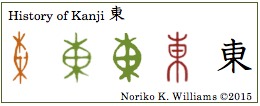 The kanji 東: Taking the explanation given in Setsumon 2000 years ago, the kanji 東 has often been explained as the sun coming through a tree, thus “east.” But now with abundant samples in oracle bone and bronze ware style scholars generally agree that it was a bag of stuff that was tied on two ends. The three lines at the top and the bottom were the ends of a tied rope. The meaning “east” for 東 was a borrowing. When used as a component the original meaning was retained, as is always the case in bushu. The meaning of “a bag of heavy stuff that was tied on both ends” was in the origin of many other kanji such as 重 “heavy,” 動 “to move” and 童 “child,” just to name a few. I hope to have a chance to look at ancient writing samples for those kanji in the near future.
The kanji 東: Taking the explanation given in Setsumon 2000 years ago, the kanji 東 has often been explained as the sun coming through a tree, thus “east.” But now with abundant samples in oracle bone and bronze ware style scholars generally agree that it was a bag of stuff that was tied on two ends. The three lines at the top and the bottom were the ends of a tied rope. The meaning “east” for 東 was a borrowing. When used as a component the original meaning was retained, as is always the case in bushu. The meaning of “a bag of heavy stuff that was tied on both ends” was in the origin of many other kanji such as 重 “heavy,” 動 “to move” and 童 “child,” just to name a few. I hope to have a chance to look at ancient writing samples for those kanji in the near future. The next two kanji 陛 and 階 have been discussed in the earlier post [
The next two kanji 陛 and 階 have been discussed in the earlier post [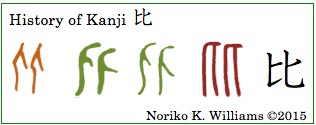 The kanji 比 – The upper right component of the kanji 陛 was well documented from oracle bone time, as shown on the right. They were all two people standing, one behind the other. Two means “many.” When two people faced backward it became the kanji 比 “to compare,” whereas when they faced left it became 従 “to follow.”
The kanji 比 – The upper right component of the kanji 陛 was well documented from oracle bone time, as shown on the right. They were all two people standing, one behind the other. Two means “many.” When two people faced backward it became the kanji 比 “to compare,” whereas when they faced left it became 従 “to follow.” The kozatohen in the kanji 階 really signified exactly the same meaning as the kanji 陛. The origin of the shape, whether “soil stacked up high” or a “ladder,” gave the meaning of having different levels within. Flights of a staircase or steps to walk up were a good match for a kozatohen. The kanji 階 had 皆 “many; everybody,” which was used phonetically for /ka’i/. A kozatohen gave the meaning “stairs; gradation; story” to the kanji 階. We are seeing a clear-cut illustration of the important fact about a bushu and tsukuri (the right side of kanji) in kanji here – A bushu gives meaning and a tsukuri gives sound.
The kozatohen in the kanji 階 really signified exactly the same meaning as the kanji 陛. The origin of the shape, whether “soil stacked up high” or a “ladder,” gave the meaning of having different levels within. Flights of a staircase or steps to walk up were a good match for a kozatohen. The kanji 階 had 皆 “many; everybody,” which was used phonetically for /ka’i/. A kozatohen gave the meaning “stairs; gradation; story” to the kanji 階. We are seeing a clear-cut illustration of the important fact about a bushu and tsukuri (the right side of kanji) in kanji here – A bushu gives meaning and a tsukuri gives sound.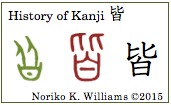 The kanji 皆. In the earlier post I mentioned that the bottom of the kanji 皆 was from 自 “self,” and also that there is a view that it was 曰 “to talk.” I do not have anything new that makes me choose one over the other now, but now I am inclined to think that both must be correct. The ten style sample may be 自 (白) from a nose on the face, but the bronze ware style was 曰 (“to talk” /e’tsu/ in on-yomi and /i’waku/ in kun-yomi.) During the last two years of our exploration of the etymology of kanji on this blog site, we have seen that components of ancient writing got lost, added, or replaced over the years. In the kanji 皆, both interpretations of the bottom may be right. Even though 曰 is not among the Joyo kanji, it is used in expressions such as 彼曰く (“according to what he said” /ka’re i’waku/”) and 曰く付きの悪者 (“a villain with the past” /iwakutsuki-no-warumono/). For the kanji 皆, from many people talking, it meant “everyone; all.”
The kanji 皆. In the earlier post I mentioned that the bottom of the kanji 皆 was from 自 “self,” and also that there is a view that it was 曰 “to talk.” I do not have anything new that makes me choose one over the other now, but now I am inclined to think that both must be correct. The ten style sample may be 自 (白) from a nose on the face, but the bronze ware style was 曰 (“to talk” /e’tsu/ in on-yomi and /i’waku/ in kun-yomi.) During the last two years of our exploration of the etymology of kanji on this blog site, we have seen that components of ancient writing got lost, added, or replaced over the years. In the kanji 皆, both interpretations of the bottom may be right. Even though 曰 is not among the Joyo kanji, it is used in expressions such as 彼曰く (“according to what he said” /ka’re i’waku/”) and 曰く付きの悪者 (“a villain with the past” /iwakutsuki-no-warumono/). For the kanji 皆, from many people talking, it meant “everyone; all.”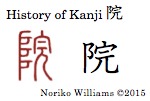 The right side of the kanji 院 is the kanji 完.
The right side of the kanji 院 is the kanji 完. 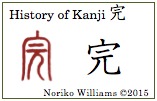 In the absence of writing that was earlier than ten style for 院 shown on the left, I hoped to find earlier shape in the kanji 完. But my search came up empty-handed — the kanji 完 only had a ten style sample too. But there was a difference that, in the ten style sample of 完, the walls of the house, a bushu ukanmuri, reached the floor. So, 元 “a person with a big head kneeling down with his hand in front” was entirely wrapped in the safety of the inside the house. The kanji 完 meant “entire; complete.”
In the absence of writing that was earlier than ten style for 院 shown on the left, I hoped to find earlier shape in the kanji 完. But my search came up empty-handed — the kanji 完 only had a ten style sample too. But there was a difference that, in the ten style sample of 完, the walls of the house, a bushu ukanmuri, reached the floor. So, 元 “a person with a big head kneeling down with his hand in front” was entirely wrapped in the safety of the inside the house. The kanji 完 meant “entire; complete.”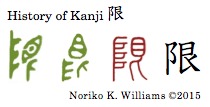 The kanji 限 was discussed earlier in connection with 艮 “to halt; go against; immobile.” [
The kanji 限 was discussed earlier in connection with 艮 “to halt; go against; immobile.” [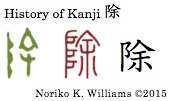 In the bronze ware style sample of the kanji 除, the right side 余 was used phonetically to mean “(time/money/space) to spare; latitude.” How did the shape 余 get that meaning? The history of the shape seems to have been well documented, and example are shown on the right.
In the bronze ware style sample of the kanji 除, the right side 余 was used phonetically to mean “(time/money/space) to spare; latitude.” How did the shape 余 get that meaning? The history of the shape seems to have been well documented, and example are shown on the right.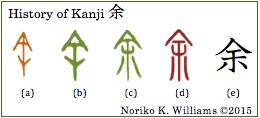 The kanji 余: One view is that for the oracle bone style (a) and bronze ware style (b), it was a surgery needle with a handle to remove lesions. In (c) and ten style (d) the two ハ-like lines were added to mean “to open a wound to remove soemthing.” Removing something that was not wanted came to mean “to have extra space; what is left; latitude.” Another view is that it was a spade that removed dirt and meant something extra. The two ハ shapes signified dirt that was removed to make a hole. (One view of the origin of the kanji 穴 “hole” is consistent with this.)
The kanji 余: One view is that for the oracle bone style (a) and bronze ware style (b), it was a surgery needle with a handle to remove lesions. In (c) and ten style (d) the two ハ-like lines were added to mean “to open a wound to remove soemthing.” Removing something that was not wanted came to mean “to have extra space; what is left; latitude.” Another view is that it was a spade that removed dirt and meant something extra. The two ハ shapes signified dirt that was removed to make a hole. (One view of the origin of the kanji 穴 “hole” is consistent with this.)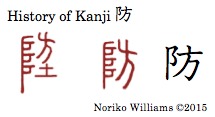 For the kanji 防, the ten style sample (the middle one) had a kozatohen on the left and the kanji 方 on the right. The 方 was used phonetically to mean something that went sideways. An alternative ten style in Setsumon (the left one) had 土 “soil” at the bottom to emphasize “dirt.” Together they signified a high dirt wall on all sides to prevent an enemy from coming in. The kanji 防 meant “to prevent; defend.” The kun-yomi /huse’gu/ means “to prevent.” The on-yomi /bo’o/ is in 防止 (“prevention” /booshi/), 予防 (“preventive” /yoboo/) and 防衛 (“defense”/booee/).
For the kanji 防, the ten style sample (the middle one) had a kozatohen on the left and the kanji 方 on the right. The 方 was used phonetically to mean something that went sideways. An alternative ten style in Setsumon (the left one) had 土 “soil” at the bottom to emphasize “dirt.” Together they signified a high dirt wall on all sides to prevent an enemy from coming in. The kanji 防 meant “to prevent; defend.” The kun-yomi /huse’gu/ means “to prevent.” The on-yomi /bo’o/ is in 防止 (“prevention” /booshi/), 予防 (“preventive” /yoboo/) and 防衛 (“defense”/booee/).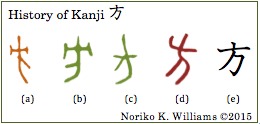 The kanji 方 — There are many different views on the origin of 方. One is that it was a hoe with a long handle and that the handle pointing on either side and the pole at the top and the bottom together signified “four directions.” A different direction is an “option.” Four directions make a “square.” Another view is a little disturbing. It was a body that was hanged in a public display. As I look at the oracle bone style (a) and bronze ware style samples (b), I am beginning to see how they were explained that way. The sideways line with two short lines at the end is very similar to the origins of the kanji 央 ”center,” and the shape in the center looks like a person viewed from the side. Why did a hanging dead body in a public display mean “direction”? Shirakawa explained that it was placed at the boundaries of surrounding barbarian countries, thus denoting various directions. When the explanation goes to mystic ancient customs, there is no way for us to judge it. So i leave it as it is. The kanji 方 means “direction; option; square.”
The kanji 方 — There are many different views on the origin of 方. One is that it was a hoe with a long handle and that the handle pointing on either side and the pole at the top and the bottom together signified “four directions.” A different direction is an “option.” Four directions make a “square.” Another view is a little disturbing. It was a body that was hanged in a public display. As I look at the oracle bone style (a) and bronze ware style samples (b), I am beginning to see how they were explained that way. The sideways line with two short lines at the end is very similar to the origins of the kanji 央 ”center,” and the shape in the center looks like a person viewed from the side. Why did a hanging dead body in a public display mean “direction”? Shirakawa explained that it was placed at the boundaries of surrounding barbarian countries, thus denoting various directions. When the explanation goes to mystic ancient customs, there is no way for us to judge it. So i leave it as it is. The kanji 方 means “direction; option; square.”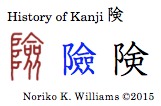 For the kanji 険, the right side in ten style was an interesting shape – under a cover there were two sets of a box and a person placed side by side. The kyujitai, in blue, retained those elements (僉) in any of the kanji that took this shape (検剣験倹). It is explained as people grading goods under a cover, signifying “to examine; check,” or “people listening to an order of the god” (from the kanji 命). It was used phonetically in many kanji. It is true in the kanji 険 that a kozatohen “mountain; hills,” phonetically used on the right right side together meant “perilous; danger.”
For the kanji 険, the right side in ten style was an interesting shape – under a cover there were two sets of a box and a person placed side by side. The kyujitai, in blue, retained those elements (僉) in any of the kanji that took this shape (検剣験倹). It is explained as people grading goods under a cover, signifying “to examine; check,” or “people listening to an order of the god” (from the kanji 命). It was used phonetically in many kanji. It is true in the kanji 険 that a kozatohen “mountain; hills,” phonetically used on the right right side together meant “perilous; danger.”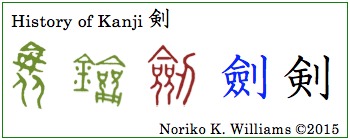 The kanji 剣– I was curious about where the right side of the kanji 険 came from. The kanji 検 験 and 倹 came in ten style only, but the kanji 剣 “bayonet; sword” came in bronze ware style, as shown on the right. The left sample consisted of a roof at the top, two people at the bottom and a shape in the middle, which I cannot recall seeing elsewhere. (I have a feeling that I will come across it one day) In the second bronze ware style sample the left side was minerals buried in mine. The right side had the same component of ten style, but the curious thing is that the feet of the people were tied together. No semantic explanation on these can be found in references. So, this did not help us much to understand the origin of the right side of the kanji 険, 検, 験, 倹, and the left side of 剣. The shared pronunciation /ken/ in Japanese tells us that it was used phonetically in those kanji, but I would certainly like to know what happened before that.
The kanji 剣– I was curious about where the right side of the kanji 険 came from. The kanji 検 験 and 倹 came in ten style only, but the kanji 剣 “bayonet; sword” came in bronze ware style, as shown on the right. The left sample consisted of a roof at the top, two people at the bottom and a shape in the middle, which I cannot recall seeing elsewhere. (I have a feeling that I will come across it one day) In the second bronze ware style sample the left side was minerals buried in mine. The right side had the same component of ten style, but the curious thing is that the feet of the people were tied together. No semantic explanation on these can be found in references. So, this did not help us much to understand the origin of the right side of the kanji 険, 検, 験, 倹, and the left side of 剣. The shared pronunciation /ken/ in Japanese tells us that it was used phonetically in those kanji, but I would certainly like to know what happened before that.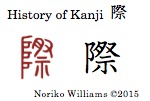 In ten style the kanji 際 had a kozatohen “boundary” and the kanji 祭 “festival” that was used phonetically for /sa’i/. It meant “edge; peripheral.”
In ten style the kanji 際 had a kozatohen “boundary” and the kanji 祭 “festival” that was used phonetically for /sa’i/. It meant “edge; peripheral.”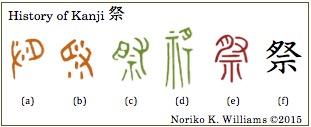 The kanji 祭 The origin of the kanji 祭 has no relationship in meaning with the kanji 際, but it reminds us what a festival was about. In oracle bone style (a) and (b) it contained a hand and a piece of meat (in a reverse position), and droplets of sake in the middle. It was sacrificial animal meat being sanctified with sake. A sacrificial animal played an important role in ancient Chinese society, including a cow, sheep, pig and dog. In (c) and (d) in bronze ware style, an altar table was added. A festival was a prayer to a god and a celebration of him. The kanji 祭 means “festival.”
The kanji 祭 The origin of the kanji 祭 has no relationship in meaning with the kanji 際, but it reminds us what a festival was about. In oracle bone style (a) and (b) it contained a hand and a piece of meat (in a reverse position), and droplets of sake in the middle. It was sacrificial animal meat being sanctified with sake. A sacrificial animal played an important role in ancient Chinese society, including a cow, sheep, pig and dog. In (c) and (d) in bronze ware style, an altar table was added. A festival was a prayer to a god and a celebration of him. The kanji 祭 means “festival.”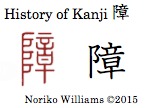 For the kanji 障, the ten style sample had a mountain or stack of dirt on the left, and the right side was the kanji 章, which was used phonetically for /sho’o/ to mean “fence.” Together they meant “to block; hinder.”
For the kanji 障, the ten style sample had a mountain or stack of dirt on the left, and the right side was the kanji 章, which was used phonetically for /sho’o/ to mean “fence.” Together they meant “to block; hinder.”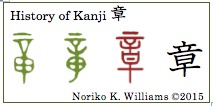 The kanji 章 The kanji 章 and 障 are not semantically related. Our reader may find the origin of 章 a little surprising, shown on the right. It was a pictograph, i.e., the entire shape was a single image. The image was a tattooing needle with a big handle at the top and a large ink reservoir in the middle. The needle tattooed a pattern clearly and distinctly, and it signified something that was drawn or written beautifully, such as a badge, chapter, etc. The kanji 章 means “badge; chapter.”
The kanji 章 The kanji 章 and 障 are not semantically related. Our reader may find the origin of 章 a little surprising, shown on the right. It was a pictograph, i.e., the entire shape was a single image. The image was a tattooing needle with a big handle at the top and a large ink reservoir in the middle. The needle tattooed a pattern clearly and distinctly, and it signified something that was drawn or written beautifully, such as a badge, chapter, etc. The kanji 章 means “badge; chapter.”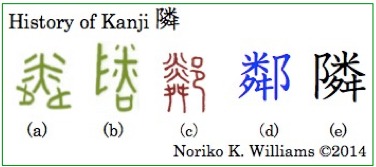 In the four postings we have looked at kanji that had the shape 阝. When this shape appeared on the right it meant “village” and was called a bushu oozato, whereas when it appeared on the left side it meant “mountain; hills; ladder; soil stacked up high,” and was called a bushu kozatohen. Generally the side on which it appeared was so important that they never switched their positions. There is a possible exception to this. That is the kanji 隣 [
In the four postings we have looked at kanji that had the shape 阝. When this shape appeared on the right it meant “village” and was called a bushu oozato, whereas when it appeared on the left side it meant “mountain; hills; ladder; soil stacked up high,” and was called a bushu kozatohen. Generally the side on which it appeared was so important that they never switched their positions. There is a possible exception to this. That is the kanji 隣 [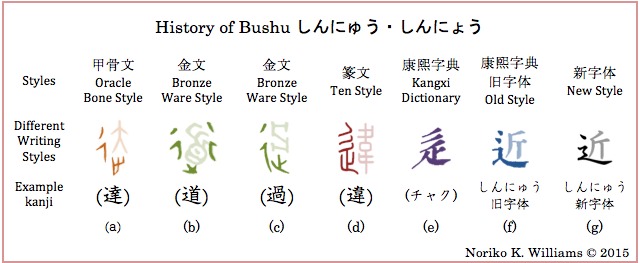 Explanation of the table above: In the bronze ware style sample (a) in brown for the kanji 達, the left side was a crossroad, and the right bottom was a (forward-facing) footprint. In the bronze ware style sample (b) in green for the kanji 道, the crossroad was in a full shape, and the footprint at the bottom began to change to the shape that we see in (c). In the second bronze ware style sample (c) for the kanji 過, the crossroad had only left side, which in ten style (d) in red became three hooked shape lines. The bottom was 止. The shape 辵 (e) in purple was taken from the section header in the Kangxi dictionary (康熙字典). In the dictionary, however, the kanji entries themselves had a more simplified shape 辶 with two dots, such as (f) for 近 in blue. The last stroke was stretched out to the right side at the bottom. The shape (f) remained as kyujitai (kyujitai was basically the style of the Kangxi dictionary), and in Japanese it was called shinnyuu/shinnyoo. After the Japanese language reform the shape (g) in black replaced it. A bushu shinnyoo has quite a history!
Explanation of the table above: In the bronze ware style sample (a) in brown for the kanji 達, the left side was a crossroad, and the right bottom was a (forward-facing) footprint. In the bronze ware style sample (b) in green for the kanji 道, the crossroad was in a full shape, and the footprint at the bottom began to change to the shape that we see in (c). In the second bronze ware style sample (c) for the kanji 過, the crossroad had only left side, which in ten style (d) in red became three hooked shape lines. The bottom was 止. The shape 辵 (e) in purple was taken from the section header in the Kangxi dictionary (康熙字典). In the dictionary, however, the kanji entries themselves had a more simplified shape 辶 with two dots, such as (f) for 近 in blue. The last stroke was stretched out to the right side at the bottom. The shape (f) remained as kyujitai (kyujitai was basically the style of the Kangxi dictionary), and in Japanese it was called shinnyuu/shinnyoo. After the Japanese language reform the shape (g) in black replaced it. A bushu shinnyoo has quite a history!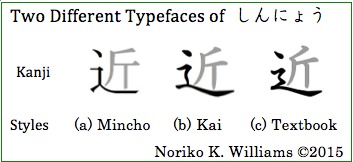 Mincho style writing for a shinnyoo — The shapes in Mincho style (a) on the right table and textbook style (kyookasho-tai) in (c) are different. The second stroke of shinnyoo in kai style (b), orthodox style in brush writing, and textbook style (c) is a wavy line whereas in Mincho style (a) it is not. When you write, you are expected to write it with a wavy line.
Mincho style writing for a shinnyoo — The shapes in Mincho style (a) on the right table and textbook style (kyookasho-tai) in (c) are different. The second stroke of shinnyoo in kai style (b), orthodox style in brush writing, and textbook style (c) is a wavy line whereas in Mincho style (a) it is not. When you write, you are expected to write it with a wavy line.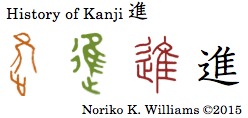 The history of the kanji 進 is shown on the left. In oracle bone style, the top was a bird, which was used phonetically, and the bottom was a footprint signifying “walking.” In bronze ware style, a crossroad was added to the left side. Adding a crossroad suggesting “one choosing to go straight past at a crossroad” meant “to advance.” The footprint was taking the shape of 止. By itself it made the kanji 止, and meant “to stop; halt,” from stopping one’s feet. When used as a component 止 carried the meaning of “foot; moving forward.” In ten style, the crossroad and a footprint were aligned vertically forming a single meaningful unit to mean “to move forward.” The shape “bird” on the right side appeared in many other kanji that eventually becomes 隹. 隹 is called fututori, and the name comes from the kyujitai kanji 舊 for /huru’i/ (旧 in shinjitai), and /tori/ “bird,” and it was frequently used phonetically.
The history of the kanji 進 is shown on the left. In oracle bone style, the top was a bird, which was used phonetically, and the bottom was a footprint signifying “walking.” In bronze ware style, a crossroad was added to the left side. Adding a crossroad suggesting “one choosing to go straight past at a crossroad” meant “to advance.” The footprint was taking the shape of 止. By itself it made the kanji 止, and meant “to stop; halt,” from stopping one’s feet. When used as a component 止 carried the meaning of “foot; moving forward.” In ten style, the crossroad and a footprint were aligned vertically forming a single meaningful unit to mean “to move forward.” The shape “bird” on the right side appeared in many other kanji that eventually becomes 隹. 隹 is called fututori, and the name comes from the kyujitai kanji 舊 for /huru’i/ (旧 in shinjitai), and /tori/ “bird,” and it was frequently used phonetically.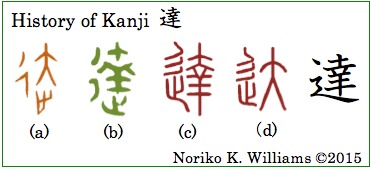 We discussed the kanji 達 in January when we looked at kanji that contain 羊 (sheep). [
We discussed the kanji 達 in January when we looked at kanji that contain 羊 (sheep). [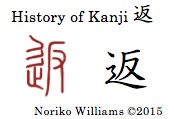 In the last post, in discussing the kanji 阪 we touched on the different explanations of the origin of 反. In ten style the kanji 返 consisted of the two elements that signified “to move forward” on the left and 反 on the right, which was used phonetically to mean “to reverse.” The kanji 返 meant “to reverse; put it back; restore.”
In the last post, in discussing the kanji 阪 we touched on the different explanations of the origin of 反. In ten style the kanji 返 consisted of the two elements that signified “to move forward” on the left and 反 on the right, which was used phonetically to mean “to reverse.” The kanji 返 meant “to reverse; put it back; restore.”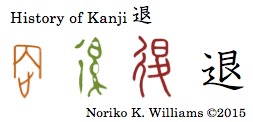 Even though the upper right component of the kanji 退, 艮, is the same as the right component of the kanji 限 discussed in our last post, their origins were different – In 限 艮 consisted of an eye and a person or a knife whereas in 退 艮 consisted of a raised bowl of food or the sun, and a backward-facing footprint (夂 suinyoo) below that. The bronze ware style sample showed a bowl of food and a backward footprint. A person walking backward not showing his back in taking down the food offering from the altar table was the explanation given by Shirakawa. The other explanation given by the Kadokawa dictionary is that, from “the sun going down,” it meant “to retreat; recede; move backward.” Now where did the shinnyoo in kanji come from? Interestingly the combination of the crossroad and the backward footprint together gave the meaning the shinnyoo “to move backward” rather than “to move forward.” (The oracle bone style sample here is the origin of the alternate ten style given by Setsumon (not shown here).)
Even though the upper right component of the kanji 退, 艮, is the same as the right component of the kanji 限 discussed in our last post, their origins were different – In 限 艮 consisted of an eye and a person or a knife whereas in 退 艮 consisted of a raised bowl of food or the sun, and a backward-facing footprint (夂 suinyoo) below that. The bronze ware style sample showed a bowl of food and a backward footprint. A person walking backward not showing his back in taking down the food offering from the altar table was the explanation given by Shirakawa. The other explanation given by the Kadokawa dictionary is that, from “the sun going down,” it meant “to retreat; recede; move backward.” Now where did the shinnyoo in kanji come from? Interestingly the combination of the crossroad and the backward footprint together gave the meaning the shinnyoo “to move backward” rather than “to move forward.” (The oracle bone style sample here is the origin of the alternate ten style given by Setsumon (not shown here).)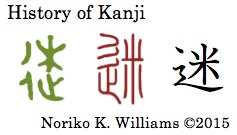 For the kanji 迷, the bronze ware style sample had a crossroad (left side of 行), 木 and a footprint 止. In ten style the footprint moved to the left, and the right side became 米, which was used phonetically. This kanji is also popularly explained as “one loses one’s way like rice grains scattered in all directions.” The kanji 迷 means “to be perplexed; lose one’s way.”
For the kanji 迷, the bronze ware style sample had a crossroad (left side of 行), 木 and a footprint 止. In ten style the footprint moved to the left, and the right side became 米, which was used phonetically. This kanji is also popularly explained as “one loses one’s way like rice grains scattered in all directions.” The kanji 迷 means “to be perplexed; lose one’s way.”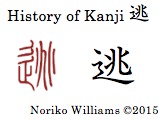 For the kanji 逃, in ten style the right side 兆 came from a pictograph that was the crack lines on a heated tortoise shell or animal bone for divination. When crack lines appeared on the heated bone, they appeared very quickly. The left side “to move forward” and cracks running fast together meant “to run away; dodge.”
For the kanji 逃, in ten style the right side 兆 came from a pictograph that was the crack lines on a heated tortoise shell or animal bone for divination. When crack lines appeared on the heated bone, they appeared very quickly. The left side “to move forward” and cracks running fast together meant “to run away; dodge.” In the ten style of the kanji 近, the right side was a hand axe with a shaped handle, but here it was used phonetically for /ki’n/ to mean “a little.” With the left side “moving forward” a short distance to go forward meant “near.” The kanji 近 meant “near; close.”
In the ten style of the kanji 近, the right side was a hand axe with a shaped handle, but here it was used phonetically for /ki’n/ to mean “a little.” With the left side “moving forward” a short distance to go forward meant “near.” The kanji 近 meant “near; close.” For the kanji 迎, the left side in ten style, in red, was a composite of two elements, a crossroad (the three hooked lines from the left half of a crossroad) and a footprint. Together they meant “to move along (beyond a crossroad)” and became a bushu shinnyoo in kanji. The center was a person standing, facing right. By having the component that meant “to move along” right behind him we can imagine that he had travelled. On the right side was another person bowing to his visitor in a humble posture. Altogether they meant “to welcome.”
For the kanji 迎, the left side in ten style, in red, was a composite of two elements, a crossroad (the three hooked lines from the left half of a crossroad) and a footprint. Together they meant “to move along (beyond a crossroad)” and became a bushu shinnyoo in kanji. The center was a person standing, facing right. By having the component that meant “to move along” right behind him we can imagine that he had travelled. On the right side was another person bowing to his visitor in a humble posture. Altogether they meant “to welcome.”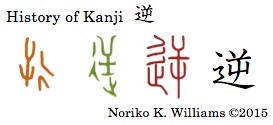 For the kanji 逆, in oracle bone style, in brown, the left side was a person upside down, and the right side was a crossroad. In bronze ware style, in green, the upside down person and crossroad switched their positions and a footprint was added at the bottom. There are a couple of different views on this. One is that “an upside down person” signified “reverse,” and with “to move along” a person went backward. From that it meant “to reverse; wrong way; backward.” Another is by Shirakawa, who said that an upside down person with a crossroad signified a person coming toward another person who was standing on his foot. Together they originally meant “to receive someone.” Then the writing was borrowed to mean “reverse.” Although I find this view, of an upside down person signifying a movement toward you, intriguing, I would like to think about this more in relation to other kanji that originated an upside down image.
For the kanji 逆, in oracle bone style, in brown, the left side was a person upside down, and the right side was a crossroad. In bronze ware style, in green, the upside down person and crossroad switched their positions and a footprint was added at the bottom. There are a couple of different views on this. One is that “an upside down person” signified “reverse,” and with “to move along” a person went backward. From that it meant “to reverse; wrong way; backward.” Another is by Shirakawa, who said that an upside down person with a crossroad signified a person coming toward another person who was standing on his foot. Together they originally meant “to receive someone.” Then the writing was borrowed to mean “reverse.” Although I find this view, of an upside down person signifying a movement toward you, intriguing, I would like to think about this more in relation to other kanji that originated an upside down image.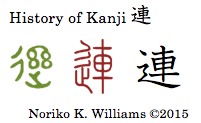 For the kanji 連 the bronze ware style sample had a crossroad on the left. The right side had two vehicles connected, and a footprint at the bottom. Together they signified a convoy of vehicles. In ten style the footprint moved to the left and aligned with the crossroad. On the right side there was only one vehicle. From many vehicles moving forward in a connected way it meant “to link; to accompany; continuous.”
For the kanji 連 the bronze ware style sample had a crossroad on the left. The right side had two vehicles connected, and a footprint at the bottom. Together they signified a convoy of vehicles. In ten style the footprint moved to the left and aligned with the crossroad. On the right side there was only one vehicle. From many vehicles moving forward in a connected way it meant “to link; to accompany; continuous.”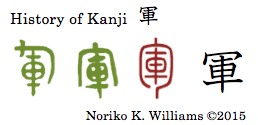 The kanji 軍 — Before the kanji 運, let us look at its component 軍 first because 軍 came before 運. On the right we have two bronze ware style writings. Both had 車 “vehicle.” The question is, what the top of or around the vehicle was about. The left bronze ware style sample was explained as a military flag that marked where the military vehicles were. This shape was similar to a flag for a clan in the kanji such as 族, 旅 and 旗, so it has an appeal to me. Another explanation is that the encircling line (勹 in ten style) simply meant “to wrap around,” and the kanji meant soldiers encircling military vehicles. Either way the kanji 軍 meant “military.” In kanji, the short line at the top was lost, possibly to differentiate it from a ukanmuri (宀) “house.” The shape above 車 is called a /waka’nmuri/, from a katakana ワ and /kanmuri/ “crown.”
The kanji 軍 — Before the kanji 運, let us look at its component 軍 first because 軍 came before 運. On the right we have two bronze ware style writings. Both had 車 “vehicle.” The question is, what the top of or around the vehicle was about. The left bronze ware style sample was explained as a military flag that marked where the military vehicles were. This shape was similar to a flag for a clan in the kanji such as 族, 旅 and 旗, so it has an appeal to me. Another explanation is that the encircling line (勹 in ten style) simply meant “to wrap around,” and the kanji meant soldiers encircling military vehicles. Either way the kanji 軍 meant “military.” In kanji, the short line at the top was lost, possibly to differentiate it from a ukanmuri (宀) “house.” The shape above 車 is called a /waka’nmuri/, from a katakana ワ and /kanmuri/ “crown.” For the kanji 運, a bushu shinnyoo “to move forward” and 軍 “military” that was used phonetically signified to “transport military equipment.” It meant “to transport.” Because a luck comes around, it also meant “luck.”
For the kanji 運, a bushu shinnyoo “to move forward” and 軍 “military” that was used phonetically signified to “transport military equipment.” It meant “to transport.” Because a luck comes around, it also meant “luck.”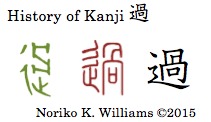 For the kanji 過 in the bronze ware style, in addition to a crossroad and a footprint we see an unusual shape at the top right. It was explained in references as “joint of bones of a deceased person.” Together with “to move along” they meant “to pass through.” Something that goes through could easily end up being excessive, which also may result in a mistake. From that it also meant “excessive; making a mistake.” The kanji 過 means “to pass through; excessive; mistake.”
For the kanji 過 in the bronze ware style, in addition to a crossroad and a footprint we see an unusual shape at the top right. It was explained in references as “joint of bones of a deceased person.” Together with “to move along” they meant “to pass through.” Something that goes through could easily end up being excessive, which also may result in a mistake. From that it also meant “excessive; making a mistake.” The kanji 過 means “to pass through; excessive; mistake.”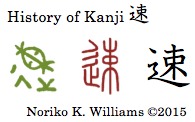 For the kanji 速 in bronze ware style, the top was stuff tied with a rope and the bottom was a crossroad which was used phonetically to mean “speedy.” The bottom had a crossroad and footprint, the makings of a shinnyoo. In ten style the tied stuff with strings became 束. Together they meant “fast.”
For the kanji 速 in bronze ware style, the top was stuff tied with a rope and the bottom was a crossroad which was used phonetically to mean “speedy.” The bottom had a crossroad and footprint, the makings of a shinnyoo. In ten style the tied stuff with strings became 束. Together they meant “fast.”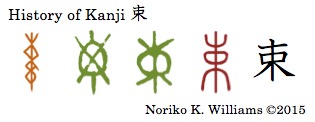 The kanji 束-– The upper right component of 速 by itself is the kanji 束. For 速, all of the ancient writing styles was a bundle of stuff tied together. It meant “to bundle.” The kun-yomi /ta’ba/ means “a bundle,” and is in 束ねる (“to bundle up” /tabane’ru/) and 花束 (“flower bouquet” /hana’taba/).
The kanji 束-– The upper right component of 速 by itself is the kanji 束. For 速, all of the ancient writing styles was a bundle of stuff tied together. It meant “to bundle.” The kun-yomi /ta’ba/ means “a bundle,” and is in 束ねる (“to bundle up” /tabane’ru/) and 花束 (“flower bouquet” /hana’taba/).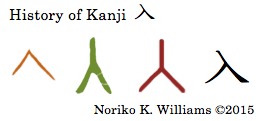 The kanji 入 In all ancient styles, it was the shape of an entrance to a house. It meant “to enter.” In kanji you write the shorter stroke towards the left first.
The kanji 入 In all ancient styles, it was the shape of an entrance to a house. It meant “to enter.” In kanji you write the shorter stroke towards the left first.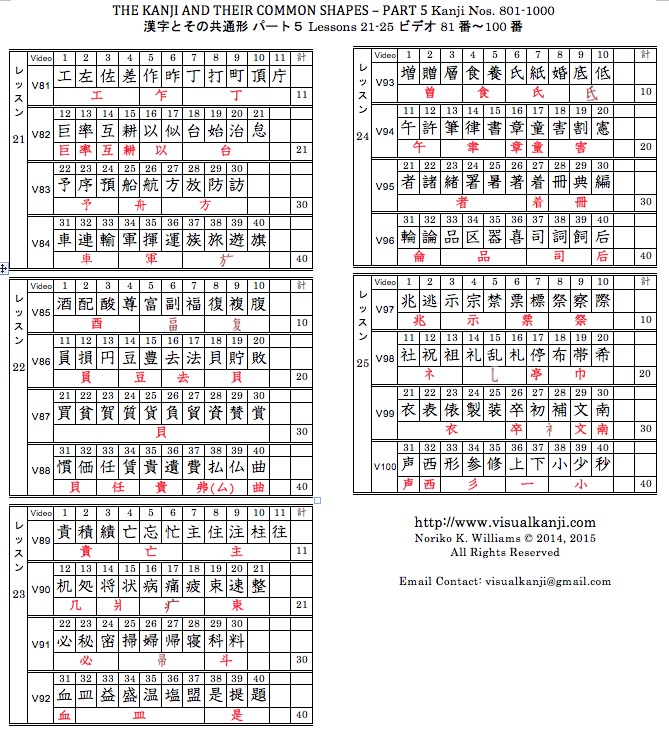
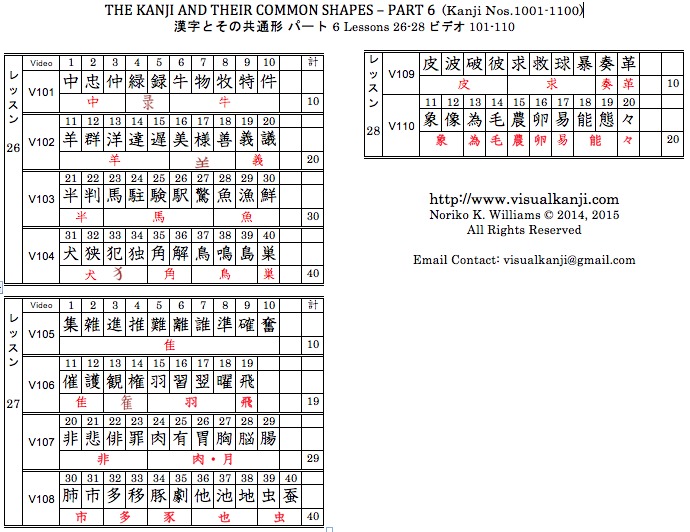
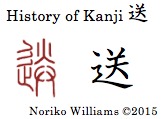 For the kanji 送, in ten style, in red, the left side was a crossroad and a footstep vertically placed, which were the makings of a bushu shinnyoo “to move forward” later on. On the right side the top looked like a fire but it was an object instead (we will come back to this shape in the kanji 朕 below). The bottom was two hands, which signified a careful act using hands. Together they signified a person sending out an object with hands. Then the left side was added to emphasize a forward movement. The two sides together meant “to send something forward.”
For the kanji 送, in ten style, in red, the left side was a crossroad and a footstep vertically placed, which were the makings of a bushu shinnyoo “to move forward” later on. On the right side the top looked like a fire but it was an object instead (we will come back to this shape in the kanji 朕 below). The bottom was two hands, which signified a careful act using hands. Together they signified a person sending out an object with hands. Then the left side was added to emphasize a forward movement. The two sides together meant “to send something forward.”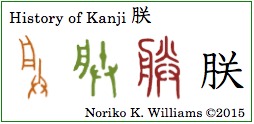 The history of the kanji 朕 is shown on the right. In both oracle bone style, in brown, and bronze ware style, in green, the left side had a shallow bowl or a tray that could be used to transport things. (月 in this case is not “moon” or “flesh” but “tray; bowl.”) On the right side the vertical line with a bulge in the middle signified an object (a bulge was to emphasize that the shape was more than just a line), and the bottom had two hands holding up the object carefully. Together they meant a bowl that contained something was held carefully with both hands reverentially. Then it was used to mean “imperial We.” (Shirakawa thinks that it was just a borrowing because pronouns are all borrowing.) In ten style, the vertical line with a bulge took the shape of 火. In kanji the two elements on the right side coalesced and became simplified. The kanji 朕 means “I (imperial We)” [exclusively used by an emperor]. Another kanji that contains the upper right side of the kanji 送 and 朕 is the kanji 咲 (“a flower blooms” /saku/), but it appears to be a more recent kanji (no ancient writing available).
The history of the kanji 朕 is shown on the right. In both oracle bone style, in brown, and bronze ware style, in green, the left side had a shallow bowl or a tray that could be used to transport things. (月 in this case is not “moon” or “flesh” but “tray; bowl.”) On the right side the vertical line with a bulge in the middle signified an object (a bulge was to emphasize that the shape was more than just a line), and the bottom had two hands holding up the object carefully. Together they meant a bowl that contained something was held carefully with both hands reverentially. Then it was used to mean “imperial We.” (Shirakawa thinks that it was just a borrowing because pronouns are all borrowing.) In ten style, the vertical line with a bulge took the shape of 火. In kanji the two elements on the right side coalesced and became simplified. The kanji 朕 means “I (imperial We)” [exclusively used by an emperor]. Another kanji that contains the upper right side of the kanji 送 and 朕 is the kanji 咲 (“a flower blooms” /saku/), but it appears to be a more recent kanji (no ancient writing available).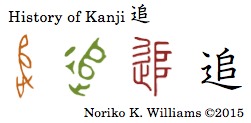 The upper right component in the kanji 追 and the left side of the kanji 師 share the same shape, not only in the kanji but also in oracle bone style and bronze ware style. Kanji scholars’ accounts on what it signified seem to differ. One view is that it was a stack of things or soil for a boundary. Another view is that it was bands of people and was phonetically used to mean “to follow” and “to add (something) afterwards.” And yet another view, which is by Shirakawa, is that it was two pieces of meat for offerings to the god to pray for a victory in a battle. The ritual with an offering was conducted wherever the military moved to fight a battle. Thus it meant “to follow.” From following it also meant “to add (something) afterwards.”
The upper right component in the kanji 追 and the left side of the kanji 師 share the same shape, not only in the kanji but also in oracle bone style and bronze ware style. Kanji scholars’ accounts on what it signified seem to differ. One view is that it was a stack of things or soil for a boundary. Another view is that it was bands of people and was phonetically used to mean “to follow” and “to add (something) afterwards.” And yet another view, which is by Shirakawa, is that it was two pieces of meat for offerings to the god to pray for a victory in a battle. The ritual with an offering was conducted wherever the military moved to fight a battle. Thus it meant “to follow.” From following it also meant “to add (something) afterwards.”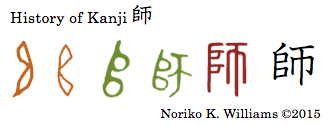 The kanji 師 –The two oracle bone style samples and the left bronze ware style writing sample shown on the right were the same as the components of 追. In the second bronze ware style writing a military flag was added on the right side. Together they meant a military division or its leader. In the military a leader is very important, From that it also meant a “mentor.” The kanji 師 meant “military unit; teacher; mentor.”
The kanji 師 –The two oracle bone style samples and the left bronze ware style writing sample shown on the right were the same as the components of 追. In the second bronze ware style writing a military flag was added on the right side. Together they meant a military division or its leader. In the military a leader is very important, From that it also meant a “mentor.” The kanji 師 meant “military unit; teacher; mentor.”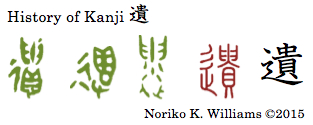 For the kanji 遺, we have three bronze ware style writing samples here. The left most one consisted of two hands holding something carefully at the top, a crossroad on the left, signifying “to go,” and a cowry, signifying something valuable, at the bottom right. Together they meant someone leaving something precious behind after his death. The two other bronze ware style samples contained the same elements in a different layout. In ten style a crossroad and a footprint were aligned vertically to mean “to go forward,” and the right side was 貴 “precious; valuable.” The kanji 遺 means “to leave behind; bequest.”
For the kanji 遺, we have three bronze ware style writing samples here. The left most one consisted of two hands holding something carefully at the top, a crossroad on the left, signifying “to go,” and a cowry, signifying something valuable, at the bottom right. Together they meant someone leaving something precious behind after his death. The two other bronze ware style samples contained the same elements in a different layout. In ten style a crossroad and a footprint were aligned vertically to mean “to go forward,” and the right side was 貴 “precious; valuable.” The kanji 遺 means “to leave behind; bequest.”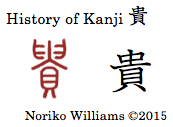 The kanji 貴–If you take the bushu shinnyoo out from the kanji 遺, we get the kanji 貴. Its ten style writing shown on the right had two hands over a container of valuable cowry with a lid. It signified “to handle something valuable carefully.” Precious cowries were kept in a container with a lid. Together they meant “precious; valuable.” The kanji 貴 is also used for people and it meant “noble.”
The kanji 貴–If you take the bushu shinnyoo out from the kanji 遺, we get the kanji 貴. Its ten style writing shown on the right had two hands over a container of valuable cowry with a lid. It signified “to handle something valuable carefully.” Precious cowries were kept in a container with a lid. Together they meant “precious; valuable.” The kanji 貴 is also used for people and it meant “noble.”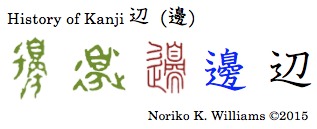 The shinjitai kanji 辺 was a drastic change from its kyujitai邊. The kyujitai had 19 strokes and we can hardly make out the shape unless you enlarge the screen many times over. The writing in blue on the left side is the kyujitai. We have two bronze ware style writing samples here. The left one had a crossroad on the left. On the right side it had a face (自) at the top, a table (丙) in the middle and four directions (方) at the bottom, signifying peripheral areas in all four directions. Together they meant “edge of an area; peripheral.” In ten style a crossroad and a footprint were aligned vertically. The kyujitai had two short strokes in the shinnyoo. The kyujitai is still used in some family names, such as 渡邊 “Watanabe or Watabe” in a formal document even though they are likely to use the shinjitai in their daily life. For us, simply learning the shinjitai shape, which has 刀 “sword,” no relation to the meaning, will do. The kanji 辺 meant “peripheral; edge of an area; area.”
The shinjitai kanji 辺 was a drastic change from its kyujitai邊. The kyujitai had 19 strokes and we can hardly make out the shape unless you enlarge the screen many times over. The writing in blue on the left side is the kyujitai. We have two bronze ware style writing samples here. The left one had a crossroad on the left. On the right side it had a face (自) at the top, a table (丙) in the middle and four directions (方) at the bottom, signifying peripheral areas in all four directions. Together they meant “edge of an area; peripheral.” In ten style a crossroad and a footprint were aligned vertically. The kyujitai had two short strokes in the shinnyoo. The kyujitai is still used in some family names, such as 渡邊 “Watanabe or Watabe” in a formal document even though they are likely to use the shinjitai in their daily life. For us, simply learning the shinjitai shape, which has 刀 “sword,” no relation to the meaning, will do. The kanji 辺 meant “peripheral; edge of an area; area.”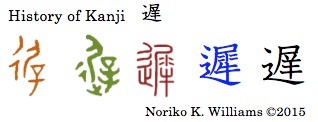 The kanji 遅 had oracle bone style and bronze ware style samples as shown on the left. How a sitting person and possibly an animal came to mean 犀 “rhinoceros” is not clear. In kanji, the upper right component 犀 was used phonetically to mean “slow.” The lower left was a bushu shinnyoo. In ten style the upper right consisted of 尾 “tail” and 牛 “ox; cow,” which was reflected in kyujitai. In shinjitai they were replaced by 羊. The kanji 遅 means “slow; late.”
The kanji 遅 had oracle bone style and bronze ware style samples as shown on the left. How a sitting person and possibly an animal came to mean 犀 “rhinoceros” is not clear. In kanji, the upper right component 犀 was used phonetically to mean “slow.” The lower left was a bushu shinnyoo. In ten style the upper right consisted of 尾 “tail” and 牛 “ox; cow,” which was reflected in kyujitai. In shinjitai they were replaced by 羊. The kanji 遅 means “slow; late.”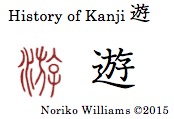
 The kanji 遊, with a bushu shinnyoo, does not appear in Setsumon Kaiji, Instead it was with a sanzui “water” (游). The history of the kanji 游 is shown on the right. In oracle bone style, the left and the top was a flagpole and a streamer of a clan. The bottom right was a child. The left bronze ware style writing showed a person viewed from the side. He was holding the flagpole with both hands firmly. The writing meant “clan” with a clan streamer swimming in the sky. In ten style, “water” was added on the left side to indicate “to swim.” When a bushu shinnyoo “to move forward” was added instead, the kanji 遊 originally meant “to travel around; move around.” From that it meant “to play; to have fun.” It also retained the original meaning of “moving about; traveling around” in the words such as 遊学 (“to travel abroad for leaning” /yuugaku/) and 外遊 (“to travel abroad” (often by a politician) /gaiyuu/).
The kanji 遊, with a bushu shinnyoo, does not appear in Setsumon Kaiji, Instead it was with a sanzui “water” (游). The history of the kanji 游 is shown on the right. In oracle bone style, the left and the top was a flagpole and a streamer of a clan. The bottom right was a child. The left bronze ware style writing showed a person viewed from the side. He was holding the flagpole with both hands firmly. The writing meant “clan” with a clan streamer swimming in the sky. In ten style, “water” was added on the left side to indicate “to swim.” When a bushu shinnyoo “to move forward” was added instead, the kanji 遊 originally meant “to travel around; move around.” From that it meant “to play; to have fun.” It also retained the original meaning of “moving about; traveling around” in the words such as 遊学 (“to travel abroad for leaning” /yuugaku/) and 外遊 (“to travel abroad” (often by a politician) /gaiyuu/). The kanji 道 and 導 have been discussed in an earlier post in connection with a physical feature (
The kanji 道 and 導 have been discussed in an earlier post in connection with a physical feature (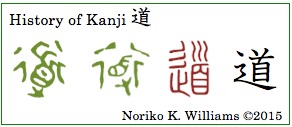 Together they signified someone showing by hand the way to go, thus 導 meant “a hand guiding the way to go forward” or just “to guide.” (Ten style is in red.) Without a hand at the bottom it became the kanji 道 “road; way.” As I write this post I am wondering if the two Japanese words みち /michi/ and みちびく /michibi’ku/ existed before the kanji came to Japan and shared the same cognates, too. The word /hiku/ means “to draw; to pull; lead.” Another scenario is that the word みちびく came after the kanji introduction. To look into which was a historical fact is a totally different endeavor. For us in vocabulary study keeping in mind this possible relationship between みち and みちびく may be useful.
Together they signified someone showing by hand the way to go, thus 導 meant “a hand guiding the way to go forward” or just “to guide.” (Ten style is in red.) Without a hand at the bottom it became the kanji 道 “road; way.” As I write this post I am wondering if the two Japanese words みち /michi/ and みちびく /michibi’ku/ existed before the kanji came to Japan and shared the same cognates, too. The word /hiku/ means “to draw; to pull; lead.” Another scenario is that the word みちびく came after the kanji introduction. To look into which was a historical fact is a totally different endeavor. For us in vocabulary study keeping in mind this possible relationship between みち and みちびく may be useful.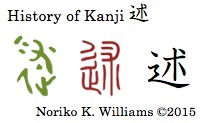 When we looked at the kanji 術 three months ago in the post entitled the kanji 行街術衛 – ゆきがまえ (October 17, 2015), 術 was explained in two ways, depending on how the middle 朮 was explained. One explanation of 朮 from Setsumon was that “sticky millets around the stalk.” Another, by Shirakawa, was an “animal that was used to exorcise an evil spirit on a road.” Unlike 術, 述 had a bronze ware style sample, but it still does not give us a definitive answer – it looks like the top of the millet stalk drooping with grain, but it also looks like an animal. (One problem with Shirakawa’s account is that many kanji scholars seem to be skeptical of the existence of such magic practice.) Whatever the origin was, the kanji 朮 (it is not a Joyo kanji) meant もちあわ “sticky millet,” and in both kanji 術 and 述, it was used phonetically for /jutsu/. For us it is more convenient to understand 述 as one following what had been said, thus “to reiterate; state.”
When we looked at the kanji 術 three months ago in the post entitled the kanji 行街術衛 – ゆきがまえ (October 17, 2015), 術 was explained in two ways, depending on how the middle 朮 was explained. One explanation of 朮 from Setsumon was that “sticky millets around the stalk.” Another, by Shirakawa, was an “animal that was used to exorcise an evil spirit on a road.” Unlike 術, 述 had a bronze ware style sample, but it still does not give us a definitive answer – it looks like the top of the millet stalk drooping with grain, but it also looks like an animal. (One problem with Shirakawa’s account is that many kanji scholars seem to be skeptical of the existence of such magic practice.) Whatever the origin was, the kanji 朮 (it is not a Joyo kanji) meant もちあわ “sticky millet,” and in both kanji 術 and 述, it was used phonetically for /jutsu/. For us it is more convenient to understand 述 as one following what had been said, thus “to reiterate; state.”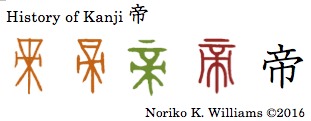 For the kanji 帝 in both of the two samples in oracle bone style, in brown, it was an altar table that had three crossed legs for stability. It was the most important altar table to place offerings for the ancestral gods and gods of nature. It signified the highest god that ruled the universe. From that it came to be used for “emperor; imperial.” In bronze ware style, the top, for most likely offerings, got separated. In kanji the bottom 巾 is probably the remnant of stabilizing three legs.
For the kanji 帝 in both of the two samples in oracle bone style, in brown, it was an altar table that had three crossed legs for stability. It was the most important altar table to place offerings for the ancestral gods and gods of nature. It signified the highest god that ruled the universe. From that it came to be used for “emperor; imperial.” In bronze ware style, the top, for most likely offerings, got separated. In kanji the bottom 巾 is probably the remnant of stabilizing three legs.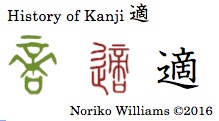 The history of the kanji 適 and 敵 is shown on the left. The two kanji in bronze ware style were basically the same: The top was what the kanji 帝 was and the bottom was 口 “words; a prayer box.” Together they signified someone who could say a prayer in conducting the most important worship rite of the ancestral gods, that is, a legitimate heir to the throne.
The history of the kanji 適 and 敵 is shown on the left. The two kanji in bronze ware style were basically the same: The top was what the kanji 帝 was and the bottom was 口 “words; a prayer box.” Together they signified someone who could say a prayer in conducting the most important worship rite of the ancestral gods, that is, a legitimate heir to the throne. 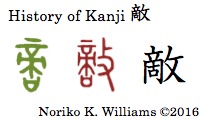 When a bushu onnaben was added on the left side, it became the kanji 嫡 /cha’ku/, in words such as 嫡子 (“legitimate son or daughter; heir”/cha’kushi/). Now let us look at the kanji 適 and 敵.
When a bushu onnaben was added on the left side, it became the kanji 嫡 /cha’ku/, in words such as 嫡子 (“legitimate son or daughter; heir”/cha’kushi/). Now let us look at the kanji 適 and 敵.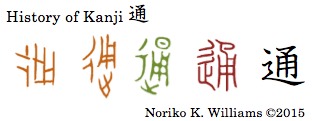 For the kanji 通, we have two oracle bone style samples shown on the left. In addition to a crossroad on the left side, and a footprint on the right, it had the shape that later became 用. In bronze ware style, a round shape was added on 用, which became 甬 in kanji. Even though scholars seem to agree that 甬 signified an action in which something went through, thus it meant “through; to pass through,” what the shape originally was came from is not agreed. One view is that the top was a person stamping on a stick to push it through; another is that the top was a hand pail 手桶 whose cylindrical shape signified something “through”; yet another is that it was just used phonetically. Whatever the origin, the katakana マ shape and 用 formed a single meaningful unit. Together with a bushu shinnyoo, the kanji 通 meant “to pass through; go and come back regularly.”
For the kanji 通, we have two oracle bone style samples shown on the left. In addition to a crossroad on the left side, and a footprint on the right, it had the shape that later became 用. In bronze ware style, a round shape was added on 用, which became 甬 in kanji. Even though scholars seem to agree that 甬 signified an action in which something went through, thus it meant “through; to pass through,” what the shape originally was came from is not agreed. One view is that the top was a person stamping on a stick to push it through; another is that the top was a hand pail 手桶 whose cylindrical shape signified something “through”; yet another is that it was just used phonetically. Whatever the origin, the katakana マ shape and 用 formed a single meaningful unit. Together with a bushu shinnyoo, the kanji 通 meant “to pass through; go and come back regularly.”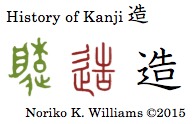 The kanji 造 means “to make; do; assemble.” There seem to be a number of different views on the origin, including that it was just a borrowing. One thing agreed upon is that the upper right was a miscopy and was not related to the kanji 告. The bronze ware style and ten style samples are shown on the left. I hate to leave it this way, but I do not see an account that would be helpful for us to learn.
The kanji 造 means “to make; do; assemble.” There seem to be a number of different views on the origin, including that it was just a borrowing. One thing agreed upon is that the upper right was a miscopy and was not related to the kanji 告. The bronze ware style and ten style samples are shown on the left. I hate to leave it this way, but I do not see an account that would be helpful for us to learn.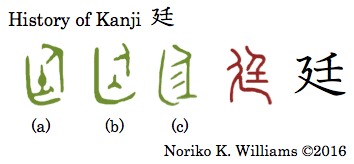 The kanji 廷 had a number of bronze ware style samples, suggesting that it was an important writing in ancient times. I have picked three of them to copy by hand (in green). In (a), the right side was a standing person with his hands put forward above a mound of soil on the ground. (In worshiping the god of the earth, a mound of soil was placed on the ground.) In (c) the soil became a line under the person, signifying the ground on which he stood, and under his hands there were a couple of diagonal lines, signifying rice wine being sprinkled to sanctify the ground. Among all three samples of bronze ware style, (a), (b) and (c), the lower left was a wall around an area where the ceremony took place. Shirakawa explained that was a wall viewed from above. Altogether the writing signified a part of the imperial court where a certain sanctifying rite was conducted. From that it meant “court; imperial court.”
The kanji 廷 had a number of bronze ware style samples, suggesting that it was an important writing in ancient times. I have picked three of them to copy by hand (in green). In (a), the right side was a standing person with his hands put forward above a mound of soil on the ground. (In worshiping the god of the earth, a mound of soil was placed on the ground.) In (c) the soil became a line under the person, signifying the ground on which he stood, and under his hands there were a couple of diagonal lines, signifying rice wine being sprinkled to sanctify the ground. Among all three samples of bronze ware style, (a), (b) and (c), the lower left was a wall around an area where the ceremony took place. Shirakawa explained that was a wall viewed from above. Altogether the writing signified a part of the imperial court where a certain sanctifying rite was conducted. From that it meant “court; imperial court.”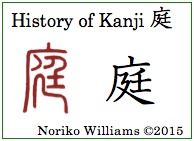 The kanji 庭 has been discussed earlier in connection with a bushu madare “house with one side open; court yard” (
The kanji 庭 has been discussed earlier in connection with a bushu madare “house with one side open; court yard” ( For the kanji 建, the top of (a) in bronze ware style was a hand holding a writing brush, and in (b) soil was attached to the brush. Also in (a), the bottom had a crossroad and a footprint at the bottom, whereas in (b) the bent shape that signified a court wall appeared. These two different shapes in bronze ware style in (a) and (b) gave me the reason for me to think that the ten style shape was a coalescence of the two meanings that I have just mentioned in discussing the kanji 廷 in 1. The writing signified one holding a writing brush upright to decide where in the courtyard they should build a building. From that it meant “to build.”
For the kanji 建, the top of (a) in bronze ware style was a hand holding a writing brush, and in (b) soil was attached to the brush. Also in (a), the bottom had a crossroad and a footprint at the bottom, whereas in (b) the bent shape that signified a court wall appeared. These two different shapes in bronze ware style in (a) and (b) gave me the reason for me to think that the ten style shape was a coalescence of the two meanings that I have just mentioned in discussing the kanji 廷 in 1. The writing signified one holding a writing brush upright to decide where in the courtyard they should build a building. From that it meant “to build.”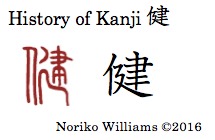 For the kanji 健, the ten style sample had a person on the left (a bushu ninben). The right side 建 “to build,” with an upright writing brush, signified someone standing with his back straight. It was used to mean “good health” and also “bravely; praiseworthily.”
For the kanji 健, the ten style sample had a person on the left (a bushu ninben). The right side 建 “to build,” with an upright writing brush, signified someone standing with his back straight. It was used to mean “good health” and also “bravely; praiseworthily.”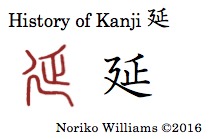 For the kanji 延, the upper right component of the ten style sample had a slanted stroke over a footprint, which signified a stretched stride. The lower left was what we have already discussed – either a crossroad whose one end was pulled to the right; or a court wall stretching. Either way it signified “a stretched way.” Together they meant “to extend; postpone.”
For the kanji 延, the upper right component of the ten style sample had a slanted stroke over a footprint, which signified a stretched stride. The lower left was what we have already discussed – either a crossroad whose one end was pulled to the right; or a court wall stretching. Either way it signified “a stretched way.” Together they meant “to extend; postpone.”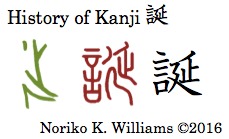 The kanji 誕 has a story that has a sense of humor. The story started in bronze ware style – the top was a footstep stretched long vertically, and the small dot on the upper right and a angle line at the bottom was a crossroad split on the top. This is an odd shape that I have not seen anywhere else so far. The writing meant “to stretch.” In ten style 言, a bushu gonben “word,” was added. Together from stretching words they meant “telling a tall story; to brag.” Very clever, isn’t it. But this original meaning of “bragging” is rarely used now. Later on it came to be used for an unrelated meaning of “to be born.”
The kanji 誕 has a story that has a sense of humor. The story started in bronze ware style – the top was a footstep stretched long vertically, and the small dot on the upper right and a angle line at the bottom was a crossroad split on the top. This is an odd shape that I have not seen anywhere else so far. The writing meant “to stretch.” In ten style 言, a bushu gonben “word,” was added. Together from stretching words they meant “telling a tall story; to brag.” Very clever, isn’t it. But this original meaning of “bragging” is rarely used now. Later on it came to be used for an unrelated meaning of “to be born.” The kanji 構 had two similar oracle bone style samples, in brown. If we look at the top portion and the bottom portion back and forth, we begin to see that they are the mirror images of each other. According the Shirakawa, they were shapes of braided ropes. (I will come back to this point in 8.) The writing signified “to connect two shapes.” For the kanji 構, in ten style time, 木 “wood” was added. Together they meant wooden configuration that repeated the same patterns that people constructed. It meant “structure; to construct.”
The kanji 構 had two similar oracle bone style samples, in brown. If we look at the top portion and the bottom portion back and forth, we begin to see that they are the mirror images of each other. According the Shirakawa, they were shapes of braided ropes. (I will come back to this point in 8.) The writing signified “to connect two shapes.” For the kanji 構, in ten style time, 木 “wood” was added. Together they meant wooden configuration that repeated the same patterns that people constructed. It meant “structure; to construct.”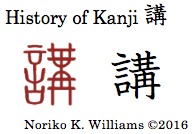 The kanji 講 has only a ten style sample. The right was used phonetically for /ko’o/ to mean “to connect two things,” and the left side had 言 “word; language.” Together “people reconnected by talking” gave the meaning “to reconcile; lecture; talk.”
The kanji 講 has only a ten style sample. The right was used phonetically for /ko’o/ to mean “to connect two things,” and the left side had 言 “word; language.” Together “people reconnected by talking” gave the meaning “to reconcile; lecture; talk.”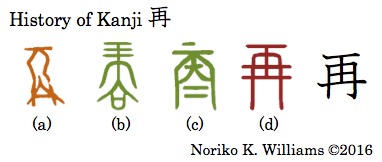 For the kanji 再 we have an oracle bone style sample, (a), and two bronze ware style samples, (b) and (c). (a) showed the shape of a braided rope, and the sideways line at the top. This line at the top indicated the spot where one turned around in making a braided rope. A return signified “again.” The shape of braiding was essentially same as those in the kanji 構 and 講. In bronze ware style, however, it is somewhat not straightforward to view them as a braiding shape. (b) had three lines at the top whereas (c) had two lines inside, signifying “double; to repeat.” From that the kanji 再 meant “to repeat; again.”
For the kanji 再 we have an oracle bone style sample, (a), and two bronze ware style samples, (b) and (c). (a) showed the shape of a braided rope, and the sideways line at the top. This line at the top indicated the spot where one turned around in making a braided rope. A return signified “again.” The shape of braiding was essentially same as those in the kanji 構 and 講. In bronze ware style, however, it is somewhat not straightforward to view them as a braiding shape. (b) had three lines at the top whereas (c) had two lines inside, signifying “double; to repeat.” From that the kanji 再 meant “to repeat; again.”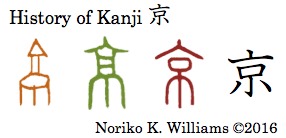 The origin of the kanji 京 was explained by Setsumon two thousand years ago as a very tall hill where people lived. Following that many references explain that the bottom was a tall hill and the top was a town. Ancient people chose a bright tall hill to live where they could avoid floods or humidity, and such an area of concentration became the capital, thus 京 meant “capital.” I took this view in the Key to Kanji. On the other hand, from the earlier writings (oracle bone style, in brown, and bronze ware style, in green) Shirakawa viewed the bottom as a tall arch gate, rather than a hill, and the top as a watchtower. A tall arch gate with a watchtower was built at the entrance of a military quarter or a castle town. From that it came to mean “capital.” A capital was a large town; thus it also meant “large.”
The origin of the kanji 京 was explained by Setsumon two thousand years ago as a very tall hill where people lived. Following that many references explain that the bottom was a tall hill and the top was a town. Ancient people chose a bright tall hill to live where they could avoid floods or humidity, and such an area of concentration became the capital, thus 京 meant “capital.” I took this view in the Key to Kanji. On the other hand, from the earlier writings (oracle bone style, in brown, and bronze ware style, in green) Shirakawa viewed the bottom as a tall arch gate, rather than a hill, and the top as a watchtower. A tall arch gate with a watchtower was built at the entrance of a military quarter or a castle town. From that it came to mean “capital.” A capital was a large town; thus it also meant “large.”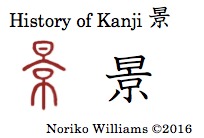 In the ten style writing, in red, of the kanji 景, the top 日 was the sun, and the bottom 京 was used phonetically for /ke’e/, and meant “bright light.” In a high place where the sun is bright, the view is good and clear. The kanji 景 meant a “fine view; good scene.” It is also used to mean good economic condition.
In the ten style writing, in red, of the kanji 景, the top 日 was the sun, and the bottom 京 was used phonetically for /ke’e/, and meant “bright light.” In a high place where the sun is bright, the view is good and clear. The kanji 景 meant a “fine view; good scene.” It is also used to mean good economic condition.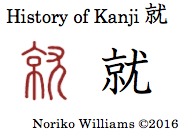 The origin of the kanji 就 remains a mystery. The left side of the ten style sample was 京 “capital,” but what about the right side? Different interpretations include that it was a dog or animal, a hand, or just a phonetic use for /shu’u/ with no particular meaning. Whatever the origin of the shape, phonetically /shu’u/ had the meaning “people gathering.” So let us leave it as meaning “people coming to the capital to take up a job.” The kanji 就 meant “to take up a job; to be engaged in work.”
The origin of the kanji 就 remains a mystery. The left side of the ten style sample was 京 “capital,” but what about the right side? Different interpretations include that it was a dog or animal, a hand, or just a phonetic use for /shu’u/ with no particular meaning. Whatever the origin of the shape, phonetically /shu’u/ had the meaning “people gathering.” So let us leave it as meaning “people coming to the capital to take up a job.” The kanji 就 meant “to take up a job; to be engaged in work.”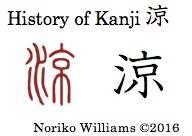 The ten style of the kanji 涼 consisted of a bushu sanzui “water” on the left and 京 used purely phonetically to mean “cold.” Together they meant “cool.”
The ten style of the kanji 涼 consisted of a bushu sanzui “water” on the left and 京 used purely phonetically to mean “cold.” Together they meant “cool.”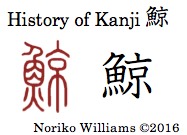 The left side of the kanji 鯨 in ten style was “fish.” The bottom was not a fire but a tailfin. The right side 京 was used phonetically for /ke’e; ge’e/ to mean “big.” Together a large fish meant “whale.” (A whale is not a fish but mammal, but that is irrelevant here.) The kun-yomi /kujira/ means “whale.” The on-yomi /ge’e/ is in 捕鯨船 (“whale catching vessel” /hogeesen/).
The left side of the kanji 鯨 in ten style was “fish.” The bottom was not a fire but a tailfin. The right side 京 was used phonetically for /ke’e; ge’e/ to mean “big.” Together a large fish meant “whale.” (A whale is not a fish but mammal, but that is irrelevant here.) The kun-yomi /kujira/ means “whale.” The on-yomi /ge’e/ is in 捕鯨船 (“whale catching vessel” /hogeesen/).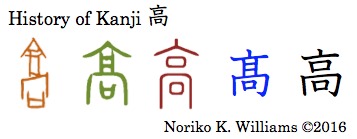 Now we are going to move to the kanji 高. In the samples of ancient writings for the kanji 高 on the left, we see what we saw in 京 – a tall arch gate with a watch tower at the top. At the bottom there was 口, which appeared in almost all the ancient writing samples of 高. And yet the explanations in many reference do not touch upon 口. So I go back to Shirakawa. Shirakawa treated all the 口 shapes as “a box that contained prayers,” rather than a mouth. He explained the kanji 高 as a tall arch gate of a powerful clan where a prayer or pledging was conducted. From the powerful clan it meant “high; tall.” The kyujitai 髙, in blue, reflected bronze ware style better than ten style, which is reflected in shinjitai. It means “tall; high.”
Now we are going to move to the kanji 高. In the samples of ancient writings for the kanji 高 on the left, we see what we saw in 京 – a tall arch gate with a watch tower at the top. At the bottom there was 口, which appeared in almost all the ancient writing samples of 高. And yet the explanations in many reference do not touch upon 口. So I go back to Shirakawa. Shirakawa treated all the 口 shapes as “a box that contained prayers,” rather than a mouth. He explained the kanji 高 as a tall arch gate of a powerful clan where a prayer or pledging was conducted. From the powerful clan it meant “high; tall.” The kyujitai 髙, in blue, reflected bronze ware style better than ten style, which is reflected in shinjitai. It means “tall; high.” The kanji 稿 consists of two components side by side, a bushu nogihen (禾) “rice plant” and 高, used phonetically for /ko’o/ for “dry.” On the other hand the ten style sample had a rice plant inside 高. We see this kind of dislocation of different elements in oracle bone style and bronze ware style all the time, but it is very unusual at this late stage of kanji formation. In the Kangxi dictionary, the orthodox kanji for 稿 had 高 at the top and 禾 at the bottom (not inside 高). “Rice plants” and “dry” together originally meant “straw.” Straw scattered is similar to scattered scribbles or notes for manuscripts. From that it means “manuscripts; draft.” (The current kanji for “straw” is 藁, consisting of a bushu kusakanmuri, 高 and 木, vertically placed).
The kanji 稿 consists of two components side by side, a bushu nogihen (禾) “rice plant” and 高, used phonetically for /ko’o/ for “dry.” On the other hand the ten style sample had a rice plant inside 高. We see this kind of dislocation of different elements in oracle bone style and bronze ware style all the time, but it is very unusual at this late stage of kanji formation. In the Kangxi dictionary, the orthodox kanji for 稿 had 高 at the top and 禾 at the bottom (not inside 高). “Rice plants” and “dry” together originally meant “straw.” Straw scattered is similar to scattered scribbles or notes for manuscripts. From that it means “manuscripts; draft.” (The current kanji for “straw” is 藁, consisting of a bushu kusakanmuri, 高 and 木, vertically placed).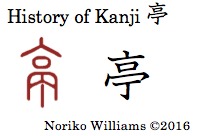 The third writing that shares an origin with 京 and 高 is the kanji 亭. It does not have an oracle bone style or bronze ware style sample. Inside a tall arch gate with a watchtower was 丁 “straight up,” used phonetically for /te’e/. Together they originally meant a house that stood alone or “pavilion; arbor.”
The third writing that shares an origin with 京 and 高 is the kanji 亭. It does not have an oracle bone style or bronze ware style sample. Inside a tall arch gate with a watchtower was 丁 “straight up,” used phonetically for /te’e/. Together they originally meant a house that stood alone or “pavilion; arbor.” The kanji 停 consisted of a bushu ninben “person” and 亭 “house that stands alone; station,” which was also used phonetically for /te’e/. Together a place to stop meant “to stop; stay.”
The kanji 停 consisted of a bushu ninben “person” and 亭 “house that stands alone; station,” which was also used phonetically for /te’e/. Together a place to stop meant “to stop; stay.”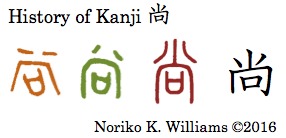 For the kanji 尚, in the oracle bone style, in brown, and bronze ware style, in brown, it was a house with a window or a kitchen stove with a door to the hearth. The two short lines above that were rising smoke. Smoke rising and staying for a long time gave two meanings. One is that from rising smoke staying for a long time it means “and yet; in additions to.” Another is that it means someone in high respect, or “to revere.” The kanji 尚 meant “high; revered; and yet.”
For the kanji 尚, in the oracle bone style, in brown, and bronze ware style, in brown, it was a house with a window or a kitchen stove with a door to the hearth. The two short lines above that were rising smoke. Smoke rising and staying for a long time gave two meanings. One is that from rising smoke staying for a long time it means “and yet; in additions to.” Another is that it means someone in high respect, or “to revere.” The kanji 尚 meant “high; revered; and yet.”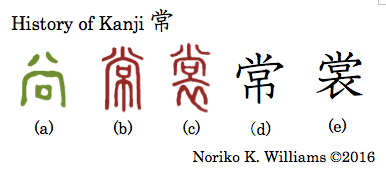 For the kanji 常, the bronze ware style writing (a) shown on the left was same as that of the kanji 尚. Even though it was used phonetically in this kanji, sharing the same earlier writing indicated that the meanings of 尚 was inclusive of 常. Setsumon listed two samples of ten style writings for this kanji (b) and (c). (b) had 尚 with its sides stretched down very long and 巾 was placed inside. 巾 was a long ceremonial scarf that was worn around the waist. The meaning “lasting long” from 尚 and long piece of cloth got the meaning “always; constant.” (b) became the kanji 常 (d).
For the kanji 常, the bronze ware style writing (a) shown on the left was same as that of the kanji 尚. Even though it was used phonetically in this kanji, sharing the same earlier writing indicated that the meanings of 尚 was inclusive of 常. Setsumon listed two samples of ten style writings for this kanji (b) and (c). (b) had 尚 with its sides stretched down very long and 巾 was placed inside. 巾 was a long ceremonial scarf that was worn around the waist. The meaning “lasting long” from 尚 and long piece of cloth got the meaning “always; constant.” (b) became the kanji 常 (d).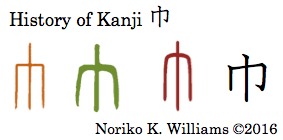 All three ancient writing styles and the kanji were basically the same shape. It was a piece of ceremonial scarf that was worn around the waist. From that it meant “a piece of cloth.” There is no kun-yomi in shinjitai, even though 巾 was used informally for the kanji 幅 /haba/ “width” in the kyujitai system. The on-yomi /ki’n/ is in 布巾 (“kitchen cloth” /huki’n/), 雑巾 (“(quilting) cleaning cloth; dust cloth” /zookin/) and 頭巾 (“hood; headscarf” /zu’kin/)
All three ancient writing styles and the kanji were basically the same shape. It was a piece of ceremonial scarf that was worn around the waist. From that it meant “a piece of cloth.” There is no kun-yomi in shinjitai, even though 巾 was used informally for the kanji 幅 /haba/ “width” in the kyujitai system. The on-yomi /ki’n/ is in 布巾 (“kitchen cloth” /huki’n/), 雑巾 (“(quilting) cleaning cloth; dust cloth” /zookin/) and 頭巾 (“hood; headscarf” /zu’kin/)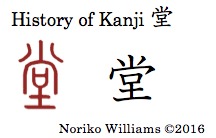 For the kanji 堂, the ten style writing sample had 土 “soil” under 尚, a house with smoke rising high. A tall house that was built on a foundation of soil meant a “hall; temple.” A tall building was impressive, so it also meant “stately.”
For the kanji 堂, the ten style writing sample had 土 “soil” under 尚, a house with smoke rising high. A tall house that was built on a foundation of soil meant a “hall; temple.” A tall building was impressive, so it also meant “stately.”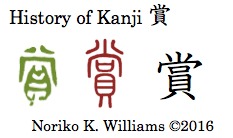 For the kanji 賞, the bronze ware style top had 尚 “high,” even though it lacked the window, and it was used phonetically for /sho’o/. The bottom was a cowry “money; valuable items.” Money or prizes given to praise someone’s achievement or merit meant “to give an award; reward.” The ten style writing consisted of 尚 and 貝. The kanji 賞 meant “award; prize; reward.”
For the kanji 賞, the bronze ware style top had 尚 “high,” even though it lacked the window, and it was used phonetically for /sho’o/. The bottom was a cowry “money; valuable items.” Money or prizes given to praise someone’s achievement or merit meant “to give an award; reward.” The ten style writing consisted of 尚 and 貝. The kanji 賞 meant “award; prize; reward.”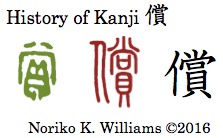 The kanji 償 consists of a bushu ninben “person” and the kanji 賞. The bronze ware style writing was the same as 賞. The other side of 賞 “award; reward” is that the awardee made some sacrifice in order to make that achievement. By adding a ninben, the kanji 償 differentiated the two sides of one thing. In order to correct a wrong, one also needs to make a right. The kanji 償 meant “to make up; compensate; stone for.”
The kanji 償 consists of a bushu ninben “person” and the kanji 賞. The bronze ware style writing was the same as 賞. The other side of 賞 “award; reward” is that the awardee made some sacrifice in order to make that achievement. By adding a ninben, the kanji 償 differentiated the two sides of one thing. In order to correct a wrong, one also needs to make a right. The kanji 償 meant “to make up; compensate; stone for.”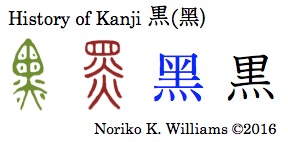 For the kanji 黒, in bronze ware style the bottom was a flame. The top had different interpretations – One is that it was a chimney that was viewed from the top and the soot was visible as dots. In this interpretation the origin of the kanji 黒 was a stove with a sooty chimney. Soot is black; thus the kanji 黒 meant “black.” Another interpretation, by Shirakawa, is that the top was a bag of stuff or fabric that was wrapped up by a string to be smoked. The smoking dyed the fabric a dark color or black. In this view the origin was a smoker for dyeing cloth. In ten style the top looked more like a chimney top, and the bottom became two fires. In kyujitai 黑, in blue, there were two black dots for soot, and the fire at the bottom became four dots. In most cases of kanji having a fire, when a fire appeared at the bottom of a kanji, it became four dots, and it is called a bushu renga or rekka. We will look at this bush later when we discuss nature. The kanji 黒 means “black; dark.”
For the kanji 黒, in bronze ware style the bottom was a flame. The top had different interpretations – One is that it was a chimney that was viewed from the top and the soot was visible as dots. In this interpretation the origin of the kanji 黒 was a stove with a sooty chimney. Soot is black; thus the kanji 黒 meant “black.” Another interpretation, by Shirakawa, is that the top was a bag of stuff or fabric that was wrapped up by a string to be smoked. The smoking dyed the fabric a dark color or black. In this view the origin was a smoker for dyeing cloth. In ten style the top looked more like a chimney top, and the bottom became two fires. In kyujitai 黑, in blue, there were two black dots for soot, and the fire at the bottom became four dots. In most cases of kanji having a fire, when a fire appeared at the bottom of a kanji, it became four dots, and it is called a bushu renga or rekka. We will look at this bush later when we discuss nature. The kanji 黒 means “black; dark.”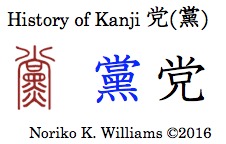 Now the kanji 党. In ten style, the writing for 黑 was completely enclosed inside 尚 that was used phonetically. The two sides of 尚 were elongated, but I think this was just a stylistic modification common to ten style. The two meanings — smoke rising high and a cooking stove (with sooty chimney) –signified a group of people who shared food that was prepared in this kitchen. It meant “party; a group of people who share the same idea and act together.” In kyujitai 黨, the side of 尚 became very short and the bottom was 黑. In shinjitai, the shape for “black; dark” was replaced by a bushu ninnyoo “person.” Together with a window in 尚, they ended up in the shape of the kanji 兄. The kanji 党 means “political party; a group of people banded together.”
Now the kanji 党. In ten style, the writing for 黑 was completely enclosed inside 尚 that was used phonetically. The two sides of 尚 were elongated, but I think this was just a stylistic modification common to ten style. The two meanings — smoke rising high and a cooking stove (with sooty chimney) –signified a group of people who shared food that was prepared in this kitchen. It meant “party; a group of people who share the same idea and act together.” In kyujitai 黨, the side of 尚 became very short and the bottom was 黑. In shinjitai, the shape for “black; dark” was replaced by a bushu ninnyoo “person.” Together with a window in 尚, they ended up in the shape of the kanji 兄. The kanji 党 means “political party; a group of people banded together.”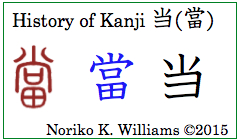 The origin of the kanji 当 has been discussed earlier in the context of 田 “rice paddies” (
The origin of the kanji 当 has been discussed earlier in the context of 田 “rice paddies” (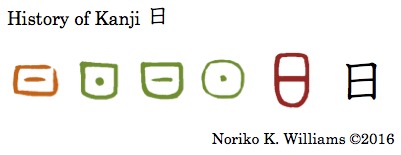 For the kanji 日, the oracle bone style writing, in brown, and bronze ware style writings, in green, had a square shape or a circle with a dot or a short line in the middle. The dot or the short line indicated that the inside was not empty. In ten style, in red, the middle dot became a line across. The kanji 日 meant “the sun; day; date; light.” From the country name 日本 /niho’n/, it also meant “Japan; Japanese.”
For the kanji 日, the oracle bone style writing, in brown, and bronze ware style writings, in green, had a square shape or a circle with a dot or a short line in the middle. The dot or the short line indicated that the inside was not empty. In ten style, in red, the middle dot became a line across. The kanji 日 meant “the sun; day; date; light.” From the country name 日本 /niho’n/, it also meant “Japan; Japanese.”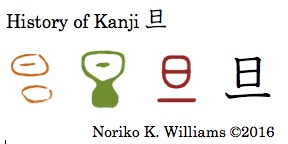 The origin of the kanji 旦 is often explained that the top was the sun and the line below was the land or horizon, and that it meant “sunrise; morning.” The explanation works well with the kanji, but when we look at the oracle bone style and bronze ware style writings, such as those shown on the left, the bottom does not look like the land or horizon. It is more like a cloud (Shirakawa). So, the morning sun rising above the clouds in the sky may be a better interpretation. The kanji 旦 meant “sunrise; daybreak.”
The origin of the kanji 旦 is often explained that the top was the sun and the line below was the land or horizon, and that it meant “sunrise; morning.” The explanation works well with the kanji, but when we look at the oracle bone style and bronze ware style writings, such as those shown on the left, the bottom does not look like the land or horizon. It is more like a cloud (Shirakawa). So, the morning sun rising above the clouds in the sky may be a better interpretation. The kanji 旦 meant “sunrise; daybreak.”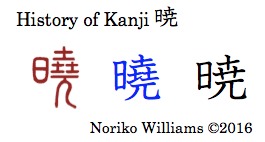 The ten style writing for the kanji 暁 had the sun on the left, and the right side was used phonetically to mean “to become white.” Together they signified the time when the dark eastern sky became white, which was “dawn.” The kyujitai, in blue, kept the three 土 from the ten style writing, which became simplified in the shinjitai. (We will see this component in 焼 when we look at a bushu hihen 火 later on.)
The ten style writing for the kanji 暁 had the sun on the left, and the right side was used phonetically to mean “to become white.” Together they signified the time when the dark eastern sky became white, which was “dawn.” The kyujitai, in blue, kept the three 土 from the ten style writing, which became simplified in the shinjitai. (We will see this component in 焼 when we look at a bushu hihen 火 later on.) For the kanji 朝 the oracle bone style writing had tall grass in the four corners, the sun in the middle on the left, and the moon in the center. Together they signified the time when the sun started to appear between the grasses and yet the moon was still in the sky. It meant “early morning.” The bronze ware style sample had water on the right, signifying the morning tide. In ten style water was replaced by a boat, with a flag at the top (also signifying “high”). In kanji the right side has 月. In kanji the component 月 carries a few different meanings in their origins — a “moon,” a “boat,” or “flesh” as in bushu nikuzuki. So, is the 月 in 朝 a “moon” or a “boat”? I would think it could be either because both existed in ancient writing – a moon in oracle bone style and a boat in ten style. In the ancient Imperial Court important protocols and business were held in the morning. From that it also meant “dynasty; imperial court.”
For the kanji 朝 the oracle bone style writing had tall grass in the four corners, the sun in the middle on the left, and the moon in the center. Together they signified the time when the sun started to appear between the grasses and yet the moon was still in the sky. It meant “early morning.” The bronze ware style sample had water on the right, signifying the morning tide. In ten style water was replaced by a boat, with a flag at the top (also signifying “high”). In kanji the right side has 月. In kanji the component 月 carries a few different meanings in their origins — a “moon,” a “boat,” or “flesh” as in bushu nikuzuki. So, is the 月 in 朝 a “moon” or a “boat”? I would think it could be either because both existed in ancient writing – a moon in oracle bone style and a boat in ten style. In the ancient Imperial Court important protocols and business were held in the morning. From that it also meant “dynasty; imperial court.”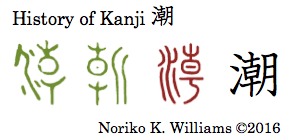 朝 /cho’o/ is used phonetically in the kanji 潮. The two bronze ware style writings of the kanji 潮 shown on the left had “water; tide,” and the other side was “the sun emerging between grass.” From “morning tide” it meant “tide; current.” In ten style, it had the same components. The water by the sunrise suggested a “morning tide.” So, it meant “tide.” In kanji a boat was added on the right side to the ten style writing. The kanji 潮 also means “trend.”
朝 /cho’o/ is used phonetically in the kanji 潮. The two bronze ware style writings of the kanji 潮 shown on the left had “water; tide,” and the other side was “the sun emerging between grass.” From “morning tide” it meant “tide; current.” In ten style, it had the same components. The water by the sunrise suggested a “morning tide.” So, it meant “tide.” In kanji a boat was added on the right side to the ten style writing. The kanji 潮 also means “trend.”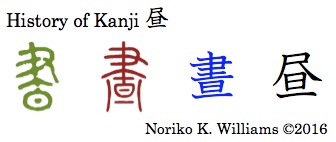 The bronze ware style writing of the kanji 昼 had a writing brush held by a hand at the top and the sun with a cover at the bottom. It is not clear what these originally signified (other than the meaning “noon; day time.”) In ten style the two curved lines on the sides surrounding the sun represented two dark times of the day before and after daylight time. Between those lines is “daytime.” The kyujitai 晝 consisted of 聿, 日 and 一. Then there was a further change to the shinjitai — the sun (日) was placed under a roof (尸), with another stroke blocking the sun shine. If our reader finds this popular explanation not convincing, you may be right. I do not have a better story for this.
The bronze ware style writing of the kanji 昼 had a writing brush held by a hand at the top and the sun with a cover at the bottom. It is not clear what these originally signified (other than the meaning “noon; day time.”) In ten style the two curved lines on the sides surrounding the sun represented two dark times of the day before and after daylight time. Between those lines is “daytime.” The kyujitai 晝 consisted of 聿, 日 and 一. Then there was a further change to the shinjitai — the sun (日) was placed under a roof (尸), with another stroke blocking the sun shine. If our reader finds this popular explanation not convincing, you may be right. I do not have a better story for this.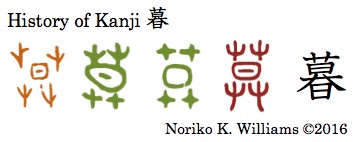 In oracle bone style and bronze ware style the writing consisted of the sun in the middle and four grasses or plants in all four corners. It was the time when the sun was about to disappear or “sundown; twilight.” The components remained the same in ten style except that the shapes of grasses were more stylized. In kanji the top became a bushu kusakanmuri “plants; vegetation,” and the bottom became a three-stroke 大-like shape and an additional sun. This additional sun was added because the original writing for evening 莫 came to be used for “nothing” or a negative meaning. When the sun disappears behind grass nothing is visible, thus “nothing.” In addition to “sundown” the kanji 暮 also means “end (of day, year).” In Japanese, 暮 is also used to mean “to live a life.” How one spends a day is life. It makes me pause to think about daily life.
In oracle bone style and bronze ware style the writing consisted of the sun in the middle and four grasses or plants in all four corners. It was the time when the sun was about to disappear or “sundown; twilight.” The components remained the same in ten style except that the shapes of grasses were more stylized. In kanji the top became a bushu kusakanmuri “plants; vegetation,” and the bottom became a three-stroke 大-like shape and an additional sun. This additional sun was added because the original writing for evening 莫 came to be used for “nothing” or a negative meaning. When the sun disappears behind grass nothing is visible, thus “nothing.” In addition to “sundown” the kanji 暮 also means “end (of day, year).” In Japanese, 暮 is also used to mean “to live a life.” How one spends a day is life. It makes me pause to think about daily life.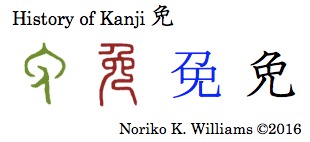 The kanji 免 – The kanji 免 “to avoid; barely” came from two totally different sources. In bronze style the top was a warrior’s helmet, and the bottom was a standing person with his hand in front. When a soldier came out alive from a battle he would take off his protective headpiece, a helmet. From that it meant “to dodge danger; avoid; barely.” It also means “to be exempted; allow.” The ten style writing is generally interpreted as a woman being in labor- with the top “person,” the middle “waist/hips” and the bottom “legs open for childbirth.” A baby is born by making it through a narrow passage during childbirth, which gave the meaning “barely (making it).”
The kanji 免 – The kanji 免 “to avoid; barely” came from two totally different sources. In bronze style the top was a warrior’s helmet, and the bottom was a standing person with his hand in front. When a soldier came out alive from a battle he would take off his protective headpiece, a helmet. From that it meant “to dodge danger; avoid; barely.” It also means “to be exempted; allow.” The ten style writing is generally interpreted as a woman being in labor- with the top “person,” the middle “waist/hips” and the bottom “legs open for childbirth.” A baby is born by making it through a narrow passage during childbirth, which gave the meaning “barely (making it).”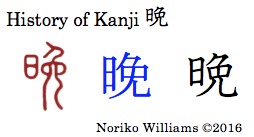 The kanji 晩— The right side 免 was used in the kanji 晩. Its ten style writing consisted of the sun 日, and 免, which was used phonetically to mean “something hidden and invisible.” From “the sun being hidden and not visible” it meant “evening; early night.” It is also used to mean “late.”
The kanji 晩— The right side 免 was used in the kanji 晩. Its ten style writing consisted of the sun 日, and 免, which was used phonetically to mean “something hidden and invisible.” From “the sun being hidden and not visible” it meant “evening; early night.” It is also used to mean “late.”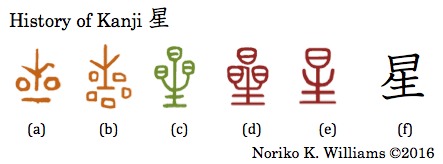 What shines or glistens in a night sky is stars. For the kanji 星 “star,” in oracle bone style (a) and (b), at the center was the a plant emerging a new from the ground, which was used phonetically for /se’e/. The small circles or squares around it were glistening stars. It meant “star.” In bronze ware style the small squares had a line in the middle like the sun. As ten style writings Setsumon gave two writings (d) and (e). (d) was originally the authentic writing and (e) was an alternative writing, but the kanji (f) reflects (e). Something in the sky that glistens emerges at night is a star. Or, we can also say that stars are born anew every night.
What shines or glistens in a night sky is stars. For the kanji 星 “star,” in oracle bone style (a) and (b), at the center was the a plant emerging a new from the ground, which was used phonetically for /se’e/. The small circles or squares around it were glistening stars. It meant “star.” In bronze ware style the small squares had a line in the middle like the sun. As ten style writings Setsumon gave two writings (d) and (e). (d) was originally the authentic writing and (e) was an alternative writing, but the kanji (f) reflects (e). Something in the sky that glistens emerges at night is a star. Or, we can also say that stars are born anew every night.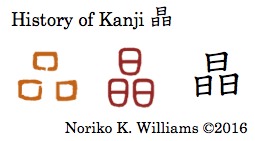 Another kanji that came from something glistening is 晶. In oracle bone style it had three squares, which signified many things that shined or sparkled. In ten style lines were placed to indicate that inside was shining. 晶 meant “pure and bright.” It is also worth noting that the kanji 星 in the authentic ten style had three 日.
Another kanji that came from something glistening is 晶. In oracle bone style it had three squares, which signified many things that shined or sparkled. In ten style lines were placed to indicate that inside was shining. 晶 meant “pure and bright.” It is also worth noting that the kanji 星 in the authentic ten style had three 日.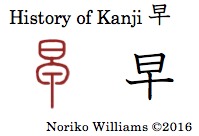 The etymology of the kanji 早 is not agreed upon. One source (Kanjigen) says that the whole writing was a pictograph of an acorn, and acorn’s black hulls were used as dye for black or dark color. From the time that was still dark in the morning meant “early.” I used this explanation in the Key to Kanji. The second source (Kadokawa) is that the top 日 was the sun, and the bottom 十 was a seed germinating, pushing up, and was used phonetically. Together they meant the time when the sun rises, which is “early” in the morning. The third source (Shirakawa) treated it as a borrowing from “spoon” 是. For lack of earlier writing, it is hard to choose one over others.
The etymology of the kanji 早 is not agreed upon. One source (Kanjigen) says that the whole writing was a pictograph of an acorn, and acorn’s black hulls were used as dye for black or dark color. From the time that was still dark in the morning meant “early.” I used this explanation in the Key to Kanji. The second source (Kadokawa) is that the top 日 was the sun, and the bottom 十 was a seed germinating, pushing up, and was used phonetically. Together they meant the time when the sun rises, which is “early” in the morning. The third source (Shirakawa) treated it as a borrowing from “spoon” 是. For lack of earlier writing, it is hard to choose one over others.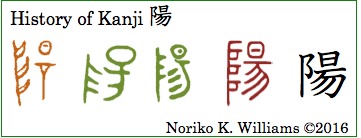 The kanji 陽— Speaking of the sun rising, we have looked at the kanji 陽 in the earlier post [
The kanji 陽— Speaking of the sun rising, we have looked at the kanji 陽 in the earlier post [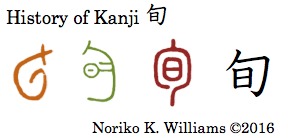 In the kanji 旬, 日 was used to mean a “day.” The oracle bone style writing was a dragon with his tail curled up. The bronze ware style writing had the sun added inside the semi-circle. The ancient calendar in China during the Yin (殷) dynasty used a calendar that had a cycle of ten days. A round shape suggested a cycle. With the sun in side, they meant “ten days,” which is one third of a month. It is also used to mean produce and fish that is “in the season,” the best time to eat.
In the kanji 旬, 日 was used to mean a “day.” The oracle bone style writing was a dragon with his tail curled up. The bronze ware style writing had the sun added inside the semi-circle. The ancient calendar in China during the Yin (殷) dynasty used a calendar that had a cycle of ten days. A round shape suggested a cycle. With the sun in side, they meant “ten days,” which is one third of a month. It is also used to mean produce and fish that is “in the season,” the best time to eat. We have looked at the kanji 時 in connection with 寸 “hand” in the earlier post.
We have looked at the kanji 時 in connection with 寸 “hand” in the earlier post. 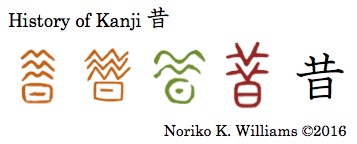 For the kanji 昔, the two oracle bone style writings and the bronze ware style writing, in green, had two or three wavy lines at the top and the sun at the bottom. What were these wavy lines? The interpretations among reference vary; (1) layers of floor covering (Kadokawa); and (2) an abstract symbol for “accumulation” (Kanjigen). With the sun added to the meaning layers, accumulation or repeat, the kanji 昔 meant “bygone days; ancient times.” Another interpretation (3) is that top was thin pieces of meat dried under the sun, i.e. a jerky (Shirakawa from Setsumon). Then it was borrowed to mean “bygone days; ancient times.”
For the kanji 昔, the two oracle bone style writings and the bronze ware style writing, in green, had two or three wavy lines at the top and the sun at the bottom. What were these wavy lines? The interpretations among reference vary; (1) layers of floor covering (Kadokawa); and (2) an abstract symbol for “accumulation” (Kanjigen). With the sun added to the meaning layers, accumulation or repeat, the kanji 昔 meant “bygone days; ancient times.” Another interpretation (3) is that top was thin pieces of meat dried under the sun, i.e. a jerky (Shirakawa from Setsumon). Then it was borrowed to mean “bygone days; ancient times.”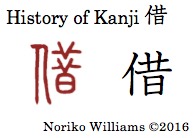 The ten style writing of the kanji 借 had a standing person on the left and the shape from the kanji昔 on the right side, which was used phonetically to mean “to borrow temporarily.“ It meant “to borrow.”
The ten style writing of the kanji 借 had a standing person on the left and the shape from the kanji昔 on the right side, which was used phonetically to mean “to borrow temporarily.“ It meant “to borrow.” The history of the kanji 春 is shown on the left. In oracle bone style (a) the left side had a tree and the sun, and the right side also was a tree. I am unable to figure out what the center signified. (No interpretation is available on this shape.) The bronze ware style writing (b) had grass or plants at the top, a plant trying to sprout up in the middle and the sun at the bottom. Together they meant the season when plants are pushing upward under the brighter sun — that is, “spring.” The ten style writing (c) was a stylized version of (b). But as we know, the kanji 春 (e) consists of three horizontal lines三, the kanji 人, and 日. I always find it somewhat difficult to see the flow from ten style to kanji in 春. So this time I went back to writing samples between the two styles, including inscriptions on a stone stele and brush writings on silk cloth. The photo (d) is a sample of brush writing on silk cloth in the 2nd century B.C. taken directly from a reference, not my reproduction by hand. I think that in (d) we can recognize how the lines in (c) were simplified to the kanji shape (e).
The history of the kanji 春 is shown on the left. In oracle bone style (a) the left side had a tree and the sun, and the right side also was a tree. I am unable to figure out what the center signified. (No interpretation is available on this shape.) The bronze ware style writing (b) had grass or plants at the top, a plant trying to sprout up in the middle and the sun at the bottom. Together they meant the season when plants are pushing upward under the brighter sun — that is, “spring.” The ten style writing (c) was a stylized version of (b). But as we know, the kanji 春 (e) consists of three horizontal lines三, the kanji 人, and 日. I always find it somewhat difficult to see the flow from ten style to kanji in 春. So this time I went back to writing samples between the two styles, including inscriptions on a stone stele and brush writings on silk cloth. The photo (d) is a sample of brush writing on silk cloth in the 2nd century B.C. taken directly from a reference, not my reproduction by hand. I think that in (d) we can recognize how the lines in (c) were simplified to the kanji shape (e).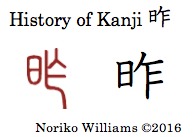 The kanji 作 is a phonetic-semantic composite形声文字– 日, a bushu hihen, “the sun,” and 乍for the sound /sa’ku/. So, let us take a look at the fuller history of the right side 乍 shown on the right.
The kanji 作 is a phonetic-semantic composite形声文字– 日, a bushu hihen, “the sun,” and 乍for the sound /sa’ku/. So, let us take a look at the fuller history of the right side 乍 shown on the right. 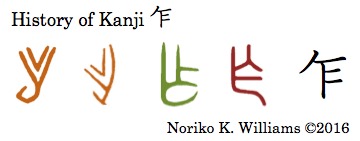 There are two different views on the origin of 乍 — (1) a craft tool for chipping off pieces of wood; and (2) bending vines in a craft such as a basket-making. 乍 meant “to make; create.” Later on 乍 began to be used phonetically in other kanji, so an additional component was added to differentiate the meanings. For the original meaning ”to make; create” a person was added (作). With the sun 日 added, the kanji 昨 was created to mean “last; previous.” With a sake cask 酉 added, the kanji for “vinegar; sour” was created (酢).
There are two different views on the origin of 乍 — (1) a craft tool for chipping off pieces of wood; and (2) bending vines in a craft such as a basket-making. 乍 meant “to make; create.” Later on 乍 began to be used phonetically in other kanji, so an additional component was added to differentiate the meanings. For the original meaning ”to make; create” a person was added (作). With the sun 日 added, the kanji 昨 was created to mean “last; previous.” With a sake cask 酉 added, the kanji for “vinegar; sour” was created (酢).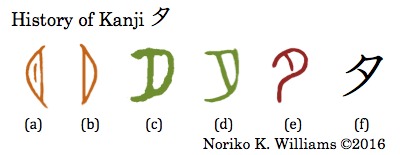 In order to discuss the kanji 夕, we also need to look at the kanji 月 because in the early times in oracle bone style, (a) and (b) in brown, they shared the same shapes – a crescent moon with or without a short line inside. The history of the kanji 夕 is shown on the left and the history of the kanji 月 is shown in 2 below. In bronze ware style, (c)s and (d)s in green in both kanji, 夕 did not have a short line inside whereas 月 did. This short line was added to differentiate the two meanings, one for “evening” (夕) and one for “moon” (月). In ten style, (e)s in red, the inner outline of a crescent became a short stroke in both 夕 and 月, for the kanji 月 resulting in having two short strokes inside. The kanji 夕 meant “evening; early evening,” and the kanji 月 meant “moon.”
In order to discuss the kanji 夕, we also need to look at the kanji 月 because in the early times in oracle bone style, (a) and (b) in brown, they shared the same shapes – a crescent moon with or without a short line inside. The history of the kanji 夕 is shown on the left and the history of the kanji 月 is shown in 2 below. In bronze ware style, (c)s and (d)s in green in both kanji, 夕 did not have a short line inside whereas 月 did. This short line was added to differentiate the two meanings, one for “evening” (夕) and one for “moon” (月). In ten style, (e)s in red, the inner outline of a crescent became a short stroke in both 夕 and 月, for the kanji 月 resulting in having two short strokes inside. The kanji 夕 meant “evening; early evening,” and the kanji 月 meant “moon.”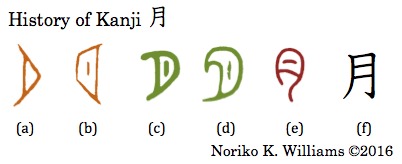 We have already discussed the history of kanji 月 in 1. The kun-yomi 月 /tsuki’/ means “moon; month,” and is in お月様 (“moon” /otsuki’sama/ in child’s speaking), 三日月 (“crescent” /mikazuki/), 月毎に (“each month; every month” /tsukigo’to-ni/) and 月見・お月見 (“moon viewing” /tsukimi; otsukimi/). The on-yomi /ge’tsu/ was a kan-on, and is in 一ヶ月 (“for a month” /ikka’getsu/), 月謝 (“monthly tuition” /gessha/), 月曜日 (“Monday” /getsuyo’obi/), 年月をかける (“to put in many years” /ne’ngetsu-o kake’ru/), 月給 (“monthly salary; salary” /gekkyuu/). Another on-yomi /ga’tsu/ was a go-on, and is in 正月 (“New years days; January” /shoogatsu/), and also in the names of the twelve months, such as 一月 (“January” /ichigatsu/), 四月 (“april” /shigatsu/), 七月 (“July” /shichigatsu/), 九月 (“September” /ku’gatsu/). The pronunciations /sho’o/ for 正 in 正月 and /ku/ for 九 in 九月 were go-on. So it makes sense to pronounce 月 as /gatsu/ in go-on.
We have already discussed the history of kanji 月 in 1. The kun-yomi 月 /tsuki’/ means “moon; month,” and is in お月様 (“moon” /otsuki’sama/ in child’s speaking), 三日月 (“crescent” /mikazuki/), 月毎に (“each month; every month” /tsukigo’to-ni/) and 月見・お月見 (“moon viewing” /tsukimi; otsukimi/). The on-yomi /ge’tsu/ was a kan-on, and is in 一ヶ月 (“for a month” /ikka’getsu/), 月謝 (“monthly tuition” /gessha/), 月曜日 (“Monday” /getsuyo’obi/), 年月をかける (“to put in many years” /ne’ngetsu-o kake’ru/), 月給 (“monthly salary; salary” /gekkyuu/). Another on-yomi /ga’tsu/ was a go-on, and is in 正月 (“New years days; January” /shoogatsu/), and also in the names of the twelve months, such as 一月 (“January” /ichigatsu/), 四月 (“april” /shigatsu/), 七月 (“July” /shichigatsu/), 九月 (“September” /ku’gatsu/). The pronunciations /sho’o/ for 正 in 正月 and /ku/ for 九 in 九月 were go-on. So it makes sense to pronounce 月 as /gatsu/ in go-on. In the oracle bone style writing for 外 shown on the left, the right side was a baked oracle bone with cracks that were read as “oracle; fortune telling.” For the left, which looked like 工, I have not come across any reference other than a photo in Akai (2010). So I leave it as it is. In bronze ware style and ten style the left side was a moon, signifying “evening.” There are different interpretations of what 夕 “moon; evening” and ト“oracle” together signified — (1) An oracle was done at sunrise. An oracle in the evening would be a deviation from the norm; thus it meant “outside; not right.” (Setsumon); (2) The cracks in an oracle bone appeared on the surface of the bone, so it meant “outside; exterior”; and (3) A crescent was used phonetically to mean “to chip” as in 缺 (欠) /ketsu/. Oracle was done by observing a moon passing through a phase from a full moon to a new moon. A crescent was the outer line of a moon, and the kanji 外 meant “outside; exterior.”
In the oracle bone style writing for 外 shown on the left, the right side was a baked oracle bone with cracks that were read as “oracle; fortune telling.” For the left, which looked like 工, I have not come across any reference other than a photo in Akai (2010). So I leave it as it is. In bronze ware style and ten style the left side was a moon, signifying “evening.” There are different interpretations of what 夕 “moon; evening” and ト“oracle” together signified — (1) An oracle was done at sunrise. An oracle in the evening would be a deviation from the norm; thus it meant “outside; not right.” (Setsumon); (2) The cracks in an oracle bone appeared on the surface of the bone, so it meant “outside; exterior”; and (3) A crescent was used phonetically to mean “to chip” as in 缺 (欠) /ketsu/. Oracle was done by observing a moon passing through a phase from a full moon to a new moon. A crescent was the outer line of a moon, and the kanji 外 meant “outside; exterior.”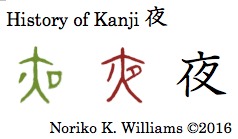 The bronze ware style and ten style writings of the kanji 夜 shown on the left had a standing person with his arms and legs spread (大) in the middle, a moon on the right side under his arm, and a short slanted line on the left. This short slanted line is open to different interpretations. One is that it was a person lying at rest; altogether they signified the time when a person rested, that is “night.” Another interpretation is that the short stroke was something that signified repeated occurrence. A moon appears at night and that repeats, thus it meant “night.” In kanji the top portion of a person became a house or roof at the top; a person became a ninben on the left; and the moon on the right. The kanji 夜 means “night.”
The bronze ware style and ten style writings of the kanji 夜 shown on the left had a standing person with his arms and legs spread (大) in the middle, a moon on the right side under his arm, and a short slanted line on the left. This short slanted line is open to different interpretations. One is that it was a person lying at rest; altogether they signified the time when a person rested, that is “night.” Another interpretation is that the short stroke was something that signified repeated occurrence. A moon appears at night and that repeats, thus it meant “night.” In kanji the top portion of a person became a house or roof at the top; a person became a ninben on the left; and the moon on the right. The kanji 夜 means “night.”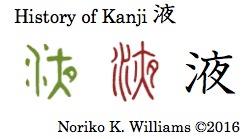 was running water. The right side was used phonetically for /e’ki/ to mean the sound of dripping repeatedly or “continuous.” Liquid drips repeatedly. It meant “liquid; fluid; solution.”
was running water. The right side was used phonetically for /e’ki/ to mean the sound of dripping repeatedly or “continuous.” Liquid drips repeatedly. It meant “liquid; fluid; solution.” In oracle bone style, (b), and bronze ware style, (c) and (d), next to the moon was a window. The writing depicted moonlight coming through a window that made inside bright. Giving something a light makes it more visible and clearer. The kanji 明 meant “bright; clear.” The ten style writing (f) was a stylized shape that had a window and a moon.
In oracle bone style, (b), and bronze ware style, (c) and (d), next to the moon was a window. The writing depicted moonlight coming through a window that made inside bright. Giving something a light makes it more visible and clearer. The kanji 明 meant “bright; clear.” The ten style writing (f) was a stylized shape that had a window and a moon.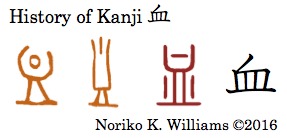 In the two oracle bone style writings for the kanji 血, it had a deep dish. The circle in the first one and the short line at the top of the second writing were added to signify blood. The blood was from the sacrificial animal for a religious rite. From that 血 meant “blood.” Without blood inside it signified “dish,” which became the kanji 皿. Who would have thought that the two kanji for “blood” and “dish; plate” shared the exactly same origin!
In the two oracle bone style writings for the kanji 血, it had a deep dish. The circle in the first one and the short line at the top of the second writing were added to signify blood. The blood was from the sacrificial animal for a religious rite. From that 血 meant “blood.” Without blood inside it signified “dish,” which became the kanji 皿. Who would have thought that the two kanji for “blood” and “dish; plate” shared the exactly same origin!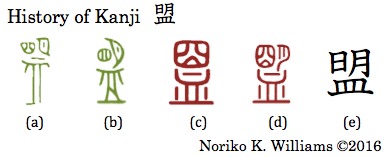 Back to the kanji 盟. In bronze ware style, (a) and (b), the top had a window on the left and a moon on the right, together signifying “bright light.” The bottom of (a) had the short line above the tall dish, which signified that what was inside the dish was something important, sacrificial animal blood. And the slanted line on the dish could be an emphasis that it had something inside. It has been explained that in making a pledge, members of an alliance sipped this blood by the window where the clear light of a moon came through. Together they meant “to make a pledge; alliance.” In ten style, (c) lost the moon, and (d) retained the moon. Just as the case with the kanji 明, (d) became (e). Why in kanji 盟 the kanji 皿, instead of 血, was used is not clear.
Back to the kanji 盟. In bronze ware style, (a) and (b), the top had a window on the left and a moon on the right, together signifying “bright light.” The bottom of (a) had the short line above the tall dish, which signified that what was inside the dish was something important, sacrificial animal blood. And the slanted line on the dish could be an emphasis that it had something inside. It has been explained that in making a pledge, members of an alliance sipped this blood by the window where the clear light of a moon came through. Together they meant “to make a pledge; alliance.” In ten style, (c) lost the moon, and (d) retained the moon. Just as the case with the kanji 明, (d) became (e). Why in kanji 盟 the kanji 皿, instead of 血, was used is not clear.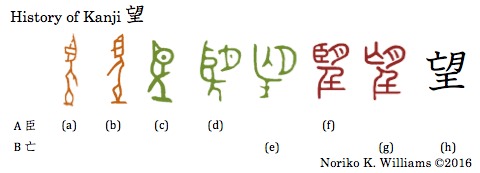 For the kanji 望, there were two different streams of origins. The alphabets below ancient writings are shown in two tiers –A with 臣; and B with 亡. We begin with A.
For the kanji 望, there were two different streams of origins. The alphabets below ancient writings are shown in two tiers –A with 臣; and B with 亡. We begin with A.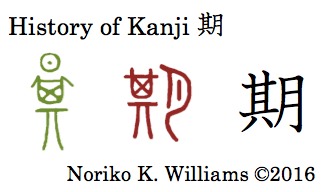 For the kanji 期 in bronze ware style the top was the sun, the middle was an apparatus to winnow, and the bottom was a table. To winnow means to force air through grain in order to remove the chaff. The whole shape 其 was used phonetically for /ki/. In ten style a moon was added to the right side. A moon has a phase or a cycle of waning and waxing. Together they meant “a specific time or period.” The kanji 期 means “specific time; period of time.”
For the kanji 期 in bronze ware style the top was the sun, the middle was an apparatus to winnow, and the bottom was a table. To winnow means to force air through grain in order to remove the chaff. The whole shape 其 was used phonetically for /ki/. In ten style a moon was added to the right side. A moon has a phase or a cycle of waning and waxing. Together they meant “a specific time or period.” The kanji 期 means “specific time; period of time.”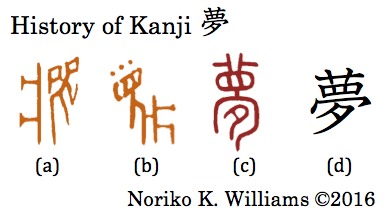 The kanji for a dream began with a bed to sleep on. The two oracle bone style writings, (a) and ( b), shown on the left had a bed with legs, vertically placed. What was the figure next to the bed? Many references take the view that the kanji 夢 originally consisted of two writings – one phonetically for /bo’o/ for “not being able to see” and another 夕 “night.” Something you see at night when you cannot see is a dream. Another explanation involves a medium – a medium conjured up spirits for a nightmare (Shirakawa). Could the figure next to a bed be a medium at work? I have not been able find explanations that include those oracle bone style writing samples. The ten style writing, (c), had “eye” and “moon; night” 夕. The top above an eye may be something that prevented one from seeing.
The kanji for a dream began with a bed to sleep on. The two oracle bone style writings, (a) and ( b), shown on the left had a bed with legs, vertically placed. What was the figure next to the bed? Many references take the view that the kanji 夢 originally consisted of two writings – one phonetically for /bo’o/ for “not being able to see” and another 夕 “night.” Something you see at night when you cannot see is a dream. Another explanation involves a medium – a medium conjured up spirits for a nightmare (Shirakawa). Could the figure next to a bed be a medium at work? I have not been able find explanations that include those oracle bone style writing samples. The ten style writing, (c), had “eye” and “moon; night” 夕. The top above an eye may be something that prevented one from seeing.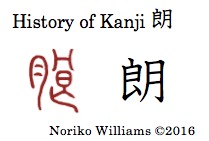 For the kanji 朗 the left side of the ten style writing was a moon. The right side was used phonetically for /ro’o/ to mean “clear and bright.” (Brightness with moonlight coming in meant “cheerful; lively.”
For the kanji 朗 the left side of the ten style writing was a moon. The right side was used phonetically for /ro’o/ to mean “clear and bright.” (Brightness with moonlight coming in meant “cheerful; lively.”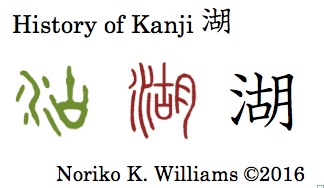 For the kanji 湖 in bronze ware style the left side was running water, and the right side was used phonetically for /ko/ to mean “large.” Together they meant “lake.” In ten style 胡 was used to mean “large.” This canji has nothing to do with a moon. The kanji 湖 means “lake.”
For the kanji 湖 in bronze ware style the left side was running water, and the right side was used phonetically for /ko/ to mean “large.” Together they meant “lake.” In ten style 胡 was used to mean “large.” This canji has nothing to do with a moon. The kanji 湖 means “lake.” The kanji that originally had a moon but lost it is 間. We have discussed this in an earlier post [
The kanji that originally had a moon but lost it is 間. We have discussed this in an earlier post [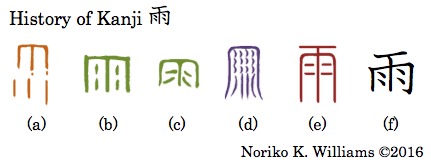 For the kanji 雨, the oracle bone style writing, (a) in brown, consisted of two parts– The top was “cloud” or “sky,” and the bottom was “rain drops.” Together water droplets coming down from the clouds or sky meant “rain.” In bronze ware style (b) and (c), in green, two water droplets were placed inside each of the two halves with a vertical line in the center. The ten style writing, (e) in red, took the bronze ware style, which became the kanji 雨 (f). Setsumon also gave (d) as its earlier style, which does not have a dividing vertical line in the middle.
For the kanji 雨, the oracle bone style writing, (a) in brown, consisted of two parts– The top was “cloud” or “sky,” and the bottom was “rain drops.” Together water droplets coming down from the clouds or sky meant “rain.” In bronze ware style (b) and (c), in green, two water droplets were placed inside each of the two halves with a vertical line in the center. The ten style writing, (e) in red, took the bronze ware style, which became the kanji 雨 (f). Setsumon also gave (d) as its earlier style, which does not have a dividing vertical line in the middle.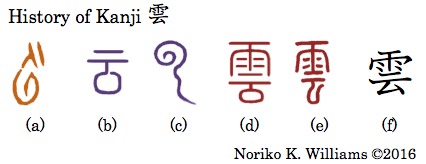 For cloud, originally it only had the bottom 云, which was “cloud.” Shirakawa explained that a dragon, an imaginary powerful animal, was believed to be inside clouds and that the oracle bone style writing (a) had a dragon in the cloud with its tail curled up. Setsumon gave (b) and (c) as earlier writings. The ten style writings got 雨 /ameka’nmuri/ on the top together with (b) for (d), and (c) for (f). The kanji 雲 means “cloud.”
For cloud, originally it only had the bottom 云, which was “cloud.” Shirakawa explained that a dragon, an imaginary powerful animal, was believed to be inside clouds and that the oracle bone style writing (a) had a dragon in the cloud with its tail curled up. Setsumon gave (b) and (c) as earlier writings. The ten style writings got 雨 /ameka’nmuri/ on the top together with (b) for (d), and (c) for (f). The kanji 雲 means “cloud.”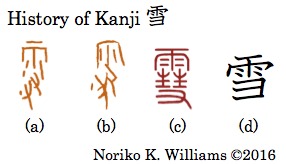 For the kanji 雪, the oracle bone style writings (a) and (b) had a cloud at the top and the bottom showed lightly falling flakes coming down from the sky, which meant “snowfall; snow.” The ten style writing (c) had different components. The top was the same, something that falls from the sky. The middle had two brushes or brooms, and the bottom had a hand — together they signified a hand holding a broom to sweep or clean. Snowfall blankets the earth as if cleansing everything on the ground. It meant “snow.”
For the kanji 雪, the oracle bone style writings (a) and (b) had a cloud at the top and the bottom showed lightly falling flakes coming down from the sky, which meant “snowfall; snow.” The ten style writing (c) had different components. The top was the same, something that falls from the sky. The middle had two brushes or brooms, and the bottom had a hand — together they signified a hand holding a broom to sweep or clean. Snowfall blankets the earth as if cleansing everything on the ground. It meant “snow.”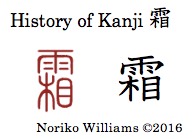 When moisture becomes frozen on the surface or in the ground, it becomes frost. The ten style of the kanji 霜 had a bushu amekanmuri “atmospheric phenomenon” and the bottom 相 was used phonetically for /so’o/. It meant “frost.” The Kadokawa dictionary and Kanjigen explained that 相 “to face each other” gave the meaning of moisture in the ground forming columns, as in 霜柱 (“frost column” /shimoba’shira/).
When moisture becomes frozen on the surface or in the ground, it becomes frost. The ten style of the kanji 霜 had a bushu amekanmuri “atmospheric phenomenon” and the bottom 相 was used phonetically for /so’o/. It meant “frost.” The Kadokawa dictionary and Kanjigen explained that 相 “to face each other” gave the meaning of moisture in the ground forming columns, as in 霜柱 (“frost column” /shimoba’shira/).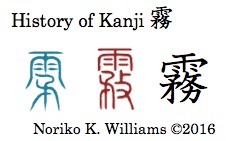 When the moisture is suspended in the air as tiny water droplets it becomes fog. The ten style of the kanji 霧 consisted of 雨 “atmospheric phenomenon” and 務, used phonetically for /mu/ to mean “something unclear.” An atmospheric phenomenon that hampered visibility due to tiny water droplets in the air was “fog.” The writing in blue is in Large ten style 大篆 /daiten/, which preceded Small ten style 小篆 /shooten/ (what we are using as ten style in this blog.)
When the moisture is suspended in the air as tiny water droplets it becomes fog. The ten style of the kanji 霧 consisted of 雨 “atmospheric phenomenon” and 務, used phonetically for /mu/ to mean “something unclear.” An atmospheric phenomenon that hampered visibility due to tiny water droplets in the air was “fog.” The writing in blue is in Large ten style 大篆 /daiten/, which preceded Small ten style 小篆 /shooten/ (what we are using as ten style in this blog.)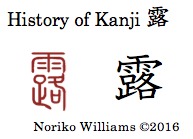 When moisture in the air becomes water droplets on the ground, it is dew. The ten style of the kanji 露 consisted of 雨 “atmospheric phenomenon” and 路, used phonetically for /ro/. The dew covers everything outside. From that 露 also meant “to cover; expose.”
When moisture in the air becomes water droplets on the ground, it is dew. The ten style of the kanji 露 consisted of 雨 “atmospheric phenomenon” and 路, used phonetically for /ro/. The dew covers everything outside. From that 露 also meant “to cover; expose.”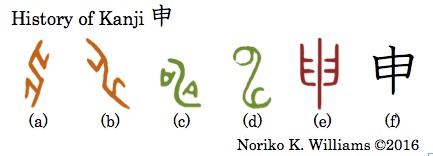 In order to understand the kanji 電 and 雷, we need to look at the origin of the bottom component first, which also became the kanji 申 shown on the left. In the two oracle bone style writings, (a) and (b) in brown, and bronze ware style writing (d), in green, a zigzag line in the center had a hooked line on both ends. The two halves are a 180-degree turn of each other. It signified lightning in the sky. People took lightening as the god appearing, and it originally meant “god; god speaking.” The other bronze ware style writing, (c), had a prayer box 口 on each side. As the shape of lightning came to be used to clear other writings the meaning of “god” was dropped, as we will see in the next kanji. 申 meant “to say; state.” In ten style, (e) in red, the lines became straight. In kanji (f), it became 申. Having “god speaking” in its origin, the kanji 申 “to say” is used in official or formal use. In Japanese it is used as a humble form of “to say; state.” In traditional kanji disctionaries, 申 is listed in the 田 section header.
In order to understand the kanji 電 and 雷, we need to look at the origin of the bottom component first, which also became the kanji 申 shown on the left. In the two oracle bone style writings, (a) and (b) in brown, and bronze ware style writing (d), in green, a zigzag line in the center had a hooked line on both ends. The two halves are a 180-degree turn of each other. It signified lightning in the sky. People took lightening as the god appearing, and it originally meant “god; god speaking.” The other bronze ware style writing, (c), had a prayer box 口 on each side. As the shape of lightning came to be used to clear other writings the meaning of “god” was dropped, as we will see in the next kanji. 申 meant “to say; state.” In ten style, (e) in red, the lines became straight. In kanji (f), it became 申. Having “god speaking” in its origin, the kanji 申 “to say” is used in official or formal use. In Japanese it is used as a humble form of “to say; state.” In traditional kanji disctionaries, 申 is listed in the 田 section header. As the writing 申 expanded its use in other kanji, a new kanji for the original meaning of “god“ was created by adding an altar table. The two bronze ware style samples, (a) and (b), show the change. A god appearing at an altar table meant “god; divine.” The kyujitai, (d) in blue, with an altar table 示 was changed to ネ a bushu shimesuhen “religious matter” in shinjitai.
As the writing 申 expanded its use in other kanji, a new kanji for the original meaning of “god“ was created by adding an altar table. The two bronze ware style samples, (a) and (b), show the change. A god appearing at an altar table meant “god; divine.” The kyujitai, (d) in blue, with an altar table 示 was changed to ネ a bushu shimesuhen “religious matter” in shinjitai.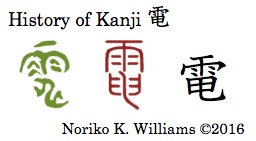 The bronze ware style writing of 電 shown on the left consisted of 雨 “rain; atmospheric phenomenon” at the top, and “lightning” at the bottom. In ten style the center line at the bottom still retained a bent shape, which is reflected in kanji in the last stroke as a line that bends and goes up. The kanji 電 means “extremely fast” like lightning travels. It also means “electricity.”
The bronze ware style writing of 電 shown on the left consisted of 雨 “rain; atmospheric phenomenon” at the top, and “lightning” at the bottom. In ten style the center line at the bottom still retained a bent shape, which is reflected in kanji in the last stroke as a line that bends and goes up. The kanji 電 means “extremely fast” like lightning travels. It also means “electricity.” Lightning accompanies thunder. The history of the kanji for “thunder; lightening” is shown on the left. The two oracle bone style writings, (a) and (b), consisted of what was used for lightning in the oracle bone styles of 申, as discussed in 1, and two prayer boxes 口 inside the whirl on each side. Together they signified a god speaking forcibly by sending lightning and thunder, and it meant “thunder.” In the three bronze ware style writings here, (c), (d) and (e), showed different ways of forming many 田. Lightning bolts never appear the same. In those writing 田 represented sounds. Setsumon gave (f) and (g) as earlier writings. The ten style writing (h) had three 田. In kanji (i) the bottom became a single 田.
Lightning accompanies thunder. The history of the kanji for “thunder; lightening” is shown on the left. The two oracle bone style writings, (a) and (b), consisted of what was used for lightning in the oracle bone styles of 申, as discussed in 1, and two prayer boxes 口 inside the whirl on each side. Together they signified a god speaking forcibly by sending lightning and thunder, and it meant “thunder.” In the three bronze ware style writings here, (c), (d) and (e), showed different ways of forming many 田. Lightning bolts never appear the same. In those writing 田 represented sounds. Setsumon gave (f) and (g) as earlier writings. The ten style writing (h) had three 田. In kanji (i) the bottom became a single 田.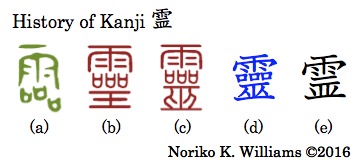 For the kanji 霊 the bronze ware style writing (a) consisted of “rain” and three prayer boxes. Together they signified a “rainmaking rite” or praying for spirits to come down. It meant “spirit; soul.” Of the two ten styles given in Setsumon, (c) had two shamans at the bottom who conducted a rainmaking rite. We can still see two 人 in kyujitai (d). In shinjitai (e) the bottom was simplified in the same manner as the top of the shinjitai 普, which originally had two standing peoples.
For the kanji 霊 the bronze ware style writing (a) consisted of “rain” and three prayer boxes. Together they signified a “rainmaking rite” or praying for spirits to come down. It meant “spirit; soul.” Of the two ten styles given in Setsumon, (c) had two shamans at the bottom who conducted a rainmaking rite. We can still see two 人 in kyujitai (d). In shinjitai (e) the bottom was simplified in the same manner as the top of the shinjitai 普, which originally had two standing peoples.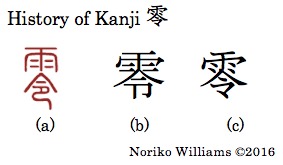 The ten style of the kanji 零, (a), consisted of 雨 and 令. We have looked at the origin of 令 earlier as coming from a “person kneeling listening to an order of a ruler or a god’s words.” [
The ten style of the kanji 零, (a), consisted of 雨 and 令. We have looked at the origin of 令 earlier as coming from a “person kneeling listening to an order of a ruler or a god’s words.” [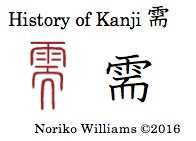 The ten style of the kanji 需 consisted of 雨 at the top and 而 at the bottom. The kanji 而 is not among the Joyo kanji but we have writings from the earlier time, so let us look at the bottom 而, shown on the right side first.
The ten style of the kanji 需 consisted of 雨 at the top and 而 at the bottom. The kanji 而 is not among the Joyo kanji but we have writings from the earlier time, so let us look at the bottom 而, shown on the right side first. The kanji 而 We see this kanji in expressions that were taken from classical kanbun texts. Some writers also use this as 而も (“and yet; also” /shika’mo/). The on-yomi is /ji/. A couple of bronze ware writings on the right were a “person whose hair was flat, not having a chignon.” Shirakawa says that a person without a chignon in this kanji was a psychic/medium. Later on it was borrowed as a pronoun/indicative that meant “that,” then 而 became a connective to mean “even though; in addition to.”
The kanji 而 We see this kanji in expressions that were taken from classical kanbun texts. Some writers also use this as 而も (“and yet; also” /shika’mo/). The on-yomi is /ji/. A couple of bronze ware writings on the right were a “person whose hair was flat, not having a chignon.” Shirakawa says that a person without a chignon in this kanji was a psychic/medium. Later on it was borrowed as a pronoun/indicative that meant “that,” then 而 became a connective to mean “even though; in addition to.”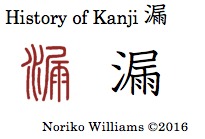 In the ten style writing of the kanji 漏, the right side consisted of 尸 “house” and 雨 “rain,” together signifying “rain leaks.” The left side “water” added the meaning of “water.” From “rain water leaking from the roof,” it meant “to leak.”
In the ten style writing of the kanji 漏, the right side consisted of 尸 “house” and 雨 “rain,” together signifying “rain leaks.” The left side “water” added the meaning of “water.” From “rain water leaking from the roof,” it meant “to leak.”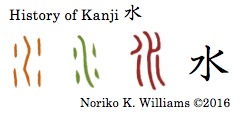 For the kanji 水, in oracle bone style, in brown, bronze ware style, in green, and ten style, in red, it was a stream of water running through the center and two short strokes on both sides, possibly for splashes. It meant “water.” In kanji 水, the two separate strokes on the left side became a single stroke but those on the right side remained as two separate strokes. So the kanji 水 is a four-stroke kanji.
For the kanji 水, in oracle bone style, in brown, bronze ware style, in green, and ten style, in red, it was a stream of water running through the center and two short strokes on both sides, possibly for splashes. It meant “water.” In kanji 水, the two separate strokes on the left side became a single stroke but those on the right side remained as two separate strokes. So the kanji 水 is a four-stroke kanji.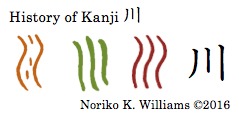 There is another kanji that also originated from a stream of water – 川. For the kanji 川, in oracle bone style levees on both sides were in solid contoure lines whereas a river stream was a broken line in the center. It meant “river.” In bronze ware style and ten style, the stream also became a solid contour line. Could the slightly bent first stroke in kanji be hinting at a winding river levee? I wonder.
There is another kanji that also originated from a stream of water – 川. For the kanji 川, in oracle bone style levees on both sides were in solid contoure lines whereas a river stream was a broken line in the center. It meant “river.” In bronze ware style and ten style, the stream also became a solid contour line. Could the slightly bent first stroke in kanji be hinting at a winding river levee? I wonder.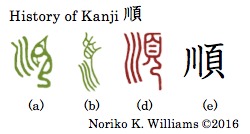 For the kanji 順, the bronze ware style writing (a) had a river on the left side and a person with a big eye observing the flow of river water. A river flows only in one direction. From someone watching how water flowed in a river, it meant “order; to follow in an orderly manner.” Another bronze ware style writing (b) also had a river and a person watching. But for “person,” a head, instead of an enlarged eye, was used. He also had something in front of his head, which was reflected at the top of the ten style writing. In ten style the right side 頁 (a bushu oogai) came from a high ranking official with a formal hat, and it meant “head.” [
For the kanji 順, the bronze ware style writing (a) had a river on the left side and a person with a big eye observing the flow of river water. A river flows only in one direction. From someone watching how water flowed in a river, it meant “order; to follow in an orderly manner.” Another bronze ware style writing (b) also had a river and a person watching. But for “person,” a head, instead of an enlarged eye, was used. He also had something in front of his head, which was reflected at the top of the ten style writing. In ten style the right side 頁 (a bushu oogai) came from a high ranking official with a formal hat, and it meant “head.” [ For the kanji 訓, in the bronze ware style writing the left side had “river” at the top and “word (言),” originally from a tattoo needle over a mouth, at the bottom. The right side was a person with a tattoo needle over his head—another reference to “word.” Together they signified that a person followed what was written in words. From that it meant “lesson; teaching; explanation.” In ten style, the left side became 言, and 川 “river” moved to the right side. In Japan, from “kanji text being explained in Japanese” it also meant “Japanese pronunciation of kanji,” i.e., 訓読み /kun-yomi/.
For the kanji 訓, in the bronze ware style writing the left side had “river” at the top and “word (言),” originally from a tattoo needle over a mouth, at the bottom. The right side was a person with a tattoo needle over his head—another reference to “word.” Together they signified that a person followed what was written in words. From that it meant “lesson; teaching; explanation.” In ten style, the left side became 言, and 川 “river” moved to the right side. In Japan, from “kanji text being explained in Japanese” it also meant “Japanese pronunciation of kanji,” i.e., 訓読み /kun-yomi/. For the kanji 巡, the left side of the ten style writing had a crossroad and a footprint — a precursor of a bushu shinnyoo “to move forward.” The right side was used phonetically to mean “to see; inspect.” Together from “to go around for inspection,” it meant “to patrol for inspection; move around.” In kanji the right side became three bent lines 巛. In the traditional kanji dictionary, 川 and 巛 were in the same heading, i.e., bushu.
For the kanji 巡, the left side of the ten style writing had a crossroad and a footprint — a precursor of a bushu shinnyoo “to move forward.” The right side was used phonetically to mean “to see; inspect.” Together from “to go around for inspection,” it meant “to patrol for inspection; move around.” In kanji the right side became three bent lines 巛. In the traditional kanji dictionary, 川 and 巛 were in the same heading, i.e., bushu.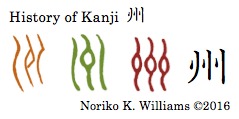 When the writing for “river” had a loop in the center, it signified a small patch of land inside a river – a sandbank or sandbar. The oracle bone style and bronze ware style writings had a sandbar in the center of a river flow between the two levees. In ten style sandbars increased to three, signifying a larger area. In kanji the sandbar became short strokes. The kanji is also used to mean a large area within a country, such as in “state” in the United States.
When the writing for “river” had a loop in the center, it signified a small patch of land inside a river – a sandbank or sandbar. The oracle bone style and bronze ware style writings had a sandbar in the center of a river flow between the two levees. In ten style sandbars increased to three, signifying a larger area. In kanji the sandbar became short strokes. The kanji is also used to mean a large area within a country, such as in “state” in the United States. For the kanji 永, the writings in all three ancient writing styles showed tributaries feeding into a main stream of a river. With an increased volume of water from tributaries, a main river stretches long in distance and time. From that the kanji 永 means “long time.”
For the kanji 永, the writings in all three ancient writing styles showed tributaries feeding into a main stream of a river. With an increased volume of water from tributaries, a main river stretches long in distance and time. From that the kanji 永 means “long time.”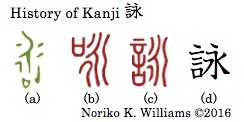 For the kanji 詠, the top of the bronze ware style writing (a) was 永 “long,” as we just saw in 7. The bottom was 口 “mouth.” Ten style (b), given as an alternative writing in Setsumon, also had 口 and 永 side by side, whereas in (c) the left side became 言 “word.” The kanji (d) reflected (c). Words that were read aloud for a long time meant “recitation” and “singing poems.”
For the kanji 詠, the top of the bronze ware style writing (a) was 永 “long,” as we just saw in 7. The bottom was 口 “mouth.” Ten style (b), given as an alternative writing in Setsumon, also had 口 and 永 side by side, whereas in (c) the left side became 言 “word.” The kanji (d) reflected (c). Words that were read aloud for a long time meant “recitation” and “singing poems.”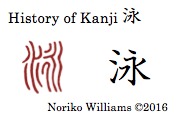 The kanji 泳 has a bushu sanzui. The ten style writing consisted of “water” and tributaries converging into the main stream signifying “for a long time.” One staying in water for a long time meant “to swim.”
The kanji 泳 has a bushu sanzui. The ten style writing consisted of “water” and tributaries converging into the main stream signifying “for a long time.” One staying in water for a long time meant “to swim.”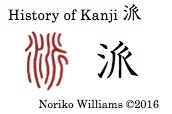 Now we look at the shape of a main stream river splitting into smaller tributaries – the right side of 派. When we compare the two ten style writings of 泳 in 9 and 派 in 10, in addition to “water” shared by the two, we see a clear contrast on the right side—they were a flipped image of each other. That means the meanings were also the reverse of each other. 派 comes from a river splitting into narrower streams but still belonging to its main stream. They could be “factions” of a main body, “schools of” artwork, “derivatives” of something. It is also used to mean “to stand out.”
Now we look at the shape of a main stream river splitting into smaller tributaries – the right side of 派. When we compare the two ten style writings of 泳 in 9 and 派 in 10, in addition to “water” shared by the two, we see a clear contrast on the right side—they were a flipped image of each other. That means the meanings were also the reverse of each other. 派 comes from a river splitting into narrower streams but still belonging to its main stream. They could be “factions” of a main body, “schools of” artwork, “derivatives” of something. It is also used to mean “to stand out.”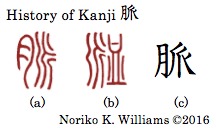 For the kanji 脈, of the two ten style writings shown on the left, (a) had a bushu nikuzuki “flesh; a part of a body.” What runs through one’s body in narrow passages is blood in artery and veins. The kanji 脈 meant “artery; pulse.” Setsumon gave the writing (b) as an alternative writing that had 血 “blood” on the right side, instead of 月 “a part of a body.” We have looked at 血 three weeks ago. [
For the kanji 脈, of the two ten style writings shown on the left, (a) had a bushu nikuzuki “flesh; a part of a body.” What runs through one’s body in narrow passages is blood in artery and veins. The kanji 脈 meant “artery; pulse.” Setsumon gave the writing (b) as an alternative writing that had 血 “blood” on the right side, instead of 月 “a part of a body.” We have looked at 血 three weeks ago. [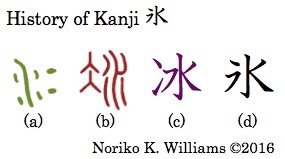 For the kanji 氷, in bronze ware style, (a) in green, the left side was “water.” On the right side the two dots signified ice. How do we know? The ten style writing, (b) in red, gives us a clearer picture – In (b) the lines on the left side were white streaks or cracks that appeared in ice. Water that was frozen meant “ice.” In kanji when ice became a component on the left side it became a bushu /nisui/ “ice; icy cold” as seen in kanji (c) 冰, in purple. The name nisui “two-stroke water” came from a familiar bushu sanzui “three-stroke water.” However, the kanji (c) 冰 is not used in Japanese (I believe it is used in Chinese.) In Japanese “ice” became just one stroke on the top left corner above 水. The kanji 氷 means “ice.”
For the kanji 氷, in bronze ware style, (a) in green, the left side was “water.” On the right side the two dots signified ice. How do we know? The ten style writing, (b) in red, gives us a clearer picture – In (b) the lines on the left side were white streaks or cracks that appeared in ice. Water that was frozen meant “ice.” In kanji when ice became a component on the left side it became a bushu /nisui/ “ice; icy cold” as seen in kanji (c) 冰, in purple. The name nisui “two-stroke water” came from a familiar bushu sanzui “three-stroke water.” However, the kanji (c) 冰 is not used in Japanese (I believe it is used in Chinese.) In Japanese “ice” became just one stroke on the top left corner above 水. The kanji 氷 means “ice.”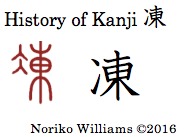 In the kanji 氷 it was water that was frozen. When stuff other than water froze there was another kanji, 凍, which has the kanji 東 on the right side. Our readers may recall from an earlier post that the kanji 東 “east” was a borrowed kanji (meaning, the use of shape and sound was not related to its origin). The original shape of 東 was “stuff tied around.” We discussed that the shape 重 in the kanji such as 動働重童, all of which had pertained to moving something heavy, came from 東 “stuff tied around.” [
In the kanji 氷 it was water that was frozen. When stuff other than water froze there was another kanji, 凍, which has the kanji 東 on the right side. Our readers may recall from an earlier post that the kanji 東 “east” was a borrowed kanji (meaning, the use of shape and sound was not related to its origin). The original shape of 東 was “stuff tied around.” We discussed that the shape 重 in the kanji such as 動働重童, all of which had pertained to moving something heavy, came from 東 “stuff tied around.” [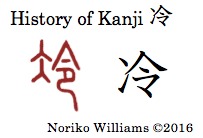 For the kanji 冷, in ten style the left side was “ice,” and the right side 令 was used phonetically for /re’e/ and meant “listening to a god’s order reverently without emotion.” Together they meant “to chill; cool down; cold (to touch).” In kanji, the left side became a bushu nisui “icy; very cold.”
For the kanji 冷, in ten style the left side was “ice,” and the right side 令 was used phonetically for /re’e/ and meant “listening to a god’s order reverently without emotion.” Together they meant “to chill; cool down; cold (to touch).” In kanji, the left side became a bushu nisui “icy; very cold.”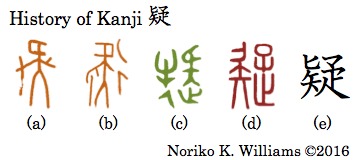 For the kanji 疑, we have two oracle bone style writing samples, (a) and (b) on the left. In (a) a person was turning his head with a long stick behind him. In (b), a person was facing toward the left with a crossroad behind him. He was not sure which way to go at a crossroad and was standing still. From that it meant “to doubt.” It sounds straightforward so far. However later on different elements were added to this, and I find it very difficult to follow the story. For instance the bronze ware style writing sample (c) in Akai (2010) appears to have had a “cow” on the top left side. I cannot figure out why so. The ten style writing, (d), could be dissected to ヒ and an arrow on the left and a child and a footprint on the right. Again what all those elements contributed to the meaning is not clear. In school we learned this kanji as ヒ矢マ疋. Other teachers seem to have come up with different mnemonics.
For the kanji 疑, we have two oracle bone style writing samples, (a) and (b) on the left. In (a) a person was turning his head with a long stick behind him. In (b), a person was facing toward the left with a crossroad behind him. He was not sure which way to go at a crossroad and was standing still. From that it meant “to doubt.” It sounds straightforward so far. However later on different elements were added to this, and I find it very difficult to follow the story. For instance the bronze ware style writing sample (c) in Akai (2010) appears to have had a “cow” on the top left side. I cannot figure out why so. The ten style writing, (d), could be dissected to ヒ and an arrow on the left and a child and a footprint on the right. Again what all those elements contributed to the meaning is not clear. In school we learned this kanji as ヒ矢マ疋. Other teachers seem to have come up with different mnemonics.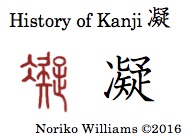 Now we look at the kanji 凝. The left side was “ice,” and the right side 疑 was used phonetically for /gi/ to mean “to stand still.” Together “staying fixedly like water becoming ice” meant “to become solid or stiff; standstill.” When one gets totally engrossed in doing something one stays still as if frozen. From that it also meant “to become obsessed,” and also what he makes may become “elaborate; ornate.”
Now we look at the kanji 凝. The left side was “ice,” and the right side 疑 was used phonetically for /gi/ to mean “to stand still.” Together “staying fixedly like water becoming ice” meant “to become solid or stiff; standstill.” When one gets totally engrossed in doing something one stays still as if frozen. From that it also meant “to become obsessed,” and also what he makes may become “elaborate; ornate.”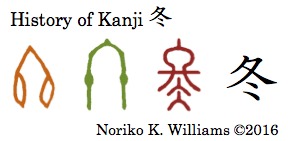 For the kanji 冬, the oracle bone style writing and bronze ware style writing were a bent rope with a knot or loop on both ends. It meant “end.” In ten style a piece of ice was added underneath. It came to mean the end of four seasons, which is winter. Another interpretation (in Kanjigen) is that the loops at the bottom in oracle bone style writing and the bulges in bronze ware style writing were food hanging down for winter use. With “ice” added at the bottom the kanji 冬 meant “winter.”
For the kanji 冬, the oracle bone style writing and bronze ware style writing were a bent rope with a knot or loop on both ends. It meant “end.” In ten style a piece of ice was added underneath. It came to mean the end of four seasons, which is winter. Another interpretation (in Kanjigen) is that the loops at the bottom in oracle bone style writing and the bulges in bronze ware style writing were food hanging down for winter use. With “ice” added at the bottom the kanji 冬 meant “winter.”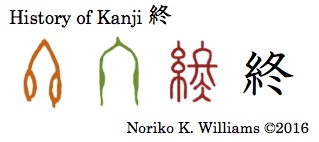 The kanji 終 had the same oracle bone and bronze ware style writing as 冬 in 6, which suggests that it was inclusive of the meaning of 冬 and 終. The two knots at the ends of a long rope meant “to end; finish; complete.” In ten style, 糸 “thread; continuous” was added to emphasize something long and continuous.
The kanji 終 had the same oracle bone and bronze ware style writing as 冬 in 6, which suggests that it was inclusive of the meaning of 冬 and 終. The two knots at the ends of a long rope meant “to end; finish; complete.” In ten style, 糸 “thread; continuous” was added to emphasize something long and continuous.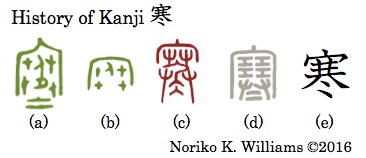 For the kanji 寒 in bronze ware style writings (a) and (b) a person, in the center, was trying to get warm in a house where dry grasses were piled up. (a) had floor mats underneath. It meant “cold.” In ten style, (c) had two hands over ice, as if he was blocking the cold air coming in. The sample (d) was taken from a seal from the Qin-Han era. In it, the grass was replaced by four 工. 工 could be 土 “dirt” or processed dirt such as dirt brick. The ice is gone but the floor rug returned. Together, (d) signified a house with walls of dirt bricks and floor mat keeping one from getting cold. In kanji (e), the ice became the two short slanted strokes. The shape in (e) reflects more of (d) at the top but (c) at the bottom. The kanji 寒い means “cold (to feel).”
For the kanji 寒 in bronze ware style writings (a) and (b) a person, in the center, was trying to get warm in a house where dry grasses were piled up. (a) had floor mats underneath. It meant “cold.” In ten style, (c) had two hands over ice, as if he was blocking the cold air coming in. The sample (d) was taken from a seal from the Qin-Han era. In it, the grass was replaced by four 工. 工 could be 土 “dirt” or processed dirt such as dirt brick. The ice is gone but the floor rug returned. Together, (d) signified a house with walls of dirt bricks and floor mat keeping one from getting cold. In kanji (e), the ice became the two short slanted strokes. The shape in (e) reflects more of (d) at the top but (c) at the bottom. The kanji 寒い means “cold (to feel).”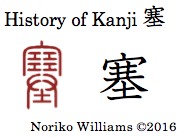 The kanji 塞 is not related to ice, but since the only difference between the kanji 寒 and 塞 is 土 at the bottom, it may give us a different perspective on the kanji 寒. For the kanji 塞 in ten style the top was walls of dirt bricks inside the house, and the bottom was two hands sealing off a hole to stop dirt from coming in. Together the kanji 塞 meant “to seal off; stop up; obstruct.”
The kanji 塞 is not related to ice, but since the only difference between the kanji 寒 and 塞 is 土 at the bottom, it may give us a different perspective on the kanji 寒. For the kanji 塞 in ten style the top was walls of dirt bricks inside the house, and the bottom was two hands sealing off a hole to stop dirt from coming in. Together the kanji 塞 meant “to seal off; stop up; obstruct.”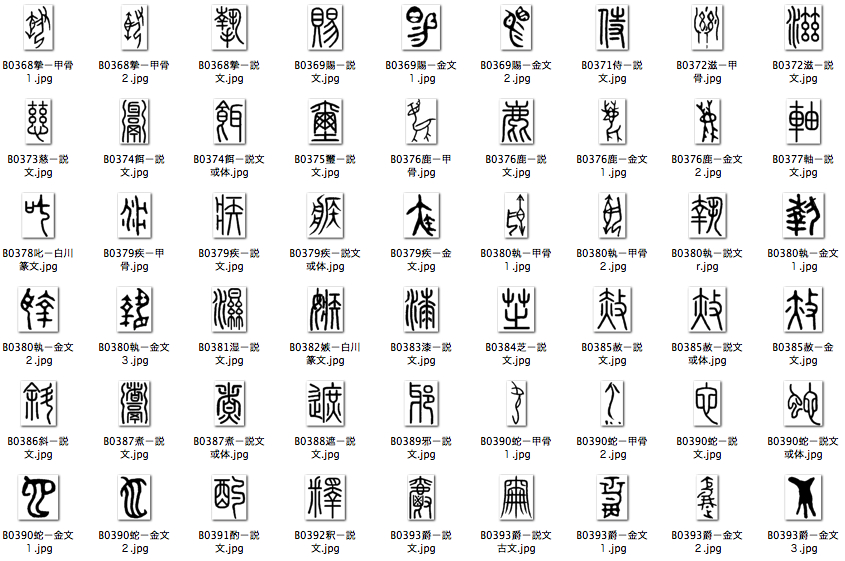 When I started this blog in December in 2013, it was the time when I had just completed making hand-copied ancient writings for the 1100 kanji in The Key to Kanji (Williams 2010), which was the first half of the 2136 Joyo kanji.
When I started this blog in December in 2013, it was the time when I had just completed making hand-copied ancient writings for the 1100 kanji in The Key to Kanji (Williams 2010), which was the first half of the 2136 Joyo kanji.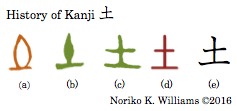 For the kanji 土, the writing in oracle bone style, (a) in brown, was the outline of a lump of dirt placed on the ground to celebrate the god of the earth. It meant “soil; dirt; ground; land.” In bronze ware style, (b) in green, the vertical line had a bulge, and in (c) the bulge became a line, which became (d) in ten style, in red. Something that is attached to a land also gave the meaning “indigenous.”
For the kanji 土, the writing in oracle bone style, (a) in brown, was the outline of a lump of dirt placed on the ground to celebrate the god of the earth. It meant “soil; dirt; ground; land.” In bronze ware style, (b) in green, the vertical line had a bulge, and in (c) the bulge became a line, which became (d) in ten style, in red. Something that is attached to a land also gave the meaning “indigenous.”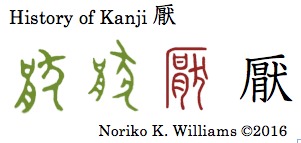 The shinjitai kanji 圧 was a drastically trimmed shape from kyujitai 壓. The ten style writing, below, consisted of 厭 at the top and.土 at the bottom. The top 厭 by itself is a kanji that means “to press from above; weary.” Its history is on the right. The left side of thebronze ware style writing had a bone at the top and meat/flesh at the bottom, and the right side was a dog — Together they signified sacrificial dog meat. In ten style a cover or something hanging over (厂) was added. From a cover pressing something down, the kanji 厭 meant “to press from above; weary of.” It is not a Joyo kanji but is used in the word 厭世 (“weary of the world/life” /ensee/). It is also used for 厭な /iya’na/ “to dislike” and 厭う (“to loathe; detest” /ito’u/).
The shinjitai kanji 圧 was a drastically trimmed shape from kyujitai 壓. The ten style writing, below, consisted of 厭 at the top and.土 at the bottom. The top 厭 by itself is a kanji that means “to press from above; weary.” Its history is on the right. The left side of thebronze ware style writing had a bone at the top and meat/flesh at the bottom, and the right side was a dog — Together they signified sacrificial dog meat. In ten style a cover or something hanging over (厂) was added. From a cover pressing something down, the kanji 厭 meant “to press from above; weary of.” It is not a Joyo kanji but is used in the word 厭世 (“weary of the world/life” /ensee/). It is also used for 厭な /iya’na/ “to dislike” and 厭う (“to loathe; detest” /ito’u/). For the ten style writing of 壓 for 圧, in addition to 厭, 土 “dirt” was added at the bottom. One interpretation is that together they signified a sacrificial dog placed on or in the ground to quell or appease the ground. It meant “to oppress; push down; pressure.” Fortunately for us, in shinjitai only the two essential elements, the pressing cover (厂) and the soil (土), were kept. So simple mnemonics would be that something pressed between a cover and the ground means “to press; pressure.” The etymology above is just for curiosity.
For the ten style writing of 壓 for 圧, in addition to 厭, 土 “dirt” was added at the bottom. One interpretation is that together they signified a sacrificial dog placed on or in the ground to quell or appease the ground. It meant “to oppress; push down; pressure.” Fortunately for us, in shinjitai only the two essential elements, the pressing cover (厂) and the soil (土), were kept. So simple mnemonics would be that something pressed between a cover and the ground means “to press; pressure.” The etymology above is just for curiosity. The kanji 吐 is a simple kanji with 口 and 土 together. The right side 土 was used phonetically for /to/ to mean “ground.” Something that comes out of one’s mouth to the ground means “to vomit; spit out.”
The kanji 吐 is a simple kanji with 口 and 土 together. The right side 土 was used phonetically for /to/ to mean “ground.” Something that comes out of one’s mouth to the ground means “to vomit; spit out.” In the earlier post, in discussing 陽 (its history is shown on the right), 昜 signified “the sun (top right) rising high (bottom right).” 昜 and “the sun hitting the mountains (阝on the left side) together meant “being made bright by the sun.” There is another interpretation — the top of 昜 was a jewel and the bottom was a tall alter table from which holy rays illuminated. From the sacred light that elevates people, 昜 meant “to elevate; heighten.”
In the earlier post, in discussing 陽 (its history is shown on the right), 昜 signified “the sun (top right) rising high (bottom right).” 昜 and “the sun hitting the mountains (阝on the left side) together meant “being made bright by the sun.” There is another interpretation — the top of 昜 was a jewel and the bottom was a tall alter table from which holy rays illuminated. From the sacred light that elevates people, 昜 meant “to elevate; heighten.”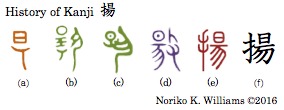 For the kanji 揚, if we look at bronze ware style writings (b) and (c) shown on the left, the interpretation of “jewel” rather than “sun” seems to fit better because it was held high by a person with two hands. One cannot hold the sun in his hands. The writing (d) was given as an older style in Setsumon. The right side of (d) had a hand. In ten style (e) five-fingers were recognizable, which in turn became a bushu tehen in kanji (f). The kanji 揚 means “to raise high (by hand).”
For the kanji 揚, if we look at bronze ware style writings (b) and (c) shown on the left, the interpretation of “jewel” rather than “sun” seems to fit better because it was held high by a person with two hands. One cannot hold the sun in his hands. The writing (d) was given as an older style in Setsumon. The right side of (d) had a hand. In ten style (e) five-fingers were recognizable, which in turn became a bushu tehen in kanji (f). The kanji 揚 means “to raise high (by hand).” For the kanji 湯, the left side of the bronze ware style writing was “(running) water,” which became a bushu sanzui in kanji, as we have seen in the posts in April. The right side 昜 was used phonetically for /to’o/ and to mean “rising.” What rises from water is steam from boiling water, and from that kanji 湯 meant “hot water.”
For the kanji 湯, the left side of the bronze ware style writing was “(running) water,” which became a bushu sanzui in kanji, as we have seen in the posts in April. The right side 昜 was used phonetically for /to’o/ and to mean “rising.” What rises from water is steam from boiling water, and from that kanji 湯 meant “hot water.” The kanji 場 has only the ten style sample shown on the right. The left side was 土 “soil; ground”, and the right side 昜 was used phonetically to mean a sun rising high. From a place where a sun rose high it meant“place; venue” in general.
The kanji 場 has only the ten style sample shown on the right. The left side was 土 “soil; ground”, and the right side 昜 was used phonetically to mean a sun rising high. From a place where a sun rose high it meant“place; venue” in general.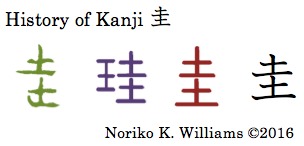 There are several kanji that contain the shape 圭. The history for 圭 is shown on the left. There are two different interpretations. One is that it was two mounds of dirt stacked up, signifying land that stood high. Another is that it was a gem that an ancient Chinese ruler gave to his subject when giving him land. It is related to feudalism. The older writing, in purple, given in Setsumon, reflected that the left side 王 was “jewel; gem.”
There are several kanji that contain the shape 圭. The history for 圭 is shown on the left. There are two different interpretations. One is that it was two mounds of dirt stacked up, signifying land that stood high. Another is that it was a gem that an ancient Chinese ruler gave to his subject when giving him land. It is related to feudalism. The older writing, in purple, given in Setsumon, reflected that the left side 王 was “jewel; gem.” We have already touched upon the kanji 街 in connection with the bushu yukigamae “crossroad.” The left and right components together were a crossroad in a full shape, rather than only the left side, as in 彳, the bushu gyooninben. The center was dirt piled up or crossing, signifying a street. Together they meant an area in which streets crisscrossed, which is a “town.” For the sample words please see the earlier post.
We have already touched upon the kanji 街 in connection with the bushu yukigamae “crossroad.” The left and right components together were a crossroad in a full shape, rather than only the left side, as in 彳, the bushu gyooninben. The center was dirt piled up or crossing, signifying a street. Together they meant an area in which streets crisscrossed, which is a “town.” For the sample words please see the earlier post. The top of the ten style writing for the kanji 崖 was a mountain. Below that were 厂 “overhanging cliff” and a tall stack of dirt. Altogether they signified “cliff” (in a mountain). The shape 厂 became a bushu gandare. The name probably comes from the kanji 雁 /ga’n/ — it meant a tare/dare that was in the kanji 雁. (The kanji 雁 in fact belongs to the bushu furutori 隹 “bird.”) A bushu name in Japanese is what Japanese people created based on Japanese use of kanji. They are different from Chinese names.
The top of the ten style writing for the kanji 崖 was a mountain. Below that were 厂 “overhanging cliff” and a tall stack of dirt. Altogether they signified “cliff” (in a mountain). The shape 厂 became a bushu gandare. The name probably comes from the kanji 雁 /ga’n/ — it meant a tare/dare that was in the kanji 雁. (The kanji 雁 in fact belongs to the bushu furutori 隹 “bird.”) A bushu name in Japanese is what Japanese people created based on Japanese use of kanji. They are different from Chinese names. The left side of the kanji 涯 was “water.” The right side was the same as the bottom component of the kanji 崖, which was used phonetically for /ga’i/ too. The two kanji were different in that the kanji 崖, with 山, was a cliff in a mountain whereas 涯, with a sanzui, was a “tall shore; bluff” overlooking a river or sea. The kanji 涯 is also used in the word 生涯 “one’s lifetime.” I was curious where this word came from, but was not able to find an explanation. I suspect that it comes from the view that the end of one’s life on earth ends where the land ends, and the kanji 生 was a goon is also suggestive.
The left side of the kanji 涯 was “water.” The right side was the same as the bottom component of the kanji 崖, which was used phonetically for /ga’i/ too. The two kanji were different in that the kanji 崖, with 山, was a cliff in a mountain whereas 涯, with a sanzui, was a “tall shore; bluff” overlooking a river or sea. The kanji 涯 is also used in the word 生涯 “one’s lifetime.” I was curious where this word came from, but was not able to find an explanation. I suspect that it comes from the view that the end of one’s life on earth ends where the land ends, and the kanji 生 was a goon is also suggestive.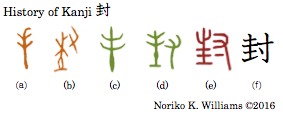 The kanji 封 appears to share the shape 圭 among the three kanji that we have just seen. It reveals that it has a different history, however.In oracle bone style, in brown, (a) was a young plant. In (b) the bottom of the young plant had a ball of “soil; dirt (the loop) attached that was placed on the ground (the horizontal line). On the right side a hand was added – together, a hand planting a young plant with a dirt ball was placed on the ground (for a ceremony). The two bronze ware style samples (c) and (d), in green, were exactly the same as oracle bone style samples (a) and (b) respectively. The difference came from how the writing was inscribed — carving the inscription on an animal bone with a knife, and founding the inscription in bronze. Together they signified a ruler’s hand planting a young plant in the ground, which was giving a fief for feudal service. From that it meant “feudal.” The land has a boundary, thus it also meant “seal; closure.”
The kanji 封 appears to share the shape 圭 among the three kanji that we have just seen. It reveals that it has a different history, however.In oracle bone style, in brown, (a) was a young plant. In (b) the bottom of the young plant had a ball of “soil; dirt (the loop) attached that was placed on the ground (the horizontal line). On the right side a hand was added – together, a hand planting a young plant with a dirt ball was placed on the ground (for a ceremony). The two bronze ware style samples (c) and (d), in green, were exactly the same as oracle bone style samples (a) and (b) respectively. The difference came from how the writing was inscribed — carving the inscription on an animal bone with a knife, and founding the inscription in bronze. Together they signified a ruler’s hand planting a young plant in the ground, which was giving a fief for feudal service. From that it meant “feudal.” The land has a boundary, thus it also meant “seal; closure.”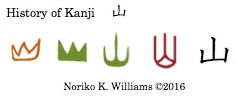 The history of the kanji 山 shown on the left does not require any explanation. Any Japanese learner knows that the kanji 山 came from a mountain range with three peaks. The kanji 山 meant “mountain; peak; heap.”
The history of the kanji 山 shown on the left does not require any explanation. Any Japanese learner knows that the kanji 山 came from a mountain range with three peaks. The kanji 山 meant “mountain; peak; heap.” For the kanji 岸, the ten style writing consisted of 山 a “mountain” at the top, 厂 a “cliff hanging over” in the middle and a phonetically used component, 干 for /ka’n/. Altogether they meant “shore; bank.”
For the kanji 岸, the ten style writing consisted of 山 a “mountain” at the top, 厂 a “cliff hanging over” in the middle and a phonetically used component, 干 for /ka’n/. Altogether they meant “shore; bank.” The ten style of the kanji 崩 had 山 “mountain” on the left whereas the older writing, in purple on the left, had a kozatohen “hill; stack of dirt piled high.” What was the right side? Shirakawa viewed that it was an imaginary auspicious bird 鳳 /ho’o/, which Setsumon incorrectly took for 朋 /ho’o/. Other references treat 朋 as two strings of necklaces that came apart, which was used phonetically. A mountain that collapsed meant “landslide.” The kanji 崩 meant “to collapse; crumble.” As a special use, it is also used to describe the death of an emperor or empress.
The ten style of the kanji 崩 had 山 “mountain” on the left whereas the older writing, in purple on the left, had a kozatohen “hill; stack of dirt piled high.” What was the right side? Shirakawa viewed that it was an imaginary auspicious bird 鳳 /ho’o/, which Setsumon incorrectly took for 朋 /ho’o/. Other references treat 朋 as two strings of necklaces that came apart, which was used phonetically. A mountain that collapsed meant “landslide.” The kanji 崩 meant “to collapse; crumble.” As a special use, it is also used to describe the death of an emperor or empress.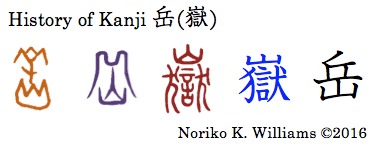 The kanji 岳 with its kyujitai 嶽 has a peculiar history. The kyujitai,in blue, was 嶽, which directly came from ten style. It had 山 “mountain” at the top, and the bottom 獄 had two dogs on both sides and 言 ”word; language” in the center. 獄 /go’ku/ by itself is the kanji “prison” (as in 地獄 “hell” /jigoku’/ and 監獄 (“prison” /kangoku/). Together 嶽 signified “ragged harsh mountain.” The earlier writing, in purple, was very different, and reflected the oracle bone style writings. In oracle bone style, the sample shown here had a sheep’s head at the top and the bottom was a mountain. Ragged mountains were a sacred place for sheep herding people. So the origin of the shape of the shinjitai 岳 was found all the way back in oracle bone style. The kanji 岳 (嶽) meant “mountain: ragged mountain.”
The kanji 岳 with its kyujitai 嶽 has a peculiar history. The kyujitai,in blue, was 嶽, which directly came from ten style. It had 山 “mountain” at the top, and the bottom 獄 had two dogs on both sides and 言 ”word; language” in the center. 獄 /go’ku/ by itself is the kanji “prison” (as in 地獄 “hell” /jigoku’/ and 監獄 (“prison” /kangoku/). Together 嶽 signified “ragged harsh mountain.” The earlier writing, in purple, was very different, and reflected the oracle bone style writings. In oracle bone style, the sample shown here had a sheep’s head at the top and the bottom was a mountain. Ragged mountains were a sacred place for sheep herding people. So the origin of the shape of the shinjitai 岳 was found all the way back in oracle bone style. The kanji 岳 (嶽) meant “mountain: ragged mountain.” The kanji 丘 is the same as the top of the kanji 岳 “mountain” that we have just seen, but it does not share the same origin. In oracle bone style, 丘 had two hills or a hill with a hollow in the middle. The bottom line was the ground level. The bronze ware style writings (b) and (c) look like two people standing back to back on the ground, which were similar to the origin of the kanji 北. The ten style writing also reflected the bronze ware style writing. Incidentally, the kanji shape 丘 is found not just in 岳 but also in the kanji 兵 “soldier,” but the two kanji,i 丘 and 兵, have nothing in common. [The kanji 兵 was discussed in the earlier article —
The kanji 丘 is the same as the top of the kanji 岳 “mountain” that we have just seen, but it does not share the same origin. In oracle bone style, 丘 had two hills or a hill with a hollow in the middle. The bottom line was the ground level. The bronze ware style writings (b) and (c) look like two people standing back to back on the ground, which were similar to the origin of the kanji 北. The ten style writing also reflected the bronze ware style writing. Incidentally, the kanji shape 丘 is found not just in 岳 but also in the kanji 兵 “soldier,” but the two kanji,i 丘 and 兵, have nothing in common. [The kanji 兵 was discussed in the earlier article — The explanation of the kanji 石 appears to be straightforward if we take the bottom 口 as a rock, as many references do. From “rocks under a mountain cliff” it meant “rock; stone.” There is another interpretation. As we have seen in many kanji, Shirakawa interpreted the shape 口 to be a “box in which prayer words are placed,” rather than more prevalent views that it was a mouth, box, rock or window. His interpretation has a sweeping implication on the interpretation of many kanji. The kanji 石 is one of them – A prayer box placed under a mountain cliff to pray to the god of the rock or mountain came to mean “rock.” When we look at the ten style writing, a rock or stone has an appeal, but when we go back to oracle bone and bronze ware style the interpretation as a rock or stone has less appeal.
The explanation of the kanji 石 appears to be straightforward if we take the bottom 口 as a rock, as many references do. From “rocks under a mountain cliff” it meant “rock; stone.” There is another interpretation. As we have seen in many kanji, Shirakawa interpreted the shape 口 to be a “box in which prayer words are placed,” rather than more prevalent views that it was a mouth, box, rock or window. His interpretation has a sweeping implication on the interpretation of many kanji. The kanji 石 is one of them – A prayer box placed under a mountain cliff to pray to the god of the rock or mountain came to mean “rock.” When we look at the ten style writing, a rock or stone has an appeal, but when we go back to oracle bone and bronze ware style the interpretation as a rock or stone has less appeal.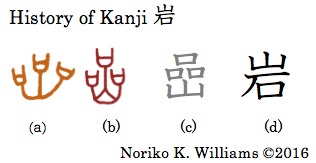
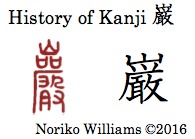 The kanji used in the Japanese kanji for “rock; boulder,” 岩, was an abbreviated form of the kanji 嵒. In Japanese 嵒 is not used. 岩 is also used as the abbreviated form of 巌 (“rock” /iwao/), as shown on the right. Both嵒and岩signified “many boulders piled up in the mountain.” The kanji 岩 means “rock.”
The kanji used in the Japanese kanji for “rock; boulder,” 岩, was an abbreviated form of the kanji 嵒. In Japanese 嵒 is not used. 岩 is also used as the abbreviated form of 巌 (“rock” /iwao/), as shown on the right. Both嵒and岩signified “many boulders piled up in the mountain.” The kanji 岩 means “rock.” The Kadokawa dictionary takes the view that the origin of the kanji 砂 was in 沙, and that “water” was replaced by 石 later on. The kanji 沙had bronze ware style samples shown on the left. The left side was water and the right side had three or four small dots, which became 少 in ten style. The kanji 沙 means “granular; very small.” Shirakawa explains that the kanji 沙 was something granular that was smaller than 砂.
The Kadokawa dictionary takes the view that the origin of the kanji 砂 was in 沙, and that “water” was replaced by 石 later on. The kanji 沙had bronze ware style samples shown on the left. The left side was water and the right side had three or four small dots, which became 少 in ten style. The kanji 沙 means “granular; very small.” Shirakawa explains that the kanji 沙 was something granular that was smaller than 砂.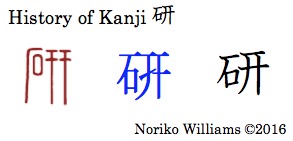 For the kanji 研 the left side of the ten style writing was 石 “rock,” and the right side had two sticks of an equal length. The right side was used phonetically for /ke’n/. Together, “two sticks ground to an equal length” gave the meaning “to sharpen by grinding; horn.” 研 meant “to grind; sharpen; horn.”
For the kanji 研 the left side of the ten style writing was 石 “rock,” and the right side had two sticks of an equal length. The right side was used phonetically for /ke’n/. Together, “two sticks ground to an equal length” gave the meaning “to sharpen by grinding; horn.” 研 meant “to grind; sharpen; horn.”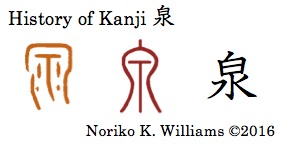 For the kanji 泉, the oracle bone style writing had water seeping out of the cracks of rocks in a cave in a mountain. It meant “spring; fountain.” In ten style, the outside was probably a cave, and the letter T-shape inside was spring water. It was a pictographic writing, 象形文字 /shookeemo’ji/. 象形文字 was a writing that came from a single image. But in kanji, it became two separate elements, the kanji 白 ”white” and 水 “water.” The kanji 泉 means “spring; fountain.”
For the kanji 泉, the oracle bone style writing had water seeping out of the cracks of rocks in a cave in a mountain. It meant “spring; fountain.” In ten style, the outside was probably a cave, and the letter T-shape inside was spring water. It was a pictographic writing, 象形文字 /shookeemo’ji/. 象形文字 was a writing that came from a single image. But in kanji, it became two separate elements, the kanji 白 ”white” and 水 “water.” The kanji 泉 means “spring; fountain.”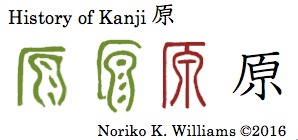 For the kanji 原, in the two bronze ware style samples, the left top was a cliff and underneath was water welling up. The ten style is that of the kanji 泉, to which a cliff was added. While 泉 was about water, 原 pointed at the place or area where water originated. So it meant “origin.” Then, it changed its meaning to include a surrounding area and meant “wilderness; field” as well as “origin; principle.”
For the kanji 原, in the two bronze ware style samples, the left top was a cliff and underneath was water welling up. The ten style is that of the kanji 泉, to which a cliff was added. While 泉 was about water, 原 pointed at the place or area where water originated. So it meant “origin.” Then, it changed its meaning to include a surrounding area and meant “wilderness; field” as well as “origin; principle.” For the kanji 源, Setsumon gave two writing samples. One has three fountains under a cliff, and another was the same as the kanji 原. Because the kanji 原 changed to mean “wilderness; wild field,” a new kanji was created to express the original meaning “source; origin.” In kanji a bushu sanzui was added to put the focus on the original meaning as a place where water originated. The kanji 源 means “source” and it also meant “origin” in general.
For the kanji 源, Setsumon gave two writing samples. One has three fountains under a cliff, and another was the same as the kanji 原. Because the kanji 原 changed to mean “wilderness; wild field,” a new kanji was created to express the original meaning “source; origin.” In kanji a bushu sanzui was added to put the focus on the original meaning as a place where water originated. The kanji 源 means “source” and it also meant “origin” in general.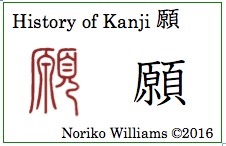 We have looked at the kanji 願 earliar in connection with its tsukuri (the right component of a composite kanji), a bushu oogai “head”. [Kanji Radical 頁 おおがい-順顔頭願 on November 15, 2014.] In ten style the left side was 原 with the original meaning “a place where water wells out.” What comes out of one’s head is his wish. For the sample words, please refer to the earlier post.
We have looked at the kanji 願 earliar in connection with its tsukuri (the right component of a composite kanji), a bushu oogai “head”. [Kanji Radical 頁 おおがい-順顔頭願 on November 15, 2014.] In ten style the left side was 原 with the original meaning “a place where water wells out.” What comes out of one’s head is his wish. For the sample words, please refer to the earlier post. The history shown on the left is actually what I combined from two separate entries in Akai (2010). The first two were for the kanji 气, which is not used in Japanese –the oracle bone style writing (a) and bronze ware style writing (b) signified “steam or air rising.” (c) through (f) are for the kanji 気, which derived from 气 –In ten style (c) grains or rice scattered in all directions was added to the three wavy lines that signifies steam rising. It meant “air; spirit.” Another ten style writing (d) had food on the left side. The kyujitai had 米 “rice” inside, which was replaced by a katakana /me/, a device to simplify complex shape in shinjitai.
The history shown on the left is actually what I combined from two separate entries in Akai (2010). The first two were for the kanji 气, which is not used in Japanese –the oracle bone style writing (a) and bronze ware style writing (b) signified “steam or air rising.” (c) through (f) are for the kanji 気, which derived from 气 –In ten style (c) grains or rice scattered in all directions was added to the three wavy lines that signifies steam rising. It meant “air; spirit.” Another ten style writing (d) had food on the left side. The kyujitai had 米 “rice” inside, which was replaced by a katakana /me/, a device to simplify complex shape in shinjitai.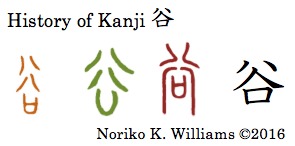 For the kanji 谷, in oracle bone style and bronze ware style, what looked like two katakana ハ signified steep mountain ridges. What was underneath was the bottom of a ravine where a river ran. It meant a “valley; ravine; gorge.”
For the kanji 谷, in oracle bone style and bronze ware style, what looked like two katakana ハ signified steep mountain ridges. What was underneath was the bottom of a ravine where a river ran. It meant a “valley; ravine; gorge.”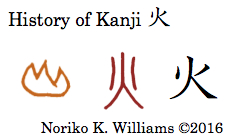 For the kanji 火, the oracle bone style writing, in brown, was a fire burning with three peaks of flames. There is no bronze ware style sample available. By the time of ten style, in red, the picture-like image was lost and became like a kanji. The kanji 火 meant “fire.”
For the kanji 火, the oracle bone style writing, in brown, was a fire burning with three peaks of flames. There is no bronze ware style sample available. By the time of ten style, in red, the picture-like image was lost and became like a kanji. The kanji 火 meant “fire.”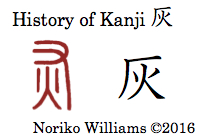 For the kanji 灰, the ten style writing had a “hand” on the upper right side and a “fire” at the bottom. Together they signified “gathering by hand what was left after a fire dies out,” which is “ash.” In kanji the hand was replaced by a bushu gandare 厂. The kanji 灰 meant “ash.”
For the kanji 灰, the ten style writing had a “hand” on the upper right side and a “fire” at the bottom. Together they signified “gathering by hand what was left after a fire dies out,” which is “ash.” In kanji the hand was replaced by a bushu gandare 厂. The kanji 灰 meant “ash.”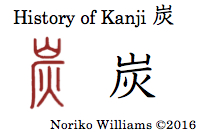 Even though the kanji 炭 consists of 山 and 灰, its origin was slightly different from 灰 in 2. In ten style, below 山 “mountain” were a cliff (厂) and a fire (火) underneath. Together they meant someone burning wood under an overhang of a mountain to make charcoal. The kanji 炭 meant “charcoal.”
Even though the kanji 炭 consists of 山 and 灰, its origin was slightly different from 灰 in 2. In ten style, below 山 “mountain” were a cliff (厂) and a fire (火) underneath. Together they meant someone burning wood under an overhang of a mountain to make charcoal. The kanji 炭 meant “charcoal.”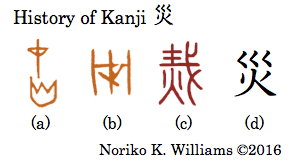 For the kanji 災, in oracle bone style, (a) had a weir or dam that blocked the flow of a river, resulting in a flood, and the bottom was a fire. (b) was a weir in a river. A flood and a fire caused by a lightning and spontaneous combustion in a mountain together signified “natural disaster; calamity.” In ten style, the upper right component was used phonetically for /sa’i/. In kanji the top (巛) signified “river.” The kanji 災 meant “calamity; disaster; misfortune.”
For the kanji 災, in oracle bone style, (a) had a weir or dam that blocked the flow of a river, resulting in a flood, and the bottom was a fire. (b) was a weir in a river. A flood and a fire caused by a lightning and spontaneous combustion in a mountain together signified “natural disaster; calamity.” In ten style, the upper right component was used phonetically for /sa’i/. In kanji the top (巛) signified “river.” The kanji 災 meant “calamity; disaster; misfortune.”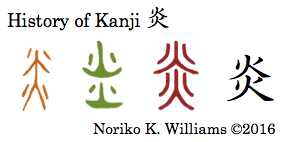 For the kanji 炎, from the very beginning in oracle bone style, bronze ware style, in green, through to the kanji it was a towering blaze expressed with two fires stacked on top of the other. The kanji 炎 means “blaze; flame.” It is also used for “inflammation.”
For the kanji 炎, from the very beginning in oracle bone style, bronze ware style, in green, through to the kanji it was a towering blaze expressed with two fires stacked on top of the other. The kanji 炎 means “blaze; flame.” It is also used for “inflammation.”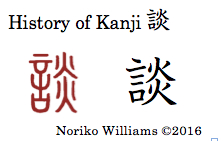 The origin of the kanji 談 is far from the intensity of a towering blaze — 炎 was used phonetically for /ta’n/ to mean “light pastel; cool,” which is found also in the kanji 淡, as in 淡い (“light; faint” /awai/). Together with 言 “word; to say” on the left side, they meant “to talk in a calm normal way.” The kanji 談 meant “to talk” in general.
The origin of the kanji 談 is far from the intensity of a towering blaze — 炎 was used phonetically for /ta’n/ to mean “light pastel; cool,” which is found also in the kanji 淡, as in 淡い (“light; faint” /awai/). Together with 言 “word; to say” on the left side, they meant “to talk in a calm normal way.” The kanji 談 meant “to talk” in general.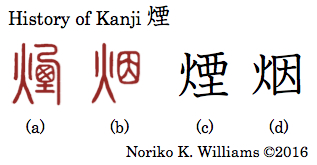 For the kanji 煙, the two ten style writings, (a) and (b), are shown on the left. Both had fire on the left. In (a) the bottom of the right side had bricks piled high in the kiln and the top right was a smoke rising. The right side was used phonetically for /e’n/ to mean “to burn.” In (b), which was considered to be a popularly used alternative, the right side signified air-like matter, such as smoke, filled in a closed space. In kanji, (c) 煙, from (a), is used to mean “smoke,” and (d) 烟, from (b), means “to be filled with air.” (The kanji 烟 is not included in Joyo kanji.)
For the kanji 煙, the two ten style writings, (a) and (b), are shown on the left. Both had fire on the left. In (a) the bottom of the right side had bricks piled high in the kiln and the top right was a smoke rising. The right side was used phonetically for /e’n/ to mean “to burn.” In (b), which was considered to be a popularly used alternative, the right side signified air-like matter, such as smoke, filled in a closed space. In kanji, (c) 煙, from (a), is used to mean “smoke,” and (d) 烟, from (b), means “to be filled with air.” (The kanji 烟 is not included in Joyo kanji.)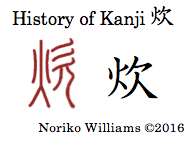 For the kanji 炊, in ten style the left side was 火 “fire,” and the right side was “a person with his mouth open to breathe the air.” From a person blowing air to keep a fire going it meant “to cook.” In kanji the right side became 欠.
For the kanji 炊, in ten style the left side was 火 “fire,” and the right side was “a person with his mouth open to breathe the air.” From a person blowing air to keep a fire going it meant “to cook.” In kanji the right side became 欠.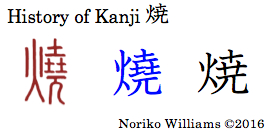 For the kanji 焼, in ten style the left side was a fire. The right side had bricks piled high in the kiln, and was used phonetically to mean “to burn.” Together they meant “to burn; bake.” The kyujitai, in blue, reflected the ten style. In shinjitai, the top on the right was slightly reduced. Our reader may recall an earlier discussion on the right side in the kanji 暁 “dawn.” [
For the kanji 焼, in ten style the left side was a fire. The right side had bricks piled high in the kiln, and was used phonetically to mean “to burn.” Together they meant “to burn; bake.” The kyujitai, in blue, reflected the ten style. In shinjitai, the top on the right was slightly reduced. Our reader may recall an earlier discussion on the right side in the kanji 暁 “dawn.” [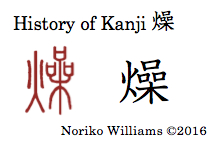 For the kanji 燥, in ten style the left side was fire, and the right side was used phonetically for /so’o/. Together they meant “to dry.”
For the kanji 燥, in ten style the left side was fire, and the right side was used phonetically for /so’o/. Together they meant “to dry.”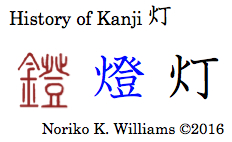 The kanji 灯 had the kyujitai 燈, which further went back to the kanji 鐙. The ten style writing for 鐙 is shown on the left. It had a bushu kanehen 金 “metal” on the left and the phonetically used 登 /to’o/ on the right. Together they were used to mean a metal lamp stand with a tray at the bottom. It was also used for stirrups on a horse. In kyujitai the bushu kanehen was replaced by 火 “fire.” Now the kanji 鐙 is used only for one of the original meanings “stirrups” (the metal to put a foot into when mounting a horse) and is read as /abumi/, a word very specialized and of no use for most of us. For the meaning “lamp; light” the kanji 灯 is used. Before 灯 came to used as the replacement of 燈, 灯 meant “fiercely burning fire.” The kanji 灯 means “light; torch.”
The kanji 灯 had the kyujitai 燈, which further went back to the kanji 鐙. The ten style writing for 鐙 is shown on the left. It had a bushu kanehen 金 “metal” on the left and the phonetically used 登 /to’o/ on the right. Together they were used to mean a metal lamp stand with a tray at the bottom. It was also used for stirrups on a horse. In kyujitai the bushu kanehen was replaced by 火 “fire.” Now the kanji 鐙 is used only for one of the original meanings “stirrups” (the metal to put a foot into when mounting a horse) and is read as /abumi/, a word very specialized and of no use for most of us. For the meaning “lamp; light” the kanji 灯 is used. Before 灯 came to used as the replacement of 燈, 灯 meant “fiercely burning fire.” The kanji 灯 means “light; torch.”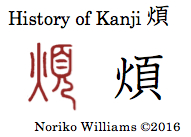 For the kanji 煩 in ten style the left side was 火 and the right side was 頁 “head.” The Kanjigen’s explanation is that it came from one’s head irritated like a fire burning in the head. The kanji 煩 means “nuisance; annoying.”
For the kanji 煩 in ten style the left side was 火 and the right side was 頁 “head.” The Kanjigen’s explanation is that it came from one’s head irritated like a fire burning in the head. The kanji 煩 means “nuisance; annoying.”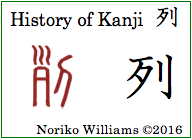 The kanji 烈 consists of the kanji 列, which was phonetically used, and a bushu rekka/renga “fire.” The kanji 列 had a gruesome origin (shown on the right). The left side of the ten style writing, in red, had a beheaded head with the hair still attached, and the right side was a knife or sword. Together 列 originally meant “to display beheaded heads.” The gruesome meaning dropped, 列 means “row; a line; file.
The kanji 烈 consists of the kanji 列, which was phonetically used, and a bushu rekka/renga “fire.” The kanji 列 had a gruesome origin (shown on the right). The left side of the ten style writing, in red, had a beheaded head with the hair still attached, and the right side was a knife or sword. Together 列 originally meant “to display beheaded heads.” The gruesome meaning dropped, 列 means “row; a line; file. ” The history of the kanji 烈 is shown on the left. The bronze ware style writing, in green, had phonetically the same /retsu/. In ten style a “fire” was added at the bottom of 列 to increase the intensity of the meaning. In kanji 火 became a bushu rekka/renga (灬). The kanji 烈 means “fierce; boisterous.”
” The history of the kanji 烈 is shown on the left. The bronze ware style writing, in green, had phonetically the same /retsu/. In ten style a “fire” was added at the bottom of 列 to increase the intensity of the meaning. In kanji 火 became a bushu rekka/renga (灬). The kanji 烈 means “fierce; boisterous.”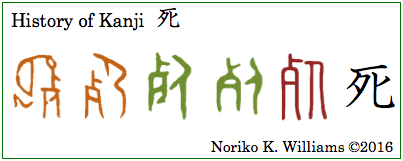 The bushu kabane (歹) in 列 and 死: The bushu kabane in the kanji 列 and 死 came from two different sources. We have looked at the history of the kanji 死 “to die; death” earlier in the post [
The bushu kabane (歹) in 列 and 死: The bushu kabane in the kanji 列 and 死 came from two different sources. We have looked at the history of the kanji 死 “to die; death” earlier in the post [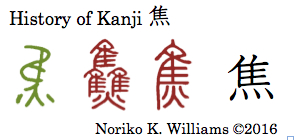 For the kanji 焦, the bronze ware style writing had a bird at the top and a fire at the bottom. From “roasting a bird over a fire,” it meant “to scorch; singe.” Of the two ten style writings shown on the left, the left one had three birds whereas the right one had a single bird. The bird in ten style becomes a bushu hurutori/furutori “bird.” The name hurutori came from the fact that the shape was used in the kyujitai 舊 for 旧い (“old” /huru’i/). The kanji 焦 means “to scorch; singe.”
For the kanji 焦, the bronze ware style writing had a bird at the top and a fire at the bottom. From “roasting a bird over a fire,” it meant “to scorch; singe.” Of the two ten style writings shown on the left, the left one had three birds whereas the right one had a single bird. The bird in ten style becomes a bushu hurutori/furutori “bird.” The name hurutori came from the fact that the shape was used in the kyujitai 舊 for 旧い (“old” /huru’i/). The kanji 焦 means “to scorch; singe.”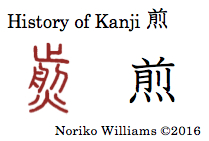 For the kanji 煎, the ten style writing consisted of 前, which was used phonetically for /se’n/, and 火 “fire.” Together they meant “to roast; parch.”
For the kanji 煎, the ten style writing consisted of 前, which was used phonetically for /se’n/, and 火 “fire.” Together they meant “to roast; parch.”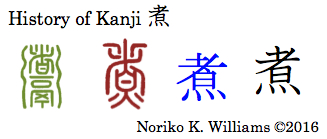 The kanji 煮 consists of the kanji 者, which was used phonetically for /sha/, and “fire.” The shape 者 makes up a number of kanji, including 緒諸署暑都著箸.
The kanji 煮 consists of the kanji 者, which was used phonetically for /sha/, and “fire.” The shape 者 makes up a number of kanji, including 緒諸署暑都著箸.  The history of 者 shown on the right is taken from the earlier post [
The history of 者 shown on the right is taken from the earlier post [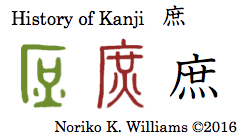 For the kanji 庶, the bronze ware style writing had a house on the top left and the bottom right was a pot over a fire. Together they originally meant “to cook food.” (Shirakawa took 庶 to be the original kanji for 煮 “to boil; cook.”) Another interpretation, which originated in Setsumon, is that it was a fire lighting up inside a house where people were present, and from that it meant “many; various.”
For the kanji 庶, the bronze ware style writing had a house on the top left and the bottom right was a pot over a fire. Together they originally meant “to cook food.” (Shirakawa took 庶 to be the original kanji for 煮 “to boil; cook.”) Another interpretation, which originated in Setsumon, is that it was a fire lighting up inside a house where people were present, and from that it meant “many; various.” By adding a bushu shinnyoo “to go forward” to 庶, we get the kanji 遮. 庶 was used phonetically to mean “to block.” Together they meant “to shut off a way to go.” The kanji 遮 means “to cut off; block.”
By adding a bushu shinnyoo “to go forward” to 庶, we get the kanji 遮. 庶 was used phonetically to mean “to block.” Together they meant “to shut off a way to go.” The kanji 遮 means “to cut off; block.” The kanji 蒸 consists of the bushu kusakanmuri “plant; grass” and 烝. In the ten style writing, below the plants, 烝 had “two hands” on the both sides of “stems of hemp plants with barks stripped off” in the center, and a “fire” at the bottom. These stems were used for a bonfire in a ritual. The fire raises the air high. Steam rises. The bushu kusakanmuri was added for an emphasis on plants. The kanji 蒸 was used to mean “to steam.”
The kanji 蒸 consists of the bushu kusakanmuri “plant; grass” and 烝. In the ten style writing, below the plants, 烝 had “two hands” on the both sides of “stems of hemp plants with barks stripped off” in the center, and a “fire” at the bottom. These stems were used for a bonfire in a ritual. The fire raises the air high. Steam rises. The bushu kusakanmuri was added for an emphasis on plants. The kanji 蒸 was used to mean “to steam.”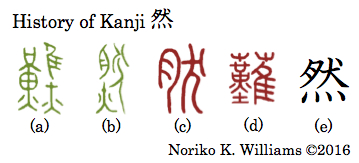 For the kanji 然 there seem to be two different interpretations of the origins. One interpretation, by Shirakawa, is more useful to us –Bronze ware style writing (b) had a piece of meat over a fire on the left side, and a sacrificial dog or animal on the right. Together they originally signified burning meat of a sacrificial dog or animal, or “to burn.” Then the writing 然 was borrowed to mean “natural” or “yes.” Ten style writing (c) kept the dog/animal meat, but the fire was dropped. In kanji (e) the fire was put back at the bottom as a bushu renga/renga.
For the kanji 然 there seem to be two different interpretations of the origins. One interpretation, by Shirakawa, is more useful to us –Bronze ware style writing (b) had a piece of meat over a fire on the left side, and a sacrificial dog or animal on the right. Together they originally signified burning meat of a sacrificial dog or animal, or “to burn.” Then the writing 然 was borrowed to mean “natural” or “yes.” Ten style writing (c) kept the dog/animal meat, but the fire was dropped. In kanji (e) the fire was put back at the bottom as a bushu renga/renga. The kanji 昭 –The right side of the kanji 昭 is 召 “to summon; invite,” from a person and a mouth, and was used phonetically for /sho’o/ to mean “bright.” The bronze ware style writing, in green, had 召 on the left and the right side was another person. In ten style, in red, the position was reversed and the person was replaced by the sun. Together they meant “bright.”
The kanji 昭 –The right side of the kanji 昭 is 召 “to summon; invite,” from a person and a mouth, and was used phonetically for /sho’o/ to mean “bright.” The bronze ware style writing, in green, had 召 on the left and the right side was another person. In ten style, in red, the position was reversed and the person was replaced by the sun. Together they meant “bright.” For the kanji 照, in ten style the left side had the sun and a fire. The right side was used phonetically for /sho’o/. Both the sun and a fire illuminate the surroundings. Together they meant “to shine.” In kanji, the fire was moved to the bottom and became a bushu rekka/renga. It meant “to shine, illuminate.”
For the kanji 照, in ten style the left side had the sun and a fire. The right side was used phonetically for /sho’o/. Both the sun and a fire illuminate the surroundings. Together they meant “to shine.” In kanji, the fire was moved to the bottom and became a bushu rekka/renga. It meant “to shine, illuminate.” For the kanji 黒, in bronze ware style, in green, the top was a chimney with black soot (the dots were deposits), a bag to collect black soot, or a bag of stuff wrapped around to be smoked to dye fabric. The bottom was a burning fire. From black soot created by a fire, it meant “black; dark.” In ten style, it had a chimney or a bag, and two fires. In kyujitai, in blue, black dots for soot were still present, and the towering fire became a bushu rekka/renga. In shinjitai, the top became 里.
For the kanji 黒, in bronze ware style, in green, the top was a chimney with black soot (the dots were deposits), a bag to collect black soot, or a bag of stuff wrapped around to be smoked to dye fabric. The bottom was a burning fire. From black soot created by a fire, it meant “black; dark.” In ten style, it had a chimney or a bag, and two fires. In kyujitai, in blue, black dots for soot were still present, and the towering fire became a bushu rekka/renga. In shinjitai, the top became 里. For the kanji 点, in ten style, the left side was the same as 黒 in 2, which had a chimney or a bag with specks of black soot at the top, and two fires. The right side 占 was used phonetically. They meant “small dot; point; to add a small note.” The kyujitai consisted of 黒 and 占. In shinjitai only the fire for 黒 was kept as a bushu rekka/renga below 占.
For the kanji 点, in ten style, the left side was the same as 黒 in 2, which had a chimney or a bag with specks of black soot at the top, and two fires. The right side 占 was used phonetically. They meant “small dot; point; to add a small note.” The kyujitai consisted of 黒 and 占. In shinjitai only the fire for 黒 was kept as a bushu rekka/renga below 占. For the kanji 墨, the top of the ten style writing was the same as 黒 in 1, and the bottom was “soil; dirt.” Black deposits from smoke was collected in a bag and got mixed with dirt-like powdery materials to make a ball of ink. The ink was used to write on materials such as silk cloth, bamboo sticks and wood. The kanji 墨 means “ink.”
For the kanji 墨, the top of the ten style writing was the same as 黒 in 1, and the bottom was “soil; dirt.” Black deposits from smoke was collected in a bag and got mixed with dirt-like powdery materials to make a ball of ink. The ink was used to write on materials such as silk cloth, bamboo sticks and wood. The kanji 墨 means “ink.” For the kanji 薫, the ten style had “plants” at the top, below that were a bag that was tied with strings in the middle and fires at the bottom – “to fume.” (In this writing, the strings were explicit.) Together they signified that plants were yielding agreeable scent, and from that 薫 meant “fragrance; aroma.” The kanji 薫 is often used for the non-Joyo kanji 燻 “to moulder,” because 燻 is not a Joyo kanji.
For the kanji 薫, the ten style had “plants” at the top, below that were a bag that was tied with strings in the middle and fires at the bottom – “to fume.” (In this writing, the strings were explicit.) Together they signified that plants were yielding agreeable scent, and from that 薫 meant “fragrance; aroma.” The kanji 薫 is often used for the non-Joyo kanji 燻 “to moulder,” because 燻 is not a Joyo kanji. For the kanji 勲, the old style writing, in purple, and the ten style writing were historically used interchangeably (Shirakawa). The right side of both writings had a plough, but the origin is not clear. The kanji 勲 meant “merit.”
For the kanji 勲, the old style writing, in purple, and the ten style writing were historically used interchangeably (Shirakawa). The right side of both writings had a plough, but the origin is not clear. The kanji 勲 meant “merit.” The kanji 黙 consists of 黒 and 犬. It is a very puzzling makeup and there are different views on its origin —A dog chasing a person (Setsumon): 黒, phonetically used to mean “not to say,” and a dog with his mouth closed together meant “to mute” (Kadokawa); “dark, unknown” from 黒 and a dog together signified “not known,” because if something is unknown, it keeps “silence” (Kanjigen). In place of mourning during which silence was expected for three years, a sacrificial dog was buried as a stand-in (Shirakawa). I do not have a preference on which one makes sense. The kanji 黙 means “to mute; silence.”
The kanji 黙 consists of 黒 and 犬. It is a very puzzling makeup and there are different views on its origin —A dog chasing a person (Setsumon): 黒, phonetically used to mean “not to say,” and a dog with his mouth closed together meant “to mute” (Kadokawa); “dark, unknown” from 黒 and a dog together signified “not known,” because if something is unknown, it keeps “silence” (Kanjigen). In place of mourning during which silence was expected for three years, a sacrificial dog was buried as a stand-in (Shirakawa). I do not have a preference on which one makes sense. The kanji 黙 means “to mute; silence.” From oracle bone style, in brown, through ten style, the top was a “person” and a the bottom was “fire.” For this combination it is generally viewed that the top was “large” and the bottom was “fire” and that the color of a large fire was “red.” It meant “red.” Shirakawa gives a different explanation – there might have been a ritual in which a fire purified a person. A fire leaves completely nothing. His view explains words such as 赤貧 (“extreme poverty” /sekihin/) and 赤裸々な (“frank; unvarnished” /sekirara-na/).
From oracle bone style, in brown, through ten style, the top was a “person” and a the bottom was “fire.” For this combination it is generally viewed that the top was “large” and the bottom was “fire” and that the color of a large fire was “red.” It meant “red.” Shirakawa gives a different explanation – there might have been a ritual in which a fire purified a person. A fire leaves completely nothing. His view explains words such as 赤貧 (“extreme poverty” /sekihin/) and 赤裸々な (“frank; unvarnished” /sekirara-na/). For the kanji 栄, the bronze ware style writings, (a) and (b), had two intersecting stands holding beacon fires. The ten style writing had beacon fires at the top but the stands became a boundary around trees. Brisk, intense flames of beacon fires illuminated a large property with lot of trees. From that it meant “flourishing; prospering.” The kyujitai, (d), reflected ten style (c). In shinjitai, (e), the two 火 side by side were reduced to a katakana ツ /tsu/ shape. For sample words please refer to the earlier post.
For the kanji 栄, the bronze ware style writings, (a) and (b), had two intersecting stands holding beacon fires. The ten style writing had beacon fires at the top but the stands became a boundary around trees. Brisk, intense flames of beacon fires illuminated a large property with lot of trees. From that it meant “flourishing; prospering.” The kyujitai, (d), reflected ten style (c). In shinjitai, (e), the two 火 side by side were reduced to a katakana ツ /tsu/ shape. For sample words please refer to the earlier post. The kanji 労 also had a bronze ware style writing, which was very similar to 栄 – two beacon fires with long stands that intersected, signifying “vigorous; energetic.” Underneath was a collar that signified a person. Together, a person working energetically meant “trouble; labor; to reward for one’s service.” In ten style, a collar was replaced by a plough, which signified hard work in the field. The Kadokawa dictionary gives a different explanation — people working hard at night under light gave the meaning “to work hard.” The kyujitai reflected ten style. “It also meant “to reward for one’s service.”
The kanji 労 also had a bronze ware style writing, which was very similar to 栄 – two beacon fires with long stands that intersected, signifying “vigorous; energetic.” Underneath was a collar that signified a person. Together, a person working energetically meant “trouble; labor; to reward for one’s service.” In ten style, a collar was replaced by a plough, which signified hard work in the field. The Kadokawa dictionary gives a different explanation — people working hard at night under light gave the meaning “to work hard.” The kyujitai reflected ten style. “It also meant “to reward for one’s service.” The kanji 営 must have been created later than the previous two kanji because the earliest writing was in ten style. In ten style, the top had fires and a boundary around the property. Inside the boundary were two connected houses (呂). Together they meant “military encampment.” Business was conducted there, and it meant “to conduct business or live one’s life.” For sample words, please refer to the earlier post.
The kanji 営 must have been created later than the previous two kanji because the earliest writing was in ten style. In ten style, the top had fires and a boundary around the property. Inside the boundary were two connected houses (呂). Together they meant “military encampment.” Business was conducted there, and it meant “to conduct business or live one’s life.” For sample words, please refer to the earlier post. One last kanji for our three posts on “fire” is the kanji 蛍 “firefly.” There is no ancient writing for 蛍. The kyujitai is 螢. The top had two fires and a boundary together phonetically for /kei/ and signifying “lights circling around.” The bottom was 虫 “bug; worm; insect.” An illuminating bug that circles around is a firefly. The kanji 蛍 means “firefly.”
One last kanji for our three posts on “fire” is the kanji 蛍 “firefly.” There is no ancient writing for 蛍. The kyujitai is 螢. The top had two fires and a boundary together phonetically for /kei/ and signifying “lights circling around.” The bottom was 虫 “bug; worm; insect.” An illuminating bug that circles around is a firefly. The kanji 蛍 means “firefly.”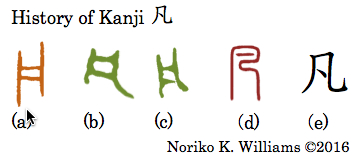 In the history of the kanji 凡, shown on the left, the writings in oracle bone style, (a) in brown, and in bronze ware style, (b) and (c) in green, were explained as “a large piece of cloth or board.” The two vertical lines were the masts and the two short horizontal lines were the outline of a sail. Covering a large area meant “all; nearly all; approximation.” The shape is also viewed as the same as 盤 /ba’n/. 盤 is a type of a shallow bowl or a boat having the function of transporting stuff to another place. From that it also meant “to extend; spread.” The kanji 凡 meant “all; common; spreading.”
In the history of the kanji 凡, shown on the left, the writings in oracle bone style, (a) in brown, and in bronze ware style, (b) and (c) in green, were explained as “a large piece of cloth or board.” The two vertical lines were the masts and the two short horizontal lines were the outline of a sail. Covering a large area meant “all; nearly all; approximation.” The shape is also viewed as the same as 盤 /ba’n/. 盤 is a type of a shallow bowl or a boat having the function of transporting stuff to another place. From that it also meant “to extend; spread.” The kanji 凡 meant “all; common; spreading.”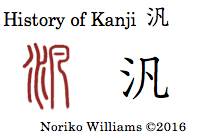 When “water” was attached to 凡, it created the kanji 汎. Together from “water spreading to a wide area” it meant “all; covering all; pan-.”
When “water” was attached to 凡, it created the kanji 汎. Together from “water spreading to a wide area” it meant “all; covering all; pan-.”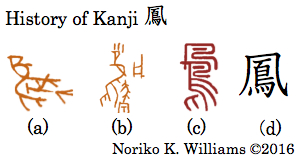 For the kanji 鳳, we have two oracle bone style writings here, (a) and (b). (a) was a mythological bird which was believed to create wind, called 鳳凰 /hooo’o/ or おおとり /ootori/. (b) was the same as the oracle bone style writing for 風, which we look at next in 5, and had a sail of a boat on the right. In ten style the sail was placed on top of this bird. In kanji the sail became a three-way enclosure, and the bird had the kanji 鳥 “bird” with an extra stroke at the top. The word 鳳凰 is said to be a pair of birds – a male (鳳) and a female (凰).
For the kanji 鳳, we have two oracle bone style writings here, (a) and (b). (a) was a mythological bird which was believed to create wind, called 鳳凰 /hooo’o/ or おおとり /ootori/. (b) was the same as the oracle bone style writing for 風, which we look at next in 5, and had a sail of a boat on the right. In ten style the sail was placed on top of this bird. In kanji the sail became a three-way enclosure, and the bird had the kanji 鳥 “bird” with an extra stroke at the top. The word 鳳凰 is said to be a pair of birds – a male (鳳) and a female (凰).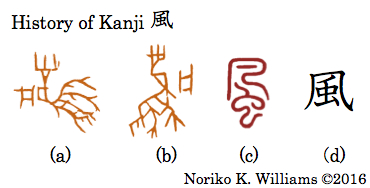 When we look at the oracle bone style writings 風, (a) and (b), and the ten style writing 風, (c), shown on the left, the two styles do not look alike. We now know from 1. 凡 and 2. 鳳 that (a) and (b) consisted of a mythical bid and a sail. The mythical bird had a large crown on the head, which signified being divine, big wings with long feathers and a long trailing tail. When this large bird flapped its large wings, it brought forth wind. This bird was considered to be “the god of wind.” The god of wind and a sail to catch wind together meant “wind.”
When we look at the oracle bone style writings 風, (a) and (b), and the ten style writing 風, (c), shown on the left, the two styles do not look alike. We now know from 1. 凡 and 2. 鳳 that (a) and (b) consisted of a mythical bid and a sail. The mythical bird had a large crown on the head, which signified being divine, big wings with long feathers and a long trailing tail. When this large bird flapped its large wings, it brought forth wind. This bird was considered to be “the god of wind.” The god of wind and a sail to catch wind together meant “wind.”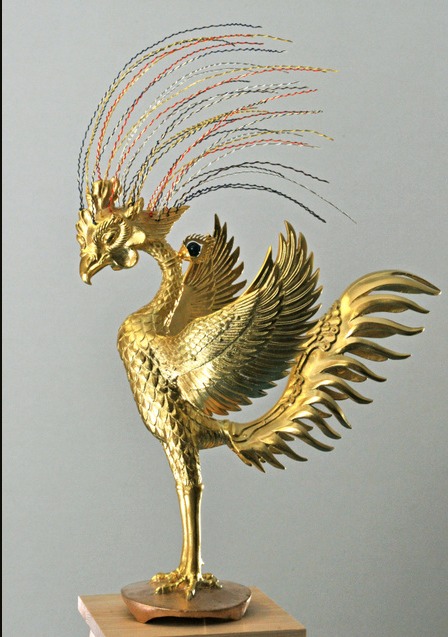
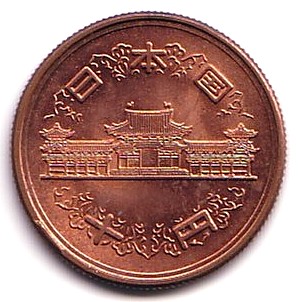
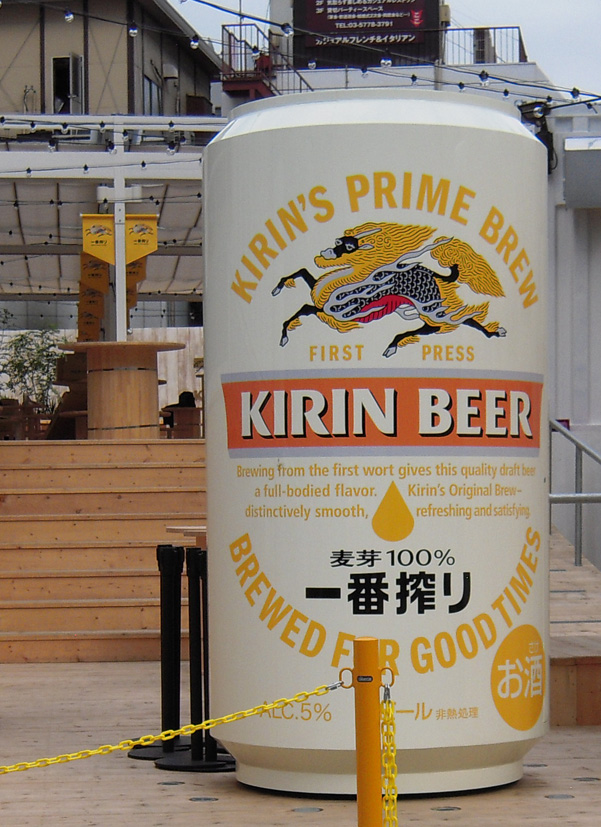
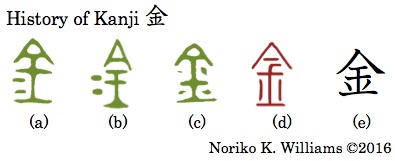 The generally accepted explanation of the kanji 金 is the Setsumon’s explanation that the top originated with 今, which was used phonetically for /kin/, and that the bottom was glistening metal nuggets in soil. I imagined a scene in nature or a mine with a roof. (In this blog, oracle bone style writing is shown in brown, bronze style writing is in green, and ten style writing is in red.) I would like to add another explanation (proposed by Shirakawa) – it was the composite of another kanji 全 and pieces of copper for casting. To understand this, the history of the kanji 全 is useful. So let us make a detour to look at the origin of the kanji 全.
The generally accepted explanation of the kanji 金 is the Setsumon’s explanation that the top originated with 今, which was used phonetically for /kin/, and that the bottom was glistening metal nuggets in soil. I imagined a scene in nature or a mine with a roof. (In this blog, oracle bone style writing is shown in brown, bronze style writing is in green, and ten style writing is in red.) I would like to add another explanation (proposed by Shirakawa) – it was the composite of another kanji 全 and pieces of copper for casting. To understand this, the history of the kanji 全 is useful. So let us make a detour to look at the origin of the kanji 全.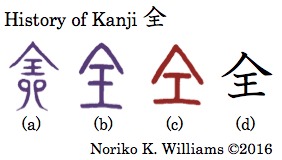 For the kanji 全, the Setsumon’s explanation for (c) was that it consisted of a bushu hitoyane and 工. It also explained it earlier shapes, (a) and (b), as flawless perfect jewels or gems (王 is the same as 玉 “jewel; gem”). From that the kanji 全 meant “complete; perfect; to fulfill.” Shirakawa explained (a) as 佩玉 /haigyoku/ “gems strung together worn by a noble on the waist in a ceremony.” In this view the whole kanji was a single image of the jewelry rather than a composite of two components.
For the kanji 全, the Setsumon’s explanation for (c) was that it consisted of a bushu hitoyane and 工. It also explained it earlier shapes, (a) and (b), as flawless perfect jewels or gems (王 is the same as 玉 “jewel; gem”). From that the kanji 全 meant “complete; perfect; to fulfill.” Shirakawa explained (a) as 佩玉 /haigyoku/ “gems strung together worn by a noble on the waist in a ceremony.” In this view the whole kanji was a single image of the jewelry rather than a composite of two components.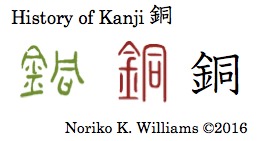 For the kanji 銅, the bronze ware style writing had “metal” on the left side, and the right side was used phonetically for /do’o/ to mean “red.” Together they meant “red metal” (赤金), which is “copper.” The kanji 銅 means “copper.” When 金 is used on the left side it is called a bushu kanehen. Bronze is 青銅, which is a yellowish brown color but when rusted 銅 becomes greenish blue (緑青 “verdigris” /rokusho’o/).
For the kanji 銅, the bronze ware style writing had “metal” on the left side, and the right side was used phonetically for /do’o/ to mean “red.” Together they meant “red metal” (赤金), which is “copper.” The kanji 銅 means “copper.” When 金 is used on the left side it is called a bushu kanehen. Bronze is 青銅, which is a yellowish brown color but when rusted 銅 becomes greenish blue (緑青 “verdigris” /rokusho’o/).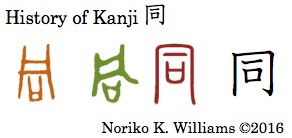 The right side of the kanji 銅 is the kanji 同 “same.” In oracle bone style and bronze ware style, it had a piece of board at the top and a hole at the bottom. A hole that went through boards enabled them to become one, which signified “the same.” In ten style, a part of the board became a line inside. The kanji 同 means “same; identical.”
The right side of the kanji 銅 is the kanji 同 “same.” In oracle bone style and bronze ware style, it had a piece of board at the top and a hole at the bottom. A hole that went through boards enabled them to become one, which signified “the same.” In ten style, a part of the board became a line inside. The kanji 同 means “same; identical.”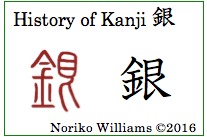 This kanji has been discussed over two years ago in the post
This kanji has been discussed over two years ago in the post 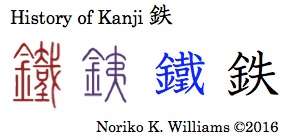 黒金 “black metal” meant “iron.” The kanji 鉄 had a kyujitai 鐵, which came from ten style. In ten style the left side was metal; the center and right side together were used phonetically to mean “reddish black.” Together they meant “metal that becomes red when rusted,” which was “iron.” In shinjitai, the right side became the kanji 失, which resembled the pre-ten style writing, in purple.
黒金 “black metal” meant “iron.” The kanji 鉄 had a kyujitai 鐵, which came from ten style. In ten style the left side was metal; the center and right side together were used phonetically to mean “reddish black.” Together they meant “metal that becomes red when rusted,” which was “iron.” In shinjitai, the right side became the kanji 失, which resembled the pre-ten style writing, in purple.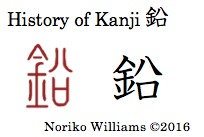 For the kanji 鉛, the left side was “metal,” and the right side was used phonetically for /e’n/ to mean “to flow along” (as in the kanji 沿 “to go along; follow”). Lead melts at a low temperature and runs quickly. From that the kanji 鉛 meant “lead.”
For the kanji 鉛, the left side was “metal,” and the right side was used phonetically for /e’n/ to mean “to flow along” (as in the kanji 沿 “to go along; follow”). Lead melts at a low temperature and runs quickly. From that the kanji 鉛 meant “lead.”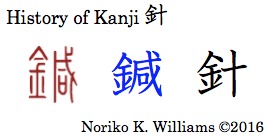 The orthodox writing (正字) for the kanji 針 was 鍼. The ten style writing of 鍼 had “metal” on the left, and the right side 咸 was used phonetically.
The orthodox writing (正字) for the kanji 針 was 鍼. The ten style writing of 鍼 had “metal” on the left, and the right side 咸 was used phonetically. 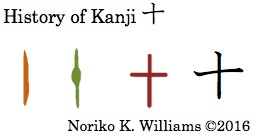 This kanji is now used to mean “acupuncture,” an alternative pain treatment using needles. In shinjitai kanji 針, the 十 shape on the right side came from a needle with a bulge in the middle, as in the kanji 十 shown on the right. The kanji 針 means “needle.”
This kanji is now used to mean “acupuncture,” an alternative pain treatment using needles. In shinjitai kanji 針, the 十 shape on the right side came from a needle with a bulge in the middle, as in the kanji 十 shown on the right. The kanji 針 means “needle.”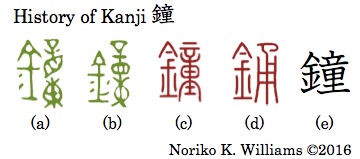 The kanji 鐘 consists of a bushu kanehen and the kanji 童. We have looked at the unusual origin of the kanji 童 in the previous post [
The kanji 鐘 consists of a bushu kanehen and the kanji 童. We have looked at the unusual origin of the kanji 童 in the previous post [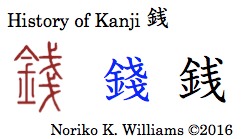 For the kanji 銭, the left side in ten style was “metal.” The right side had two halberds, 戔, giving the sound /se’n/ and also meant “shaving something thinner.” Together they originally meant a plough that had thin blades. There were plough-shaped coins. From that it meant “money.” The kyujitai 錢, in blue, reflected ten style. The shinjitai simplified the right side, and it means “money; small change; coin.”
For the kanji 銭, the left side in ten style was “metal.” The right side had two halberds, 戔, giving the sound /se’n/ and also meant “shaving something thinner.” Together they originally meant a plough that had thin blades. There were plough-shaped coins. From that it meant “money.” The kyujitai 錢, in blue, reflected ten style. The shinjitai simplified the right side, and it means “money; small change; coin.”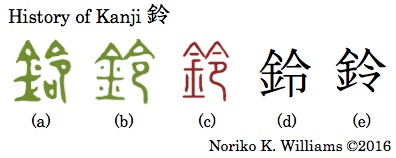 For the kanji 鈴, the bronze ware style writings, (a) and (b) in green, in ten style writing, (c) in red, had 金 “metal” on the left. On the right side was a person under a roof bending his back low or kneeling, which would become the kanji 令 “order,” used phonetically for /ree/. (a) had a prayer box in front of this person, suggesting that he was praying. A metal object that called for a god was a “bell.” The kanji (d) is in Mincho style whereas (e) is in textbook writing style. In the last post we also looked at another kanji that meant “bell; chime” – the kanji 鐘. The kanji 鐘 /kane/ is a bigger bell and 鈴 /suzu/ is a small bell, both of which called for the attention of a god.
For the kanji 鈴, the bronze ware style writings, (a) and (b) in green, in ten style writing, (c) in red, had 金 “metal” on the left. On the right side was a person under a roof bending his back low or kneeling, which would become the kanji 令 “order,” used phonetically for /ree/. (a) had a prayer box in front of this person, suggesting that he was praying. A metal object that called for a god was a “bell.” The kanji (d) is in Mincho style whereas (e) is in textbook writing style. In the last post we also looked at another kanji that meant “bell; chime” – the kanji 鐘. The kanji 鐘 /kane/ is a bigger bell and 鈴 /suzu/ is a small bell, both of which called for the attention of a god.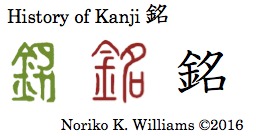 For the kanji 銘, in bronze ware style and ten style the left side was 金 “metal.” The right side was 名 “name” and was used phonetically for /me’e/. From “name inscribed in bronze” it meant “to inscribe.” What was inscribed in metal/bronze was important names and words, and in Japanese it also means “famed.”
For the kanji 銘, in bronze ware style and ten style the left side was 金 “metal.” The right side was 名 “name” and was used phonetically for /me’e/. From “name inscribed in bronze” it meant “to inscribe.” What was inscribed in metal/bronze was important names and words, and in Japanese it also means “famed.”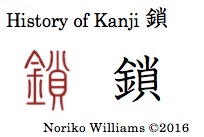 For the kanji 鎖, in ten style the left side was “metal” and the right side was small cowry shells (貝) strung together (the top), and was also used phonetically for /sa/. Together they meant “chain” and “being closed by a chain.”
For the kanji 鎖, in ten style the left side was “metal” and the right side was small cowry shells (貝) strung together (the top), and was also used phonetically for /sa/. Together they meant “chain” and “being closed by a chain.”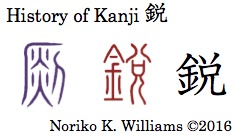 For the kanji 鋭, the ten style writing had “metal” on the left side, and the right side was used phonetically. Setsumon also gave the left one, in purple, as its old writing, 古文 /kobun/. The left writing was a scene of a fire burning high in a kiln or furnace (on the left) to make a sharp sword or knife. The kanji 鋭 means “sharp.”
For the kanji 鋭, the ten style writing had “metal” on the left side, and the right side was used phonetically. Setsumon also gave the left one, in purple, as its old writing, 古文 /kobun/. The left writing was a scene of a fire burning high in a kiln or furnace (on the left) to make a sharp sword or knife. The kanji 鋭 means “sharp.”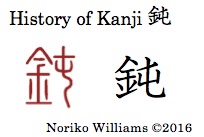 For the kanji 鈍, the left side 金 was “metal,” and the right side 屯 was used phonetically.
For the kanji 鈍, the left side 金 was “metal,” and the right side 屯 was used phonetically. 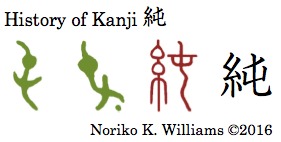 屯 came from a fringe of woven fabric that was tied in a knot. We can see what 屯 looked like in bronze style writings of the kanji 純 “pure”(from tufts of pure silk) shown on the right. The roundness of a knot signified “not sharp.” Together they meant “dull; blunt; slow.”
屯 came from a fringe of woven fabric that was tied in a knot. We can see what 屯 looked like in bronze style writings of the kanji 純 “pure”(from tufts of pure silk) shown on the right. The roundness of a knot signified “not sharp.” Together they meant “dull; blunt; slow.”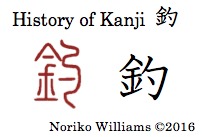 For the kanji 釣, the right side was 勺. 勺 was a “ladle,” something that scooped up (the dot was what was scooped up), or was a hook shape. 金 “metal” and 勺 “to scoop out; hook” together meant “to fish.” The kun-yomi 釣る /tsuru/ means “to fish; lure,” and is in 釣り (“fishing” /tsuri/) and 釣り合う “to match; equilibrate.” It is also used in words お釣り (“change money” /otsuri/) and 釣り銭 (“change money” /tsurisen/). お釣り is what a merchant gives back to a customer to make up the balance betwee goods and payment and how it came to be used for this meaning is not clear. お釣り is what a merchant gives back to a customer to make up the balance betwee goods and payment.
For the kanji 釣, the right side was 勺. 勺 was a “ladle,” something that scooped up (the dot was what was scooped up), or was a hook shape. 金 “metal” and 勺 “to scoop out; hook” together meant “to fish.” The kun-yomi 釣る /tsuru/ means “to fish; lure,” and is in 釣り (“fishing” /tsuri/) and 釣り合う “to match; equilibrate.” It is also used in words お釣り (“change money” /otsuri/) and 釣り銭 (“change money” /tsurisen/). お釣り is what a merchant gives back to a customer to make up the balance betwee goods and payment and how it came to be used for this meaning is not clear. お釣り is what a merchant gives back to a customer to make up the balance betwee goods and payment.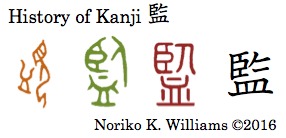 The oracle bone style writing for the kanji 監 was a vivid description of a person with a watchful eye kneeling down over a basin. In bronze ware style it became clearer that the basin had water – the extra short stroke right below the eye indicated water. Together they signified someone looking at himself carefully in the reflection of water. From that the kanji 監 meant “to watch carefully; observe; monitor.”
The oracle bone style writing for the kanji 監 was a vivid description of a person with a watchful eye kneeling down over a basin. In bronze ware style it became clearer that the basin had water – the extra short stroke right below the eye indicated water. Together they signified someone looking at himself carefully in the reflection of water. From that the kanji 監 meant “to watch carefully; observe; monitor.” Now let us look at the kanji 鑑. The bronze ware style writing (a) was the same as 監 above, whereas in (b) “metal” was added. Together metal and one looking at one’s own reflection meant “mirror.” It also meant something that one heeded as a shining model.
Now let us look at the kanji 鑑. The bronze ware style writing (a) was the same as 監 above, whereas in (b) “metal” was added. Together metal and one looking at one’s own reflection meant “mirror.” It also meant something that one heeded as a shining model.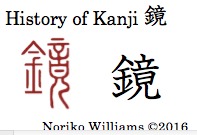 For the kanji 鏡, the right side 竟 was used phonetically for /kyo’o/ to signify “shape; scene.” With the left side 金 “metal” together, they meant “mirror.”
For the kanji 鏡, the right side 竟 was used phonetically for /kyo’o/ to signify “shape; scene.” With the left side 金 “metal” together, they meant “mirror.”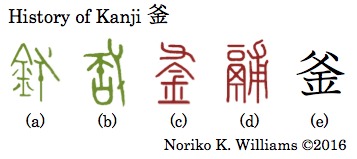 The kanji 釜 looks a little strange. It looks like the kanji 父 “father” and 金 “metal” coalesced into one. In bronze ware style, (a) had metal on the left. The right side was a hand holding a stick, which originally signified a “measuring tool.” What the left side of (b) signified is not clear to me. Setsumon gave two writings (c) and (d). (c) reflected the bronze ware style, which also became the kanji (e). The left side of (e) was a cooking pot or food storage, and the right side was used phonetically. The kanji 釜 meant “iron cooking pot.”
The kanji 釜 looks a little strange. It looks like the kanji 父 “father” and 金 “metal” coalesced into one. In bronze ware style, (a) had metal on the left. The right side was a hand holding a stick, which originally signified a “measuring tool.” What the left side of (b) signified is not clear to me. Setsumon gave two writings (c) and (d). (c) reflected the bronze ware style, which also became the kanji (e). The left side of (e) was a cooking pot or food storage, and the right side was used phonetically. The kanji 釜 meant “iron cooking pot.”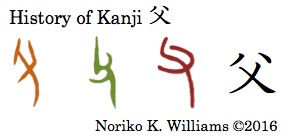 父 and 釜 — The kanji 釜 does not appear to be related to the meaning of “father” (父). On reflection, however, the origin of the kanji 父 also came from “a hand holding a stick to lead the family,” as shown on the right. So it looks like that both 父 and 釜 had “hand holding something” in their origins.
父 and 釜 — The kanji 釜 does not appear to be related to the meaning of “father” (父). On reflection, however, the origin of the kanji 父 also came from “a hand holding a stick to lead the family,” as shown on the right. So it looks like that both 父 and 釜 had “hand holding something” in their origins.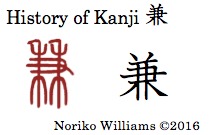 The kanji 兼 — The ten style writing of 兼 had “two rice plants” (禾) held by “side-way hand” in the middle. Holding two in one hand meant “to have both.”
The kanji 兼 — The ten style writing of 兼 had “two rice plants” (禾) held by “side-way hand” in the middle. Holding two in one hand meant “to have both.”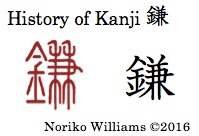 Now let us look at the kanji 鎌. In ten style the left side 金 “metal” and the right side 兼 “two rice plants held by hand.” Together they signified a metal tool that one used to cut rice plants, a “sickle.”
Now let us look at the kanji 鎌. In ten style the left side 金 “metal” and the right side 兼 “two rice plants held by hand.” Together they signified a metal tool that one used to cut rice plants, a “sickle.”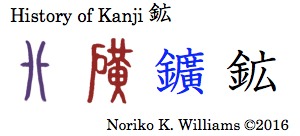 The kanji 鉱 had the kyujitai 鑛, and the right side was used phonetically for /ko’o/. In ten style the left side was 石 “rock” rather than 金. In the kanji 礦 it has 金. 礦 and 鑛 were used interchangeably before for “ore,” –a solid rock from which metal is extracted. The writing in purple on the left is interpreted as two persons protecting an area that had valuable ore. The kanji 鉱 means “ore.”
The kanji 鉱 had the kyujitai 鑛, and the right side was used phonetically for /ko’o/. In ten style the left side was 石 “rock” rather than 金. In the kanji 礦 it has 金. 礦 and 鑛 were used interchangeably before for “ore,” –a solid rock from which metal is extracted. The writing in purple on the left is interpreted as two persons protecting an area that had valuable ore. The kanji 鉱 means “ore.”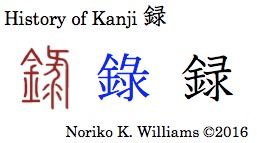 The right side of the kanji 録 was used phonetically for /roku/. Setsumon explained it as “the color of bronze (金の色),” which was bluish green. (Related to this, the kanji 緑 “green,” whose on-yomi is /roku/ or /ryoku/, shared the same right side component.) The inscription on bronze ware gave the meaning “to record” (Shirakawa).
The right side of the kanji 録 was used phonetically for /roku/. Setsumon explained it as “the color of bronze (金の色),” which was bluish green. (Related to this, the kanji 緑 “green,” whose on-yomi is /roku/ or /ryoku/, shared the same right side component.) The inscription on bronze ware gave the meaning “to record” (Shirakawa). For the kanji 木 in oracle bone style, in brown, bronze ware style, in green, and ten style, in red, it was a standing tree with big limbs stretching out upwards and downwards. When a tree is cut down it becomes wood. The kanji 木 meant “tree; wood; wooden.”
For the kanji 木 in oracle bone style, in brown, bronze ware style, in green, and ten style, in red, it was a standing tree with big limbs stretching out upwards and downwards. When a tree is cut down it becomes wood. The kanji 木 meant “tree; wood; wooden.”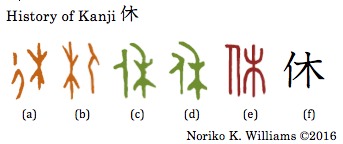 The most prevalent view of the origin of the kanji 休 is “a person leaning against a tree resting.” From that the kanji 休meant “to rest.” This explanation sounds convincing to us when we look at the kanji. However, this time when I was making a copy of ancient writings samples, the slightly bent top of the tree in the two bronze ware style writings, (c) and (d), puzzled me a little. It looked similar to 禾. Shirakawa offered an explanation for this. He said that the right side was not 木 but 禾. 禾 was explained as a sign placed on the gate of a military installation where a cease-fire ceremony was held (related to the kanji 和 “peace; harmony”). From this the writing 休 meant to conduct a peace-keeping negotiation at this gate. We will explore the meaning of 禾 when we look at a bushu nogihen later on.
The most prevalent view of the origin of the kanji 休 is “a person leaning against a tree resting.” From that the kanji 休meant “to rest.” This explanation sounds convincing to us when we look at the kanji. However, this time when I was making a copy of ancient writings samples, the slightly bent top of the tree in the two bronze ware style writings, (c) and (d), puzzled me a little. It looked similar to 禾. Shirakawa offered an explanation for this. He said that the right side was not 木 but 禾. 禾 was explained as a sign placed on the gate of a military installation where a cease-fire ceremony was held (related to the kanji 和 “peace; harmony”). From this the writing 休 meant to conduct a peace-keeping negotiation at this gate. We will explore the meaning of 禾 when we look at a bushu nogihen later on.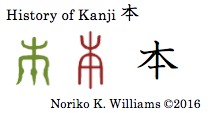 For the kanji 本, in bronze ware style, the bottom or base of a tree trunk had a small bulge. That indicated that this writing was about the “base of a tree” or a basis of something that grew and branched out. A basis never changes, so it remains true. From that the kanji 本 meant “origin; base; true; serious.” In ten style, the bulge became a short horizontal line. It was also used to mean “book,” and as a counter for a long slender object.
For the kanji 本, in bronze ware style, the bottom or base of a tree trunk had a small bulge. That indicated that this writing was about the “base of a tree” or a basis of something that grew and branched out. A basis never changes, so it remains true. From that the kanji 本 meant “origin; base; true; serious.” In ten style, the bulge became a short horizontal line. It was also used to mean “book,” and as a counter for a long slender object.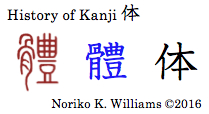 The shinjitai kanji 体 has the totally different kyujitai 體, in blue, which came from ten style. In ten style, it consisted of 骨 “bone” on the left, which had “vertebrae” at the top and 月 “flesh” at the bottom. The right side 豊 was used phonetically for /ho’o/ to mean “all.” Together they meant an entity with full bones and flesh, that was “body; entity.” It also meant “style.” The shinjitai consisted of イ, a bushu ninben, and 本 “base.” It is hard to connect 體 and 体 as belonging to the same writing, but 体 is believed to have been used as an informal writing for several centuries.
The shinjitai kanji 体 has the totally different kyujitai 體, in blue, which came from ten style. In ten style, it consisted of 骨 “bone” on the left, which had “vertebrae” at the top and 月 “flesh” at the bottom. The right side 豊 was used phonetically for /ho’o/ to mean “all.” Together they meant an entity with full bones and flesh, that was “body; entity.” It also meant “style.” The shinjitai consisted of イ, a bushu ninben, and 本 “base.” It is hard to connect 體 and 体 as belonging to the same writing, but 体 is believed to have been used as an informal writing for several centuries. The next kanji is the example of having a bulge at the top of a tree. For the kanji 末 in the bronze ware style writing we see a short line crossing the tip of a tree. It meant the “end” of a tree. In ten style, it became a very long line, which is reflected in kanji. In writing the kanji 末, the first stroke has to be longer than the second stroke. The kanji 末 meant “end.”
The next kanji is the example of having a bulge at the top of a tree. For the kanji 末 in the bronze ware style writing we see a short line crossing the tip of a tree. It meant the “end” of a tree. In ten style, it became a very long line, which is reflected in kanji. In writing the kanji 末, the first stroke has to be longer than the second stroke. The kanji 末 meant “end.”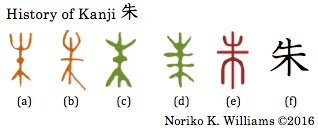 When the bulge was placed at the center of a tree, it developed into the kanji 朱. (a) in oracle bone style and (c) in bronze ware style had a bulge at the center of a tree trunk. What the bulge at this location meant is not very clear. But 朱 meant “red.” The most prevalent explanation for the connection between the shape and the meaning “red” is that when you cut a fresh trunk, the color of the center of a trunk is reddish. In ten style, the extra line stayed in the middle. In kanji a short slash was added as the first stroke. Where did this come from? I was not able to find any reference on this, but something similar had happened in the kanji 先, as we have touched upon in an earlier post.
When the bulge was placed at the center of a tree, it developed into the kanji 朱. (a) in oracle bone style and (c) in bronze ware style had a bulge at the center of a tree trunk. What the bulge at this location meant is not very clear. But 朱 meant “red.” The most prevalent explanation for the connection between the shape and the meaning “red” is that when you cut a fresh trunk, the color of the center of a trunk is reddish. In ten style, the extra line stayed in the middle. In kanji a short slash was added as the first stroke. Where did this come from? I was not able to find any reference on this, but something similar had happened in the kanji 先, as we have touched upon in an earlier post. 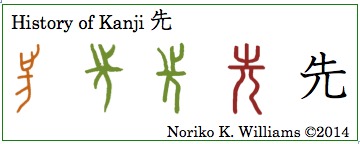 [
[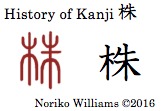 In ten style, the left side was “tree,” and the right side was used phonetically to mean “bright red.” The color of a freshly cut trunk is red or reddish. Together they meant “tree stump; stub.” It is also used for “share; stock,” as in shares of a corporation.
In ten style, the left side was “tree,” and the right side was used phonetically to mean “bright red.” The color of a freshly cut trunk is red or reddish. Together they meant “tree stump; stub.” It is also used for “share; stock,” as in shares of a corporation.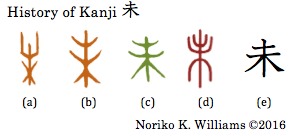 In the oracle bone style writings of 未 (a), in brown, there was an upward-facing U-shape line placed on a tree. It signified that the tree was growing with rigor and the limbs were even outgrowing the trunk. It originally meant “a tree growing strong.” In the second oracle bone sample (b), bronze ware style, (c) in green, and ten style, (d) in red, the top limbs were in a more well-formed shape. The original meaning “a tree growing strong” was borrowed, or came, to mean something that had not been completed. The writing 未 meant “not yet; still.”
In the oracle bone style writings of 未 (a), in brown, there was an upward-facing U-shape line placed on a tree. It signified that the tree was growing with rigor and the limbs were even outgrowing the trunk. It originally meant “a tree growing strong.” In the second oracle bone sample (b), bronze ware style, (c) in green, and ten style, (d) in red, the top limbs were in a more well-formed shape. The original meaning “a tree growing strong” was borrowed, or came, to mean something that had not been completed. The writing 未 meant “not yet; still.”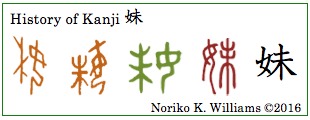 A long-time reader of this blog may recall reading such a story given in 1 above before in the kanji 妹 in the context of a bushu onnahen “woman; female.” [
A long-time reader of this blog may recall reading such a story given in 1 above before in the kanji 妹 in the context of a bushu onnahen “woman; female.” [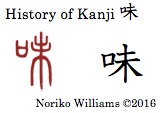 For the kanji 味, in ten style the left side 口 was a mouth and the right side 未 was used phonetically for /mi/ to mean “not yet; still.” Tasting something in the mouth is the process of trying to figure out what it is. It meant “taste.”
For the kanji 味, in ten style the left side 口 was a mouth and the right side 未 was used phonetically for /mi/ to mean “not yet; still.” Tasting something in the mouth is the process of trying to figure out what it is. It meant “taste.”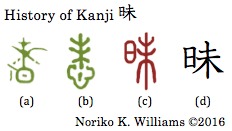 The two kanji 味 and 昧 are easy to be confused in isolation. The kanji 昧 has a bushu hihen “sun” instead of a bushu kuchihen “mouth.” For the kanji 昧, (a) and (b) in bronze ware style, the top was 未 “not yet,” and the bottom was “the sun.” The time before the sun rose was dark, and from that it meant “not clear.” When one is self-absorbed in something, he cannot see other things. In ten style (c), 日 and 未 were placed side by side. The kanji 昧 means “self-absorption; indulge.”
The two kanji 味 and 昧 are easy to be confused in isolation. The kanji 昧 has a bushu hihen “sun” instead of a bushu kuchihen “mouth.” For the kanji 昧, (a) and (b) in bronze ware style, the top was 未 “not yet,” and the bottom was “the sun.” The time before the sun rose was dark, and from that it meant “not clear.” When one is self-absorbed in something, he cannot see other things. In ten style (c), 日 and 未 were placed side by side. The kanji 昧 means “self-absorption; indulge.”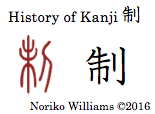 In ten style for 制 the left side was exactly the same as that of 未, whose original meaning was “a tree growing strong.” The right side was “knife.” Together “trimming overgrowing limbs at the top with a knife or a pair of shears” meant “to put in order; control; regulate.” In kanji an extra short stroke was added to emphasize pruning. (In the last post in 朱 and 株, we saw a similar device of adding an extra short stroke on top left of a tree.) The right side became a bushu rittoo “vertical knife,” which is a bushu shape when 刀 “knife; sword” was placed on the right side of kanji. The kanji 制 means “to put in order; control; regulate.”
In ten style for 制 the left side was exactly the same as that of 未, whose original meaning was “a tree growing strong.” The right side was “knife.” Together “trimming overgrowing limbs at the top with a knife or a pair of shears” meant “to put in order; control; regulate.” In kanji an extra short stroke was added to emphasize pruning. (In the last post in 朱 and 株, we saw a similar device of adding an extra short stroke on top left of a tree.) The right side became a bushu rittoo “vertical knife,” which is a bushu shape when 刀 “knife; sword” was placed on the right side of kanji. The kanji 制 means “to put in order; control; regulate.”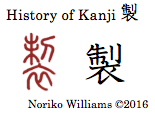 For the kanji 製, in ten style the top was pruning a tree with a pair of shears, which became the kanji 制 “to regulate.” A well-maintained tree signified something well-made. The bottom was “clothes” from “collar.” Together they signified “to make clothes.” The meaning extended to mean manufacturing a well-made product with precision. The kanji 製 means “to manufacture products of even quality; product; made in.”
For the kanji 製, in ten style the top was pruning a tree with a pair of shears, which became the kanji 制 “to regulate.” A well-maintained tree signified something well-made. The bottom was “clothes” from “collar.” Together they signified “to make clothes.” The meaning extended to mean manufacturing a well-made product with precision. The kanji 製 means “to manufacture products of even quality; product; made in.”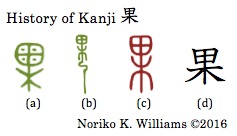 In bronze ware style, it was a tree with berries or fruits on top.The oddly elongated wtiting (b) may be due to a particular stylistic effect. It meant “nut; fruit; berry.” It also meant something that came to fruition, thus, “results.” In ten style (c) the dots were lost. In Japan this writing also meant “to perish; end.” Could it be because fruits and berries perish very quickly? The kanji means “fruit; result; outcome; to perish; end; carry out.”
In bronze ware style, it was a tree with berries or fruits on top.The oddly elongated wtiting (b) may be due to a particular stylistic effect. It meant “nut; fruit; berry.” It also meant something that came to fruition, thus, “results.” In ten style (c) the dots were lost. In Japan this writing also meant “to perish; end.” Could it be because fruits and berries perish very quickly? The kanji means “fruit; result; outcome; to perish; end; carry out.”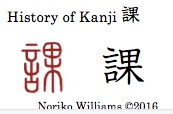 For the kanji 課, in ten style the left side 言 was a bushu gonben “word; language.” The right side 果 was used phonetically for /ka/ to mean “to use; try.” Together they originally signified administering an employment exam. An applicant studied the materials and the examiner gave the test. An official examined the fee or levy, so it also extended to mean “charge.” The kanji 課 means “section of study; lesson; to charge; impose.”
For the kanji 課, in ten style the left side 言 was a bushu gonben “word; language.” The right side 果 was used phonetically for /ka/ to mean “to use; try.” Together they originally signified administering an employment exam. An applicant studied the materials and the examiner gave the test. An official examined the fee or levy, so it also extended to mean “charge.” The kanji 課 means “section of study; lesson; to charge; impose.”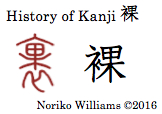 For the kanji 裸, in the ten style writing 果 was phonetically used for /ka/, which was placed inside 衣 “clothes.” In the development of kanji, the shape of a component stayed in tact, not splitting up to allow other shape in between. There are some exceptions. 衣belonged to those exceptions, showing the back and front of a collar separately in some kanji. (The kanji 裏 “back; wrong side” is another example.) The role of 果 is not very clear in 裸 but some scholars think that smooth skin of a fruit and a body could be the connection. A body without clothes meant “bare; naked.”
For the kanji 裸, in the ten style writing 果 was phonetically used for /ka/, which was placed inside 衣 “clothes.” In the development of kanji, the shape of a component stayed in tact, not splitting up to allow other shape in between. There are some exceptions. 衣belonged to those exceptions, showing the back and front of a collar separately in some kanji. (The kanji 裏 “back; wrong side” is another example.) The role of 果 is not very clear in 裸 but some scholars think that smooth skin of a fruit and a body could be the connection. A body without clothes meant “bare; naked.”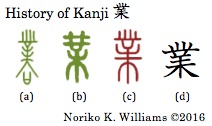 For the kanji 業, the top of (a) in bronze ware style, in green, and ten style (c), in red, had notches to hang a number of musical instruments, and the bottom was its stand. This view came from Setsumon and is the prevalent view in references. The fact that such a stand became writing suggests the importance of musical instruments in a ceremony and religious rite in ancient times. It came to be used to mean “skills; work; one’s deed.” On the other hand Shirakawa takes the view that it was wooden frames that were used to ram dirt down to make a strong foundation or wall, and that from those boards in construction 業 came to mean “work” in general. In Buddhism it is used for “karma” from the Sanskrit word that meant “deed; act.”
For the kanji 業, the top of (a) in bronze ware style, in green, and ten style (c), in red, had notches to hang a number of musical instruments, and the bottom was its stand. This view came from Setsumon and is the prevalent view in references. The fact that such a stand became writing suggests the importance of musical instruments in a ceremony and religious rite in ancient times. It came to be used to mean “skills; work; one’s deed.” On the other hand Shirakawa takes the view that it was wooden frames that were used to ram dirt down to make a strong foundation or wall, and that from those boards in construction 業 came to mean “work” in general. In Buddhism it is used for “karma” from the Sanskrit word that meant “deed; act.”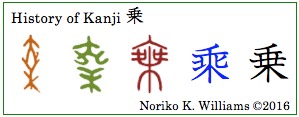 We looked at the kanji 乗 exactly two years ago in connection with “foot.”
We looked at the kanji 乗 exactly two years ago in connection with “foot.” 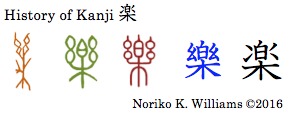 There are different views on what the top of the kanji 楽 originated from — a swing drum on a stand (Setsumon); bells with a handle which had ornamental threads on both sides (Shirakawa); a string instrument, from a fingernail (白) plucking two strings of threads (幺) (Kadokawa); and acorns on a kunugi tree that were used phonetically to mean “fun; to enjoy.” A musical instrument making pleasant rhythmic sounds meant “music; pleasant; enjoyable; comfortable.” The kyujitai writing 樂 reflected ten style but it was simplified to 楽 in shinjitai.
There are different views on what the top of the kanji 楽 originated from — a swing drum on a stand (Setsumon); bells with a handle which had ornamental threads on both sides (Shirakawa); a string instrument, from a fingernail (白) plucking two strings of threads (幺) (Kadokawa); and acorns on a kunugi tree that were used phonetically to mean “fun; to enjoy.” A musical instrument making pleasant rhythmic sounds meant “music; pleasant; enjoyable; comfortable.” The kyujitai writing 樂 reflected ten style but it was simplified to 楽 in shinjitai.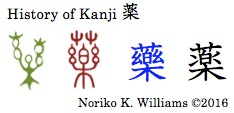 The kanji 薬 has a bushu kusakanmuri “plant; plant life; vegetation” on top of the kanji 楽. The bottom 楽 was used phonetically for /raku/ to mean “medicinal herb.” Together they meant “medicine; pharmaceutical.” Just like 樂, 薬 was simplified to 薬
The kanji 薬 has a bushu kusakanmuri “plant; plant life; vegetation” on top of the kanji 楽. The bottom 楽 was used phonetically for /raku/ to mean “medicinal herb.” Together they meant “medicine; pharmaceutical.” Just like 樂, 薬 was simplified to 薬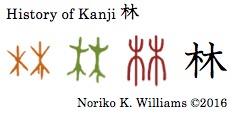 In all the ancient writings in three styles shown on the left, it had two trees side by side. They meant “woods; grove.” When 木 is placed on the left side of a kanji, it is a bushu kihen, and the fourth stroke becomes short.
In all the ancient writings in three styles shown on the left, it had two trees side by side. They meant “woods; grove.” When 木 is placed on the left side of a kanji, it is a bushu kihen, and the fourth stroke becomes short. In oracle bone style the kanji 森 had three trees, either in a triangle shape or side by side. A lot of trees meant “forest.” Deep in a forest also gave the meaning “mystic.”
In oracle bone style the kanji 森 had three trees, either in a triangle shape or side by side. A lot of trees meant “forest.” Deep in a forest also gave the meaning “mystic.”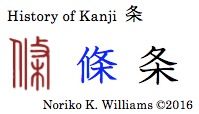 The kanji 条 had the kyujitai 條. The ten style writing had quite a few discrete items– the left side was a person; the middle vertical line was water trickling down; and the right side had a hand holding a stick at the top and (a branch of) a tree. In an earlier post on the bushu bokuzukuri/bokunyoo [
The kanji 条 had the kyujitai 條. The ten style writing had quite a few discrete items– the left side was a person; the middle vertical line was water trickling down; and the right side had a hand holding a stick at the top and (a branch of) a tree. In an earlier post on the bushu bokuzukuri/bokunyoo [ 査 was not discussed in Setsumon. In kanji, the bottom 且 was used phonetically for /sa/. The use of 査 to mean “to examine” was said to have come from a dialectal use or borrowing.
査 was not discussed in Setsumon. In kanji, the bottom 且 was used phonetically for /sa/. The use of 査 to mean “to examine” was said to have come from a dialectal use or borrowing.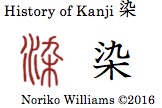 The ten style of the kanji 染 had “water; liquid” on the left side. The right side was wilted leaves and a tree, signifying tree extract to dye. Together soaking fabric in tree extract liquid meant “to dye.” The kanji 染 meant “to dye.”
The ten style of the kanji 染 had “water; liquid” on the left side. The right side was wilted leaves and a tree, signifying tree extract to dye. Together soaking fabric in tree extract liquid meant “to dye.” The kanji 染 meant “to dye.”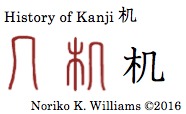 In ten style, the left writing was a low stand with a leg on two sides. It was also used as a stool to sit on or an armrest. The right ten style writing had “wood” on the left. A wooden low table became the kanji 机 “desk; writing table.”
In ten style, the left writing was a low stand with a leg on two sides. It was also used as a stool to sit on or an armrest. The right ten style writing had “wood” on the left. A wooden low table became the kanji 机 “desk; writing table.”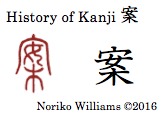 For the kanji 案, the top 安 was used phonetically for /a’n/. The bottom 木 “wood” signified a wooden table. (For the discussion of the kanji 安, please read the previous post [Kanji Radical 女 おんなへん – 女好妹要妻安 on November 23, 2014].) One thought about a matter in order to make a proposal at a desk. From that, it meant “plan; proposal; idea.” Sitting at a desk pondering for a long time also gave the meaning “anxious; to be worried.”
For the kanji 案, the top 安 was used phonetically for /a’n/. The bottom 木 “wood” signified a wooden table. (For the discussion of the kanji 安, please read the previous post [Kanji Radical 女 おんなへん – 女好妹要妻安 on November 23, 2014].) One thought about a matter in order to make a proposal at a desk. From that, it meant “plan; proposal; idea.” Sitting at a desk pondering for a long time also gave the meaning “anxious; to be worried.”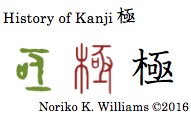 In bronze ware style, it was a person standing in a constricted space. In ten style, a tree was added on the left side. Setsumon treated 極 and 棟 as the “ridge beam” of a house. The room between the ridge beam and roof is very small. In ten style, “wood” and a hand of another person pushing the standing person into a tight corner, and was used phonetically for /kyoku/ to mean “extreme.” Together they meant “extreme.”
In bronze ware style, it was a person standing in a constricted space. In ten style, a tree was added on the left side. Setsumon treated 極 and 棟 as the “ridge beam” of a house. The room between the ridge beam and roof is very small. In ten style, “wood” and a hand of another person pushing the standing person into a tight corner, and was used phonetically for /kyoku/ to mean “extreme.” Together they meant “extreme.”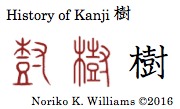 For the kanji 樹, the left side of one ten style writing, in red, had a drum on the left and a hand on the right. The sound of a drum expelled evil while planting seedlings and trees. Another view is that the left side was a tall-legged tray with branches at the top, and the right side was hand holding it. In the second ten style writing a tree was added. The kanji 樹 means “tree” or “to plant a tree.” It is also used to mean “to establish.”
For the kanji 樹, the left side of one ten style writing, in red, had a drum on the left and a hand on the right. The sound of a drum expelled evil while planting seedlings and trees. Another view is that the left side was a tall-legged tray with branches at the top, and the right side was hand holding it. In the second ten style writing a tree was added. The kanji 樹 means “tree” or “to plant a tree.” It is also used to mean “to establish.”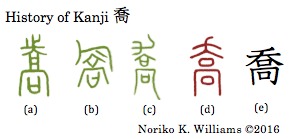 For the kanji 喬, the bottom of bronze ware style, in green, and ten style had a tower with an arch, which became the kanji 高 “high; tall” in other development. The question is what was the top because that presumably became the slanted short stroke. The Setsumon’s explanation of (d) was that 喬 was made up of 夭 and 高, and it meant “tall and tilted at the top.” (夭 came from “a person tilting his head.”) Referring to earlier writings in bronze ware style, Shirakawa says it was tree branches placed at the top of a tower gate as a spell to prevent evil from coming through. No other reference that I have explains bronze ware style writings.
For the kanji 喬, the bottom of bronze ware style, in green, and ten style had a tower with an arch, which became the kanji 高 “high; tall” in other development. The question is what was the top because that presumably became the slanted short stroke. The Setsumon’s explanation of (d) was that 喬 was made up of 夭 and 高, and it meant “tall and tilted at the top.” (夭 came from “a person tilting his head.”) Referring to earlier writings in bronze ware style, Shirakawa says it was tree branches placed at the top of a tower gate as a spell to prevent evil from coming through. No other reference that I have explains bronze ware style writings.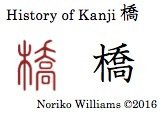 Back to our kanji 橋. The ten style writing for 橋 was 木 and 喬 together. The two component木 “wood” and 喬 “tall; high” together signified a bent wooden structure in a high place, that is a “bridge.” The kun-yomi 橋 /hashi’/ means ‘bridge,” and is in 橋渡しする (“to mediate” /hashiwatashi-suru/). The on-yomi /kyo’o/ is in 鉄橋 (“iron bridge” for railroad /tekkyoo/) and 歩道橋 (“pedestrian bridge” /hodookyoo/).
Back to our kanji 橋. The ten style writing for 橋 was 木 and 喬 together. The two component木 “wood” and 喬 “tall; high” together signified a bent wooden structure in a high place, that is a “bridge.” The kun-yomi 橋 /hashi’/ means ‘bridge,” and is in 橋渡しする (“to mediate” /hashiwatashi-suru/). The on-yomi /kyo’o/ is in 鉄橋 (“iron bridge” for railroad /tekkyoo/) and 歩道橋 (“pedestrian bridge” /hodookyoo/).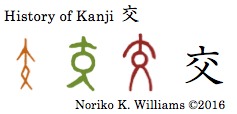 For the kanji 交, the oracle bone style writing, in brown, showed a person crossing his legs. “Crossing legs” gave the meaning “to mix; cross; mingle.”
For the kanji 交, the oracle bone style writing, in brown, showed a person crossing his legs. “Crossing legs” gave the meaning “to mix; cross; mingle.”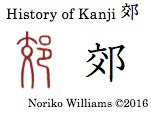 The kanji 郊 could have been discussed earlier together with other kanji with a bushu oozato [
The kanji 郊 could have been discussed earlier together with other kanji with a bushu oozato [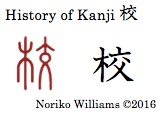 Now we are ready to look at the kanji 校. By adding 木 “wood” it created a totally different meaning — a pair of shackles over a prisoner’s ankles or neck. Crossing also gave the meaning “to check; compare.” A school is where knowledge gets exchanged between teachers and students, so 校 also meant “school.” Piling logs in an interlocking manner makes a wall, and a house. A military installation had a crossed-log wall or fence, and from that 校 was also used to mean “military officer.”
Now we are ready to look at the kanji 校. By adding 木 “wood” it created a totally different meaning — a pair of shackles over a prisoner’s ankles or neck. Crossing also gave the meaning “to check; compare.” A school is where knowledge gets exchanged between teachers and students, so 校 also meant “school.” Piling logs in an interlocking manner makes a wall, and a house. A military installation had a crossed-log wall or fence, and from that 校 was also used to mean “military officer.”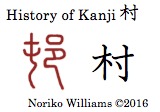 Here is another kanji for “village.” The kanji 村 originally was 邨. The left side of the ten style writing, 屯, “fringe,” was from threads gathered and tied, and signified “encampment; a band of people.” The right side 邑 was a village, as we have seen before. Together they meant “village.” The kanji 村 originally meant “field and villages,” but its use as “village” goes back a long time. The right side 寸 was used phonetically.
Here is another kanji for “village.” The kanji 村 originally was 邨. The left side of the ten style writing, 屯, “fringe,” was from threads gathered and tied, and signified “encampment; a band of people.” The right side 邑 was a village, as we have seen before. Together they meant “village.” The kanji 村 originally meant “field and villages,” but its use as “village” goes back a long time. The right side 寸 was used phonetically. For the kanji 沈, the two oracle bone style writings had a sacrificial cow in a river for a rite. From that it meant “to sink; drop down.” The right side of the bronze ware style writing looks to me like a person with a bar across the neck. This reminds me of a yoke around the neck to indicate the center of a body in the origin of the kanji 央.
For the kanji 沈, the two oracle bone style writings had a sacrificial cow in a river for a rite. From that it meant “to sink; drop down.” The right side of the bronze ware style writing looks to me like a person with a bar across the neck. This reminds me of a yoke around the neck to indicate the center of a body in the origin of the kanji 央. 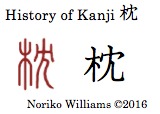 For the kanji 枕, the right side was used phonetically for /chi’n/. Shirakawa explains that the right side was a person lying down. Together a wooden item one used to sleep on meant a “pillow.” Kanjigen took its explanation for the kanji 沈 in the oracle bone style, referring to “a cow in river water.” It also says that the horizontal short line on the right side was a wooden piece to press down a person on the shoulder, and that something one used above the shoulder when lying down meant “pillow.”
For the kanji 枕, the right side was used phonetically for /chi’n/. Shirakawa explains that the right side was a person lying down. Together a wooden item one used to sleep on meant a “pillow.” Kanjigen took its explanation for the kanji 沈 in the oracle bone style, referring to “a cow in river water.” It also says that the horizontal short line on the right side was a wooden piece to press down a person on the shoulder, and that something one used above the shoulder when lying down meant “pillow.”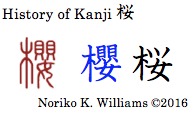 For the kanji 桜 in ten style, the right side was used phonetically. It signified a tree that bore small fruits like beads in a necklace (two 貝) that a woman wore. The fruit was called /yusura’ume/. In Japan it is used to mean /sakura/ “cherry (blossom) tree” for flower viewing. The kyujitai reflected ten style, but in shinjitai, the right top had been replaced by a simpler short katakana /tsu/ ツ. Cherry as a fruit is called /sakuranbo/.
For the kanji 桜 in ten style, the right side was used phonetically. It signified a tree that bore small fruits like beads in a necklace (two 貝) that a woman wore. The fruit was called /yusura’ume/. In Japan it is used to mean /sakura/ “cherry (blossom) tree” for flower viewing. The kyujitai reflected ten style, but in shinjitai, the right top had been replaced by a simpler short katakana /tsu/ ツ. Cherry as a fruit is called /sakuranbo/.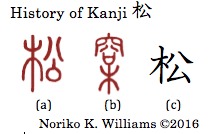 For the kanji 松 we have two ten style writings here. In (a) the right side 公 was phonetically used. The top of (b) had the shape of 容, but its role is not clear. 松 meant “pine tree.” Kadokawa explains that 公 was used phonetically to mean a pointed knife, and that a tree with pointed leaves meant pine tree. Kanjigen explains that 公 phonetically meant “letting through,” and that a tree with narrow leaves that left gaps was a pine tree. A pine tree is evergreen and grows tall and strong. In Japan pine trees are appreciated as auspicious trees. Customarily 松明 is read as /taimatsu/ and means “torch.” Pine and its resin burn well with bright light.
For the kanji 松 we have two ten style writings here. In (a) the right side 公 was phonetically used. The top of (b) had the shape of 容, but its role is not clear. 松 meant “pine tree.” Kadokawa explains that 公 was used phonetically to mean a pointed knife, and that a tree with pointed leaves meant pine tree. Kanjigen explains that 公 phonetically meant “letting through,” and that a tree with narrow leaves that left gaps was a pine tree. A pine tree is evergreen and grows tall and strong. In Japan pine trees are appreciated as auspicious trees. Customarily 松明 is read as /taimatsu/ and means “torch.” Pine and its resin burn well with bright light.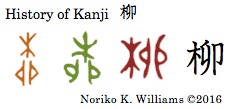 For the kanji 柳 all three ancient writings consisted of a tree at the top and the shape that would become 卯 in kanji. What was the bottom shape, which eventually became the right side of the kanji 柳? The Kadokawa dictionary says that it was used phonetically and to mean “to flow” like 流, and that branches swinging in the wind were a “willow tree.” Kanjigen explains that the right side was the original writing for 留, which meant to stop everything from slipping, and that the kanji 柳 meant the leaves were slipping like they were flowing. Shirakawa treated it as phonetic use of 留.
For the kanji 柳 all three ancient writings consisted of a tree at the top and the shape that would become 卯 in kanji. What was the bottom shape, which eventually became the right side of the kanji 柳? The Kadokawa dictionary says that it was used phonetically and to mean “to flow” like 流, and that branches swinging in the wind were a “willow tree.” Kanjigen explains that the right side was the original writing for 留, which meant to stop everything from slipping, and that the kanji 柳 meant the leaves were slipping like they were flowing. Shirakawa treated it as phonetic use of 留.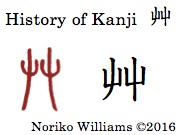 In the traditional kanji dictionary, the bushu kusakanmuri was listed as six strokes or four stokes. We can see why it was classified as six strokes in the kanji 艸 “grass; plant,” which is not used in Japanese. In ten style, it was two plants growing. When used as a bushu before a shinjitai, it was two short 十 , thus a four-stroke bushu. Now it is a three-stroke bushu.
In the traditional kanji dictionary, the bushu kusakanmuri was listed as six strokes or four stokes. We can see why it was classified as six strokes in the kanji 艸 “grass; plant,” which is not used in Japanese. In ten style, it was two plants growing. When used as a bushu before a shinjitai, it was two short 十 , thus a four-stroke bushu. Now it is a three-stroke bushu.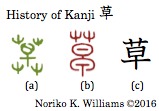 For the kanji 草, (a) in stone-engraved style, in green, is a horse chestnut acorn surrounded by grass in all directions. It meant “grass; weed.” In ten style (b), in red, the grass remained only at the top and the acorn became a dominant shape. Grass emerging on the ground also gave the meaning “beginning” and “informal.”
For the kanji 草, (a) in stone-engraved style, in green, is a horse chestnut acorn surrounded by grass in all directions. It meant “grass; weed.” In ten style (b), in red, the grass remained only at the top and the acorn became a dominant shape. Grass emerging on the ground also gave the meaning “beginning” and “informal.” For the kanji 芝, in ten style the top was grass and the bottom was a footprint signifying “to go out.“ It was originally a fast-growing mushroom or herb that was believed to help longevity. The kanji 芝 meant “grass; turf grass.”
For the kanji 芝, in ten style the top was grass and the bottom was a footprint signifying “to go out.“ It was originally a fast-growing mushroom or herb that was believed to help longevity. The kanji 芝 meant “grass; turf grass.” For the kanji 菌, in ten style below “grass; plant” was an enclosure with 禾 inside, which was used phonetically for /kin/ that meant “densely built up.” Together they originally meant mushrooms, which grew in a lump on soil or decayed trees. The kanji 菌 means “fungus; bacteria.”
For the kanji 菌, in ten style below “grass; plant” was an enclosure with 禾 inside, which was used phonetically for /kin/ that meant “densely built up.” Together they originally meant mushrooms, which grew in a lump on soil or decayed trees. The kanji 菌 means “fungus; bacteria.” For the kanji 茶, in olden days another kanji that had 余 underneath was used. The ten style writing shown on the left was for this kanji, and it meant “bitter.” Since the Tang dynasty in China, it was used to mean a short tree whose leaves made bitter drinking, which was “tea.”
For the kanji 茶, in olden days another kanji that had 余 underneath was used. The ten style writing shown on the left was for this kanji, and it meant “bitter.” Since the Tang dynasty in China, it was used to mean a short tree whose leaves made bitter drinking, which was “tea.” For the kanji 苦, the ten style writing consisted of grass at the top and 古 at the bottom, which was used phonetically. It originally meant a very bitter plant called /nigana/. It was extended to mean “touch; hard.”
For the kanji 苦, the ten style writing consisted of grass at the top and 古 at the bottom, which was used phonetically. It originally meant a very bitter plant called /nigana/. It was extended to mean “touch; hard.” For the kanji 苛 in bronze ware style, in green, underneath “plants” was 可 that was used phonetically. 可 had 口 “mouth,” where voice comes out through a bent passage, signifying an utterance made with some reluctance. Kanjigen explains that 苛 was a plant that irritated the throat, which gave the meaning “an act that causes severe friction or impact.” From “short grass” (Setsumon), Shirakawa explains that rampantly grown grass gave the meaning crude and violent. The kanji 苛 means “severe; crude.”
For the kanji 苛 in bronze ware style, in green, underneath “plants” was 可 that was used phonetically. 可 had 口 “mouth,” where voice comes out through a bent passage, signifying an utterance made with some reluctance. Kanjigen explains that 苛 was a plant that irritated the throat, which gave the meaning “an act that causes severe friction or impact.” From “short grass” (Setsumon), Shirakawa explains that rampantly grown grass gave the meaning crude and violent. The kanji 苛 means “severe; crude.”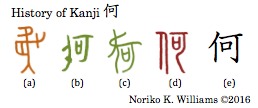 For the kanji 何, in oracle bone style, in brown, it was a picture of a person carrying a halberd. In bronze ware style (a) and (b), it was a person carrying some load on his shoulder. 何 originally meant “to carry a load on the shoulder.” At the same time the right side 可 had the meaning “pang (of conscience)” and “questioning.” From that the writing 何 came to be used to mean “what” or an interrogative word.
For the kanji 何, in oracle bone style, in brown, it was a picture of a person carrying a halberd. In bronze ware style (a) and (b), it was a person carrying some load on his shoulder. 何 originally meant “to carry a load on the shoulder.” At the same time the right side 可 had the meaning “pang (of conscience)” and “questioning.” From that the writing 何 came to be used to mean “what” or an interrogative word. Because the writing 何 was taken to mean “interrogative,” a new kanji to express its original meaning “load” was needed.” In ten style, the top was explained in Setsumon as lotus leaves. Lotus leaves are flat on an upright stem, like someone carrying a load on the shoulder. The kanji 荷 means “to carry over shoulder; burden.”
Because the writing 何 was taken to mean “interrogative,” a new kanji to express its original meaning “load” was needed.” In ten style, the top was explained in Setsumon as lotus leaves. Lotus leaves are flat on an upright stem, like someone carrying a load on the shoulder. The kanji 荷 means “to carry over shoulder; burden.”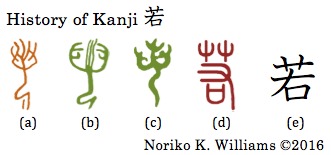 For the kanji 若, in oracle bone style (a) and bronze ware style (b) and (c) it was a young woman with long hair dancing, possibly in a prayer dance. From her pliant posture it meant “young.” In ten style, the top became plants, a hand in the middle, and a mouth at the bottom. The kanji consists of a bushu kusakanmuri and the kanji 右, and meant “young.”
For the kanji 若, in oracle bone style (a) and bronze ware style (b) and (c) it was a young woman with long hair dancing, possibly in a prayer dance. From her pliant posture it meant “young.” In ten style, the top became plants, a hand in the middle, and a mouth at the bottom. The kanji consists of a bushu kusakanmuri and the kanji 右, and meant “young.”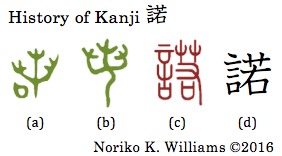 For the kanji 諾, the bronze ware style writings, (a) and (b), were very similar to the bronze ware style writing (c) in 若. Shirakawa explained that the god’s response appeared when a medium is in trance. From that it meant “to grant; consent.” The Kadokawa dictionary explains that a gonben “word” and 若 “compliant” together signified “to give consent.”
For the kanji 諾, the bronze ware style writings, (a) and (b), were very similar to the bronze ware style writing (c) in 若. Shirakawa explained that the god’s response appeared when a medium is in trance. From that it meant “to grant; consent.” The Kadokawa dictionary explains that a gonben “word” and 若 “compliant” together signified “to give consent.” For the kanji 荒, grasses at the top and a body whose hairs still attached signified a body in the wilderness due to starvation. It is a desolate scene. From that the kanji 荒 means “rough; violent.”
For the kanji 荒, grasses at the top and a body whose hairs still attached signified a body in the wilderness due to starvation. It is a desolate scene. From that the kanji 荒 means “rough; violent.”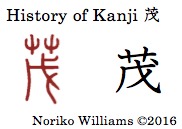 For the kanji 茂, in ten style, in red, the bottom 戊 originally came from “halberd,” but it was only used phonetically here to mean “to cover.” Together with “plants” at the top, they meant plants growing densely. The kanji 茂 meant “to grow thick; become dense.”
For the kanji 茂, in ten style, in red, the bottom 戊 originally came from “halberd,” but it was only used phonetically here to mean “to cover.” Together with “plants” at the top, they meant plants growing densely. The kanji 茂 meant “to grow thick; become dense.” In ten style of the kanji 芋 had 于at the bottom. We have looked at the shape 于in the kanji 宇in connection with a bushu ukanmuri in the earlier post (
In ten style of the kanji 芋 had 于at the bottom. We have looked at the shape 于in the kanji 宇in connection with a bushu ukanmuri in the earlier post ( For the kanji 苗 in ten style it had “plants” at the top and “rice paddies” at the bottom. Together they meant “seedling.”
For the kanji 苗 in ten style it had “plants” at the top and “rice paddies” at the bottom. Together they meant “seedling.” For the kanji 葉 in oracle bone style, in brown, it was a tree with new growth or leaves at the tip of tree limbs. In bronze ware style the growing top was emphasized, keeping it separate from the tree. In ten style “plants; grass” were added at the top, and the middle was similar to the kanji 世, in which a tree was branching out. Together they meant “leaf.” A leaf is flat. So, it is also used for “something flat.” The word 言葉 /kotoba’/ comes from a Yamato-kotoba koto-no-ha “a leaf of the language.”
For the kanji 葉 in oracle bone style, in brown, it was a tree with new growth or leaves at the tip of tree limbs. In bronze ware style the growing top was emphasized, keeping it separate from the tree. In ten style “plants; grass” were added at the top, and the middle was similar to the kanji 世, in which a tree was branching out. Together they meant “leaf.” A leaf is flat. So, it is also used for “something flat.” The word 言葉 /kotoba’/ comes from a Yamato-kotoba koto-no-ha “a leaf of the language.”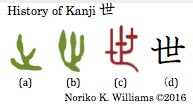 In bronze ware style, the shape of three branches with bulges signified new growth or new generation. Generations of people live together in the world. The kanji 世means “generation; world.”
In bronze ware style, the shape of three branches with bulges signified new growth or new generation. Generations of people live together in the world. The kanji 世means “generation; world.”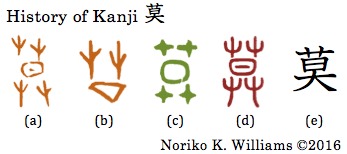
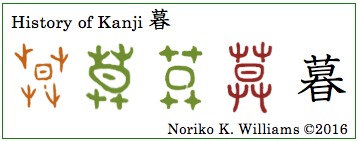 The ancient writing shown on the left for the kanji 莫 were the same as the kanji 暮 shown on the right in a box. In all of the ancient writings, (a) and (b) in oracle bone style, (b) in bronze ware style and (c) in ten style, the sun, in the center, was about to go down behind tall grass. It originally meant “dusk; sundown.” Then as the writing came to be used to mean “nothing,” they needed a new writing that expressed “dusk; sundown.” So by adding another “sun” the kanji 暮 was created. The kanji 莫 meant “nothing,” and when used as a component, 莫 was used phonetically for /bo; mo; baku; maku/ to mean “invisible; vague.”
The ancient writing shown on the left for the kanji 莫 were the same as the kanji 暮 shown on the right in a box. In all of the ancient writings, (a) and (b) in oracle bone style, (b) in bronze ware style and (c) in ten style, the sun, in the center, was about to go down behind tall grass. It originally meant “dusk; sundown.” Then as the writing came to be used to mean “nothing,” they needed a new writing that expressed “dusk; sundown.” So by adding another “sun” the kanji 暮 was created. The kanji 莫 meant “nothing,” and when used as a component, 莫 was used phonetically for /bo; mo; baku; maku/ to mean “invisible; vague.”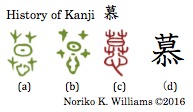 For the kanji 慕 a couple of bronze ware style writings, (a) and (b), are shown here. It had a “heart” below “the sun disappearing behind tall grasses,” signifying “not visible.” What was in one’s mind could not be seen either. Together they originally signified “seeking for something in an unclear vast area,” thus “to consult; seek ideas.” Later the meaning changed to mean “to yearn for; adore.” In kanji, (d), the chambers of the heart took the shape of four short strokes, with the second one longer. This shape is called a bushu shitagokoro. (The bushu shitagokoro is in limited use, and another Joyo kanji that contains a bushu shitagokoro is the kanji 添 “to play along; accompany.”)
For the kanji 慕 a couple of bronze ware style writings, (a) and (b), are shown here. It had a “heart” below “the sun disappearing behind tall grasses,” signifying “not visible.” What was in one’s mind could not be seen either. Together they originally signified “seeking for something in an unclear vast area,” thus “to consult; seek ideas.” Later the meaning changed to mean “to yearn for; adore.” In kanji, (d), the chambers of the heart took the shape of four short strokes, with the second one longer. This shape is called a bushu shitagokoro. (The bushu shitagokoro is in limited use, and another Joyo kanji that contains a bushu shitagokoro is the kanji 添 “to play along; accompany.”) For the kanji 幕, in ten style the bottom was “drapery; cloth.” The top was used phonetically as well as to mean “to hide; cover.” Together it meant a military tent. A military headquarters in a battlefield had drapery around it, and the word 幕府 /ba’kuhu/ “shogunate government; bakufu government” comes from it.
For the kanji 幕, in ten style the bottom was “drapery; cloth.” The top was used phonetically as well as to mean “to hide; cover.” Together it meant a military tent. A military headquarters in a battlefield had drapery around it, and the word 幕府 /ba’kuhu/ “shogunate government; bakufu government” comes from it. For the kanji 募, in ten style, the bottom was “plough” signifying “man power.” The top was used phonetically to signify “unspecified wide area.” Together they meant “to search widely; to recruit people; to raise money.”
For the kanji 募, in ten style, the bottom was “plough” signifying “man power.” The top was used phonetically to signify “unspecified wide area.” Together they meant “to search widely; to recruit people; to raise money.”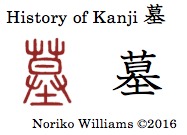 For the kanji 墓, in ten style the bottom was土 “soil; ground.” Burying the deceased underneath the ground made them invisible or hidden. From that it meant a “tomb.”
For the kanji 墓, in ten style the bottom was土 “soil; ground.” Burying the deceased underneath the ground made them invisible or hidden. From that it meant a “tomb.” For the kanji 漠 in ten style the left side was a bushu sanzui “water.” Drifting sand moves like running water. Together with 莫 “vast,” they meant “vast area of drifting sand; desert.” Another view is that the meaning 莫 “nothing” and “water” together meant “a place that had no water,” which was “desert.”
For the kanji 漠 in ten style the left side was a bushu sanzui “water.” Drifting sand moves like running water. Together with 莫 “vast,” they meant “vast area of drifting sand; desert.” Another view is that the meaning 莫 “nothing” and “water” together meant “a place that had no water,” which was “desert.”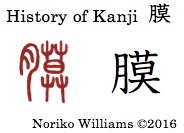 For the kun-yomi 膜 the ten style had a bushu nikuzuki “flesh” on the left side. The right side 莫 had the meaning “to cover; drapery.” Together they meant “membrane.”
For the kun-yomi 膜 the ten style had a bushu nikuzuki “flesh” on the left side. The right side 莫 had the meaning “to cover; drapery.” Together they meant “membrane.” For the kanji 模, the ten style had a tree on the left side. The right side was used phonetically for /mo/. A mold was made with pieces of wood. From that it meant “model; to model.” The kanji “model; prescribed form; to copy.”
For the kanji 模, the ten style had a tree on the left side. The right side was used phonetically for /mo/. A mold was made with pieces of wood. From that it meant “model; to model.” The kanji “model; prescribed form; to copy.”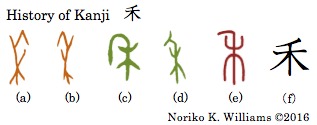 禾 is not used as a kanji in Japanese but it is useful for us to start this topic. In oracle bone style, (a) and (b) in brown, and bronze ware style, (c) and (d) in green, it was a rice plant in which the top was bent downward because its crop was full and heavy. It meant “rice plant.” After a stylized ten style writing, (e) in red, the drooped crop became a short slant in kanji. When it is used on the left side it is called a bushu nogihen.
禾 is not used as a kanji in Japanese but it is useful for us to start this topic. In oracle bone style, (a) and (b) in brown, and bronze ware style, (c) and (d) in green, it was a rice plant in which the top was bent downward because its crop was full and heavy. It meant “rice plant.” After a stylized ten style writing, (e) in red, the drooped crop became a short slant in kanji. When it is used on the left side it is called a bushu nogihen. For the kanji 季 in all the three ancient styles, the top was rice plant with drooping crops, and the bottom was a child. A child signified “small.” It was also used to mean “youngest child.” In the current use, 季 is used mostly to mean “season; quarterly.”
For the kanji 季 in all the three ancient styles, the top was rice plant with drooping crops, and the bottom was a child. A child signified “small.” It was also used to mean “youngest child.” In the current use, 季 is used mostly to mean “season; quarterly.”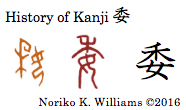 For the kanji 委, the oracle bone style writing had a rice plant on the left and a woman on the right. A woman was in a pliant kneeling position, which gave the meaning of something pliant, flexible or “to comply easily.” From that, it also meant “to entrust.”
For the kanji 委, the oracle bone style writing had a rice plant on the left and a woman on the right. A woman was in a pliant kneeling position, which gave the meaning of something pliant, flexible or “to comply easily.” From that, it also meant “to entrust.”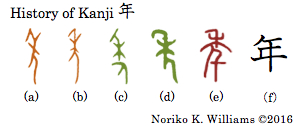 It is not eady to see 禾 in the kanji 年, or even a “person“ in it. But the ancient writing samples in all three styles tell us the same story on the origin. In oracle bone style (a) and (b) had a person standing with his hand in front, which was the same as the origin of the kanji 人 “person.” The top was a rice plant with a drooping top. The same composition was seen in bronze ware style (c) and (d) and in ten style (e). The cycle of harvesting rice crops was yearly. From that the kanji 年 meant “year; annual; age.”
It is not eady to see 禾 in the kanji 年, or even a “person“ in it. But the ancient writing samples in all three styles tell us the same story on the origin. In oracle bone style (a) and (b) had a person standing with his hand in front, which was the same as the origin of the kanji 人 “person.” The top was a rice plant with a drooping top. The same composition was seen in bronze ware style (c) and (d) and in ten style (e). The cycle of harvesting rice crops was yearly. From that the kanji 年 meant “year; annual; age.”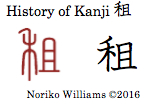 In ten style of the kanji 祖, the right side (且) signified “to stack up.” A pile of rice plants got assessed for taxation. The kanji 祖 meant “tax; levy.”
In ten style of the kanji 祖, the right side (且) signified “to stack up.” A pile of rice plants got assessed for taxation. The kanji 祖 meant “tax; levy.”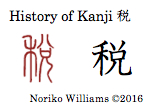 For the kanji 税 in ten style the right side was the same as the kanji 脱, which meant “something leaving; to come off.” With the left side a bushu nogihen “rice plants,” they meant “a part of one’s harvest leaving or taking away”-that was “tax; levy.”
For the kanji 税 in ten style the right side was the same as the kanji 脱, which meant “something leaving; to come off.” With the left side a bushu nogihen “rice plants,” they meant “a part of one’s harvest leaving or taking away”-that was “tax; levy.”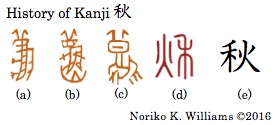 For the kanji 秋, in oracle bone style (a) was a bug that ate rice. (b) had a fire at the bottom of the bug. I cannot figure out what the right bottom shape in (c) was. The fire signified heat to dry crops, or burning bugs that ate grains. In ten style, the left side was a “fire” and the right side was “rice plant with crop.” The season of harvesting crops is autumn. It meant “autumn; fall.” In kanji, the positions of the two components switched.
For the kanji 秋, in oracle bone style (a) was a bug that ate rice. (b) had a fire at the bottom of the bug. I cannot figure out what the right bottom shape in (c) was. The fire signified heat to dry crops, or burning bugs that ate grains. In ten style, the left side was a “fire” and the right side was “rice plant with crop.” The season of harvesting crops is autumn. It meant “autumn; fall.” In kanji, the positions of the two components switched.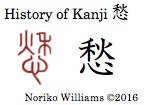 For the kanji 愁 in ten style the top was same as 秋, and was used phonetically for /shu’u/. The bottom was a heart. Together they meant “to grieve; be distressed.”
For the kanji 愁 in ten style the top was same as 秋, and was used phonetically for /shu’u/. The bottom was a heart. Together they meant “to grieve; be distressed.”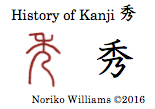 For the kanji 秀 in ten style the top was a rice plant and the bottom was a rice plant grown long. It was the time before grain was taken out and was the best time. From that it meant “excellent.” In kanji the bottom became 乃.
For the kanji 秀 in ten style the top was a rice plant and the bottom was a rice plant grown long. It was the time before grain was taken out and was the best time. From that it meant “excellent.” In kanji the bottom became 乃.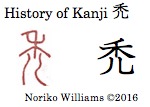 The kanji 禿 ”baldness” — The kanji 禿 is not a Joyo kanji, but it is worthwhile to note the similarity and dissimilarity between the kanji 秀 and 禿. In ten style the bottom signified an empty hull after grain was taken out. Later on the meaning of “not having” was extended to mean “not having hair, baldness.” The kun-yomi /ha’ge/ means “baldness,” and is in 禿げ山 (“treeless mountain” /hageyama/). [The explanation of 秀 and 禿 is based on Shirakawa, and there are other views.]
The kanji 禿 ”baldness” — The kanji 禿 is not a Joyo kanji, but it is worthwhile to note the similarity and dissimilarity between the kanji 秀 and 禿. In ten style the bottom signified an empty hull after grain was taken out. Later on the meaning of “not having” was extended to mean “not having hair, baldness.” The kun-yomi /ha’ge/ means “baldness,” and is in 禿げ山 (“treeless mountain” /hageyama/). [The explanation of 秀 and 禿 is based on Shirakawa, and there are other views.]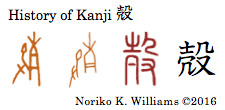 The next kanji 殻 was also related to “hull” after grain was taken out of rice plants. In each of the two oracle bone style writings shown on the left, the left side was a hand holding a tool that was used to pound rice plants. The right side was an “empty hull.” Together they meant a rice plant after it was pounded to remove the grain, “hull.” The positions were reversed in ten style, which was reflected in the kanji. The kanji 殻 meant “shell; hull; shell.”
The next kanji 殻 was also related to “hull” after grain was taken out of rice plants. In each of the two oracle bone style writings shown on the left, the left side was a hand holding a tool that was used to pound rice plants. The right side was an “empty hull.” Together they meant a rice plant after it was pounded to remove the grain, “hull.” The positions were reversed in ten style, which was reflected in the kanji. The kanji 殻 meant “shell; hull; shell.”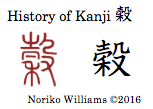 When we compare the two kanji 殻 and 穀 in ten style, we notice that they are identical except that 穀 had 禾 at the bottom left. One threshed grain by pounding down by hand using a tool. The kanji 穀 means “grains.”
When we compare the two kanji 殻 and 穀 in ten style, we notice that they are identical except that 穀 had 禾 at the bottom left. One threshed grain by pounding down by hand using a tool. The kanji 穀 means “grains.”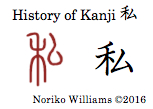 For the kanji 私 in ten style, in red, the left side was a “rice plant.” The right side was a hoe or plow of a peasant who worked on a private field owned by a landowner. From a private land peasant, it meant “private” and was extended to mean “I.” Another view of the right side is that a person was bending his arm to claim crops that belonged to him. In kanji the right side is in the katakana ムshape.
For the kanji 私 in ten style, in red, the left side was a “rice plant.” The right side was a hoe or plow of a peasant who worked on a private field owned by a landowner. From a private land peasant, it meant “private” and was extended to mean “I.” Another view of the right side is that a person was bending his arm to claim crops that belonged to him. In kanji the right side is in the katakana ムshape.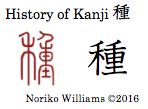 For the kanji 種 in ten style the right side meant “heavy.” (Please refer to the earlier post on 重 “heavy.” [The Kanji 東動働重童-力 “power” (3) on January 5, 2015] The grains that were full and heavy made good seeds and were kept for the next seeding time. Seeds are also of different kinds. The kanji 種 meant “seed; kind.”
For the kanji 種 in ten style the right side meant “heavy.” (Please refer to the earlier post on 重 “heavy.” [The Kanji 東動働重童-力 “power” (3) on January 5, 2015] The grains that were full and heavy made good seeds and were kept for the next seeding time. Seeds are also of different kinds. The kanji 種 meant “seed; kind.”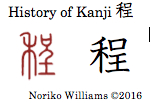 For the kanji 程 in ten style the right side had a person with a short line at the shin, and was used phonetically to mean “to present; submit.” Together with the left side “rice plant,” they meant the neatly piled rice plants that were measured. Measuring gave the meaning “extent; degree.” In kanji the right side became 呈 (“to present; submit” /te’e/) with the bottom changing to 王 from the shape 壬 that was kept in other kanji such as 廷庭.
For the kanji 程 in ten style the right side had a person with a short line at the shin, and was used phonetically to mean “to present; submit.” Together with the left side “rice plant,” they meant the neatly piled rice plants that were measured. Measuring gave the meaning “extent; degree.” In kanji the right side became 呈 (“to present; submit” /te’e/) with the bottom changing to 王 from the shape 壬 that was kept in other kanji such as 廷庭.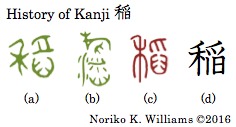 For the kanji 稲 in bronze ware style, in green, the right side of (a) had “a hand reaching from above” and “a mortar” at the bottom. It was also used phonetically to mean “a scooping.” With the left side a rice plant with crop, together they meant a hand handling rice in a mortar. In (b) the rice plant and a hand were placed at the top, and the bottom had “water” on the left, and rice grains and a mortar on the right side. Rice is grown in paddies immersed in water at earlier stage, unlike other grains. From a hand handling rice in a mortar the kanji 稲 meant “rice plant.”
For the kanji 稲 in bronze ware style, in green, the right side of (a) had “a hand reaching from above” and “a mortar” at the bottom. It was also used phonetically to mean “a scooping.” With the left side a rice plant with crop, together they meant a hand handling rice in a mortar. In (b) the rice plant and a hand were placed at the top, and the bottom had “water” on the left, and rice grains and a mortar on the right side. Rice is grown in paddies immersed in water at earlier stage, unlike other grains. From a hand handling rice in a mortar the kanji 稲 meant “rice plant.”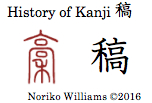 For the kanji 稿 in ten style the top was a tower, and was used phonetically to mean “dry.” Inside the tower was rice plants. Together they originally signified dry rice plants or “straw.” In shinjitai the two components 禾 “rice plants” and 高 were placed side by side. Straws scattered were similar to scattered scribbles or notes for manuscripts. From that it meant “manuscripts.” The original meaning of “straw” is written as 藁 (a bushu kusakanmuri, 高 and 木) pronounced as /wa’ra/, which is not included among Joyo kanji.
For the kanji 稿 in ten style the top was a tower, and was used phonetically to mean “dry.” Inside the tower was rice plants. Together they originally signified dry rice plants or “straw.” In shinjitai the two components 禾 “rice plants” and 高 were placed side by side. Straws scattered were similar to scattered scribbles or notes for manuscripts. From that it meant “manuscripts.” The original meaning of “straw” is written as 藁 (a bushu kusakanmuri, 高 and 木) pronounced as /wa’ra/, which is not included among Joyo kanji.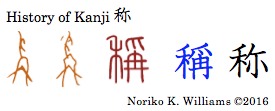 For the kanji 称 the oracle bone style writings, in brown, had a hand from above at the top holding a pair of scales. From “lifting two things to weigh” it meant “to raise someone up with praise.” In ten style, the left side had a rice plant and the right side was a hand and a well-balanced structure, signifying lifting a weigh scale. The kyujitai, in blue, reflected the ten style writing. In shinjitai, the right side was replaced by 尓.
For the kanji 称 the oracle bone style writings, in brown, had a hand from above at the top holding a pair of scales. From “lifting two things to weigh” it meant “to raise someone up with praise.” In ten style, the left side had a rice plant and the right side was a hand and a well-balanced structure, signifying lifting a weigh scale. The kyujitai, in blue, reflected the ten style writing. In shinjitai, the right side was replaced by 尓.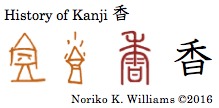 For the kanji 香, the oracle bone style writings were millet in a bowl. That became the top of the ten style writing.
For the kanji 香, the oracle bone style writings were millet in a bowl. That became the top of the ten style writing.  It is not easy to see the transition, but if we look at the history of the kanji 黍 /ki’bi/ “millet” shown on the right, we can see that the ten style of 黍 became the top of the ten style of 香. Millet has a fragrance. (I do not know how millet smells.) With 曰, it meant one tasting in one’s mouth millet that is fragrant. So in 香, 禾 at the top was not from “rice plant” but “rice-like plant.” The kanji 香 meant “pleasant smell; fragrance.”
It is not easy to see the transition, but if we look at the history of the kanji 黍 /ki’bi/ “millet” shown on the right, we can see that the ten style of 黍 became the top of the ten style of 香. Millet has a fragrance. (I do not know how millet smells.) With 曰, it meant one tasting in one’s mouth millet that is fragrant. So in 香, 禾 at the top was not from “rice plant” but “rice-like plant.” The kanji 香 meant “pleasant smell; fragrance.”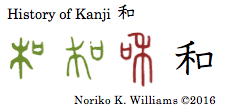 For the kanji 和 in bronze ware style the left side had a wooden sign on a gate of a military installation. The right side was a box to contain documents. Together they signified a military truce agreement for peace, and from that it meant “peace; harmony.” That is View A. The more prevalent view, View B, is that it was used phonetically: 禾 was a drooping head of a millet plant, was used phonetically to mean “rounded” (Kanjigen) and signified “not having a conflict”; or, the writing consisted of a mouth and 禾 /ka/, which signified phonetically “to add,” as in 加 /ka/. Together they meant people talk harmoniously (Kadokawa). 和 also meant “Japanese.”
For the kanji 和 in bronze ware style the left side had a wooden sign on a gate of a military installation. The right side was a box to contain documents. Together they signified a military truce agreement for peace, and from that it meant “peace; harmony.” That is View A. The more prevalent view, View B, is that it was used phonetically: 禾 was a drooping head of a millet plant, was used phonetically to mean “rounded” (Kanjigen) and signified “not having a conflict”; or, the writing consisted of a mouth and 禾 /ka/, which signified phonetically “to add,” as in 加 /ka/. Together they meant people talk harmoniously (Kadokawa). 和 also meant “Japanese.”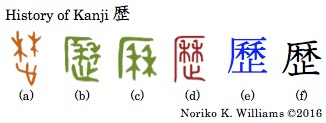 For the kanji 歴 in oracle bone style (a) had two piecs of wood or rice plants and a footprint. In bronze ware style, (b) and (c), cliff or roof was added. (c) did not have a footprint. In ten style 禾 was 木, but in kyujitai kanji it became 禾, and further changed back to 木 in shinjitai kanji. View A: the top signified military signs under a cliff and the footprint signified an army touring a number of places one by one. Because army moved from one place to another, it meant “path; history.” View B: Many seasons of rice harvests counted one by one. The kanji 歴 meant “history; path.”
For the kanji 歴 in oracle bone style (a) had two piecs of wood or rice plants and a footprint. In bronze ware style, (b) and (c), cliff or roof was added. (c) did not have a footprint. In ten style 禾 was 木, but in kyujitai kanji it became 禾, and further changed back to 木 in shinjitai kanji. View A: the top signified military signs under a cliff and the footprint signified an army touring a number of places one by one. Because army moved from one place to another, it meant “path; history.” View B: Many seasons of rice harvests counted one by one. The kanji 歴 meant “history; path.”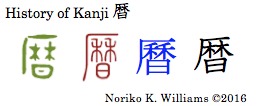 View A: a military field headquarters and a box of documents. It originally meant a recognition ceremony for distinguished war service at the gate. Later on the bottom was mistakenly interpreted as the sun, and it was used as a calendar. View B: Rice plants laid in a row and the sun together signified “the sun taking its path.” From that it meant “calendar.”
View A: a military field headquarters and a box of documents. It originally meant a recognition ceremony for distinguished war service at the gate. Later on the bottom was mistakenly interpreted as the sun, and it was used as a calendar. View B: Rice plants laid in a row and the sun together signified “the sun taking its path.” From that it meant “calendar.”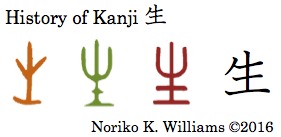 For the kanji 生, in oracle bone style, in brown, it was a plant coming out of the ground. It signified “to emerge; grow; life.” In bronze ware, in green, and ten style, in red, a short line was on “soil.” (We recall that in the kanji 土 the short horizontal stroke came from an emphasis.) From the meaning “an emerging plant” it meant “raw; life,” and from something that has a life it also meant a “person.” In kanji, a short slanted stroke was further added on the upper left, in the same manner as the kanji 先 and 朱. The kanji 生 meant “life; to be born; person; raw.”
For the kanji 生, in oracle bone style, in brown, it was a plant coming out of the ground. It signified “to emerge; grow; life.” In bronze ware, in green, and ten style, in red, a short line was on “soil.” (We recall that in the kanji 土 the short horizontal stroke came from an emphasis.) From the meaning “an emerging plant” it meant “raw; life,” and from something that has a life it also meant a “person.” In kanji, a short slanted stroke was further added on the upper left, in the same manner as the kanji 先 and 朱. The kanji 生 meant “life; to be born; person; raw.” For the kanji 姓 (a) in oracle bone style, next to the emerging plant to signify “living life” was a woman kneeling down. Together they signified the female lineage of family, which was a way to group families. In bronze ware style, (b) was 生 only, and (c) had a “person” in addition to 生. In ten style “person” changed to “woman,” a bushu onnahen. The kanji 姓 means “surname.”
For the kanji 姓 (a) in oracle bone style, next to the emerging plant to signify “living life” was a woman kneeling down. Together they signified the female lineage of family, which was a way to group families. In bronze ware style, (b) was 生 only, and (c) had a “person” in addition to 生. In ten style “person” changed to “woman,” a bushu onnahen. The kanji 姓 means “surname.”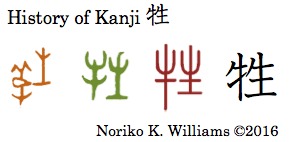 For the kanji 牲, the left side of (a) in oracle bone style was a sheep (the horns curved outward usually meant a sheep). On the other hand (b) in bronze ware style and (c) in ten style had a “cow.” In either case, it meant “sacrificial animals.” A cow is a larger animal than a sheep. A live cow made a much appreciated sacrificial offering in a religious rite. The kanji 牲 meant “sacrifice.”
For the kanji 牲, the left side of (a) in oracle bone style was a sheep (the horns curved outward usually meant a sheep). On the other hand (b) in bronze ware style and (c) in ten style had a “cow.” In either case, it meant “sacrificial animals.” A cow is a larger animal than a sheep. A live cow made a much appreciated sacrificial offering in a religious rite. The kanji 牲 meant “sacrifice.”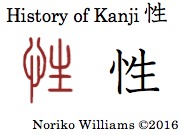 For the kanji 性, In ten style the left side was a bushu risshinben “heart,” and the right side was “life.” Together they meant “a heart that one was born with” or “innate nature.” From that it meant “natural character; gender; sex.” The kun-yomi 性 /sa’ga/ means “one’s nature; destiny.” The on-yomi /se’e/ 性 means “gender; sex,” and is in 性質 (“one’s disposition; character” /seeshitsu/), 性急な (“impatient; hasty” /seekyuu-na/), 異性 (“opposite sex” /i’see/). Another on-yomi /sho’o/ is in 性分 (“temperament” /shoobun/) and 本性 (“true nature” /ho’nshoo/).
For the kanji 性, In ten style the left side was a bushu risshinben “heart,” and the right side was “life.” Together they meant “a heart that one was born with” or “innate nature.” From that it meant “natural character; gender; sex.” The kun-yomi 性 /sa’ga/ means “one’s nature; destiny.” The on-yomi /se’e/ 性 means “gender; sex,” and is in 性質 (“one’s disposition; character” /seeshitsu/), 性急な (“impatient; hasty” /seekyuu-na/), 異性 (“opposite sex” /i’see/). Another on-yomi /sho’o/ is in 性分 (“temperament” /shoobun/) and 本性 (“true nature” /ho’nshoo/).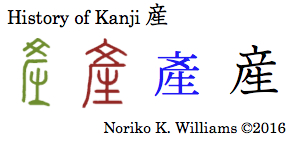 For the kanji 産, in bronze ware style the top (文) signified a pretty pattern. The soft angle on the left (厂) signified a forehead and the bottom (生) was an emerging life. Together they meant a beautiful pattern that was placed on the forehead of a newborn child, or the birth of a beautiful child. It means “to give birth” or “to produce; product.” The shape 文 at the top was kept through the time of kyujitai, in blue, but in shinjitai it changed to 立.
For the kanji 産, in bronze ware style the top (文) signified a pretty pattern. The soft angle on the left (厂) signified a forehead and the bottom (生) was an emerging life. Together they meant a beautiful pattern that was placed on the forehead of a newborn child, or the birth of a beautiful child. It means “to give birth” or “to produce; product.” The shape 文 at the top was kept through the time of kyujitai, in blue, but in shinjitai it changed to 立.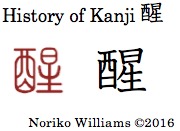 For the kanji 醒 in ten style the left side (酉) was “a cask for fermented liquid, such as rice wine.” The right side had 日 “sun” or something bright and 生, which together made up the kanji 星 “star.”
For the kanji 醒 in ten style the left side (酉) was “a cask for fermented liquid, such as rice wine.” The right side had 日 “sun” or something bright and 生, which together made up the kanji 星 “star.” 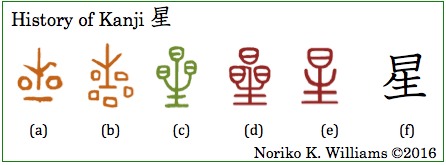 We have looked at the history of the kanji 星 earlier. [
We have looked at the history of the kanji 星 earlier. [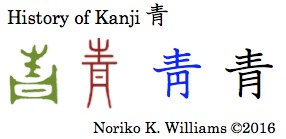 For the kanji 青 in bronze ware style the top was used phonetically to mean “fresh; new.” The bottom was “cinnabar in a well,” which by itself became the kanji 丹 (“cinnabar; red”).
For the kanji 青 in bronze ware style the top was used phonetically to mean “fresh; new.” The bottom was “cinnabar in a well,” which by itself became the kanji 丹 (“cinnabar; red”). 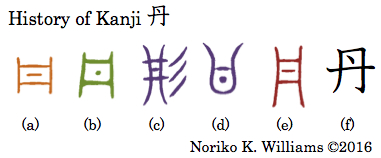 The history of the kanji 丹 is shown on the right. (a) in bronze ware style and (b) in bronze ware style it was a square well to dig up a cinnabar, which was used to make vermillion. In 青 the dot in the middle was interpreted as the reflection of clean water in the well. From that the top 生 and 丹 together (“clean fresh water in a well”) meant “blue; clean; young.” The kyujitai reflected 丹, but in shinjitai it was replaced by 月.
The history of the kanji 丹 is shown on the right. (a) in bronze ware style and (b) in bronze ware style it was a square well to dig up a cinnabar, which was used to make vermillion. In 青 the dot in the middle was interpreted as the reflection of clean water in the well. From that the top 生 and 丹 together (“clean fresh water in a well”) meant “blue; clean; young.” The kyujitai reflected 丹, but in shinjitai it was replaced by 月.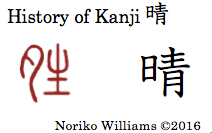 In the writing in Setsumon the left side was “moon” and the right side was used phonetically to mean “clear.” Together they signified a clear sky after a rainfall at night. In kanji the left side became 日 “sun,” and the right side was 青 “clean and clear.” The kanji 晴 means “clear blue sky.”
In the writing in Setsumon the left side was “moon” and the right side was used phonetically to mean “clear.” Together they signified a clear sky after a rainfall at night. In kanji the left side became 日 “sun,” and the right side was 青 “clean and clear.” The kanji 晴 means “clear blue sky.”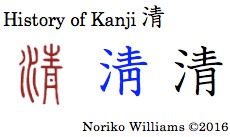 For the kanji 清, in ten style the left side was a bushu sanzui “water,” and the right side was 青 “clear; blue.” Together they meant “pure.” In kyujitai a remnant of 丹 was seen at the bottom right, but it was replaced by 月 in shinjitai.
For the kanji 清, in ten style the left side was a bushu sanzui “water,” and the right side was 青 “clear; blue.” Together they meant “pure.” In kyujitai a remnant of 丹 was seen at the bottom right, but it was replaced by 月 in shinjitai.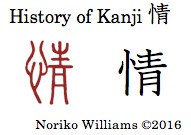 For the kanji 情, In ten style the left side was a bushu risshinben “heart” and the right was 青 “freshness.” Together “what emerged in one’s heart afresh” meant “feeling; emotion.” It also included circumstances that caused an emotion.
For the kanji 情, In ten style the left side was a bushu risshinben “heart” and the right was 青 “freshness.” Together “what emerged in one’s heart afresh” meant “feeling; emotion.” It also included circumstances that caused an emotion. For the kanji 精 in ten style, the left side 米 was rice grain. The right side 青 was used phonetically to mean “to select.” Select good grain gave something “pure; the essence.” The sense of purity was also extended to the state of mind and soul. The kanji 精 meant “pure;the essence; spirit; mind; soul.”
For the kanji 精 in ten style, the left side 米 was rice grain. The right side 青 was used phonetically to mean “to select.” Select good grain gave something “pure; the essence.” The sense of purity was also extended to the state of mind and soul. The kanji 精 meant “pure;the essence; spirit; mind; soul.”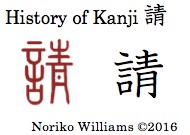 For the kanji 請, the ten style writing consisted of a bushu gonben “word; language” and 青, which was used phonetically to mean “to have an audience with.” Together they originally meant “to request audience; request guidance.” The kanji 請 means “to request; undertake.”
For the kanji 請, the ten style writing consisted of a bushu gonben “word; language” and 青, which was used phonetically to mean “to have an audience with.” Together they originally meant “to request audience; request guidance.” The kanji 請 means “to request; undertake.” For the kanji 竹, the bronze ware style writing was a pictograph of two bamboo stalks with pointed leaves drooping. It meant “bamboo.” The shape was stylized in ten style. A bamboo stalk has many uses for its strength, ease of obtaining materials and ease of crafting.
For the kanji 竹, the bronze ware style writing was a pictograph of two bamboo stalks with pointed leaves drooping. It meant “bamboo.” The shape was stylized in ten style. A bamboo stalk has many uses for its strength, ease of obtaining materials and ease of crafting. For the kanji 笑 in ten style the top was two stalks of bamboo, which became a bushu takekanmuri. The bottom was a person swaying his or her head dancing with happiness and smiling. It meant “to smile.” Shirakawa’s view is the top as originally two hands upward in a trance, just as he views the bushu kusakanmuri in the kanji 若 as coming from two hands of a young woman dancing. On the other hand the Kadokawa dictionary takes the view that the old kanji (口 “mouth” on the left, and 夭 with a bushu kusakanmuri on top instead of a takekanmuri on the right) signified someone’s smiling mouth when the mouth was added to /shoo/.
For the kanji 笑 in ten style the top was two stalks of bamboo, which became a bushu takekanmuri. The bottom was a person swaying his or her head dancing with happiness and smiling. It meant “to smile.” Shirakawa’s view is the top as originally two hands upward in a trance, just as he views the bushu kusakanmuri in the kanji 若 as coming from two hands of a young woman dancing. On the other hand the Kadokawa dictionary takes the view that the old kanji (口 “mouth” on the left, and 夭 with a bushu kusakanmuri on top instead of a takekanmuri on the right) signified someone’s smiling mouth when the mouth was added to /shoo/.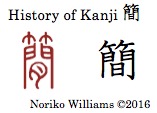 For the kanji 簡 in ten style the bottom “a moon passing through a gap between two doors,” thus “duration; gap; space,” was 閒 (the kyuji for 間) and was used phonetically. (間 was discussed in
For the kanji 簡 in ten style the bottom “a moon passing through a gap between two doors,” thus “duration; gap; space,” was 閒 (the kyuji for 間) and was used phonetically. (間 was discussed in 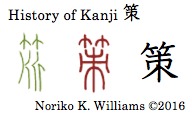 For the kanji 策 in ten style the bottom 朿 was a “thorny long stick” and was used phonetically. With a bamboo on top they originally meant a “horsewhip.” Later it came to be used for 冊 “bound documents,” which came from bamboo or wooden writing tablets bound in a book form. Measures and plans were written on those writing tablets. From that it meant “plan; scheme.”
For the kanji 策 in ten style the bottom 朿 was a “thorny long stick” and was used phonetically. With a bamboo on top they originally meant a “horsewhip.” Later it came to be used for 冊 “bound documents,” which came from bamboo or wooden writing tablets bound in a book form. Measures and plans were written on those writing tablets. From that it meant “plan; scheme.”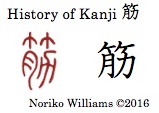 For the kanji 筋 in ten style, the bottom by itself had “flesh” (月/肉) on the left and “muscle of a strong hand” (力) on the right. Together with the meaning “straight” that bamboo provided, they meant “tendon; muscle; fiber; string.” In Japanese it is also used to mean “reason; storyline.”
For the kanji 筋 in ten style, the bottom by itself had “flesh” (月/肉) on the left and “muscle of a strong hand” (力) on the right. Together with the meaning “straight” that bamboo provided, they meant “tendon; muscle; fiber; string.” In Japanese it is also used to mean “reason; storyline.”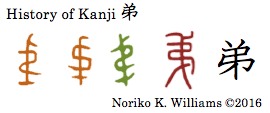 We make a little detour to a kanji that does not have a takekanmuri – 弟. In oracle bone style and bronze ware style, it had a stake around which a leather strap was wrapped. The line at the bottom indicated something at the end. A younger brother was lower in the order of male siblings. It meant “younger brother.”
We make a little detour to a kanji that does not have a takekanmuri – 弟. In oracle bone style and bronze ware style, it had a stake around which a leather strap was wrapped. The line at the bottom indicated something at the end. A younger brother was lower in the order of male siblings. It meant “younger brother.” For the kanji 第 in ten style it was the same as 弟. In kanji a bushu takekanmuri was added to indicate bamboo tablets. Bamboo tablets were bound in a good order with leather straps. From the order of bamboo tablets, it meant “order.”
For the kanji 第 in ten style it was the same as 弟. In kanji a bushu takekanmuri was added to indicate bamboo tablets. Bamboo tablets were bound in a good order with leather straps. From the order of bamboo tablets, it meant “order.”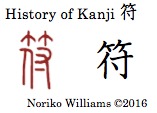 For the kanji符 in ten style the bottom 付 signified “a hand (on the right) giving something to another person” or “to issue.” Bamboo was easy to craft, including making a tally. Tallies were used to seal an agreement and a notched tally could also be a proof. Together they meant “tag; signal; mark.”
For the kanji符 in ten style the bottom 付 signified “a hand (on the right) giving something to another person” or “to issue.” Bamboo was easy to craft, including making a tally. Tallies were used to seal an agreement and a notched tally could also be a proof. Together they meant “tag; signal; mark.”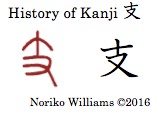 For the kanji 支 in ten style the top was either a bamboo twig or tree twig, and the bottom was a hand. A twig branches out from its limb or trunk, so it gave the meaning “to branch out.” At the same time a hand holding this gave the meaning “to support.” The kanji 支 means “branch; to support.”
For the kanji 支 in ten style the top was either a bamboo twig or tree twig, and the bottom was a hand. A twig branches out from its limb or trunk, so it gave the meaning “to branch out.” At the same time a hand holding this gave the meaning “to support.” The kanji 支 means “branch; to support.”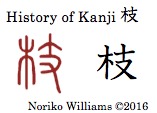 Because the original meaning of “tree branch” for the kanji 支 was used for meanings other than a tree brach, this kanji with a bushu kihen was created to mean “tree branch.”
Because the original meaning of “tree branch” for the kanji 支 was used for meanings other than a tree brach, this kanji with a bushu kihen was created to mean “tree branch.”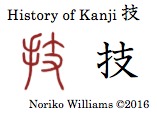 For the kanji 技 in ten style the left side was a bushu tehen “action using a hand.” The right side holding a small twig in hand gave the meaning “skillful hand that does detailed work.” The kanji 技 means “skill.”
For the kanji 技 in ten style the left side was a bushu tehen “action using a hand.” The right side holding a small twig in hand gave the meaning “skillful hand that does detailed work.” The kanji 技 means “skill.”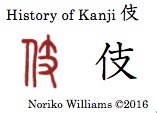 For the kanji, 伎in contrast with the kanji 技 with a tehen, the kanji 伎 had a ninben “person,” and signified a skill or art using one’s body. The kanji 伎 was added to the Joyo kanji list in 2010. Until then the kanji技 with a tehen was substituted. The kanji 伎 means “skills; a person who possess skills.”
For the kanji, 伎in contrast with the kanji 技 with a tehen, the kanji 伎 had a ninben “person,” and signified a skill or art using one’s body. The kanji 伎 was added to the Joyo kanji list in 2010. Until then the kanji技 with a tehen was substituted. The kanji 伎 means “skills; a person who possess skills.”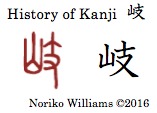 For the kanji 岐 in ten style the left side was a mountain. Together with the right side, they meant “a fork in a mountain; narrow path in a mountain.”
For the kanji 岐 in ten style the left side was a mountain. Together with the right side, they meant “a fork in a mountain; narrow path in a mountain.” For the kanji 米 in oracle bone style, in brown, (a) was a stalk of a rice plant with grains still attached on both sides. (In 稲 bronze ware style had a similar shape inside a mortar.) A layout in which grains are scattered in four corners was seen in oracle bone style, as in (b), through ten style, in red. Setsumon included millet for this kanji. The kanji 米 meant “rice grains.”
For the kanji 米 in oracle bone style, in brown, (a) was a stalk of a rice plant with grains still attached on both sides. (In 稲 bronze ware style had a similar shape inside a mortar.) A layout in which grains are scattered in four corners was seen in oracle bone style, as in (b), through ten style, in red. Setsumon included millet for this kanji. The kanji 米 meant “rice grains.” For the kanji 粉 in ten style, the right side 分 consisted of two hands diving something in two and a knife at the bottom, together signifying “to divide something into small pieces; disperse.” Grinding rice produces powder. The kanji 粉 meant “powder.”
For the kanji 粉 in ten style, the right side 分 consisted of two hands diving something in two and a knife at the bottom, together signifying “to divide something into small pieces; disperse.” Grinding rice produces powder. The kanji 粉 meant “powder.” For the kanji 粗, the right side 且 was used only phonetically for /so/ to mean “rough.” Together with the left side they meant “unpolished rice; brown rice.” From that the kanji 粗 meant “coarse; crude; poor quality.”
For the kanji 粗, the right side 且 was used only phonetically for /so/ to mean “rough.” Together with the left side they meant “unpolished rice; brown rice.” From that the kanji 粗 meant “coarse; crude; poor quality.” For the kanji 粋 in ten style the right side was used phonetically. Together with the left side it meant something “pure.” The kyujitai, in blue, reflected the ten style on the right side but in shinjitai it became the combination of 九 and 十. (I do not have a good explanation for this at the moment.) In Japanese, the kanji 粋 is used as “smartness; chic; refined.”
For the kanji 粋 in ten style the right side was used phonetically. Together with the left side it meant something “pure.” The kyujitai, in blue, reflected the ten style on the right side but in shinjitai it became the combination of 九 and 十. (I do not have a good explanation for this at the moment.) In Japanese, the kanji 粋 is used as “smartness; chic; refined.” For the kanji 類 in ten style the left side had 米 “rice” and 犬 “dog,” and the right side had 頁 “a man with a formal headdress; head.” [For 頁 please refer to the earlier post:
For the kanji 類 in ten style the left side had 米 “rice” and 犬 “dog,” and the right side had 頁 “a man with a formal headdress; head.” [For 頁 please refer to the earlier post: 
 The right side of the kanji 糧 was 量, which we have looked at earlier, as shown on the right. It was a bag that was tied on both ends and had an opening at the top. It signified a scale to weigh a bag of grain. From the original meaning, the kanji 量 means “mass, amount.”
The right side of the kanji 糧 was 量, which we have looked at earlier, as shown on the right. It was a bag that was tied on both ends and had an opening at the top. It signified a scale to weigh a bag of grain. From the original meaning, the kanji 量 means “mass, amount.” For the kanji 粒, in Old style, in purple, it had 立 “a standing person” on the left, used phonetically, and the right side 食was food in a bowl with a cover. In ten style the left side was “rice” and the right side was 立. Together it meant “particle; grain.”
For the kanji 粒, in Old style, in purple, it had 立 “a standing person” on the left, used phonetically, and the right side 食was food in a bowl with a cover. In ten style the left side was “rice” and the right side was 立. Together it meant “particle; grain.” For the kanji 糖, (a) and (b), both in ten style, looked totally dissimilar. In (a) the left was “food,” and the right side 易 was used phonetically for “sugar; candy.” (b) had rice on the left and the right side was used phonetically to mean “to stretch” in making candies out of sweet rice. Whichever the explanation is, the kanji 糖 meant “sugar.”
For the kanji 糖, (a) and (b), both in ten style, looked totally dissimilar. In (a) the left was “food,” and the right side 易 was used phonetically for “sugar; candy.” (b) had rice on the left and the right side was used phonetically to mean “to stretch” in making candies out of sweet rice. Whichever the explanation is, the kanji 糖 meant “sugar.” For the kanji 粘, the left side was 黍 /kibi/ “millet.” Just a few posts ago we looked at this shape as the origin of the kanji 香.
For the kanji 粘, the left side was 黍 /kibi/ “millet.” Just a few posts ago we looked at this shape as the origin of the kanji 香. 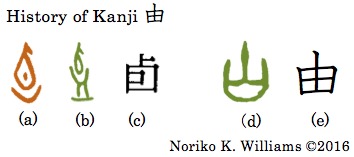 Kanji scholars seem to agree that the precursor of the kanji 由 was (c), shown on the left. (The old kanji (c) is not available on MS Word.) The kanji (c) /yu’u/, (a) in oracle bone style and (b) in bronze ware style had a gourd with a top. Inside an overripe gourd the fruit liquefied and dripped out, and the gourd became empty. It was used as a rice wine container. From “inside contents coming out” it meant “to originate from; cause; reason.”
Kanji scholars seem to agree that the precursor of the kanji 由 was (c), shown on the left. (The old kanji (c) is not available on MS Word.) The kanji (c) /yu’u/, (a) in oracle bone style and (b) in bronze ware style had a gourd with a top. Inside an overripe gourd the fruit liquefied and dripped out, and the gourd became empty. It was used as a rice wine container. From “inside contents coming out” it meant “to originate from; cause; reason.”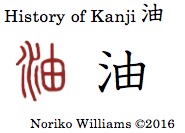 For the kanji 油 the ten style writing had a bushu sanzui “water; liquid” on the left. Liquefied flesh in an overripe gourd was oily. Together they meant “oil.”
For the kanji 油 the ten style writing had a bushu sanzui “water; liquid” on the left. Liquefied flesh in an overripe gourd was oily. Together they meant “oil.” (The kanji 宙 was discussed once earlier in connection with a bushu ukanmuri “house.”) In oracle bone style, in the middle was an empty gourd after its ripe flesh drained out signifying “emptiness.” Over that was a big canopy that covers the land, which is the sky. A large empty space under the sky meant “space; sky.”
(The kanji 宙 was discussed once earlier in connection with a bushu ukanmuri “house.”) In oracle bone style, in the middle was an empty gourd after its ripe flesh drained out signifying “emptiness.” Over that was a big canopy that covers the land, which is the sky. A large empty space under the sky meant “space; sky.”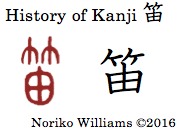 For the kanji 笛 the ten style writing had a takekanmuri “bamboo” above 由. Bamboo is hollow inside like an empty gourd. Holes in the bamboo made it a “flute.”
For the kanji 笛 the ten style writing had a takekanmuri “bamboo” above 由. Bamboo is hollow inside like an empty gourd. Holes in the bamboo made it a “flute.”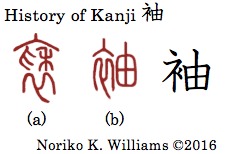 For the kanji 袖 Setsumon gave (a) as the authentic style and (b) as a popular style. In (a) the collar was split into two, the top being the back of the neck and the bottom afront in which two sides meet. No account is given as to what the inside was about in references. In (b) the left side was a collar, which signified “clothes.” Together with 由 they meant the part of clothing from which an arm comes out, which is a “sleeve.” The left side of the ten style writing became the kanji 衣 /koromo/, and when 衣 was placed on the left side it became a bushu koromohen衤.
For the kanji 袖 Setsumon gave (a) as the authentic style and (b) as a popular style. In (a) the collar was split into two, the top being the back of the neck and the bottom afront in which two sides meet. No account is given as to what the inside was about in references. In (b) the left side was a collar, which signified “clothes.” Together with 由 they meant the part of clothing from which an arm comes out, which is a “sleeve.” The left side of the ten style writing became the kanji 衣 /koromo/, and when 衣 was placed on the left side it became a bushu koromohen衤. For the kanji 抽 three writings in ten style were given in Shirakawa (2004). (a) had a “hand” and 由, and it signified “a hand drawing out something.” In (b) the right side was 留 “reservoir,” such as a wine cask. In (c) the right side had a mature rice plant. A hand pulling contents out of a ripe gourd meant “to pull; draw out.”
For the kanji 抽 three writings in ten style were given in Shirakawa (2004). (a) had a “hand” and 由, and it signified “a hand drawing out something.” In (b) the right side was 留 “reservoir,” such as a wine cask. In (c) the right side had a mature rice plant. A hand pulling contents out of a ripe gourd meant “to pull; draw out.”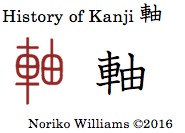 For the kanji 軸 in ten style, the left side was a wheel. Something sticking out connecting wheels was an axle or shaft. The kanji 軸 meant “axle; shaft.” A hanging scroll is stored rolled up, which looks like a stick, and from that it also meant “scroll.”
For the kanji 軸 in ten style, the left side was a wheel. Something sticking out connecting wheels was an axle or shaft. The kanji 軸 meant “axle; shaft.” A hanging scroll is stored rolled up, which looks like a stick, and from that it also meant “scroll.”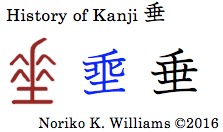 For the kanji 垂 in ten style, in red, the top was leaves or branches hanging down low, which by itself signified “to droop.” The bottom was 土 “ground,” adding the sense that hanging leaves touched the ground. Together they meant “to hang down; dangle; droop.” Something that was hanging down also meant “vertical; at a right angle.” (In kyujitai, in blue, the top was similar to the non-joyo kanji 乖 /ka’i/, as in 乖離 “estrangement; separation.”I suspect that it came from a different origin and just happened to use the shape.)
For the kanji 垂 in ten style, in red, the top was leaves or branches hanging down low, which by itself signified “to droop.” The bottom was 土 “ground,” adding the sense that hanging leaves touched the ground. Together they meant “to hang down; dangle; droop.” Something that was hanging down also meant “vertical; at a right angle.” (In kyujitai, in blue, the top was similar to the non-joyo kanji 乖 /ka’i/, as in 乖離 “estrangement; separation.”I suspect that it came from a different origin and just happened to use the shape.) In ten style of the kanji 郵, 垂 on the left meant “frontier; outlying district” from something that stretched away from the center. The right side had an “area” and a “person,” signifying “village,” which is our familia bushu oozato. A village along the roads leading to an outlying area had a post station where messengers pass through. From that it meant “post; postal service.” (This kanji was in
In ten style of the kanji 郵, 垂 on the left meant “frontier; outlying district” from something that stretched away from the center. The right side had an “area” and a “person,” signifying “village,” which is our familia bushu oozato. A village along the roads leading to an outlying area had a post station where messengers pass through. From that it meant “post; postal service.” (This kanji was in 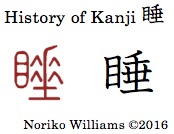 In ten style of the kanji 睡, 目 “eye” was added to 垂 “to droop,” which was also used phonetically for /su’i/. Eyelids drooping meant “to sleep.”
In ten style of the kanji 睡, 目 “eye” was added to 垂 “to droop,” which was also used phonetically for /su’i/. Eyelids drooping meant “to sleep.”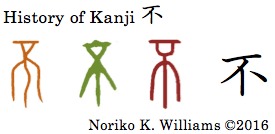 In oracle bone style, in brown, bronze ware style, in green, and ten style, it was a pictograph of a calyx of a flower – the top was an enclosed fruit or seed and the bottom was a leaf-like support, usually green. The shape was borrowed to mean “negation; not ~.” 不 is used as prefix to signify “negation; not.”
In oracle bone style, in brown, bronze ware style, in green, and ten style, it was a pictograph of a calyx of a flower – the top was an enclosed fruit or seed and the bottom was a leaf-like support, usually green. The shape was borrowed to mean “negation; not ~.” 不 is used as prefix to signify “negation; not.”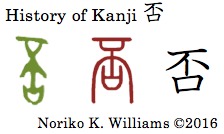 In ten style of the kanji 否, what we see in ten style of 不 had 口 “mouth” or “speaking.” Together they meant “to deny.”
In ten style of the kanji 否, what we see in ten style of 不 had 口 “mouth” or “speaking.” Together they meant “to deny.”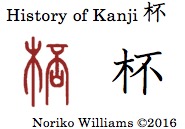 For the kanji 杯 in ten style 木 “tree/wood” was added to 不 “calyx.” Together they signified a calyx-shape wine cup made of wood. From that it meant “wine cup; cupful of.” It is also used as a counter for “cupful.”
For the kanji 杯 in ten style 木 “tree/wood” was added to 不 “calyx.” Together they signified a calyx-shape wine cup made of wood. From that it meant “wine cup; cupful of.” It is also used as a counter for “cupful.”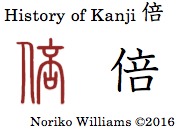 For the kanji 倍 in ten style, a bushu ninben “person” was added to the left. The right side meant a ripe fruit or seed that was about to split. 咅 was used phonetically for /bu/ tmeaning “to divide.” Together they signified two people splitting something. From that it meant “to become doubled; double.” For sample words please see the earlier post. For word samples, please refer to the earlier post.
For the kanji 倍 in ten style, a bushu ninben “person” was added to the left. The right side meant a ripe fruit or seed that was about to split. 咅 was used phonetically for /bu/ tmeaning “to divide.” Together they signified two people splitting something. From that it meant “to become doubled; double.” For sample words please see the earlier post. For word samples, please refer to the earlier post. The kanji 培 had a bushu tsuchihen “soil; dirt’ ground.” A mature calyx swelled and signified something “swelling; bulging.” Together they meant a hilly land or raised ground. When you grow a plant you add soil around it. The kanji 培 means “to cultivate.”
The kanji 培 had a bushu tsuchihen “soil; dirt’ ground.” A mature calyx swelled and signified something “swelling; bulging.” Together they meant a hilly land or raised ground. When you grow a plant you add soil around it. The kanji 培 means “to cultivate.” The kanji 陪 had a bushu kozatohen “pile of dirt.” The right side 咅 was used phonetically.It means “to attend; accompany” in an official capacity. The connection with “officially” is explained in Shirakawa as coming from a kozatohen as a ladder for the god.
The kanji 陪 had a bushu kozatohen “pile of dirt.” The right side 咅 was used phonetically.It means “to attend; accompany” in an official capacity. The connection with “officially” is explained in Shirakawa as coming from a kozatohen as a ladder for the god.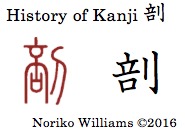 The kanji 剖 had a bushu rittoo “knife” on the right side. On the left the top part of a matured calyx would split. Together they meant “to divide; cut.” There is no kun-yomi. The on-yomi /bo’o/ is in 解剖する (“to dissect” /kaiboo-suru/).
The kanji 剖 had a bushu rittoo “knife” on the right side. On the left the top part of a matured calyx would split. Together they meant “to divide; cut.” There is no kun-yomi. The on-yomi /bo’o/ is in 解剖する (“to dissect” /kaiboo-suru/). If you only look at the kanji 部 and 陪, they look as if the components were just swiched. However, as we already know from the earlier posts, the bushu kosatohen and oozato had entirely different origins. This pair would be a good reminder for us about different origins. For the kanji 部 in ten style the right side was “village.” The left side 咅, meaning “splitting into two,” and the right side “village” meant “a part of a village or other entirety.” The kanji 部 meant “to divide a village into parts.” From that it meant “part; portion” of a whole or “department; section” of a larger organization. For word samples please refer to the earlier post. (
If you only look at the kanji 部 and 陪, they look as if the components were just swiched. However, as we already know from the earlier posts, the bushu kosatohen and oozato had entirely different origins. This pair would be a good reminder for us about different origins. For the kanji 部 in ten style the right side was “village.” The left side 咅, meaning “splitting into two,” and the right side “village” meant “a part of a village or other entirety.” The kanji 部 meant “to divide a village into parts.” From that it meant “part; portion” of a whole or “department; section” of a larger organization. For word samples please refer to the earlier post. (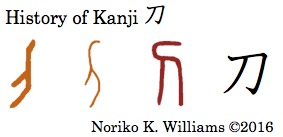 For the kanji 刀, in oracle bone style, in brown, it was a shape of a sword. In ten style the slightly curved handle in oracle bone style was bent backward sharply, and that became the kanji shape 刀. The kanji 刀 meant “sword; knife.”
For the kanji 刀, in oracle bone style, in brown, it was a shape of a sword. In ten style the slightly curved handle in oracle bone style was bent backward sharply, and that became the kanji shape 刀. The kanji 刀 meant “sword; knife.”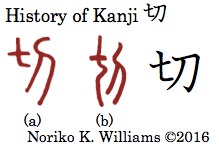 For the kanji 切, in ten style the left side of (b) had a small contour signifying a cut in the middle, and it was used phonetically for /setsu/ to mean “to cut.” The right side 刀 added the meaning of “to cut.” Together they meant “to cut.” When there is nothing left as if it were a cut off, it meant “all.” When one faces a sharp knife one has to be serious, and from that it also meant “precious; earnest.”
For the kanji 切, in ten style the left side of (b) had a small contour signifying a cut in the middle, and it was used phonetically for /setsu/ to mean “to cut.” The right side 刀 added the meaning of “to cut.” Together they meant “to cut.” When there is nothing left as if it were a cut off, it meant “all.” When one faces a sharp knife one has to be serious, and from that it also meant “precious; earnest.”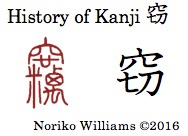 The kanji 窃 means “to steal secretly.” It is not an every-day kanji. When do we see it? It is in more specialized words such as 窃盗犯 (“thief of personal property” /setto’ohan/) and 剽窃 (“plagiarism; piracy” /hyoosetsu/). The latter word has come up quite often as an illegal or dishonest act in scholarly work, art, copying of other people’s work including from the Internet, has come more and more to the attention of people and government. In this regard, I find the ten style writing of the kanji 窃 interesting. The top was a house, signifying a granary, and a hole. The bottom left was “rice,” and the bottom right was small bugs in a lump. The four elements (house; hole; rice; and bugs) worked together like this — inside a rice granary bugs burrowed and ate the grains, leaving empty hull while the owner was not aware of what was happening. From that 窃 meant “to steal away secretly.” What is left for the owner is just empty hulls.
The kanji 窃 means “to steal secretly.” It is not an every-day kanji. When do we see it? It is in more specialized words such as 窃盗犯 (“thief of personal property” /setto’ohan/) and 剽窃 (“plagiarism; piracy” /hyoosetsu/). The latter word has come up quite often as an illegal or dishonest act in scholarly work, art, copying of other people’s work including from the Internet, has come more and more to the attention of people and government. In this regard, I find the ten style writing of the kanji 窃 interesting. The top was a house, signifying a granary, and a hole. The bottom left was “rice,” and the bottom right was small bugs in a lump. The four elements (house; hole; rice; and bugs) worked together like this — inside a rice granary bugs burrowed and ate the grains, leaving empty hull while the owner was not aware of what was happening. From that 窃 meant “to steal away secretly.” What is left for the owner is just empty hulls.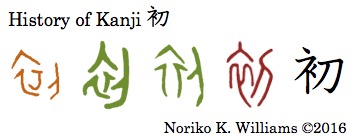 For the kanji 初, in oracle bone style, bronze ware style, in green, and ten style the left side was the shape of a “collar,” its front and back, and the right side was a “knife.” In order to make clothes, fabric has to be cut first. From that the kanji 初 meant “first time; beginning.” In kanji the collar became a bushu koromohen, which looked like a katakana /ne/ with an extra stroke attached. (We will look at a group of kanji that have a koromohen later on.)
For the kanji 初, in oracle bone style, bronze ware style, in green, and ten style the left side was the shape of a “collar,” its front and back, and the right side was a “knife.” In order to make clothes, fabric has to be cut first. From that the kanji 初 meant “first time; beginning.” In kanji the collar became a bushu koromohen, which looked like a katakana /ne/ with an extra stroke attached. (We will look at a group of kanji that have a koromohen later on.)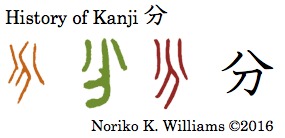 In the kanji 分, in each of the three ancient writing styles a sword or knife was placed in the middle of something that was cut in half (ハ). It meant “to divide; portion.” This kanji included many related meanings. From the meaning of “one’s own portion,” it meant “one’s social status.” Dividing an hour makes “minutes.” When something is explained in a clear-cut manner, it is easy to understand, thus it meant “to understand.”
In the kanji 分, in each of the three ancient writing styles a sword or knife was placed in the middle of something that was cut in half (ハ). It meant “to divide; portion.” This kanji included many related meanings. From the meaning of “one’s own portion,” it meant “one’s social status.” Dividing an hour makes “minutes.” When something is explained in a clear-cut manner, it is easy to understand, thus it meant “to understand.”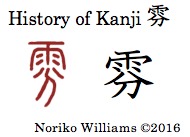 Less than a month ago we looked at the kanji 粉 “flower” in connection with komehen “rice.” 米 and 分 together meant that rice was pulverized into powder. The kanji 雰 had 分 at the bottom of a bushu amekanmuri “rain; atmospheric”. Together pulverized drops of water in the air meant something pervading in the air. From that it meant “atmosphere.” The use of this kanji is limited to 雰囲気 (“atmosphere” /huni’ki/), but the word itself is often used.
Less than a month ago we looked at the kanji 粉 “flower” in connection with komehen “rice.” 米 and 分 together meant that rice was pulverized into powder. The kanji 雰 had 分 at the bottom of a bushu amekanmuri “rain; atmospheric”. Together pulverized drops of water in the air meant something pervading in the air. From that it meant “atmosphere.” The use of this kanji is limited to 雰囲気 (“atmosphere” /huni’ki/), but the word itself is often used.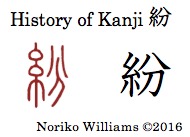 For the kanji 紛 the left side in ten style was a skein of thread. When a skein of threads comes apart, it becomes tangled up. From that the kanji 紛 means “to become confused; become lost.” It also included turmoil.
For the kanji 紛 the left side in ten style was a skein of thread. When a skein of threads comes apart, it becomes tangled up. From that the kanji 紛 means “to become confused; become lost.” It also included turmoil.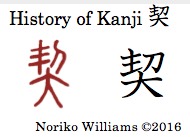 In the ten style writing of the kanji 契, the top left had a vertical line with three short lines intersecting, and the top right had a knife. It signified one making notches on a piece of wood with a knife. This was cut in half as a tally to match later on. The bottom was a “person.” Together people make a pledge or “contract.” The kanji 契 means “contract.”
In the ten style writing of the kanji 契, the top left had a vertical line with three short lines intersecting, and the top right had a knife. It signified one making notches on a piece of wood with a knife. This was cut in half as a tally to match later on. The bottom was a “person.” Together people make a pledge or “contract.” The kanji 契 means “contract.”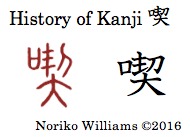 For the kanji 喫, a mouth (口) was added to 契, which was used phonetically to mean “to chew.” Together they meant an act in which one put something in the mouth, such as “to chew; eat; drink; smoke.”
For the kanji 喫, a mouth (口) was added to 契, which was used phonetically to mean “to chew.” Together they meant an act in which one put something in the mouth, such as “to chew; eat; drink; smoke.”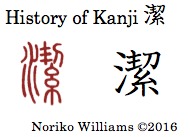 For the kanji 潔, in ten style the left side was “water.” The bottom right had skein of threads, but it was used phonetically for /ke’tsu/ to mean “to purify.” Together they signified “to purify with water.” The meaning of “pure; clean” was also used to describe the manner in which one acted, “brave; graceful; manly.”
For the kanji 潔, in ten style the left side was “water.” The bottom right had skein of threads, but it was used phonetically for /ke’tsu/ to mean “to purify.” Together they signified “to purify with water.” The meaning of “pure; clean” was also used to describe the manner in which one acted, “brave; graceful; manly.”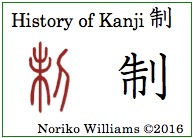 The two shapes 刀 and刂 in kanji had the same shape in ancient writing, and when the last ancient style writing became kanji that 刂 was used. Just a few months ago we had a chance to look at this change in the kanji 制 and 製 in connection with a bushu kihen. [T
The two shapes 刀 and刂 in kanji had the same shape in ancient writing, and when the last ancient style writing became kanji that 刂 was used. Just a few months ago we had a chance to look at this change in the kanji 制 and 製 in connection with a bushu kihen. [T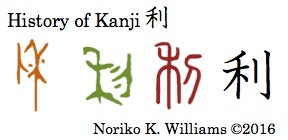 For the kanji 利, in oracle bone style, in brown, the left side was a knife and the right side was a rice plant with crops. The two dots were probably grains of rice. In bronze ware style, in green, the positions of the knife and the rice plant were switched and the grains are still present. A sharp cutting tool was advantageous in harvesting rice or other crops. In kanji the knife on the right became two vertical lines and formed a bushu rittoo. The kanji 利meant “sharp” and “useful; advantageous.”
For the kanji 利, in oracle bone style, in brown, the left side was a knife and the right side was a rice plant with crops. The two dots were probably grains of rice. In bronze ware style, in green, the positions of the knife and the rice plant were switched and the grains are still present. A sharp cutting tool was advantageous in harvesting rice or other crops. In kanji the knife on the right became two vertical lines and formed a bushu rittoo. The kanji 利meant “sharp” and “useful; advantageous.” For the kanji 別, in oracle bone style the right side signified separated bones. Together with a knife on the left, they meant “to separate bones at the joint using a knife.” In ten style, in red, the positions of the two elements got switched. The kanji 別 meant “to separate; another.”
For the kanji 別, in oracle bone style the right side signified separated bones. Together with a knife on the left, they meant “to separate bones at the joint using a knife.” In ten style, in red, the positions of the two elements got switched. The kanji 別 meant “to separate; another.”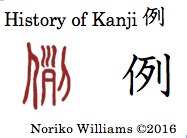 For the kanji 例 In ten style the left side was a “person.” The middle and the right side had a beheaded head with the hair still attached and a sword, which signified “to display an enemy’s beheaded heads in a row as a show of victory after a battle,” as previously discussed. For 例, with “person” (イ) added, it signified “people neatly in line.” From that 例 meant “things in display as a model.” 例 is also used to refer to something previously known to both a speaker and a hearer, “that; usual.”
For the kanji 例 In ten style the left side was a “person.” The middle and the right side had a beheaded head with the hair still attached and a sword, which signified “to display an enemy’s beheaded heads in a row as a show of victory after a battle,” as previously discussed. For 例, with “person” (イ) added, it signified “people neatly in line.” From that 例 meant “things in display as a model.” 例 is also used to refer to something previously known to both a speaker and a hearer, “that; usual.”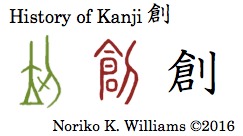 For the kanji 創, the bronze ware style writing had a standing person on the left and a knife on the right. Together they meant “to be wounded; cut.” In ten style the left side was replaced by a different writing 倉 that had the same sound /so’o/. A knife was used to create something new. So, it also meant “to create.”
For the kanji 創, the bronze ware style writing had a standing person on the left and a knife on the right. Together they meant “to be wounded; cut.” In ten style the left side was replaced by a different writing 倉 that had the same sound /so’o/. A knife was used to create something new. So, it also meant “to create.”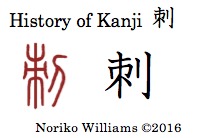 For the kanji 刺, the left side 朿 was “thorny twigs.” With a “knife” on the right side together, they meant “to sting; pierce; stab.”
For the kanji 刺, the left side 朿 was “thorny twigs.” With a “knife” on the right side together, they meant “to sting; pierce; stab.”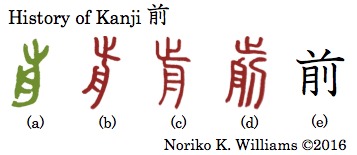 For the kanji 前, In bronze ware style, the top was “a footprint,” and the bottom was a boat. It meant “to move forward.” In the three ten style writings (b) (c) and (d), the footprint looked more like the kanji 止. (d) had a knife on the bottom right that added the meaning “to cut and even up,” possibly toenails — toenails are in front of your body. The kanji 前means “front; before.” It is also used to mean “portion.” In kanji the footprint (止) was simplified to a three stroke shape.
For the kanji 前, In bronze ware style, the top was “a footprint,” and the bottom was a boat. It meant “to move forward.” In the three ten style writings (b) (c) and (d), the footprint looked more like the kanji 止. (d) had a knife on the bottom right that added the meaning “to cut and even up,” possibly toenails — toenails are in front of your body. The kanji 前means “front; before.” It is also used to mean “portion.” In kanji the footprint (止) was simplified to a three stroke shape.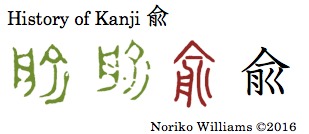 The next five kanji 愉癒輸諭喩 share the same component 兪. 兪 is not a Joyo kanji but we have its ancient style writings shown on the left. Both bronze ware style writings had a boat, or a tray that was placed vertically. A boat and a tray signified “to transport” something to another place. The right side was a surgical needle with a big handle at the top and a knife. In ten style the handle became the top. Together they originally meant “to take a lesion out with a knife; heal.”
The next five kanji 愉癒輸諭喩 share the same component 兪. 兪 is not a Joyo kanji but we have its ancient style writings shown on the left. Both bronze ware style writings had a boat, or a tray that was placed vertically. A boat and a tray signified “to transport” something to another place. The right side was a surgical needle with a big handle at the top and a knife. In ten style the handle became the top. Together they originally meant “to take a lesion out with a knife; heal.”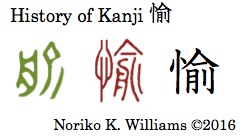 For the kanji 愉, the bronze ware style writing was the same as that of 兪 “to take a lesion out with a knife; recover.” In ten style a heart (忄) was added on the left. Removing the source of concern from the heart meant “pleasure; joy.” In kanji the knife became a bushu rittoo shape.
For the kanji 愉, the bronze ware style writing was the same as that of 兪 “to take a lesion out with a knife; recover.” In ten style a heart (忄) was added on the left. Removing the source of concern from the heart meant “pleasure; joy.” In kanji the knife became a bushu rittoo shape. The ten style writing of the kanji 癒 had a bed (爿), vertically placed for space, on the left and a horizontal line at the top of 兪, which signified a sick person. Together they mean a sick person getting healed from an illness by having lesion removed with a surgical knife. In kanji the bed and the sick person became a bushu yamaidare (疒) “sick; illness,” and a “heart” (心) was added to indicate “feeling better; healing from an illness.” The kanji 癒 meant “cure: heal.”
The ten style writing of the kanji 癒 had a bed (爿), vertically placed for space, on the left and a horizontal line at the top of 兪, which signified a sick person. Together they mean a sick person getting healed from an illness by having lesion removed with a surgical knife. In kanji the bed and the sick person became a bushu yamaidare (疒) “sick; illness,” and a “heart” (心) was added to indicate “feeling better; healing from an illness.” The kanji 癒 meant “cure: heal.”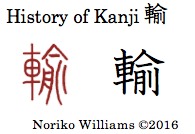 For the kanji 輸, in ten style the left side was a “vehicle” (車). The right side “taking out a lesion” gave the meaning “to take something out to another place.” Together they meant “to move something; transport.”
For the kanji 輸, in ten style the left side was a “vehicle” (車). The right side “taking out a lesion” gave the meaning “to take something out to another place.” Together they meant “to move something; transport.”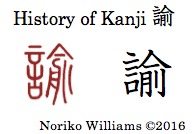 The ten style writing of the kanji 諭 had a bushu gonben “word; to say.” Together with 兪, they meant “to admonish someone for an error; advise,” as if one took the lesion out. The kanji 諭 means “to admonish someone for an error; counsel; discourage.”
The ten style writing of the kanji 諭 had a bushu gonben “word; to say.” Together with 兪, they meant “to admonish someone for an error; advise,” as if one took the lesion out. The kanji 諭 means “to admonish someone for an error; counsel; discourage.”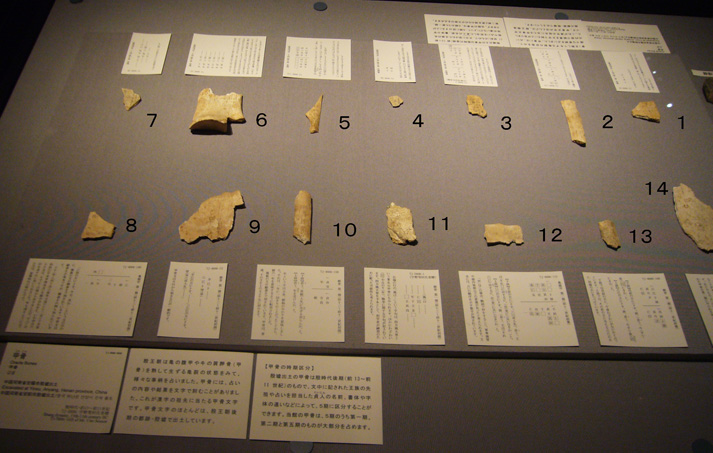
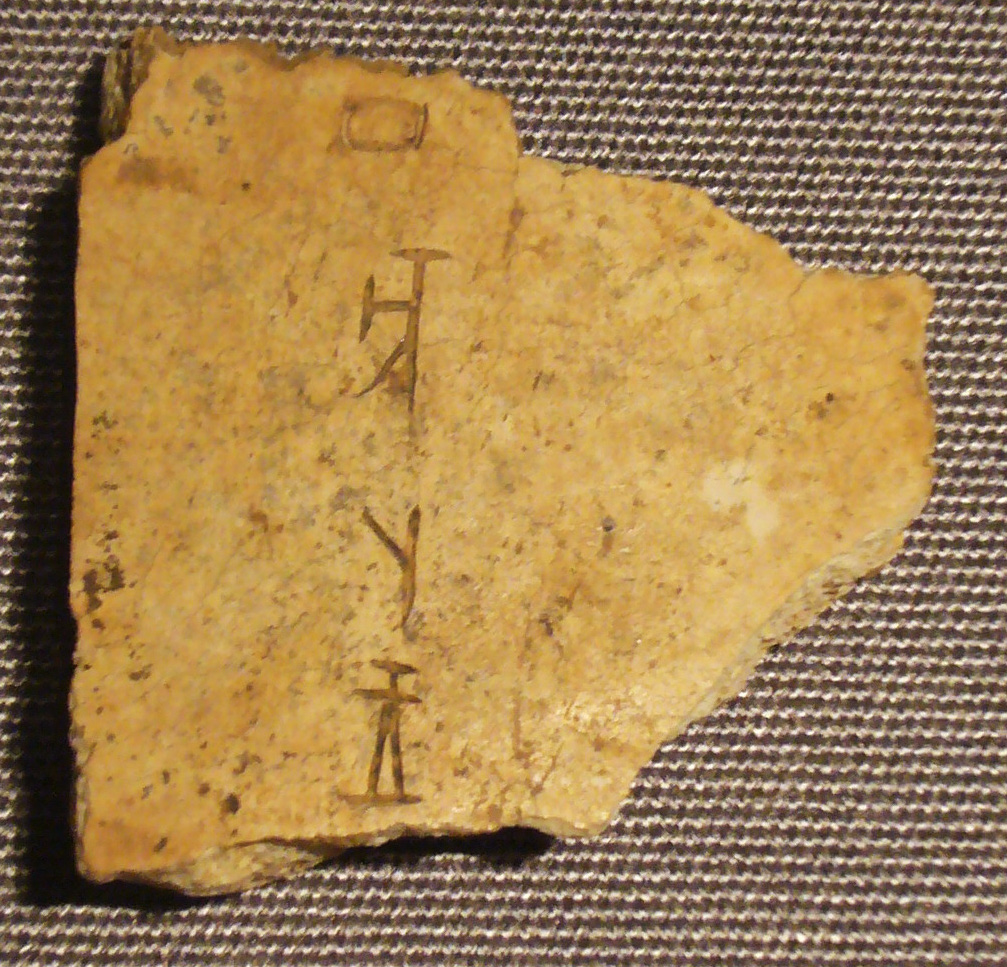
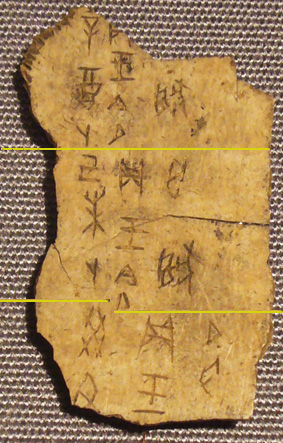
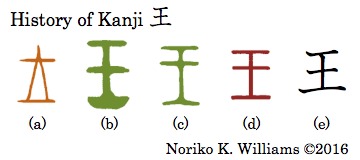 The oracle bone style writing for 王, (a) in brown, was similar to the shape in Photo 1. In bronze ware style writing the bottom line of (b) was thicker and had a curved edge, which was the blade of a king’s ceremonial axe. The second horizontal line was closer to the top line. The same proportion remains in (d) in ten style, in red. In kanji the proportion of the three horizontal lines became even.
The oracle bone style writing for 王, (a) in brown, was similar to the shape in Photo 1. In bronze ware style writing the bottom line of (b) was thicker and had a curved edge, which was the blade of a king’s ceremonial axe. The second horizontal line was closer to the top line. The same proportion remains in (d) in ten style, in red. In kanji the proportion of the three horizontal lines became even.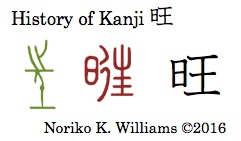
 For the kanji 旺, the bronze ware style writing had a footprint (止) at the top and a standing person with an emphasis on his legs at the bottom, together signifying “to go.” In ten style the crossroad was added, which made up 往 “to go,” as shown on the right, taken from a previous post. The sun (日) for “bright light” was added on the left side. Together light spreading intensely meant “vigorous; thriving.” In kanji, the right side became 王 only.
For the kanji 旺, the bronze ware style writing had a footprint (止) at the top and a standing person with an emphasis on his legs at the bottom, together signifying “to go.” In ten style the crossroad was added, which made up 往 “to go,” as shown on the right, taken from a previous post. The sun (日) for “bright light” was added on the left side. Together light spreading intensely meant “vigorous; thriving.” In kanji, the right side became 王 only. For the kanji 皇, in bronze ware style writing the bottom was 王, and the top was a crown with jewels in the middle. It meant “king; imperial.” In ten sstyle, the crown got separated and took the form 自, which became 白 in kanji. The kanji 皇 means “imperial.”
For the kanji 皇, in bronze ware style writing the bottom was 王, and the top was a crown with jewels in the middle. It meant “king; imperial.” In ten sstyle, the crown got separated and took the form 自, which became 白 in kanji. The kanji 皇 means “imperial.”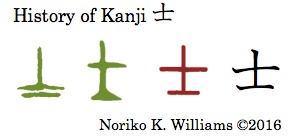 The kanji 士 originated from a smaller axe that was placed with the blade side down. Just like the kanji 王, some bronze ware style samples had a thick bottom to indicate the blade of the weapon. The kanji 士 meant a “warrior; man.”
The kanji 士 originated from a smaller axe that was placed with the blade side down. Just like the kanji 王, some bronze ware style samples had a thick bottom to indicate the blade of the weapon. The kanji 士 meant a “warrior; man.”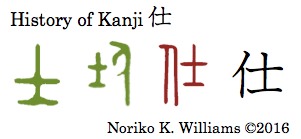 For the kanji 仕, in bronze ware style it was a warrior’s axe, which was the same as 士. In the second bronze ware style writing, a standing person was added on the right side. Together they meant “a person who serves” or “to serve.” In ten style, the two elements were switched, placing the element that was used phonetically on the right side in line with the general rule in kanji. The kanji 仕 means “to serve.” In Japanese it is also used to mean “to do.”
For the kanji 仕, in bronze ware style it was a warrior’s axe, which was the same as 士. In the second bronze ware style writing, a standing person was added on the right side. Together they meant “a person who serves” or “to serve.” In ten style, the two elements were switched, placing the element that was used phonetically on the right side in line with the general rule in kanji. The kanji 仕 means “to serve.” In Japanese it is also used to mean “to do.”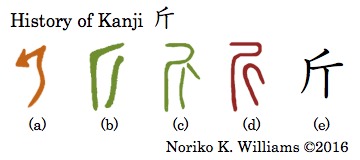 For the kanji 斤, in oracle bone style, (a) in brown, it was an axe with a blade in the right angle to the handle. Unlike the origin of 王 and 士, it was not a weapon but was for cutting and shaping wood. It may be called adze. The word adze is not a familiar word to us, but may be to a craftsman. The writings in bronze ware style, (b) and (c) in green, and ten style, (d) in red, are not very easy for me to visualize, but to the best of my imagination in kanji I see the first two strokes as the blade and the second two as a handle in the right angle. An axe was also used as a weight. The kanji 質, which I hope to discuss later among 貝 “cowry,”had two axes that were used to weigh. Incidentally, the word for an handheld axe is 斧 /o’no/ with 父 on top, which originated a hand holding an axe.
For the kanji 斤, in oracle bone style, (a) in brown, it was an axe with a blade in the right angle to the handle. Unlike the origin of 王 and 士, it was not a weapon but was for cutting and shaping wood. It may be called adze. The word adze is not a familiar word to us, but may be to a craftsman. The writings in bronze ware style, (b) and (c) in green, and ten style, (d) in red, are not very easy for me to visualize, but to the best of my imagination in kanji I see the first two strokes as the blade and the second two as a handle in the right angle. An axe was also used as a weight. The kanji 質, which I hope to discuss later among 貝 “cowry,”had two axes that were used to weigh. Incidentally, the word for an handheld axe is 斧 /o’no/ with 父 on top, which originated a hand holding an axe.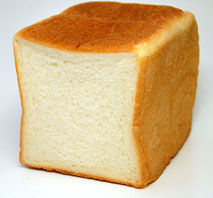
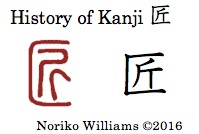 For the kanji 匠, 斤 is inside a box or container 匚. Together they meant “to make a craft work using an axe; design” or a person who made craft work using an axe. It also included someone who excelled in his art.
For the kanji 匠, 斤 is inside a box or container 匚. Together they meant “to make a craft work using an axe; design” or a person who made craft work using an axe. It also included someone who excelled in his art.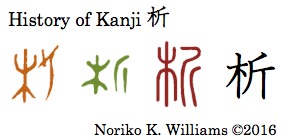 The kanji 析 in oracle bone style had a tree on the left and an axe on the right. Together they signified “to split wood using an axe.” From that it meant “to divide or split something; analyze.”
The kanji 析 in oracle bone style had a tree on the left and an axe on the right. Together they signified “to split wood using an axe.” From that it meant “to divide or split something; analyze.”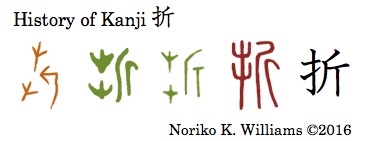 The kanji 折 has a bushu tehen “hand.” Its origin had no relation to a hand. Instead it was miscopied later on. (a) and (b) in oracle bone style had two separate plants that were placed vertically, and an axe was hitting as if it were separating or cutting the plants. They signified plants that were cut short. From that it meant “to break; bend; fold.” This component of “two separate short plants” remained throughout bronze ware style writings, (c) and (d). But in (e) in ten style the two short plants were connected and became a tehen. Setsumon also gave (f) as its ten style. (f) has two separate plants on the left side, which reflected earlier writing. The kanji 折 means “to break; bend; fold.” When a break happens, it creates a new occasion, so it also means “time; occasion.”
The kanji 折 has a bushu tehen “hand.” Its origin had no relation to a hand. Instead it was miscopied later on. (a) and (b) in oracle bone style had two separate plants that were placed vertically, and an axe was hitting as if it were separating or cutting the plants. They signified plants that were cut short. From that it meant “to break; bend; fold.” This component of “two separate short plants” remained throughout bronze ware style writings, (c) and (d). But in (e) in ten style the two short plants were connected and became a tehen. Setsumon also gave (f) as its ten style. (f) has two separate plants on the left side, which reflected earlier writing. The kanji 折 means “to break; bend; fold.” When a break happens, it creates a new occasion, so it also means “time; occasion.” The kanji 逝 has a bushu shinnyoo “to move forward.” 折 was used phonetically for /se’e/. The kanji 逝 meant “to go; pass on; die.”
The kanji 逝 has a bushu shinnyoo “to move forward.” 折 was used phonetically for /se’e/. The kanji 逝 meant “to go; pass on; die.”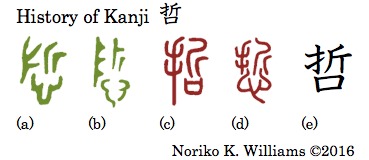 Adding口, a” mouth,” under 折 makes the kanji 哲. For this, it is explained as “decisively talking; to talk clearly,” thus “cleaver; smart.” But when we look at the bronze ware style writings, (a) and (b), we wonder whether there must have been more than speaking, because it had a 心 “heart” at the bottom. Could it be that one reflected deeply in order to see things fall into place as if they were cut decisively? In fact Setsumon also gave (d), which had a heart, rather than a mouth, as an alternative writing. The kani 哲 means “wisdom.”
Adding口, a” mouth,” under 折 makes the kanji 哲. For this, it is explained as “decisively talking; to talk clearly,” thus “cleaver; smart.” But when we look at the bronze ware style writings, (a) and (b), we wonder whether there must have been more than speaking, because it had a 心 “heart” at the bottom. Could it be that one reflected deeply in order to see things fall into place as if they were cut decisively? In fact Setsumon also gave (d), which had a heart, rather than a mouth, as an alternative writing. The kani 哲 means “wisdom.”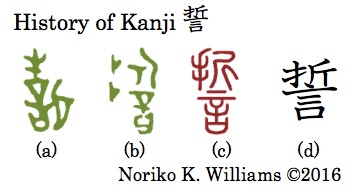 When you add 言 “word” under 折 “to break; bend,” you get the kanji 誓 “to vow; pledge; promise.” 折 was used phonetically for /se’e/. The left side of (a) in bronze ware style was a tattooing needle and a mouth, which was the origin of 言 “word; saying”, and plants at the top. The right side was an axe. (b) contained the same components, in a different arrangement. Together they meant “to vow; pledge; promise.”
When you add 言 “word” under 折 “to break; bend,” you get the kanji 誓 “to vow; pledge; promise.” 折 was used phonetically for /se’e/. The left side of (a) in bronze ware style was a tattooing needle and a mouth, which was the origin of 言 “word; saying”, and plants at the top. The right side was an axe. (b) contained the same components, in a different arrangement. Together they meant “to vow; pledge; promise.”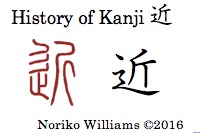 For the kanji 近 in ten style, in red, the left side had a crossroad above a footprint, which together almost always formed a bushu shinnyoo “to go forward” in kanji. The right side, 斤, was used phonetically and meant “little.” Going a small distance signified “close; near.” The kanji 近 meant “near; close; recent.”
For the kanji 近 in ten style, in red, the left side had a crossroad above a footprint, which together almost always formed a bushu shinnyoo “to go forward” in kanji. The right side, 斤, was used phonetically and meant “little.” Going a small distance signified “close; near.” The kanji 近 meant “near; close; recent.”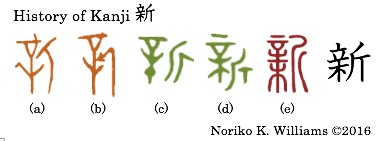 For the kanji 新, (a) and (b) in oracle bone style, in brown, had a tatooing needle with a handle (辛), and an axe (斤) that was used phonetically for /shi’n/. The blade was at a right angle to the handle. In bronze ware style, in green, the needle in (c) had an emphatic dot. In (d) in ten style the left side had a tree (木) added to 辛. Shirakawa says that a tree chosen to be cut down was pierced with a needle in ritual, and that the kanji 新 meant “a tree that was marked with a needle to be cut down with an axe.” From a freshly cut tree, the kanji 新 came to mean “new; recent.”
For the kanji 新, (a) and (b) in oracle bone style, in brown, had a tatooing needle with a handle (辛), and an axe (斤) that was used phonetically for /shi’n/. The blade was at a right angle to the handle. In bronze ware style, in green, the needle in (c) had an emphatic dot. In (d) in ten style the left side had a tree (木) added to 辛. Shirakawa says that a tree chosen to be cut down was pierced with a needle in ritual, and that the kanji 新 meant “a tree that was marked with a needle to be cut down with an axe.” From a freshly cut tree, the kanji 新 came to mean “new; recent.” For the kanji 祈 (a) in oracle bone style was an axe. In (b) the top was an axe, and the bottom was a two-pronged thrusting weapon or shield to protect a soldier. In (c) in bronze ware style, the top was a banner for troops, and the right side was an axe, used phonetically for /ki/. (d) had a footprint at the top, signifying troops advancing. Together they meant praying for good luck in a battle. In (e) in ten style, the left side became an altar table, and it further changed to a bushu shimesuhen ネ “religious matter” in kanji. The kanji 祈 meant “to pray.”
For the kanji 祈 (a) in oracle bone style was an axe. In (b) the top was an axe, and the bottom was a two-pronged thrusting weapon or shield to protect a soldier. In (c) in bronze ware style, the top was a banner for troops, and the right side was an axe, used phonetically for /ki/. (d) had a footprint at the top, signifying troops advancing. Together they meant praying for good luck in a battle. In (e) in ten style, the left side became an altar table, and it further changed to a bushu shimesuhen ネ “religious matter” in kanji. The kanji 祈 meant “to pray.”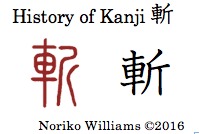 For the kanji 斬 a vehicle on the left side (車) and an axe (斤) on the right side together meant “to cut/hack (materials) with an axe to make a vehicle.”
For the kanji 斬 a vehicle on the left side (車) and an axe (斤) on the right side together meant “to cut/hack (materials) with an axe to make a vehicle.”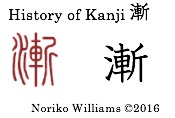 By adding “water” on the left to 斬 “to cut; chop,” which was used phonetically for /ze’n/, we get the kanji 漸. 漸 was the name of a river. The kanji 漸 meant “gradual movement,” like water seeping through over time.
By adding “water” on the left to 斬 “to cut; chop,” which was used phonetically for /ze’n/, we get the kanji 漸. 漸 was the name of a river. The kanji 漸 meant “gradual movement,” like water seeping through over time.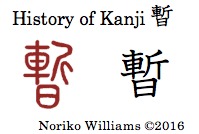 By adding 日 “sun” to the kanji 斬 for phonetic use, we get the kanji 暫. The kanji 暫 meant “short period of time.”
By adding 日 “sun” to the kanji 斬 for phonetic use, we get the kanji 暫. The kanji 暫 meant “short period of time.”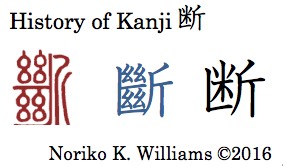 For the kanji 断, in ten style the left side had four skeins of threads cut short that were placed on shelves. The right side was an axe. Together they signified “to cut off; severe” or “drastic action.” The kyujitai, in blue, reflected the ten style writing. Just think of writing this kanji in kyujitai. A lot of strokes in a small space. The shinjitai replaced to 米 to reduce stokes. The kanji 断 means “to cut off; stop; decline; drastic action.
For the kanji 断, in ten style the left side had four skeins of threads cut short that were placed on shelves. The right side was an axe. Together they signified “to cut off; severe” or “drastic action.” The kyujitai, in blue, reflected the ten style writing. Just think of writing this kanji in kyujitai. A lot of strokes in a small space. The shinjitai replaced to 米 to reduce stokes. The kanji 断 means “to cut off; stop; decline; drastic action. The kanji 斥 appears to share the same shape with the kanji斤, except that it has an extra stroke. But the ten style writing tells us a totally different story – It had 广 “house” and 屰 ”reverse” (as found in the kanji 逆 “reverse; wrong way”). Together they meant “to send away; refuse; defeat.”
The kanji 斥 appears to share the same shape with the kanji斤, except that it has an extra stroke. But the ten style writing tells us a totally different story – It had 广 “house” and 屰 ”reverse” (as found in the kanji 逆 “reverse; wrong way”). Together they meant “to send away; refuse; defeat.”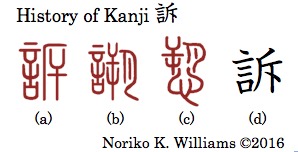 For the kanji 訴 we have three ten style writings. (c) was 愬 ( a heart that repels屰). The kanji 訴 meant “to sue; appeal; take an legal action.”
For the kanji 訴 we have three ten style writings. (c) was 愬 ( a heart that repels屰). The kanji 訴 meant “to sue; appeal; take an legal action.”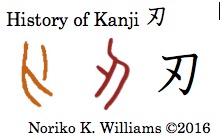 For the kanji 刃, in oracle bone style a knife had a short line pointing out its blade. In ten style, the point was still there. The kanji 刃 meant “blade.”
For the kanji 刃, in oracle bone style a knife had a short line pointing out its blade. In ten style, the point was still there. The kanji 刃 meant “blade.”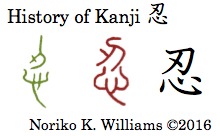 For the kanji 忍in bronze ware style the top was a sharp blade of a knife, and the bottom was a heart. This combination remained through ten style and kanji. A person’s heart on a sharp knife signified a heart that was strong and tenacious, thus it meant “patience.” The kanji 忍 meant “patience.”
For the kanji 忍in bronze ware style the top was a sharp blade of a knife, and the bottom was a heart. This combination remained through ten style and kanji. A person’s heart on a sharp knife signified a heart that was strong and tenacious, thus it meant “patience.” The kanji 忍 meant “patience.”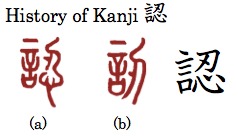 for the kanji 認 two ten style writings had a bushu gonben “word; language.” The right side of (a) had a blade and a heart signifying a tenacious heart, whereas (b) dropped the heart. Together they meant listening patiently to what another person has to say and accepting it. The kanji 認 meant “to accept” or “to recognize.”
for the kanji 認 two ten style writings had a bushu gonben “word; language.” The right side of (a) had a blade and a heart signifying a tenacious heart, whereas (b) dropped the heart. Together they meant listening patiently to what another person has to say and accepting it. The kanji 認 meant “to accept” or “to recognize.”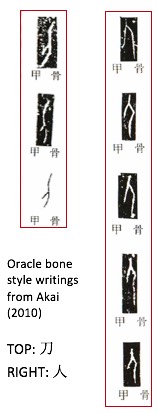 In searching for clues about what kanji originated from, the oldest style, oracle bone style, is most important. Carving lines on a small piece of bone could create some ambiguous shapes. The shape for “person” (人) and “knife; sword” (刀) is in that category. To show you how difficult it is to interpret the two-stroke shapes for 人 and 刀, I scanned the pages in Akai (2010), as shown on the right. When it was used as a component in some kanji a longer line became shortened, and became even more ambiguous. Later style writing also has a similar problem. For instance, for the top of the two kanji 色 “color; amorous” and 絶 “to cease to exist; extreme” some scholars say that it is “person” and others say “knife.” The kanji 到 “to reach” had “person” on the right instead of “knife” in bronze ware style.
In searching for clues about what kanji originated from, the oldest style, oracle bone style, is most important. Carving lines on a small piece of bone could create some ambiguous shapes. The shape for “person” (人) and “knife; sword” (刀) is in that category. To show you how difficult it is to interpret the two-stroke shapes for 人 and 刀, I scanned the pages in Akai (2010), as shown on the right. When it was used as a component in some kanji a longer line became shortened, and became even more ambiguous. Later style writing also has a similar problem. For instance, for the top of the two kanji 色 “color; amorous” and 絶 “to cease to exist; extreme” some scholars say that it is “person” and others say “knife.” The kanji 到 “to reach” had “person” on the right instead of “knife” in bronze ware style. There are two different views on how the top of 召 in oracle bone style came about. One view takes the top of 召as a knife, and explains that 刀 /to’o/ was used phonetically for /sho’o/ to mean “to call for.” With the bottom 口 “mouth” signifying “to speak” together they meant “to call; summon; send for.” Another view takes it as a “person,” and explains it as “a person (top) speaking (口) to send for someone.” Shirakawa (2004) took the latter view further. In his view the bottom was not a “mouth,” which is a prevalent view among kanji scholars, but a prayer vessel. So in this case, the top of oracle bone style writing signified a divine spirit descending in answer to a prayer. From calling for a divine spirit in prayer, it originally meant “to call for; summon.”
There are two different views on how the top of 召 in oracle bone style came about. One view takes the top of 召as a knife, and explains that 刀 /to’o/ was used phonetically for /sho’o/ to mean “to call for.” With the bottom 口 “mouth” signifying “to speak” together they meant “to call; summon; send for.” Another view takes it as a “person,” and explains it as “a person (top) speaking (口) to send for someone.” Shirakawa (2004) took the latter view further. In his view the bottom was not a “mouth,” which is a prevalent view among kanji scholars, but a prayer vessel. So in this case, the top of oracle bone style writing signified a divine spirit descending in answer to a prayer. From calling for a divine spirit in prayer, it originally meant “to call for; summon.” In ten style the left side was 扌, a bushu tehen “an act that uses a hand.” The right side 召 was used phonetically for /shoo/. A tehen added a beckoning hand. Beckoning someone by hand meant “to invite.”
In ten style the left side was 扌, a bushu tehen “an act that uses a hand.” The right side 召 was used phonetically for /shoo/. A tehen added a beckoning hand. Beckoning someone by hand meant “to invite.”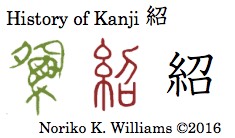 The bronze ware style writing, in green, is hard to make out. Setsumon explained that 紹 meant “to connect.” It also said it was to twist strings or ropes together. With that explanation in mind, I wonder if the middle of the bronze ware style writing was a skein of threads with the ends of three threads or ropes sticking out at the bottom. In ten style, the left side 糸 “thread” (with three loose ends of a skein at the bottom) was placed on the left, and the right side was the kanji 召 for /sho’o/. Together they meant “to connect people; introduce.”
The bronze ware style writing, in green, is hard to make out. Setsumon explained that 紹 meant “to connect.” It also said it was to twist strings or ropes together. With that explanation in mind, I wonder if the middle of the bronze ware style writing was a skein of threads with the ends of three threads or ropes sticking out at the bottom. In ten style, the left side 糸 “thread” (with three loose ends of a skein at the bottom) was placed on the left, and the right side was the kanji 召 for /sho’o/. Together they meant “to connect people; introduce.”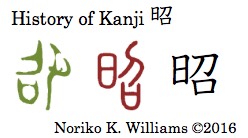 In bronze ware style 召 was used phonetically for /shoo/ to mean “bright” on the left, and on the right was 卩“person.” In ten style 日 “sun” replaced a “person.” The kanji 昭 meant “bright.”
In bronze ware style 召 was used phonetically for /shoo/ to mean “bright” on the left, and on the right was 卩“person.” In ten style 日 “sun” replaced a “person.” The kanji 昭 meant “bright.” In ten style, the left side had 日 “sun” and 火 “fire,” both signifying “bright light.” The right side 召 was used phonetically for /sho’o/. Together they meant “to shine brightly.” In kanji, 火 was moved to the bottom and became another shape for “fire” that was used at the bottom 灬, a bushu renga. The kanji 照 meant “to shine; illuminate.”
In ten style, the left side had 日 “sun” and 火 “fire,” both signifying “bright light.” The right side 召 was used phonetically for /sho’o/. Together they meant “to shine brightly.” In kanji, 火 was moved to the bottom and became another shape for “fire” that was used at the bottom 灬, a bushu renga. The kanji 照 meant “to shine; illuminate.”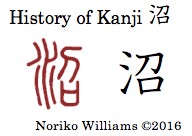 In ten style, the left side was a stream of water, which will become a bushu sanzui “water.” The right side 召 was used only phonetically for 少 “little.” Together from “a little water pool” the kanji 沼 meant “marsh.”
In ten style, the left side was a stream of water, which will become a bushu sanzui “water.” The right side 召 was used only phonetically for 少 “little.” Together from “a little water pool” the kanji 沼 meant “marsh.”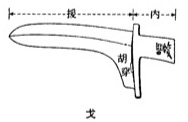
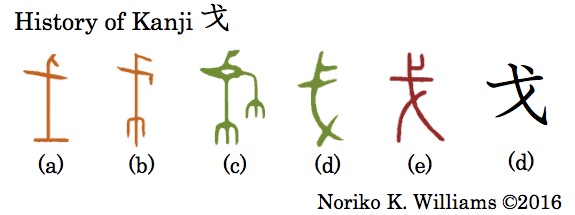 The kanji 戈 is not Joyo kanji, but it has a long important history in the history of kanji. 戈 is read as /ho’ko/ (and its on-yomi is /ka/), which is translated as “halberd” in English. A halberd is a weapon that has two functions, thrusting and cutting. In the history of oracle bone style, (a) and (b) in brown, we see a long vertical line with a short line crossing near the top. According to Shirakawa Setsumon explained that the short line was a flat blade that was shown sideways. The picture of 戈 on the right is taken from Shirakawa (2004). (I am writing with some trepidation because having been raised and educated in an extremely pacifist atmosphere of Post-war Japan, knowledge of weapons never came to me.) My simple understanding from this is that 戈 came from a spear which had a flat-blade axe attached to it on the side.
The kanji 戈 is not Joyo kanji, but it has a long important history in the history of kanji. 戈 is read as /ho’ko/ (and its on-yomi is /ka/), which is translated as “halberd” in English. A halberd is a weapon that has two functions, thrusting and cutting. In the history of oracle bone style, (a) and (b) in brown, we see a long vertical line with a short line crossing near the top. According to Shirakawa Setsumon explained that the short line was a flat blade that was shown sideways. The picture of 戈 on the right is taken from Shirakawa (2004). (I am writing with some trepidation because having been raised and educated in an extremely pacifist atmosphere of Post-war Japan, knowledge of weapons never came to me.) My simple understanding from this is that 戈 came from a spear which had a flat-blade axe attached to it on the side.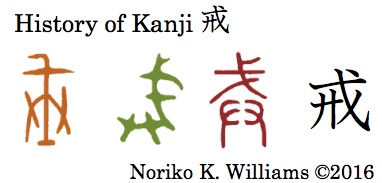 The oracle bone style writing for the kanji 戒 had a halberd standing straight up in the center and a hand on each side. They meant raising a halberd with both hands “to guard against; keep a look out for.” In the bronze ware writing, in green, a halberd was raised by two hands and pushed to the right. In seal style, in red, the halberd was placed on top of the two hands. In kanji two hands holding up the halberd became the shape 廾. The kanji 戒 meant “to admonish; guard against.”
The oracle bone style writing for the kanji 戒 had a halberd standing straight up in the center and a hand on each side. They meant raising a halberd with both hands “to guard against; keep a look out for.” In the bronze ware writing, in green, a halberd was raised by two hands and pushed to the right. In seal style, in red, the halberd was placed on top of the two hands. In kanji two hands holding up the halberd became the shape 廾. The kanji 戒 meant “to admonish; guard against.”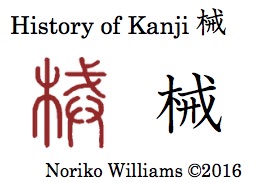 The seal style writing had 木 “tree; wood” on the left side. The top of the right side 戒 was used phonetically for /ka’i/, and meant “to admonish.” Together they meant a wooden gadget that shackled a criminal’s hands. The meaning of handcuffs dropped, and it was used to mean something mechanical. The kanji 械 meant “gadget; machine” in general.
The seal style writing had 木 “tree; wood” on the left side. The top of the right side 戒 was used phonetically for /ka’i/, and meant “to admonish.” Together they meant a wooden gadget that shackled a criminal’s hands. The meaning of handcuffs dropped, and it was used to mean something mechanical. The kanji 械 meant “gadget; machine” in general. For the kanji 成 in oracle bone style and bronze ware style it had an axe attached to a halberd. The short line below that was a decoration to mark the completion of making a new halberd. Thus, it meant “to complete.” In seal style the inside was the shape of a nail, which may have signified “pounding,” and in kanji it became a hooked shape.The kanji 成 meant “to complete; accomplish; comprise.”
For the kanji 成 in oracle bone style and bronze ware style it had an axe attached to a halberd. The short line below that was a decoration to mark the completion of making a new halberd. Thus, it meant “to complete.” In seal style the inside was the shape of a nail, which may have signified “pounding,” and in kanji it became a hooked shape.The kanji 成 meant “to complete; accomplish; comprise.”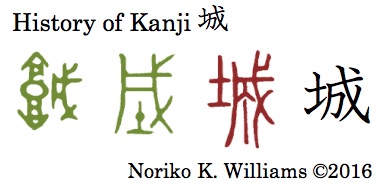 For the kanji 城, we have two very different bronze ware style writings. The left one had a tall tower on the left and a halberd on the right. The second one had the soil (土) underneath a halberd. A tall structure or fortress on the ground that had weapons to protect it meant “castle; fortress.” In seal style, the soil moved to the left and became a bushu tsuchihen “soil; ground.” The right side had a halberd and something to pound (丁). The kanji 城 “castle” is comprised of a bushu tsuchihen and the kanji 成.
For the kanji 城, we have two very different bronze ware style writings. The left one had a tall tower on the left and a halberd on the right. The second one had the soil (土) underneath a halberd. A tall structure or fortress on the ground that had weapons to protect it meant “castle; fortress.” In seal style, the soil moved to the left and became a bushu tsuchihen “soil; ground.” The right side had a halberd and something to pound (丁). The kanji 城 “castle” is comprised of a bushu tsuchihen and the kanji 成.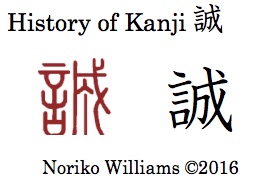 The seal style writing for 誠 had 言, a bushu gonben “word; language,” on the left. The right side 成 gave the sound /se’e/ to mean “to complete; become.” From the meaning of “one’s words becomes one’s deeds,” the kanji 誠 meant “sincerity, loyalty.”
The seal style writing for 誠 had 言, a bushu gonben “word; language,” on the left. The right side 成 gave the sound /se’e/ to mean “to complete; become.” From the meaning of “one’s words becomes one’s deeds,” the kanji 誠 meant “sincerity, loyalty.”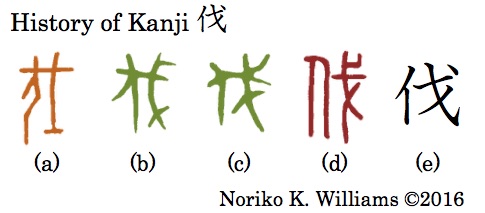 When I first realized that the writings in oracle bone style and bronze ware style for the kanji 伐 were all a scene in which a halberd was crossing a person’s neck, I felt a little uneasy. This was no longer just a threat, but cutting someone’s head off! Fortunately, the gruesome meaning was dropped, and in seal style a person (イ) was detached from a halberd. The kanji 伐 meant “to cut down; attack.”
When I first realized that the writings in oracle bone style and bronze ware style for the kanji 伐 were all a scene in which a halberd was crossing a person’s neck, I felt a little uneasy. This was no longer just a threat, but cutting someone’s head off! Fortunately, the gruesome meaning was dropped, and in seal style a person (イ) was detached from a halberd. The kanji 伐 meant “to cut down; attack.”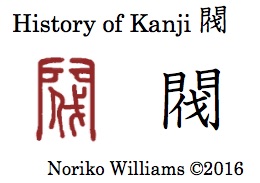 The seal style of 閥 had 門 “two closed doors” and 伐 inside, which was used phonetically for /ba’tsu/ to mean “commendation; honoring.” Together they signified a house or family which received commendation, and from that it meant a group of people who band together exclusively. The kanji 閥 meant “clique; faction.”
The seal style of 閥 had 門 “two closed doors” and 伐 inside, which was used phonetically for /ba’tsu/ to mean “commendation; honoring.” Together they signified a house or family which received commendation, and from that it meant a group of people who band together exclusively. The kanji 閥 meant “clique; faction.”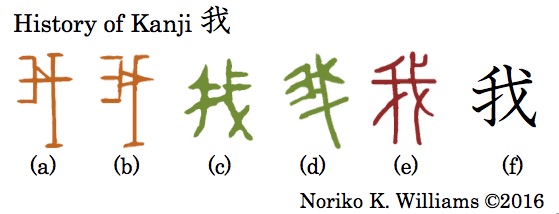 Here is another type of halberd. For the kanji 我, in bronze ware style the left side of a halberd had a three prong-like shape. It has been explained as a saw-like blade attached to a halberd or a saw. The origin of the kanji 義, which contains 我 at the bottom, was given as proof that a saw that was used to cut a sacrificial sheep [Shirakawa]. It was borrowed to mean “I, me; oneself” in oracle bone style time, and has no relevance to the origin being a halberd.
Here is another type of halberd. For the kanji 我, in bronze ware style the left side of a halberd had a three prong-like shape. It has been explained as a saw-like blade attached to a halberd or a saw. The origin of the kanji 義, which contains 我 at the bottom, was given as proof that a saw that was used to cut a sacrificial sheep [Shirakawa]. It was borrowed to mean “I, me; oneself” in oracle bone style time, and has no relevance to the origin being a halberd.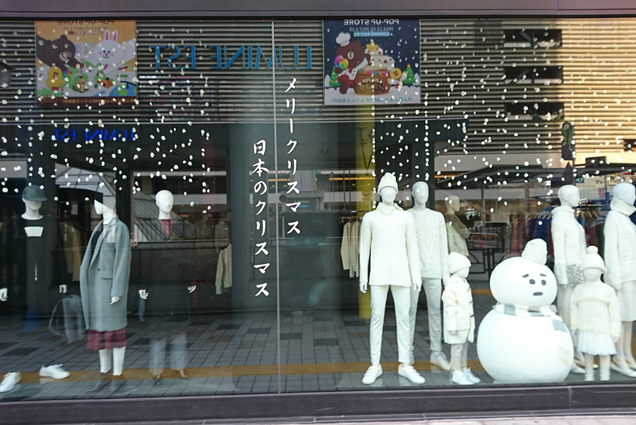
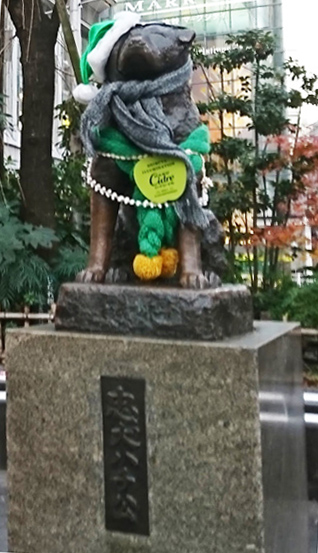
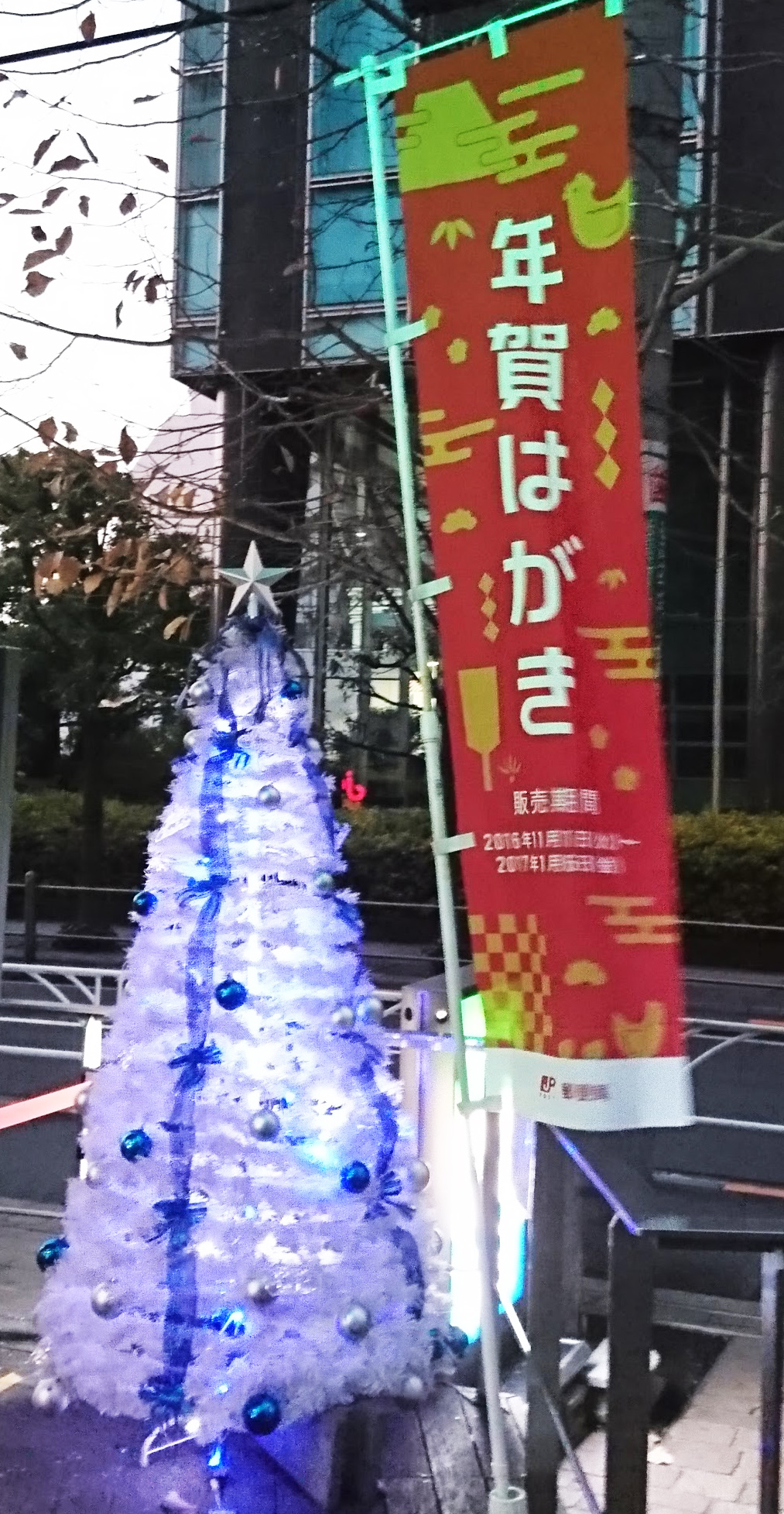
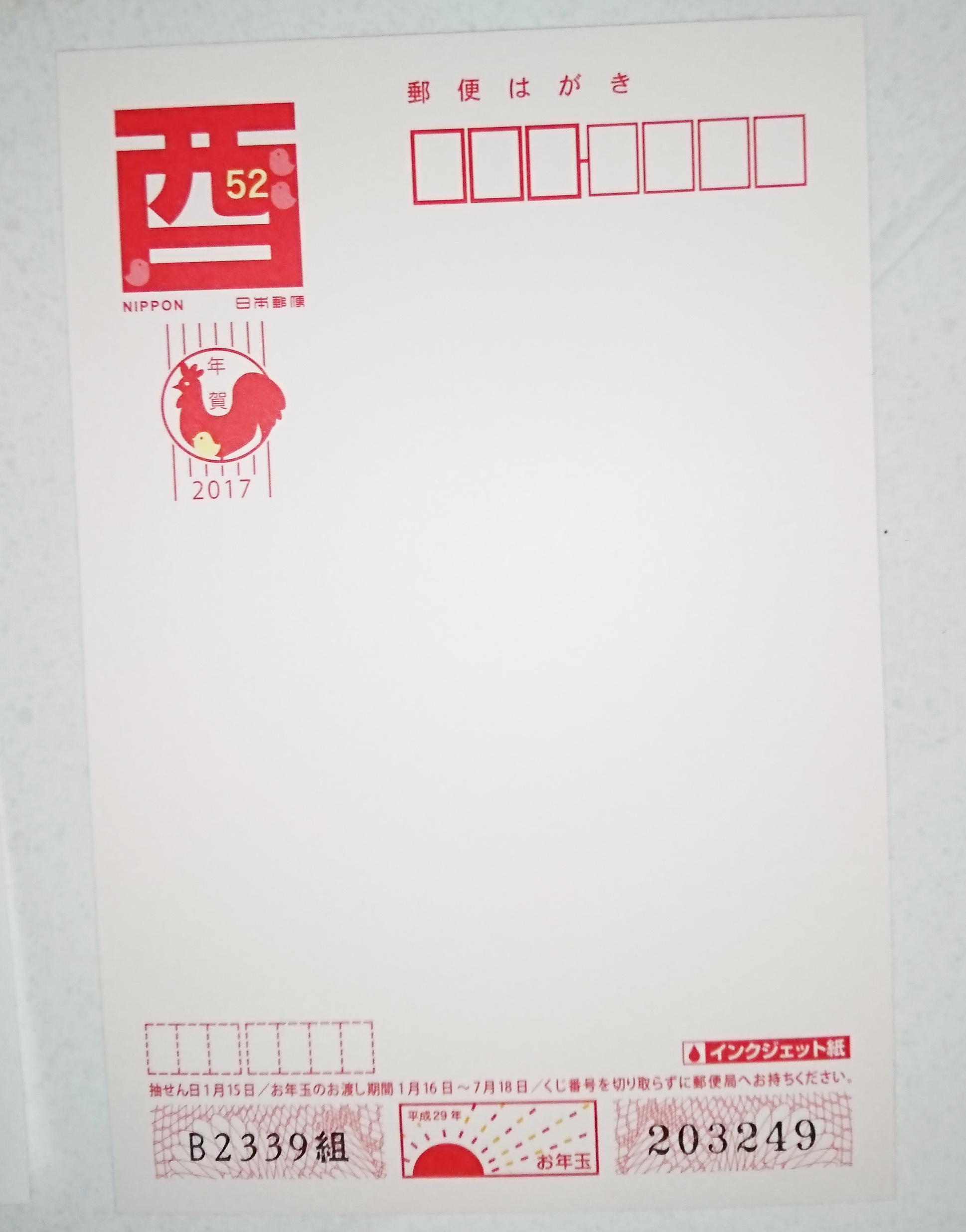

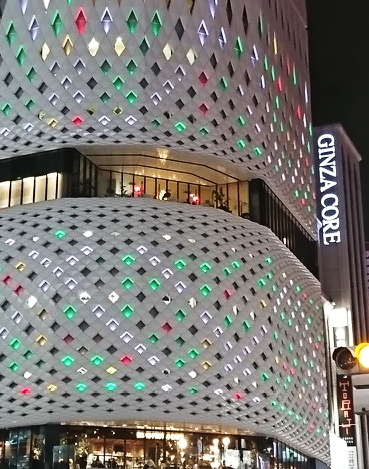
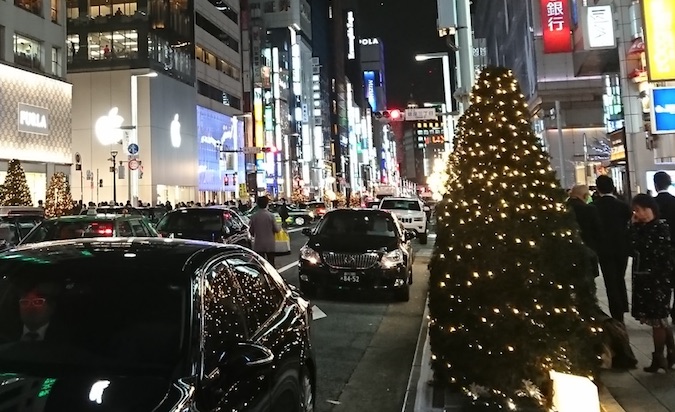

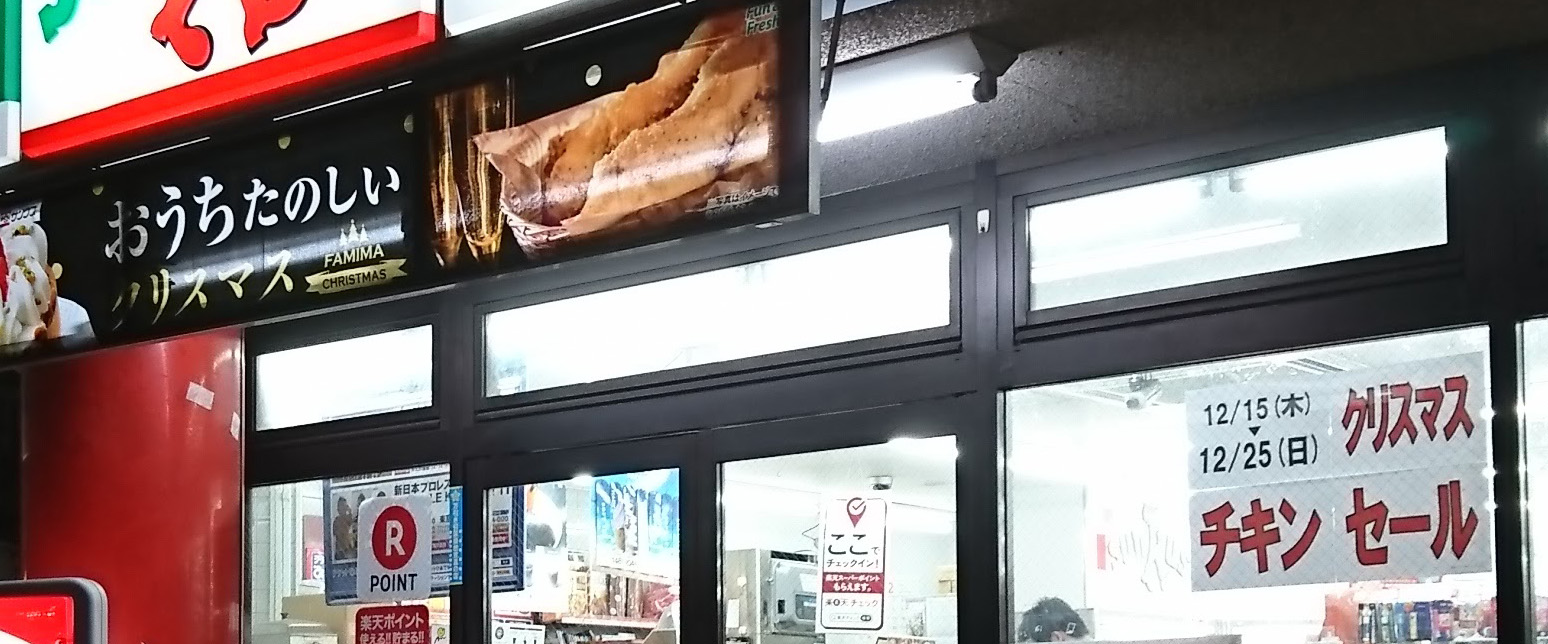

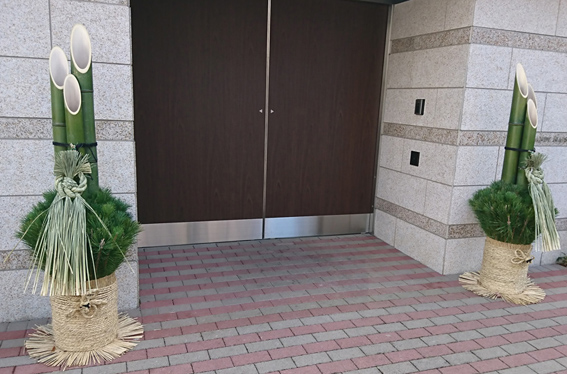
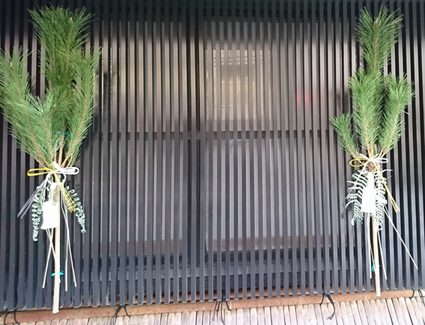
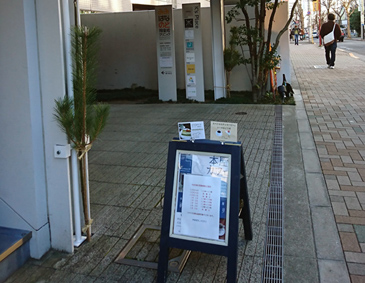
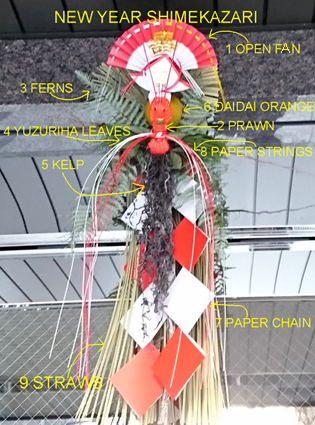
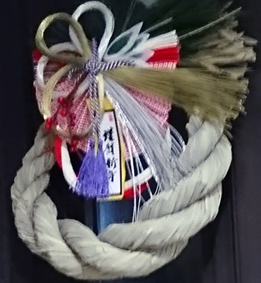
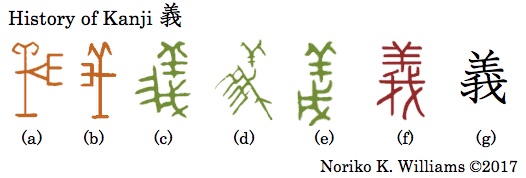 For the kanji 義 (a) and (b) in oracle bone style, in brown, were very similar to (a) and (b) for the kanji 我, except one point – The top of the vertical line had sheep’s curled horns. In bronze ware style, in green, the sheep got separated from the bottom. The bottom of 12 writings had three or more prongs on the left, as in (c) and (d). Only two of them had the shape without prongs, as in (e), and that was an axe. Since the overwhelming number had a prong shape, we can comfortably conclude that the bottom of the kanji 義 was a saw-like object or a saw. 羊 “sheep” and 我 “saw” together meant cutting a sacrificial sheep with a saw to prepare for an offering to a god. What is suitable for a god meant “morality; just.” Explaining “what is just” also gave the meaning “significance; meaning.” So the kanji 義 meant “just; morality; significance; meaning.”
For the kanji 義 (a) and (b) in oracle bone style, in brown, were very similar to (a) and (b) for the kanji 我, except one point – The top of the vertical line had sheep’s curled horns. In bronze ware style, in green, the sheep got separated from the bottom. The bottom of 12 writings had three or more prongs on the left, as in (c) and (d). Only two of them had the shape without prongs, as in (e), and that was an axe. Since the overwhelming number had a prong shape, we can comfortably conclude that the bottom of the kanji 義 was a saw-like object or a saw. 羊 “sheep” and 我 “saw” together meant cutting a sacrificial sheep with a saw to prepare for an offering to a god. What is suitable for a god meant “morality; just.” Explaining “what is just” also gave the meaning “significance; meaning.” So the kanji 義 meant “just; morality; significance; meaning.”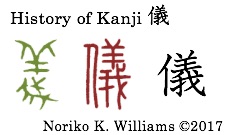 The bronze ware style of the kanji 儀 was the same as (c) and (d) for 義. That suggests that the meanings of 儀 was originally a part of 義. In seal style, in red, イ , a bushu ninben “standing person,” was added to 義 that was used phonetically for /gi/. Together they signified a person’s righteous deed. A right way of doing by a righteous person became the meaning “protocol; ceremony; affair.” The kanji 儀 meant “ceremony; affair; matter.”
The bronze ware style of the kanji 儀 was the same as (c) and (d) for 義. That suggests that the meanings of 儀 was originally a part of 義. In seal style, in red, イ , a bushu ninben “standing person,” was added to 義 that was used phonetically for /gi/. Together they signified a person’s righteous deed. A right way of doing by a righteous person became the meaning “protocol; ceremony; affair.” The kanji 儀 meant “ceremony; affair; matter.”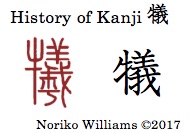 The left side of the seal style writing of the kanji 犠was 牛 “cow,” which sometimes signified animals in general. In kanji the right side is 義, but in seal style the bottom had something else added. What this addition meant is not clear. From the original meaning of 義 “a sheep to be cut with a saw for an offering” and 牛 together meant “sacrificial animal; sacrifice.”
The left side of the seal style writing of the kanji 犠was 牛 “cow,” which sometimes signified animals in general. In kanji the right side is 義, but in seal style the bottom had something else added. What this addition meant is not clear. From the original meaning of 義 “a sheep to be cut with a saw for an offering” and 牛 together meant “sacrificial animal; sacrifice.”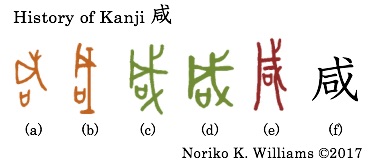 The kanji 咸
The kanji 咸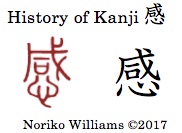 For the kanji 感, the seal style writing had 咸 at the top, which was used phonetically for /kan/ to mean “to contain,” and 心 “heart” at the bottom. Together they signified what was contained inside one’s heart — “to feel; emotion; feeing.”
For the kanji 感, the seal style writing had 咸 at the top, which was used phonetically for /kan/ to mean “to contain,” and 心 “heart” at the bottom. Together they signified what was contained inside one’s heart — “to feel; emotion; feeing.”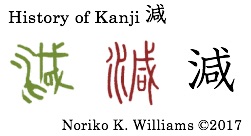 For the kanji 減 the bronze ware style writing had a stream of water on the left, and the right side was a battle-axe and a mouth, signifying “to confine.” Together they meant that closing the mouth of a stream reduced the amount of the flow of water. The kanji 減 meant “to reduce.”
For the kanji 減 the bronze ware style writing had a stream of water on the left, and the right side was a battle-axe and a mouth, signifying “to confine.” Together they meant that closing the mouth of a stream reduced the amount of the flow of water. The kanji 減 meant “to reduce.”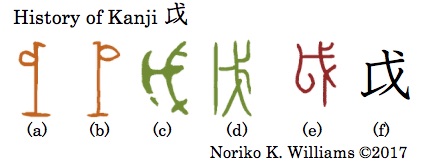 The kanji 戉
The kanji 戉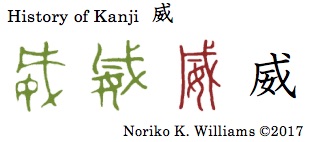 For the kanji 威, the two bronze ware style writings had a broad-blade axe or battle-axe (戉) and a woman (女) underneath. Together a woman under the threat of a weapon signified “to threaten” or “authority.”
For the kanji 威, the two bronze ware style writings had a broad-blade axe or battle-axe (戉) and a woman (女) underneath. Together a woman under the threat of a weapon signified “to threaten” or “authority.”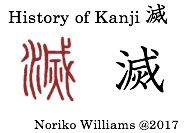 The seal style writing of the kanji 滅 had氵, a bushu sanzui “water.” The right side had a 戉 “broad blade battle-axe” and 火 “fire” inside, and was used phonetically for /betsu/ to mean “to exhaust; run out.” Both sides together signified water running out. From that the kanji 滅 meant “to run out; die away.”
The seal style writing of the kanji 滅 had氵, a bushu sanzui “water.” The right side had a 戉 “broad blade battle-axe” and 火 “fire” inside, and was used phonetically for /betsu/ to mean “to exhaust; run out.” Both sides together signified water running out. From that the kanji 滅 meant “to run out; die away.”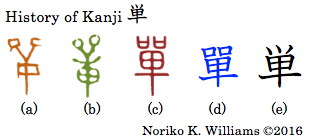 The kanji 単—For the kanji (a) in oracle bone style, in brown, and (b) in bronze ware style, in green, was a shield with a two-pronged spear at the top. It was borrowed to mean “single; only.” The top of (c) in seal style, in red, and kyujitai (d), in blue, was simplified to a truncated katakana ツ shape in shinjitai (e). The kanji 単 meant “single; only.”
The kanji 単—For the kanji (a) in oracle bone style, in brown, and (b) in bronze ware style, in green, was a shield with a two-pronged spear at the top. It was borrowed to mean “single; only.” The top of (c) in seal style, in red, and kyujitai (d), in blue, was simplified to a truncated katakana ツ shape in shinjitai (e). The kanji 単 meant “single; only.”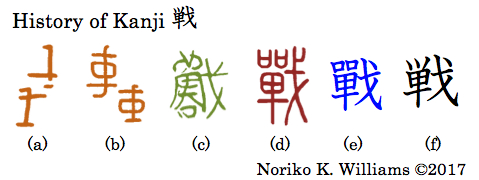 Now the kanji 戦. In oracle bone style (a) was two halberds whereas (b) was two shields. In bronze ware style the left side of (c) was a shield and the right side was a halberd. Together they meant “battle; war; to fight.” The kanji 戦 meant “war; battle; to fight.”
Now the kanji 戦. In oracle bone style (a) was two halberds whereas (b) was two shields. In bronze ware style the left side of (c) was a shield and the right side was a halberd. Together they meant “battle; war; to fight.” The kanji 戦 meant “war; battle; to fight.”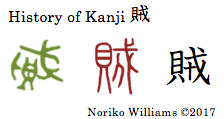 For the kanji 賊, in the bronze ware style writing under a halberd the bottom left was a person standing next to a three-legged bronze vessel. Together someone damaging a bronze vessel with a weapon meant “to damage” and a villain who robbed or damaged with a weapon. In seal style a person was placed under a halberd. The kanji 賊 meant “to damage; steal; robber”
For the kanji 賊, in the bronze ware style writing under a halberd the bottom left was a person standing next to a three-legged bronze vessel. Together someone damaging a bronze vessel with a weapon meant “to damage” and a villain who robbed or damaged with a weapon. In seal style a person was placed under a halberd. The kanji 賊 meant “to damage; steal; robber”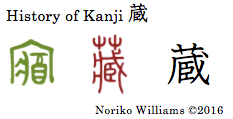 For the kanji 蔵, the bronze ware style writing was a vessel for treasure hidden in a house. 爿on the left of the vessel was used phonetically for /zoo/. In seal style, the top was a bushu kusakanmuri “grass” – adding the sense of hiding in tall grass. The bottom had 爿, and the vessel changed to the watchful eye of retainer’s with a halberd. Together they meant to store something valuable away in a secure place. From that the kanji 蔵 meant “vault; to store away.”
For the kanji 蔵, the bronze ware style writing was a vessel for treasure hidden in a house. 爿on the left of the vessel was used phonetically for /zoo/. In seal style, the top was a bushu kusakanmuri “grass” – adding the sense of hiding in tall grass. The bottom had 爿, and the vessel changed to the watchful eye of retainer’s with a halberd. Together they meant to store something valuable away in a secure place. From that the kanji 蔵 meant “vault; to store away.”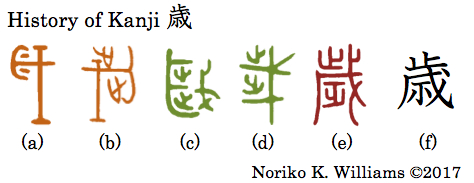
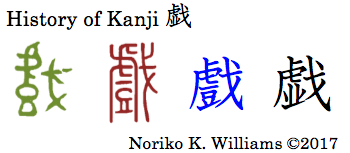 For the kanji 戯, in bronze ware style the left side was a person with a tiger headgear for a play on sitting on a tall stool. It was used phonetically for /ki; gi/. The right side was a halberd. Together they meant someone playing a votive dance before going into battle. Seal style and kyujitai kept all three components 虍 “tiger” and 豆 “tall stool; something tall” on the left and 戈 “halberd” on the right. In shinjitai 虚, a kanji that had no relation with the original meaning, replaced the left side. The kanji 戯 meant “to play; joke.”
For the kanji 戯, in bronze ware style the left side was a person with a tiger headgear for a play on sitting on a tall stool. It was used phonetically for /ki; gi/. The right side was a halberd. Together they meant someone playing a votive dance before going into battle. Seal style and kyujitai kept all three components 虍 “tiger” and 豆 “tall stool; something tall” on the left and 戈 “halberd” on the right. In shinjitai 虚, a kanji that had no relation with the original meaning, replaced the left side. The kanji 戯 meant “to play; joke.”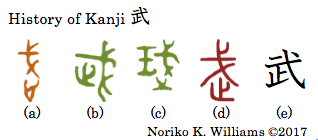 For the kanji 武, the oracle bone style writing (a) had a halberd and a footprint. Advancing with a halberd meant “military; warrior.” In bronze ware style (b) had a footprint under a halberd, and (c) had a king’s axe added. In kanji (e) the stroke that crosses the stick was lost. Instead an additional short line was added at the top. The kanji 武 meant “military; warrior.” The kanji 武 is in contrast with 文 in the sense of “civil; literary.”
For the kanji 武, the oracle bone style writing (a) had a halberd and a footprint. Advancing with a halberd meant “military; warrior.” In bronze ware style (b) had a footprint under a halberd, and (c) had a king’s axe added. In kanji (e) the stroke that crosses the stick was lost. Instead an additional short line was added at the top. The kanji 武 meant “military; warrior.” The kanji 武 is in contrast with 文 in the sense of “civil; literary.”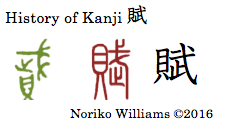 For the kanji 賦, in bronze ware style the top was a halberd and a footprint (together signifying “army advancing”), and the bottom was a cowry, signifying money and valuable things. Together they meant valuable things that were sought by force. From that it meant “to collect levy; impose labor.” A ruler expected to be given a tribute and it meant “tribute.” An interesting point is that it also included the flip side of collecting – “to allocate; distribute.” I find it a little puzzling about having both directions of giving and getting, but this reminds me of the kanji 受 “to receive.” It originally meant both “to receive;” and “to give,” until another kanji 授 was created to mean “to give.” There may be other example like this.
For the kanji 賦, in bronze ware style the top was a halberd and a footprint (together signifying “army advancing”), and the bottom was a cowry, signifying money and valuable things. Together they meant valuable things that were sought by force. From that it meant “to collect levy; impose labor.” A ruler expected to be given a tribute and it meant “tribute.” An interesting point is that it also included the flip side of collecting – “to allocate; distribute.” I find it a little puzzling about having both directions of giving and getting, but this reminds me of the kanji 受 “to receive.” It originally meant both “to receive;” and “to give,” until another kanji 授 was created to mean “to give.” There may be other example like this.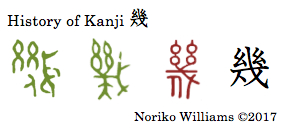 For the kanji 幾 the two bronze ware style writings had two short threads (幺) on the top left, a halberd on the right side and something else, possibly hanging threads or a person, on the bottom left. The interpretations of its origin differ among kanji scholars – (1) it was a halberd with spiritual decoration to ward off evil, and it was probably used to interrogate. From that it originally meant “to detect fine points,” and from that it meant “small; nearly” (Shirakawa); (2) The two short threads signifying “to weave” and 戍 “halberd” used phonetically together meant “to stop weaving thread,” and later on it came to be used to mean “sign” (Kadokawa dictionary); (3) The two short threads for “a little” and a broad-blade halberd (戈) and a person (人) together signified a halberd reaching nearly to a person’s neck. The short distance from a halberd to the neck meant “small; little” (Kanjigen). I do not have a view on which is the most acceptable history. It is also used as an interrogative word. The kanji 幾 meant “a few; some; how much.”
For the kanji 幾 the two bronze ware style writings had two short threads (幺) on the top left, a halberd on the right side and something else, possibly hanging threads or a person, on the bottom left. The interpretations of its origin differ among kanji scholars – (1) it was a halberd with spiritual decoration to ward off evil, and it was probably used to interrogate. From that it originally meant “to detect fine points,” and from that it meant “small; nearly” (Shirakawa); (2) The two short threads signifying “to weave” and 戍 “halberd” used phonetically together meant “to stop weaving thread,” and later on it came to be used to mean “sign” (Kadokawa dictionary); (3) The two short threads for “a little” and a broad-blade halberd (戈) and a person (人) together signified a halberd reaching nearly to a person’s neck. The short distance from a halberd to the neck meant “small; little” (Kanjigen). I do not have a view on which is the most acceptable history. It is also used as an interrogative word. The kanji 幾 meant “a few; some; how much.”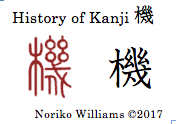 For the kanji 機, the left side 木 “wood” signified the wooden frame of a loom. The right side 幾 had many short threads cut by a knife. Together they meant a mechanical device or machine.” It means “moment; change.”
For the kanji 機, the left side 木 “wood” signified the wooden frame of a loom. The right side 幾 had many short threads cut by a knife. Together they meant a mechanical device or machine.” It means “moment; change.”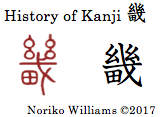 The seal style writing of the kanji 畿 had rice paddies (田), which signified a territory or area. The kanji 畿 meant “an area which an emperor rules.” In Japan 畿 is used for the name of the area that included the old capital 京都 where an emperor was situated. The kanji 畿 meant “an area under the direct control of the emperor.”
The seal style writing of the kanji 畿 had rice paddies (田), which signified a territory or area. The kanji 畿 meant “an area which an emperor rules.” In Japan 畿 is used for the name of the area that included the old capital 京都 where an emperor was situated. The kanji 畿 meant “an area under the direct control of the emperor.”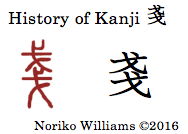 The first six kanji in this post, 桟箋浅残銭践, shared the same origin 戔. The seal style writing, in red, shown on the right side had two halberds, one on top of the other. It had two different meanings: one was to hurt a person with weapon; and the other came from the fact that a sharp blade was thin and halberds were placed in a pile – so they signified “thin things that were layered; thin strips.”
The first six kanji in this post, 桟箋浅残銭践, shared the same origin 戔. The seal style writing, in red, shown on the right side had two halberds, one on top of the other. It had two different meanings: one was to hurt a person with weapon; and the other came from the fact that a sharp blade was thin and halberds were placed in a pile – so they signified “thin things that were layered; thin strips.”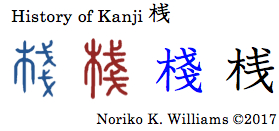 For the kanji 棧, the writing in dark blue was in the style that was said to have been used by the newly unified Qin (秦) dynasty to put a curse on their former enemy Chu (楚). Because it is from the same time that the small seal style 小篆 (now commonly known as just the seal style) was created, it looked very similar to the seal style writing, in red. Both had 木 “wood” on the left and 戔 “two halberds placed in layers.” Together they meant thin pieces of wood or bamboo, such as crosspieces, frames or narrow strips. The kyujitai, in blue, reflected seal style. In shinjitai the two halberds coalesced into one shape with three horizontal strokes.
For the kanji 棧, the writing in dark blue was in the style that was said to have been used by the newly unified Qin (秦) dynasty to put a curse on their former enemy Chu (楚). Because it is from the same time that the small seal style 小篆 (now commonly known as just the seal style) was created, it looked very similar to the seal style writing, in red. Both had 木 “wood” on the left and 戔 “two halberds placed in layers.” Together they meant thin pieces of wood or bamboo, such as crosspieces, frames or narrow strips. The kyujitai, in blue, reflected seal style. In shinjitai the two halberds coalesced into one shape with three horizontal strokes.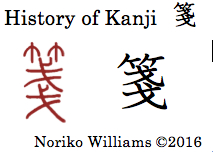 For the kanji 箋, the top 竹 was a bushu takekanmuri “bamboo,” and the bottom 戔 signified thin strips. A bamboo tablet was used to write on, which was tied as a book. Together they meant narrow thin pieces of writing. While other Joyo kanji that contained 戔 in seal style or kyujitai became simplified, the kanji 便 retained the old shape. The kanji 箋 meant “thin strips of note paper.”
For the kanji 箋, the top 竹 was a bushu takekanmuri “bamboo,” and the bottom 戔 signified thin strips. A bamboo tablet was used to write on, which was tied as a book. Together they meant narrow thin pieces of writing. While other Joyo kanji that contained 戔 in seal style or kyujitai became simplified, the kanji 便 retained the old shape. The kanji 箋 meant “thin strips of note paper.”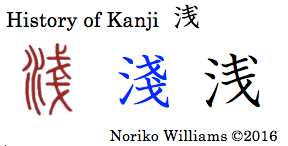 For the kanji 浅, the left side of the seal style writing was a bushu sanzui “water,” and the right side戔 “thin objects piled.” Together the area where there is little water meant “shallow.” It also meant “light” in color, as well as lack of understanding or knowledge. The kanji 浅 meant “shallow; thoughtless.”
For the kanji 浅, the left side of the seal style writing was a bushu sanzui “water,” and the right side戔 “thin objects piled.” Together the area where there is little water meant “shallow.” It also meant “light” in color, as well as lack of understanding or knowledge. The kanji 浅 meant “shallow; thoughtless.”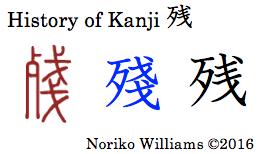 For the kanji 残, the left side of the seal style writing was the bones of a dead person, which became 歹, a bushu shikabane “dead body.” With the right side 戔 “thin objects” and bones together, they meant remains that were cut up small. The scene in which an animal eating the corpse of another animal and leaving bones behind is “gruesome; cruel.” The kanji 残 meant “remains; cruel; gruesome.”
For the kanji 残, the left side of the seal style writing was the bones of a dead person, which became 歹, a bushu shikabane “dead body.” With the right side 戔 “thin objects” and bones together, they meant remains that were cut up small. The scene in which an animal eating the corpse of another animal and leaving bones behind is “gruesome; cruel.” The kanji 残 meant “remains; cruel; gruesome.” For the kanji 銭, having 金 “metal” added to戔 “layers of thin strips,” the kanji 銭 meant farming tools that have thin blades, such as a plough and spade. In ancient China there was plough shaped money. From that the kanji 銭 meant “money; coins.”
For the kanji 銭, having 金 “metal” added to戔 “layers of thin strips,” the kanji 銭 meant farming tools that have thin blades, such as a plough and spade. In ancient China there was plough shaped money. From that the kanji 銭 meant “money; coins.”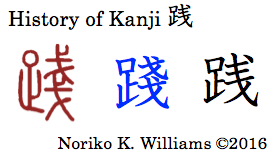 For the kanji 践, the left side足 was foot. With 戔 “to lay over; superimpose” added, placing a step over another signified “to tread upon” and “to follow an old way.” The kanji 践 meant “to tread upon; experience; act.”
For the kanji 践, the left side足 was foot. With 戔 “to lay over; superimpose” added, placing a step over another signified “to tread upon” and “to follow an old way.” The kanji 践 meant “to tread upon; experience; act.”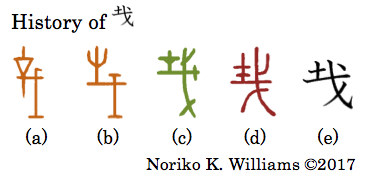 The writing sai – The top left in oracle bone style (a) and (b) in brown, was a 才, which was a pictograph of a weir that blocked water flow. It came to indicate timbers or materials in general. From that the generally accepted view is that the writing sai meant “to block; stop.”
The writing sai – The top left in oracle bone style (a) and (b) in brown, was a 才, which was a pictograph of a weir that blocked water flow. It came to indicate timbers or materials in general. From that the generally accepted view is that the writing sai meant “to block; stop.”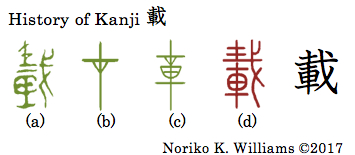 For the kanji 載, we have three bronze ware style writings here. (a) had才 on the top left, and 戈 on the right for /sai/ to mean “to block.” To this 車 “vehicle” was added at the bottom left. Together, they meant to fasten a load on a vehicle so that it would not fall. The kanji 載 meant “to load.” (b) was the same as 才, and (b) had 車 added underneath. In seal style, (d), the top left had two strokes above the 戈, whereas in kanji it became one stroke. Shirakawa suggested that the kanji 戴 was probably a ritual to sanctify military vehicles before a battle began. The kanji 載 meant “to load; put up.” It was also used to mean to enter or place article or documents in a book or publication.
For the kanji 載, we have three bronze ware style writings here. (a) had才 on the top left, and 戈 on the right for /sai/ to mean “to block.” To this 車 “vehicle” was added at the bottom left. Together, they meant to fasten a load on a vehicle so that it would not fall. The kanji 載 meant “to load.” (b) was the same as 才, and (b) had 車 added underneath. In seal style, (d), the top left had two strokes above the 戈, whereas in kanji it became one stroke. Shirakawa suggested that the kanji 戴 was probably a ritual to sanctify military vehicles before a battle began. The kanji 載 meant “to load; put up.” It was also used to mean to enter or place article or documents in a book or publication.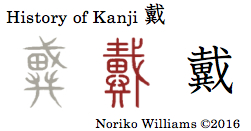 The kanji 戴 is comprised of the writing sai and the kanji 異. For this, Kanjigen took the writing sai to be the old form of the kanji 在signifying “to cut and stop” and 異 for a phonetic feature for /tai/. Together they meant “to hold something on the head.” On the other hand Shirakawa took the writing sai to be the phonetic component that changed from /sai/ to /tai/. 異 was carrying an extraordinary head of a dead person’s spirit above one’s own head. Together 戴 signified to protect something sacred with a halberd. The kanji 戴 meant “to hold something above one’s head” and is also used to mean “to receive; eat” in humble style.
The kanji 戴 is comprised of the writing sai and the kanji 異. For this, Kanjigen took the writing sai to be the old form of the kanji 在signifying “to cut and stop” and 異 for a phonetic feature for /tai/. Together they meant “to hold something on the head.” On the other hand Shirakawa took the writing sai to be the phonetic component that changed from /sai/ to /tai/. 異 was carrying an extraordinary head of a dead person’s spirit above one’s own head. Together 戴 signified to protect something sacred with a halberd. The kanji 戴 meant “to hold something above one’s head” and is also used to mean “to receive; eat” in humble style.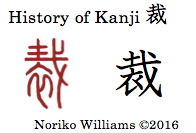 The kanji 裁 is comprised of the writing sai “to cut” or “to begin,” which was used phonetically for /sa’i/, and the kanji 衣 “clothes; fabric.” Together they meant to cut fabric for the first time. A judge makes a ruling after careful deliberation, just as cutting new fabric. From that it also meant “to make a careful decision.” The kanji 裁 meant “to cut cloth; make a final decision.”
The kanji 裁 is comprised of the writing sai “to cut” or “to begin,” which was used phonetically for /sa’i/, and the kanji 衣 “clothes; fabric.” Together they meant to cut fabric for the first time. A judge makes a ruling after careful deliberation, just as cutting new fabric. From that it also meant “to make a careful decision.” The kanji 裁 meant “to cut cloth; make a final decision.”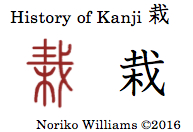 The seal style of the kanji 栽 had 木 “tree” underneath the writing sai, which was used phonetically for /sai/. Together they signified to prune unnecessary branches of a tree. The kanji 栽 meant “to grow (plant); cultivate.”
The seal style of the kanji 栽 had 木 “tree” underneath the writing sai, which was used phonetically for /sai/. Together they signified to prune unnecessary branches of a tree. The kanji 栽 meant “to grow (plant); cultivate.”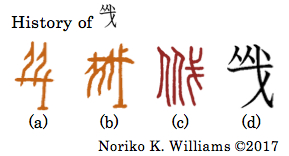
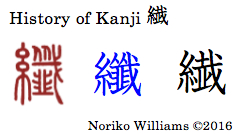 For the kanji 繊, the seal style writing had 糸, a bushu itohen “thread.” The right side had two people above a halberd, and 韭underneath signified small things. Together they signified fine threads. Fibers are fine and short hair-like. The kyujitai, in blue, retained the same shape as seal style, which had two 人 at the top – the remnant of the gruesome origin –, but in shijitai the center right became the same as the writing sai, and the center bottom was also simplified. The kanji 繊 meant “fine; detailed.”
For the kanji 繊, the seal style writing had 糸, a bushu itohen “thread.” The right side had two people above a halberd, and 韭underneath signified small things. Together they signified fine threads. Fibers are fine and short hair-like. The kyujitai, in blue, retained the same shape as seal style, which had two 人 at the top – the remnant of the gruesome origin –, but in shijitai the center right became the same as the writing sai, and the center bottom was also simplified. The kanji 繊 meant “fine; detailed.”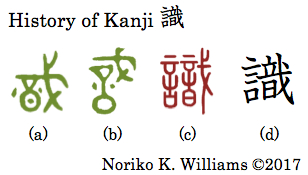 For the kanji 識 Setsumon Kaiji explained that it meant “constant” and “to know.” Shirakawa added that something that was always visible was a “flag” or “mark; sign.” Kanjigen and the Kadokawa dictionary explained that the right side was 弋, a stake as a sign, and that 音 was used phonetically (View A), while Shirakawa explained that it was a halberd (戈) with a hanging amulet to ward off evil, which was something that people should pay attention to – together giving the meaning “to discern; to know; knowledge” (View B). Because the earliest ancient writing for 弋 we have was in seal style, I find it hard to decide which of the two – the 弋 “stake in the ground” with a phonetic feature 音, or 戈 a halberd with a hanging amulet – was the likely origin. The kanji 識 meant “to discern; recognize; knowledge; mark.”
For the kanji 識 Setsumon Kaiji explained that it meant “constant” and “to know.” Shirakawa added that something that was always visible was a “flag” or “mark; sign.” Kanjigen and the Kadokawa dictionary explained that the right side was 弋, a stake as a sign, and that 音 was used phonetically (View A), while Shirakawa explained that it was a halberd (戈) with a hanging amulet to ward off evil, which was something that people should pay attention to – together giving the meaning “to discern; to know; knowledge” (View B). Because the earliest ancient writing for 弋 we have was in seal style, I find it hard to decide which of the two – the 弋 “stake in the ground” with a phonetic feature 音, or 戈 a halberd with a hanging amulet – was the likely origin. The kanji 識 meant “to discern; recognize; knowledge; mark.”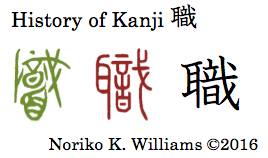 For the kanji 職 in bronze ware style, in green, it had the same shape as the kanji 識 at the top. Below that was 首 “head.” In seal style an ear “耳” was added on the left side. View A explains 職 as “to discern by listening” and it signifies a job. View B (a halberd with a hanging amulet) explains that the writing is a piece of cloth over the enemy’s head or ear as a war trophy and that its original meaning was to record military service. From that it meant “job; administration.” The kanji 職 meant “job; position; occupation.”
For the kanji 職 in bronze ware style, in green, it had the same shape as the kanji 識 at the top. Below that was 首 “head.” In seal style an ear “耳” was added on the left side. View A explains 職 as “to discern by listening” and it signifies a job. View B (a halberd with a hanging amulet) explains that the writing is a piece of cloth over the enemy’s head or ear as a war trophy and that its original meaning was to record military service. From that it meant “job; administration.” The kanji 職 meant “job; position; occupation.”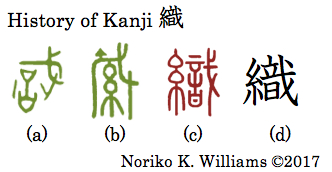 Setsumon Kaiji explained that 織 was a general term for weaving. In bronze ware style, in green, (a) was the same as (b) for 識. Another bronze ware style (b) had a skein of threads inside and 才 on the top left of 戈. As we have seen in the last post, 才 on top of 戈would result in the writing sai, the top right side of 裁. In seal style (c), in red, a bushu itohen “threads; continuous” was placed on the left side. The right side was used phonetically for making threads in weaving. In weaving, continuous threads spread sideways and lengthwise. From that it is also used for “organization.” The kanji 織 meant “to weave; organization.”
Setsumon Kaiji explained that 織 was a general term for weaving. In bronze ware style, in green, (a) was the same as (b) for 識. Another bronze ware style (b) had a skein of threads inside and 才 on the top left of 戈. As we have seen in the last post, 才 on top of 戈would result in the writing sai, the top right side of 裁. In seal style (c), in red, a bushu itohen “threads; continuous” was placed on the left side. The right side was used phonetically for making threads in weaving. In weaving, continuous threads spread sideways and lengthwise. From that it is also used for “organization.” The kanji 織 meant “to weave; organization.” This is another kanji for “halberd.” The bronze ware style writing for 矛 was a halberd or lance with a long shaft. It meant “halberd.” (A halberd has both spear-like top and blade whereas a lance has a spear-like top only.) Even when not in a battle, the display of a halberd on a stand signified the display of military power. When used with another kanji 盾 (“shield” /tate’/), the two components 矛 “halberd” and 盾 “shield” make up the word 矛盾 “contradiction; inconsistency.”
This is another kanji for “halberd.” The bronze ware style writing for 矛 was a halberd or lance with a long shaft. It meant “halberd.” (A halberd has both spear-like top and blade whereas a lance has a spear-like top only.) Even when not in a battle, the display of a halberd on a stand signified the display of military power. When used with another kanji 盾 (“shield” /tate’/), the two components 矛 “halberd” and 盾 “shield” make up the word 矛盾 “contradiction; inconsistency.”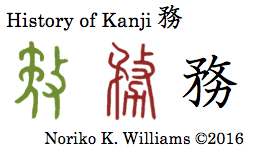 For the kanji 務, in bronze ware style the left side was a halberd (矛), and the right side was a hand holding a stick, which signified “to act” or “to make someone do something” (a bushu bokunyuu/bokuzukuri). Together they originally meant “to make someone do something.” In seal style 力 “plough” was added to signify hard work in the field. The kanji 務 meant “to work on; duty; mission.”
For the kanji 務, in bronze ware style the left side was a halberd (矛), and the right side was a hand holding a stick, which signified “to act” or “to make someone do something” (a bushu bokunyuu/bokuzukuri). Together they originally meant “to make someone do something.” In seal style 力 “plough” was added to signify hard work in the field. The kanji 務 meant “to work on; duty; mission.” In chubun style (籀文), in light blue, which predated small seal style, it had a bushu ukanmuri (雨) “atmospheric phenomenon” at the top and 矛. The bottom was used phonetically for /mu/ to mean “not clear.” Together they meant “mist; fog.”
In chubun style (籀文), in light blue, which predated small seal style, it had a bushu ukanmuri (雨) “atmospheric phenomenon” at the top and 矛. The bottom was used phonetically for /mu/ to mean “not clear.” Together they meant “mist; fog.”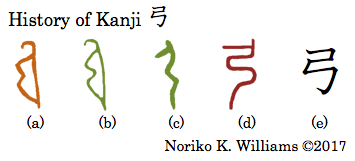 For the kanji 弓, (a) in oracle bone style, in brown, and (b) in bronze ware style, in green, had a bow with a bowstring. Another bronze ware style writing (c), (d) in seal style, in red, had a bow only, which became the kanji 弓. The kanji 弓 meant “bow.”
For the kanji 弓, (a) in oracle bone style, in brown, and (b) in bronze ware style, in green, had a bow with a bowstring. Another bronze ware style writing (c), (d) in seal style, in red, had a bow only, which became the kanji 弓. The kanji 弓 meant “bow.”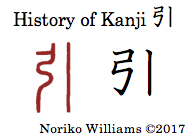 For the kanji 引, the seal style kanji had a bow and a vertical line, which is interpreted to signify something being pulled to straighten. Pulling something back also meant “to subtract.” The kanji 引 meant “to pull; pull back; subtract; look up.”
For the kanji 引, the seal style kanji had a bow and a vertical line, which is interpreted to signify something being pulled to straighten. Pulling something back also meant “to subtract.” The kanji 引 meant “to pull; pull back; subtract; look up.” For the kanji 張, in bronze ware style the left side was a skein of thread (糸), and the right side was an old man with long hair (長), which was used phonetically for /cho’o/. In seal style the left side was a bow (弓), which signified something stretched. Stretching something makes it longer. The kanji 張 meant “to stretch; to extend.” The kanji 張 was also used to mean “paste; post” when its correct kanji 貼 was a non-Joyo kanji until the 2010 revision. So, you saw the kanji 張 to mean “post; paste.”
For the kanji 張, in bronze ware style the left side was a skein of thread (糸), and the right side was an old man with long hair (長), which was used phonetically for /cho’o/. In seal style the left side was a bow (弓), which signified something stretched. Stretching something makes it longer. The kanji 張 meant “to stretch; to extend.” The kanji 張 was also used to mean “paste; post” when its correct kanji 貼 was a non-Joyo kanji until the 2010 revision. So, you saw the kanji 張 to mean “post; paste.”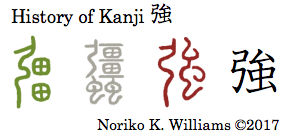 For the kanji 強, Setsumon gave the Chubun style writing, shown in gray, to be its preceding writing – 彊 phonetically used for /kyoo/ at the top and two worms 虫 at the bottom. They meant a hard shell insect such as a beetle. From that it meant “strong.” Shirakawa viewed that 彊 meant something else and that 強 was a semantic composite which was comprised of 弘, a bow with bow string detached, and 虫, a wild silkworm thread that was fortified with resin. Together they meant “strong.” Being strong is advantageous. The kanji強 meant “strong; advantage; to force.”
For the kanji 強, Setsumon gave the Chubun style writing, shown in gray, to be its preceding writing – 彊 phonetically used for /kyoo/ at the top and two worms 虫 at the bottom. They meant a hard shell insect such as a beetle. From that it meant “strong.” Shirakawa viewed that 彊 meant something else and that 強 was a semantic composite which was comprised of 弘, a bow with bow string detached, and 虫, a wild silkworm thread that was fortified with resin. Together they meant “strong.” Being strong is advantageous. The kanji強 meant “strong; advantage; to force.”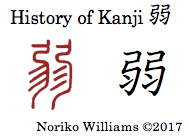 For the kanji 弱 in seal style it had two bows with three diagonal lines. In ancient writing three diagonal lines usually signified something beautiful or a decorative pattern. A decorative bow was for ceremonial purposes and was not strong. The kanji 弱 meant “weak; fragile; mild.”
For the kanji 弱 in seal style it had two bows with three diagonal lines. In ancient writing three diagonal lines usually signified something beautiful or a decorative pattern. A decorative bow was for ceremonial purposes and was not strong. The kanji 弱 meant “weak; fragile; mild.”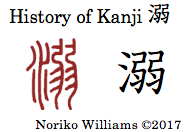 For the kanji 溺, the seal style writing had a bushu sanzui “water” and the phonetically used component 弱 for /jaku; deki/. The kanji 溺 meant “to drown.”
For the kanji 溺, the seal style writing had a bushu sanzui “water” and the phonetically used component 弱 for /jaku; deki/. The kanji 溺 meant “to drown.”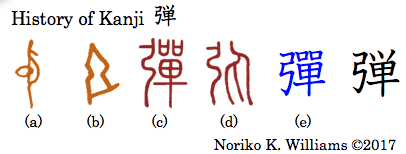 For the kanji 弾, in oracle bone style, (a) had a bow with a circle that might have emphasized the action of shooting, or a rock to shoot with. (b) was a bow. For seal style Setsubun gave two writings (c) and (d), both of which had a bow on the left – (c) had 単 used phonetically for /tan/, and (d) had 爪 “fingernails,” which suggested an action of fingers flicking something. The kyujitai (e) took (c), which became simplified to 弾 in shinjitai. The kanji 弾 meant “to flick; bullet; spring”
For the kanji 弾, in oracle bone style, (a) had a bow with a circle that might have emphasized the action of shooting, or a rock to shoot with. (b) was a bow. For seal style Setsubun gave two writings (c) and (d), both of which had a bow on the left – (c) had 単 used phonetically for /tan/, and (d) had 爪 “fingernails,” which suggested an action of fingers flicking something. The kyujitai (e) took (c), which became simplified to 弾 in shinjitai. The kanji 弾 meant “to flick; bullet; spring” For the kanji 弦, the seal style writing was comprised of 弓 and 玄, used phonetically for /gen/. 玄 was twined threads that were dyed black. Together they meant strings on a bow. Plucking a tightened string makes sounds, and 弦 meant “stringed musical instrument.” The kanji 弦 meant “bow string; string musical instrument.”
For the kanji 弦, the seal style writing was comprised of 弓 and 玄, used phonetically for /gen/. 玄 was twined threads that were dyed black. Together they meant strings on a bow. Plucking a tightened string makes sounds, and 弦 meant “stringed musical instrument.” The kanji 弦 meant “bow string; string musical instrument.”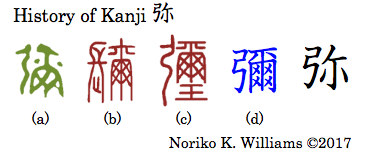 For the kanji 弥, Setsumon gave two (a) and (b) as its seal style writings. (a) had 長 “long hair” on the left instead of 弓. The right side was 爾 or 璽 “imperial seal.” Shirakawa explained (a) in bronze ware style as having a beautifully done body painting on a woman’s upper body for a ritual, and a bow probably used in a rite to fend off evil. The kanji 彌 meant “long.” The seal style (c) had 王 “jewel” to signify an imperial seal made of a precious stone. In kyujitai (d) 王 was dropped. In shinjitai 爾 was replaced by 尓, and became 弥. The Kadokawa dictionary and Kanjigen viewed the right side of 彌 to be a seal. The kanji 弥 meant “long time; increasingly.”
For the kanji 弥, Setsumon gave two (a) and (b) as its seal style writings. (a) had 長 “long hair” on the left instead of 弓. The right side was 爾 or 璽 “imperial seal.” Shirakawa explained (a) in bronze ware style as having a beautifully done body painting on a woman’s upper body for a ritual, and a bow probably used in a rite to fend off evil. The kanji 彌 meant “long.” The seal style (c) had 王 “jewel” to signify an imperial seal made of a precious stone. In kyujitai (d) 王 was dropped. In shinjitai 爾 was replaced by 尓, and became 弥. The Kadokawa dictionary and Kanjigen viewed the right side of 彌 to be a seal. The kanji 弥 meant “long time; increasingly.”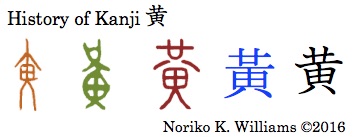 For the kanji 黄 in oracle bone style, in brown, bronze ware style, in green, and seal style, in red, it was a fire arrow with an arrowhead at the top, combustible materials in the middle and feathers at the bottom. When a fire arrow was shot, it illuminated an area. The yellow color of this light became the meaning of this kanji. The kanji 黄 meant “yellow; golden.”
For the kanji 黄 in oracle bone style, in brown, bronze ware style, in green, and seal style, in red, it was a fire arrow with an arrowhead at the top, combustible materials in the middle and feathers at the bottom. When a fire arrow was shot, it illuminated an area. The yellow color of this light became the meaning of this kanji. The kanji 黄 meant “yellow; golden.”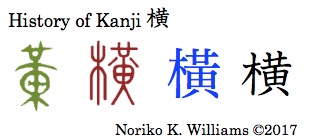 For the kanji 横, the bronze ware style writing was the same as 黄. In seal style 木 “wood” was added on the left, and the right side was used phonetically for /oo/, and meant “sideways,” from a fire arrow illuminating both sides as it traveled. Together they signified a piece of wood placed sideways as a latch on a gate. From that it meant “side; sideways.” Something that goes sideways could be going outside the legitimate areas, thus, it also meant “wicked; wrong.”
For the kanji 横, the bronze ware style writing was the same as 黄. In seal style 木 “wood” was added on the left, and the right side was used phonetically for /oo/, and meant “sideways,” from a fire arrow illuminating both sides as it traveled. Together they signified a piece of wood placed sideways as a latch on a gate. From that it meant “side; sideways.” Something that goes sideways could be going outside the legitimate areas, thus, it also meant “wicked; wrong.” For the kanji 広, in (a) in oracle bone style the top was a house, and the inside was a fire arrow that signified “wide.” (b) and (c) in bronze ware style had a house with one side open, which (d) in seal style became 广, a bushu gandare “house with one side open.” In shinjitai (f) the inside of the kyujitai (e) 廣 was replaced by a katakana ム, which is one of the simplifying shapes. The kanji 広 meant “wide; spacious.”
For the kanji 広, in (a) in oracle bone style the top was a house, and the inside was a fire arrow that signified “wide.” (b) and (c) in bronze ware style had a house with one side open, which (d) in seal style became 广, a bushu gandare “house with one side open.” In shinjitai (f) the inside of the kyujitai (e) 廣 was replaced by a katakana ム, which is one of the simplifying shapes. The kanji 広 meant “wide; spacious.”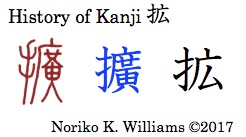 For The kanji 拡, the seal style had扌, a bushu tehen “act that one does by hand.” Together with the kanji 廣 “wide” they meant “to widen.” The kyujitai 擴 was simplified to 拡. By an agent of action ,“hand,” the kanji 拡 is used as a verb, whereas 広 was an adjective. Until the 2010 revision of Joyo kanji (that is, 1981 version), the kun-yomi /hiro/ was not in Joyo kanji, and 広 was often used. So we see both 広げる and 拡げる in print.
For The kanji 拡, the seal style had扌, a bushu tehen “act that one does by hand.” Together with the kanji 廣 “wide” they meant “to widen.” The kyujitai 擴 was simplified to 拡. By an agent of action ,“hand,” the kanji 拡 is used as a verb, whereas 広 was an adjective. Until the 2010 revision of Joyo kanji (that is, 1981 version), the kun-yomi /hiro/ was not in Joyo kanji, and 広 was often used. So we see both 広げる and 拡げる in print. For the kanji 鉱 Old style was shown in gray. The seal style writing had 石 “rock” on the left, and the right side 黄 was used phonetically for /koo/. Together they meant “ore; mineral; rock.” In kyujitai 鑛, the left side became 金, a bushu kanehen “metal; mineral,” and the right side became 廣 with a madare, which was further replaced by 広 in shinjitai. The kanji 鉱 means “ore; mineral.”
For the kanji 鉱 Old style was shown in gray. The seal style writing had 石 “rock” on the left, and the right side 黄 was used phonetically for /koo/. Together they meant “ore; mineral; rock.” In kyujitai 鑛, the left side became 金, a bushu kanehen “metal; mineral,” and the right side became 廣 with a madare, which was further replaced by 広 in shinjitai. The kanji 鉱 means “ore; mineral.”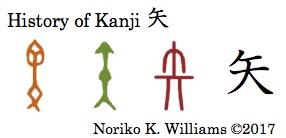 For the kanji 矢, in oracle bone style and bronze ware style it was an arrow with an arrowhead at the top and feathers at the bottom. The seal style writing became much less an image of an arrow. In kanji a short slanted stroke emphasized the arrowhead. The kanji 矢 meant “arrow.”
For the kanji 矢, in oracle bone style and bronze ware style it was an arrow with an arrowhead at the top and feathers at the bottom. The seal style writing became much less an image of an arrow. In kanji a short slanted stroke emphasized the arrowhead. The kanji 矢 meant “arrow.”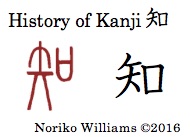 For the kanji 短, the seal style writing had 矢 “arrow,” which also meant “to vow.” The right side, 口 “mouth,” signified “word; language.” Together they signified “to vow to a god.” Knowledge was what the god gave. From that the kanji 知 meant “to know.”
For the kanji 短, the seal style writing had 矢 “arrow,” which also meant “to vow.” The right side, 口 “mouth,” signified “word; language.” Together they signified “to vow to a god.” Knowledge was what the god gave. From that the kanji 知 meant “to know.”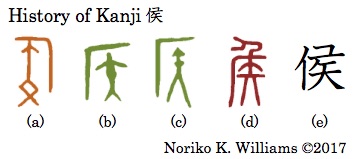 For the kanji 侯, (a) in oracle bone style and (b) and (c) in bronze ware style had an arrow under a canopy or target range, signifying “to shoot an arrow.” In (d) in seal style, a person bending his back foward to watch out was added at the top. Together they meant the title of a person who oversaw shooting arrows against an enemy – “feudal lord; lord.” Later on it became one of the five levels of titles in the order of 公侯伯子男 based on Confucious. The kanji 侯 meant “lord; marquis.”
For the kanji 侯, (a) in oracle bone style and (b) and (c) in bronze ware style had an arrow under a canopy or target range, signifying “to shoot an arrow.” In (d) in seal style, a person bending his back foward to watch out was added at the top. Together they meant the title of a person who oversaw shooting arrows against an enemy – “feudal lord; lord.” Later on it became one of the five levels of titles in the order of 公侯伯子男 based on Confucious. The kanji 侯 meant “lord; marquis.” For the kanji 候 the bronze ware style writing had an arrow and a house or canopy, the same components as 侯. In seal style, in addition to a person crouching watching out at the top (侯), another person (イ) was added on the left side. This was to differentiate the two meanings that 侯 originally had – “lord” from shooting arrows, and “to watch for a sign of an enemy; scout,” the latter of which became the meaning of the kanji 候 “to peep; watch for a sign.” Weather or climate was something one judged or forecast from atmospheric signs, so it was used to discuss season or weather. In classical Japanese, 候 /sooro’o/ meant “to be” for /~de aru/ in old epistolary style. The kanji 候 meant “to scout; climate; be.”
For the kanji 候 the bronze ware style writing had an arrow and a house or canopy, the same components as 侯. In seal style, in addition to a person crouching watching out at the top (侯), another person (イ) was added on the left side. This was to differentiate the two meanings that 侯 originally had – “lord” from shooting arrows, and “to watch for a sign of an enemy; scout,” the latter of which became the meaning of the kanji 候 “to peep; watch for a sign.” Weather or climate was something one judged or forecast from atmospheric signs, so it was used to discuss season or weather. In classical Japanese, 候 /sooro’o/ meant “to be” for /~de aru/ in old epistolary style. The kanji 候 meant “to scout; climate; be.”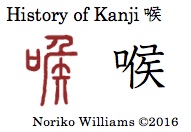 For the kanji 喉, the seal style writing had 口 “mouth” next to the shape (d) in 侯, which was used phonetically for /koo/. Together they meant “throat.”
For the kanji 喉, the seal style writing had 口 “mouth” next to the shape (d) in 侯, which was used phonetically for /koo/. Together they meant “throat.” For the kanji 医, the two seal style writings, (b) and (c), were originally not related. (b) had its oracle bone style precursor (a), which had an arrow in a box that signified “to hide an arrow.” The other seal style writing (c) had (b) 医 “a box of arrows” at the top left. With the right side殳 “a hand holding a weapon or tool” that meant “to cause,” together it meant an injury caused by an arrow in battle. The bottom酉 was a spirit jar that signified medicinal spirit. Altogether “treating an injured person with medical spirit” meant “medicine.” The kyujitai (d) reflected (c). The shinjitai became only an arrow hidden in a box. The kanji 医 meant “medicine.”
For the kanji 医, the two seal style writings, (b) and (c), were originally not related. (b) had its oracle bone style precursor (a), which had an arrow in a box that signified “to hide an arrow.” The other seal style writing (c) had (b) 医 “a box of arrows” at the top left. With the right side殳 “a hand holding a weapon or tool” that meant “to cause,” together it meant an injury caused by an arrow in battle. The bottom酉 was a spirit jar that signified medicinal spirit. Altogether “treating an injured person with medical spirit” meant “medicine.” The kyujitai (d) reflected (c). The shinjitai became only an arrow hidden in a box. The kanji 医 meant “medicine.”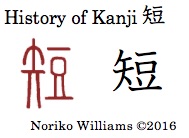 For the kanji 短, the left side was an arrow and the right side 豆 was a small one-legged tray or bowl. Setsumon explained that an arrow was used in measuring length. From that the kanji 短 meant “short.”
For the kanji 短, the left side was an arrow and the right side 豆 was a small one-legged tray or bowl. Setsumon explained that an arrow was used in measuring length. From that the kanji 短 meant “short.” For the kanji 至, the bronze ware style writing was an arrow with its arrowhead at the bottom, hitting the ground (一). It meant “to reach an end.” In seal style the arrowhead became long, which in kanji became a part of 土 “soil; ground.” The kanji 至 meant “to reach an end; to the end.”
For the kanji 至, the bronze ware style writing was an arrow with its arrowhead at the bottom, hitting the ground (一). It meant “to reach an end.” In seal style the arrowhead became long, which in kanji became a part of 土 “soil; ground.” The kanji 至 meant “to reach an end; to the end.” For the kanji 屋, in (a) in Old style, (b) Chubun style, and (c) seal style 至 was placed inside a house, (a), or under尸 , (b) and (c). There are different views on its origin: (1) Shirkawa took the view that in ancient times an arrow was shot to determine an appropriate location and where an arrow dropped was considered to be the place. That is 至. 尸 was a hut to house a corpse to intern to weather it before burial. Together 屋 meant a house. (2) Kanjigen explained that a covering drapery 至 “dead end” together blocked passing. 屋 meant a covered house; (3) The Kadokawa dictionary explained 尸 “drapery” and 至 “to reach” together meant a secluded room in the back. The fact that a bushu shikabane 尸has two distinctly different meanings –“corpse,” as the name indicates, and “roof” — is reflected in these different views. The kanji 屋 meant “roof; house.” In Japanese it was also used to mean business that was conducted under a roof, a “store.”
For the kanji 屋, in (a) in Old style, (b) Chubun style, and (c) seal style 至 was placed inside a house, (a), or under尸 , (b) and (c). There are different views on its origin: (1) Shirkawa took the view that in ancient times an arrow was shot to determine an appropriate location and where an arrow dropped was considered to be the place. That is 至. 尸 was a hut to house a corpse to intern to weather it before burial. Together 屋 meant a house. (2) Kanjigen explained that a covering drapery 至 “dead end” together blocked passing. 屋 meant a covered house; (3) The Kadokawa dictionary explained 尸 “drapery” and 至 “to reach” together meant a secluded room in the back. The fact that a bushu shikabane 尸has two distinctly different meanings –“corpse,” as the name indicates, and “roof” — is reflected in these different views. The kanji 屋 meant “roof; house.” In Japanese it was also used to mean business that was conducted under a roof, a “store.”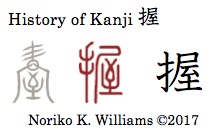 The seal style writing of the kanji 握 had 扌, a bushu tehen “an act one does using a hand” and 屋 phonetically for /oku; aku/. Together a hand reaching out to seize meant “to grip; grasp.”
The seal style writing of the kanji 握 had 扌, a bushu tehen “an act one does using a hand” and 屋 phonetically for /oku; aku/. Together a hand reaching out to seize meant “to grip; grasp.”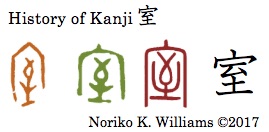 For the kanji 室 all three ancient style — oracle bone, bronze ware and seal — had a house (宀) and an arrow reaching the ground (至), signifying “the farthest point” in a house. Together they meant a secluded room in the back. The kanji 室 meant “room.”
For the kanji 室 all three ancient style — oracle bone, bronze ware and seal — had a house (宀) and an arrow reaching the ground (至), signifying “the farthest point” in a house. Together they meant a secluded room in the back. The kanji 室 meant “room.”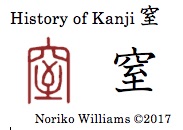 The seal style writing for the kanji 窒 had 穴 “house; cave” at the top and 至 “an arrow reaching the ground” used phonetically fpr /shi; tetsu/. Together an arrow reaching a cave meant “to block passing or traffic.”
The seal style writing for the kanji 窒 had 穴 “house; cave” at the top and 至 “an arrow reaching the ground” used phonetically fpr /shi; tetsu/. Together an arrow reaching a cave meant “to block passing or traffic.”
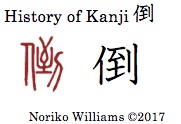 The seal style writing for the kanji 倒 had イ “person” and 到 “to reach,” from a person arriving at where an arrow reached, used phonetically for /too/. Together a person retrieving an arrow and coming back originally signified a person in a reverse manner or upside-down position. The kanji 倒 meant “to invert; fall; topple.”
The seal style writing for the kanji 倒 had イ “person” and 到 “to reach,” from a person arriving at where an arrow reached, used phonetically for /too/. Together a person retrieving an arrow and coming back originally signified a person in a reverse manner or upside-down position. The kanji 倒 meant “to invert; fall; topple.”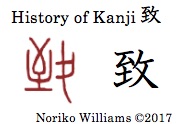 The seal style writing for the kanji 致 had 至on the left. The right side was a hand or glove for shooting arrows holding a long bow. Together they meant “to make someone do something.” In kanji the right side became 攵,a bushu bokuzukuri “to cause.“
The seal style writing for the kanji 致 had 至on the left. The right side was a hand or glove for shooting arrows holding a long bow. Together they meant “to make someone do something.” In kanji the right side became 攵,a bushu bokuzukuri “to cause.“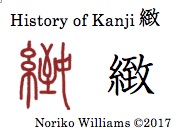 The seal style writing of the kanji 緻 had 糸 “stein of threads” that signified “close-grained; fine” next to 致 “to do” used phonetically for /chi/. Together they meant “fine.”
The seal style writing of the kanji 緻 had 糸 “stein of threads” that signified “close-grained; fine” next to 致 “to do” used phonetically for /chi/. Together they meant “fine.”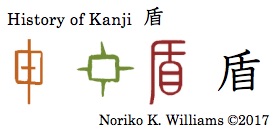 In oracle bone style, in brown, and bronze ware style, in green, it was an image of a shield. The seal style writing, in red, had a canopy-like shape and an eye with a cross shape. Following Setsumon’s explanation, which is based on the seal style, many scholars view this as a shield which protected the eyes of a soldier and his body. The kanji 盾 meant “shield.”
In oracle bone style, in brown, and bronze ware style, in green, it was an image of a shield. The seal style writing, in red, had a canopy-like shape and an eye with a cross shape. Following Setsumon’s explanation, which is based on the seal style, many scholars view this as a shield which protected the eyes of a soldier and his body. The kanji 盾 meant “shield.”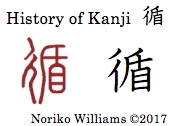 The left side of the seal style writing was a crossroad, signifying “going” and the right side 盾 “shield” was also used phonetically for /jun/ to mean “to follow; go along.” The kanji 循 meant “to follow.”
The left side of the seal style writing was a crossroad, signifying “going” and the right side 盾 “shield” was also used phonetically for /jun/ to mean “to follow; go along.” The kanji 循 meant “to follow.”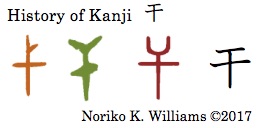 In oracle bone, bronze ware and ten styles, it was a forked weapon. The kanji 干 meant “to violate; attack.” However, this kanji is rarely used to mean aggression, except in the word 干渉 “interference; meddling.” It was borrowed to mean “dry; dry up.”
In oracle bone, bronze ware and ten styles, it was a forked weapon. The kanji 干 meant “to violate; attack.” However, this kanji is rarely used to mean aggression, except in the word 干渉 “interference; meddling.” It was borrowed to mean “dry; dry up.”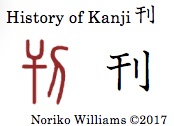 For the kanji 刊, the left side (干) of the seal style writing was used phonetically for /kan/ to mean “to shave a piece of wood.” The right side was a knife. By using a knife, printing blocks were shaved to make a book. In kanji the knife became刂,a bushu rittoo “knife.” The kanji 刊 meant “to publish.”
For the kanji 刊, the left side (干) of the seal style writing was used phonetically for /kan/ to mean “to shave a piece of wood.” The right side was a knife. By using a knife, printing blocks were shaved to make a book. In kanji the knife became刂,a bushu rittoo “knife.” The kanji 刊 meant “to publish.”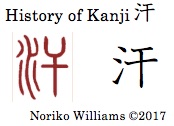 For the kanji 汗, the left side of the seal style was “water,” which became a bushu sanzui in kanji (氵). The right side was used phonetically for /kan/. The kanji 汗 meant “perspiration; sweat.”
For the kanji 汗, the left side of the seal style was “water,” which became a bushu sanzui in kanji (氵). The right side was used phonetically for /kan/. The kanji 汗 meant “perspiration; sweat.”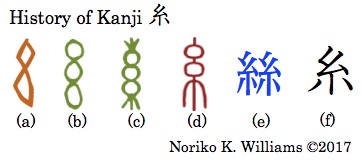 For the kanji 糸, (a) in oracle bone style, in brown, and (b) and (c), in bronze ware style, in green, had two or three silkworm cocoons strung together with filaments coming out at two ends. An alternative view is that it was a skein of raw silk threads. It meant “thread.” The two round shapes in (d) in seal style, in red, became the shape that had two 糸side by side in (e) in kyuji, in blue. In shinji (f) it became a single skein of threads. The kanji 糸 meant “thread.”
For the kanji 糸, (a) in oracle bone style, in brown, and (b) and (c), in bronze ware style, in green, had two or three silkworm cocoons strung together with filaments coming out at two ends. An alternative view is that it was a skein of raw silk threads. It meant “thread.” The two round shapes in (d) in seal style, in red, became the shape that had two 糸side by side in (e) in kyuji, in blue. In shinji (f) it became a single skein of threads. The kanji 糸 meant “thread.”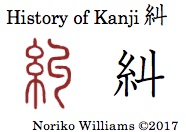 The seal style writing of the kanji 糾 had “thread” on the left. The right side was two ropes that were twisted or entwined, and was used phonetically for /kyuu/. Threads that were twisted or entwined also signified to lump things together or to make things right. The kanji 糾 meant “to twist something; entwine; investigate; scrutinize.” When糸 is used as a bushu on the left side it is called a bushu itohen.
The seal style writing of the kanji 糾 had “thread” on the left. The right side was two ropes that were twisted or entwined, and was used phonetically for /kyuu/. Threads that were twisted or entwined also signified to lump things together or to make things right. The kanji 糾 meant “to twist something; entwine; investigate; scrutinize.” When糸 is used as a bushu on the left side it is called a bushu itohen.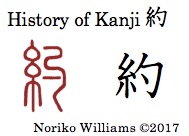 The seal style writing of the kanji 約 is comprised of 糸 “thread” and 勺 “ladle scooping up something,” which was used phonetically for /shaku; yaku/. Together binding with threads what was raised meant “to promise.” Binding things in a bundle also gave the meaning to shorten or cut back. The kanji 約meant “to promise; shorten; cut back.”
The seal style writing of the kanji 約 is comprised of 糸 “thread” and 勺 “ladle scooping up something,” which was used phonetically for /shaku; yaku/. Together binding with threads what was raised meant “to promise.” Binding things in a bundle also gave the meaning to shorten or cut back. The kanji 約meant “to promise; shorten; cut back.”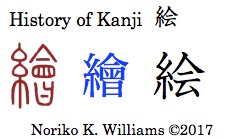 The seal style writing of the kanji絵 had 糸 “thread” and 會 “steamer with a lid.” A lid meets the steamer tightly, thus meant “to meet,” and it was also used phonetically for /kai/. Both sides together pulling threads of various color together originally signified brocade or embroidered cloth. Later it came to be used to mean “painting.” The kyuji 繪, which reflected seal style, was simplified to 絵, just as the kanji會 was replaced by 会 in shinji. The kanji 絵 meant “painting; picture.”
The seal style writing of the kanji絵 had 糸 “thread” and 會 “steamer with a lid.” A lid meets the steamer tightly, thus meant “to meet,” and it was also used phonetically for /kai/. Both sides together pulling threads of various color together originally signified brocade or embroidered cloth. Later it came to be used to mean “painting.” The kyuji 繪, which reflected seal style, was simplified to 絵, just as the kanji會 was replaced by 会 in shinji. The kanji 絵 meant “painting; picture.”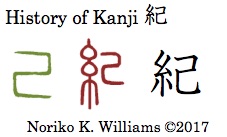 己, the bronze ware style writing for the kanji 紀, was phonetically /ki/, and has been given various interpretations — a tool used for spinning threads; a crooked end of a thread or rope; a motion in which a person in a crouched position was about to get up, etc. In seal style 糸 “thread” was added on the left to clarify the meaning. Gathering threads into one signified a beginning of a long-lasting event – thus, “to begin.” Making a chronicle of events was like gathering different lines of events into one – thus, “to chronicle.” The kanji 紀 meant “to begin; chronicle.”
己, the bronze ware style writing for the kanji 紀, was phonetically /ki/, and has been given various interpretations — a tool used for spinning threads; a crooked end of a thread or rope; a motion in which a person in a crouched position was about to get up, etc. In seal style 糸 “thread” was added on the left to clarify the meaning. Gathering threads into one signified a beginning of a long-lasting event – thus, “to begin.” Making a chronicle of events was like gathering different lines of events into one – thus, “to chronicle.” The kanji 紀 meant “to begin; chronicle.”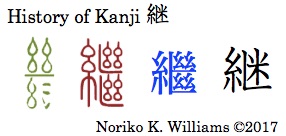 For the kanji 継, the bronze ware style writing had a pair of skeins of threads on two separate levels with a line in-between. That line signified that the threads were cut short (幺). In seal style another thread 糸 was added on the left, and together they signified “a thread (on the left) connecting the threads that are cut.” The four 幺 in kyuji was replaced by 米 in shinji. The kanji 継 meant “to succeed; inherit: continue.”
For the kanji 継, the bronze ware style writing had a pair of skeins of threads on two separate levels with a line in-between. That line signified that the threads were cut short (幺). In seal style another thread 糸 was added on the left, and together they signified “a thread (on the left) connecting the threads that are cut.” The four 幺 in kyuji was replaced by 米 in shinji. The kanji 継 meant “to succeed; inherit: continue.”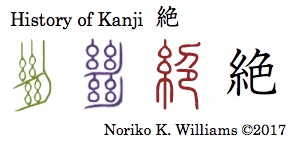 The bronze ware style writing of the kanji 絶 was similar to 継 in 6– a pair of skeins of threads on two shelves to mean “short thread” The Old style, in purple, was the same as the right side of the kanji 継, except that it was a flip-side. In seal style the right side (色) was added and used phonetically for /zee; zetsu/. The top of 色 had a knife (刀). Together they meant “to cut; die out.”
The bronze ware style writing of the kanji 絶 was similar to 継 in 6– a pair of skeins of threads on two shelves to mean “short thread” The Old style, in purple, was the same as the right side of the kanji 継, except that it was a flip-side. In seal style the right side (色) was added and used phonetically for /zee; zetsu/. The top of 色 had a knife (刀). Together they meant “to cut; die out.” The combination of “four skeins of short threads” and “knife” reminds us of another kanji 断 in the earlier discussion. [December 6, 2016] The kanji 断 in seal style had a hand axe (斤), a more powerful sharp object- thus, the kanji 断 meant “to cut drastically.”
The combination of “four skeins of short threads” and “knife” reminds us of another kanji 断 in the earlier discussion. [December 6, 2016] The kanji 断 in seal style had a hand axe (斤), a more powerful sharp object- thus, the kanji 断 meant “to cut drastically.”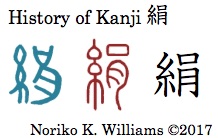 The writing in light color (time unknown) and seal style writing had 糸 on the left, and the right side was used phonetically for /ken/. The top of the right side was generally viewed as a round silkworm. The kanji 絹 meant “silk.”
The writing in light color (time unknown) and seal style writing had 糸 on the left, and the right side was used phonetically for /ken/. The top of the right side was generally viewed as a round silkworm. The kanji 絹 meant “silk.”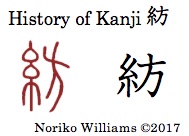 The seal style of the kanji 紡 had 糸 “skein of thread” and 方 for a phonetic /hoo; boo/. The kanji 紡 meant “to spin.”
The seal style of the kanji 紡 had 糸 “skein of thread” and 方 for a phonetic /hoo; boo/. The kanji 紡 meant “to spin.”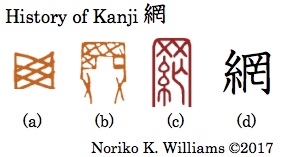 For the kanji 網, (a) and (b) in oracle bone style, in brown, was a net and was also used phonetically for /moo/. It meant “net.” (c) in seal style, in red, the outside was a net and inside was a skein of thread (糸) and 亡 for /boo; moo/. In kanji, (d), a skein of thread was taken outside the net as a bushu itohen, and the right side became 罔. The kanji 網 meant “net; net-like thing.”
For the kanji 網, (a) and (b) in oracle bone style, in brown, was a net and was also used phonetically for /moo/. It meant “net.” (c) in seal style, in red, the outside was a net and inside was a skein of thread (糸) and 亡 for /boo; moo/. In kanji, (d), a skein of thread was taken outside the net as a bushu itohen, and the right side became 罔. The kanji 網 meant “net; net-like thing.”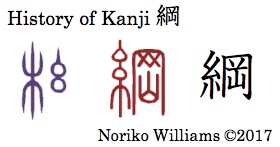 The seal style for the kanji 綱 had 岡, which was used phonetically for /koo/. 岡 was originally a hard mold that was baked at a high temperature and signified “strong.” Together with 糸, they meant “cable; line.” Something that was strong gave a principle for an order, thus it meant “principle.” The kanji 綱 meant “cable; principle.”
The seal style for the kanji 綱 had 岡, which was used phonetically for /koo/. 岡 was originally a hard mold that was baked at a high temperature and signified “strong.” Together with 糸, they meant “cable; line.” Something that was strong gave a principle for an order, thus it meant “principle.” The kanji 綱 meant “cable; principle.”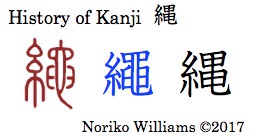 In the seal style writing of the kanji 縄, the right side originated from a fly, but was used phonetically for /joo/ to mean a “twisted thing.” Together they meant “rope.” The kyuji, in blue, reflected seal style. In kanji the right side became simplified. The kanji 縄 meant “rope; cord.”
In the seal style writing of the kanji 縄, the right side originated from a fly, but was used phonetically for /joo/ to mean a “twisted thing.” Together they meant “rope.” The kyuji, in blue, reflected seal style. In kanji the right side became simplified. The kanji 縄 meant “rope; cord.” In the seal style writing of the kanji 総, next to the skein of threads (糸) was 悤, which was used phonetically for /soo/ to mean “to bundle up hair.” Together they meant to bundle threads into one. From that it meant “to gather all” and “all.” In kanji the right side悤became忩. The kanji 総 meant “to gather all; all; general.”
In the seal style writing of the kanji 総, next to the skein of threads (糸) was 悤, which was used phonetically for /soo/ to mean “to bundle up hair.” Together they meant to bundle threads into one. From that it meant “to gather all” and “all.” In kanji the right side悤became忩. The kanji 総 meant “to gather all; all; general.”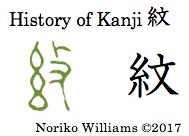 The bronze ware style writing for the kanji 紋 had a skein of threads (three rounds), and the right side was a hand holding a stick, signifying “action by hand.” Together they signified a hand making a pattern with threads. Setsumon did not give any seal style writing. The right side (文) of the kanji 紋 was used phonetically for /bun; mon/ to mean “design.” With 糸 and 文 together they meant a pretty pattern in woven fabric. In Japanese 紋 is also used to mean “family crest.”
The bronze ware style writing for the kanji 紋 had a skein of threads (three rounds), and the right side was a hand holding a stick, signifying “action by hand.” Together they signified a hand making a pattern with threads. Setsumon did not give any seal style writing. The right side (文) of the kanji 紋 was used phonetically for /bun; mon/ to mean “design.” With 糸 and 文 together they meant a pretty pattern in woven fabric. In Japanese 紋 is also used to mean “family crest.”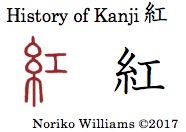 The seal style writing was comprised of 糸, a skein of threads, and 工, which was used phonetically for /koo/. Together they meant “red.” The kanji 紅 meant “red.”
The seal style writing was comprised of 糸, a skein of threads, and 工, which was used phonetically for /koo/. Together they meant “red.” The kanji 紅 meant “red.”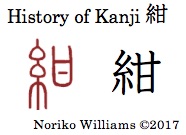 The seal style writing was comprised of 糸 and 甘, which was used phonetically for /kan/. Together they meant “dark blue.” The kanji 紺 meant “dark blue.”
The seal style writing was comprised of 糸 and 甘, which was used phonetically for /kan/. Together they meant “dark blue.” The kanji 紺 meant “dark blue.”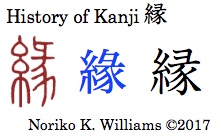 The right side of the seal style writing (彖) was used phonetically for /tan; en/ to mean “edge.” With the left side 糸, together they meant “edge of clothes; fringe.” From that it also meant something connecting. In Buddhism this kanji means “to be linked by fate.” The kyuji, in blue, reflected the seal style. In shinji the right top was simplified. The kanji 縁 meant “edge; to be linked by fate.”
The right side of the seal style writing (彖) was used phonetically for /tan; en/ to mean “edge.” With the left side 糸, together they meant “edge of clothes; fringe.” From that it also meant something connecting. In Buddhism this kanji means “to be linked by fate.” The kyuji, in blue, reflected the seal style. In shinji the right top was simplified. The kanji 縁 meant “edge; to be linked by fate.”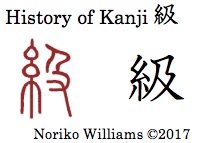 The kanji 級 had 糸and 及, which was used phonetically for /kyuu/. The history of 及 by itself is shown on the right. The image was a person and a hand of another person catching the person in front. The sense of “order” from these two people, front and behind, signified order. With threads added, they originally meant setting up threads in the right order on the loom. From that it was extended to mean “phase; stage.” The kanji級 meant “class; order.”
The kanji 級 had 糸and 及, which was used phonetically for /kyuu/. The history of 及 by itself is shown on the right. The image was a person and a hand of another person catching the person in front. The sense of “order” from these two people, front and behind, signified order. With threads added, they originally meant setting up threads in the right order on the loom. From that it was extended to mean “phase; stage.” The kanji級 meant “class; order.”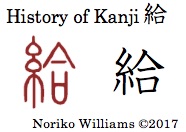 The right side合 of the kanji 給 was used phonetically for /kyuu/ to mean “to fill a gap.” With the left side 糸, they meant “to meet what is deficient.” The kanji 給 meant “to supply.”
The right side合 of the kanji 給 was used phonetically for /kyuu/ to mean “to fill a gap.” With the left side 糸, they meant “to meet what is deficient.” The kanji 給 meant “to supply.”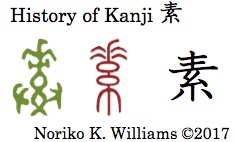 In bronze ware style, in green, the center was a skein of raw silk threads with the top twisted tightly for dyeing, which was handled with two hands from the sides at the bottom. From “threads that were to be dyed” it meant “raw; materials.” In seal style, in red, the two hands were dropped but the tip of the threads remained more prominent, which became the top of the kanji 素. The kanji 素 meant “raw materials; crude; natural.”
In bronze ware style, in green, the center was a skein of raw silk threads with the top twisted tightly for dyeing, which was handled with two hands from the sides at the bottom. From “threads that were to be dyed” it meant “raw; materials.” In seal style, in red, the two hands were dropped but the tip of the threads remained more prominent, which became the top of the kanji 素. The kanji 素 meant “raw materials; crude; natural.”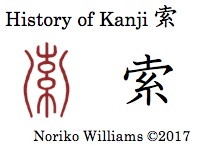 The seal style writing was an apparatus to make a rope by twisting threads or other fibers. Twisting a rope started from the top. Pulling a rope signified searching for something. The kanji 索 meant “to search.”
The seal style writing was an apparatus to make a rope by twisting threads or other fibers. Twisting a rope started from the top. Pulling a rope signified searching for something. The kanji 索 meant “to search.”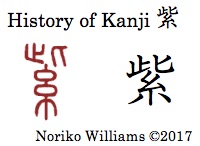 In seal style the top 此 was used phonetically for /shi/, and the bottom 糸 was “thread.” It meant the color in which red and blue were mixed– “purple.” The kanji 紫 meant “purple.”
In seal style the top 此 was used phonetically for /shi/, and the bottom 糸 was “thread.” It meant the color in which red and blue were mixed– “purple.” The kanji 紫 meant “purple.”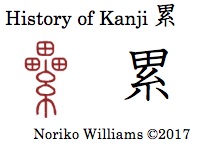 In seal style the top of 纍, three 田, was used phonetically for /rui/ to mean “to accumulate,” and the bottom was 糸 “thread.” Together they meant “to connect; heap up; put one on top of another.” In kanji the top became a single 田 and 糸. The kanji 累 meant “to connect; pile up.”
In seal style the top of 纍, three 田, was used phonetically for /rui/ to mean “to accumulate,” and the bottom was 糸 “thread.” Together they meant “to connect; heap up; put one on top of another.” In kanji the top became a single 田 and 糸. The kanji 累 meant “to connect; pile up.”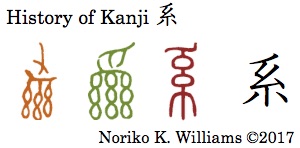 In oracle bone style, in brown, and bronze ware style, a hand at the top was pulling three skeins of threads together. From “pulling things into one” the kanji 系 meant “system; faction; family line; lineage.”
In oracle bone style, in brown, and bronze ware style, a hand at the top was pulling three skeins of threads together. From “pulling things into one” the kanji 系 meant “system; faction; family line; lineage.”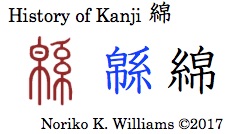 The kanji 綿 has 糸, a bushu itohen, rather than系, but if we look at the seal style writing it was 系, threads that were connected. In seal style the left side 帛 meant “silk cloth.” The right side was a skein of threads tied together. Together they originally meant “silk cloth.” Silk was produced in ancient times but was always expensive. Cotton is believed to have been introduced in China in the late first millennium or the turn of the second millennium. The correct kanji 緜 reflected seal style. When cotton gained popularity, the kanji 綿 came to mean “cotton.”
The kanji 綿 has 糸, a bushu itohen, rather than系, but if we look at the seal style writing it was 系, threads that were connected. In seal style the left side 帛 meant “silk cloth.” The right side was a skein of threads tied together. Together they originally meant “silk cloth.” Silk was produced in ancient times but was always expensive. Cotton is believed to have been introduced in China in the late first millennium or the turn of the second millennium. The correct kanji 緜 reflected seal style. When cotton gained popularity, the kanji 綿 came to mean “cotton.” In oracle bone style and bronze ware style, the left side was a child, and the right bottom was a skein of threads. A thread is long and continuous. With a child together they meant “offspring; grandchild.” In seal style the right side became 系 “lineage.” The kanji 孫 meant “grandchild; offspring.”
In oracle bone style and bronze ware style, the left side was a child, and the right bottom was a skein of threads. A thread is long and continuous. With a child together they meant “offspring; grandchild.” In seal style the right side became 系 “lineage.” The kanji 孫 meant “grandchild; offspring.”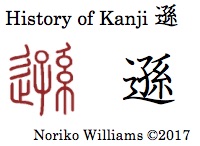 In seal style the left side辵 meant “to go forward.” The center and the right side together, 孫, was used phonetically for /son/. It originally meant “to back off,” then was borrowed to mean “to humble oneself; condescend.”
In seal style the left side辵 meant “to go forward.” The center and the right side together, 孫, was used phonetically for /son/. It originally meant “to back off,” then was borrowed to mean “to humble oneself; condescend.” In seal style the left side イwas a person standing, and the right side was the kanji 系, “connection.” From “someone who was connecting matters,” it meant “a person in charge; relationship.”
In seal style the left side イwas a person standing, and the right side was the kanji 系, “connection.” From “someone who was connecting matters,” it meant “a person in charge; relationship.”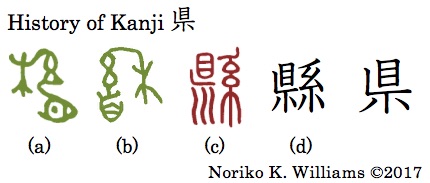 The origin of the kanji 県 is a gruesome one. In (a) and (b) in bronze ware style it was comprised of three elements: A tree and a rope to which a head was attached. It was the severed head of someone who was executed for a crime. The gruesome origin was dropped, and it meant “to hang down.” In seal style (c) the left side was a head upside done with the hair hanging, and the right side 系retained the original meaning of a rope attached to something, even though the tree was dropped. The kyuji (d 縣) reflected seal style, and in shinji, 系 was dropped. The authority that had the power to execute was a jurisdiction. The kanji 県 meant “prefecture.”
The origin of the kanji 県 is a gruesome one. In (a) and (b) in bronze ware style it was comprised of three elements: A tree and a rope to which a head was attached. It was the severed head of someone who was executed for a crime. The gruesome origin was dropped, and it meant “to hang down.” In seal style (c) the left side was a head upside done with the hair hanging, and the right side 系retained the original meaning of a rope attached to something, even though the tree was dropped. The kyuji (d 縣) reflected seal style, and in shinji, 系 was dropped. The authority that had the power to execute was a jurisdiction. The kanji 県 meant “prefecture.”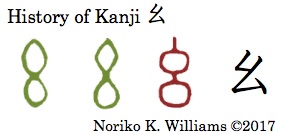 In this post we are going to look at kanji that contain幺 “skein of threads”–幼玄畜蓄幽率滋慈磁. The history of 幺 is shown on the right. Then we will look at the four kanji that contain 屯 “threads knotted”– 屯純頓鈍.
In this post we are going to look at kanji that contain幺 “skein of threads”–幼玄畜蓄幽率滋慈磁. The history of 幺 is shown on the right. Then we will look at the four kanji that contain 屯 “threads knotted”– 屯純頓鈍.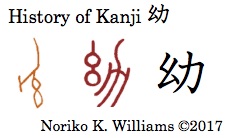 For the kanji 幼 in oracle bone style, in brown, it was a skein of threads with a long stick that was used to twist the threads. Shirakawa wrote that it was the original shape for the kanji 拗 “to twist” (a non-Joyo kanji), and was borrowed to mean “very young; immature.” On the other hand Setsumon 2000 years ago explained the origin to be 幺 and 力. Oracle bones were first entered into scholarly discussion at the very end of the 19th century so Setsumon’s account naturally did not take oracle bone writing into consideration. Nonetheless Setsumon’s account still influences many kanji dictionaries today. For instance, the Kadokawa dictionary and Kanjigen followed Setsumon’s account — with 幺 “fine small thread,” phonetically for /yoo/, and 力 “power” together, they meant “fragile, young child.” This view does not explain the oracle bone style writing shown above. In the Key to Kanji (2010) I took the latter view.
For the kanji 幼 in oracle bone style, in brown, it was a skein of threads with a long stick that was used to twist the threads. Shirakawa wrote that it was the original shape for the kanji 拗 “to twist” (a non-Joyo kanji), and was borrowed to mean “very young; immature.” On the other hand Setsumon 2000 years ago explained the origin to be 幺 and 力. Oracle bones were first entered into scholarly discussion at the very end of the 19th century so Setsumon’s account naturally did not take oracle bone writing into consideration. Nonetheless Setsumon’s account still influences many kanji dictionaries today. For instance, the Kadokawa dictionary and Kanjigen followed Setsumon’s account — with 幺 “fine small thread,” phonetically for /yoo/, and 力 “power” together, they meant “fragile, young child.” This view does not explain the oracle bone style writing shown above. In the Key to Kanji (2010) I took the latter view.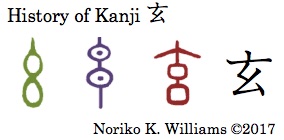 For the kanji 玄, the bronze ware style writing was the same as 糸 “skein of threads.” The Old style writing that predated seal style, in purple, had dots inside the skein, possibly indicating that it was not raw color. The seal style writing, in red, was a skein of threads with an apparatus for dyeing at the top. Threads that were dyed dark meant “deep color; black.” In Japanese the meaning was applied to a person–someone who became skilled by experience.
For the kanji 玄, the bronze ware style writing was the same as 糸 “skein of threads.” The Old style writing that predated seal style, in purple, had dots inside the skein, possibly indicating that it was not raw color. The seal style writing, in red, was a skein of threads with an apparatus for dyeing at the top. Threads that were dyed dark meant “deep color; black.” In Japanese the meaning was applied to a person–someone who became skilled by experience. For the kanji 畜 the oracle bone style writing was a skein of threads that was tied at the top (玄) and an urn that contained dye (田) at the bottom. In Old style there were two skeins, signifying many skeins together. They were soaked in an urn of dye for some length of time. Leaving the skeins in the urn to pick up the color originally meant “to keep; accumulate.” Animals were kept inside a fence, and it came to be used to mean “animal; livestock.” The kanji 畜 means “animal; beast.”
For the kanji 畜 the oracle bone style writing was a skein of threads that was tied at the top (玄) and an urn that contained dye (田) at the bottom. In Old style there were two skeins, signifying many skeins together. They were soaked in an urn of dye for some length of time. Leaving the skeins in the urn to pick up the color originally meant “to keep; accumulate.” Animals were kept inside a fence, and it came to be used to mean “animal; livestock.” The kanji 畜 means “animal; beast.”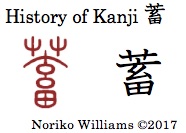 For the kanji 蓄 the seal style writing had 艸 “plant” at the top and 畜 “accumulate.” Together they originally signified “to accumulate or pile up plants.” From accumulating or piling up things, it meant “to store; save.” The kanji 蓄 means “to save up; stock up; learn.”
For the kanji 蓄 the seal style writing had 艸 “plant” at the top and 畜 “accumulate.” Together they originally signified “to accumulate or pile up plants.” From accumulating or piling up things, it meant “to store; save.” The kanji 蓄 means “to save up; stock up; learn.”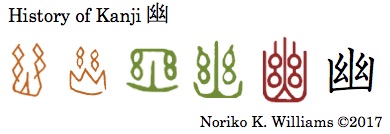 For the kanji 幽 in oracle bone style and bronze ware style, it had skeins of threads (the two 幺) on top of a fire for smoking. Smoke dyed threads darkened gradually. The smoking room was dark and visibility was obscured. The kanji 幽 meant “dark; subtle and profound; obscure.”
For the kanji 幽 in oracle bone style and bronze ware style, it had skeins of threads (the two 幺) on top of a fire for smoking. Smoke dyed threads darkened gradually. The smoking room was dark and visibility was obscured. The kanji 幽 meant “dark; subtle and profound; obscure.”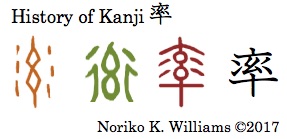 The kanji 率 was a bundle of wet threads being wrung tightly. In oracle bone style the six dots were water droplets. In seal style both ends of the skein had an apparatus to wring. Wringing a bundle of threads tightly gave the meaning of “pulling many things into one strongly” and was applied to people too to mean “to lead; head a party of people.” It was also used to mean “rate.” The kanji 率 means “to lead or head a party of people; rate.”
The kanji 率 was a bundle of wet threads being wrung tightly. In oracle bone style the six dots were water droplets. In seal style both ends of the skein had an apparatus to wring. Wringing a bundle of threads tightly gave the meaning of “pulling many things into one strongly” and was applied to people too to mean “to lead; head a party of people.” It was also used to mean “rate.” The kanji 率 means “to lead or head a party of people; rate.”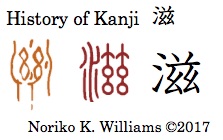 For The kanji 滋, the oracle bone style writing had two skeins of thread in the middle of running water. The seal style had water on the left, and the right side was 茲 “(plant) to grow thick; rampart,” which was phonetically used for /ji/. Together they meant “to become moistened; profit; flourish.”
For The kanji 滋, the oracle bone style writing had two skeins of thread in the middle of running water. The seal style had water on the left, and the right side was 茲 “(plant) to grow thick; rampart,” which was phonetically used for /ji/. Together they meant “to become moistened; profit; flourish.” For the kanji 慈, the bronze ware style writing had two 幺, which was used phonetically for /ji/ and 心 “heart.” In seal style it was茲 and 心. Together they meant “to nurture a child; treat tenderly.”
For the kanji 慈, the bronze ware style writing had two 幺, which was used phonetically for /ji/ and 心 “heart.” In seal style it was茲 and 心. Together they meant “to nurture a child; treat tenderly.”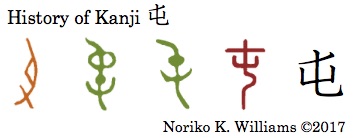 For the kanji 屯in oracle bone style and in bronze ware style it was the knotted end of threads in woven fabric. Pulling many threads together into one also meant a place where many people congregate, such as “camp; barracks of soldiers.”
For the kanji 屯in oracle bone style and in bronze ware style it was the knotted end of threads in woven fabric. Pulling many threads together into one also meant a place where many people congregate, such as “camp; barracks of soldiers.” For the kanji 純 the two bronze ware style writings were same as those of 屯. In seal style 糸 “skein of threads” was added. A knot of threads of same quality meant “pure.”
For the kanji 純 the two bronze ware style writings were same as those of 屯. In seal style 糸 “skein of threads” was added. A knot of threads of same quality meant “pure.”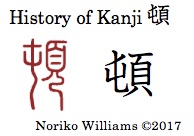 In 頓 the left side of the seal style writing (屯) was “knotted end of threads; fringe” that hangs down. The right side (頁) was a person with headgear in formal attire, and it meant “head.” Together a kneeling person in a formal attire bowed his head down to the ground. The kanji 頓 meant “to make deep bow; prostrate oneself.”
In 頓 the left side of the seal style writing (屯) was “knotted end of threads; fringe” that hangs down. The right side (頁) was a person with headgear in formal attire, and it meant “head.” Together a kneeling person in a formal attire bowed his head down to the ground. The kanji 頓 meant “to make deep bow; prostrate oneself.” For the kanji 鈍, the left side (金) was “metal.” The right side (屯) “knotted end of threads; fringe” signified something round. Cutlery whose blade is not sharp (that is “round”) is “dull; blunt.” Applied to a person, it meant “dumb; slow.” The kanji 鈍 meant “dull; bunt; dumb; slow.”
For the kanji 鈍, the left side (金) was “metal.” The right side (屯) “knotted end of threads; fringe” signified something round. Cutlery whose blade is not sharp (that is “round”) is “dull; blunt.” Applied to a person, it meant “dumb; slow.” The kanji 鈍 meant “dull; bunt; dumb; slow.” For the kanji 衣, in oracle bone style, in brown, bronze ware style, in green, and seal style, in red, it was a single image of a collar — the top was the back of a collar that would be behind one’s neck and the bottom was the front part of a collar where two front sections of clothes were folded in a V-shape. In kanji a back collar became 亠 and a front collar became rather complex. (Please see the stroke order at the bottom of this post.) The kanji 衣 meant “clothes.”
For the kanji 衣, in oracle bone style, in brown, bronze ware style, in green, and seal style, in red, it was a single image of a collar — the top was the back of a collar that would be behind one’s neck and the bottom was the front part of a collar where two front sections of clothes were folded in a V-shape. In kanji a back collar became 亠 and a front collar became rather complex. (Please see the stroke order at the bottom of this post.) The kanji 衣 meant “clothes.”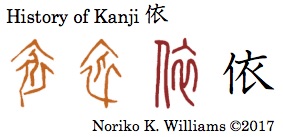 For the kanji 依 in oracle bone style the two writing samples had a standing person inside a collar. A person was protected by clothes, and being inside someone’s protection meant “to depend.” In seal style the person was taken out of the collar and was placed to the left side, which became イ, a bush ninben. The kanji 依 means “to depend; follow.”
For the kanji 依 in oracle bone style the two writing samples had a standing person inside a collar. A person was protected by clothes, and being inside someone’s protection meant “to depend.” In seal style the person was taken out of the collar and was placed to the left side, which became イ, a bush ninben. The kanji 依 means “to depend; follow.”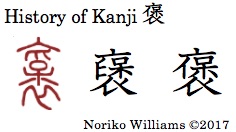 The oracle bone style writing of the kanji 褒 had a collar split to the top and the bottom, and a middle. In the middle was a hand holding a baby wrapped in diapers, used phonetically for /hu/ (孚) and /hoo/ to mean “to wrap loosely.” Together they meant “robe.” In the kyuji 襃 the collar 衣 was split into two parts, a back collar (亠) and a frontal collar, and the middle changed to 保. Later it was borrowed to mean “to praise; commend.” The kanji 褒 means “to praise; commend.”
The oracle bone style writing of the kanji 褒 had a collar split to the top and the bottom, and a middle. In the middle was a hand holding a baby wrapped in diapers, used phonetically for /hu/ (孚) and /hoo/ to mean “to wrap loosely.” Together they meant “robe.” In the kyuji 襃 the collar 衣 was split into two parts, a back collar (亠) and a frontal collar, and the middle changed to 保. Later it was borrowed to mean “to praise; commend.” The kanji 褒 means “to praise; commend.”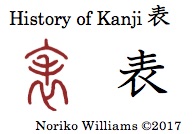 The seal style writing had a collar inside which had animal fur. Fur clothes were worn with the fur side out. From that the kanji 表 meant “outside.” Something that is outside becomes “public.” What is shown is “in front” of something. What is seen is the “surface” of something. Something that is shown to be understood at first sight is a “table.” The kanji 表 means “outside; surface; public; front; table.”
The seal style writing had a collar inside which had animal fur. Fur clothes were worn with the fur side out. From that the kanji 表 meant “outside.” Something that is outside becomes “public.” What is shown is “in front” of something. What is seen is the “surface” of something. Something that is shown to be understood at first sight is a “table.” The kanji 表 means “outside; surface; public; front; table.” For the kanji 裏 in bronze ware style (a) had 田 “rice paddies” and 土 “dirt,” which was phonetically /ri/. In (b) 里 was placed inside a collar. From “the inside of clothes” it meant “wrong side; inside; hidden.” In (c) in seal style 里 was placed in 衣 which was split up to the top and the bottom. The kanji 裏 means “wrong side; back; inside; hidden.”
For the kanji 裏 in bronze ware style (a) had 田 “rice paddies” and 土 “dirt,” which was phonetically /ri/. In (b) 里 was placed inside a collar. From “the inside of clothes” it meant “wrong side; inside; hidden.” In (c) in seal style 里 was placed in 衣 which was split up to the top and the bottom. The kanji 裏 means “wrong side; back; inside; hidden.”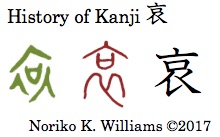 For the kanji 哀 in bronze ware style inside a collar was a mouth. The muffled sound of wailing meant “sorrow.”
For the kanji 哀 in bronze ware style inside a collar was a mouth. The muffled sound of wailing meant “sorrow.”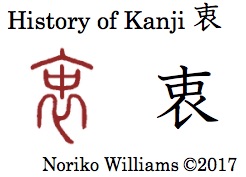 For the kanji 衷 in the seal style 中 “center; inside” in the middle was used phonetically for /chuu/ to mean “center; middle.” What was inside a collar was underclothes worn under outerwear. Underclothes touch one’s skin. What was hidden under clothes was true feelings. The kanji 衷 means “true feeling; genuine sentiment.”
For the kanji 衷 in the seal style 中 “center; inside” in the middle was used phonetically for /chuu/ to mean “center; middle.” What was inside a collar was underclothes worn under outerwear. Underclothes touch one’s skin. What was hidden under clothes was true feelings. The kanji 衷 means “true feeling; genuine sentiment.”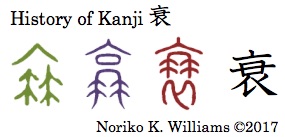 For the kanji 衰 in bronze ware style it was a collar at the top and strands of grass or plants hanging down from the neck. It was a straw raincoat. The Old style writing, in purple, is more descriptive because the wet straws were wilted with rain. It meant “to droop down.” In seal style the drooping straws was placed between the split collar. In kanji the straw became simplified. The kanji 衰 means “to slack; die away; fade; decline.”
For the kanji 衰 in bronze ware style it was a collar at the top and strands of grass or plants hanging down from the neck. It was a straw raincoat. The Old style writing, in purple, is more descriptive because the wet straws were wilted with rain. It meant “to droop down.” In seal style the drooping straws was placed between the split collar. In kanji the straw became simplified. The kanji 衰 means “to slack; die away; fade; decline.”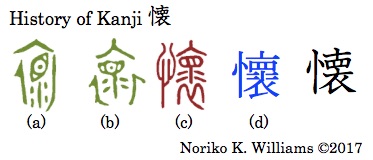 For the kanji 懐 in (a) and (b) in bronze ware style, in green, the top was “back collar.” In the bottom the center was an “eye” and “drops of water coming down,” signifying “tears pouring out,” and the outside was the right and left sides of a front collar. Under a collar there is one’s heart, so together they appear to signify hiding one’s tears or feelings inside. Shirakawa explains that the right side of the kanji 懐 alone, which was phonetically /kai/, meant “grieving for a deceased person at a funeral,” and that the kanji 懐 with a “heart” meant “sentiments and thoughts cherished in one’s mind,” rather than lamenting someone’s death. (c) in seal style, in red, had a heart. On the right side the two sides of a front collar became overlapping. In kyuji (4) 懷, in blue, the tears were still there, and by the shinji 懐 the tears were gone. The kanji 懐 meant “chest; heart; inside jacket; to hold sentiment.”
For the kanji 懐 in (a) and (b) in bronze ware style, in green, the top was “back collar.” In the bottom the center was an “eye” and “drops of water coming down,” signifying “tears pouring out,” and the outside was the right and left sides of a front collar. Under a collar there is one’s heart, so together they appear to signify hiding one’s tears or feelings inside. Shirakawa explains that the right side of the kanji 懐 alone, which was phonetically /kai/, meant “grieving for a deceased person at a funeral,” and that the kanji 懐 with a “heart” meant “sentiments and thoughts cherished in one’s mind,” rather than lamenting someone’s death. (c) in seal style, in red, had a heart. On the right side the two sides of a front collar became overlapping. In kyuji (4) 懷, in blue, the tears were still there, and by the shinji 懐 the tears were gone. The kanji 懐 meant “chest; heart; inside jacket; to hold sentiment.”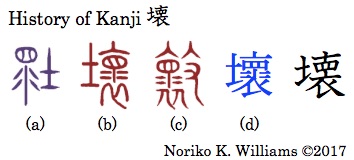 The earliest writing that we have for the kanji 壊 was Old style, (a) in purple on the left, which predated (small) seal style. The left side of (a) had an eye with tears pouring down, which was used phonetically for /kai/, and the right side was a mound of soil (土) that signified celebrating the god of earth. It is difficult to get the meaning of the kanji 壊 “to break; destroy” from (a). However, in seal style, in red, in (b) the right side was the same as (c) for 懐, but in (c) the right side had 攴 “to hit by hand using a stick.” This would be in line with the current meaning. However, the kyuji (d) took after (b). The kanji 壊 means “to break; destroy; tear.”
The earliest writing that we have for the kanji 壊 was Old style, (a) in purple on the left, which predated (small) seal style. The left side of (a) had an eye with tears pouring down, which was used phonetically for /kai/, and the right side was a mound of soil (土) that signified celebrating the god of earth. It is difficult to get the meaning of the kanji 壊 “to break; destroy” from (a). However, in seal style, in red, in (b) the right side was the same as (c) for 懐, but in (c) the right side had 攴 “to hit by hand using a stick.” This would be in line with the current meaning. However, the kyuji (d) took after (b). The kanji 壊 means “to break; destroy; tear.” Shirakawa proposed a unique explanation. In bronze ware style in (a) “crossroad” on the left and “footprint” at the bottom together signified “to move forward” (This became辵 in (c), and eventually辶, a bushu shinnyoo in kanji.) In both (a) and (b) the top right was a “footprint” and below that was a collar with a circle, signifying “jewel.” Together, Shirakawa explained, the bottom right (which became 袁) was jewel inside a deceased person’s clothes. The top footprint (止) signified the departure of a deceased person for a long journey. From a long journey of a deceased person it meant “far; distant.”
Shirakawa proposed a unique explanation. In bronze ware style in (a) “crossroad” on the left and “footprint” at the bottom together signified “to move forward” (This became辵 in (c), and eventually辶, a bushu shinnyoo in kanji.) In both (a) and (b) the top right was a “footprint” and below that was a collar with a circle, signifying “jewel.” Together, Shirakawa explained, the bottom right (which became 袁) was jewel inside a deceased person’s clothes. The top footprint (止) signified the departure of a deceased person for a long journey. From a long journey of a deceased person it meant “far; distant.” For the kanji 園, the inside (袁) was used phonetically for /en/ to mean “spacious; roomy.” The outside (囗) was an enclosure. An enclosure that had a lot of roomy space was a garden or park. The kanji 園 means “park; garden.”
For the kanji 園, the inside (袁) was used phonetically for /en/ to mean “spacious; roomy.” The outside (囗) was an enclosure. An enclosure that had a lot of roomy space was a garden or park. The kanji 園 means “park; garden.”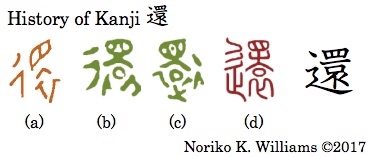 Usually the origin of the kanji 還 is explained as being comprised of “to go” (辶) and that /kan/ was used phonetically to mean “to go around; round.” Together they meant “to go around and return to the beginning.” The kanji 還 means “to return; circle back to the original point.”
Usually the origin of the kanji 還 is explained as being comprised of “to go” (辶) and that /kan/ was used phonetically to mean “to go around; round.” Together they meant “to go around and return to the beginning.” The kanji 還 means “to return; circle back to the original point.”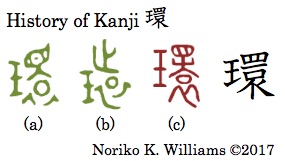 The kanji 環 is usually explained as 王 “jewel” and the right side, which was used phonetically for /kan/ to mean “a ring.” The eye signified to look around. Later on it came to be used for “something round” or “to circle.”
The kanji 環 is usually explained as 王 “jewel” and the right side, which was used phonetically for /kan/ to mean “a ring.” The eye signified to look around. Later on it came to be used for “something round” or “to circle.”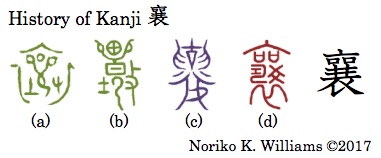 For 襄, (a) in bronze ware style had many things inside a collar. We can see “soil” (土) on the left and a hand on the right, which coincided with (b) – more precisely speaking, (b) had 攴 “action.” What the center was in (a) and (b) is hard to interpret. (b) did not have a collar. In (c) in Old style two hands holding something at the top, and the bottom is not clear other than having a “backward foot.” In (d) in seal style, inside the collar were two 口 “mouths” or “prayer boxes” at the top, and below was a lightning-like shape and 爻 “to mix.” Again no clue for me. The kanji 襄, which is not Joyo kanji, is said to have assorted unrelated meanings — “rich; soft; to squeeze in; face forward; wave off; help; to rise.” Well, a little excursion to the history of 襄 did not produce much, but at least we covered the ground. In fact in all of the four kanji the right side was used phonetically for /joo/ whose meanings may or may not have contributed to the kanji.
For 襄, (a) in bronze ware style had many things inside a collar. We can see “soil” (土) on the left and a hand on the right, which coincided with (b) – more precisely speaking, (b) had 攴 “action.” What the center was in (a) and (b) is hard to interpret. (b) did not have a collar. In (c) in Old style two hands holding something at the top, and the bottom is not clear other than having a “backward foot.” In (d) in seal style, inside the collar were two 口 “mouths” or “prayer boxes” at the top, and below was a lightning-like shape and 爻 “to mix.” Again no clue for me. The kanji 襄, which is not Joyo kanji, is said to have assorted unrelated meanings — “rich; soft; to squeeze in; face forward; wave off; help; to rise.” Well, a little excursion to the history of 襄 did not produce much, but at least we covered the ground. In fact in all of the four kanji the right side was used phonetically for /joo/ whose meanings may or may not have contributed to the kanji.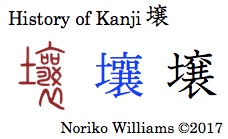 The left side of the seal style of 壌 had “soil” on the left, and the right side was used phonetically for /joo/.
The left side of the seal style of 壌 had “soil” on the left, and the right side was used phonetically for /joo/.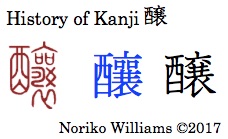 The kanji 醸 had 酉 “rice wine vessel.” The right side 襄 was used phonetically for /joo/ to mean “to put things in,” — together putting rice and yeast in a vessel and brewing or fermenting the contents. The kanji 醸 means “to ferment; brew.”
The kanji 醸 had 酉 “rice wine vessel.” The right side 襄 was used phonetically for /joo/ to mean “to put things in,” — together putting rice and yeast in a vessel and brewing or fermenting the contents. The kanji 醸 means “to ferment; brew.”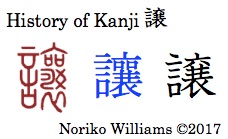 The kanji 譲 had 言 “language; word.” The right side was used phonetically for /joo/ to mean “to blame; condemn.” It was borrowed to mean “to grant; give way; pass on.”
The kanji 譲 had 言 “language; word.” The right side was used phonetically for /joo/ to mean “to blame; condemn.” It was borrowed to mean “to grant; give way; pass on.”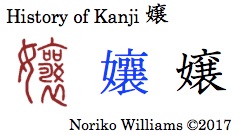 The kanji 嬢 had 女 “female.” The right side was used phonetically for /joo/ to mean “plentiful; abundant.” Together they meant “daughter; young lady.”
The kanji 嬢 had 女 “female.” The right side was used phonetically for /joo/ to mean “plentiful; abundant.” Together they meant “daughter; young lady.” All the ancient styles (oracle bone style, in brown, bronze ware style, in green, and seal style, in red) had the full shape of a collar (衣) on the left side and a knife (刀) on the right side. In order to make clothes, fabric first had to be cut. From that it meant “first time; beginning.” When 衣 appeared on the left side in kanji, it became 衤, a bushu koromohen “clothing.” /Koromo/ is the kun-yomi of the kanji 衣, as we saw last week. The shape 衤 is not to be confused with ネ, a bushu shimesuhen “religious matter,” which is related to the kanji 示 /shimesu/. It is interesting to me to see how the two very different kanji 衣and 示 could end up with such similar shapes as bushu.
All the ancient styles (oracle bone style, in brown, bronze ware style, in green, and seal style, in red) had the full shape of a collar (衣) on the left side and a knife (刀) on the right side. In order to make clothes, fabric first had to be cut. From that it meant “first time; beginning.” When 衣 appeared on the left side in kanji, it became 衤, a bushu koromohen “clothing.” /Koromo/ is the kun-yomi of the kanji 衣, as we saw last week. The shape 衤 is not to be confused with ネ, a bushu shimesuhen “religious matter,” which is related to the kanji 示 /shimesu/. It is interesting to me to see how the two very different kanji 衣and 示 could end up with such similar shapes as bushu.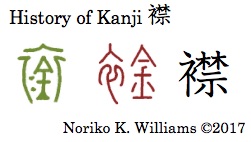 In the bronze ware style of the kanji 襟, inside the wide-open collar was 金, which was used phonetically for /kin/. It meant “collar.” In seal style the same two components 衣 and 金 were placed side by side. In kanji the left side became a bushu koromohen and the right side was replaced by 禁, which was used phonetically for /kin/ to mean “to close.” The kanji 襟 means “collar.”
In the bronze ware style of the kanji 襟, inside the wide-open collar was 金, which was used phonetically for /kin/. It meant “collar.” In seal style the same two components 衣 and 金 were placed side by side. In kanji the left side became a bushu koromohen and the right side was replaced by 禁, which was used phonetically for /kin/ to mean “to close.” The kanji 襟 means “collar.”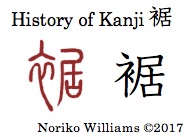 The seal style writing of the kanji 裾 was comprised of koromohen and 居, which was used phonetically for /kyo/. It appears that the meaning was originally inclusive of parts of clothing, such as the hem, the bottom of clothes, the collar, the sleeve and the edge of the front panel of clothes. But now the kanji 裾 is used only for “the bottom of clothes; hem; skirts”
The seal style writing of the kanji 裾 was comprised of koromohen and 居, which was used phonetically for /kyo/. It appears that the meaning was originally inclusive of parts of clothing, such as the hem, the bottom of clothes, the collar, the sleeve and the edge of the front panel of clothes. But now the kanji 裾 is used only for “the bottom of clothes; hem; skirts”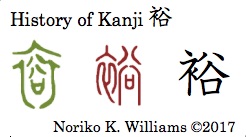 For the kanji 裕 in bronze ware style a collar that was opened wide had 谷. Several kanji that contain谷 are difficult to explain from the origins, because their ancient writings do not appear to have come from the same source. Rather than going into unsolved issues in my mind, I am going to leave it as being used phonetically for “roomy; ample.” Together the original meaning of “roomy; loose clothes” came to be used more generally to mean “leeway; plentiful; room.”
For the kanji 裕 in bronze ware style a collar that was opened wide had 谷. Several kanji that contain谷 are difficult to explain from the origins, because their ancient writings do not appear to have come from the same source. Rather than going into unsolved issues in my mind, I am going to leave it as being used phonetically for “roomy; ample.” Together the original meaning of “roomy; loose clothes” came to be used more generally to mean “leeway; plentiful; room.”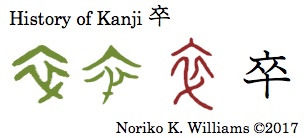 The kanji 卒 has seemingly different meanings, and that may have affected the interpretations of its origin. In both bronze ware style and seal style, it was a collar that had a slanted line. One view is that the slanted line across the right and left front panels of clothes that were closed signified that soldiers wore the same clothes that were given to them. From that the kanji 卒 meant “low-ranking soldiers.” Another view is that a deceased person’s collar was tied so that the spirit would not stray out – thus the slanted line signified “tied tightly.” The kanji 卒meant “sudden death,” and this sudden happening gave the meaning “rash; hasty.” It also meant “to end after one does everything to be done.” The kanji became 亠, two 人 and 十. The kanji 卒 means “low-ranking solder; sudden; to end.”
The kanji 卒 has seemingly different meanings, and that may have affected the interpretations of its origin. In both bronze ware style and seal style, it was a collar that had a slanted line. One view is that the slanted line across the right and left front panels of clothes that were closed signified that soldiers wore the same clothes that were given to them. From that the kanji 卒 meant “low-ranking soldiers.” Another view is that a deceased person’s collar was tied so that the spirit would not stray out – thus the slanted line signified “tied tightly.” The kanji 卒meant “sudden death,” and this sudden happening gave the meaning “rash; hasty.” It also meant “to end after one does everything to be done.” The kanji became 亠, two 人 and 十. The kanji 卒 means “low-ranking solder; sudden; to end.”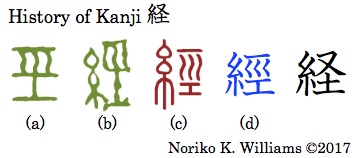 The first kanji is 経. In bronze ware style, (a), a loom that had threads (warps) was placed vertically to the wooden frame. In weaving, warp has to be placed straight so that other threads (the weft) can pass through to make a cloth. So it signified “straight; to go through.” In (b) a skein of threads was added. In (c) in seal style the threads were three wavy lines and the wooden frame became 工 ”craft” at the bottom. The kyuji 經, in blue, reflected seal style. Experience is something one goes through, so it means “experience.” A Buddhist sutra is a long continuous chanting, and the kanji also is used to mean “sutra.” In shinjitai, the right became the kanji 又 and 土. The kanji 経 means “to go through; (time) passes; Buddhist sutra.”
The first kanji is 経. In bronze ware style, (a), a loom that had threads (warps) was placed vertically to the wooden frame. In weaving, warp has to be placed straight so that other threads (the weft) can pass through to make a cloth. So it signified “straight; to go through.” In (b) a skein of threads was added. In (c) in seal style the threads were three wavy lines and the wooden frame became 工 ”craft” at the bottom. The kyuji 經, in blue, reflected seal style. Experience is something one goes through, so it means “experience.” A Buddhist sutra is a long continuous chanting, and the kanji also is used to mean “sutra.” In shinjitai, the right became the kanji 又 and 土. The kanji 経 means “to go through; (time) passes; Buddhist sutra.”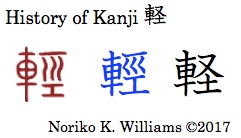 For the kanji 軽 in seal style the left side was a “wheel; military vehicle.” The right side 巠 was used phonetically for /kee/ to mean “light.” It meant a military vehicle that was not transporting heavy equipment. From that it meant “light.” The kyuji 輕 reflected seal style.
For the kanji 軽 in seal style the left side was a “wheel; military vehicle.” The right side 巠 was used phonetically for /kee/ to mean “light.” It meant a military vehicle that was not transporting heavy equipment. From that it meant “light.” The kyuji 輕 reflected seal style.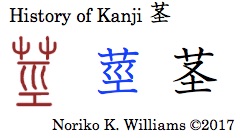 For the kanji 茎 the seal style writing was comprised of 艸 “plant; grass” and 巠 “something straight across.” The part of a plant that was straight was a stem. It meant “stem.” The kanji 茎 means “stem; stalk.”
For the kanji 茎 the seal style writing was comprised of 艸 “plant; grass” and 巠 “something straight across.” The part of a plant that was straight was a stem. It meant “stem.” The kanji 茎 means “stem; stalk.”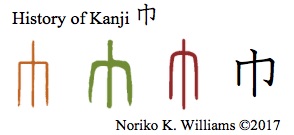 For the kanji 巾 in all the three ancient writing styles (oracle bone, in brown; bronze ware, in green; and seal, in red) and the kanji, it basically remained the same shape. It was a piece of ceremonial scarf that was worn around the waist by a man. From that it meant “a piece of cloth.”
For the kanji 巾 in all the three ancient writing styles (oracle bone, in brown; bronze ware, in green; and seal, in red) and the kanji, it basically remained the same shape. It was a piece of ceremonial scarf that was worn around the waist by a man. From that it meant “a piece of cloth.”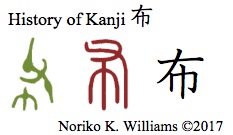 For the kanji 布, in bronze ware style it had a hand holding an axe or a rock at the top, which was used phonetically for /hu/ to mean “to pound.” Our reader may recognize this shape as the bronze ware style writing of the kanji 父 “father.” (A person holding an important axe or a rock in his hand was a father or paternal head.) Underneath was 巾 “cloth or scarf that a man wore around the waist.” In ancient times before cotton was introduced cloth was made of fibrous stems and stalks of a plant such as hemp by pounding it flat with a stone. The kanji 布 meant “cloth.” A piece of cloth covered a wide area, and it also meant “to spread.” The kanji 布 means “cloth; to lay flat; spread.”
For the kanji 布, in bronze ware style it had a hand holding an axe or a rock at the top, which was used phonetically for /hu/ to mean “to pound.” Our reader may recognize this shape as the bronze ware style writing of the kanji 父 “father.” (A person holding an important axe or a rock in his hand was a father or paternal head.) Underneath was 巾 “cloth or scarf that a man wore around the waist.” In ancient times before cotton was introduced cloth was made of fibrous stems and stalks of a plant such as hemp by pounding it flat with a stone. The kanji 布 meant “cloth.” A piece of cloth covered a wide area, and it also meant “to spread.” The kanji 布 means “cloth; to lay flat; spread.”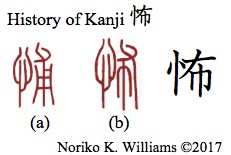 For the kanji 怖 in seal style, (a) was comprised of 心 “heart” and 甫, which was used phonetically for /hu/ to mean “fear,” whereas (b) was comprised of 心 “heart” and 布, which was also used phonetically for /hu/ to mean “fear.” (a) became the kanji 怖 in which “heart” became a bushu risshinben “heart.” The kanji 怖 means “afraid; frightening; terrifying; fear.”
For the kanji 怖 in seal style, (a) was comprised of 心 “heart” and 甫, which was used phonetically for /hu/ to mean “fear,” whereas (b) was comprised of 心 “heart” and 布, which was also used phonetically for /hu/ to mean “fear.” (a) became the kanji 怖 in which “heart” became a bushu risshinben “heart.” The kanji 怖 means “afraid; frightening; terrifying; fear.”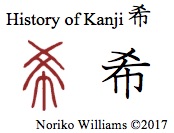
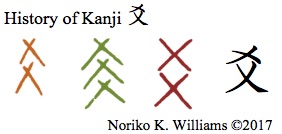 In seal style the top meant “to mix.” The history of the shape 爻 is shown on the right. Many threads crossing made woven cloth. Fine thin woven cloth would have a light coming through between threads, and thinness signified “rare.” The bottom, 巾, was a piece of cloth. Together they meant something that was “rare.” One makes a “wish” for something that is not commonly around. The kanji 希 means “wish; to beseech; rare.”
In seal style the top meant “to mix.” The history of the shape 爻 is shown on the right. Many threads crossing made woven cloth. Fine thin woven cloth would have a light coming through between threads, and thinness signified “rare.” The bottom, 巾, was a piece of cloth. Together they meant something that was “rare.” One makes a “wish” for something that is not commonly around. The kanji 希 means “wish; to beseech; rare.”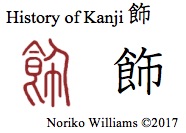 In the seal style writing of the kanji 飾, 食 “eat; food” and 人 “person” together were used phonetically for /shoku/ and meant someone at a banquet table. With 巾 “cloth” below added, they originally meant “to wipe” (dishes). Wiping something with a piece of cloth meant to make it clean or pretty. Thee kanji 飾 meant “to decorate; embellish.”
In the seal style writing of the kanji 飾, 食 “eat; food” and 人 “person” together were used phonetically for /shoku/ and meant someone at a banquet table. With 巾 “cloth” below added, they originally meant “to wipe” (dishes). Wiping something with a piece of cloth meant to make it clean or pretty. Thee kanji 飾 meant “to decorate; embellish.”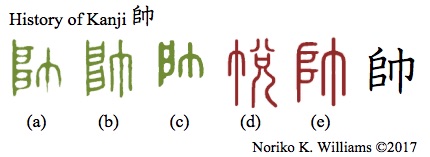 For the kanji 帥 in bronze ware style writings, (a), (b) and (c) was “a door or panel to open a family altar,” and the right side 巾 was “cloth.” Together wiping one’s family altar signified one following a god, and an exemplar. The flipside of following someone was “to lead; to take command.” [Shirakawa] The kanji 帥 means “general; commander.” In seal style (d) was a piece of cloth for a woman. In (e) the left side became simplified. Another view [Kadokawa dictionary] takes the left side of 帥 as signifying “band of people,” and together with 巾 “flag,” they meant commanding a troop with a flag.
For the kanji 帥 in bronze ware style writings, (a), (b) and (c) was “a door or panel to open a family altar,” and the right side 巾 was “cloth.” Together wiping one’s family altar signified one following a god, and an exemplar. The flipside of following someone was “to lead; to take command.” [Shirakawa] The kanji 帥 means “general; commander.” In seal style (d) was a piece of cloth for a woman. In (e) the left side became simplified. Another view [Kadokawa dictionary] takes the left side of 帥 as signifying “band of people,” and together with 巾 “flag,” they meant commanding a troop with a flag.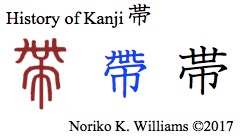 For the kanji 帯 the top of the seal style writing was a belt with accessory, and the bottom was a cloth in front, such as an apron. A rope that helped to keep clothes on was a “sash.” A sash is something you put on yourself. From that it also meant “to have on oneself.” The top of the kyuji 帶 was slightly simplified. The kanji 帯 also meant a “long, narrow stretch of area; strip; sash.”
For the kanji 帯 the top of the seal style writing was a belt with accessory, and the bottom was a cloth in front, such as an apron. A rope that helped to keep clothes on was a “sash.” A sash is something you put on yourself. From that it also meant “to have on oneself.” The top of the kyuji 帶 was slightly simplified. The kanji 帯 also meant a “long, narrow stretch of area; strip; sash.”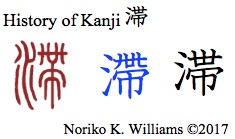 For the kanji 滞 the seal style writing was comprised of “water” and 帯, which was used phonetically for /tai/ to mean “belt; strip.” Together “water in an area” gave the meaning “to stagnate,” which further meant “to be delayed; be behindhand with.”
For the kanji 滞 the seal style writing was comprised of “water” and 帯, which was used phonetically for /tai/ to mean “belt; strip.” Together “water in an area” gave the meaning “to stagnate,” which further meant “to be delayed; be behindhand with.”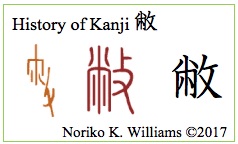 The shape 敝— The next three kanji 幣弊蔽 share the shape 敝. The history of 敝 is shown on the right. In bronze ware style the top left 巾 had two short lines inside, signifying that cloth is worn and torn. The bottom right was a hand holding a stick, signifying an action. In seal style they became 㡀 and攴. The kanji 敝 meant “cloth becomes rag; torn; to break; tire.”
The shape 敝— The next three kanji 幣弊蔽 share the shape 敝. The history of 敝 is shown on the right. In bronze ware style the top left 巾 had two short lines inside, signifying that cloth is worn and torn. The bottom right was a hand holding a stick, signifying an action. In seal style they became 㡀 and攴. The kanji 敝 meant “cloth becomes rag; torn; to break; tire.”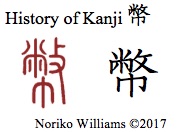 For the kanji 幣 the top 敝 was used phonetically for /hee/. The bottom was 巾 “cloth.” Together they meant “sacred piece of cloth for offering to a god.” An offering was sometimes money. From that the kanji 幣 meant “money.” It is also used to mean strips of hanging paper to mark a sacred area in Shinto to ward off evils.
For the kanji 幣 the top 敝 was used phonetically for /hee/. The bottom was 巾 “cloth.” Together they meant “sacred piece of cloth for offering to a god.” An offering was sometimes money. From that the kanji 幣 meant “money.” It is also used to mean strips of hanging paper to mark a sacred area in Shinto to ward off evils.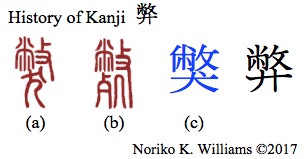 For the kanji 弊 in seal style (a) and (b), the top was 敝, which was used phonetically for /hee/. The bottom of (a) was “dog” (犬), and (b) had “death” (死). A dog was said to have been used for poison testing. Together they meant “to collapse; perish; die; harmful.” The Correct writing (c) reflected (a) with 犬 at the bottom. The kanji 弊 was also used to mean “our (company)” in humble style. The kanji 弊 means “to collapse; to become exhausted; harmful; our (humble),” and is in 疲弊 (”impoverishment; exhaustion” /hihee/), 弊害 (“bad practice; harmful influence” /heegai/) and 語弊がある (“to be misleading” /gohee-ga-a’ru/).
For the kanji 弊 in seal style (a) and (b), the top was 敝, which was used phonetically for /hee/. The bottom of (a) was “dog” (犬), and (b) had “death” (死). A dog was said to have been used for poison testing. Together they meant “to collapse; perish; die; harmful.” The Correct writing (c) reflected (a) with 犬 at the bottom. The kanji 弊 was also used to mean “our (company)” in humble style. The kanji 弊 means “to collapse; to become exhausted; harmful; our (humble),” and is in 疲弊 (”impoverishment; exhaustion” /hihee/), 弊害 (“bad practice; harmful influence” /heegai/) and 語弊がある (“to be misleading” /gohee-ga-a’ru/). The seal style writing of the kanji 蔽 had 艸 “plant; grass” on top of 敝, which was used phonetically for /hee/. They meant that grass grew rampantly and covered or hid things. The kanji 蔽 means “to hide; cover; conceal.”
The seal style writing of the kanji 蔽 had 艸 “plant; grass” on top of 敝, which was used phonetically for /hee/. They meant that grass grew rampantly and covered or hid things. The kanji 蔽 means “to hide; cover; conceal.”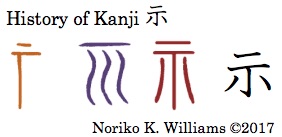 For the kanji 示, in oracle bone style, in brown, it was an altar table with an offering placed above. An altar was where the god showed his message. From that it meant “to show; demonstrate.” In seal style, in red, a line was added on each side of the stand. Setsumon’s explanation of these three lines was the sun, the moon and a star by which the god showed himself to people.
For the kanji 示, in oracle bone style, in brown, it was an altar table with an offering placed above. An altar was where the god showed his message. From that it meant “to show; demonstrate.” In seal style, in red, a line was added on each side of the stand. Setsumon’s explanation of these three lines was the sun, the moon and a star by which the god showed himself to people.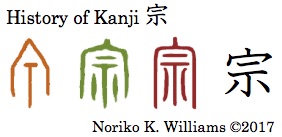 For the kanji 宗, in oracle bone style it was an altar table inside a house or shrine. In bronze ware style, in green, and seal style the altar table had three lines. Together they meant “religious belief,” and “the head or founder of a religious group; group.”
For the kanji 宗, in oracle bone style it was an altar table inside a house or shrine. In bronze ware style, in green, and seal style the altar table had three lines. Together they meant “religious belief,” and “the head or founder of a religious group; group.”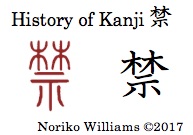 In seal style of the kanji 禁, the top had two trees that signified “forest.” The bottom was “altar table,” signifying something sacred. Together they signified a sacred forest that was forbidden to enter. From that it meant “to prohibit; forbid.”
In seal style of the kanji 禁, the top had two trees that signified “forest.” The bottom was “altar table,” signifying something sacred. Together they signified a sacred forest that was forbidden to enter. From that it meant “to prohibit; forbid.”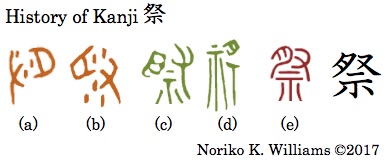 For the kanji 祭, (a) in oracle bone style was comprised of a “hand” on the left sprinkling “rice wine” over an offering of a “piece of meat” on the right to sanctify it. (b) was the mirror image of (a). In (c) and (d) in bronze ware style an altar table replaced the sanctifying rice wine. (e) in seal style remained in kanji. (The top left of the kanji is not タ “moon” but has two short strokes inside, from 肉.) The kanji 祭 meant “celebration; festival.”
For the kanji 祭, (a) in oracle bone style was comprised of a “hand” on the left sprinkling “rice wine” over an offering of a “piece of meat” on the right to sanctify it. (b) was the mirror image of (a). In (c) and (d) in bronze ware style an altar table replaced the sanctifying rice wine. (e) in seal style remained in kanji. (The top left of the kanji is not タ “moon” but has two short strokes inside, from 肉.) The kanji 祭 meant “celebration; festival.” In the seal style writing of the kanji 際, an earthen wall for a boundary was added to the left of 祭 “celebration of a god.” The area where the god and people come to meet was edge of an area; contact. In kanji the left side became simplified to 阝, a bushu kozatohen. The kanji 際 meant “boundary; edge of an area; contact.”
In the seal style writing of the kanji 際, an earthen wall for a boundary was added to the left of 祭 “celebration of a god.” The area where the god and people come to meet was edge of an area; contact. In kanji the left side became simplified to 阝, a bushu kozatohen. The kanji 際 meant “boundary; edge of an area; contact.”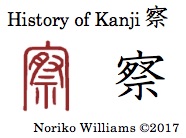 The seal style writing was comprised of 宀 “house” and 祭 “celebration of a god.” In a house that enshrined a god one looked for a god’s will carefully and reflected on it. The religious meaning was dropped and the kanji 察 means “to perceive; look thoroughly; conjecture.”
The seal style writing was comprised of 宀 “house” and 祭 “celebration of a god.” In a house that enshrined a god one looked for a god’s will carefully and reflected on it. The religious meaning was dropped and the kanji 察 means “to perceive; look thoroughly; conjecture.”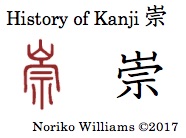 The seal style writing of the kanji 崇 was comprised of 山 “mountain” that signified “high” and 宗, which was used phonetically for /suu/ to mean “main.” Together from the highest mountain in the mountain range, it meant “high; supreme.”
The seal style writing of the kanji 崇 was comprised of 山 “mountain” that signified “high” and 宗, which was used phonetically for /suu/ to mean “main.” Together from the highest mountain in the mountain range, it meant “high; supreme.”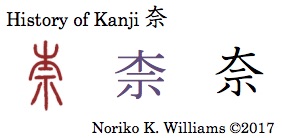 The seal style writing was comprised of 木 “tree” and 示 “altar table.” Together they meant the name of a tree. It was used for an interrogative word. The Correct writing 柰 reflected the seal style, but in kanji the top became 大. The kanji 奈 was used for “how; why” in some kanbun-style writing, but is no longer used except in a very limited word related to Buddhism.
The seal style writing was comprised of 木 “tree” and 示 “altar table.” Together they meant the name of a tree. It was used for an interrogative word. The Correct writing 柰 reflected the seal style, but in kanji the top became 大. The kanji 奈 was used for “how; why” in some kanbun-style writing, but is no longer used except in a very limited word related to Buddhism.
 For the kanji 礼 in (a) in bronze ware style, the top was two strings of cowries strung together or jewelries, and the bottom was a tall container. Together they meant abundant offering to a deity. The two Old style writings, in purple, came from an entirely different origin– (b) was an altar table with the offering on top, and (c) had a person kneeling to worship added on the right side. It meant “propriety (of ceremony).” (d) in seal style was comprised of 示 and 豊, which came from (a). The kyuji 禮, (e), reflected seal style (d), and is still used in formal occasions. The shinji uses 礼, in line with Old style (b) and (c). The kanji 礼 means “propriety; a bow.”
For the kanji 礼 in (a) in bronze ware style, the top was two strings of cowries strung together or jewelries, and the bottom was a tall container. Together they meant abundant offering to a deity. The two Old style writings, in purple, came from an entirely different origin– (b) was an altar table with the offering on top, and (c) had a person kneeling to worship added on the right side. It meant “propriety (of ceremony).” (d) in seal style was comprised of 示 and 豊, which came from (a). The kyuji 禮, (e), reflected seal style (d), and is still used in formal occasions. The shinji uses 礼, in line with Old style (b) and (c). The kanji 礼 means “propriety; a bow.” For the kanji 福, (a) in oracle bone style was comprised of an altar table at the top left and a rice wine cask that was raised by two hands. Placing a full wine cask on the altar, one prayed for blessing from the god. (b) ddid not have two hands. In bronze ware style, (c) and (d) had an altar table and a wine cask that was filled with wine (the cross at the bottom indicated that it was not empty.) In seal style (e) reflected (c), in line with the general arrangement of a semantic-phonetic formation of kanji (keisei-moji) –a left component for meaning and a right component for sound. The kanji 福 meant “blessing; good luck.”
For the kanji 福, (a) in oracle bone style was comprised of an altar table at the top left and a rice wine cask that was raised by two hands. Placing a full wine cask on the altar, one prayed for blessing from the god. (b) ddid not have two hands. In bronze ware style, (c) and (d) had an altar table and a wine cask that was filled with wine (the cross at the bottom indicated that it was not empty.) In seal style (e) reflected (c), in line with the general arrangement of a semantic-phonetic formation of kanji (keisei-moji) –a left component for meaning and a right component for sound. The kanji 福 meant “blessing; good luck.”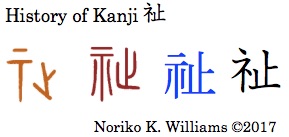 The oracle bone style writing of the kanji 祉 had an altar table for “deity,” and 止 was used phonetically for /shi/ to mean “to remain.” Together they meant “the god’s blessing remained.” The kanji 祉 means “blessing; happiness given by a god,” but in the current Japanese the use is limited to the word 福祉. There is no kun-yomi. The on-yomi /shi/ is in 福祉 (“welfare; well-being” /huku’shi/).
The oracle bone style writing of the kanji 祉 had an altar table for “deity,” and 止 was used phonetically for /shi/ to mean “to remain.” Together they meant “the god’s blessing remained.” The kanji 祉 means “blessing; happiness given by a god,” but in the current Japanese the use is limited to the word 福祉. There is no kun-yomi. The on-yomi /shi/ is in 福祉 (“welfare; well-being” /huku’shi/).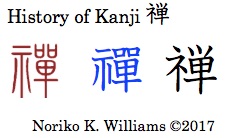 The seal style writing of the kanji 禅 was comprised of an altar table, signifying “worshipping,” and 單, which was used phonetically for /tan; zen/. Together they originally meant a platform or a raised area where a deity was worshipped. Following a god’s will one passed on a throne to someone else peacefully, and it meant “to pass on power peacefully.” Later on it also came to be used to mean a Buddhist sect. In shinji the left side 示 became ネ a bushu shimesuhen. The kanji 禅 means “Zen sect; to vacate a throne (peacefully).”
The seal style writing of the kanji 禅 was comprised of an altar table, signifying “worshipping,” and 單, which was used phonetically for /tan; zen/. Together they originally meant a platform or a raised area where a deity was worshipped. Following a god’s will one passed on a throne to someone else peacefully, and it meant “to pass on power peacefully.” Later on it also came to be used to mean a Buddhist sect. In shinji the left side 示 became ネ a bushu shimesuhen. The kanji 禅 means “Zen sect; to vacate a throne (peacefully).”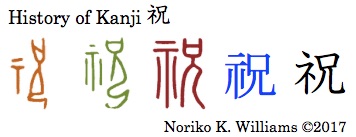 For the kanji 祝 the writing in oracle bone style, bronze were style and seal style all was comprised of 示 “altar table” and 兄 “elder brother; elder person.” Together from an elder person worshipping and celebrating the god, the kanji 祝 meant “to celebrate.”
For the kanji 祝 the writing in oracle bone style, bronze were style and seal style all was comprised of 示 “altar table” and 兄 “elder brother; elder person.” Together from an elder person worshipping and celebrating the god, the kanji 祝 meant “to celebrate.”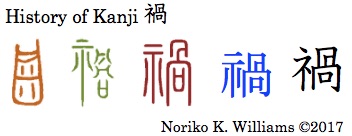 For the kanji 禍 what the shape in oracle bone style was about is not clear. The source from which I have taken this writing (Shirakawa) does not appear to be addressing it. The bronze ware style writing was comprised of an altar table and bones of a deceased (咼). Together they meant “affliction; catastrophe.” The kanji 禍 meant “misfortune; calamity.”
For the kanji 禍 what the shape in oracle bone style was about is not clear. The source from which I have taken this writing (Shirakawa) does not appear to be addressing it. The bronze ware style writing was comprised of an altar table and bones of a deceased (咼). Together they meant “affliction; catastrophe.” The kanji 禍 meant “misfortune; calamity.”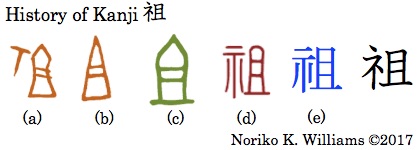 In oracle bone style (a) was an altar table and a stack of similar things. They could be ancestral tombstones or representations of many ancestors to be worshipped at an altar. In (b) and in bronze ware style (c) an altar table disappeared, but in (d) in seal style it reappeared. The kanji 祖 means “ancestor.”
In oracle bone style (a) was an altar table and a stack of similar things. They could be ancestral tombstones or representations of many ancestors to be worshipped at an altar. In (b) and in bronze ware style (c) an altar table disappeared, but in (d) in seal style it reappeared. The kanji 祖 means “ancestor.”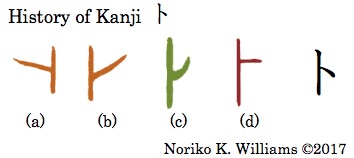 The kanji 卜 is not among the Joyo kanji. But it appeared in many kanji as a component. In oracle bone style (a) and (b), in brown, bronze ware style (c), in green, and seal style (d), in red, the two lines signified cracks (vertical and horizontal) that appeared on a heated underside shell of a turtle or tortoise or a piece of animal bone that was used for divination. On the back of a bone heat was applied to a small hole that had been drilled in advance, and heat cracks that appeared were read as oracle on the topic that a ruler was seeking. The kanji 卜 meant “oracle; divination.”
The kanji 卜 is not among the Joyo kanji. But it appeared in many kanji as a component. In oracle bone style (a) and (b), in brown, bronze ware style (c), in green, and seal style (d), in red, the two lines signified cracks (vertical and horizontal) that appeared on a heated underside shell of a turtle or tortoise or a piece of animal bone that was used for divination. On the back of a bone heat was applied to a small hole that had been drilled in advance, and heat cracks that appeared were read as oracle on the topic that a ruler was seeking. The kanji 卜 meant “oracle; divination.”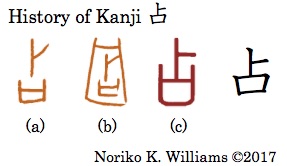 The kanji 占 in oracle bone style (a) was comprisee of a bone with divination cracks (卜), and a mouth (口) at the bottom. In (b), the two components in (a) were in an enclosure. It meant “oracle; divination.” The kanji 占 means “to tell someone’s fortune; divine.” Another interpretation of the bottom 口 is an “area,” which meant asking a deity which area one should take. From that it also meant “to occupy.”
The kanji 占 in oracle bone style (a) was comprisee of a bone with divination cracks (卜), and a mouth (口) at the bottom. In (b), the two components in (a) were in an enclosure. It meant “oracle; divination.” The kanji 占 means “to tell someone’s fortune; divine.” Another interpretation of the bottom 口 is an “area,” which meant asking a deity which area one should take. From that it also meant “to occupy.”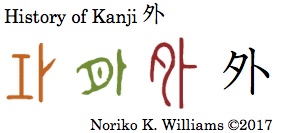 For the kanji 外, the oracle bone style writing had 工, which was probably used phonetically, and 卜 “oracle.” The left side of the bronze ware style writing and seal style writing had an early moon (夕), which would appear outside, or a piece of meat (月) offering for divination. The divination appeared on the surface or outside the bone. The kanji 外 means “outside; exterior,” and its extention “others; else; to take out.”
For the kanji 外, the oracle bone style writing had 工, which was probably used phonetically, and 卜 “oracle.” The left side of the bronze ware style writing and seal style writing had an early moon (夕), which would appear outside, or a piece of meat (月) offering for divination. The divination appeared on the surface or outside the bone. The kanji 外 means “outside; exterior,” and its extention “others; else; to take out.”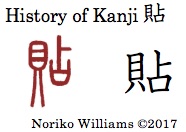 The seal style writing was comprised of 貝 “cowry,” and 占, which was used phonetically for /choo; ten/. Together they meant “to stick on; affix over something.” The kanji 貼 means “to stick; paste.” The kanji 貼 was added to the Joyo kanji in 2010, and before that 張 was used instead.
The seal style writing was comprised of 貝 “cowry,” and 占, which was used phonetically for /choo; ten/. Together they meant “to stick on; affix over something.” The kanji 貼 means “to stick; paste.” The kanji 貼 was added to the Joyo kanji in 2010, and before that 張 was used instead. For the kanji 点, the left side in seal style was the same as 黒 “black,” which had a chimney with soot and two fires. The right side占 was used phonetically for /ten/ to mean “small dot.” Together they signified “small (black) dots.” Adding small points also gave the meaning “score.” The kyuji 點, in blue, had 黑 and 占. In kanji “black” was dropped except the “fire” underneath 占 as a bushu renga/rekka. The kanji 点 means “small dot; point; to add a small note.”
For the kanji 点, the left side in seal style was the same as 黒 “black,” which had a chimney with soot and two fires. The right side占 was used phonetically for /ten/ to mean “small dot.” Together they signified “small (black) dots.” Adding small points also gave the meaning “score.” The kyuji 點, in blue, had 黑 and 占. In kanji “black” was dropped except the “fire” underneath 占 as a bushu renga/rekka. The kanji 点 means “small dot; point; to add a small note.”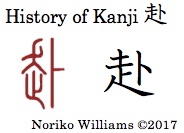 For the kanji 赴, the seal style writing was comprised of 走 “to run,” and 卜, which was used phonetically for /hu/ to mean “the news of someone’s death.” Together they originally meant “to tell” and “to rush in a distance.” From that the kanji 赴 means “to go somewhere at a distance; proceed; head for (a destination).”
For the kanji 赴, the seal style writing was comprised of 走 “to run,” and 卜, which was used phonetically for /hu/ to mean “the news of someone’s death.” Together they originally meant “to tell” and “to rush in a distance.” From that the kanji 赴 means “to go somewhere at a distance; proceed; head for (a destination).”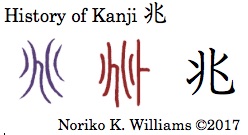 For the kanji 兆 (a) in Old style and (b) in seal style was a pictograph of a oracle bone writing, possibly signifying the whole image of a tortoise shell with cracks. It meant “sign; indication; omen.” 兆 is also used to mean “trillion.”
For the kanji 兆 (a) in Old style and (b) in seal style was a pictograph of a oracle bone writing, possibly signifying the whole image of a tortoise shell with cracks. It meant “sign; indication; omen.” 兆 is also used to mean “trillion.” For the kanji 逃 the bronze ware style writing had a crossroad on the left, and crosses scattered, which was also used phonetically for /too/. The way in which a crack ran through rapidly in divination was similar to soldiers in defeat in a battle running away in all directions. It meant “to run away.” The seal style writing was comprised of 辵 “to move forward” and 兆, which was used phonetically for /choo/. From “a hasty retreat” the kanji 逃 meant “to run away; dodge; evade.”
For the kanji 逃 the bronze ware style writing had a crossroad on the left, and crosses scattered, which was also used phonetically for /too/. The way in which a crack ran through rapidly in divination was similar to soldiers in defeat in a battle running away in all directions. It meant “to run away.” The seal style writing was comprised of 辵 “to move forward” and 兆, which was used phonetically for /choo/. From “a hasty retreat” the kanji 逃 meant “to run away; dodge; evade.”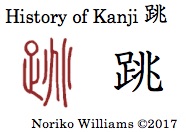 The seal style writing was comprised of 足 “leg” and 兆, which was used phonetically for /choo/ to mean “leaping,” from the manner in which cracks appeared in a heated bone in divination. Together from legs leaping up and down, the kanji 跳 means “to leap; jump.”
The seal style writing was comprised of 足 “leg” and 兆, which was used phonetically for /choo/ to mean “leaping,” from the manner in which cracks appeared in a heated bone in divination. Together from legs leaping up and down, the kanji 跳 means “to leap; jump.”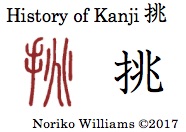 The seal style writing was comprised of “hand”and 兆, which was used phonetically for /choo/ to mean “to bend.” Together they meant a hand bending something forcefully which met a push back. The kanji 挑 means “to challenge; confront; go after.”
The seal style writing was comprised of “hand”and 兆, which was used phonetically for /choo/ to mean “to bend.” Together they meant a hand bending something forcefully which met a push back. The kanji 挑 means “to challenge; confront; go after.”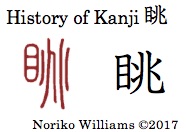 The seal style writing was comprised of 目 “eye” and兆, which was used phonetically for /choo/ to mean “to disperse.” Together they meant “to look at a distance; see.”
The seal style writing was comprised of 目 “eye” and兆, which was used phonetically for /choo/ to mean “to disperse.” Together they meant “to look at a distance; see.” The seal style writing of the kanji 桃 was comprised of 木 “tree” and 兆, which was used phonetically for /too/ to mean something to split in half. Together they meant “peach.”
The seal style writing of the kanji 桃 was comprised of 木 “tree” and 兆, which was used phonetically for /too/ to mean something to split in half. Together they meant “peach.” For the kanji 斉, in (a) in oracle bone style, in brown, (b) and (c) in bronze ware style, in green, and (d) in seal style, in red, there were three beautiful hair accessories of women involved in a religious rite in a uniformly neat appearance. It meant “to be in good order; gather properly.”
For the kanji 斉, in (a) in oracle bone style, in brown, (b) and (c) in bronze ware style, in green, and (d) in seal style, in red, there were three beautiful hair accessories of women involved in a religious rite in a uniformly neat appearance. It meant “to be in good order; gather properly.”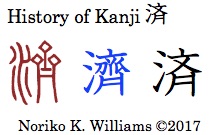 The seal style writing was comprised of “water” and 斉. It was the name of a river. From crossing the river, it was borrowed to mean “to rescue people” and further “to be accomplished.” The kyuji 濟 was simplified to済. The kanji 済 means “to complete; finish up.”
The seal style writing was comprised of “water” and 斉. It was the name of a river. From crossing the river, it was borrowed to mean “to rescue people” and further “to be accomplished.” The kyuji 濟 was simplified to済. The kanji 済 means “to complete; finish up.”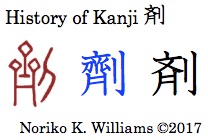 The seal style writing was comprised of 斉 and 刂 “knife.” Together they meant engraving on a bronze ware vessel to inscribe a contract. Later on it was borrowed to mean “medicine.” In kyuji the knife, being used on the right side, became刂, a bushu rittoo “knife.” The kanji 剤 means “medicine; drug.”
The seal style writing was comprised of 斉 and 刂 “knife.” Together they meant engraving on a bronze ware vessel to inscribe a contract. Later on it was borrowed to mean “medicine.” In kyuji the knife, being used on the right side, became刂, a bushu rittoo “knife.” The kanji 剤 means “medicine; drug.”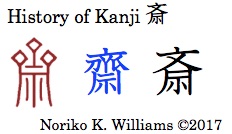 For the kanji 斎the bronze ware style writing was comprised of an altar table added to 斉, which was used phonetically for /sai/ to pertain to religious rite. Together they meant the discrete reverential manner of areligious rite. In seal style the altar table was placed inside 斉. The kanji 斎meant “votive abstinence; .”
For the kanji 斎the bronze ware style writing was comprised of an altar table added to 斉, which was used phonetically for /sai/ to pertain to religious rite. Together they meant the discrete reverential manner of areligious rite. In seal style the altar table was placed inside 斉. The kanji 斎meant “votive abstinence; .” For the kanji 帝, (a) in oracle bone style (b) in bronze ware style, and (c) and (d) in seal style was an altar table that had three crossed legs for stability. It was the most important altar table on which to place offerings for the ancestral gods, in comparison to another alter (示), which was for general meaning of religions matters. A person who was the primary celebrant was an emperor. In kanji the bottom 巾 was probably the remnant of three legs. The kanji 帝 meant “emperor; imperial.”
For the kanji 帝, (a) in oracle bone style (b) in bronze ware style, and (c) and (d) in seal style was an altar table that had three crossed legs for stability. It was the most important altar table on which to place offerings for the ancestral gods, in comparison to another alter (示), which was for general meaning of religions matters. A person who was the primary celebrant was an emperor. In kanji the bottom 巾 was probably the remnant of three legs. The kanji 帝 meant “emperor; imperial.”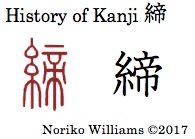 The seal style writing for the kanji 締 was comprised of 糸 “thread,” signifying “tying,” and 帝, which was used phonetically for /tee/. The kanji 締 they meant “to fasten; sign a treaty.”
The seal style writing for the kanji 締 was comprised of 糸 “thread,” signifying “tying,” and 帝, which was used phonetically for /tee/. The kanji 締 they meant “to fasten; sign a treaty.” The seal style writing for the kanji 諦was comprisee of 言 “word; language,” and 帝, which was used phonetically for /tee/. Together they meant “to make clear (with words); reveal the truth.” In Japanese it also means “to resign to one’s fate; despair.” The kanji 諦 means “to resign to one’s fate.”
The seal style writing for the kanji 諦was comprisee of 言 “word; language,” and 帝, which was used phonetically for /tee/. Together they meant “to make clear (with words); reveal the truth.” In Japanese it also means “to resign to one’s fate; despair.” The kanji 諦 means “to resign to one’s fate.”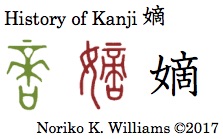 For the kanji 嫡 the bronze ware style writing was the same as 啇. In seal style a woman was added to indicate a line of legitimate heirs to a throne. The kanji 嫡 means “legitimate line.”
For the kanji 嫡 the bronze ware style writing was the same as 啇. In seal style a woman was added to indicate a line of legitimate heirs to a throne. The kanji 嫡 means “legitimate line.” For the kanji 敵, the bronze ware style writing was the same as 啇 “emperor; imperial” or 嫡 “legitimate heir.” In seal style, 攴, a bushu bokuzukuri “to beat; hit,” was added. Someone who attacked an heir was “enemy; foe.” Someone who was an good match to be one’s enemy also gave the meaning “equal to; match; opponent.”
For the kanji 敵, the bronze ware style writing was the same as 啇 “emperor; imperial” or 嫡 “legitimate heir.” In seal style, 攴, a bushu bokuzukuri “to beat; hit,” was added. Someone who attacked an heir was “enemy; foe.” Someone who was an good match to be one’s enemy also gave the meaning “equal to; match; opponent.” For the kanji 適, again, the bronze ware style writing was the same as in 8 and 9. It suggests that all those meanings were once expressed in one writing. In seal style, 辵, the precursors of shinnyo/shinnyu “to move forward; move on.” The right side was used phonetically for /teki/ to mean “a legitimate person.” The meaning of being suitable to conduct worship rites was used for this writing. The writing 適 meant “suitable; to fit.”
For the kanji 適, again, the bronze ware style writing was the same as in 8 and 9. It suggests that all those meanings were once expressed in one writing. In seal style, 辵, the precursors of shinnyo/shinnyu “to move forward; move on.” The right side was used phonetically for /teki/ to mean “a legitimate person.” The meaning of being suitable to conduct worship rites was used for this writing. The writing 適 meant “suitable; to fit.”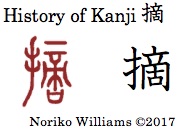 The seal style writing was comprised of扌 “hand” and 啇, which was used phonetically for /teki/. Together they meant a hand picking or plucking something. The kanji 摘 means “to pick; pluck.”
The seal style writing was comprised of扌 “hand” and 啇, which was used phonetically for /teki/. Together they meant a hand picking or plucking something. The kanji 摘 means “to pick; pluck.”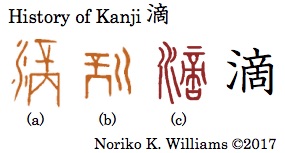 For the kanji 滴 the two writings (a) and (b) in oracle bone style were taken from Akai (2010). In (a) and (b) next to “water” was a tattooing needle and a table or base to place it on, which was the origin of the kanji 商. This puzzles me. Shirakawa (2004) did not list them in 滴. I suspect that it is due to the difference in view on which writings should be taken as for origin of a particular kanji. Generally speaking the writings listed in Akai, a calligrapher and kanji compiler, are in line with Shirakawa’s view, but this is one of very few discrepancies. The seal style writing, (c), was comprised of 氵, a bushu sanzui “water,” and the right side 啇 was used phonetically for /teki/. It is believed to be an onomatopoetic use for the sound of water dripping. The kanji 滴 means “to drop; drip.”
For the kanji 滴 the two writings (a) and (b) in oracle bone style were taken from Akai (2010). In (a) and (b) next to “water” was a tattooing needle and a table or base to place it on, which was the origin of the kanji 商. This puzzles me. Shirakawa (2004) did not list them in 滴. I suspect that it is due to the difference in view on which writings should be taken as for origin of a particular kanji. Generally speaking the writings listed in Akai, a calligrapher and kanji compiler, are in line with Shirakawa’s view, but this is one of very few discrepancies. The seal style writing, (c), was comprised of 氵, a bushu sanzui “water,” and the right side 啇 was used phonetically for /teki/. It is believed to be an onomatopoetic use for the sound of water dripping. The kanji 滴 means “to drop; drip.”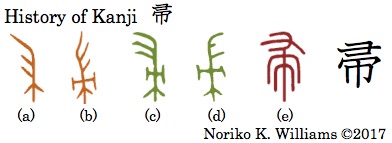 The component 帚 — (a) and (b) in oracle bone style, in brown, and (3) and (4) in bronze ware style, in green, was a broom for sweeping an altar table in an ancestral mausoleum. It has also been interpreted as something that sprinkles rice wine to sanctify offerings. 帚 meant “broom; to sweep; to cleanse.”
The component 帚 — (a) and (b) in oracle bone style, in brown, and (3) and (4) in bronze ware style, in green, was a broom for sweeping an altar table in an ancestral mausoleum. It has also been interpreted as something that sprinkles rice wine to sanctify offerings. 帚 meant “broom; to sweep; to cleanse.”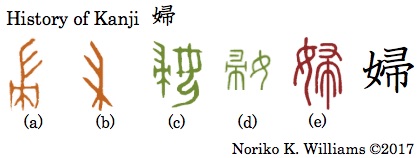 For the kanji 婦, in oracle bone style (a) and (b) were the same as 帚 above, which was a broom for sweeping or cleansing an altar. In bronze ware style, (c) and (d) had a broom on the left and a woman (女) on the right. Together they signified the mistress of a household, who was responsible for keeping an ancestral mausoleum in good order. It originally meant the wife of one’s son. The kanji 婦 means “lady; woman; female.”
For the kanji 婦, in oracle bone style (a) and (b) were the same as 帚 above, which was a broom for sweeping or cleansing an altar. In bronze ware style, (c) and (d) had a broom on the left and a woman (女) on the right. Together they signified the mistress of a household, who was responsible for keeping an ancestral mausoleum in good order. It originally meant the wife of one’s son. The kanji 婦 means “lady; woman; female.” For the kanji 掃, in oracle bone style (a) had a broom and a hand holding it whereas (b) was the same as 帚 “broom; brush” and (a) and (b) in 1. 婦 “woman” above. It meant “a hand sweeping with a broom.” In (d) in seal style, in red, 帚 was used for a secular mundane purpose, and 土 “soil; ground” was added to mean “to sweep the ground; clean.” In kanji, 扌, a bushu tehen –“hand; an act that one does using a hand” — was restored. The kanji 掃 means “to sweep; brush on; broom.”
For the kanji 掃, in oracle bone style (a) had a broom and a hand holding it whereas (b) was the same as 帚 “broom; brush” and (a) and (b) in 1. 婦 “woman” above. It meant “a hand sweeping with a broom.” In (d) in seal style, in red, 帚 was used for a secular mundane purpose, and 土 “soil; ground” was added to mean “to sweep the ground; clean.” In kanji, 扌, a bushu tehen –“hand; an act that one does using a hand” — was restored. The kanji 掃 means “to sweep; brush on; broom.” For the kanji 帰, In (a) and (b) in oracle bone style and (c) in bronze ware style, the left side was a sacrificial meat offering to a deity before a military force went out for a battle. The right was a broom, signifying a purified family altar. Together they originally meant a military force returning to the family mausoleum to give a battle report on a safe return. (e) in bronze ware style and (f) in seal style had a footprint at the bottom left to signify a return. From that it meant “to return home.” The kyuji 歸, (g) in blue, reflected (f) closely. In shinji the left side became two slightly curved lines, perhaps signifying the original two pieces of sacrificial meat offerings. The kanji 帰 means “to return; come/go home; belong to.”
For the kanji 帰, In (a) and (b) in oracle bone style and (c) in bronze ware style, the left side was a sacrificial meat offering to a deity before a military force went out for a battle. The right was a broom, signifying a purified family altar. Together they originally meant a military force returning to the family mausoleum to give a battle report on a safe return. (e) in bronze ware style and (f) in seal style had a footprint at the bottom left to signify a return. From that it meant “to return home.” The kyuji 歸, (g) in blue, reflected (f) closely. In shinji the left side became two slightly curved lines, perhaps signifying the original two pieces of sacrificial meat offerings. The kanji 帰 means “to return; come/go home; belong to.” For the kanji 寝, (a) in oracle bone style and (c) in bronze ware style had a house or family mausoleum, inside of which was a broom or brush. Together they originally meant a mausoleum that was purified. On the other hand, (b) in oracle bone style had a sick bed with a few droplets signifying perspiration on the left, and the right side was a hand holding a broom, which signified a cleansed mausoleum. Together they meant a sick person waking up from in bed with a nightmare. (d) in seal style was very different but had a similar story – inside a mausoleum (a house and a broom) the left side was a bed, and the top right was a medium who was believed to cause a nightmare/dream. An illness was considered something that an evil spirit caused, and purification was necessary. In kyuji 寢, (e), the dream component was dropped, and a hand (又) was added at the bottom. The kanji 寝 means “to sleep.”
For the kanji 寝, (a) in oracle bone style and (c) in bronze ware style had a house or family mausoleum, inside of which was a broom or brush. Together they originally meant a mausoleum that was purified. On the other hand, (b) in oracle bone style had a sick bed with a few droplets signifying perspiration on the left, and the right side was a hand holding a broom, which signified a cleansed mausoleum. Together they meant a sick person waking up from in bed with a nightmare. (d) in seal style was very different but had a similar story – inside a mausoleum (a house and a broom) the left side was a bed, and the top right was a medium who was believed to cause a nightmare/dream. An illness was considered something that an evil spirit caused, and purification was necessary. In kyuji 寢, (e), the dream component was dropped, and a hand (又) was added at the bottom. The kanji 寝 means “to sleep.”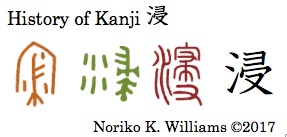 For the kanji 浸, in oracle bone style inside a family mausoleum was a broom shaking drops of sanctifying aromatic liquor. From the aroma of liquor permeating the room strongly, it meant “to soak; immerse.” The kanji 浸 means “to immerse; soak.”
For the kanji 浸, in oracle bone style inside a family mausoleum was a broom shaking drops of sanctifying aromatic liquor. From the aroma of liquor permeating the room strongly, it meant “to soak; immerse.” The kanji 浸 means “to immerse; soak.”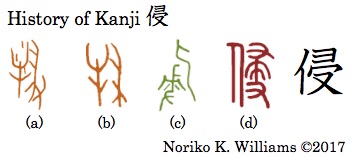 For the kanji 侵, in oracle bone style (a) had an ox with sanctifying liquor droplets on the left and a hand holding a broom on the right. (b) had an ox and a broom only. [Incidentally, (a) and (b) were copied from Akai (2010), but were not included Shirakawa (2004). I suspect that it is possible that Shirakawa treated (a) and (b) belonging to other kanji.] (c) in bronze ware style had a sitting person on the top right and a broom in hand at the bottom. The meaning of 浸 “to permeate; immerse” was adopted for an act people do (signified by イ, a bushu ninben “person; an act that a person does”) in a military sense, and it meant “to invade.”
For the kanji 侵, in oracle bone style (a) had an ox with sanctifying liquor droplets on the left and a hand holding a broom on the right. (b) had an ox and a broom only. [Incidentally, (a) and (b) were copied from Akai (2010), but were not included Shirakawa (2004). I suspect that it is possible that Shirakawa treated (a) and (b) belonging to other kanji.] (c) in bronze ware style had a sitting person on the top right and a broom in hand at the bottom. The meaning of 浸 “to permeate; immerse” was adopted for an act people do (signified by イ, a bushu ninben “person; an act that a person does”) in a military sense, and it meant “to invade.”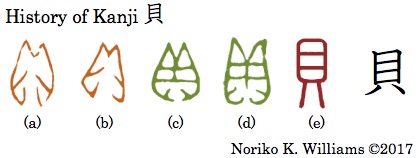 For the kanji 貝, (a) and (b) in oracle bone style, in brown, and (c) and (d) in bronze ware style, in green, was a cowrie, a spiral shell that has an opening in the back. A cowrie was found in the southern sea of China, a long way from the inland where the civilization was situation. It was treasured and valued and was used for an exchange of goods and as money. A majority of kanji that means “value; money” contain a component 貝 “cowry,” as we shall see in a few posts now. By itself the kanji 貝 means “shell; shellfish,” inclusive of all shapes of shells.
For the kanji 貝, (a) and (b) in oracle bone style, in brown, and (c) and (d) in bronze ware style, in green, was a cowrie, a spiral shell that has an opening in the back. A cowrie was found in the southern sea of China, a long way from the inland where the civilization was situation. It was treasured and valued and was used for an exchange of goods and as money. A majority of kanji that means “value; money” contain a component 貝 “cowry,” as we shall see in a few posts now. By itself the kanji 貝 means “shell; shellfish,” inclusive of all shapes of shells.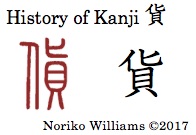 For the kanji 貨, the left side of the seal style writing, in red, was a standing person (イ), and the right side had ヒ as a phonetic feature /ka/ to mean “change” and 貝 “cowrie; valuable.” Together they meant something that could be exchanged as money or for goods. In kanji the top became 化 (“to change” and phonetically /ka/). The kanji 貸 means “goods; money.”
For the kanji 貨, the left side of the seal style writing, in red, was a standing person (イ), and the right side had ヒ as a phonetic feature /ka/ to mean “change” and 貝 “cowrie; valuable.” Together they meant something that could be exchanged as money or for goods. In kanji the top became 化 (“to change” and phonetically /ka/). The kanji 貸 means “goods; money.”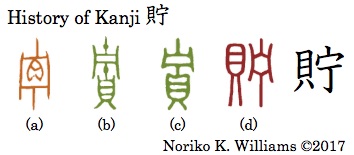 For the kanji 貯 (a) in oracle bone style was a container, the inside of which showed a cowrie. It meant “to store valuable things.” In (b) and (c) in bronze ware style the container and the cowrie became two separate components top and bottom, which were later placed side by side in seal style, (d). Cowries were so important that they were kept in an elaborate bronze ware container called 貯貝器 /choba’iki/. In kanji the right side 丁 seems to be out of place but in fact one of the origins of the kanji 丁 was a square shape. The kanji 貯 means “to save up; lay up; make cash of.”
For the kanji 貯 (a) in oracle bone style was a container, the inside of which showed a cowrie. It meant “to store valuable things.” In (b) and (c) in bronze ware style the container and the cowrie became two separate components top and bottom, which were later placed side by side in seal style, (d). Cowries were so important that they were kept in an elaborate bronze ware container called 貯貝器 /choba’iki/. In kanji the right side 丁 seems to be out of place but in fact one of the origins of the kanji 丁 was a square shape. The kanji 貯 means “to save up; lay up; make cash of.” The top of the seal style writing for the kanji 貢, 工, was used phonetically for /koo/ to mean “product; skilled work,” and the bottom 貝 was “cowrie; money.” Many kinds of products of value were paid as a tribute. The kanji 貢 means “tribute; contribution.”
The top of the seal style writing for the kanji 貢, 工, was used phonetically for /koo/ to mean “product; skilled work,” and the bottom 貝 was “cowrie; money.” Many kinds of products of value were paid as a tribute. The kanji 貢 means “tribute; contribution.”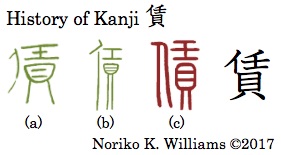 For the kanji 賃, in (a) and (b) in bronze ware style and (c) in seal style the left side and the top of the right side made up 任, which was used phonetically for /jin/ to mean “work.” The bottom right was 貝 “cowrie.” Together they meant paying money to hire a person to do work for wages. The kanji 賃 means “wages.”
For the kanji 賃, in (a) and (b) in bronze ware style and (c) in seal style the left side and the top of the right side made up 任, which was used phonetically for /jin/ to mean “work.” The bottom right was 貝 “cowrie.” Together they meant paying money to hire a person to do work for wages. The kanji 賃 means “wages.”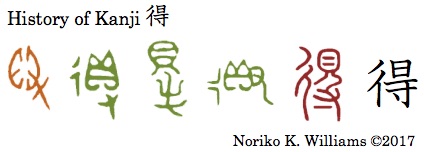 For the kanji 得, (a) in oracle bone style and (c) in bronze ware style had a cowrie and a hand, whereas (b) and (d) in bronze ware style had a crossroad added. Together they mean one going “to obtain something valuable.” In seal style, on the left side a crossroad was added to a cowrie, and a hand was on the right side. From “going out to gain something valuable” it meant “to gain; make a profit.” In kanji the cowrie became a 旦 “sunrise” and a hand became 寸.
For the kanji 得, (a) in oracle bone style and (c) in bronze ware style had a cowrie and a hand, whereas (b) and (d) in bronze ware style had a crossroad added. Together they mean one going “to obtain something valuable.” In seal style, on the left side a crossroad was added to a cowrie, and a hand was on the right side. From “going out to gain something valuable” it meant “to gain; make a profit.” In kanji the cowrie became a 旦 “sunrise” and a hand became 寸. The seal style writing of the kanji 負 had a person with his back bent at the top, and “cowrie,” signifying “money” at the bottom. Together they meant a man carrying something on his back, or a debt, on his bent back. The kanji 負 means “debt; to lose; owe; carry on one’s back.”
The seal style writing of the kanji 負 had a person with his back bent at the top, and “cowrie,” signifying “money” at the bottom. Together they meant a man carrying something on his back, or a debt, on his bent back. The kanji 負 means “debt; to lose; owe; carry on one’s back.”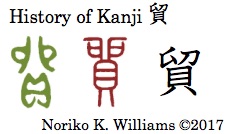 For the kanji 貿 in bronze ware style and seal style, the top was used phonetically for /boo/ to mean “to divide in two,” and the bottom was “cowrie.” Together they signified “to trade goods” The kanji 貿means “to trade.”
For the kanji 貿 in bronze ware style and seal style, the top was used phonetically for /boo/ to mean “to divide in two,” and the bottom was “cowrie.” Together they signified “to trade goods” The kanji 貿means “to trade.” In seal style writing, the kanji 貴 had two hands holding something reverently. The bottom was a cowrie. Together they signified “to handle something valuable carefully.” It means “precious; valuable; of high value.” It is also used for people to mean “noble; august.” The kanji 貴 means “precious; valuable; noble; venerable.”
In seal style writing, the kanji 貴 had two hands holding something reverently. The bottom was a cowrie. Together they signified “to handle something valuable carefully.” It means “precious; valuable; of high value.” It is also used for people to mean “noble; august.” The kanji 貴 means “precious; valuable; noble; venerable.” In bronze ware style, (a) had “two hands holding something carefully” (top), “crossroad” (left) and a cowrie (bottom right). In (b) a hand was at the bottom, and a footprint was added at the bottom left. Together they meant someone leaving something precious behind. In (c), underneath two hands holding a thing carefully, were a crossroad and footprint, which in (d) in seal style became 辵 “to go forward,” a precursor of a bushu shinnyoo. The kanji 遺 means “to leave behind; bequest.”
In bronze ware style, (a) had “two hands holding something carefully” (top), “crossroad” (left) and a cowrie (bottom right). In (b) a hand was at the bottom, and a footprint was added at the bottom left. Together they meant someone leaving something precious behind. In (c), underneath two hands holding a thing carefully, were a crossroad and footprint, which in (d) in seal style became 辵 “to go forward,” a precursor of a bushu shinnyoo. The kanji 遺 means “to leave behind; bequest.”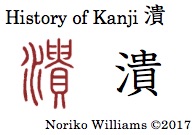 The seal style writing of the kanji 潰 had “water” and 貴, which was used phonetically for /kai/ to mean “to collapse.” Together their ogirinal meaning was “a breach of water; bursting a bank.” It described a forceful destruction such as one made by a collapse of a bank –“collapse; crush; smash.” The kanji 潰 means “a breach of water; collapse; crush.”
The seal style writing of the kanji 潰 had “water” and 貴, which was used phonetically for /kai/ to mean “to collapse.” Together their ogirinal meaning was “a breach of water; bursting a bank.” It described a forceful destruction such as one made by a collapse of a bank –“collapse; crush; smash.” The kanji 潰 means “a breach of water; collapse; crush.”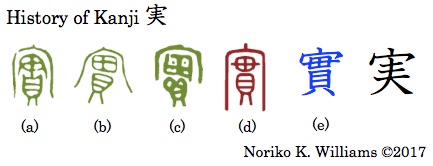 The top of (a) and (b) in bronze ware style, in green, was a house or a family mausoleum. The top of the inside, 毌, meant “small cowries pierced through and strung together,” and the bottom 貝 was “cowrie,” signifying valuable items or money. Valuable offerings at a mausoleum signified fullness of wealth having “substance” and wealth displayed, signifying “real; actual.” It also came to be used to mean “fruit; nut; berry.” The kyuji 實, (e) in blue, reflected (d) in seal style, in red. In shinji 実, the inside of the bushu ukanmuri was replaced by a much simpler shape that had no meaning attached. The kanji 実 means “substance; contents; fruit; nut; berry; contents; reality.”
The top of (a) and (b) in bronze ware style, in green, was a house or a family mausoleum. The top of the inside, 毌, meant “small cowries pierced through and strung together,” and the bottom 貝 was “cowrie,” signifying valuable items or money. Valuable offerings at a mausoleum signified fullness of wealth having “substance” and wealth displayed, signifying “real; actual.” It also came to be used to mean “fruit; nut; berry.” The kyuji 實, (e) in blue, reflected (d) in seal style, in red. In shinji 実, the inside of the bushu ukanmuri was replaced by a much simpler shape that had no meaning attached. The kanji 実 means “substance; contents; fruit; nut; berry; contents; reality.”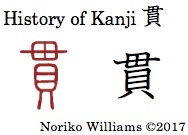 The kanji 貫 was a component of the kyuji of the kanji 実 above, but the earliest writing appears to be in seal style. So I suspect that this kanji was derived from the kanji 實. (If that is the case it is a curious reverse process.) The top 毌 of the seal style writing came from two cowries pierced through, and was used phonetically for /kan/. With the bottom 貝 “cowrie,” they meant “to pierce through; penetrate; carry through.”
The kanji 貫 was a component of the kyuji of the kanji 実 above, but the earliest writing appears to be in seal style. So I suspect that this kanji was derived from the kanji 實. (If that is the case it is a curious reverse process.) The top 毌 of the seal style writing came from two cowries pierced through, and was used phonetically for /kan/. With the bottom 貝 “cowrie,” they meant “to pierce through; penetrate; carry through.”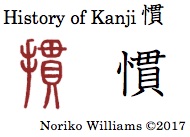 The seal style writing of the kanji 慣 comprised扌, a bushu tehen “hand; an act that one does using a hand,” and 貫, which was used phonetically for /kan/ to mean “linking things.” Together they signified “to accumulate.” Doing things many times makes one’s mind being accustomed to it, and in kanji the left side was replaced by忄, a bushu risshinben “heart.” The kanji 慣 means “to become used to; custom.”
The seal style writing of the kanji 慣 comprised扌, a bushu tehen “hand; an act that one does using a hand,” and 貫, which was used phonetically for /kan/ to mean “linking things.” Together they signified “to accumulate.” Doing things many times makes one’s mind being accustomed to it, and in kanji the left side was replaced by忄, a bushu risshinben “heart.” The kanji 慣 means “to become used to; custom.”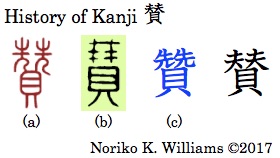 The top of the kanji 賛 in seal style, (a), was used phonetically for /shin; san/ to mean “offer; present.” The bottom was 貝 “cowrie.” Together they meant “to present valuable goods at an audience or meeting.” The kyuji (c) had two 先 at the top, which in kanji was replaced by two 夫. The kanji 賛 means “to present; help; laud.”
The top of the kanji 賛 in seal style, (a), was used phonetically for /shin; san/ to mean “offer; present.” The bottom was 貝 “cowrie.” Together they meant “to present valuable goods at an audience or meeting.” The kyuji (c) had two 先 at the top, which in kanji was replaced by two 夫. The kanji 賛 means “to present; help; laud.” For the kanji 鎖, the left side of the seal style writing was 金 “metal.” The right side comprised small shells at the top (小) and 貝 at the bottom, and was used phonetically for /sa/. Together small metal things linked together meant “chain” and “to lock down.” The top right component小flipped upside down and became a shape called sakasa–shoo “flipped 小.” (This flipping of 小 in shinji happened in other kanji such as 消.) The kanji 鎖 means “chain” and “to lock.”
For the kanji 鎖, the left side of the seal style writing was 金 “metal.” The right side comprised small shells at the top (小) and 貝 at the bottom, and was used phonetically for /sa/. Together small metal things linked together meant “chain” and “to lock down.” The top right component小flipped upside down and became a shape called sakasa–shoo “flipped 小.” (This flipping of 小 in shinji happened in other kanji such as 消.) The kanji 鎖 means “chain” and “to lock.”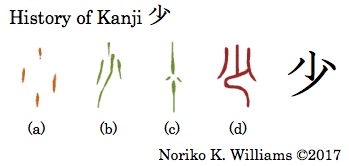 For a long time I treated the origin of 小 as just small markers, rather than having a specific origin. But after going over kanji such as 貫, 鎖, 朋 in the context of cowries that ancient people valued, the account by Shirakawa, which explains that those were small shells, makes some sense to me now.
For a long time I treated the origin of 小 as just small markers, rather than having a specific origin. But after going over kanji such as 貫, 鎖, 朋 in the context of cowries that ancient people valued, the account by Shirakawa, which explains that those were small shells, makes some sense to me now. 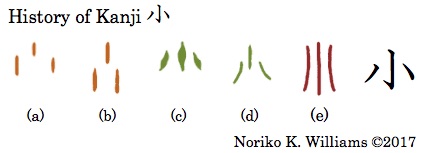 In the bronze ware style writing (b) for the kanji 少, shown on the left, the last long stroke of the kanji is viewed as a string that would have linked the small cowries. The history of the kanji 小 is shown on the right.
In the bronze ware style writing (b) for the kanji 少, shown on the left, the last long stroke of the kanji is viewed as a string that would have linked the small cowries. The history of the kanji 小 is shown on the right.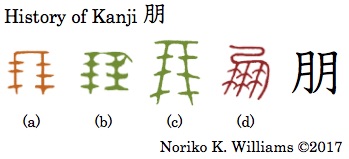 To have a better image of the small cowries that were made into strands, the history of the kanji 朋 shown on the right may be helpful. The kanji 朋is not a Joyo kanji but we are familiar with it because it is used in a given name. In the kanji 豊 “abundance” might have had two strands of cowries that were among offerings on an altar table (Ochiai 2014: 236).
To have a better image of the small cowries that were made into strands, the history of the kanji 朋 shown on the right may be helpful. The kanji 朋is not a Joyo kanji but we are familiar with it because it is used in a given name. In the kanji 豊 “abundance” might have had two strands of cowries that were among offerings on an altar table (Ochiai 2014: 236).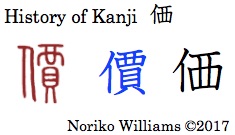 For the kanji 価, the right side in seal style had “person.” The right side 賈 comprised “cover” (襾) and “cowrie” (貝), and was used phonetically for /ka/ to mean “to sell and buy.” A value is something people apply. The kyuji 價 was replaced by 価. The kanji 価 means “value; price.”
For the kanji 価, the right side in seal style had “person.” The right side 賈 comprised “cover” (襾) and “cowrie” (貝), and was used phonetically for /ka/ to mean “to sell and buy.” A value is something people apply. The kyuji 價 was replaced by 価. The kanji 価 means “value; price.”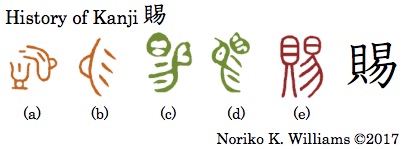 The kanji 賜 is not a daily kanji that we would need at all. It describes an act of giving by royalty. (a) in oracle bone style had a rice wine pitcher pouring wine in a wine cup. An emperor giving a cup of wine out of a wine pitcher called shaku (爵) personally meant “to confer; bestow.” (b) in oracle bone style and (c) and (d) in bronze ware style was for 易. The origin of 易 could have been the sun’s ray and a lizard on the right, but the association is not clear. In seal style (e), 貝 was added to mean a valuable thing. The kanji 賜 means “to bestow; confer.”
The kanji 賜 is not a daily kanji that we would need at all. It describes an act of giving by royalty. (a) in oracle bone style had a rice wine pitcher pouring wine in a wine cup. An emperor giving a cup of wine out of a wine pitcher called shaku (爵) personally meant “to confer; bestow.” (b) in oracle bone style and (c) and (d) in bronze ware style was for 易. The origin of 易 could have been the sun’s ray and a lizard on the right, but the association is not clear. In seal style (e), 貝 was added to mean a valuable thing. The kanji 賜 means “to bestow; confer.”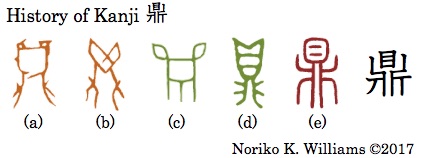 The kanji 鼎 is not a Joyo kanji, but it is the base of many kanji that contain the shape 貝 that meant “three-legged bronze vessel.” It generally had three or four legs at the bottom and two “ears” at the top. It was used to cook various foods together, including sacrificial animal meat. The food in this vessel was prepared to be used as offerings to an ancestral deity. (a) and (b) in oracle bone style, in brown, and (c) in bronze ware style, in green, had the features of “ears” and three or four legs. The top of (d) in bronze ware style and (e) in seal style, in red, became 目.
The kanji 鼎 is not a Joyo kanji, but it is the base of many kanji that contain the shape 貝 that meant “three-legged bronze vessel.” It generally had three or four legs at the bottom and two “ears” at the top. It was used to cook various foods together, including sacrificial animal meat. The food in this vessel was prepared to be used as offerings to an ancestral deity. (a) and (b) in oracle bone style, in brown, and (c) in bronze ware style, in green, had the features of “ears” and three or four legs. The top of (d) in bronze ware style and (e) in seal style, in red, became 目.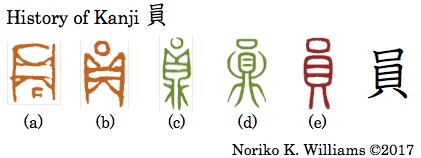 (a) and (b) in oracle bone style and (c) in bronze ware style was a three-or four-legged bronze ware vessel. It was originally used as a counter for such vessels, and later for “number of people” or just “person.” A rounded or square shape at the top was interpreted as a shape of the opening at the top. A three-legged vessel had a rounded opening whereas a four-legged one had a square opening. (e) in seal style kept the opening as a square shape, and the legs became two. The kanji 員 meant “member; staff; people.” It is also used for a word to describe a person’s occupation, or a person who is engaged in that occupation.
(a) and (b) in oracle bone style and (c) in bronze ware style was a three-or four-legged bronze ware vessel. It was originally used as a counter for such vessels, and later for “number of people” or just “person.” A rounded or square shape at the top was interpreted as a shape of the opening at the top. A three-legged vessel had a rounded opening whereas a four-legged one had a square opening. (e) in seal style kept the opening as a square shape, and the legs became two. The kanji 員 meant “member; staff; people.” It is also used for a word to describe a person’s occupation, or a person who is engaged in that occupation.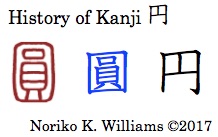 The seal style writing and the kyuji (圓), in blue, had 員, a round top three-legged vessel, inside an enclosure (囗), which signified something all around. It meant “round; circular.” It is also used for the unit of Japanese currency “Japanese yen.” The shinji is 円. The Japanese currency unit (円 /en/ “Japanese yen”), Chinese currency (元yuan), and Korean currency (wong) all originated from the kanji 圓. Japanese yen’s symbol is ¥, a letter “Y” and an equal sign (=) through it.
The seal style writing and the kyuji (圓), in blue, had 員, a round top three-legged vessel, inside an enclosure (囗), which signified something all around. It meant “round; circular.” It is also used for the unit of Japanese currency “Japanese yen.” The shinji is 円. The Japanese currency unit (円 /en/ “Japanese yen”), Chinese currency (元yuan), and Korean currency (wong) all originated from the kanji 圓. Japanese yen’s symbol is ¥, a letter “Y” and an equal sign (=) through it. The seal style writing comprised 扌, a bushu tehen “hand; an act that one does using a hand” and 員 “three-legged bronze ware vessel” to cook food for offering to a deity. Together they meant a hand damaging the contents of a pot or, perhaps, one of the legs. (Those bronze ware vessels were extraordinarily heavy, and we can easily imagine that the legs could have been damaged.) The kanji 損 means “to damage; impair; loss.”
The seal style writing comprised 扌, a bushu tehen “hand; an act that one does using a hand” and 員 “three-legged bronze ware vessel” to cook food for offering to a deity. Together they meant a hand damaging the contents of a pot or, perhaps, one of the legs. (Those bronze ware vessels were extraordinarily heavy, and we can easily imagine that the legs could have been damaged.) The kanji 損 means “to damage; impair; loss.”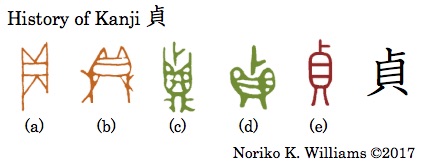 Oracle bone style (a) and (b) was smilar to 員, which was a bronze ware cooking vessel for offerings, and was used phonetically for /tee/ to mean “to inquire about a god’s will; divination.” In bronze ware style (c) and (d) had 卜 “divination” on top of the vessel. It originally meant “to hear the will of a god by divination.” Seeking the god’s will gave the meaning “right; straight; faithful.” The kanji 貞 means “right; upright; faithful.”
Oracle bone style (a) and (b) was smilar to 員, which was a bronze ware cooking vessel for offerings, and was used phonetically for /tee/ to mean “to inquire about a god’s will; divination.” In bronze ware style (c) and (d) had 卜 “divination” on top of the vessel. It originally meant “to hear the will of a god by divination.” Seeking the god’s will gave the meaning “right; straight; faithful.” The kanji 貞 means “right; upright; faithful.”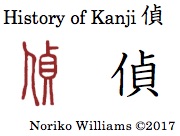 The seal style writing comprised イ “person” and 貞, which was used phonetially for /tee/ to mean “to listen to deity’s voice; inquire.” Together they meant a person investigating carefully by listening and inquiring. The kanji 貞 means “right; straight; faithful.”
The seal style writing comprised イ “person” and 貞, which was used phonetially for /tee/ to mean “to listen to deity’s voice; inquire.” Together they meant a person investigating carefully by listening and inquiring. The kanji 貞 means “right; straight; faithful.”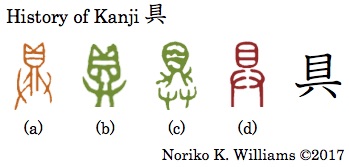 (a) in oracle bone style and (b) and (c) in bronze ware style had a bronze ware vessel at the top and two hands held up at the bottom. Together a vessel that was full of offerings of food was held out reverentially with both hands. Two upward hands generally signified reverence or a polite act. Full contents of a vessel gave the meaning “contents” and also “being amply provided.” In (d) in seal style the legs dissappeared. The kanji 具 means “contents; to be amply provided (often in a set).”
(a) in oracle bone style and (b) and (c) in bronze ware style had a bronze ware vessel at the top and two hands held up at the bottom. Together a vessel that was full of offerings of food was held out reverentially with both hands. Two upward hands generally signified reverence or a polite act. Full contents of a vessel gave the meaning “contents” and also “being amply provided.” In (d) in seal style the legs dissappeared. The kanji 具 means “contents; to be amply provided (often in a set).” For the kanji 敗 in oracle bone style the right sides of (a) and (b) were the same — “a hand holding a stick,” which signified “to hit; cause an action.” The left sides, however, came from two different origins. (a) was a bronze ware legged cooking vessel to prepare for an offering, whereas (b) was a cowrie. A bronze ware vessel being used for cooking for offering to a deity and a cowrie being used as money signified something valuable. In bronze ware style, (c), the left side had two cowries. Or, could they be two vessels? Then when I compared the bronze ware style writings for a cowrie and those of a legged-bronze ware vessel in other kanji, there appeared to be a difference — a legged bronze ware vessel had short sideways lines, signifying legs of the vessel. So (c) in 敗 can be interpreted as having two cowries. A valuable cowrie broken in two by a hand meant “loss.” The right side 攴 in (e) became 攵, a bushu bokuzukuri “to do; cause something to happen” in shinji. The kanji 敗 means “loss; to fail.”
For the kanji 敗 in oracle bone style the right sides of (a) and (b) were the same — “a hand holding a stick,” which signified “to hit; cause an action.” The left sides, however, came from two different origins. (a) was a bronze ware legged cooking vessel to prepare for an offering, whereas (b) was a cowrie. A bronze ware vessel being used for cooking for offering to a deity and a cowrie being used as money signified something valuable. In bronze ware style, (c), the left side had two cowries. Or, could they be two vessels? Then when I compared the bronze ware style writings for a cowrie and those of a legged-bronze ware vessel in other kanji, there appeared to be a difference — a legged bronze ware vessel had short sideways lines, signifying legs of the vessel. So (c) in 敗 can be interpreted as having two cowries. A valuable cowrie broken in two by a hand meant “loss.” The right side 攴 in (e) became 攵, a bushu bokuzukuri “to do; cause something to happen” in shinji. The kanji 敗 means “loss; to fail.”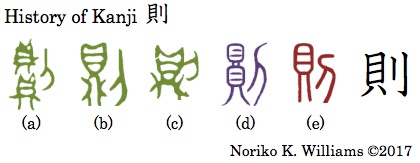 For the kanji 則, we have three writing samples in bronze ware style, in green, here. (a) had two three-legged bronze ware vessels whereas (b) and (c) has just one vessel. The right side was a knife. The knife next to the vessel has been given different accounts — It was a knife used as a utensil for eating food that was cooked in the vessel. Sacrificial animal meat and other food that was offered to a deity was also shared by participants in a religious rite. Something that always accompanied the vessel signified “the rules always to be abided by.” Another account is that a knife signified inscription on the vessel [Shirakawa]. What was inscribed on a bronze ware stayed for a long time and was to be abided by — thus “rules; laws.” The double vessels in (a), and (d) in Old style, in purple, are explained by Shirakawa as signifying the fact that important contracts were inscribed in two vessels for each party to keep as proof. In kanji the knife became刂, a bushu rittoo “a knife placed vertically.”
For the kanji 則, we have three writing samples in bronze ware style, in green, here. (a) had two three-legged bronze ware vessels whereas (b) and (c) has just one vessel. The right side was a knife. The knife next to the vessel has been given different accounts — It was a knife used as a utensil for eating food that was cooked in the vessel. Sacrificial animal meat and other food that was offered to a deity was also shared by participants in a religious rite. Something that always accompanied the vessel signified “the rules always to be abided by.” Another account is that a knife signified inscription on the vessel [Shirakawa]. What was inscribed on a bronze ware stayed for a long time and was to be abided by — thus “rules; laws.” The double vessels in (a), and (d) in Old style, in purple, are explained by Shirakawa as signifying the fact that important contracts were inscribed in two vessels for each party to keep as proof. In kanji the knife became刂, a bushu rittoo “a knife placed vertically.”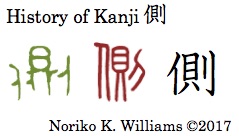 For the kanji 側, the bronze ware style writing, and the seal style writing, in red, had a “person” (イ), a “three-legged bronze ware vessel” (貝) and a “knife” (刀). 則 was used phonetically for /soku/. A person standing next to the vessel meant “by the side.” The kanji 側 means “close by; side.”
For the kanji 側, the bronze ware style writing, and the seal style writing, in red, had a “person” (イ), a “three-legged bronze ware vessel” (貝) and a “knife” (刀). 則 was used phonetically for /soku/. A person standing next to the vessel meant “by the side.” The kanji 側 means “close by; side.”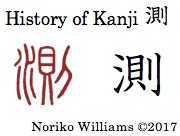 The seal style writing of the kanji 測 comprised “water” and 則, which was used phonetically for /soku/ to mean “standard.” Together they signified measuring the depth of water or in a more general sense of “to measure.” The kanji 測 means “to measure.”
The seal style writing of the kanji 測 comprised “water” and 則, which was used phonetically for /soku/ to mean “standard.” Together they signified measuring the depth of water or in a more general sense of “to measure.” The kanji 測 means “to measure.” In the bronze ware style of the kanji 賊. we see a halberd (戈) on the top right and a three-legged vessel (貝) underneath. But what was the small piece on the left side of the vessel? Was it a “knife” or a “person”? As I mentioned in earlier posts, a knife and a person looked so alike in bronze ware style that they caused some confusion.
In the bronze ware style of the kanji 賊. we see a halberd (戈) on the top right and a three-legged vessel (貝) underneath. But what was the small piece on the left side of the vessel? Was it a “knife” or a “person”? As I mentioned in earlier posts, a knife and a person looked so alike in bronze ware style that they caused some confusion. 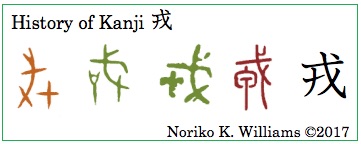 Then when I looked up the ancient writing for 戎 (“soldier; weapon” /e’bisu; kai/), which was the right side of the kanji 賊, it became clear that it was a shield or armor (The history is shown on the right). The kanji 戎 had a halberd (戈) and a shield, making up the meaning “weapons.” So, the kanji 賊 comprises 貝 “three-legged vessel” and 戎 “weapons; soldier.” Together they meant scraping an inscription of an oath out of bronze ware to revoke it. It was also used to mean injuring a person. The kanji 賊 means “to damage; damage due to a robbery; robber.”
Then when I looked up the ancient writing for 戎 (“soldier; weapon” /e’bisu; kai/), which was the right side of the kanji 賊, it became clear that it was a shield or armor (The history is shown on the right). The kanji 戎 had a halberd (戈) and a shield, making up the meaning “weapons.” So, the kanji 賊 comprises 貝 “three-legged vessel” and 戎 “weapons; soldier.” Together they meant scraping an inscription of an oath out of bronze ware to revoke it. It was also used to mean injuring a person. The kanji 賊 means “to damage; damage due to a robbery; robber.” We leave the exploration of the kanji that originated from a legged bronze ware vessel here. The last shape we are exploring in this group of four posts is the shape 賁. The kanji 賁 /hi; hun/ is not a Joyo kanji but we have the history shown on the right side. The bronze ware style was richly decorated ornament. In seal style a cowrie was added to indicate decoration with cowries. The kanji 賁 means “to decorate colorfully,” and when it is used as a component it meant “to burst out.”
We leave the exploration of the kanji that originated from a legged bronze ware vessel here. The last shape we are exploring in this group of four posts is the shape 賁. The kanji 賁 /hi; hun/ is not a Joyo kanji but we have the history shown on the right side. The bronze ware style was richly decorated ornament. In seal style a cowrie was added to indicate decoration with cowries. The kanji 賁 means “to decorate colorfully,” and when it is used as a component it meant “to burst out.”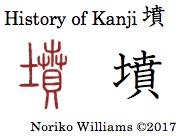 The seal style writing of the kanji 墳 comprised 土 “soil; dirt” and 賁, which was used phonetically for /hun/ to mean “causing something to swell; rise.” Together they meant a burial mound of ancient times. In kanji 土 became a bushu tsuchihen “ground; dirt.” The kanji 墳 means “burial mound.”
The seal style writing of the kanji 墳 comprised 土 “soil; dirt” and 賁, which was used phonetically for /hun/ to mean “causing something to swell; rise.” Together they meant a burial mound of ancient times. In kanji 土 became a bushu tsuchihen “ground; dirt.” The kanji 墳 means “burial mound.” The seal style writing of the kanji 噴 comprised 口 “mouth; opening” and 賁, which was used phonetically for /hun/ to mean “to burst out; gush out.” Together they meant “to gush out.”
The seal style writing of the kanji 噴 comprised 口 “mouth; opening” and 賁, which was used phonetically for /hun/ to mean “to burst out; gush out.” Together they meant “to gush out.”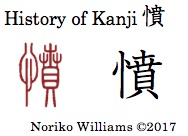 The seal style writing of the kanji 憤 comprised “heart” and 賁, which was used phonetically for /hun/to mean “to burst out.” Together a heart gushing out with emotions meant “to anger; rancor ; outrage; indignation” In kanji, a heart became 忄, a bushu risshinben “heart.” The kanji 憤 means “anger; rancor; outrage; indignation.”
The seal style writing of the kanji 憤 comprised “heart” and 賁, which was used phonetically for /hun/to mean “to burst out.” Together a heart gushing out with emotions meant “to anger; rancor ; outrage; indignation” In kanji, a heart became 忄, a bushu risshinben “heart.” The kanji 憤 means “anger; rancor; outrage; indignation.” For the kanji 机, in seal style (a) was a low table with a leg on each side. It was used as a low table, a chair to sit on or an armrest. In (2) “wood” (木) was added on the left side. A wooden low table (机) meant “desk; writing table.”
For the kanji 机, in seal style (a) was a low table with a leg on each side. It was used as a low table, a chair to sit on or an armrest. In (2) “wood” (木) was added on the left side. A wooden low table (机) meant “desk; writing table.”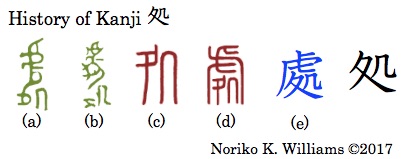 For the kanji 処, (a) and (b) in bronze ware style, in green, had a person wearing a tiger headdress for a votive play sitting on a chair, with his legs stretched in front. The foot was facing sideways, which might have signified “not moving forward.” Together they meant “to stay; be at a place; do something so that it goes better.” From that it meant “to handle; deal with.” In seal style, in red, in (c) a tiger (虎) was dropped, leaving a backward/backward foot (夂) and a chair (几), whereas in (d) a tiger became the top that enclosed 夂 and几. The kyuji 處, in blue, reflected 4, whereas the shinji 処 reflected 3. The kanji 処 means “place; situation; to handle; deal with.” <The composition of the kanji 処: 夂 and 几>
For the kanji 処, (a) and (b) in bronze ware style, in green, had a person wearing a tiger headdress for a votive play sitting on a chair, with his legs stretched in front. The foot was facing sideways, which might have signified “not moving forward.” Together they meant “to stay; be at a place; do something so that it goes better.” From that it meant “to handle; deal with.” In seal style, in red, in (c) a tiger (虎) was dropped, leaving a backward/backward foot (夂) and a chair (几), whereas in (d) a tiger became the top that enclosed 夂 and几. The kyuji 處, in blue, reflected 4, whereas the shinji 処 reflected 3. The kanji 処 means “place; situation; to handle; deal with.” <The composition of the kanji 処: 夂 and 几>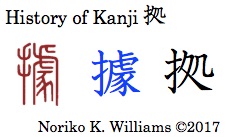 The seal style writing had “hand” on the left side. The right side had “a tiger” and “a boar; pig,” but was used phonetically for /kyo/. Together they meant “to be based on a (particular) place.” The right side of the kyuji 據 was different from the kyuji 處 for 処, as in (e) in 2 above, but in kanji (拠) it became 処. <The composition of the kanji 拠: 扌, 夂 and 几>
The seal style writing had “hand” on the left side. The right side had “a tiger” and “a boar; pig,” but was used phonetically for /kyo/. Together they meant “to be based on a (particular) place.” The right side of the kyuji 據 was different from the kyuji 處 for 処, as in (e) in 2 above, but in kanji (拠) it became 処. <The composition of the kanji 拠: 扌, 夂 and 几>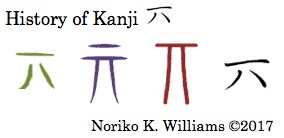 The next shape for a table or base appears as a component only. (There is no font on MS Word for Mac that we can use in text. It is shown on the right in a graphics file. (It is like 六 without the top.) It meant “a place to put something on; base.” This shape is seen in 其基期棋碁欺.
The next shape for a table or base appears as a component only. (There is no font on MS Word for Mac that we can use in text. It is shown on the right in a graphics file. (It is like 六 without the top.) It meant “a place to put something on; base.” This shape is seen in 其基期棋碁欺.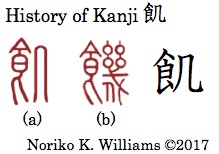 For the kanji 飢 in seal style, (a) comprised covered food on a raised bowl (食) and 几, which was used phonetically for /ki/. It meant “hunger; to starve.” (b) had 幾 on the right, which was used phonetically for /ki/ to mean “little.” The kanji 飢 reflected (a). <The composition of the kanji 飢: a bushu shokuhen (one fewer stroke than 食) and 几>
For the kanji 飢 in seal style, (a) comprised covered food on a raised bowl (食) and 几, which was used phonetically for /ki/. It meant “hunger; to starve.” (b) had 幾 on the right, which was used phonetically for /ki/ to mean “little.” The kanji 飢 reflected (a). <The composition of the kanji 飢: a bushu shokuhen (one fewer stroke than 食) and 几> The kanji 其 is not a Joyo kanji. (a) in oracle bone style and (b) in bronze ware style was a winnowing basket for removing chaff from grain, and was /ki/ phonetically. In (c) in bronze ware style and (d) in seal style the basket was placed on a base. The writing was borrowed to mean “the; that.”
The kanji 其 is not a Joyo kanji. (a) in oracle bone style and (b) in bronze ware style was a winnowing basket for removing chaff from grain, and was /ki/ phonetically. In (c) in bronze ware style and (d) in seal style the basket was placed on a base. The writing was borrowed to mean “the; that.”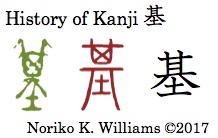 For the kanji 基, the bronze ware style writing comprised a winnowing apparatus with its base (其), which was used phonetically for /ki/, and “soil; ground” (土). Together they meant the ground on which a building was built — “foundation; base.” In seal style, the same components were kept. The kanji 基 means “basis; base; foundation.” <The composition of the kanji 基: 其 and 土>
For the kanji 基, the bronze ware style writing comprised a winnowing apparatus with its base (其), which was used phonetically for /ki/, and “soil; ground” (土). Together they meant the ground on which a building was built — “foundation; base.” In seal style, the same components were kept. The kanji 基 means “basis; base; foundation.” <The composition of the kanji 基: 其 and 土>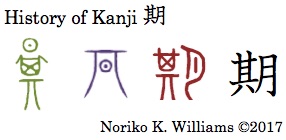 For the kanji 期 the bronze ware style writing had “the sun” at the top, and 其, which was used phonetically for /ki/ at the bottom. Together they meant “a specific time or period.” In Old style, in purple, the sun was inside the base. In seal style, on the right side the sun was replaced by a moon (月). A moon had a cycle of waxing and waning — “thus, a cycle of time.” The kanji 期 means “specific time; period; cycle of time; to expect.” <The composition of the kanji 期: 其 and 月>
For the kanji 期 the bronze ware style writing had “the sun” at the top, and 其, which was used phonetically for /ki/ at the bottom. Together they meant “a specific time or period.” In Old style, in purple, the sun was inside the base. In seal style, on the right side the sun was replaced by a moon (月). A moon had a cycle of waxing and waning — “thus, a cycle of time.” The kanji 期 means “specific time; period; cycle of time; to expect.” <The composition of the kanji 期: 其 and 月>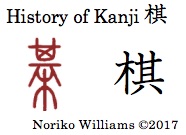 The seal style writing comprised 其, which was used phonetically for /ki/ to mean “square shape,” and “wood” (木) below. Together they meant a square checkerboard. The kanji 棋 is only used for the words that are related to Japanese shogi play 将棋 /shoogi/, in which the kanji 将 /sho’o/ means “commander; general.” <The composition of the kanji 棋: 木 and 其>
The seal style writing comprised 其, which was used phonetically for /ki/ to mean “square shape,” and “wood” (木) below. Together they meant a square checkerboard. The kanji 棋 is only used for the words that are related to Japanese shogi play 将棋 /shoogi/, in which the kanji 将 /sho’o/ means “commander; general.” <The composition of the kanji 棋: 木 and 其>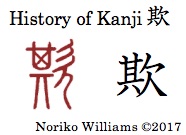 The seal style writing comprised 其, which was used phonetically for /gi/, and a person with his mouth open wide (欠). Setsumon stated that the kanji 欺 meant “to deceive.” (I feel this is not exactly an explanation, but I do not have any better one for now.) <The composition of the kanji 欺: 其 and 欠>
The seal style writing comprised 其, which was used phonetically for /gi/, and a person with his mouth open wide (欠). Setsumon stated that the kanji 欺 meant “to deceive.” (I feel this is not exactly an explanation, but I do not have any better one for now.) <The composition of the kanji 欺: 其 and 欠> The kanji 丙 has quite limited use in the current writing system, but it had a longer history than some other kanji. (a) in oracle bone style and (b), (c) and (d) in bronze ware style was a pictograph of a table or a pedestal to place something on. Unlike 几, the legs were fortified with diagonal supports. It was used phonetically for /hee/ and was borrowed to mean a certain time in the Chinese calendar. In (e) another line was added to indicate that this table was a place to put something on or a pedestal. In Japanese 丙 was also used to indicate a lowest grade in 甲乙丙 /ko’o o’tsu he’e/ “Top, Medium and Low.” The kanji 丙 means “the third-class; poor grade.” <the composition of the kanji 丙: 一 and 内>
The kanji 丙 has quite limited use in the current writing system, but it had a longer history than some other kanji. (a) in oracle bone style and (b), (c) and (d) in bronze ware style was a pictograph of a table or a pedestal to place something on. Unlike 几, the legs were fortified with diagonal supports. It was used phonetically for /hee/ and was borrowed to mean a certain time in the Chinese calendar. In (e) another line was added to indicate that this table was a place to put something on or a pedestal. In Japanese 丙 was also used to indicate a lowest grade in 甲乙丙 /ko’o o’tsu he’e/ “Top, Medium and Low.” The kanji 丙 means “the third-class; poor grade.” <the composition of the kanji 丙: 一 and 内>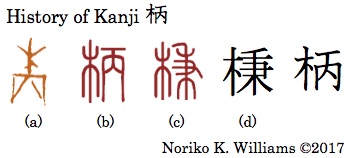 (a) in oracle bone style had a tree on top of a base, whereas in (b) in seal style the two components were placed side by side. Together they signified a ladle with a long wooden stick. A long wooden stick or handle could be a tool to manipulate something or even a person. From that it also meant “power; to handle power; manner in which a matter is handled.” In Japanese it also means “pattern.” The kanji 柄 means “a handle; power; to manipulate; demeanor; pattern.” < the composition of the kanji 柄: 木 and 丙>
(a) in oracle bone style had a tree on top of a base, whereas in (b) in seal style the two components were placed side by side. Together they signified a ladle with a long wooden stick. A long wooden stick or handle could be a tool to manipulate something or even a person. From that it also meant “power; to handle power; manner in which a matter is handled.” In Japanese it also means “pattern.” The kanji 柄 means “a handle; power; to manipulate; demeanor; pattern.” < the composition of the kanji 柄: 木 and 丙>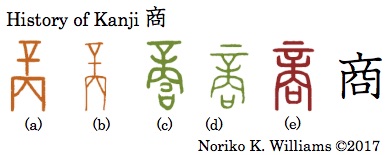 (a) and (b) in oracle bone style comprised “a tattooing needle” at the top and “a table” at the bottom. In (c) and (d) in bronze ware style and (e) in seal style, 口 “mouth or a box of benedictions” was added. There have been various views on the origin of 商. One view is that a person who had the power to tattoo criminals also talked or prayed to a god to ask the will of a god. The meaning of god was dropped but the meaning of asking someone if he is interested in trading business. It meant “commerce.” Another view, which is often cited, is that 商 /sho’o/ (Shang in Chinese) was the capital of the ancient dynasty 殷, Yin (Shang). When the Shang dynasty fell they became merchants travelling around the country. From that the kanji 商 meant “trade; commerce.” <the composition of the kanji 商: 立 without the last stroke, 冂, 八 and 口>
(a) and (b) in oracle bone style comprised “a tattooing needle” at the top and “a table” at the bottom. In (c) and (d) in bronze ware style and (e) in seal style, 口 “mouth or a box of benedictions” was added. There have been various views on the origin of 商. One view is that a person who had the power to tattoo criminals also talked or prayed to a god to ask the will of a god. The meaning of god was dropped but the meaning of asking someone if he is interested in trading business. It meant “commerce.” Another view, which is often cited, is that 商 /sho’o/ (Shang in Chinese) was the capital of the ancient dynasty 殷, Yin (Shang). When the Shang dynasty fell they became merchants travelling around the country. From that the kanji 商 meant “trade; commerce.” <the composition of the kanji 商: 立 without the last stroke, 冂, 八 and 口>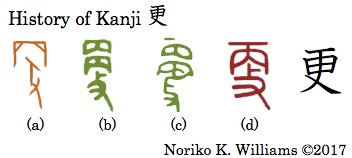 In oracle bone style (a) had “a table” at the top and “a hand with a stick” signifying “to hit; cause something.” In bronze ware style in (b) and (c) another table was added, signifying “repeat” or “replacing.” (d) in seal style became 丙 at the top and 攴 at the bottom. In kanji, the two components were coalesced into one, in which an elongated shape of a hand (又) may be recognized in the last two strokes. The kanji 更 means “again; further; to change.”
In oracle bone style (a) had “a table” at the top and “a hand with a stick” signifying “to hit; cause something.” In bronze ware style in (b) and (c) another table was added, signifying “repeat” or “replacing.” (d) in seal style became 丙 at the top and 攴 at the bottom. In kanji, the two components were coalesced into one, in which an elongated shape of a hand (又) may be recognized in the last two strokes. The kanji 更 means “again; further; to change.”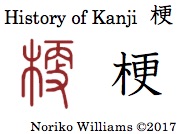 The seal style writing was comprised of 木 on the left, and 丙 and攴 (which became 更 in kanji), which was used phonetically for /koo/. It is used for a mountain elm tree, which was thorny and hard. The kanji 梗 means “hard.” <the composition of the kanji梗: 木 and 更>
The seal style writing was comprised of 木 on the left, and 丙 and攴 (which became 更 in kanji), which was used phonetically for /koo/. It is used for a mountain elm tree, which was thorny and hard. The kanji 梗 means “hard.” <the composition of the kanji梗: 木 and 更>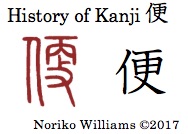 The seal style writing comprised イ“person” and 更 “to renew.” From the meaning of “a person changed something to make it better,” it meant “convenient; service.” It is also used for something that happened regularly such as “service; bowel movement.” The kanji 便 means “convenient; service; bowel movement.” <the composition of the kanji便: イ and 更>
The seal style writing comprised イ“person” and 更 “to renew.” From the meaning of “a person changed something to make it better,” it meant “convenient; service.” It is also used for something that happened regularly such as “service; bowel movement.” The kanji 便 means “convenient; service; bowel movement.” <the composition of the kanji便: イ and 更>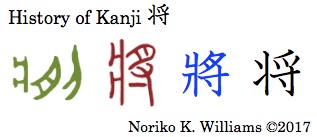 For the kanji 将, in bronze ware style, in green, it had爿”a vertically placed two-legged table,” 月 “a piece of meat,” and 刀 “a knife.” Together they signified placing the offering of sacrificial animal meat on an altar table right before a battle. The person who conducted the rite was a military leader – thus it meant “military leader; general.” It was conducted right before embarking on a battle – thus it meant “immediate future.” In seal style, in red, and the kyuji 將, in blue, the bottom became 寸 “hand.” In shinji 将, the legs of the table were simplified to a ハ shape, vertically placed, and the piece of meat was replaced by “a hand with fingers showing from above.” The kanji 将 means “a military leader; general; immediate future.” <the composition of the kanji 将: the reduced shape of 爿, a small ノ, a truncated ツ and 寸>
For the kanji 将, in bronze ware style, in green, it had爿”a vertically placed two-legged table,” 月 “a piece of meat,” and 刀 “a knife.” Together they signified placing the offering of sacrificial animal meat on an altar table right before a battle. The person who conducted the rite was a military leader – thus it meant “military leader; general.” It was conducted right before embarking on a battle – thus it meant “immediate future.” In seal style, in red, and the kyuji 將, in blue, the bottom became 寸 “hand.” In shinji 将, the legs of the table were simplified to a ハ shape, vertically placed, and the piece of meat was replaced by “a hand with fingers showing from above.” The kanji 将 means “a military leader; general; immediate future.” <the composition of the kanji 将: the reduced shape of 爿, a small ノ, a truncated ツ and 寸>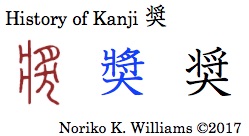 For the kanji 奨 the seal style writing had a vertically placed table (爿), “ a piece of meat” (月), which was used phonetically for 將 /shoo/, and “dog” (犬) at the bottom right. Together they meant “to recommend; encourage.” The role of a dog is not clear, but some scholars view it that “setting a dog on” gave the meaning “to instigate; encourage.” (Personally I do not feel this explanation sits well.) In the kyuji 奬 the bottom was replaced by 大 “person.” (In many of the kanji that contained 犬 “a dog” in ancient writing, it lost the short stroke, and became 大 “person” or “big.”) The kanji 奨 means “to urge; commend; encourage.” <the composition of the kanji 奨: 将 and 大>
For the kanji 奨 the seal style writing had a vertically placed table (爿), “ a piece of meat” (月), which was used phonetically for 將 /shoo/, and “dog” (犬) at the bottom right. Together they meant “to recommend; encourage.” The role of a dog is not clear, but some scholars view it that “setting a dog on” gave the meaning “to instigate; encourage.” (Personally I do not feel this explanation sits well.) In the kyuji 奬 the bottom was replaced by 大 “person.” (In many of the kanji that contained 犬 “a dog” in ancient writing, it lost the short stroke, and became 大 “person” or “big.”) The kanji 奨 means “to urge; commend; encourage.” <the composition of the kanji 奨: 将 and 大>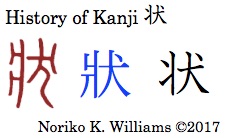 For the kanji 状 the seal style writing comprised “a vertically placed table” (爿), which was used phonetically for /joo/, and “a dog” (犬). For this kanji Setsumon explained it as “the shape of a dog.” It meant “shapes; conditions.” One reported the condition of a matter by a letter, thus it also meant “letter; a piece of paper.” The kanji 状 means “state; condition; letter.” <the composition of the kanji 状: the reduced shape of 爿 and 犬>
For the kanji 状 the seal style writing comprised “a vertically placed table” (爿), which was used phonetically for /joo/, and “a dog” (犬). For this kanji Setsumon explained it as “the shape of a dog.” It meant “shapes; conditions.” One reported the condition of a matter by a letter, thus it also meant “letter; a piece of paper.” The kanji 状 means “state; condition; letter.” <the composition of the kanji 状: the reduced shape of 爿 and 犬>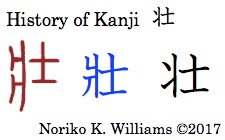 For the kanji 壮 the seal style writing comprised 爿 “a table with legs that was placed vertically” and was used phonetically for /shoo; soo/. The right side 士, “man; warrior,” came from an ceremonial axe to signify that a man belongs to the “warrior class.” Together they meant “grand; manly; strong.” <the composition of the kanji 壮: a reduced shape of 爿 and 士>
For the kanji 壮 the seal style writing comprised 爿 “a table with legs that was placed vertically” and was used phonetically for /shoo; soo/. The right side 士, “man; warrior,” came from an ceremonial axe to signify that a man belongs to the “warrior class.” Together they meant “grand; manly; strong.” <the composition of the kanji 壮: a reduced shape of 爿 and 士>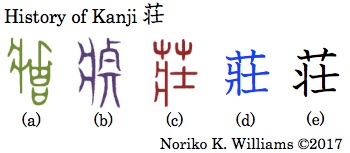 For the kanji 荘, (a) in bronze ware style had爿“a vertically placed table,” 由 and 口, together having the meaning “grandness in religious ceremony, and meant “grand; solemn.” (b) in Old style, in purple, had a table (爿), deceased bones (歹) on a table (几). (For the Old style (b) I have not been able to find an analysis in references.) (c) in seal style had 艸 “grass” and 壮, which was /soo/ phonetically. Together a place where many trees and plants vigorously grew gave the meaning “villa; manor.” The kanji 荘 means “villa; manor; solemn; grand.” <the composition of the kanji 荘: 艹 and 壮>
For the kanji 荘, (a) in bronze ware style had爿“a vertically placed table,” 由 and 口, together having the meaning “grandness in religious ceremony, and meant “grand; solemn.” (b) in Old style, in purple, had a table (爿), deceased bones (歹) on a table (几). (For the Old style (b) I have not been able to find an analysis in references.) (c) in seal style had 艸 “grass” and 壮, which was /soo/ phonetically. Together a place where many trees and plants vigorously grew gave the meaning “villa; manor.” The kanji 荘 means “villa; manor; solemn; grand.” <the composition of the kanji 荘: 艹 and 壮>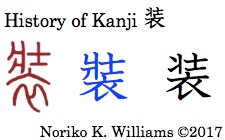 For the kanji 装 in seal style the top 壮 was used phonetically for /soo/ to mean “grand; manly,” and the bottom 衣 meant “clothes” from “collar.” From putting on a good outfit to look grand it meant “to put on good clothes; equip with gear.” It also meant “to pretend.” The kanji 装 means “to wear clothes; equip; pretend.” <the composition of the kanji 装: 壮 and 衣>
For the kanji 装 in seal style the top 壮 was used phonetically for /soo/ to mean “grand; manly,” and the bottom 衣 meant “clothes” from “collar.” From putting on a good outfit to look grand it meant “to put on good clothes; equip with gear.” It also meant “to pretend.” The kanji 装 means “to wear clothes; equip; pretend.” <the composition of the kanji 装: 壮 and 衣> There is one more kanji that I would like to bring in – the kanji 床, even though 爿 does not appear on the surface. The kanji 床 had the Correct writing style 牀, in green, on the left. The kanji 牀 comprised 爿 “table; wooden plank,” which was used phonetically for /shoo/, and 木 “wood.” Together they meant “wooden floor; wooden bed.” The kanji 床 became a popular writing for 牀 in much later times. The kanji 床 means “floor; bed.” <the composition of the kanji 床: 广 and 木>
There is one more kanji that I would like to bring in – the kanji 床, even though 爿 does not appear on the surface. The kanji 床 had the Correct writing style 牀, in green, on the left. The kanji 牀 comprised 爿 “table; wooden plank,” which was used phonetically for /shoo/, and 木 “wood.” Together they meant “wooden floor; wooden bed.” The kanji 床 became a popular writing for 牀 in much later times. The kanji 床 means “floor; bed.” <the composition of the kanji 床: 广 and 木>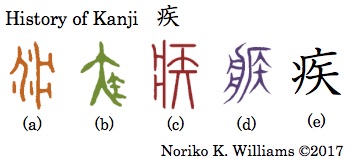 For the kanji 疾 (a) in oracle bone style, in brown, was “a sick person with perspiration due to high fever or blood (indicated by the three dots) lying in bed” that was placed vertically. On the other hand, (b) in bronze ware style, in green, was “a person” and “an arrow” at the bottom right, together signifying “a wounded person shot with an arrow.” An arrow was also used phonetically for /shitsu/. (c) in seal style, in red, was (a) and (b) combined – “a sick bed” and “an arrow.” In (d) in Old style, in purple, an arrow was placed under 厂. The kanji 疾comprises a bushu yamaidare (疒) and “an arrow” (矢). Having an arrow as its component, it also meant “very fast.” The kanji 疾 means “illness; very fast.” <the composition of the kanji 疾: 疒 and 矢>
For the kanji 疾 (a) in oracle bone style, in brown, was “a sick person with perspiration due to high fever or blood (indicated by the three dots) lying in bed” that was placed vertically. On the other hand, (b) in bronze ware style, in green, was “a person” and “an arrow” at the bottom right, together signifying “a wounded person shot with an arrow.” An arrow was also used phonetically for /shitsu/. (c) in seal style, in red, was (a) and (b) combined – “a sick bed” and “an arrow.” In (d) in Old style, in purple, an arrow was placed under 厂. The kanji 疾comprises a bushu yamaidare (疒) and “an arrow” (矢). Having an arrow as its component, it also meant “very fast.” The kanji 疾 means “illness; very fast.” <the composition of the kanji 疾: 疒 and 矢>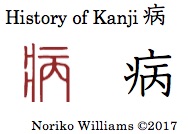 For the kanji 病, the seal style writing comprised “a bed” that was vertically placed, and 一, signifying “a person lying down” on the right side, and 丙, which was used phonetically for /hee; byoo/ to mean “to add; increase.” Together they originally signified someone’s illness had deteriorated or “ill; sick.” In kanji “a person lying in a sickbed” became 疒, a bushu yamaidare. The kanji means “illness; sick; something unhealthy.” <the composition of the kanji 病: 疒 and 丙>
For the kanji 病, the seal style writing comprised “a bed” that was vertically placed, and 一, signifying “a person lying down” on the right side, and 丙, which was used phonetically for /hee; byoo/ to mean “to add; increase.” Together they originally signified someone’s illness had deteriorated or “ill; sick.” In kanji “a person lying in a sickbed” became 疒, a bushu yamaidare. The kanji means “illness; sick; something unhealthy.” <the composition of the kanji 病: 疒 and 丙>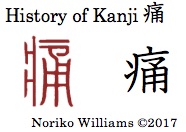 For the kanji 痛, the seal style writing had the elements of a bushu yamaidare. On the right side below a line, 甬 “a wooden pail,” was used phonetically for /tsuu/ to mean “to pass through.” In sickness what passed through one’s body was “pain; ache.” A pain running through a body could be “piercing and severe.” The kanji 痛 means “pain; ache; severe; piercing.” <the composition of the kanji 痛: 疒, マ and 用>
For the kanji 痛, the seal style writing had the elements of a bushu yamaidare. On the right side below a line, 甬 “a wooden pail,” was used phonetically for /tsuu/ to mean “to pass through.” In sickness what passed through one’s body was “pain; ache.” A pain running through a body could be “piercing and severe.” The kanji 痛 means “pain; ache; severe; piercing.” <the composition of the kanji 痛: 疒, マ and 用>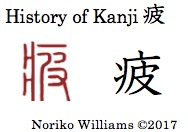 For the kanji 疲, the seal style writing had the components for 疒, a bushu yamaidare, and 皮, which was used phonetically for /hi/ to mean “to be tired.” The kanji 疲 means “fatigue; to become tired; worn out.” <the composition of the kanji 疲: 疒 and 皮>
For the kanji 疲, the seal style writing had the components for 疒, a bushu yamaidare, and 皮, which was used phonetically for /hi/ to mean “to be tired.” The kanji 疲 means “fatigue; to become tired; worn out.” <the composition of the kanji 疲: 疒 and 皮>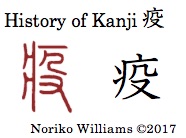 For the kanji 疫, the seal style writing comprised the elements of a bushu yamaidare. The right side under a line (“a person”) was “a hand holding a weapon” (殳, a bushu hokozukuri), which was /eki/ phonetically, and is believed to be an abbreviated form of the kanji 役. The kanji 役, when pronounced as /eki/, meant “conscripted for a battle or frontier work,” and it had the connotation that it was something everyone did reluctantly. So, 疒, a bushu yamaidare and 殳 together meant “illness that everyone unwillingly got” – that is, “an epidemic.” The kanji 疫 means “epidemic.” <the composition of the kanji 疫: 疒 and 殳>
For the kanji 疫, the seal style writing comprised the elements of a bushu yamaidare. The right side under a line (“a person”) was “a hand holding a weapon” (殳, a bushu hokozukuri), which was /eki/ phonetically, and is believed to be an abbreviated form of the kanji 役. The kanji 役, when pronounced as /eki/, meant “conscripted for a battle or frontier work,” and it had the connotation that it was something everyone did reluctantly. So, 疒, a bushu yamaidare and 殳 together meant “illness that everyone unwillingly got” – that is, “an epidemic.” The kanji 疫 means “epidemic.” <the composition of the kanji 疫: 疒 and 殳>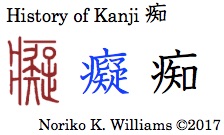 The seal style of the kanji 痴 comprised the components of a bushu yamaidare, and 疑 “to doubt; unsure,” which was used phonetically for /chi/. The kanji 疑 had the origin that someone stood still not knowing which way to go or what to do. Together someone who was in such a sick condition that he could not judge correctly meant “foolish; idiocy” The kyuji reflected the seal style, but in the shinji 痴, 疑 was replaced by 知 “to know,” which was phonetically /chi/. It is interesting to see that components (疑 and 知) that had almost opposite meanings were used to carry the same meaning. <the composition of the kanji 痴: 疒 and 知>
The seal style of the kanji 痴 comprised the components of a bushu yamaidare, and 疑 “to doubt; unsure,” which was used phonetically for /chi/. The kanji 疑 had the origin that someone stood still not knowing which way to go or what to do. Together someone who was in such a sick condition that he could not judge correctly meant “foolish; idiocy” The kyuji reflected the seal style, but in the shinji 痴, 疑 was replaced by 知 “to know,” which was phonetically /chi/. It is interesting to see that components (疑 and 知) that had almost opposite meanings were used to carry the same meaning. <the composition of the kanji 痴: 疒 and 知>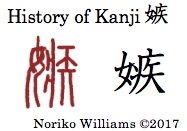 The seal style writing of the kanji 嫉 had 女 “a woman” and 疾, which was used phonetically for /shitsu/, as we have just seen in 1 above. According to Shirakawa, Setsumon gave the writing with イ, a ninben “a person,” rather than 女 “woman” as on the left side of 疾 to be the Correct writing, but Setsumon did not seem to have given any seal style sample. (The seal style on the left is from Shirakawa.) Together they meant “jealous.” The kanji 嫉 means “to be jealous; envy.” <the composition of the kanji 嫉: 女 and 嫉>
The seal style writing of the kanji 嫉 had 女 “a woman” and 疾, which was used phonetically for /shitsu/, as we have just seen in 1 above. According to Shirakawa, Setsumon gave the writing with イ, a ninben “a person,” rather than 女 “woman” as on the left side of 疾 to be the Correct writing, but Setsumon did not seem to have given any seal style sample. (The seal style on the left is from Shirakawa.) Together they meant “jealous.” The kanji 嫉 means “to be jealous; envy.” <the composition of the kanji 嫉: 女 and 嫉>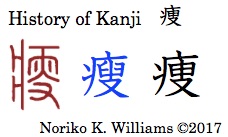 For the kanji 痩 the seal style writing had “a table” on the left, and the right side had a line on top, and 叟 “an elder person” was used phonetically for /soo/. “A sick old person” gave the meaning “to become haggard; emaciated.” <the composition of the kanji 疲: 疒 and 皮>
For the kanji 痩 the seal style writing had “a table” on the left, and the right side had a line on top, and 叟 “an elder person” was used phonetically for /soo/. “A sick old person” gave the meaning “to become haggard; emaciated.” <the composition of the kanji 疲: 疒 and 皮>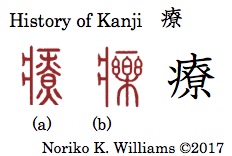 In seal style (a) and (b) had the components for a bushu yamaidare. The right side 尞 of (a) underneath 一 was used phonetically for /ryoo/. 2 had 樂 “comfort,” which is the kyuji for the kanji 楽. Together they meant “relieving pains of a sick person.” The kanji 療 means “medical treatment.” <the composition of the kanji 疲: 疒 and 尞>
In seal style (a) and (b) had the components for a bushu yamaidare. The right side 尞 of (a) underneath 一 was used phonetically for /ryoo/. 2 had 樂 “comfort,” which is the kyuji for the kanji 楽. Together they meant “relieving pains of a sick person.” The kanji 療 means “medical treatment.” <the composition of the kanji 疲: 疒 and 尞>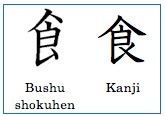 The new area of topics we are going to explore in the this and next several postings is around a kitchen, cooking, measuring, etc. We start kanji with a bushu shokuhen “eating; food” – 食飯餓館飽飾飲餌養. A bushu shokuhen has one stroke fewer than the kanji 食, as shown on the right. We shall also see that not all the kanji with a bushu shokuhen originated from 食.
The new area of topics we are going to explore in the this and next several postings is around a kitchen, cooking, measuring, etc. We start kanji with a bushu shokuhen “eating; food” – 食飯餓館飽飾飲餌養. A bushu shokuhen has one stroke fewer than the kanji 食, as shown on the right. We shall also see that not all the kanji with a bushu shokuhen originated from 食.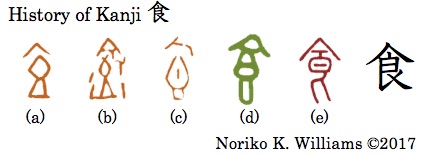 For the kanji 食, in (a), (b) and (c) in oracle bone style, in brown, it was “food in a raised bowl with a lid.” (b) had the dotted lines on both sides. I am unable to find the account for this in reference, but I am wondering if they signified that there was so much food that it was spilling over. It meant “food; to eat.” (d), in green, was in bronze ware style. In seal style (e), in red, some scholars analyze it as 皀 with 𠆢 — “a cover” (𠆢), “food” (白) and “a spoon; ladle” (ヒ). The kanji 食 means “to eat; food.” <The composition of the kanji: 𠆢 and 良>
For the kanji 食, in (a), (b) and (c) in oracle bone style, in brown, it was “food in a raised bowl with a lid.” (b) had the dotted lines on both sides. I am unable to find the account for this in reference, but I am wondering if they signified that there was so much food that it was spilling over. It meant “food; to eat.” (d), in green, was in bronze ware style. In seal style (e), in red, some scholars analyze it as 皀 with 𠆢 — “a cover” (𠆢), “food” (白) and “a spoon; ladle” (ヒ). The kanji 食 means “to eat; food.” <The composition of the kanji: 𠆢 and 良>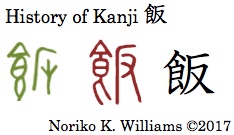 For the kanji 飯, in bronze ware style and seal style it comprised “food in a raised bowl with a lid,” and 反, which was used phonetically for /han/. Together they originally meant “cooked grains such as rice and millet.” The kanji 飯 means “cooked rice; meal.” <The composition of the kanji 飯: a bushu shokuhen and 反>
For the kanji 飯, in bronze ware style and seal style it comprised “food in a raised bowl with a lid,” and 反, which was used phonetically for /han/. Together they originally meant “cooked grains such as rice and millet.” The kanji 飯 means “cooked rice; meal.” <The composition of the kanji 飯: a bushu shokuhen and 反>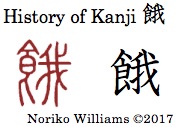 For the kanji 餓, the seal style writing comprised “food in a raised bowl with a lid,” and 我, which was used phonetically for /ga/ to mean “to starve.” The kanji 餓 means “to starve.” A few postings ago, we looked at another kanji that meant “to starve” – the kanji 飢. The kanji 飢 focuses on lack of food (such as in famine). <The composition of the kanji 餓: a bushu shokuhen and 我>
For the kanji 餓, the seal style writing comprised “food in a raised bowl with a lid,” and 我, which was used phonetically for /ga/ to mean “to starve.” The kanji 餓 means “to starve.” A few postings ago, we looked at another kanji that meant “to starve” – the kanji 飢. The kanji 飢 focuses on lack of food (such as in famine). <The composition of the kanji 餓: a bushu shokuhen and 我> For the kanji 館, the seal style writing had “food in a raised bowl with a lid” (食), and 官 “a place where military officers stay,” which was used phonetically for /kan/. Together they originally meant “a place where many people gather and eat.” The kanji 館 means “a large building; mansion.” <The composition of the kanji 館: a bushu shokuhen and 官>
For the kanji 館, the seal style writing had “food in a raised bowl with a lid” (食), and 官 “a place where military officers stay,” which was used phonetically for /kan/. Together they originally meant “a place where many people gather and eat.” The kanji 館 means “a large building; mansion.” <The composition of the kanji 館: a bushu shokuhen and 官>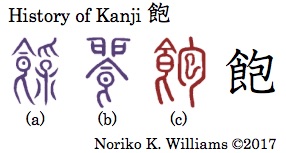 For the kanji 飽, in Old style the left side of (a), in purple, had “a covered bowl of food.” The right side had “a hand” over “a baby.” Together they meant “feeding a baby to full stomach.” The top of (b) is not clear, but it could be two doors to an altar, and (b) means “to offer food to satisfy a god.” In seal style in (c) the right side was replaced by 包 “to wrap up completely,” from a baby in mother’s womb, and was used phonetically for /hoo/ to mean “full.” After eating much food one’s stomach was full. With too much of anything one gets weary of. The kanji 飽 means “to become tired of; be saturated; weary; full.” <The composition of the kanji 飽: a bushu shokuhen and 包>
For the kanji 飽, in Old style the left side of (a), in purple, had “a covered bowl of food.” The right side had “a hand” over “a baby.” Together they meant “feeding a baby to full stomach.” The top of (b) is not clear, but it could be two doors to an altar, and (b) means “to offer food to satisfy a god.” In seal style in (c) the right side was replaced by 包 “to wrap up completely,” from a baby in mother’s womb, and was used phonetically for /hoo/ to mean “full.” After eating much food one’s stomach was full. With too much of anything one gets weary of. The kanji 飽 means “to become tired of; be saturated; weary; full.” <The composition of the kanji 飽: a bushu shokuhen and 包> For the kanji 飾, the left side of the seal style writing had 食 “food in a raised bowl with a lid” and 人 “person” on the right top, and 巾 “cloth” at the bottom. Together they meant “a person in front of a bowl of food wiping the bowl with a piece of cloth.” It meant “to make it clean or pretty.” The kanji 飾 meant “to decorate; embellish.” <The composition of the kanji 飾: a bushu shokuhen, a short ノ, 一 and 巾>
For the kanji 飾, the left side of the seal style writing had 食 “food in a raised bowl with a lid” and 人 “person” on the right top, and 巾 “cloth” at the bottom. Together they meant “a person in front of a bowl of food wiping the bowl with a piece of cloth.” It meant “to make it clean or pretty.” The kanji 飾 meant “to decorate; embellish.” <The composition of the kanji 飾: a bushu shokuhen, a short ノ, 一 and 巾> For the kanji 飲, in oracle bone style (a) had “a person trying to drink wine from a large wine cask.” If we look at (a) closely, the tongue was a forked shape, as was in the ancient writings of the kanji 舌 “tongue,” indicating eating. It meant “to drink (wine).” (b) in oracle bone style was a large wine cask (酉) with a stopper at the top. The left side of (c) and (d) in bronze ware style and (e) in seal style had a wine cask with a stopper. The right side was a person trying to drink or opening his mouth wide. In the kyuji 飮, (f) in blue, the cask was replaced by a bushu shokuhen “to eat; food.” The reason could be that a bushu 酉 was primarily used for fermented liquid and the kanji 飲 is more inclusive of liquids and food that one drinks or swallows without chewing. The kanji 飲 meant “to drink; swallow.” <The composition of the kanji 飲: a bushu shokuhen and 欠 >
For the kanji 飲, in oracle bone style (a) had “a person trying to drink wine from a large wine cask.” If we look at (a) closely, the tongue was a forked shape, as was in the ancient writings of the kanji 舌 “tongue,” indicating eating. It meant “to drink (wine).” (b) in oracle bone style was a large wine cask (酉) with a stopper at the top. The left side of (c) and (d) in bronze ware style and (e) in seal style had a wine cask with a stopper. The right side was a person trying to drink or opening his mouth wide. In the kyuji 飮, (f) in blue, the cask was replaced by a bushu shokuhen “to eat; food.” The reason could be that a bushu 酉 was primarily used for fermented liquid and the kanji 飲 is more inclusive of liquids and food that one drinks or swallows without chewing. The kanji 飲 meant “to drink; swallow.” <The composition of the kanji 飲: a bushu shokuhen and 欠 >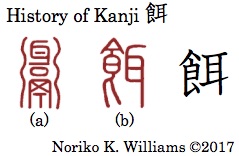 For the kanji 餌, the two seal style writings, (a) and (b), had totally different shapes. (a) was “a vessel to keep grains” (鬲) with 耳 on top, which was used phonetically for /ji/ to mean “flour dumpling.” Together they originally meant “steamed dumpling.” (b) had “food on a raised bowl with a lid” on the left side, and 耳 “ear,” which was used phonetically for /ji/. The kanji 餌 means “animal feed; bait; lure.” <The composition of the kanji 餌: a bushu shokuhen and 耳>
For the kanji 餌, the two seal style writings, (a) and (b), had totally different shapes. (a) was “a vessel to keep grains” (鬲) with 耳 on top, which was used phonetically for /ji/ to mean “flour dumpling.” Together they originally meant “steamed dumpling.” (b) had “food on a raised bowl with a lid” on the left side, and 耳 “ear,” which was used phonetically for /ji/. The kanji 餌 means “animal feed; bait; lure.” <The composition of the kanji 餌: a bushu shokuhen and 耳>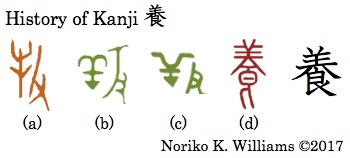 For the kanji 養, (a) in oracle bone style and (b) and (c) in bronze ware style had a sheep on the left, which was used phonetically for /yoo/ to mean “to feed.” The right side was “a stick held by a hand,” signifying “action.” Together they signified sheep farming. The right side would have become 攴 in kanji, but in seal style, (d), the kanji 食 “to eat; food” replaced it. The kanji 養 means “to support (by providing food); nourish; foster.” <The composition of the kanji 養: 羊 with a short last stroke, 八 and 良> (P. S. — Actually (a) was “a cow; ox,” judging from the shape of the horns. August 20, 2017)
For the kanji 養, (a) in oracle bone style and (b) and (c) in bronze ware style had a sheep on the left, which was used phonetically for /yoo/ to mean “to feed.” The right side was “a stick held by a hand,” signifying “action.” Together they signified sheep farming. The right side would have become 攴 in kanji, but in seal style, (d), the kanji 食 “to eat; food” replaced it. The kanji 養 means “to support (by providing food); nourish; foster.” <The composition of the kanji 養: 羊 with a short last stroke, 八 and 良> (P. S. — Actually (a) was “a cow; ox,” judging from the shape of the horns. August 20, 2017) For the kanji 即 in (a) in oracle bone style, in brown, (b) and (c) in bronze ware style, in green, and (d) in seal style, in red, the left side was “food in a raised bowl,” and the right side was “a person about to take a seat to eat.” A person about to do something gave the meaning “at once; immediately.” The sense of immediacy was also used to mean “accession to a throne” (it happens immediately after a predecessor’s death). The kyuji 卽, (e) in blue, comprised 皀 (often explained as “a bowl of food” and “a spoon” (ヒ)), and 卩 “a kneeling person.” In shinji the left side became the bottom of a bushu shokuhen. The kanji 即 means “immediate; instance; to accede to the throne; namely.”
For the kanji 即 in (a) in oracle bone style, in brown, (b) and (c) in bronze ware style, in green, and (d) in seal style, in red, the left side was “food in a raised bowl,” and the right side was “a person about to take a seat to eat.” A person about to do something gave the meaning “at once; immediately.” The sense of immediacy was also used to mean “accession to a throne” (it happens immediately after a predecessor’s death). The kyuji 卽, (e) in blue, comprised 皀 (often explained as “a bowl of food” and “a spoon” (ヒ)), and 卩 “a kneeling person.” In shinji the left side became the bottom of a bushu shokuhen. The kanji 即 means “immediate; instance; to accede to the throne; namely.”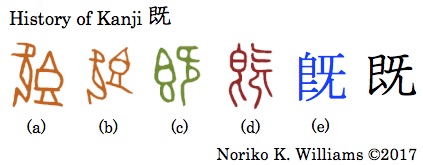 For the kanji 既, in (a) and (b) in oracle bone style a person who knelt down in front of food was turning his face away from the food to indicate that he had had enough food. His open mouth is interpreted as belching because of his full stomach. “Having finished eating” gave the meaning “already.” In (c) in bronze ware style and (d) in seal style the two components swapped the positions. In (d) the right side was the reversed shape of 欠 in seal style and became 旡 /ki/ in kanji to mean “full of.” (The kanji 欠 “lack of” and 旡 “full of” had a reverse meaning of each other” in its origin.) The kanji 既 means “already; to be finished.”
For the kanji 既, in (a) and (b) in oracle bone style a person who knelt down in front of food was turning his face away from the food to indicate that he had had enough food. His open mouth is interpreted as belching because of his full stomach. “Having finished eating” gave the meaning “already.” In (c) in bronze ware style and (d) in seal style the two components swapped the positions. In (d) the right side was the reversed shape of 欠 in seal style and became 旡 /ki/ in kanji to mean “full of.” (The kanji 欠 “lack of” and 旡 “full of” had a reverse meaning of each other” in its origin.) The kanji 既 means “already; to be finished.”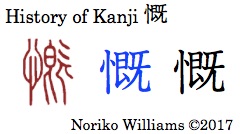 or the kanji 慨, the seal style writing comprised “heart,” and 既 “a person looking backward with an open mouth.” A heart full of emotions signified “to lament; grieve over,” and was used phonetically for /gai/. The kanji 慨 means “to lament; deplore; grieve over.”
or the kanji 慨, the seal style writing comprised “heart,” and 既 “a person looking backward with an open mouth.” A heart full of emotions signified “to lament; grieve over,” and was used phonetically for /gai/. The kanji 慨 means “to lament; deplore; grieve over.”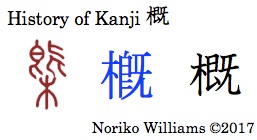 For the kanji 概, in the seal style writing the top 既 was used phonetically for /gai/, and the bottom meant 木 “tree; wood.” Together they originally meant “a wooden strickle – a rod to level off a heaped measure.” Leveling off grains indicated “roughly equal.” The kanji 概 means “roughly; in general.”
For the kanji 概, in the seal style writing the top 既 was used phonetically for /gai/, and the bottom meant 木 “tree; wood.” Together they originally meant “a wooden strickle – a rod to level off a heaped measure.” Leveling off grains indicated “roughly equal.” The kanji 概 means “roughly; in general.”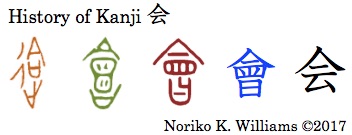 For the kanji 会 the oracle bone style writing comprised “a crossroad” (彳), “a container with a lid” (合), signifying “to fit; meet,” and “a footprint” at the bottom. Together they meant “to go on foot to meet (someone).” In bronze ware style and seal style it had “a food steamer with a lid with layers of steaming trays” and “a cooking stove” at the bottom. The crossroad disappeared. The kyuji 會 reflected seal style. The shinji 会 is the simplified form with 云 (a shape that is used in place of a complex shape) under 𠆢 “a cover.” The kanji 会 means “to meet; meeting; association.”
For the kanji 会 the oracle bone style writing comprised “a crossroad” (彳), “a container with a lid” (合), signifying “to fit; meet,” and “a footprint” at the bottom. Together they meant “to go on foot to meet (someone).” In bronze ware style and seal style it had “a food steamer with a lid with layers of steaming trays” and “a cooking stove” at the bottom. The crossroad disappeared. The kyuji 會 reflected seal style. The shinji 会 is the simplified form with 云 (a shape that is used in place of a complex shape) under 𠆢 “a cover.” The kanji 会 means “to meet; meeting; association.” For the kanji 曽, (a) and (b) in bronze ware style was “a steamer” from which steam was rising (八) at the top. A steamer had layers of trays or baskets, and from that it meant “to layer; layered.” The kyuji 曾, (d), reflected (c) in seal style, and became simplified to 曽 in shinji, changing ハ to a truncated ソ, 田 and曰. It was also borrowed to mean “once; on one occasion; formerly” or “three generations ago.” The kanji 曽 means “to lay something on top of another; formerly.”
For the kanji 曽, (a) and (b) in bronze ware style was “a steamer” from which steam was rising (八) at the top. A steamer had layers of trays or baskets, and from that it meant “to layer; layered.” The kyuji 曾, (d), reflected (c) in seal style, and became simplified to 曽 in shinji, changing ハ to a truncated ソ, 田 and曰. It was also borrowed to mean “once; on one occasion; formerly” or “three generations ago.” The kanji 曽 means “to lay something on top of another; formerly.”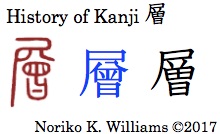 For the kanji 層 the seal style comprised 尸 , a bushu shikabane “roof,” and 曾 “layers; to add” and was used phonetically for /soo/. Something in multiple levels meant “stratum.” It is also used for “class of people.” The kyuji 層, 2, reflected 1. The kanji 層 means “layer; stratum.”
For the kanji 層 the seal style comprised 尸 , a bushu shikabane “roof,” and 曾 “layers; to add” and was used phonetically for /soo/. Something in multiple levels meant “stratum.” It is also used for “class of people.” The kyuji 層, 2, reflected 1. The kanji 層 means “layer; stratum.”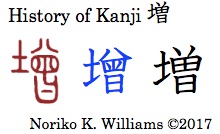 For the kanji 増the seal style writing comprised 土 “dirt; soil,” and 曾 “layer; to add,” which was used phonetically for /soo/. Together adding soil to existing layers meant “to increase.” The kyuji 增, 2, was simplified to 増. The kanji 増 means “to add; increase.”
For the kanji 増the seal style writing comprised 土 “dirt; soil,” and 曾 “layer; to add,” which was used phonetically for /soo/. Together adding soil to existing layers meant “to increase.” The kyuji 增, 2, was simplified to 増. The kanji 増 means “to add; increase.”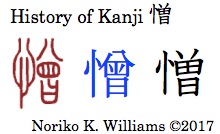 For the kanji 憎 the seal style writing comprised “heart,” which became 忄, a bushu risshinben, and 曾 “layers; to add,” which was used phonetically for /zoo/. Together “certain emotions that accumulated” gave the meaning “hate.” The kyuji 憎, 2, became shinji 憎. The kanji 憎 means “to hate; detest; abhor; hateful.”
For the kanji 憎 the seal style writing comprised “heart,” which became 忄, a bushu risshinben, and 曾 “layers; to add,” which was used phonetically for /zoo/. Together “certain emotions that accumulated” gave the meaning “hate.” The kyuji 憎, 2, became shinji 憎. The kanji 憎 means “to hate; detest; abhor; hateful.”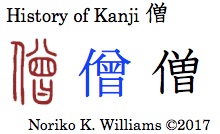 For the kanji 僧 the seal style writing comprised “a person,” and 曾, which was used phonetically for /soo/. The writing was used as a phonetic rendition of the Buddhism word sampha in Sanskrit. The kanji 僧 means “monk; priest.”
For the kanji 僧 the seal style writing comprised “a person,” and 曾, which was used phonetically for /soo/. The writing was used as a phonetic rendition of the Buddhism word sampha in Sanskrit. The kanji 僧 means “monk; priest.”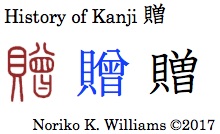 For the kanji 贈 the seal style writing comprised 貝 “cowry” signifying “valuable; monetary value,” and 曾 “layers; to add,” which was used phonetically for /soo; zoo/. Giving a present was an act of one conferring or giving a valuable item to another person. The kyuji 贈, 2, was simplified to 贈. The kanji 贈 means “to give; present.”
For the kanji 贈 the seal style writing comprised 貝 “cowry” signifying “valuable; monetary value,” and 曾 “layers; to add,” which was used phonetically for /soo; zoo/. Giving a present was an act of one conferring or giving a valuable item to another person. The kyuji 贈, 2, was simplified to 贈. The kanji 贈 means “to give; present.”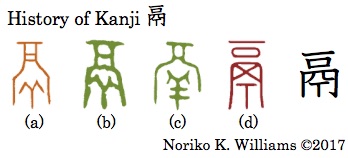 Now let us start with the component 鬲. 鬲 /reki/ is not a kanji we use by itself, but we have the history as shown on the right. (a) in oracle bone style, in brown, (b) and (c) in bronze ware style, in green, and (d) in seal style, in red, was a clay tripod (meaning, three-legged) pot. The legs were thick and hollow, and it was used to keep grains.
Now let us start with the component 鬲. 鬲 /reki/ is not a kanji we use by itself, but we have the history as shown on the right. (a) in oracle bone style, in brown, (b) and (c) in bronze ware style, in green, and (d) in seal style, in red, was a clay tripod (meaning, three-legged) pot. The legs were thick and hollow, and it was used to keep grains.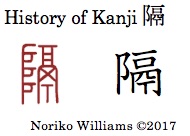 The left side of the seal style writing became a bushu kozatohen in kanji. A bushu kozatohen had various meanings – “a hill or mountains placed vertically,” which signified “a pile of dirt; a dirt wall separating the area; a boundary” or “a ladder; a ladder from which a god descends.” For the kanji 隔, one view is that the left side “hill” signified separating an area, and 鬲 was used phonetically for /kaku/ to mean “to block.” Together they meant “to block; separate.” The second view is that placing a tripod in front of a divine ladder signified separation of a sacred area from a secular area. The third view is that inside the pod (鬲) there was a division between grains at the top and water in the legs to cook the contents, and it signified “to separate.” If we take the first view, “hills separating areas” gave the meaning “to isolate; insulate.” The kanji 隔 means “to separate; insulate.”
The left side of the seal style writing became a bushu kozatohen in kanji. A bushu kozatohen had various meanings – “a hill or mountains placed vertically,” which signified “a pile of dirt; a dirt wall separating the area; a boundary” or “a ladder; a ladder from which a god descends.” For the kanji 隔, one view is that the left side “hill” signified separating an area, and 鬲 was used phonetically for /kaku/ to mean “to block.” Together they meant “to block; separate.” The second view is that placing a tripod in front of a divine ladder signified separation of a sacred area from a secular area. The third view is that inside the pod (鬲) there was a division between grains at the top and water in the legs to cook the contents, and it signified “to separate.” If we take the first view, “hills separating areas” gave the meaning “to isolate; insulate.” The kanji 隔 means “to separate; insulate.”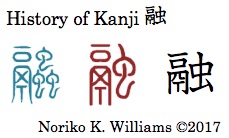 In large seal style, in light blue, which predated small seal style, (in this blog we simply call it seal style) and in seal style, it had 鬲 “a clay tripod to cook in,” and 蟲 that was used phonetically for /chuu/ to mean “to come out.” Together steam coming out during cooking gave the meaning of “something melting coming out.” In seal style, the right side 蟲 became 虫. The kanji 融 means “to melt; dissolve.” <the composition of the kanji 融: 鬲 and 虫>
In large seal style, in light blue, which predated small seal style, (in this blog we simply call it seal style) and in seal style, it had 鬲 “a clay tripod to cook in,” and 蟲 that was used phonetically for /chuu/ to mean “to come out.” Together steam coming out during cooking gave the meaning of “something melting coming out.” In seal style, the right side 蟲 became 虫. The kanji 融 means “to melt; dissolve.” <the composition of the kanji 融: 鬲 and 虫> (a) in oracle bone style had “a tripod” and “a hand,” signifying “a person laying tripods in a row by hand.” In (b) in bronze ware style “a footprint” was added to signify “keeping on doing something.” It meant “to penetrate; stick to.” (c) in Old style, in purple, had 彳 “a crossroad,” taking the place of “a footprint,” 鬲 “a tripod” and 攴 “to cause an action.” In (d) in seal style 鬲 was replaced by 育. Some scholars view this as miscopied. The kanji 徹 took (d). The kanji 徹 means “to do thoroughly; penetrate; stick to.”
(a) in oracle bone style had “a tripod” and “a hand,” signifying “a person laying tripods in a row by hand.” In (b) in bronze ware style “a footprint” was added to signify “keeping on doing something.” It meant “to penetrate; stick to.” (c) in Old style, in purple, had 彳 “a crossroad,” taking the place of “a footprint,” 鬲 “a tripod” and 攴 “to cause an action.” In (d) in seal style 鬲 was replaced by 育. Some scholars view this as miscopied. The kanji 徹 took (d). The kanji 徹 means “to do thoroughly; penetrate; stick to.”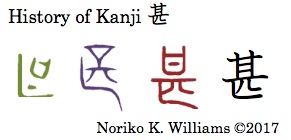 In bronze ware style, Old style, and seal style it was a brazier (a portable cooking apparatus) with a pot on top. It meant “to cook food thoroughly over a fire.” From cooking food over a heat well it meant “thoroughly” or “excessively.” This is the account by Shirakawa. Another view that other scholars take is based on the account on Setsumon Kaiji — it signified pleasure between a man and a woman. Looking at the bronze ware style writing a brazier with a pot makes more sense to me until I come across something else in the future. The kanji 甚 meant “exceedingly; intense.” <the composition of the kanji 甚: 其 and an angle on the bottom left>
In bronze ware style, Old style, and seal style it was a brazier (a portable cooking apparatus) with a pot on top. It meant “to cook food thoroughly over a fire.” From cooking food over a heat well it meant “thoroughly” or “excessively.” This is the account by Shirakawa. Another view that other scholars take is based on the account on Setsumon Kaiji — it signified pleasure between a man and a woman. Looking at the bronze ware style writing a brazier with a pot makes more sense to me until I come across something else in the future. The kanji 甚 meant “exceedingly; intense.” <the composition of the kanji 甚: 其 and an angle on the bottom left>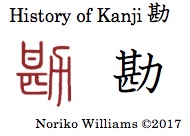 The seal style writing comprised 甚 “thoroughly; exceedingly” and 力 “effort.” Together they meant “to look over thoroughly or check against something else.” In Japanese it is also used to mean “perceptiveness; intuition.” The kanji 勘 means “to investigate; perceptiveness; intuition; sixth sense.” <the composition of the kanji 勘; 甚 and 力>
The seal style writing comprised 甚 “thoroughly; exceedingly” and 力 “effort.” Together they meant “to look over thoroughly or check against something else.” In Japanese it is also used to mean “perceptiveness; intuition.” The kanji 勘 means “to investigate; perceptiveness; intuition; sixth sense.” <the composition of the kanji 勘; 甚 and 力>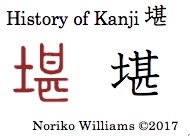 The seal style writing comprised 土 “soil; ground,” and 甚 “excessive,” which was used phonetically for /kan; tan/. Together they originally meant “a large mound of soil,” possibly “a kiln” (Shirakawa). What was baked in a kiln went through extreme heat and it gave the meaning “to endure; bear.” The kanji 堪 means “to withstand; bear; tolerate.” <the composition of the kanji 堪: 土へん and 甚>
The seal style writing comprised 土 “soil; ground,” and 甚 “excessive,” which was used phonetically for /kan; tan/. Together they originally meant “a large mound of soil,” possibly “a kiln” (Shirakawa). What was baked in a kiln went through extreme heat and it gave the meaning “to endure; bear.” The kanji 堪 means “to withstand; bear; tolerate.” <the composition of the kanji 堪: 土へん and 甚>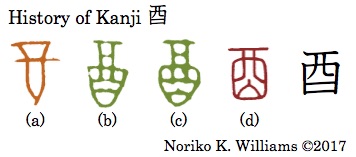 The common component 酉 here is not a Joyo kanji. In all of the ancient writings shown on the right – (a) in oracle bone style, in brown, (b) and (c) in bronze ware style, in green, and (d) seal style, in red, – was “a rice wine cask” or “a cask to keep fermented liquid in.” So all the kanji that we are going to look at pertain to “fermentation” at one stage of the history.
The common component 酉 here is not a Joyo kanji. In all of the ancient writings shown on the right – (a) in oracle bone style, in brown, (b) and (c) in bronze ware style, in green, and (d) seal style, in red, – was “a rice wine cask” or “a cask to keep fermented liquid in.” So all the kanji that we are going to look at pertain to “fermentation” at one stage of the history.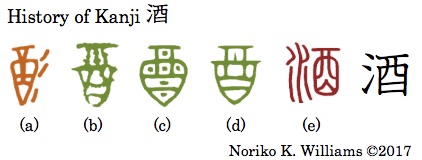 In oracle bone style (a), “a rice wine cask” was on the left and “water; liquid” on the right. In bronze ware style (b), (c) and (d) “a rice wine cask” was standing alone but the small dots in (c) were pointing out its contents rather than the cask as a container. Together they meant “rice wine.” In (e) in seal style “water; liquid” was separately added to a wine cask, possibly signifying that it was the liquid from which sake lees had been removed. The kanji 酒 means “rice wine; fermented drink; alcohol beverage.” <The composition of the kanji 酒: 氵and 酉>
In oracle bone style (a), “a rice wine cask” was on the left and “water; liquid” on the right. In bronze ware style (b), (c) and (d) “a rice wine cask” was standing alone but the small dots in (c) were pointing out its contents rather than the cask as a container. Together they meant “rice wine.” In (e) in seal style “water; liquid” was separately added to a wine cask, possibly signifying that it was the liquid from which sake lees had been removed. The kanji 酒 means “rice wine; fermented drink; alcohol beverage.” <The composition of the kanji 酒: 氵and 酉> (a) in oracle bone style, (b) and (c) in bronze ware style and (d) in seal style all comprised “a wine cask” on the left and “a squatting person looking at the cask.” He was waiting for rice wine to be handed out to him. It means “to hand out; deal.” In (d) in seal style and kanji 配, the person took the shape 己 “a squatting person; a person.” The kanji 配 means “to distribute; to hand out; to arrange.” <The composition of the kanji 配: 酉 and 己>
(a) in oracle bone style, (b) and (c) in bronze ware style and (d) in seal style all comprised “a wine cask” on the left and “a squatting person looking at the cask.” He was waiting for rice wine to be handed out to him. It means “to hand out; deal.” In (d) in seal style and kanji 配, the person took the shape 己 “a squatting person; a person.” The kanji 配 means “to distribute; to hand out; to arrange.” <The composition of the kanji 配: 酉 and 己>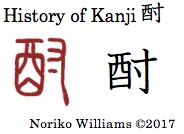 The seal style writing comprised 酉 “a rice wine cask,” and 寸 “a hand,” which was used phonetically for /chuu/. Together they meant “flavorful wine that was filtered three times.” The kanji 酎 means “flavorful rice wine.” <The composition of the kanji 酎: 酉 and 寸>
The seal style writing comprised 酉 “a rice wine cask,” and 寸 “a hand,” which was used phonetically for /chuu/. Together they meant “flavorful wine that was filtered three times.” The kanji 酎 means “flavorful rice wine.” <The composition of the kanji 酎: 酉 and 寸>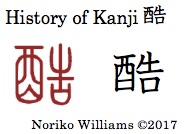 The seal style writing comprised 酉 “a rice wine cask,” and 告, which was used phonetically for /koku/. Together they meant “intense taste of alcohol.” From that the kanji 酷 means “intense; cruel; harsh.” The phrase 酷のある /koku-no-a’ru/ “full-bodied; robust” is usually written in katakana コク nowadays. <The composition of the kanji 酷: 酉 and 告>
The seal style writing comprised 酉 “a rice wine cask,” and 告, which was used phonetically for /koku/. Together they meant “intense taste of alcohol.” From that the kanji 酷 means “intense; cruel; harsh.” The phrase 酷のある /koku-no-a’ru/ “full-bodied; robust” is usually written in katakana コク nowadays. <The composition of the kanji 酷: 酉 and 告>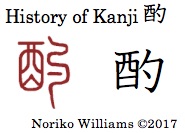 The seal style writing comprised 酉 “a rice wine cask,” and 勺 “a ladle scooping up,” which was used phonetically for /shaku/. Together they meant “a ladle scooping up wine.” The kanji 酌 means “to serve wine; scoop out sake.” <The composition of the kanji 酌: 酉 and 勺>
The seal style writing comprised 酉 “a rice wine cask,” and 勺 “a ladle scooping up,” which was used phonetically for /shaku/. Together they meant “a ladle scooping up wine.” The kanji 酌 means “to serve wine; scoop out sake.” <The composition of the kanji 酌: 酉 and 勺>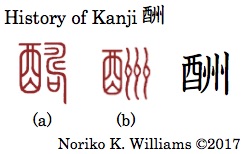 In seal style (a) and (b) had 酉 “a rice wine cask” on the left. The right side of (a), 寿 (the kyuji 壽) “long life; auspicious,” was used phonetically for /shuu/. Together they originally meant “to offer a drink of wine to a guest.” Later it meant “to reply; reward.” In (b) 壽 was replaced by the phonetically same 州 /shuu/. The kanji 酬 is also used for “fee.” <The composition of the kanji 酬: 酉 and 州>
In seal style (a) and (b) had 酉 “a rice wine cask” on the left. The right side of (a), 寿 (the kyuji 壽) “long life; auspicious,” was used phonetically for /shuu/. Together they originally meant “to offer a drink of wine to a guest.” Later it meant “to reply; reward.” In (b) 壽 was replaced by the phonetically same 州 /shuu/. The kanji 酬 is also used for “fee.” <The composition of the kanji 酬: 酉 and 州>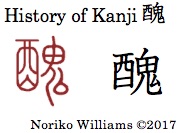 The seal style writing comprised 酉 “a rice wine cask,” which was used phonetically for /shuu/. The right side was 鬼 “spirit of a deceased; ghost,” which had a frightfully ugly face and ム “a floating spirit.” Together they meant “ugly; mean-spirited; shameful.” <The composition of the kanji 醜: 酉 and 鬼>
The seal style writing comprised 酉 “a rice wine cask,” which was used phonetically for /shuu/. The right side was 鬼 “spirit of a deceased; ghost,” which had a frightfully ugly face and ム “a floating spirit.” Together they meant “ugly; mean-spirited; shameful.” <The composition of the kanji 醜: 酉 and 鬼>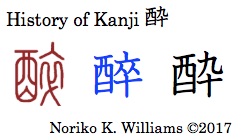 The seal style writing comprised 酉 “a rice wine cask,” and 卒 “to end,” which was used phonetically for /sui/. Together they meant “to drink rice wine to finish off” – thus “to be drunk.” The kyuji 醉, in blue, reflected seal style, but in shinji 酔 the right side 卒 was replaced by 卆. The kanji 酔 means “to become drunk; get inebriated on sake; be intoxicated.” <The composition of the kanji 酔: 酉 and 卆>
The seal style writing comprised 酉 “a rice wine cask,” and 卒 “to end,” which was used phonetically for /sui/. Together they meant “to drink rice wine to finish off” – thus “to be drunk.” The kyuji 醉, in blue, reflected seal style, but in shinji 酔 the right side 卒 was replaced by 卆. The kanji 酔 means “to become drunk; get inebriated on sake; be intoxicated.” <The composition of the kanji 酔: 酉 and 卆> The seal style writing comprised 酉 “a rice wine cask,” and 星, which was used phonetically for /see/. Together they meant “to sober up from being drunk,” that is “to awaken; have clear awareness.” The kanji 醒 means “to awaken; have clear awareness.” <The composition of the kanji 醒: 酉and 星>
The seal style writing comprised 酉 “a rice wine cask,” and 星, which was used phonetically for /see/. Together they meant “to sober up from being drunk,” that is “to awaken; have clear awareness.” The kanji 醒 means “to awaken; have clear awareness.” <The composition of the kanji 醒: 酉and 星>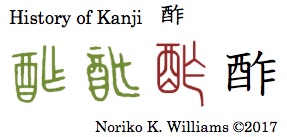 The two bronze ware style writings had “a cask of fermented liquid” (酉), and 乍, which was used phonetically for /saku/ to mean “something past,” which is related to the kanji 昨. Rice wine that went bad is vinegar. The kanji 酢 means “vinegar.” <The composition of the kanji 醒: 酉 and 星>
The two bronze ware style writings had “a cask of fermented liquid” (酉), and 乍, which was used phonetically for /saku/ to mean “something past,” which is related to the kanji 昨. Rice wine that went bad is vinegar. The kanji 酢 means “vinegar.” <The composition of the kanji 醒: 酉 and 星>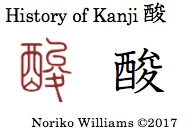 The seal style writing comprised 酉 “a wine cask,” and 夋, which was used phonetically for /san/ to mean “sour.” When wine goes bad it becomes sour. The kanji means “acidic; sour.” <The composition of the kanji 酸: 酉 and 夋>
The seal style writing comprised 酉 “a wine cask,” and 夋, which was used phonetically for /san/ to mean “sour.” When wine goes bad it becomes sour. The kanji means “acidic; sour.” <The composition of the kanji 酸: 酉 and 夋>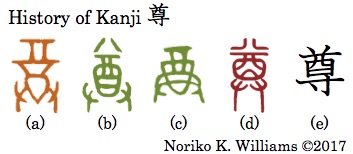 For the kanji 尊 in oracle bone style, in brown, (a) was “a wine cask presented reverentially to a god with two hands.” It meant “to revere; respect.” In bronze ware style, in green, (b) had a ハ shape that signified “rising alcoholic spirit.” (c) in bronze ware style, and (d) in seal style, in red, had the same components as (a). In kanji the two hands at the bottom became the kanji 寸. The kanji 尊 means “to revere; respect.” <the composition of the kanji 尊: a truncated ソ, 酉 and 寸>
For the kanji 尊 in oracle bone style, in brown, (a) was “a wine cask presented reverentially to a god with two hands.” It meant “to revere; respect.” In bronze ware style, in green, (b) had a ハ shape that signified “rising alcoholic spirit.” (c) in bronze ware style, and (d) in seal style, in red, had the same components as (a). In kanji the two hands at the bottom became the kanji 寸. The kanji 尊 means “to revere; respect.” <the composition of the kanji 尊: a truncated ソ, 酉 and 寸>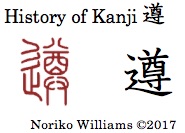 For the kanji 遵, the left side of the seal style writing was 辵, a precursor of the bushu shinnyoo “to move forward.” The right side was the same as (d) in 1.尊 “to respect; revere; value highly,” and was used phonetically for /jun/ to mean “to observe.” One conducting himself with a respect (of the precedent) gave the meaning “to follow; obey.” The kanji 遵 means “to observe law or precedent; obey.” <the composition of the kanji 遵: 尊 and a bushu shinnyoo>
For the kanji 遵, the left side of the seal style writing was 辵, a precursor of the bushu shinnyoo “to move forward.” The right side was the same as (d) in 1.尊 “to respect; revere; value highly,” and was used phonetically for /jun/ to mean “to observe.” One conducting himself with a respect (of the precedent) gave the meaning “to follow; obey.” The kanji 遵 means “to observe law or precedent; obey.” <the composition of the kanji 遵: 尊 and a bushu shinnyoo>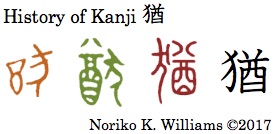 The origin of the kanji 猶 was also odd. The oracle bone style writing had “a wine cask,” which was used phonetically for /yuu/, and “a dog; animal.” The bronze ware style writing and the seal style writing had the same two components in more developed shapes. Some view that it was originally an animal that climbed a tree, such as a monkey. From a suspicious-natured monkey, it meant “to be suspicious; hesitate.” (This account sounds odd to me, but I do not have any better one here.) In kanji the animal became 犭, a bushu kemonohen “animal; dog.” The kanji 猶 is used to mean “to hesitate; take time; furthermore.” <the composition of the kanji 猶:犭and a truncated ソ and 酉>
The origin of the kanji 猶 was also odd. The oracle bone style writing had “a wine cask,” which was used phonetically for /yuu/, and “a dog; animal.” The bronze ware style writing and the seal style writing had the same two components in more developed shapes. Some view that it was originally an animal that climbed a tree, such as a monkey. From a suspicious-natured monkey, it meant “to be suspicious; hesitate.” (This account sounds odd to me, but I do not have any better one here.) In kanji the animal became 犭, a bushu kemonohen “animal; dog.” The kanji 猶 is used to mean “to hesitate; take time; furthermore.” <the composition of the kanji 猶:犭and a truncated ソ and 酉> The kanji 爵 has a large number of ancient writings in various shapes. In (a) and (b) in oracle bone style, (c), (d) and (e) in bronze ware style it was a three-legged wine holder for warm rice wine that was used in a religious ceremony. A ruler giving such an item to a subject was a part of a ceremony conferring honor. The kanji 爵 means “peerage; titular rank.” <the composition of the kanji 爵: “a hand from above,” 罒, the left side of 即 and 寸>
The kanji 爵 has a large number of ancient writings in various shapes. In (a) and (b) in oracle bone style, (c), (d) and (e) in bronze ware style it was a three-legged wine holder for warm rice wine that was used in a religious ceremony. A ruler giving such an item to a subject was a part of a ceremony conferring honor. The kanji 爵 means “peerage; titular rank.” <the composition of the kanji 爵: “a hand from above,” 罒, the left side of 即 and 寸> For the kanji 午 in oracle bone style, (a) was “a skein of thread” whereas (b) was “a pestle,” which was used for “pounding grains in a mortar.” In (c) and (d) in bronze ware style and (f) in seal style it was also “a pestle.” The pounding motion of a pestle was a straight vertical motion. The shape appeared in other kanji to signify something in the middle. Later it was borrowed to mean “noon.” The kanji 午 means “noon.”
For the kanji 午 in oracle bone style, (a) was “a skein of thread” whereas (b) was “a pestle,” which was used for “pounding grains in a mortar.” In (c) and (d) in bronze ware style and (f) in seal style it was also “a pestle.” The pounding motion of a pestle was a straight vertical motion. The shape appeared in other kanji to signify something in the middle. Later it was borrowed to mean “noon.” The kanji 午 means “noon.” For the kanji 許, in bronze ware style and seal style the left side was “word; language; to speak,” and “a pestle” 午 on the right side was used phonetically for /kyo/. The kanji 許 means “to permit; allow; forgive.” <the kanji 許: 言 and 午>
For the kanji 許, in bronze ware style and seal style the left side was “word; language; to speak,” and “a pestle” 午 on the right side was used phonetically for /kyo/. The kanji 許 means “to permit; allow; forgive.” <the kanji 許: 言 and 午> For the kanji 御 in oracle bone style it had “a person who was kneeling down” in front of either “a pestle” (a) or “a skein of thread” (b). It meant “to handle or control something.” In bronze ware style (c) had the same two components, whereas (d) had “a crossroad” and “a footprint,” adding the meaning “going.” Together they meant “to steer a horse carriage to control where it was going.” In (e) in Old style it had two totally different components – “a horse” and “a hand”-, and they meant “to steer a horse by hand.” In seal style (f) had “a crossroad” (彳) on the left, “a pestle” (午) and “a footprint” (止) coalesced in the middle and “a kneeling person” (卩) on the right. A posture of kneeling down doing something was a humble posture, and it was used as an honorific prefix or suffix. The kanji 御 means “to control; manipulate; honorific affix.” <the composition of the kanji 御:彳and 卸>
For the kanji 御 in oracle bone style it had “a person who was kneeling down” in front of either “a pestle” (a) or “a skein of thread” (b). It meant “to handle or control something.” In bronze ware style (c) had the same two components, whereas (d) had “a crossroad” and “a footprint,” adding the meaning “going.” Together they meant “to steer a horse carriage to control where it was going.” In (e) in Old style it had two totally different components – “a horse” and “a hand”-, and they meant “to steer a horse by hand.” In seal style (f) had “a crossroad” (彳) on the left, “a pestle” (午) and “a footprint” (止) coalesced in the middle and “a kneeling person” (卩) on the right. A posture of kneeling down doing something was a humble posture, and it was used as an honorific prefix or suffix. The kanji 御 means “to control; manipulate; honorific affix.” <the composition of the kanji 御:彳and 卸> The kanji 卸 is the original shape of the kanji 御. The bronze ware style writing comprised “a pestle” and “a kneeling person.” They meant “to steer a horse.” In seal style “a footprint” (止) was added. Together they meant “stopping a horse to unload a crate from a horse or carriage.” Unloading a crate also meant “wholesale.” The kanji 卸 means “to drive a horse cart; to operate; run; wholesale.” <the composition of the kanji 卸: 午 and 止 coalesced and 卩>
The kanji 卸 is the original shape of the kanji 御. The bronze ware style writing comprised “a pestle” and “a kneeling person.” They meant “to steer a horse.” In seal style “a footprint” (止) was added. Together they meant “stopping a horse to unload a crate from a horse or carriage.” Unloading a crate also meant “wholesale.” The kanji 卸 means “to drive a horse cart; to operate; run; wholesale.” <the composition of the kanji 卸: 午 and 止 coalesced and 卩>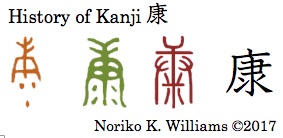 For the kanji 康 in oracle bone style it was “an apparatus (with a pestle) to thresh grain, with hulls dropping down.” In bronze ware style two hands were added in the middle. In seal style it had “a pestle” in the middle, and “two hands” that were “threshing rice” in the middle. Threshing rice to provide food gave the meaning of “good livelihood and health.” The kanji 康 means “peaceful and healthy.” <the composition of the kanji 康: 广 and >
For the kanji 康 in oracle bone style it was “an apparatus (with a pestle) to thresh grain, with hulls dropping down.” In bronze ware style two hands were added in the middle. In seal style it had “a pestle” in the middle, and “two hands” that were “threshing rice” in the middle. Threshing rice to provide food gave the meaning of “good livelihood and health.” The kanji 康 means “peaceful and healthy.” <the composition of the kanji 康: 广 and > In (a) and (b) in oracle bone style and (c) in bronze ware style the top had “two hands holding a pestle to thresh grain,” and was used phonetically for /too/. The bottom was 口 “mouth.” In (d) in Old style 昜 was used phonetically for /too/. (e) in seal style reflected (c). The kanji 唐 is used for the name of the Chinese Tang dynasty (618-907). It was the time when Japan imported many aspects of Chinese culture by sending official envoys called 遣唐使 /kento’oshi/, including kan-on reading of kanji. In Japanese it was used to mean “Chinese.” <the composition of the kanji 唐: 广, “a hand from the sideways” with a vertical line and 口>
In (a) and (b) in oracle bone style and (c) in bronze ware style the top had “two hands holding a pestle to thresh grain,” and was used phonetically for /too/. The bottom was 口 “mouth.” In (d) in Old style 昜 was used phonetically for /too/. (e) in seal style reflected (c). The kanji 唐 is used for the name of the Chinese Tang dynasty (618-907). It was the time when Japan imported many aspects of Chinese culture by sending official envoys called 遣唐使 /kento’oshi/, including kan-on reading of kanji. In Japanese it was used to mean “Chinese.” <the composition of the kanji 唐: 广, “a hand from the sideways” with a vertical line and 口>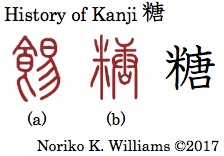 The kanji 糖 in seal style (a) comprised 食 “food; to eat” and 昜, which was used phonetically for /too/ to mean “sugar; candy.” (b) comprised 米 “rice” and 唐, which was used phonetically for /too/ to mean “to stretch” in making candies out of sweet rice. Whichever the explanation is, the kanji 糖 meant “sugar.” <the composition of the kanji 糖: the kanji 米 and 唐>
The kanji 糖 in seal style (a) comprised 食 “food; to eat” and 昜, which was used phonetically for /too/ to mean “sugar; candy.” (b) comprised 米 “rice” and 唐, which was used phonetically for /too/ to mean “to stretch” in making candies out of sweet rice. Whichever the explanation is, the kanji 糖 meant “sugar.” <the composition of the kanji 糖: the kanji 米 and 唐>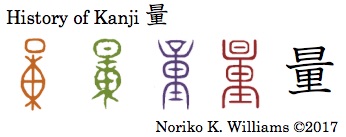 In oracle bone style, in brown, in bronze, and in bronze ware style, in brown, the top round shape signified an opening of a bag tied below. It signified a scale to weigh a bag of grain. What was weighed meant “mass; amount.” In Old style, in purple, and seal style, in red, 土 “dirt” was added at the bottom, and the bottom shape became 里. It is similar to the history of kanji such a 重 “heavy” and 動 “to move.” The kanji 量 means “mass, amount.”
In oracle bone style, in brown, in bronze, and in bronze ware style, in brown, the top round shape signified an opening of a bag tied below. It signified a scale to weigh a bag of grain. What was weighed meant “mass; amount.” In Old style, in purple, and seal style, in red, 土 “dirt” was added at the bottom, and the bottom shape became 里. It is similar to the history of kanji such a 重 “heavy” and 動 “to move.” The kanji 量 means “mass, amount.”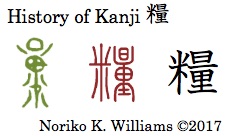 In bronze ware style it had a bag tied in the middle with an opening on top, which was the same as 量 “a scale to measure grains.” The bottom was probably “rice.” Together rice measured meant “food; provisions.” In seal style 米 was placed on the left side of 量 as a bushu komehen. The kanji 糧 means “food; provisions.”
In bronze ware style it had a bag tied in the middle with an opening on top, which was the same as 量 “a scale to measure grains.” The bottom was probably “rice.” Together rice measured meant “food; provisions.” In seal style 米 was placed on the left side of 量 as a bushu komehen. The kanji 糧 means “food; provisions.”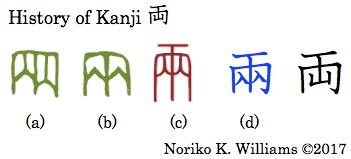 One view of the origin is that the symmetrical shape was “a scale.” Another takes it as “a gourd split in two with dry seeds inside” and the third one is that it was “a handle of a horse carrier to pull two horses.” The kyuji 兩, (d) in blue, reflected (c) in seal style which had a line at the top. Ryo was a unit of currency in gold before Meiji, based on its weight. It is also used as a counter of train cars in railway. The kanji 両 means “two; double; both; a car of train; ryo (a old unit of currency).”
One view of the origin is that the symmetrical shape was “a scale.” Another takes it as “a gourd split in two with dry seeds inside” and the third one is that it was “a handle of a horse carrier to pull two horses.” The kyuji 兩, (d) in blue, reflected (c) in seal style which had a line at the top. Ryo was a unit of currency in gold before Meiji, based on its weight. It is also used as a counter of train cars in railway. The kanji 両 means “two; double; both; a car of train; ryo (a old unit of currency).”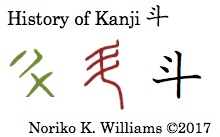 In bronze ware style and seal style it was “a ladle with a handle for scooping rice wine,” and was used phonetically for /to/. It was used as a unit of volume. One to in Japan was 18 liters. The kanji 斗 means “ladle; dipper; measurement unit for liquid.”
In bronze ware style and seal style it was “a ladle with a handle for scooping rice wine,” and was used phonetically for /to/. It was used as a unit of volume. One to in Japan was 18 liters. The kanji 斗 means “ladle; dipper; measurement unit for liquid.”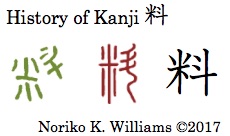 In bronze ware style it is comprised of “rice grains” (米) and “a measuring ladle” (斗). Together they meant “measured amount of food.” An official measure food to charge a fee. The kanji 料 means “to measure; food; fee; provisions.”
In bronze ware style it is comprised of “rice grains” (米) and “a measuring ladle” (斗). Together they meant “measured amount of food.” An official measure food to charge a fee. The kanji 料 means “to measure; food; fee; provisions.”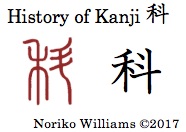 The seal style writing comprised “a rice plant” (禾), which became a bushu nogihen in kanji, and “a measuring ladle” (斗). Various types of grains such as rice were sorted out using a measuring ladle and were classified. It meant “classification; section; department.” Authorities also measured an appropriate amount of fee and penalty, and it meant “to charge a penalty; conviction.” The kanji 科 means “section; department; charge; penalty; conviction.”
The seal style writing comprised “a rice plant” (禾), which became a bushu nogihen in kanji, and “a measuring ladle” (斗). Various types of grains such as rice were sorted out using a measuring ladle and were classified. It meant “classification; section; department.” Authorities also measured an appropriate amount of fee and penalty, and it meant “to charge a penalty; conviction.” The kanji 科 means “section; department; charge; penalty; conviction.”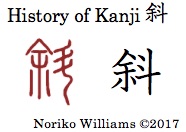 The seal style writing comprised 余, which was used phonetically for /yo; sha/, and 斗 “a measuring ladle.” When one scoops liquid using a ladle, the ladle is held diagonally. From that the kanji 斜 means “diagonal; slanted.”
The seal style writing comprised 余, which was used phonetically for /yo; sha/, and 斗 “a measuring ladle.” When one scoops liquid using a ladle, the ladle is held diagonally. From that the kanji 斜 means “diagonal; slanted.”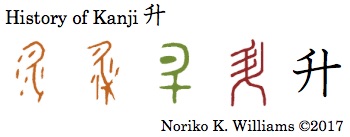 In the two oracle bone style writings we can see grains or liquid that this measuring ladle was scooping up. It is very similar to 斗. In bronze ware style a dot inside the cup still signified that it was not empty. 4 in seal style the three diagonal lines was simplified to one in kanji 升. One sho was 1.8 liters. The kanji 升 means “sho,” a pre-metric measurement system for liquid.
In the two oracle bone style writings we can see grains or liquid that this measuring ladle was scooping up. It is very similar to 斗. In bronze ware style a dot inside the cup still signified that it was not empty. 4 in seal style the three diagonal lines was simplified to one in kanji 升. One sho was 1.8 liters. The kanji 升 means “sho,” a pre-metric measurement system for liquid. For the kanji 復, (a) in oracle bone style, in brown, had a cylindrical shape with a small end at the top and the bottom. This was an apparatus which one flipped up and down repeatedly in measuring grain. Underneath it was “a backward foot,”(夂) signifying “a return.” They meant “a repeated motion of going back-and-forth.” In bronze ware style (b) and (c), in green, “a crossroad” (彳) and “a hand” at the bottom were added. In (c) another “forward-facing footprint” is also seen to emphasize a repeated action of “going” and “coming” (by a backward footprint.) In (d) in seal style, in red, a forward-facing footprint was dropped. In kanji the two rounds that signified “a repeat” was changed to 日. The kanji 復 means “to repeat; return way; again.” <the composition of the kanji 復: 彳, ノ,一, 日 and 夂>
For the kanji 復, (a) in oracle bone style, in brown, had a cylindrical shape with a small end at the top and the bottom. This was an apparatus which one flipped up and down repeatedly in measuring grain. Underneath it was “a backward foot,”(夂) signifying “a return.” They meant “a repeated motion of going back-and-forth.” In bronze ware style (b) and (c), in green, “a crossroad” (彳) and “a hand” at the bottom were added. In (c) another “forward-facing footprint” is also seen to emphasize a repeated action of “going” and “coming” (by a backward footprint.) In (d) in seal style, in red, a forward-facing footprint was dropped. In kanji the two rounds that signified “a repeat” was changed to 日. The kanji 復 means “to repeat; return way; again.” <the composition of the kanji 復: 彳, ノ,一, 日 and 夂>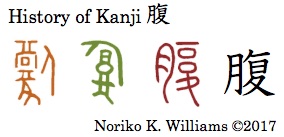 For the kanji 腹, in oracle bone style and in bronze ware style it had “a measuring tool with a thick middle,” which was (a) in oracle bone style 腹 above. With “a backward footprint” together they were used phonetically for /huku/ and signify a repeated action. To this component “a person” was added on the right. In 3 in seal style “a person” was replaced by 月, a bushu nikuzuki “flesh; a part of a body.” The part of one’s body that is thick is one’s abdomen. It meant “abdomen.” The kanji 腹 means “abdomen; belly; middle.” <the composition of the kanji 腹: 月 and the right side of 復>
For the kanji 腹, in oracle bone style and in bronze ware style it had “a measuring tool with a thick middle,” which was (a) in oracle bone style 腹 above. With “a backward footprint” together they were used phonetically for /huku/ and signify a repeated action. To this component “a person” was added on the right. In 3 in seal style “a person” was replaced by 月, a bushu nikuzuki “flesh; a part of a body.” The part of one’s body that is thick is one’s abdomen. It meant “abdomen.” The kanji 腹 means “abdomen; belly; middle.” <the composition of the kanji 腹: 月 and the right side of 復>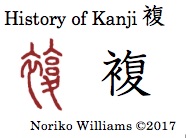 For the kanji 複, the seal style writing comprised 衣 “collar,” signifying “something in a fold,” and the right side of 復 meaning “to repeat,” which was used phonetically for /huku/. Together they meant “to duplicate.” In kanji the left became 衤, a bushu koromohen “clothing.” The kanji 複 meant “to duplicate; copy” and also “complex.” <the composition of the kanji 複: 衤 and the right side of 復>
For the kanji 複, the seal style writing comprised 衣 “collar,” signifying “something in a fold,” and the right side of 復 meaning “to repeat,” which was used phonetically for /huku/. Together they meant “to duplicate.” In kanji the left became 衤, a bushu koromohen “clothing.” The kanji 複 meant “to duplicate; copy” and also “complex.” <the composition of the kanji 複: 衤 and the right side of 復>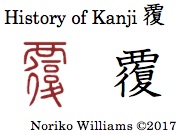 For the kanji 覆, the top of the seal style writing, 襾, was “a cover on an opening with the stopper in the middle.” The bottom 復 originally meant “to flip over a measuring apparatus,” and was used phonetically for /huku/. In kanji the top became 覀. Together they meant “to overturn; cover.” The kanji 覆 means “to cover; overturn; flip over.” <the composition of the kanji 覆: 覀 and 復>
For the kanji 覆, the top of the seal style writing, 襾, was “a cover on an opening with the stopper in the middle.” The bottom 復 originally meant “to flip over a measuring apparatus,” and was used phonetically for /huku/. In kanji the top became 覀. Together they meant “to overturn; cover.” The kanji 覆 means “to cover; overturn; flip over.” <the composition of the kanji 覆: 覀 and 復>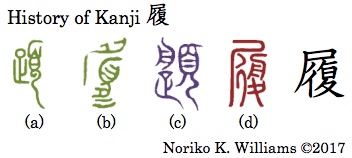 The kanji 履 contains 復. However, it came from a very different origin. (a) in bronze ware style had “a leg” and “a person with a formal hat.” (b) in bronze ware style and (c) in Old style, in purple, had “a boat shape footwear” (signifying “to transport”) and “a person; head” (頁). Together they meant “one goes forward with footwear on” or “to perform.” In seal style (d) was replaced by 復 under 尸, a bushu shikabane. The kanji 履 means “clogs; to put on footwear; to perform; carry out.” <the composition of the kanji 履: 尸 and 復>
The kanji 履 contains 復. However, it came from a very different origin. (a) in bronze ware style had “a leg” and “a person with a formal hat.” (b) in bronze ware style and (c) in Old style, in purple, had “a boat shape footwear” (signifying “to transport”) and “a person; head” (頁). Together they meant “one goes forward with footwear on” or “to perform.” In seal style (d) was replaced by 復 under 尸, a bushu shikabane. The kanji 履 means “clogs; to put on footwear; to perform; carry out.” <the composition of the kanji 履: 尸 and 復>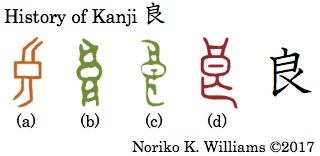 For the kanji 良 (a) in oracle bone style, (b) and (c) in bronze ware style was “an apparatus to select good grains”– The top was the opening to pour grain in and to blow air through to remove bad grains, and good ones were taken out from the bottom. (d) in seal style still retained that meaning in its shape, but in kanji there is little remnant to tell us its history. The kanji 良 meant “good; excellent; true.”
For the kanji 良 (a) in oracle bone style, (b) and (c) in bronze ware style was “an apparatus to select good grains”– The top was the opening to pour grain in and to blow air through to remove bad grains, and good ones were taken out from the bottom. (d) in seal style still retained that meaning in its shape, but in kanji there is little remnant to tell us its history. The kanji 良 meant “good; excellent; true.”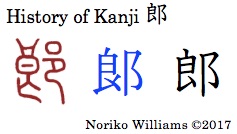 For the kanji 郎 in seal style it comprised 良, which was used phonetically for /roo/, and 邑 “town; village,” which became 阝, a bushu oozato. It was originally the name of a town. 郎 was used to mean a government official, and it came to be used in a male name. The kyuji 郞, in blue, had 良 on the left, which became simplified by dropping a stroke in shinji. The kanji 郎 means “man.” <the composition of the kanji 郎: 良 without the 6th stroke and 阝>
For the kanji 郎 in seal style it comprised 良, which was used phonetically for /roo/, and 邑 “town; village,” which became 阝, a bushu oozato. It was originally the name of a town. 郎 was used to mean a government official, and it came to be used in a male name. The kyuji 郞, in blue, had 良 on the left, which became simplified by dropping a stroke in shinji. The kanji 郎 means “man.” <the composition of the kanji 郎: 良 without the 6th stroke and 阝> For the kanji 朗 in seal style it comprised 月 “moon,” signifying “bright light of a moon,” and 良 “good,” which was used phonetically for /roo/. Together they meant “clear and bright.” In the kyuji 朗, 2, the positions of the two components were swapped. In shinji 良 was simplified in shinji by dropping a stroke. The kanji 朗 means “cheerful; lively.” <the composition of the kanji 朗: 良 without the 6th stroke and 月>
For the kanji 朗 in seal style it comprised 月 “moon,” signifying “bright light of a moon,” and 良 “good,” which was used phonetically for /roo/. Together they meant “clear and bright.” In the kyuji 朗, 2, the positions of the two components were swapped. In shinji 良 was simplified in shinji by dropping a stroke. The kanji 朗 means “cheerful; lively.” <the composition of the kanji 朗: 良 without the 6th stroke and 月>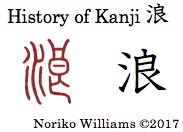 For the kanji 浪, the seal style writing comprised “water” and 良, which was used phonetically for /roo/. Together they were used as the name of a river. The right side 良 originated from an apparatus of selecting good grains in which grains were shaken and moved about, like “waves.” The kanji 浪 was borrowed to mean “wave; drift; waste.” <the composition of the kanji 浪: 氵 and 良>
For the kanji 浪, the seal style writing comprised “water” and 良, which was used phonetically for /roo/. Together they were used as the name of a river. The right side 良 originated from an apparatus of selecting good grains in which grains were shaken and moved about, like “waves.” The kanji 浪 was borrowed to mean “wave; drift; waste.” <the composition of the kanji 浪: 氵 and 良>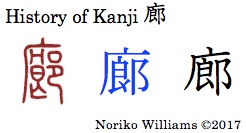 For the kanji 廊 the seal style writing had 广 a bushu madare “the eaves of a house; canopy.” Underneath was 郞 “government official,” which was used phonetically for /roo/. Officials conducted business there. The kanji 廊 means “corridor; walkway.” <the composition of the kanji: 广 and 郎 >
For the kanji 廊 the seal style writing had 广 a bushu madare “the eaves of a house; canopy.” Underneath was 郞 “government official,” which was used phonetically for /roo/. Officials conducted business there. The kanji 廊 means “corridor; walkway.” <the composition of the kanji: 广 and 郎 >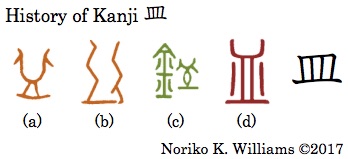 For the kanji 皿 (a) and (b) in oracle bone style, in brown, was “a stemmed dish or bowl.” It meant “dish; bowl; plate.” (c) in bronze ware style, in green, had “metal” added. (d) in seal style, in red, was back to a stemmed bowl only. The kanji 皿 means “a flat dish; plate.”
For the kanji 皿 (a) and (b) in oracle bone style, in brown, was “a stemmed dish or bowl.” It meant “dish; bowl; plate.” (c) in bronze ware style, in green, had “metal” added. (d) in seal style, in red, was back to a stemmed bowl only. The kanji 皿 means “a flat dish; plate.”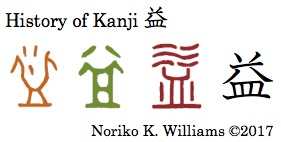 For the kanji 益 in oracle bone style and bronze ware style, a stemmed dish had “drops of water overflowing.” What was superabundant gave the meaning “to increase; gain.” In seal style the top was the seal style writing for “water” 水 that was placed sideways. The kanji 益 means “gain; profit.” <the composition of the kanji 益: a truncated ソ, 一, ハ and 皿>
For the kanji 益 in oracle bone style and bronze ware style, a stemmed dish had “drops of water overflowing.” What was superabundant gave the meaning “to increase; gain.” In seal style the top was the seal style writing for “water” 水 that was placed sideways. The kanji 益 means “gain; profit.” <the composition of the kanji 益: a truncated ソ, 一, ハ and 皿>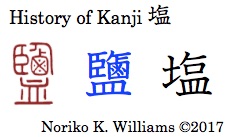 For the kanji 塩 the seal style writing and the kyuji 鹽, in blue, had a complex shape — The top left, 臣, was “a watchful eye,” and the top right had “a person looking down a salt field where dots signified salt crystals.” The bottom was “a stemmed bowl with water inside.” The makings of this writing were very similar to 監 “to watch carefully,” which was phonetically /kan/. In the kanji 塩, the initial consonant disappeared. With a salt pit added it meant “salt.” The shinji 塩 was an informal style of the kyuji 鹽. The kanji 塩 means “salt.” <the composition of the kanji 塩: a bushu tsuchihen, a short ノ, 一, a side-long 口 and 皿 >
For the kanji 塩 the seal style writing and the kyuji 鹽, in blue, had a complex shape — The top left, 臣, was “a watchful eye,” and the top right had “a person looking down a salt field where dots signified salt crystals.” The bottom was “a stemmed bowl with water inside.” The makings of this writing were very similar to 監 “to watch carefully,” which was phonetically /kan/. In the kanji 塩, the initial consonant disappeared. With a salt pit added it meant “salt.” The shinji 塩 was an informal style of the kyuji 鹽. The kanji 塩 means “salt.” <the composition of the kanji 塩: a bushu tsuchihen, a short ノ, 一, a side-long 口 and 皿 > For the kanji 温 the left side of the seal style writing was “water.” The right side had “a stemmed bowl whose steam was captured inside a lid.” Together they meant “warm; mild; gentle.” The kanji 温 means “warm; mild; gentle.” <the composition of the kanji 温: 氵, 日 and 皿>
For the kanji 温 the left side of the seal style writing was “water.” The right side had “a stemmed bowl whose steam was captured inside a lid.” Together they meant “warm; mild; gentle.” The kanji 温 means “warm; mild; gentle.” <the composition of the kanji 温: 氵, 日 and 皿>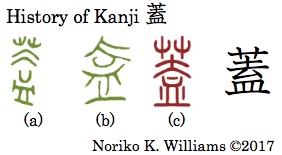 For the kanji 蓋 in bronze ware style (a) had “grass; plants” signifying “a covering like thatching” at the top while (b) did not. Both had “a lid or cover over a stemmed bowl.” In (c) in seal style the grass covering returned to signify “a cover.” The writing was also used to mean “probably; perhaps.” The kanji 蓋 means “a lid; to cover; possibly.” <the composition of the kanji 蓋: 艹, 去 and 皿>
For the kanji 蓋 in bronze ware style (a) had “grass; plants” signifying “a covering like thatching” at the top while (b) did not. Both had “a lid or cover over a stemmed bowl.” In (c) in seal style the grass covering returned to signify “a cover.” The writing was also used to mean “probably; perhaps.” The kanji 蓋 means “a lid; to cover; possibly.” <the composition of the kanji 蓋: 艹, 去 and 皿>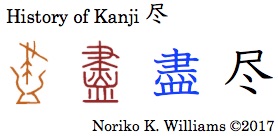 For the kanji 尽in oracle bone style it had “a stemmed bowl with a twig that was held from the top.” The twigs were used to cleanse the bowl completely. It meant “thoroughly.” In seal style it comprised “a brush (聿)” and “a stemmed bowl (皿)” along with “a fire” in the middle. The fire signified “drying.” Another view is that it was water droplets after washing that was mistaken as a fire, and became four dots in the kyuji 盡. The shinji 尽 was an informal writing of 盡. I must say that it is a drastically reduced shape from the kyuji. The kanji 尽 means “to exhaust; run out; devote.” <the composition of the kanji 尽: 尺 and the bottom of 冬>
For the kanji 尽in oracle bone style it had “a stemmed bowl with a twig that was held from the top.” The twigs were used to cleanse the bowl completely. It meant “thoroughly.” In seal style it comprised “a brush (聿)” and “a stemmed bowl (皿)” along with “a fire” in the middle. The fire signified “drying.” Another view is that it was water droplets after washing that was mistaken as a fire, and became four dots in the kyuji 盡. The shinji 尽 was an informal writing of 盡. I must say that it is a drastically reduced shape from the kyuji. The kanji 尽 means “to exhaust; run out; devote.” <the composition of the kanji 尽: 尺 and the bottom of 冬>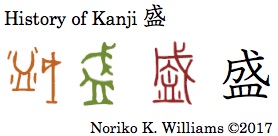 For the kanji 盛 the left side of the oracle bone style comprised “a stemmed bowl” that was “spilling out offerings”- 皿. The right side was “a long-blade halberd” that signified “to pile up,” (成) and was used phonetically used for /see/. Together offerings piled up in a stemmed bowl for a religious service meant “to thrive; prosperous; to pile up.” In bronze ware style the two components were placed top and bottom. The kanji 盛 means “to flourish; vigorous; prosper; heap.” <the composition of the kanji 盛: 成 and皿 >
For the kanji 盛 the left side of the oracle bone style comprised “a stemmed bowl” that was “spilling out offerings”- 皿. The right side was “a long-blade halberd” that signified “to pile up,” (成) and was used phonetically used for /see/. Together offerings piled up in a stemmed bowl for a religious service meant “to thrive; prosperous; to pile up.” In bronze ware style the two components were placed top and bottom. The kanji 盛 means “to flourish; vigorous; prosper; heap.” <the composition of the kanji 盛: 成 and皿 >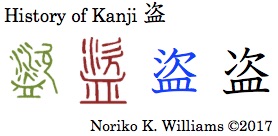 For the kanji 盗 in bronze ware style, the top was “water” and “a person with his mouth open,” signifying “a person drooling with envy.” The bottom was “a stemmed bowl.” The seal style writing had the same components. Together they meant “a person wanted something in the raised bowl so much that he stole it.” The top of the kyuji 盜, 3, is the bottom of 羨 “to envy.” In shinji, the top became 次. The kanji 盗 means “to steal.” <the composition of the kanji 盗: 次 and 皿>
For the kanji 盗 in bronze ware style, the top was “water” and “a person with his mouth open,” signifying “a person drooling with envy.” The bottom was “a stemmed bowl.” The seal style writing had the same components. Together they meant “a person wanted something in the raised bowl so much that he stole it.” The top of the kyuji 盜, 3, is the bottom of 羨 “to envy.” In shinji, the top became 次. The kanji 盗 means “to steal.” <the composition of the kanji 盗: 次 and 皿>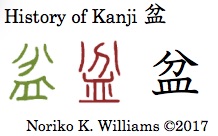 For the kanji 盆 in bronze ware style and in seal style it comprised 分, which was used phonetically for /bon/ to mean “a bulging shape,” and 皿. Together they meant “a bowl; pot; basin,” and also “something in a concave shape.” In Japanese it is used for a flat dish or tray to carry food. The kanji 盆 means “tray; flat dish.” It is also used to mean a Buddhist event in August to welcome the sprits of the ancestors and the dead. <the composition of the kanji 盆: 分 and 皿>
For the kanji 盆 in bronze ware style and in seal style it comprised 分, which was used phonetically for /bon/ to mean “a bulging shape,” and 皿. Together they meant “a bowl; pot; basin,” and also “something in a concave shape.” In Japanese it is used for a flat dish or tray to carry food. The kanji 盆 means “tray; flat dish.” It is also used to mean a Buddhist event in August to welcome the sprits of the ancestors and the dead. <the composition of the kanji 盆: 分 and 皿> For the kanji 血 (a) and (b) in oracle bone style was “a stemmed dish with something inside.” What was inside was what the writing was about — it was “blood from a sacrificial animal” for a religious rite. Such blood was used for making a contract/promise. The kanji 血 means “blood.” <the composition of the kanji 血: a very short ノ and 皿>
For the kanji 血 (a) and (b) in oracle bone style was “a stemmed dish with something inside.” What was inside was what the writing was about — it was “blood from a sacrificial animal” for a religious rite. Such blood was used for making a contract/promise. The kanji 血 means “blood.” <the composition of the kanji 血: a very short ノ and 皿> We begin our exploration with 勺 “ladle; dipper.” The shape 勺 in seal style shown on the right was a ladle with its cup filled with food or liquid – the short line in the middle was what was scooped up. It meant “a ladle” or “to scoop up or out.” As the shape came to be used phonetically in various kanji, a bushu 木 “wooden” was added to keep the original meaning – 杓. The kanji 杓 is a non-Joyo kanji, and is used in the word 柄杓 (“dipper; ladle” /hishaku/). A hishaku was indispensable to scoop up water in kitchen and at a water fountain, but it has become less used in the age of tap water. The kanji that contains 勺 we discuss here are 酌釣的約.
We begin our exploration with 勺 “ladle; dipper.” The shape 勺 in seal style shown on the right was a ladle with its cup filled with food or liquid – the short line in the middle was what was scooped up. It meant “a ladle” or “to scoop up or out.” As the shape came to be used phonetically in various kanji, a bushu 木 “wooden” was added to keep the original meaning – 杓. The kanji 杓 is a non-Joyo kanji, and is used in the word 柄杓 (“dipper; ladle” /hishaku/). A hishaku was indispensable to scoop up water in kitchen and at a water fountain, but it has become less used in the age of tap water. The kanji that contains 勺 we discuss here are 酌釣的約. We looked at the kanji 酌 quite recently in connection with the bushu 酉 “fermented liquid container.” In bronze ware style, in green, and seal style, in red, it comprised 酉 “a wine cask; fermented liquid container,” and 勺 “a ladle to scoop up,” which was also used phonetically for /shaku/. Together they meant “a ladle scooping up wine.” The kanji 酌 means “to serve wine; scoop up sake.”
We looked at the kanji 酌 quite recently in connection with the bushu 酉 “fermented liquid container.” In bronze ware style, in green, and seal style, in red, it comprised 酉 “a wine cask; fermented liquid container,” and 勺 “a ladle to scoop up,” which was also used phonetically for /shaku/. Together they meant “a ladle scooping up wine.” The kanji 酌 means “to serve wine; scoop up sake.” The seal style writing had 金 “metal,” and the right side 勺 “a ladle” was used phonetically for /choo/. Together they meant “a fishing hook” to catch a fish and lift up. It is also used to mean “to lure.” The kanji 釣 means “to fish; lure.” <The composition of the kanji 釣: 金 and 勺>
The seal style writing had 金 “metal,” and the right side 勺 “a ladle” was used phonetically for /choo/. Together they meant “a fishing hook” to catch a fish and lift up. It is also used to mean “to lure.” The kanji 釣 means “to fish; lure.” <The composition of the kanji 釣: 金 and 勺>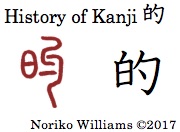 The seal style writing had 日 “the sun,” and 勺 was used phonetically for /teki/ to mean “bright.” Together they meant “bright.” Something bright stands out and becomes a precise target. The kanji 的 means “accurate; target; pertinent.” Adding 的 to a noun as an affix makes an adjective “having a characteristic of.” <The composition of the kanji 的: 白 and 勺>
The seal style writing had 日 “the sun,” and 勺 was used phonetically for /teki/ to mean “bright.” Together they meant “bright.” Something bright stands out and becomes a precise target. The kanji 的 means “accurate; target; pertinent.” Adding 的 to a noun as an affix makes an adjective “having a characteristic of.” <The composition of the kanji 的: 白 and 勺> For the kanji 約 in seal style 糸 “a skein of threads” signified “to tie” and 勺 was used phonetically for /yaku/. Together tying something with a thread meant “to bind; promise.” Bundling things into one also gave the meaning “to summarize” and “about.” The kanji 約 means “to promise; cut back; summarize; about.” <The composition of the kanji 約: 糸 and 勺>
For the kanji 約 in seal style 糸 “a skein of threads” signified “to tie” and 勺 was used phonetically for /yaku/. Together tying something with a thread meant “to bind; promise.” Bundling things into one also gave the meaning “to summarize” and “about.” The kanji 約 means “to promise; cut back; summarize; about.” <The composition of the kanji 約: 糸 and 勺>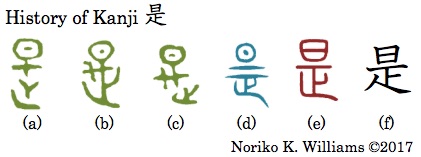 I must admit that the old writing (a), (b) and (c) in bronze was style does not appeal to me as a spoon, but many scholars agree that it was a spoon. So, I try. The top was a cup part of a dipper and the bottom was a decorative handle. It was borrowed to mean “this,” pointing the correct thing, thus “right.” The kanji 是 means “this; right.” <The composition of the kanji 是: 日 and the bottom of 定>
I must admit that the old writing (a), (b) and (c) in bronze was style does not appeal to me as a spoon, but many scholars agree that it was a spoon. So, I try. The top was a cup part of a dipper and the bottom was a decorative handle. It was borrowed to mean “this,” pointing the correct thing, thus “right.” The kanji 是 means “this; right.” <The composition of the kanji 是: 日 and the bottom of 定>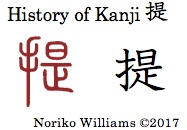 The seal style writing comprised “hand,” which became 扌, a bushu tehen “an act that one does using a hand,” and 是, used phonetically for /tee/. Together they meant “to carry in hand; put forward something (by hand).” <The composition of the kanji 提: 扌 and 是>
The seal style writing comprised “hand,” which became 扌, a bushu tehen “an act that one does using a hand,” and 是, used phonetically for /tee/. Together they meant “to carry in hand; put forward something (by hand).” <The composition of the kanji 提: 扌 and 是>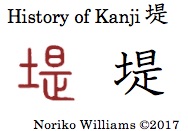 The seal style writing comprised 土 “soil; ground,” and 是, which was used phonetically for /tee/ to mean “to stagnate.” Together they meant “a pile of dirt that stayed; dike; bank.” The kanji 堤 means “bank; dike.” <The composition of the kanji 堤: 土 and 是>
The seal style writing comprised 土 “soil; ground,” and 是, which was used phonetically for /tee/ to mean “to stagnate.” Together they meant “a pile of dirt that stayed; dike; bank.” The kanji 堤 means “bank; dike.” <The composition of the kanji 堤: 土 and 是>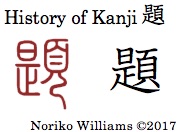 The left side of the seal style writing (是) was used phonetically for /dai/ to mean “to put forward.” The right side (頁) originally meant “the head of an official with a formal hat.” One would put “title or topic” at the very beginning at the top, thus it also meant “topic; title; question.” The kanji 題 means “title; topic; theme; question.” <The composition of the kanji 題: 是 and 頁>
The left side of the seal style writing (是) was used phonetically for /dai/ to mean “to put forward.” The right side (頁) originally meant “the head of an official with a formal hat.” One would put “title or topic” at the very beginning at the top, thus it also meant “topic; title; question.” The kanji 題 means “title; topic; theme; question.” <The composition of the kanji 題: 是 and 頁>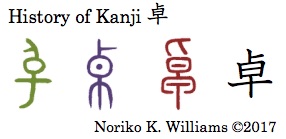 The origin of the kanji 卓 is obscure. But some scholars explain that the top of the writing in bronze ware style and Old style, in purple, and seal style was ヒ “a spoon” and that below that was “a large spoon.” A large spoon stood out and meant “to stand out.” Another view takes the top to be “a person” and 早 “early; to lead,” together signifying a person leading “to stand out.” It is also used to mean “a table.” The kanji 卓 means “to stand out; table.” <The composition of the kanji 卓: ト and 早>
The origin of the kanji 卓 is obscure. But some scholars explain that the top of the writing in bronze ware style and Old style, in purple, and seal style was ヒ “a spoon” and that below that was “a large spoon.” A large spoon stood out and meant “to stand out.” Another view takes the top to be “a person” and 早 “early; to lead,” together signifying a person leading “to stand out.” It is also used to mean “a table.” The kanji 卓 means “to stand out; table.” <The composition of the kanji 卓: ト and 早>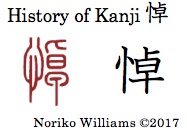 The seal style writing comprised 忄 “heart” and 卓, which was used phonetically for /too/. The kanji 悼 means “to grieve; mourn.” <The composition of the kanji 悼: 忄 and 卓>
The seal style writing comprised 忄 “heart” and 卓, which was used phonetically for /too/. The kanji 悼 means “to grieve; mourn.” <The composition of the kanji 悼: 忄 and 卓>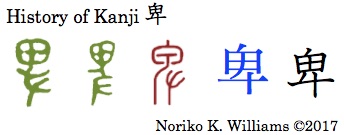 The top of the writing in bronze ware style and seal style was “a spoon with a handle,” and the bottom was “a left hand.” One view is that a left hand holding a spoon somehow meant “someone who did lowly work.” The kanji 卑 means “lowly; humble; crude; abject.” If you compare the kyuji, in blue, and the shinji closely, there is a difference – In the kyuji the vertical line in the center goes through bending toward left, reflecting the handle of a spoon bending in seal style. In kanji it became separated as a short stroke.
The top of the writing in bronze ware style and seal style was “a spoon with a handle,” and the bottom was “a left hand.” One view is that a left hand holding a spoon somehow meant “someone who did lowly work.” The kanji 卑 means “lowly; humble; crude; abject.” If you compare the kyuji, in blue, and the shinji closely, there is a difference – In the kyuji the vertical line in the center goes through bending toward left, reflecting the handle of a spoon bending in seal style. In kanji it became separated as a short stroke.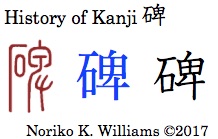 The seal style comprised 石 “rock; stone,” and 卑, used phonetically for /hi/ to mean “upright.” Together they meant “a stone that stood straight up.” The kanji 碑 means “stone monument; stone stele.” <The composition of the kanji 碑: 石 and 卑>
The seal style comprised 石 “rock; stone,” and 卑, used phonetically for /hi/ to mean “upright.” Together they meant “a stone that stood straight up.” The kanji 碑 means “stone monument; stone stele.” <The composition of the kanji 碑: 石 and 卑>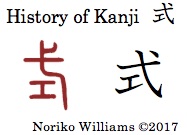 For the kanji 式 the seal style writing, in red, comprised 弋 “a wooden stake for marking” and 工 “craft; a tool for carpentry.” Together they signified “a set way of making or doing something” or “formula.” The meaning was also used in a social setting, such as “ceremony.” The kanji 式 means “formula; way of doing; ceremony; style.” <The composition of the kanji 式: 弋 and 工> (the stroke order breaks up the two components)
For the kanji 式 the seal style writing, in red, comprised 弋 “a wooden stake for marking” and 工 “craft; a tool for carpentry.” Together they signified “a set way of making or doing something” or “formula.” The meaning was also used in a social setting, such as “ceremony.” The kanji 式 means “formula; way of doing; ceremony; style.” <The composition of the kanji 式: 弋 and 工> (the stroke order breaks up the two components)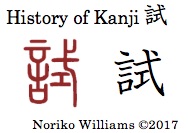 For the kanji 試 the seal style writing comprised 言 “word; language; to say,” and 式 “a set way of doing,” which was used phonetically for /shi/. Together they meant “to try to find out the correct way to do by inquiring.” In testing an apprentice or applicant, an examiner asked his examinee a question on how he would do certain things. The kanji 試 means “to test; attempt to do something; trial.” <Composition of the kanji 試: 言 and 式)
For the kanji 試 the seal style writing comprised 言 “word; language; to say,” and 式 “a set way of doing,” which was used phonetically for /shi/. Together they meant “to try to find out the correct way to do by inquiring.” In testing an apprentice or applicant, an examiner asked his examinee a question on how he would do certain things. The kanji 試 means “to test; attempt to do something; trial.” <Composition of the kanji 試: 言 and 式)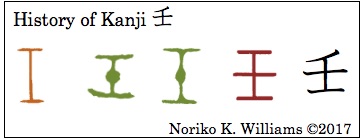 The next shape 壬 “something thick in the middle” from a smithery table had a bulge in the middle, as shown on the right. It is different from 壬 and 王 in the kanji 廷庭呈程望 (In those kanji the middle line came from a line pointing a straight shin signifying “standing; straight”).
The next shape 壬 “something thick in the middle” from a smithery table had a bulge in the middle, as shown on the right. It is different from 壬 and 王 in the kanji 廷庭呈程望 (In those kanji the middle line came from a line pointing a straight shin signifying “standing; straight”).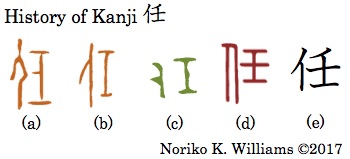 For The kanji 任 the left side of (a) and (b) in oracle bone style, in brown, and (c) in bronze ware style, in green, was “a standing person.” The right side was a smithy table with a bulge in the middle and was used phonetically for /jin; nin/. The bulge signifies “burden; responsibility.” Together they meant “a person who bears responsibility or role,” or “one entrusting a burden to someone else.” In (d) in seal style the bulge became another line, bearing the importance of its meaning, and in kanji the top became a slanted short stroke. The kanji 任 means “to entrust; leave a task with someone.” <Composition of the kanji 任: イ and 壬>
For The kanji 任 the left side of (a) and (b) in oracle bone style, in brown, and (c) in bronze ware style, in green, was “a standing person.” The right side was a smithy table with a bulge in the middle and was used phonetically for /jin; nin/. The bulge signifies “burden; responsibility.” Together they meant “a person who bears responsibility or role,” or “one entrusting a burden to someone else.” In (d) in seal style the bulge became another line, bearing the importance of its meaning, and in kanji the top became a slanted short stroke. The kanji 任 means “to entrust; leave a task with someone.” <Composition of the kanji 任: イ and 壬>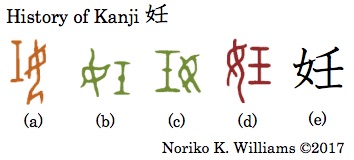 For the kanji 妊, (a) in oracle bone style, (b) and (c) in bronze ware style and (d) in seal style all comprised 女 “a woman” and 工 with a bulge (壬).” They signified “a woman who has a bulged stomach” — “pregnant.” The kanji 妊 means “pregnant.” <Composition of the kanji 妊: 女 and 壬>
For the kanji 妊, (a) in oracle bone style, (b) and (c) in bronze ware style and (d) in seal style all comprised 女 “a woman” and 工 with a bulge (壬).” They signified “a woman who has a bulged stomach” — “pregnant.” The kanji 妊 means “pregnant.” <Composition of the kanji 妊: 女 and 壬> The shape 乍 appeared frequently in oracle bones to mean “to create; make” and was /saku/ phonetically, and yet, accounts of its origin vary — twigs bent to make a fence; a tool such as an adze chipping off pieces of wood to make craft; woven basket, among others. The history is shown on the right.
The shape 乍 appeared frequently in oracle bones to mean “to create; make” and was /saku/ phonetically, and yet, accounts of its origin vary — twigs bent to make a fence; a tool such as an adze chipping off pieces of wood to make craft; woven basket, among others. The history is shown on the right. For the kanji 作 in oracle bone style and bronze ware style it was just 乍 “to make; create.” Soon,乍 came to be used in other kanji phonetically, and in order to keep the original meaning “to make” a standing person was added to signify “an act one does.” The kanji 作 meant “to make; create; do; begin.” <Composition of the kanji 作: イ and 乍>
For the kanji 作 in oracle bone style and bronze ware style it was just 乍 “to make; create.” Soon,乍 came to be used in other kanji phonetically, and in order to keep the original meaning “to make” a standing person was added to signify “an act one does.” The kanji 作 meant “to make; create; do; begin.” <Composition of the kanji 作: イ and 乍> For the kanji 昨 the seal style writing comprised 日 “the sun; day” and 乍, which was used phonetically for /saku/ to mean “to pass quickly.” A day passing quickly meant “past; last.” The kanji 昨 means “past; last.” <Composition of the kanji 昨: 日 and 乍>
For the kanji 昨 the seal style writing comprised 日 “the sun; day” and 乍, which was used phonetically for /saku/ to mean “to pass quickly.” A day passing quickly meant “past; last.” The kanji 昨 means “past; last.” <Composition of the kanji 昨: 日 and 乍> We have looked at the kanji 酢 quite recetly in connection with the bushu 酉 “cask for fermented liquid.” The right side 乍 was used phonetically for /saku/ to mean “something past.” Rice wine that went bad was vinegar. The kanji 酢 means “vinegar.” For sample words, please refer to the earlier post. <Composition of the kanji 酢: 酉 and 乍>
We have looked at the kanji 酢 quite recetly in connection with the bushu 酉 “cask for fermented liquid.” The right side 乍 was used phonetically for /saku/ to mean “something past.” Rice wine that went bad was vinegar. The kanji 酢 means “vinegar.” For sample words, please refer to the earlier post. <Composition of the kanji 酢: 酉 and 乍> The writings in bronze ware style and seal style comprised 言 “word; language; to say” and 乍, which was used phonetically for /saku/ to mean “deceive.” Together they meant “to break oath.” The kanji 詐 means “to deceive; lie.” <Composition of the kanji 詐: 言 and 乍>
The writings in bronze ware style and seal style comprised 言 “word; language; to say” and 乍, which was used phonetically for /saku/ to mean “deceive.” Together they meant “to break oath.” The kanji 詐 means “to deceive; lie.” <Composition of the kanji 詐: 言 and 乍>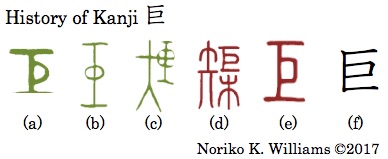 For the kanji 巨 (a) and (b) in bronze ware style was “a large carpenter’s rectangular ruler with a handle in the middle,” and (c) had “a person who was holding a ruler” added. There were two different writings in seal style — (d) had “an arrow (矢),” which was used to measure a short object, “a large ruler” (巨) and a wooden object (木), whereas (e) returned to the original shape of a large ruler only. The kanji 巨 means “huge; giant; gigantic.” <The stroke order of 巨 begins with the vertical line>
For the kanji 巨 (a) and (b) in bronze ware style was “a large carpenter’s rectangular ruler with a handle in the middle,” and (c) had “a person who was holding a ruler” added. There were two different writings in seal style — (d) had “an arrow (矢),” which was used to measure a short object, “a large ruler” (巨) and a wooden object (木), whereas (e) returned to the original shape of a large ruler only. The kanji 巨 means “huge; giant; gigantic.” <The stroke order of 巨 begins with the vertical line>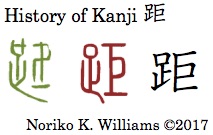 For the kanji 距 the bronze ware style writing had 足 “foot,” and a shape that was used phonetically for /kyo/. The short line in the middle was considered to be similar to a spur of a chicken, and that a chicken leaping a long distance signified “distance.” The kanji 距 means “distance.” <Composition of the kanji 距: あしへん and 巨>
For the kanji 距 the bronze ware style writing had 足 “foot,” and a shape that was used phonetically for /kyo/. The short line in the middle was considered to be similar to a spur of a chicken, and that a chicken leaping a long distance signified “distance.” The kanji 距 means “distance.” <Composition of the kanji 距: あしへん and 巨>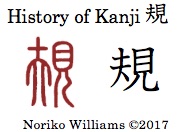 One last tool we look at in this post came from “a compass to draw a circle.” For the kanji 規 the left side of the seal style writing looked like that of the kanji 夫, but it did not share the same origin – it was “a compass to draw a circle,” possibly using two short arrows. “A tool that was used to draw a circle” gave the meaning “standard; criterion.” The right side was 見 “to look at.” The kanji 規 meant “standard.” <Composition of the kanji 規: 夫 with a short fourth stroke and 見>
One last tool we look at in this post came from “a compass to draw a circle.” For the kanji 規 the left side of the seal style writing looked like that of the kanji 夫, but it did not share the same origin – it was “a compass to draw a circle,” possibly using two short arrows. “A tool that was used to draw a circle” gave the meaning “standard; criterion.” The right side was 見 “to look at.” The kanji 規 meant “standard.” <Composition of the kanji 規: 夫 with a short fourth stroke and 見> There are two different meanings associated with the ancient writings of 丁 – one is “an area; a square” and another “a nailhead” that was viewed from above or from the side. (In our blogs, oracle bone style is shown in brown; bronze ware style in green; and seal style in red.) A nail got pounded down flat in a straight angle, thus it meant something “right angle; flat,” and “a square block.” In Japan it is used as a counter for a square block as well as in an address for a section of an areas in a large city, such as 銀座四丁目 (“Fourth block of the Ginza area in Tokyo” /ginza-yonchoome/). The kanji 丁 means “a (square) block; section; counter for a section.”
There are two different meanings associated with the ancient writings of 丁 – one is “an area; a square” and another “a nailhead” that was viewed from above or from the side. (In our blogs, oracle bone style is shown in brown; bronze ware style in green; and seal style in red.) A nail got pounded down flat in a straight angle, thus it meant something “right angle; flat,” and “a square block.” In Japan it is used as a counter for a square block as well as in an address for a section of an areas in a large city, such as 銀座四丁目 (“Fourth block of the Ginza area in Tokyo” /ginza-yonchoome/). The kanji 丁 means “a (square) block; section; counter for a section.” The seal style writing of the kanji 打 comprised “a hand; an act that one does using a hand” and 丁 “square; a right angle.” Together a hand over a nailhead meant “to hit; strike hard.” 打 was also used to make a word without adding the meaning “to hit.” The kanji 打 means “to hit; pound on.” <Composition of the kanji: 扌and 丁>
The seal style writing of the kanji 打 comprised “a hand; an act that one does using a hand” and 丁 “square; a right angle.” Together a hand over a nailhead meant “to hit; strike hard.” 打 was also used to make a word without adding the meaning “to hit.” The kanji 打 means “to hit; pound on.” <Composition of the kanji: 扌and 丁> The seal style writing of the kanji 訂 comprised 言 “word; language; to say” and 丁 “straight; right angle,” which was used phonetically for /tee/. Together they meant “to make words right.” The kanji 訂 means “to correct; revise; amend.” <Composition of the kanji 訂: 言 and 丁>
The seal style writing of the kanji 訂 comprised 言 “word; language; to say” and 丁 “straight; right angle,” which was used phonetically for /tee/. Together they meant “to make words right.” The kanji 訂 means “to correct; revise; amend.” <Composition of the kanji 訂: 言 and 丁>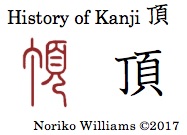 The seal style writing comprised 丁 “a flat nailhead,” which was used phonetically for /choo/, and 頁, a bushu oogai “head,” from a man with formal headdress. Together they meant “a flat top area; summit; the top of one’s head.” In Japanese this kanji is also used for a humble verb for “to receive.” Comparing to another kanji 戴 for “to receive,” 頂 is used more casually. The kanji 頂 means “summit; top; to receive (humble style).” <Composition of the kanji 訂: 丁 and 頁>
The seal style writing comprised 丁 “a flat nailhead,” which was used phonetically for /choo/, and 頁, a bushu oogai “head,” from a man with formal headdress. Together they meant “a flat top area; summit; the top of one’s head.” In Japanese this kanji is also used for a humble verb for “to receive.” Comparing to another kanji 戴 for “to receive,” 頂 is used more casually. The kanji 頂 means “summit; top; to receive (humble style).” <Composition of the kanji 訂: 丁 and 頁>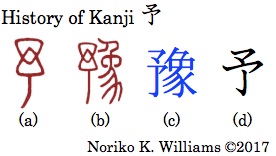 For the kanji 予 there are two different writings (a) and (b) in seal style to account for the kyuji (c), in blue, and the shinji (d). (a) was a “weaving shuttle with a thread hanging down.” A weaving shuttle was pushed through the warps that were loosened on the loom. From “making room in advance of a shuttle’s passing” the kanji 予 meant “in advance; preliminary; allowances.” (b) had 象 “elephant,” which had been explained that the large size and slow movement of an elephant signified “large; relaxed; loose.” (c) reflected (b). In shinji, 象 was dropped. The kanji 予 means “in advance; preliminary.” The kanji for the original meaning, a weaving shuttle, is the non-Joyo kanji 杼 with a bushu kihen “wooden.” <Composition of the kanji 予: マ and 了>
For the kanji 予 there are two different writings (a) and (b) in seal style to account for the kyuji (c), in blue, and the shinji (d). (a) was a “weaving shuttle with a thread hanging down.” A weaving shuttle was pushed through the warps that were loosened on the loom. From “making room in advance of a shuttle’s passing” the kanji 予 meant “in advance; preliminary; allowances.” (b) had 象 “elephant,” which had been explained that the large size and slow movement of an elephant signified “large; relaxed; loose.” (c) reflected (b). In shinji, 象 was dropped. The kanji 予 means “in advance; preliminary.” The kanji for the original meaning, a weaving shuttle, is the non-Joyo kanji 杼 with a bushu kihen “wooden.” <Composition of the kanji 予: マ and 了> For the kanji 序, the top left of the seal style writing was the eaves or an addition to a house. Under that 予 “extra room” was used phonetically for /jo/. The extended area next to the main house was used as a place or school where propriety was taught. From that the kanji 序 meant “order; beginning of an order.” It is sometimes used for the word 序でに “while I am at it (I do another thing); taking the opportunity,” perhaps from the sense of order.<Composition of the kanji 序: 广 and 予>
For the kanji 序, the top left of the seal style writing was the eaves or an addition to a house. Under that 予 “extra room” was used phonetically for /jo/. The extended area next to the main house was used as a place or school where propriety was taught. From that the kanji 序 meant “order; beginning of an order.” It is sometimes used for the word 序でに “while I am at it (I do another thing); taking the opportunity,” perhaps from the sense of order.<Composition of the kanji 序: 广 and 予> For the kanji 預 the left side of the seal style writing was 予 “roomy; extra,” which was used phonetically for /yo/. The right side 頁 was a man with a ceremonial hat or a “head.” How they came to mean “to deposit; leave something for a temporary custody” is not clear, perhaps it signified an act that one does for future purpose. The kanji 預 means “to leave for a temporary custody; deposit.” <Composition of the kanji 預: 予 and 頁>
For the kanji 預 the left side of the seal style writing was 予 “roomy; extra,” which was used phonetically for /yo/. The right side 頁 was a man with a ceremonial hat or a “head.” How they came to mean “to deposit; leave something for a temporary custody” is not clear, perhaps it signified an act that one does for future purpose. The kanji 預 means “to leave for a temporary custody; deposit.” <Composition of the kanji 預: 予 and 頁> The ancient writing for the kanji 幻 was the upside down image of 予, showing the thread coming out at the top. Pulling a shuttle in the wrong way caused confusion in weaving, signifying something that was not correct or real, thus “illusion.” Very clever! The kanji 幻 means “illusion; magic.”
The ancient writing for the kanji 幻 was the upside down image of 予, showing the thread coming out at the top. Pulling a shuttle in the wrong way caused confusion in weaving, signifying something that was not correct or real, thus “illusion.” Very clever! The kanji 幻 means “illusion; magic.” For the kanji 互 the seal style writing was “a tool to make a rope by twisting threads alternately from two of more sides.” The kanji 互 means “each other; alternately.”
For the kanji 互 the seal style writing was “a tool to make a rope by twisting threads alternately from two of more sides.” The kanji 互 means “each other; alternately.”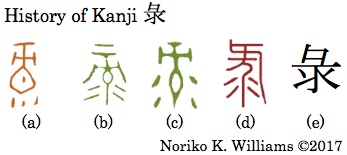 The component 彔 – The right side 彔 of the kyuji for the kanji 緑 and 録 had its own history as shown on the right. It was a twisting devise for wringing wet threads or drilling a piece of wood, creating spills around. It was phonetically /roku/.
The component 彔 – The right side 彔 of the kyuji for the kanji 緑 and 録 had its own history as shown on the right. It was a twisting devise for wringing wet threads or drilling a piece of wood, creating spills around. It was phonetically /roku/.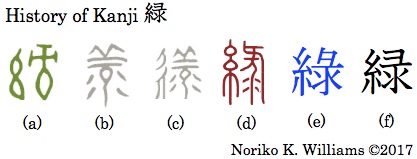 For the kanji 緑 (a) in oracle bone style and (c) in the styles found in documents, in gray, and (d) in seal style had a skein of threads (糸). The right side was a twisting devise for wringing wet threads or drilling a piece of wood, creating spills around or sawdust. It was also used phonetically for /roku/ to mean “green.” A skein of threads that was green gave the meaning “green.” The kanji 緑 means “color of green.” <Composition of the kanji 緑: 糸, ヨ with a long stroke and 氺>
For the kanji 緑 (a) in oracle bone style and (c) in the styles found in documents, in gray, and (d) in seal style had a skein of threads (糸). The right side was a twisting devise for wringing wet threads or drilling a piece of wood, creating spills around or sawdust. It was also used phonetically for /roku/ to mean “green.” A skein of threads that was green gave the meaning “green.” The kanji 緑 means “color of green.” <Composition of the kanji 緑: 糸, ヨ with a long stroke and 氺> For the kanji 録, in seal style 金 “metal” and 彔 “green” together meant greenish color of bronze ware, on which record of important events were cast, and was used phonetically for /roku/ “to record.” The kanji 録 means “records; to record.” <Composition of the kanji 録: 金, ヨ with a long stroke and 氺>
For the kanji 録, in seal style 金 “metal” and 彔 “green” together meant greenish color of bronze ware, on which record of important events were cast, and was used phonetically for /roku/ “to record.” The kanji 録 means “records; to record.” <Composition of the kanji 録: 金, ヨ with a long stroke and 氺>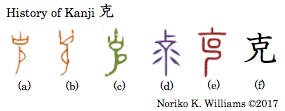 The kanji 克 had a stream of records from the ancient times. How we interpret them is another matter. One view is that (a) and (b) in oracle bone style (c) in bronze ware style was “a curved knife with a large handle at the top and that a handgrip on the side that was used to core out.” (d) in Old style showed that it had saw-dust. The writing was borrowed to mean “to overcome.” Another view is that the ancient writings was a person with a heavy helmet, sitting with his legs bent and enduring the weight. In this account the kanji shape 克 is explained as a person (兄) with a helmet. In my view whichever appeals to you for your study should be fine. The kanji 克 means “to overcome.” <Composition of the kanji 克: a short 十 and 兄>
The kanji 克 had a stream of records from the ancient times. How we interpret them is another matter. One view is that (a) and (b) in oracle bone style (c) in bronze ware style was “a curved knife with a large handle at the top and that a handgrip on the side that was used to core out.” (d) in Old style showed that it had saw-dust. The writing was borrowed to mean “to overcome.” Another view is that the ancient writings was a person with a heavy helmet, sitting with his legs bent and enduring the weight. In this account the kanji shape 克 is explained as a person (兄) with a helmet. In my view whichever appeals to you for your study should be fine. The kanji 克 means “to overcome.” <Composition of the kanji 克: a short 十 and 兄> For the kanji 以 (a) and (b) in oracle bone style, (c) and (d) in bronze ware style and (e) in seal styles was “a hoe” for a field work. It had a bent end to turn up the soil. “An implement that one uses” gave the meaning “using X; by means of.” One’s field work began with it, thus “starting from.” In kanji a person who used a hoe was added on the right side (人). The kanji 以 means “to use; by means of; starting from.”
For the kanji 以 (a) and (b) in oracle bone style, (c) and (d) in bronze ware style and (e) in seal styles was “a hoe” for a field work. It had a bent end to turn up the soil. “An implement that one uses” gave the meaning “using X; by means of.” One’s field work began with it, thus “starting from.” In kanji a person who used a hoe was added on the right side (人). The kanji 以 means “to use; by means of; starting from.”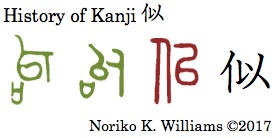 In bronze ware style the left one had “a hoe,” which was used phonetically for /i; shi/ to mean “to resemble,” and 口 “a mouth.” The right one had “a person” added on the right. Together they meant “a person resembling to another.” In seal style the positions of “a person” and “a hoe” were swapped. In the kanji 似 another person was added to 以. So the kanji 似 contained two people (イ and 人), which would suit very well as mnemonics. The kanji 似 means “to resemble.” <Composition of the kanji 似: イ and 以>
In bronze ware style the left one had “a hoe,” which was used phonetically for /i; shi/ to mean “to resemble,” and 口 “a mouth.” The right one had “a person” added on the right. Together they meant “a person resembling to another.” In seal style the positions of “a person” and “a hoe” were swapped. In the kanji 似 another person was added to 以. So the kanji 似 contained two people (イ and 人), which would suit very well as mnemonics. The kanji 似 means “to resemble.” <Composition of the kanji 似: イ and 以>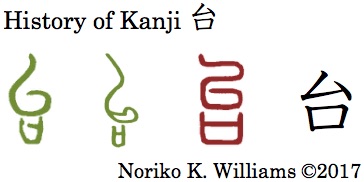
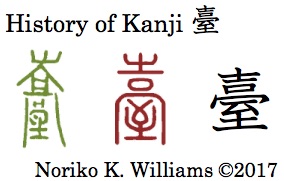 The kanji 台 had the kyuji 臺, which had a different history from 台, as shown on the right. Let us look at the kyuji first. The bronze ware style and seal style writing was “a watch tower,” inside which showed “an arrow hitting the ground” (至). The kyuji 臺 faithfully reflected the seal style writing. It meant “stand; tower; raised level.”
The kanji 台 had the kyuji 臺, which had a different history from 台, as shown on the right. Let us look at the kyuji first. The bronze ware style and seal style writing was “a watch tower,” inside which showed “an arrow hitting the ground” (至). The kyuji 臺 faithfully reflected the seal style writing. It meant “stand; tower; raised level.”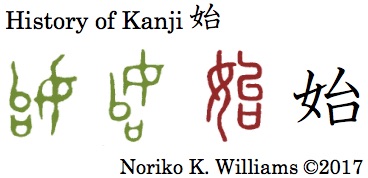 For the kanji 始 the bronze ware style writings comprised “a hoe” (ム), which was phonetically used for /shi/, “mouth; speaking” (口) and “woman” (女). The views on the origin vary among kanji scholars. One explains that 台 was used phonetically for /tai; dai/ to mean “womb,” and that with 女 “woman,” from giving a new life to a child, gave the meaning “to begin.” Another explains that it meant “a first-born daughter,” and it means “to begin.” The kanji 始 means “to begin; start.” <Composition of the kanji 始: 女 and 台>
For the kanji 始 the bronze ware style writings comprised “a hoe” (ム), which was phonetically used for /shi/, “mouth; speaking” (口) and “woman” (女). The views on the origin vary among kanji scholars. One explains that 台 was used phonetically for /tai; dai/ to mean “womb,” and that with 女 “woman,” from giving a new life to a child, gave the meaning “to begin.” Another explains that it meant “a first-born daughter,” and it means “to begin.” The kanji 始 means “to begin; start.” <Composition of the kanji 始: 女 and 台>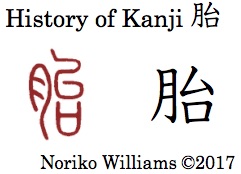 The seal style writing of the kanji 胎 comprised 月, a bushu nikuzuki “flesh; a part of one’s body,” and 台, which was used phonetically for /tai/ to mean “to begin.” The part of a body where a life began meant “a womb.” The kanji 胎 means “womb.” <Composition of the kanji 胎: 月 and 台>
The seal style writing of the kanji 胎 comprised 月, a bushu nikuzuki “flesh; a part of one’s body,” and 台, which was used phonetically for /tai/ to mean “to begin.” The part of a body where a life began meant “a womb.” The kanji 胎 means “womb.” <Composition of the kanji 胎: 月 and 台>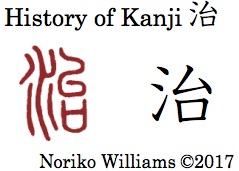 The seal style writing of the kanji 治 comprised “water,” and “a hoe” (ム) and “a mouth” (口), which was used phonetically for /shi; ji/. In ancient times controlling irrigation water or flood was a very important job for a ruler. The kanji meant “to rule; govern.” The notion was also applied on people, and meant “to cure (illness); recover.” The kanji 治 means “to rule; cure (illness).” <Composition of the kanji 治: 氵 and 台>
The seal style writing of the kanji 治 comprised “water,” and “a hoe” (ム) and “a mouth” (口), which was used phonetically for /shi; ji/. In ancient times controlling irrigation water or flood was a very important job for a ruler. The kanji meant “to rule; govern.” The notion was also applied on people, and meant “to cure (illness); recover.” The kanji 治 means “to rule; cure (illness).” <Composition of the kanji 治: 氵 and 台>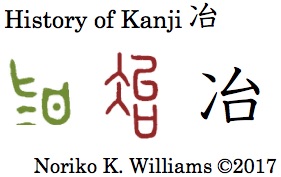 For the kanji 冶 in the bronze ware style writing “a hoe” on the top left and “a mouth” on the right made up the shape 台. The two short lines on the bottom left were metal pieces. Together they meant “melting metal; metallurgy.” The seal style writing had “streaks in ice” that signified smithy work– Like water freezes solid to ice or ice melts to liquid, metal work was melting and solidifying process. It became 冫, a bushu nisui “ice; icy cold” in kanji. The kanji 冶 means “to melt metal; finish work beautifully.” <Composition of the kanji 冶: 冫 and 台>
For the kanji 冶 in the bronze ware style writing “a hoe” on the top left and “a mouth” on the right made up the shape 台. The two short lines on the bottom left were metal pieces. Together they meant “melting metal; metallurgy.” The seal style writing had “streaks in ice” that signified smithy work– Like water freezes solid to ice or ice melts to liquid, metal work was melting and solidifying process. It became 冫, a bushu nisui “ice; icy cold” in kanji. The kanji 冶 means “to melt metal; finish work beautifully.” <Composition of the kanji 冶: 冫 and 台>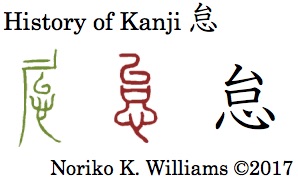 For the kanji 怠 in bronze ware style and seal style it had phonetically-used 台 /tai/ and “a heart” (心). Together they made up the kanji 怡 /tai/ that meant “joyful.” When you are joyful you are more relaxed and thus become neglectful. The kanji 怠 meant “lazy; to neglect; neglectful.” <Composition of the kanji 怠: 台 and 心>
For the kanji 怠 in bronze ware style and seal style it had phonetically-used 台 /tai/ and “a heart” (心). Together they made up the kanji 怡 /tai/ that meant “joyful.” When you are joyful you are more relaxed and thus become neglectful. The kanji 怠 meant “lazy; to neglect; neglectful.” <Composition of the kanji 怠: 台 and 心>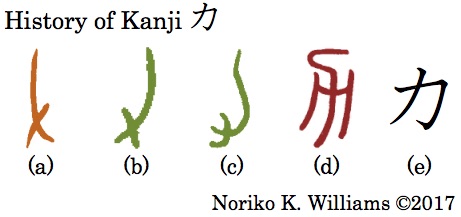 For the kanji 力, there are two different views. One view, by Setsumon, is that the bottom suggested that it was a hand, and that the curve at the top in (c) in bronze ware style, in green, and (d) in seal style, in red, was “muscles in the arm,” and that flexing muscles meant “strength; power.” This view has been the traditional view. Another view in Shirakawa’s Shinjito is that the bottom was “a plough; a digging fork” in the field. In working in the field one had to apply much muscular strength. In this blog we take the second view. The kanji 力 means “power; strength.” (For the stroke order, you write the angled stroke first.)
For the kanji 力, there are two different views. One view, by Setsumon, is that the bottom suggested that it was a hand, and that the curve at the top in (c) in bronze ware style, in green, and (d) in seal style, in red, was “muscles in the arm,” and that flexing muscles meant “strength; power.” This view has been the traditional view. Another view in Shirakawa’s Shinjito is that the bottom was “a plough; a digging fork” in the field. In working in the field one had to apply much muscular strength. In this blog we take the second view. The kanji 力 means “power; strength.” (For the stroke order, you write the angled stroke first.)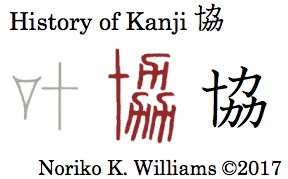 For the kanji 協, the Old style writing, in gray, comprised 口 “mouth” and 十 “to bundle up to one.” The seal style writing had “three ploughs” together, which was used phonetically for /kyoo/. Together they meant many people work together in a field, giving help to others. The kanji 協 means “to cooperate; give help to others.” <Composition of the kanji 協: a narrow 十 and three力>
For the kanji 協, the Old style writing, in gray, comprised 口 “mouth” and 十 “to bundle up to one.” The seal style writing had “three ploughs” together, which was used phonetically for /kyoo/. Together they meant many people work together in a field, giving help to others. The kanji 協 means “to cooperate; give help to others.” <Composition of the kanji 協: a narrow 十 and three力>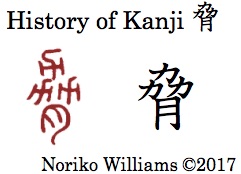 The kanji 脅 and the next kanji 脇 shared the same seal style writing — “three ploughs” and 月 “a part of one’s body”– and yet they have different meanings. For the kanji 脅, the top was used phonetically for /kyoo/ to mean “power,” and the bottom 月 was “a part of one’s body.” Together “powers over one’s body” meant “to threaten; menace; coerce.” <Composition of the kanji: Three 力 and 月>
The kanji 脅 and the next kanji 脇 shared the same seal style writing — “three ploughs” and 月 “a part of one’s body”– and yet they have different meanings. For the kanji 脅, the top was used phonetically for /kyoo/ to mean “power,” and the bottom 月 was “a part of one’s body.” Together “powers over one’s body” meant “to threaten; menace; coerce.” <Composition of the kanji: Three 力 and 月>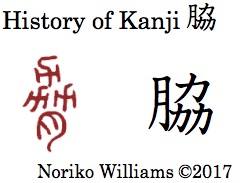 The seal style writing of the kanji 脇 was the same as 脅. In the kanji 脇, “three ploughs lining up” signified “ribs.” Together with 月, a bushu nikuzuki “flesh,” they meant “side (of one’s body); flank.” It also means “supporting role.” The kanji 脇 means “side of one’s body; flank; supporting role.” <Composition of the kanji: 月 and three 力>
The seal style writing of the kanji 脇 was the same as 脅. In the kanji 脇, “three ploughs lining up” signified “ribs.” Together with 月, a bushu nikuzuki “flesh,” they meant “side (of one’s body); flank.” It also means “supporting role.” The kanji 脇 means “side of one’s body; flank; supporting role.” <Composition of the kanji: 月 and three 力> For the kanji 加 the two bronze ware style writings comprised “a plough; a digging fork” that was placed sideways and “a mouth.” When doing heavy labor in the field adding voice was encouraging in exerting effort. It meant “to add.” The katakana カ and the hiragana か came from the kanji 加. The kanji 加 means “to add.” <Composition of the kanji 加: 力 and 口>
For the kanji 加 the two bronze ware style writings comprised “a plough; a digging fork” that was placed sideways and “a mouth.” When doing heavy labor in the field adding voice was encouraging in exerting effort. It meant “to add.” The katakana カ and the hiragana か came from the kanji 加. The kanji 加 means “to add.” <Composition of the kanji 加: 力 and 口> For the kanji 賀 the bronze ware style writing comprised “a cowrie; valuable,” and “a plough” and “a mouth,” which was phonetically used for /ka/ to mean “to add.” One gave someone a valuable gift at a time of celebration. It meant “to celebrate; congratulate; auspicious occasion.” In seal style and in kanji the cowrie was moved to the bottom. The kanji 賀 means “to celebrate; auspicious.” <Composition of the kanji 賀: 力, 口 and 貝>
For the kanji 賀 the bronze ware style writing comprised “a cowrie; valuable,” and “a plough” and “a mouth,” which was phonetically used for /ka/ to mean “to add.” One gave someone a valuable gift at a time of celebration. It meant “to celebrate; congratulate; auspicious occasion.” In seal style and in kanji the cowrie was moved to the bottom. The kanji 賀 means “to celebrate; auspicious.” <Composition of the kanji 賀: 力, 口 and 貝>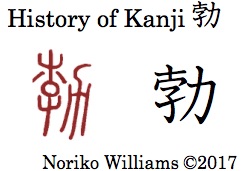 For the kanji 勃 the left side of the seal style was “a plant whose center was bulging with a seed,” and was used phonetically for /botsu/ to mean “a sudden change; a force pushing out from within.” A child at the bottom may suggest a seed. The right side “plough” added “power.” Together they meant “sudden occurrence.” The kanji 勃 means “to happen abruptly; energetic.”<Composition of the kanji 勃: a truncated 十, 冖, 子 and 力>
For the kanji 勃 the left side of the seal style was “a plant whose center was bulging with a seed,” and was used phonetically for /botsu/ to mean “a sudden change; a force pushing out from within.” A child at the bottom may suggest a seed. The right side “plough” added “power.” Together they meant “sudden occurrence.” The kanji 勃 means “to happen abruptly; energetic.”<Composition of the kanji 勃: a truncated 十, 冖, 子 and 力>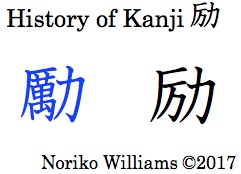 There is no ancient writing for the kanji 励. The left side of the kyuji 勵, in blue, for the kanji 励 was used phonetically for /ree/ to mean either “a hard mineral rock” or “a poisonous scorpion.” The right side 力 “plough” signified “hard field work.” Together they meant “to strive for; labor for; be industrious; give encouragement.” In kanji the left side became 厂 and 万. <Composition of the kanji 励: 厂, 万 and 力>
There is no ancient writing for the kanji 励. The left side of the kyuji 勵, in blue, for the kanji 励 was used phonetically for /ree/ to mean either “a hard mineral rock” or “a poisonous scorpion.” The right side 力 “plough” signified “hard field work.” Together they meant “to strive for; labor for; be industrious; give encouragement.” In kanji the left side became 厂 and 万. <Composition of the kanji 励: 厂, 万 and 力>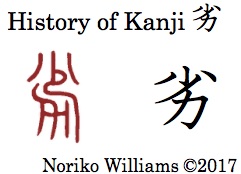 The seal style writing of the kanji 劣 comprised 少 “a little” and 力 “power.” Together “lack of strength” meant “inferior.” The kanji 劣 means “inferior; to deteriorate.” <Composition of the kanji 劣: 少 and力>
The seal style writing of the kanji 劣 comprised 少 “a little” and 力 “power.” Together “lack of strength” meant “inferior.” The kanji 劣 means “inferior; to deteriorate.” <Composition of the kanji 劣: 少 and力>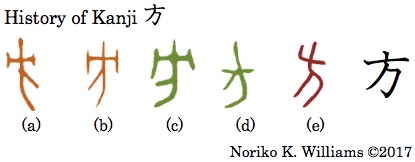 For the kanji 方 in (a) and (b) in oracle bone style, in brown, (c) and (d) in bronze ware style, in green, and (e) in seal style, in red, it was “a plough with a long handle” in which the handle pointing to directions, right and left, the pole at the top and the bottom with tines. From that it signified “four or all directions.” A direction is an “option.” Four directions make “a square.” The kanji 方 means “way; direction; option; a square; method.”
For the kanji 方 in (a) and (b) in oracle bone style, in brown, (c) and (d) in bronze ware style, in green, and (e) in seal style, in red, it was “a plough with a long handle” in which the handle pointing to directions, right and left, the pole at the top and the bottom with tines. From that it signified “four or all directions.” A direction is an “option.” Four directions make “a square.” The kanji 方 means “way; direction; option; a square; method.”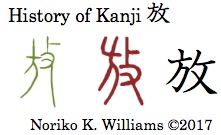 For the kanji 放 the bronze ware style writing comprised 方 “all directions” used phonetically for /hoo/ and 攴 “a hand moving a stick,” which eventually became 攵, a bushu bokunyoo/bokuzukuri “to cause” in kanji. Together they meant “a hand letting a thing disperse to various directions; to release.” The kanji 放 means “to release; free; emit; cast.” [Composition of the kanji 放: 方 and 攵]
For the kanji 放 the bronze ware style writing comprised 方 “all directions” used phonetically for /hoo/ and 攴 “a hand moving a stick,” which eventually became 攵, a bushu bokunyoo/bokuzukuri “to cause” in kanji. Together they meant “a hand letting a thing disperse to various directions; to release.” The kanji 放 means “to release; free; emit; cast.” [Composition of the kanji 放: 方 and 攵]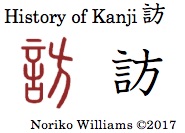 For the kanji 訪 the seal style writing comprised 言 “word; language; to say” and 方 “direction” used phonetically for /hoo/, together signifying “asking how to get to a place” when one visited someone. The kanji 訪 means “to visit; travel to.” [Composition of the kanji 訪: 言 and 方]
For the kanji 訪 the seal style writing comprised 言 “word; language; to say” and 方 “direction” used phonetically for /hoo/, together signifying “asking how to get to a place” when one visited someone. The kanji 訪 means “to visit; travel to.” [Composition of the kanji 訪: 言 and 方]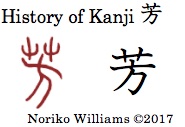 For the kanji 芳 the seal style writing comprised 艸 “plants” and 方 “to emit; cast” used phonetically for /hoo/. A fragrant plant spreads its aroma in all directions. It is also applied on person having good reputation. The kanji 芳 means “fragrant; good.” [Composition of the kanji 芳: 艹and方 ]
For the kanji 芳 the seal style writing comprised 艸 “plants” and 方 “to emit; cast” used phonetically for /hoo/. A fragrant plant spreads its aroma in all directions. It is also applied on person having good reputation. The kanji 芳 means “fragrant; good.” [Composition of the kanji 芳: 艹and方 ]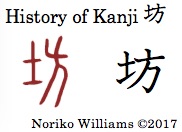 The seal style writing of the kanji 坊 comprised 土 “gound; soil” and 方 “a square area” used phonetically for /boo/. Together they originally meant “a block or a section of an area or a house” that was on the ground. The kanji 坊 means “section; living quarters in a temple.” It is also used as a suffix (often affectionately) to mean “tyke; youngster.” [Composition of the kanji 坊: 土へんand 方]
The seal style writing of the kanji 坊 comprised 土 “gound; soil” and 方 “a square area” used phonetically for /boo/. Together they originally meant “a block or a section of an area or a house” that was on the ground. The kanji 坊 means “section; living quarters in a temple.” It is also used as a suffix (often affectionately) to mean “tyke; youngster.” [Composition of the kanji 坊: 土へんand 方]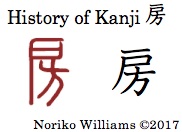 The seal style writing of the kanji 房 comprised 戸 “a single door” and 方 “a square” used phonetically for /boo/. Together they meant “a small quarter that was located on the side of a house.” From that it meant “living quarters; room.” A tassel hangs loosely on the side from the main body, and it meant “a tassel.” The kanji 房 means “room; quarters; tassel; something hanging.” [Composition of the kanji 房: 戸 and 方]
The seal style writing of the kanji 房 comprised 戸 “a single door” and 方 “a square” used phonetically for /boo/. Together they meant “a small quarter that was located on the side of a house.” From that it meant “living quarters; room.” A tassel hangs loosely on the side from the main body, and it meant “a tassel.” The kanji 房 means “room; quarters; tassel; something hanging.” [Composition of the kanji 房: 戸 and 方] In seal style the left writing of the kanji 防 comprised a bushu kozatohen “mountains; dirt wall” and 方 “four directions” used phonetically for /boo/. The second writing had 土 added to emphasize “dirt.” Together they signified “a high dirt wall that was built to prevent an enemy from coming in.” The kanji 防 means “to prevent; defend.” [Composition of the kanji 防: 阝 and 方]
In seal style the left writing of the kanji 防 comprised a bushu kozatohen “mountains; dirt wall” and 方 “four directions” used phonetically for /boo/. The second writing had 土 added to emphasize “dirt.” Together they signified “a high dirt wall that was built to prevent an enemy from coming in.” The kanji 防 means “to prevent; defend.” [Composition of the kanji 防: 阝 and 方] The seal style writing of the kanji 妨 comprised 女 “woman; female” and 方 used phonetically for /boo/ to mean “to prevent,” perhaps related to 防. Together preventing to come close to a woman meant “to obstruct.” The kanji 妨 means “to obstruct; hamper.” [Composition of the kanji 妨: 女へん and 方]
The seal style writing of the kanji 妨 comprised 女 “woman; female” and 方 used phonetically for /boo/ to mean “to prevent,” perhaps related to 防. Together preventing to come close to a woman meant “to obstruct.” The kanji 妨 means “to obstruct; hamper.” [Composition of the kanji 妨: 女へん and 方]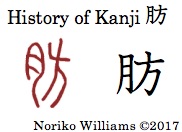 The seal style writing of the kanji 肪 comprised 月 “a part of a body,” which become a bushu nikuzuki, and 方used phonetically for /boo/ to mean “to spread out.” The part of one’s body that spreads out meant “fat; corpulent.” The kanji 肪 means “fat.” [Composition of the kanji 肪: 月 and 方]
The seal style writing of the kanji 肪 comprised 月 “a part of a body,” which become a bushu nikuzuki, and 方used phonetically for /boo/ to mean “to spread out.” The part of one’s body that spreads out meant “fat; corpulent.” The kanji 肪 means “fat.” [Composition of the kanji 肪: 月 and 方]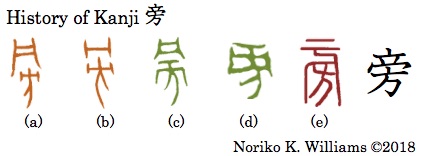 The kanji 旁 is used for the word 旁 /tsukuri/ “the right side of kanji that usually carries a phonetic feature,” in contrast to 扁 /hen/ “the left side of kanji that usually carries a semantic feature.” The kanji 旁 is not a frequently kanji at all. (It does not come in among the 2200 kanji by frequency in Tokuhiro (2014).) Nonetheless for us kanji learners it may pop up sometimes, so we include it here.
The kanji 旁 is used for the word 旁 /tsukuri/ “the right side of kanji that usually carries a phonetic feature,” in contrast to 扁 /hen/ “the left side of kanji that usually carries a semantic feature.” The kanji 旁 is not a frequently kanji at all. (It does not come in among the 2200 kanji by frequency in Tokuhiro (2014).) Nonetheless for us kanji learners it may pop up sometimes, so we include it here.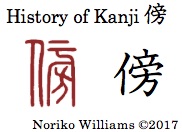 The seal style writing of the kanji 傍 comprised “an act that one does” and 旁 “on the side,” used phonetically for /boo/. Together they signified “a person standing by the side” (for a reason.) The kanji 傍 means “side; to stand by.” [Composition of the kanji 傍: イand 旁]
The seal style writing of the kanji 傍 comprised “an act that one does” and 旁 “on the side,” used phonetically for /boo/. Together they signified “a person standing by the side” (for a reason.) The kanji 傍 means “side; to stand by.” [Composition of the kanji 傍: イand 旁]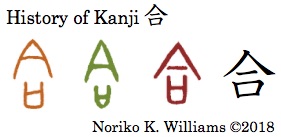 In all three types of ancient writing (oracle bone style in brown, bronze ware style in green and seal style in red) for the kanji 合 it had a container with a lid on top. From the meaning of “a lid and the container fitting well,” it meant “to meet; fit.” The kanji 合 means “to meet; put together; fit; mix.” Of the two kanji that is pronounced as /au/ to mean “to meet,” the kanji 合 is used for things whereas the kanji 会 is for people. <Composition of the kanji 合: and 𠆢 , 一 and 口>
In all three types of ancient writing (oracle bone style in brown, bronze ware style in green and seal style in red) for the kanji 合 it had a container with a lid on top. From the meaning of “a lid and the container fitting well,” it meant “to meet; fit.” The kanji 合 means “to meet; put together; fit; mix.” Of the two kanji that is pronounced as /au/ to mean “to meet,” the kanji 合 is used for things whereas the kanji 会 is for people. <Composition of the kanji 合: and 𠆢 , 一 and 口>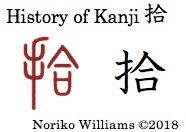 The seal style writing of the kanji 拾 comprised “a hand” and 合 used phonetically for /shuu/ to mean “to pick up,” together signifying “a hand picking up a thing.” In kanji the left side became 扌, a bushu tehen “an act that one does using a hand.” The kanji 拾 means “to pick up; gather.” <Composition of the kanji 拾: 扌 and 合>
The seal style writing of the kanji 拾 comprised “a hand” and 合 used phonetically for /shuu/ to mean “to pick up,” together signifying “a hand picking up a thing.” In kanji the left side became 扌, a bushu tehen “an act that one does using a hand.” The kanji 拾 means “to pick up; gather.” <Composition of the kanji 拾: 扌 and 合>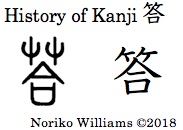 There is no ancient writing for the kanji 答. The writing on the left side is a brush writing from a later time and comprised 艸 “plants; grass” and 合 “to meet” used phonetically for /too/, together forming 荅 “answer.” One view explains 荅 to be two sides of a pea pod, fitting very well. Later the top was replaced by 竹, a bushu takekanmuri “bamboo.” A bushu takekanmuri often pertained to writing because bamboo writing tablets and writing brush had a bamboo handle. It may be the case that the takekanmuri replaced “plants” because writing an answer using a bamboo brush fit better to its meaning. The kanji 答 means “answer.” <Composition of the kanji 答: 竹 and 合>
There is no ancient writing for the kanji 答. The writing on the left side is a brush writing from a later time and comprised 艸 “plants; grass” and 合 “to meet” used phonetically for /too/, together forming 荅 “answer.” One view explains 荅 to be two sides of a pea pod, fitting very well. Later the top was replaced by 竹, a bushu takekanmuri “bamboo.” A bushu takekanmuri often pertained to writing because bamboo writing tablets and writing brush had a bamboo handle. It may be the case that the takekanmuri replaced “plants” because writing an answer using a bamboo brush fit better to its meaning. The kanji 答 means “answer.” <Composition of the kanji 答: 竹 and 合>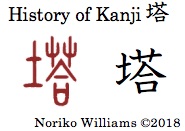 The seal style writing for the kanji 塔 comprised 土 “dirt; soil” and 荅 used phonetically for /too/. The writing 塔 was phonetic rendition of 卒塔婆 /sotoba/ from the Sanskrit “stupa,” which was a dome-like monument erected as a Buddha shrine. The kanji 塔 means “tower; monument.” <Composition of the kanji 塔: 土 and 荅>
The seal style writing for the kanji 塔 comprised 土 “dirt; soil” and 荅 used phonetically for /too/. The writing 塔 was phonetic rendition of 卒塔婆 /sotoba/ from the Sanskrit “stupa,” which was a dome-like monument erected as a Buddha shrine. The kanji 塔 means “tower; monument.” <Composition of the kanji 塔: 土 and 荅>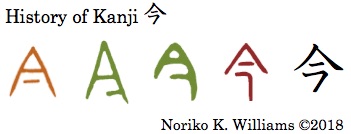 For the kanji 今 in all three ancient style it comprised “a cover with a stopper for a container or rice wine cask.” (The shape appeared in the top of the anceint writing of the kanji 飲 which we looked at in earlier post.) It was borrowed to mean “present moment; now.” Another explanation is that “the top was capturing the present moment.” The kanji 今 means “now; present time.” <Composition of the kanji 今: 𠆢 and ラ>
For the kanji 今 in all three ancient style it comprised “a cover with a stopper for a container or rice wine cask.” (The shape appeared in the top of the anceint writing of the kanji 飲 which we looked at in earlier post.) It was borrowed to mean “present moment; now.” Another explanation is that “the top was capturing the present moment.” The kanji 今 means “now; present time.” <Composition of the kanji 今: 𠆢 and ラ> For the kanji 陰 in the two bronze ware style writings the left comprised “mountains” (vertically placed), “something to cover” and “a cloud rising” underneath, together a mountain blocking the sun and a could under a cover signified “a dark area” or “a shadow.” The contrast between a sunny area and a shadowy area also is used for the contrast between “positive (陽) and negative (陰).” The seal style writing comprised the same components in more stylized shape. The kanji 陰 means “shadow; negative.” <Composition of the kanji 陰: 阝, 今 and 云>
For the kanji 陰 in the two bronze ware style writings the left comprised “mountains” (vertically placed), “something to cover” and “a cloud rising” underneath, together a mountain blocking the sun and a could under a cover signified “a dark area” or “a shadow.” The contrast between a sunny area and a shadowy area also is used for the contrast between “positive (陽) and negative (陰).” The seal style writing comprised the same components in more stylized shape. The kanji 陰 means “shadow; negative.” <Composition of the kanji 陰: 阝, 今 and 云>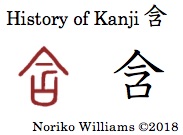 The seal style writing of the kanji 含 comprised “a cover with a stopper” (今) and “a mouth; box” (口) together signifying “putting something inside a mouth or container.” The kanji 含 means “to contain; include.” <Composition of the kanji 含: 今 and 口>
The seal style writing of the kanji 含 comprised “a cover with a stopper” (今) and “a mouth; box” (口) together signifying “putting something inside a mouth or container.” The kanji 含 means “to contain; include.” <Composition of the kanji 含: 今 and 口>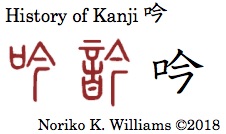 For the kanji 吟 in seal style the left one comprised 口 “mouth” and 今 “a cover with a stopper” used phonetically for /kin; gin/ to mean “muffling sound in a mouth.” The second one had 音 “sound” instead of 口. The kanji 吟 reflected the left one. From “a muffled voice in a closed mouth” the kanji 吟 means “to groan; chant.” <Composition of the kanji 吟: 口 and 今>
For the kanji 吟 in seal style the left one comprised 口 “mouth” and 今 “a cover with a stopper” used phonetically for /kin; gin/ to mean “muffling sound in a mouth.” The second one had 音 “sound” instead of 口. The kanji 吟 reflected the left one. From “a muffled voice in a closed mouth” the kanji 吟 means “to groan; chant.” <Composition of the kanji 吟: 口 and 今>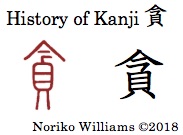 The seal style writing of the kanji 貪 comprised “a lid with a stopper” (今) and “a bronze ware vessel” (貝) to store valuables. Together they signified “stashing away greedily with a stopper.” The kanji 貪 means “to covet; be greedy; devour.” <Composition of the kanji 貪: 今 and 貝>
The seal style writing of the kanji 貪 comprised “a lid with a stopper” (今) and “a bronze ware vessel” (貝) to store valuables. Together they signified “stashing away greedily with a stopper.” The kanji 貪 means “to covet; be greedy; devour.” <Composition of the kanji 貪: 今 and 貝>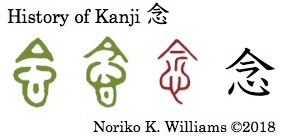 For the kanji 念 the bronze ware style writing and the seal style writing comprised 今 “a lid to keep something in” and 心 “heart.” Together they meant “a thought that one kept inside his heart for a long time.” The kanji 念 means “thought; pray; wish; ponder.” <Composition of the kanji 念: 今 and心>
For the kanji 念 the bronze ware style writing and the seal style writing comprised 今 “a lid to keep something in” and 心 “heart.” Together they meant “a thought that one kept inside his heart for a long time.” The kanji 念 means “thought; pray; wish; ponder.” <Composition of the kanji 念: 今 and心>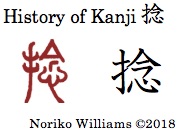 The seal style writing of the 捻 comprised “a hand” and 念 used phoneticallly for /nen/ to mean “twist.” Together they signified “to twist something with fingers.” The kanji 捻 means “to twist; bend.” <Composition of the kanji 捻: 扌, 今 and 心>
The seal style writing of the 捻 comprised “a hand” and 念 used phoneticallly for /nen/ to mean “twist.” Together they signified “to twist something with fingers.” The kanji 捻 means “to twist; bend.” <Composition of the kanji 捻: 扌, 今 and 心>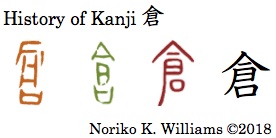 For the kanji 倉 in oracle bone style and bronze ware style it was “a grainer,” with “a cover to protect the grain from rain” at the top and “an opening to get the grain out” at the bottom, together signifying “storage of grain.” In seal style the top became a bushu hitoyane. The kanji 倉 means “storage; warehouse; vault.” <Composition of the kanji 倉: 𠆢 , 戸 with another stroke and 口>
For the kanji 倉 in oracle bone style and bronze ware style it was “a grainer,” with “a cover to protect the grain from rain” at the top and “an opening to get the grain out” at the bottom, together signifying “storage of grain.” In seal style the top became a bushu hitoyane. The kanji 倉 means “storage; warehouse; vault.” <Composition of the kanji 倉: 𠆢 , 戸 with another stroke and 口>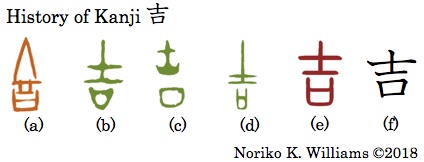 Various interpretations on the origin of the kanji 吉 are found in references, including (1) “a heap of food for celebratory feast,” – thus “joyous”; (2) “a warrior’s weapon” placed the blade side down in a ceremony and “a prayer box to confine evils” – “benediction” and (3) and “a container that is full inside which was securely plugged with a double lid,” and being full was “good.” When we look at the ancient writing all of those interpretations may make sense — (a) in oracle bone style, in brown, could be a heap of food for a feast; The top of (b) and (c) in bronze ware style, in green, and (d) in seal style, in red, appear to correspond with 士 “warrior; man” from a warrior’s axe, particularly (c) in which the thick blade at the bottom was thicker; and perhaps (e) could be viewed as (3), a container with a secure double plug at the top. Which account makes sense to us best? It does not matter to me but in this blog I just pick one “a container with a tight lid” to move on. The kanji 吉 means “good luck; joy; auspicious.” [Composition of the kanji 吉: 士 and 口]
Various interpretations on the origin of the kanji 吉 are found in references, including (1) “a heap of food for celebratory feast,” – thus “joyous”; (2) “a warrior’s weapon” placed the blade side down in a ceremony and “a prayer box to confine evils” – “benediction” and (3) and “a container that is full inside which was securely plugged with a double lid,” and being full was “good.” When we look at the ancient writing all of those interpretations may make sense — (a) in oracle bone style, in brown, could be a heap of food for a feast; The top of (b) and (c) in bronze ware style, in green, and (d) in seal style, in red, appear to correspond with 士 “warrior; man” from a warrior’s axe, particularly (c) in which the thick blade at the bottom was thicker; and perhaps (e) could be viewed as (3), a container with a secure double plug at the top. Which account makes sense to us best? It does not matter to me but in this blog I just pick one “a container with a tight lid” to move on. The kanji 吉 means “good luck; joy; auspicious.” [Composition of the kanji 吉: 士 and 口] The seal style writing of the kanji 結 had 糸, a bushu itohen “a skein of threads.” The right side 吉 was used phonetically for /kitsu; ketsu/ to mean “to be tightly contained in a jar.” The kanji 結 means “to tie; end; congregate into one.” [Composition of the kanji 結: 糸, 士 and 口]
The seal style writing of the kanji 結 had 糸, a bushu itohen “a skein of threads.” The right side 吉 was used phonetically for /kitsu; ketsu/ to mean “to be tightly contained in a jar.” The kanji 結 means “to tie; end; congregate into one.” [Composition of the kanji 結: 糸, 士 and 口]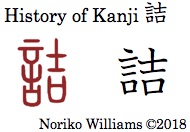 The seal style writing of the kanji 詰 comprised 言, a bushu gonben “word; language; to speak” and 吉 used phonetically for /kitsu/ to mean “containment.” Together pressing someone with accusing words meant “to blame; rebuke; criticize.” In Japanese it is also used to mean “to pack; cram; full” and “to stand by” from a room where on-duty gurds stays. The kanji 詰 means “to pack; full; rebuke; blame; squeeze; stand by.”[Composition of the kanji 詰: 言, 士 and 口]
The seal style writing of the kanji 詰 comprised 言, a bushu gonben “word; language; to speak” and 吉 used phonetically for /kitsu/ to mean “containment.” Together pressing someone with accusing words meant “to blame; rebuke; criticize.” In Japanese it is also used to mean “to pack; cram; full” and “to stand by” from a room where on-duty gurds stays. The kanji 詰 means “to pack; full; rebuke; blame; squeeze; stand by.”[Composition of the kanji 詰: 言, 士 and 口]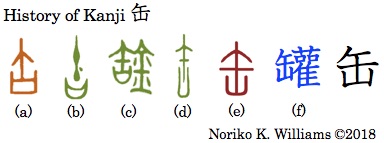 For the kanji 缶 in (a), (b) and (d) it was “a teraccotta container with a secure double lid to hold water and wine.” In (c) had the addition of 金 “metal” suggested a metal or bronze ware container that appeared later. In (f) 罐, in kyuji in blue, 雚 was added for /kan/ phonetically. From the writing (c) with a “metal” component, in Japanese it meant “metal container; can.” The kanji 缶 means “can; tin.” [Composition of the kanji 缶: 午 and 凵]
For the kanji 缶 in (a), (b) and (d) it was “a teraccotta container with a secure double lid to hold water and wine.” In (c) had the addition of 金 “metal” suggested a metal or bronze ware container that appeared later. In (f) 罐, in kyuji in blue, 雚 was added for /kan/ phonetically. From the writing (c) with a “metal” component, in Japanese it meant “metal container; can.” The kanji 缶 means “can; tin.” [Composition of the kanji 缶: 午 and 凵]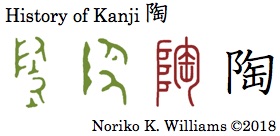 For the kanji 陶 in the two bronze ware style writings the left side was “a hill-like mound of dirt” placed vertically. The right side had double images of “a person bending his back, kneading clay.” Together they meant people making pottery near an ascending kiln. 3 in seal style comprised a bushu kozatohen “hill” and 缶 “a clay container” wrapped in 勹 that signified “ceramics.” Together they meant “making ceramic in a kiln.” It also meant “to educate” from “kneading.” The knaji 陶 means “ceramic; to educate.” [Composition of the kanji 陶: 阝, 勹and 缶]
For the kanji 陶 in the two bronze ware style writings the left side was “a hill-like mound of dirt” placed vertically. The right side had double images of “a person bending his back, kneading clay.” Together they meant people making pottery near an ascending kiln. 3 in seal style comprised a bushu kozatohen “hill” and 缶 “a clay container” wrapped in 勹 that signified “ceramics.” Together they meant “making ceramic in a kiln.” It also meant “to educate” from “kneading.” The knaji 陶 means “ceramic; to educate.” [Composition of the kanji 陶: 阝, 勹and 缶]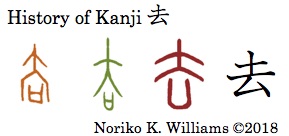 For the kanji 去 the oracle bone style and bronze ware style writings had “a person” above “an area; box” 口. Together “a person’s legs crossing over an area” signified “leaving and going far away.” The kanji 去 meant “to leave; remove.” In seal style the bottom became 凵 “receptacle”. In kanji 大 “a person” became 土 and the bottom ム. The kanji 去 means “to leave; remove; past.” [Composition of the kanji 去: 土 and ム]
For the kanji 去 the oracle bone style and bronze ware style writings had “a person” above “an area; box” 口. Together “a person’s legs crossing over an area” signified “leaving and going far away.” The kanji 去 meant “to leave; remove.” In seal style the bottom became 凵 “receptacle”. In kanji 大 “a person” became 土 and the bottom ム. The kanji 去 means “to leave; remove; past.” [Composition of the kanji 去: 土 and ム]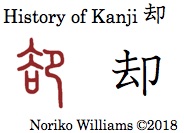 The seal style writing of the kanji 却 comprised 去 “to leave” and 卩 “a person kneeling down” signifying “receding.” Together they meant “to make a retreat; withdraw.” It is also used to mean “on the contrary; all the more” in a phrase 却って. The kanji 却 means “to withdraw; retreat; on the contrary.” [Composition of the kanji 却: 土 , ム and 卩]
The seal style writing of the kanji 却 comprised 去 “to leave” and 卩 “a person kneeling down” signifying “receding.” Together they meant “to make a retreat; withdraw.” It is also used to mean “on the contrary; all the more” in a phrase 却って. The kanji 却 means “to withdraw; retreat; on the contrary.” [Composition of the kanji 却: 土 , ム and 卩]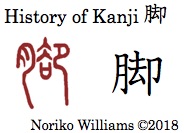 The seal style writing of the kanji 脚 comprised 月, a bushu nikuzuki “a part of one’s body” and 却 “to retreat” used phonetically for /kyaku/. From the posture of legs knelt down one one backing down, it signified “leg; foot.” The kanji 脚 means “leg; foot.” [Composition of the kanji 脚: 月, 土 , ム and 卩]
The seal style writing of the kanji 脚 comprised 月, a bushu nikuzuki “a part of one’s body” and 却 “to retreat” used phonetically for /kyaku/. From the posture of legs knelt down one one backing down, it signified “leg; foot.” The kanji 脚 means “leg; foot.” [Composition of the kanji 脚: 月, 土 , ム and 卩]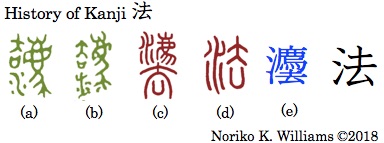 The kanji 法had a history of complex writings. One view of (a) and (b) is that the left side had 去 “to remove” and “water” and that the right side was “an imaginary animal that was believed to be used for divine judgment.” Together they meant “fair judgment; justice.” From that it meant “law.” In seal style in (c) 去 became more prominent, whereas in 4 an imaginary animal for justice was totally dropped. 灋 in 5 in Correct style is the kanji that reflected 3. The current kanji 法 reflects 4. The kanji 法 means “law; legal; court of law; method.” [Composition of the kanji 法: 氵, 土 and ム]
The kanji 法had a history of complex writings. One view of (a) and (b) is that the left side had 去 “to remove” and “water” and that the right side was “an imaginary animal that was believed to be used for divine judgment.” Together they meant “fair judgment; justice.” From that it meant “law.” In seal style in (c) 去 became more prominent, whereas in 4 an imaginary animal for justice was totally dropped. 灋 in 5 in Correct style is the kanji that reflected 3. The current kanji 法 reflects 4. The kanji 法 means “law; legal; court of law; method.” [Composition of the kanji 法: 氵, 土 and ム]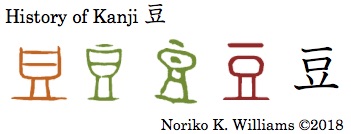 For the kanji 豆 in the oracle bone style writing, in brown, the two bronze ware style writings, in green, and the seal style writing, in red, it was “a tall raised or stemmed bowl,” and was /too/ phonetically. Later it was borrowed to mean “bean.” [Composition of the kanji 豆: 一, a side-long 口, a truncated ソ and 一]
For the kanji 豆 in the oracle bone style writing, in brown, the two bronze ware style writings, in green, and the seal style writing, in red, it was “a tall raised or stemmed bowl,” and was /too/ phonetically. Later it was borrowed to mean “bean.” [Composition of the kanji 豆: 一, a side-long 口, a truncated ソ and 一]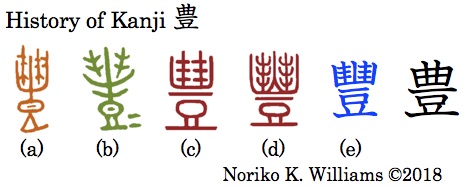 For the kanji 豊 on (a) in oracle bone style, (b) in bronze ware style and (c) and (d) in seal style one view is that it was “a tall stemmed bowl with millet stalks,” which signified “abundance of harvest.” It meant “abundance.” Another view is that the top was strands of jewels, rather than mille stalks, and it signified “wealth.” In either view the bottom was a tall stemmed bowl that was used phonetically for /too/. The kyuji 豐, (e) in blue, reflected (d), but in shinji, the top became simplified to 曲. The kanji 豊 means “abundance; affluent; plentiful; rich.” [Composition of the kanji 豊: 曲 and 豆]
For the kanji 豊 on (a) in oracle bone style, (b) in bronze ware style and (c) and (d) in seal style one view is that it was “a tall stemmed bowl with millet stalks,” which signified “abundance of harvest.” It meant “abundance.” Another view is that the top was strands of jewels, rather than mille stalks, and it signified “wealth.” In either view the bottom was a tall stemmed bowl that was used phonetically for /too/. The kyuji 豐, (e) in blue, reflected (d), but in shinji, the top became simplified to 曲. The kanji 豊 means “abundance; affluent; plentiful; rich.” [Composition of the kanji 豊: 曲 and 豆]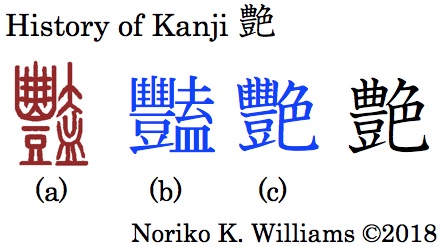 The seal style writing of the kanji 艶, (a) comprised 豊 “plentiful; abundant” and the right side that signified “a lid (去) over a vessel (皿).” Plentiful food or offerings in a vessel was “desirable,” which further meant “enchanting; attractive” in appearance. (b) 豔 reflected (a). (c) was an informal writing of (b), in which 色 suggested “attractiveness.” The top of (c) still reflected (a). In the shinji 艷 the top became 曲. The kanji 艶 means “glossy; (women’s) enchanting.” [Composition of the kanji 艶: 豊 and 色]
The seal style writing of the kanji 艶, (a) comprised 豊 “plentiful; abundant” and the right side that signified “a lid (去) over a vessel (皿).” Plentiful food or offerings in a vessel was “desirable,” which further meant “enchanting; attractive” in appearance. (b) 豔 reflected (a). (c) was an informal writing of (b), in which 色 suggested “attractiveness.” The top of (c) still reflected (a). In the shinji 艷 the top became 曲. The kanji 艶 means “glossy; (women’s) enchanting.” [Composition of the kanji 艶: 豊 and 色]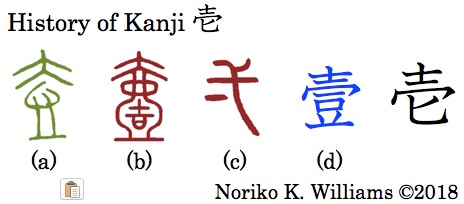 For the kanji 壱 in bronze ware style and seal style it was “a pot or crock that had a secure lid.” A tightly closed pot was filled with fermented air. The bottom of 4 in kyuji, 壹, was 豆, reflecting the original meaning. It was borrowed to mean “one” and is used to avoid misreading the kanji 一 in an important receipt, draft or check. One can easily imagine that it is very easy to add another line or two to 一 to tamper the original number. The kanji 二 and 三 also had a formal writing — the kanji 貮弐 for 二 and 参 for 三. The kanji 壱 means “one; single.” [Composition of the kanji 壱: 士, 冖 and ヒ]
For the kanji 壱 in bronze ware style and seal style it was “a pot or crock that had a secure lid.” A tightly closed pot was filled with fermented air. The bottom of 4 in kyuji, 壹, was 豆, reflecting the original meaning. It was borrowed to mean “one” and is used to avoid misreading the kanji 一 in an important receipt, draft or check. One can easily imagine that it is very easy to add another line or two to 一 to tamper the original number. The kanji 二 and 三 also had a formal writing — the kanji 貮弐 for 二 and 参 for 三. The kanji 壱 means “one; single.” [Composition of the kanji 壱: 士, 冖 and ヒ]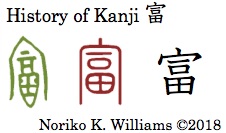 For the kanji 富 in bronze ware style the top was “a house” and the inside was “a narrow neck container with a lid whose bottom was swelled in the middle.” A house that had a container that was filled with treasure or things signified “wealth; wealthy; fortune.” Inside of the seal style the container shape became 畐 — a lid, an opening and a full container itself. The kanji 富 means “wealth; fortune.” [Composition of the kanji 富 : 宀, 一, 口 and 田]
For the kanji 富 in bronze ware style the top was “a house” and the inside was “a narrow neck container with a lid whose bottom was swelled in the middle.” A house that had a container that was filled with treasure or things signified “wealth; wealthy; fortune.” Inside of the seal style the container shape became 畐 — a lid, an opening and a full container itself. The kanji 富 means “wealth; fortune.” [Composition of the kanji 富 : 宀, 一, 口 and 田]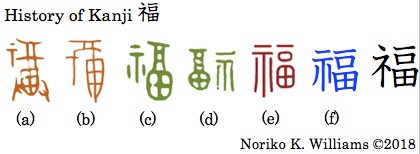 For the kanji 福 in oracle bone style (a) had “a wine cask filled with a lid with wine that was raised by two hands” and “an altar table with offering” on the top left, while 2 did not have hands. By placing a cask full of stuff on an altar table, one prayed for blessing from a god. It meant “bliss; good luck; happiness.” In (c) and (d) in bronze ware style an altar table with offering began to take the shape 示. In (e) in seal style a full container with a lid became 畐, which is reflected in the kyuji 福, (f). In shinji 福, the left side became ネ, a bushu shimesuhen “religious matter.” The kanji 福 means “good luck; bliss; blessing; fortune.” [Composition of the kanji 福: ネ and 畐]
For the kanji 福 in oracle bone style (a) had “a wine cask filled with a lid with wine that was raised by two hands” and “an altar table with offering” on the top left, while 2 did not have hands. By placing a cask full of stuff on an altar table, one prayed for blessing from a god. It meant “bliss; good luck; happiness.” In (c) and (d) in bronze ware style an altar table with offering began to take the shape 示. In (e) in seal style a full container with a lid became 畐, which is reflected in the kyuji 福, (f). In shinji 福, the left side became ネ, a bushu shimesuhen “religious matter.” The kanji 福 means “good luck; bliss; blessing; fortune.” [Composition of the kanji 福: ネ and 畐]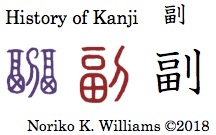 For the kanji 副 in Large seal style, in purple, it had two “full narrow-neck containers” and “a knife” in between. They signified that a knife dividing wealth in two parts, a main part and an accompanying part. The meaning of the writing focused on the accompanying part, and it meant “to accompany; assisting; copy.” The seal style writing comprised 畐 and 刀 “knife” which was replaced by 刂, a bushu rittoo “knife on the right side” in the shinji 副. The kanji 副 means “to accompany; assisting; copy.” [Composition of the kanji 副: 畐 and 刂]
For the kanji 副 in Large seal style, in purple, it had two “full narrow-neck containers” and “a knife” in between. They signified that a knife dividing wealth in two parts, a main part and an accompanying part. The meaning of the writing focused on the accompanying part, and it meant “to accompany; assisting; copy.” The seal style writing comprised 畐 and 刀 “knife” which was replaced by 刂, a bushu rittoo “knife on the right side” in the shinji 副. The kanji 副 means “to accompany; assisting; copy.” [Composition of the kanji 副: 畐 and 刂]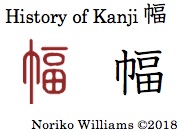 The seal style writing of the kanji 幅 comprised 巾 “cloth; lap robe” and 畐, which was used phonetically for /huku/ to mean something spreading sideways like a barrel. For a lap robe, fabric was used as it was woven with its width intact. It is also used as a counter for a scroll. The kanji 幅 means “width; counter of scroll.” [Composition of the kanji 幅: 巾 and 畐]
The seal style writing of the kanji 幅 comprised 巾 “cloth; lap robe” and 畐, which was used phonetically for /huku/ to mean something spreading sideways like a barrel. For a lap robe, fabric was used as it was woven with its width intact. It is also used as a counter for a scroll. The kanji 幅 means “width; counter of scroll.” [Composition of the kanji 幅: 巾 and 畐]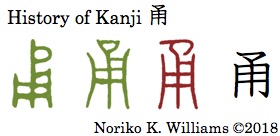 The shape 甬 had its own history shown on the right. There are different views on this shape. One is a person stamping his feet on a pole to push through a board. In this post we take the view that it was a hollow cylindrical shape that was formed by assembling pieces of wood. Being hollow gave the meaning “to fall through.” It is phonetically /yoo; too/.
The shape 甬 had its own history shown on the right. There are different views on this shape. One is a person stamping his feet on a pole to push through a board. In this post we take the view that it was a hollow cylindrical shape that was formed by assembling pieces of wood. Being hollow gave the meaning “to fall through.” It is phonetically /yoo; too/. For the kanji 通 (a) and (b) in oracle bone style, in brown, had “a crossroad” on the left and 甬 “a hollow cylindrical shape,” signifying “to fall through,” and “a footprint” in (a) added. Together they meant “to move on past a crossroad” or “to pass through.” In (c) in bronze ware style, in green, in addition to the two components it had “a round shape” at the top indicating “a rounded cylindrical shape,” such as a pail,” which changed to a マ shape in kanji. In (d) in seal style the footprint moved to the left side, and together with a crossroad they formed 辵, which coalesced into 辶, a bushu shinnyoo “to move forward.” Not having an obstacle in the passage also meant “to go and come back regularly.” It is also used in communication in speaking and telephone, etc. The kanji 通 means “to pass through; go and come back regularly; understand.” [Composition of the kanji 通: 甬 and 辶] (Please note that in writing 辶 has a wiggly line, as shown in the kanji in the table.)
For the kanji 通 (a) and (b) in oracle bone style, in brown, had “a crossroad” on the left and 甬 “a hollow cylindrical shape,” signifying “to fall through,” and “a footprint” in (a) added. Together they meant “to move on past a crossroad” or “to pass through.” In (c) in bronze ware style, in green, in addition to the two components it had “a round shape” at the top indicating “a rounded cylindrical shape,” such as a pail,” which changed to a マ shape in kanji. In (d) in seal style the footprint moved to the left side, and together with a crossroad they formed 辵, which coalesced into 辶, a bushu shinnyoo “to move forward.” Not having an obstacle in the passage also meant “to go and come back regularly.” It is also used in communication in speaking and telephone, etc. The kanji 通 means “to pass through; go and come back regularly; understand.” [Composition of the kanji 通: 甬 and 辶] (Please note that in writing 辶 has a wiggly line, as shown in the kanji in the table.)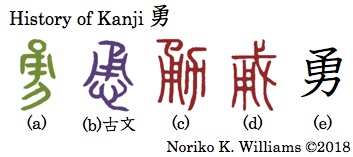 For the kanji 勇, the top of (a) in bronze ware style had “a hollow cylindrical shape,” signifying “to go through,” and was used phonetically for /yuu/. The bottom was “a plough,” signifying “to exert one’s strength.” Together they meant “one’s strength spurting.” (b) in Old style had “a heart” rather than “a plough” at the bottom. In seal style (c) had the two components placed side by side whereas (d) had “a halberd” instead of “a plough.” Together they meant to muster up one’s strength to do something. Bravery involves spurts of strength. The kanji 勇 means “courage; brave.” [Composition of the kanji 勇: マ, 田 and 力]
For the kanji 勇, the top of (a) in bronze ware style had “a hollow cylindrical shape,” signifying “to go through,” and was used phonetically for /yuu/. The bottom was “a plough,” signifying “to exert one’s strength.” Together they meant “one’s strength spurting.” (b) in Old style had “a heart” rather than “a plough” at the bottom. In seal style (c) had the two components placed side by side whereas (d) had “a halberd” instead of “a plough.” Together they meant to muster up one’s strength to do something. Bravery involves spurts of strength. The kanji 勇 means “courage; brave.” [Composition of the kanji 勇: マ, 田 and 力]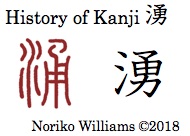 The seal style writing of the kanji 湧 comprised “water” and 甬 which was used phonetically for /yuu/ to mean “through.” Together they meant “water springing out from a well.” The kanji 湧く means “to bubble up; spring out.” [Composition of the kanji 湧: 氵and 勇]
The seal style writing of the kanji 湧 comprised “water” and 甬 which was used phonetically for /yuu/ to mean “through.” Together they meant “water springing out from a well.” The kanji 湧く means “to bubble up; spring out.” [Composition of the kanji 湧: 氵and 勇] The seal style writing of the kanji 踊 comprised 足 “leg; foot” and 甬 used phonetically for /yoo/ to mean “to bubble up.” Together they meant “legs jumping up and down.” The kanji 踊 means “to dance.” [Composition of the kanji 踊: 足へん and 甬]
The seal style writing of the kanji 踊 comprised 足 “leg; foot” and 甬 used phonetically for /yoo/ to mean “to bubble up.” Together they meant “legs jumping up and down.” The kanji 踊 means “to dance.” [Composition of the kanji 踊: 足へん and 甬] For the kanji 全 (a) in Large seal style, in light blue, had “a roof or cover” (𠆢 or 亼) that signified “to gather things under one cover”– a bushu hitoyane. The bottom was a set of flawless perfect jewels or jems (王). (b) in Old style had decoration that was in symmetry. The kanji 全 meant “complete; perfect; to fulfill.” [Composition of the kanji 全: 𠆢 and 王]
For the kanji 全 (a) in Large seal style, in light blue, had “a roof or cover” (𠆢 or 亼) that signified “to gather things under one cover”– a bushu hitoyane. The bottom was a set of flawless perfect jewels or jems (王). (b) in Old style had decoration that was in symmetry. The kanji 全 meant “complete; perfect; to fulfill.” [Composition of the kanji 全: 𠆢 and 王] The seal style writing comprised 言 “word; language” and 全 “complete; thorough” used phonetically for /sen/. Together they meant that “details were worked out or elucidated.” It also means “to think thoroughly” and “in the end.” [Composition of the kanji 詮: 言 and 全]
The seal style writing comprised 言 “word; language” and 全 “complete; thorough” used phonetically for /sen/. Together they meant that “details were worked out or elucidated.” It also means “to think thoroughly” and “in the end.” [Composition of the kanji 詮: 言 and 全]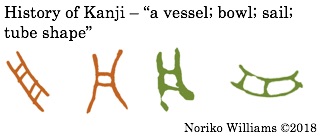 In this and next posts we explore kanji whose shapes appear totally unrelated and yet if we look at their ancient writings they did share the same shape, or at least closely related. The shapes shown on the right side were taken from the various kanji. They meant “a vessel; a boat; bowl; cylindrical shape.” I find it very interesting to know that the English word “vessel” also means (1) a ship or a large boat, (2) a hollow container especially one used to hold liquid, such as bowl or cask and (3) by extension, a duct or canal holding or conveying blood or other fluid.
In this and next posts we explore kanji whose shapes appear totally unrelated and yet if we look at their ancient writings they did share the same shape, or at least closely related. The shapes shown on the right side were taken from the various kanji. They meant “a vessel; a boat; bowl; cylindrical shape.” I find it very interesting to know that the English word “vessel” also means (1) a ship or a large boat, (2) a hollow container especially one used to hold liquid, such as bowl or cask and (3) by extension, a duct or canal holding or conveying blood or other fluid.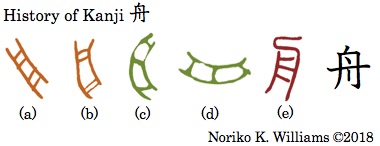 For the kanji 舟 in (a) and (b) in oracle bone style, in brown, and (c) and (d) in bronze ware style, in green, it was the shape of “a boat.” A simple boat such as a canoe was made by hollowing out a log. A boat could also be made with panels of wooden board. (e) in seal style, in red, became the kanji 舟. The kanji 舟 means “boat.”
For the kanji 舟 in (a) and (b) in oracle bone style, in brown, and (c) and (d) in bronze ware style, in green, it was the shape of “a boat.” A simple boat such as a canoe was made by hollowing out a log. A boat could also be made with panels of wooden board. (e) in seal style, in red, became the kanji 舟. The kanji 舟 means “boat.”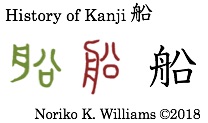 For the kanji 船the bronze ware style and seal style writings had “a boat” on the left side. The right side 㕣 was used phonetically for /en/ to mean “along.” A vessel that travelled along the flow of water meant “ship.” The kanji 船 means “ship.” [Composition of the kanji 船: 舟 and 㕣]
For the kanji 船the bronze ware style and seal style writings had “a boat” on the left side. The right side 㕣 was used phonetically for /en/ to mean “along.” A vessel that travelled along the flow of water meant “ship.” The kanji 船 means “ship.” [Composition of the kanji 船: 舟 and 㕣]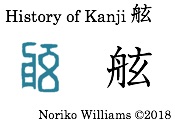 The Qin-Han era seal sample, in blue, comprised 舟 “boat” and 玄 “thin things like threads” used phonetically for /gen/. Together they meant “the sides of a boat.” The kanji 舷 means “side of a boat; the gunwale; the railing of a boad,” a very specialized kanji in my view. [Composition of the kanji 舷: 舟 and 玄]
The Qin-Han era seal sample, in blue, comprised 舟 “boat” and 玄 “thin things like threads” used phonetically for /gen/. Together they meant “the sides of a boat.” The kanji 舷 means “side of a boat; the gunwale; the railing of a boad,” a very specialized kanji in my view. [Composition of the kanji 舷: 舟 and 玄]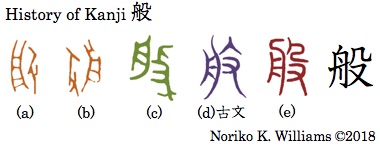 The left side of (a) and (b) in oracle bone style and (c) in bronze ware style and (d) in Old style, in purple, and (e) in seal style was “a tray.” The right side was “a hand holding a weapon or tool,” which eventually becomes 殳, a bushu hokozukuri/rumata. Together they originally meant “a hand carrying somethings in a shallow bowl,” but the shape was borrowed to mean “general.” A new kanji was created for the original meaning of “to carry” by adding another hand, the kanji 搬, our next kanji. The kanji 般 means “general.” [Composition of the kanji 般: 舟 and 殳]
The left side of (a) and (b) in oracle bone style and (c) in bronze ware style and (d) in Old style, in purple, and (e) in seal style was “a tray.” The right side was “a hand holding a weapon or tool,” which eventually becomes 殳, a bushu hokozukuri/rumata. Together they originally meant “a hand carrying somethings in a shallow bowl,” but the shape was borrowed to mean “general.” A new kanji was created for the original meaning of “to carry” by adding another hand, the kanji 搬, our next kanji. The kanji 般 means “general.” [Composition of the kanji 般: 舟 and 殳] For the kanji 盤 (a) in oracle bone style had “a hand holding a tool” (殳) and “a tray” (舟) (together 般, originally meant “to carry”) and “a shallow bowl” (皿). In bronze ware style, (b), (c) and (d) had the same three components. Together they meant “a shallow flat bowl one carries something” or “a tray.” (e) in Large seal style, (f) in Old style and (g) in seal style all had 般 at the top. The kanji 盤 means “a tray; a raised flat bowl.” [Composition of the kanji 盤: 舟, 殳and 皿]
For the kanji 盤 (a) in oracle bone style had “a hand holding a tool” (殳) and “a tray” (舟) (together 般, originally meant “to carry”) and “a shallow bowl” (皿). In bronze ware style, (b), (c) and (d) had the same three components. Together they meant “a shallow flat bowl one carries something” or “a tray.” (e) in Large seal style, (f) in Old style and (g) in seal style all had 般 at the top. The kanji 盤 means “a tray; a raised flat bowl.” [Composition of the kanji 盤: 舟, 殳and 皿] For the kanji 朕 (a) and (b) in oracle bone style and (c) and (d) in bronze ware style all comprised “a shallow bowl or a tray” (月 or 舟) for transporting things and “two hands holding up an (important) object.” Together they meant “to carry something in a tray and present reverentially with both hands.” It was used by an emperor as a first-person pronoun “imperial We.” In seal style, (e), what was presented became the shape 火 (with no relevance to “fire”). In kanji 朕 the elements on the right side coalesced and became 关. The kanji 朕 means “I (imperial We).” [Composition of the kanji 朕: 月and 关]
For the kanji 朕 (a) and (b) in oracle bone style and (c) and (d) in bronze ware style all comprised “a shallow bowl or a tray” (月 or 舟) for transporting things and “two hands holding up an (important) object.” Together they meant “to carry something in a tray and present reverentially with both hands.” It was used by an emperor as a first-person pronoun “imperial We.” In seal style, (e), what was presented became the shape 火 (with no relevance to “fire”). In kanji 朕 the elements on the right side coalesced and became 关. The kanji 朕 means “I (imperial We).” [Composition of the kanji 朕: 月and 关]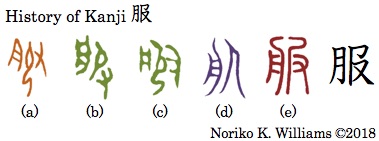 For the kanji 服 (a) in oracle bone style and (b) and (c) in bronze ware style, the left side had “a flat bowl or vessel.” In the middle and the right side had “a person being pushed by a hand and kneeling down.” Together the knelt-down posture signified “to subject to; yield to.” In Old style, (d), “a hand” disappeared, but in (e) in seal style “a hand” (又) returned. The kanji 服 meant “to follow; obey; obedient.” Clothes are molded to a person’s body, yielding to the body, so it is also used for “clothes.” It also means “to take medicine” or “to have a short rest.” [Composition of the kanji 服: no segment available]
For the kanji 服 (a) in oracle bone style and (b) and (c) in bronze ware style, the left side had “a flat bowl or vessel.” In the middle and the right side had “a person being pushed by a hand and kneeling down.” Together the knelt-down posture signified “to subject to; yield to.” In Old style, (d), “a hand” disappeared, but in (e) in seal style “a hand” (又) returned. The kanji 服 meant “to follow; obey; obedient.” Clothes are molded to a person’s body, yielding to the body, so it is also used for “clothes.” It also means “to take medicine” or “to have a short rest.” [Composition of the kanji 服: no segment available]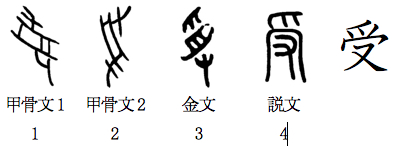 The kanji 受 and 授–It has been a long time since we looked at the kanji 受and 授. The kanji 受 also had “a vessel that contained a valuable thing” between “a hand form above” and “a hand from below.” Together they signified “a hand giving out something valuable and another hand receiving it,” and originally meant both “to receive” and “to bestow.” Later giving and receiving became differentiated and the kanji 受was used for an action for a receiver. The kanji 受 meant “to receive.”
The kanji 受 and 授–It has been a long time since we looked at the kanji 受and 授. The kanji 受 also had “a vessel that contained a valuable thing” between “a hand form above” and “a hand from below.” Together they signified “a hand giving out something valuable and another hand receiving it,” and originally meant both “to receive” and “to bestow.” Later giving and receiving became differentiated and the kanji 受was used for an action for a receiver. The kanji 受 meant “to receive.” In the interpretation of 凡 (c) above, the two vertical lines (a) and (b) in oracle bone style, in brown, and (c) and (d) in bronze ware style, in green were “masts,” and the short horizontal lines were the outline of “a sail.” A sail caught wind. A sail is large, and covering a large area meant “all; nearly all; approximation.” In (e) in seal style, in red, the short line in the middle signified that inside was not hollow or empty. “All” means nothing special, thus “ordinary.” The kanji 凡 means “all; common; ordinary; spreading.” [Composition of the kanji 凡: 几and ヽ]
In the interpretation of 凡 (c) above, the two vertical lines (a) and (b) in oracle bone style, in brown, and (c) and (d) in bronze ware style, in green were “masts,” and the short horizontal lines were the outline of “a sail.” A sail caught wind. A sail is large, and covering a large area meant “all; nearly all; approximation.” In (e) in seal style, in red, the short line in the middle signified that inside was not hollow or empty. “All” means nothing special, thus “ordinary.” The kanji 凡 means “all; common; ordinary; spreading.” [Composition of the kanji 凡: 几and ヽ] The seal style writing had “water” and 凡, which was used phonetically for /han/ to mean “sail; large piece of cloth; to spread.” Together they meant “to float on the water.” Water spreading would cause a flood in a wide area. The kanji 汎 means “all; covering all; far and wide; pan-.” [Composition of the kanji 汎: 氵 and 凡]
The seal style writing had “water” and 凡, which was used phonetically for /han/ to mean “sail; large piece of cloth; to spread.” Together they meant “to float on the water.” Water spreading would cause a flood in a wide area. The kanji 汎 means “all; covering all; far and wide; pan-.” [Composition of the kanji 汎: 氵 and 凡] The origin is not clear. One view is that the top of 1 and 2 in oracle bone style and 3 and 4 in bronze ware style was same as 凡, and in some instances as 舟. The bottom was 口 “mouth; to speak.” A tube-like shape signified that the opening from the front through the back was “the same.” The sides of the top shape were lengthened in (e) in seal style, which reflected in the kanji 同. The kanji 同 means “same; identical.” [Composition of the kanji 同: 冂, 一 and 口]
The origin is not clear. One view is that the top of 1 and 2 in oracle bone style and 3 and 4 in bronze ware style was same as 凡, and in some instances as 舟. The bottom was 口 “mouth; to speak.” A tube-like shape signified that the opening from the front through the back was “the same.” The sides of the top shape were lengthened in (e) in seal style, which reflected in the kanji 同. The kanji 同 means “same; identical.” [Composition of the kanji 同: 冂, 一 and 口]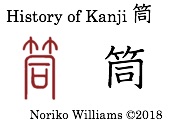 The seal style writing had 竹 “bamboo” and 同, which was used phonetically for /doo; too/ to mean “tube-like shape,” a shape having straight parallel sides. Together they meant tube-like shape such as a bamboo. The kanji 筒 means “tube-like shape; cylindrical.” [Composition of the kanji 筒: 竹かんむり and 同]
The seal style writing had 竹 “bamboo” and 同, which was used phonetically for /doo; too/ to mean “tube-like shape,” a shape having straight parallel sides. Together they meant tube-like shape such as a bamboo. The kanji 筒 means “tube-like shape; cylindrical.” [Composition of the kanji 筒: 竹かんむり and 同]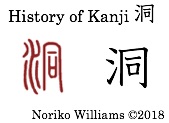 The seal style writing comprised “water” and 同, which was used phonetically to mean “a shape that was hollow.” Together they mean an area where water gushed through and made a shape that went through, such as cave. The kanji 洞 means “cave; to penetrate.” [Composition of the kanji 洞: 氵 and 同]
The seal style writing comprised “water” and 同, which was used phonetically to mean “a shape that was hollow.” Together they mean an area where water gushed through and made a shape that went through, such as cave. The kanji 洞 means “cave; to penetrate.” [Composition of the kanji 洞: 氵 and 同] The bronze ware style and seal style writings comprised 金 “metal” and 同, which was used phonetically for /do’o/ to mean “red.” Together “red metal” (赤金) meant “copper.” The kanji 銅 means “copper.” [Composition of the kanji 銅: 金 and 同]
The bronze ware style and seal style writings comprised 金 “metal” and 同, which was used phonetically for /do’o/ to mean “red.” Together “red metal” (赤金) meant “copper.” The kanji 銅 means “copper.” [Composition of the kanji 銅: 金 and 同]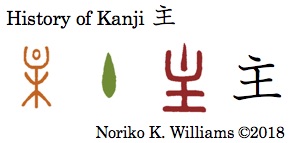 For the kanji 主 the oracle bone style writing, in brown, was “a flame” on top of 木 “wood,” signifying “a torch” (used outside). The bronze ware writing, in green, was “a flame” alone. In seal style, in red, it became “a burning oil wick on a long-stem oil lamp holder” inside a house. A fire was important and symbolized “the master of a house.” The kanji 主 means “master; main; primary.” [the composition of the kanji 主: 丶 and 王]
For the kanji 主 the oracle bone style writing, in brown, was “a flame” on top of 木 “wood,” signifying “a torch” (used outside). The bronze ware writing, in green, was “a flame” alone. In seal style, in red, it became “a burning oil wick on a long-stem oil lamp holder” inside a house. A fire was important and symbolized “the master of a house.” The kanji 主 means “master; main; primary.” [the composition of the kanji 主: 丶 and 王]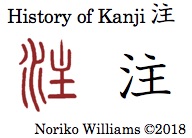 For the kanji 注 the seal style writing comprised “water; liquid” and 主 used phonetically for /chuu/ to mean “staying in one place.” Together they meant “a manner in which one poured lamp oil very carefully.” The kanji 注 meant “to pour; pay (attention).” [the composition of the kanji 注: 氵and 主]
For the kanji 注 the seal style writing comprised “water; liquid” and 主 used phonetically for /chuu/ to mean “staying in one place.” Together they meant “a manner in which one poured lamp oil very carefully.” The kanji 注 meant “to pour; pay (attention).” [the composition of the kanji 注: 氵and 主]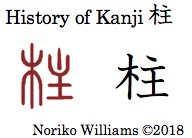 The seal style of the kanji 柱 comprised 木 “tree; wood” and 主 used phonetically for /chuu/ to mean “something that does not move; main.” Together “wood that stayed in one place supporting the rest of a house” was “column.” The kanji 柱 means “pillar; column; support.” [the composition of the kanji 柱: 木 and 主]
The seal style of the kanji 柱 comprised 木 “tree; wood” and 主 used phonetically for /chuu/ to mean “something that does not move; main.” Together “wood that stayed in one place supporting the rest of a house” was “column.” The kanji 柱 means “pillar; column; support.” [the composition of the kanji 柱: 木 and 主]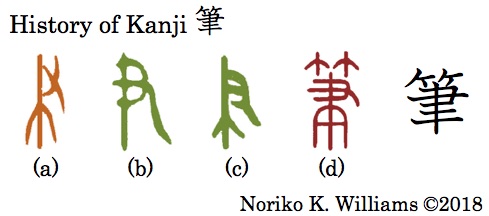 For the kanji 筆 (a), (b) and (c) had “a writing brush held by a hand.” It meant “a writing brush.” In (d) “bamboo” (竹) was added at the top to mean the brush itself, differentiating from act of writing. A writing brush usually had a bamboo handle. The kanji 筆 means “a writing brush.” [the composition of the kanji 筆: 竹かんむり and 聿]
For the kanji 筆 (a), (b) and (c) had “a writing brush held by a hand.” It meant “a writing brush.” In (d) “bamboo” (竹) was added at the top to mean the brush itself, differentiating from act of writing. A writing brush usually had a bamboo handle. The kanji 筆 means “a writing brush.” [the composition of the kanji 筆: 竹かんむり and 聿] For the kanji 律 the oracle bone writing comprised “a crossroad” signifying “a way to go or to conduct oneself” and “a hand holding a writing brush straight up.” Together they meant “to conduct oneself in an upright manner as prescribed in a rule.” The kanji 律 means “law; rules that one follows.” [the composition of the kanji 律: 彳 and聿]
For the kanji 律 the oracle bone writing comprised “a crossroad” signifying “a way to go or to conduct oneself” and “a hand holding a writing brush straight up.” Together they meant “to conduct oneself in an upright manner as prescribed in a rule.” The kanji 律 means “law; rules that one follows.” [the composition of the kanji 律: 彳 and聿]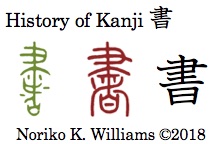 For the kanji 書in the bronze ware style and seal style writings the top was “a hand holding a writing brush upright” (聿). The bottom (者) was used phonetically for /sha/ to mean “to copy.” The kanji 書 means “to write; writing; scripture.” [the composition of the kanji 書: 聿 except the middle vertical line does not go through and 日]
For the kanji 書in the bronze ware style and seal style writings the top was “a hand holding a writing brush upright” (聿). The bottom (者) was used phonetically for /sha/ to mean “to copy.” The kanji 書 means “to write; writing; scripture.” [the composition of the kanji 書: 聿 except the middle vertical line does not go through and 日] For the kanji 粛 (a) in oracle bone style had “a writing brush” and “a pair of compasses for drawing a circle.” Together they meant “drawing a picture on bronze ware.” In (b) and (c) in bronze ware style the brush was not present. (d) in Old style, in purple, comprised “a writing brush,” “a heart” and something else (possibly 勺 for phonetic use of /shaku/). Adding a picture to a bronze ware was serious work. From that the kanji 粛 meant “solemn; gravely harsh.” The kyuji, in blue, (f), reflected (e) in seal style. In kanji the bottom was replaced by 米, but had no relevance to the meaning “rice.” The kanji 粛 means “solemn; quiet; prudent.” [the composition of the kanji 粛: hard to describe]
For the kanji 粛 (a) in oracle bone style had “a writing brush” and “a pair of compasses for drawing a circle.” Together they meant “drawing a picture on bronze ware.” In (b) and (c) in bronze ware style the brush was not present. (d) in Old style, in purple, comprised “a writing brush,” “a heart” and something else (possibly 勺 for phonetic use of /shaku/). Adding a picture to a bronze ware was serious work. From that the kanji 粛 meant “solemn; gravely harsh.” The kyuji, in blue, (f), reflected (e) in seal style. In kanji the bottom was replaced by 米, but had no relevance to the meaning “rice.” The kanji 粛 means “solemn; quiet; prudent.” [the composition of the kanji 粛: hard to describe]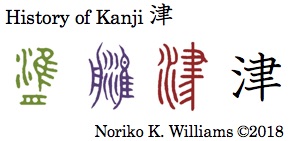 For the kanji 津 the bronze ware style and Old style comprised “water” “a bird” and “a boat.” A bird alighting on a boat in water signified “a boat landing area.” In seal style the right side became a writing brush dripping ink or liquid droplets on the lower left side signifying an area with little water, and it was used phonetically for /shin/. The kanji 津 means “shoal; landing.” [the composition of the kanji 津: 氵and聿]
For the kanji 津 the bronze ware style and Old style comprised “water” “a bird” and “a boat.” A bird alighting on a boat in water signified “a boat landing area.” In seal style the right side became a writing brush dripping ink or liquid droplets on the lower left side signifying an area with little water, and it was used phonetically for /shin/. The kanji 津 means “shoal; landing.” [the composition of the kanji 津: 氵and聿] For the kanji 典 in (a) and (b) in oracle bone style, in brown, the top was writing tablets of the same length linked together with leather straps. (a) had two hands holding it very carefully while (b) had a hand turning the book to read. What the two lines at the bottom in (a) signified is not clear, but they might have indicated a table. (c) and (d) in bronze ware style, in green, had a low table (几). The important bound writing tablets were a model or code from precedents that one looked up, and the writing meant “code; law; model.” In (e) in Old style, in purple, “bamboo” pertaining to “writing” was added at the top, but it was dropped in (f) in seal style, in red. In kanji the top was coalesced to the top of a low table. The kanji 典 means “code, law; model.”
For the kanji 典 in (a) and (b) in oracle bone style, in brown, the top was writing tablets of the same length linked together with leather straps. (a) had two hands holding it very carefully while (b) had a hand turning the book to read. What the two lines at the bottom in (a) signified is not clear, but they might have indicated a table. (c) and (d) in bronze ware style, in green, had a low table (几). The important bound writing tablets were a model or code from precedents that one looked up, and the writing meant “code; law; model.” In (e) in Old style, in purple, “bamboo” pertaining to “writing” was added at the top, but it was dropped in (f) in seal style, in red. In kanji the top was coalesced to the top of a low table. The kanji 典 means “code, law; model.” The history of the kanji 冊 has two different interpretations. One is that it was writing tablets linked together as a book. (d) in Old style, in purple, had “bamboo” at the top but lost it in (e) in seal style. This development is very similar to the kanji 典, without a table to place on. It meant “a counter of bound books.” Another view takes notice on the different length of the vertical lines in the ancient writings. Shirakawa says that a writing tablet had a set length and that wooden stakes of different length linked in a circle signified “a corral to keep live stocks to be used for sacrificial offering.” It was /saku/ phonetically. Because of the similar appearance between stakes pounded to the ground to keep live animals and writing tablets linked together, the writing mistakenly came to be used to mean “a bound book.” The kyuji 册, (f) in blue, was simplified to 冊. The kanji 冊 is used as a counter for books.
The history of the kanji 冊 has two different interpretations. One is that it was writing tablets linked together as a book. (d) in Old style, in purple, had “bamboo” at the top but lost it in (e) in seal style. This development is very similar to the kanji 典, without a table to place on. It meant “a counter of bound books.” Another view takes notice on the different length of the vertical lines in the ancient writings. Shirakawa says that a writing tablet had a set length and that wooden stakes of different length linked in a circle signified “a corral to keep live stocks to be used for sacrificial offering.” It was /saku/ phonetically. Because of the similar appearance between stakes pounded to the ground to keep live animals and writing tablets linked together, the writing mistakenly came to be used to mean “a bound book.” The kyuji 册, (f) in blue, was simplified to 冊. The kanji 冊 is used as a counter for books.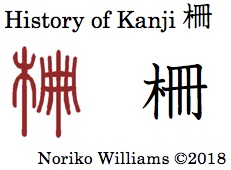 The seal style writing of the kanji 柵 comprised 木 “tree; wood” and 冊 “linked wooden stakes” used phonetically for /saku/. Because the writing 冊 changed to mean “a bound book,” the new writing was created for the original meaning of “wooden uneven length stakes to keep animals.” The kanji 柵 means “fence; wooden stockade.” <Composition of the kanji 柵: 木 and 冊>
The seal style writing of the kanji 柵 comprised 木 “tree; wood” and 冊 “linked wooden stakes” used phonetically for /saku/. Because the writing 冊 changed to mean “a bound book,” the new writing was created for the original meaning of “wooden uneven length stakes to keep animals.” The kanji 柵 means “fence; wooden stockade.” <Composition of the kanji 柵: 木 and 冊>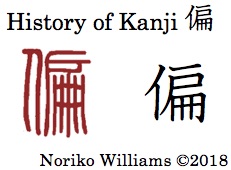 The seal style writing of the kanji 偏 comprised イ “an act one does” and 扁 “a screen door” used phonetically for /hen/ to mean “one side (of the two),” together signifying “to lean to one side.” The kanji 偏 means “to get lopsided; one side; bias.” <Composition of the kanji 偏: イ, 戸 and 冊 without the horizontal line going through >
The seal style writing of the kanji 偏 comprised イ “an act one does” and 扁 “a screen door” used phonetically for /hen/ to mean “one side (of the two),” together signifying “to lean to one side.” The kanji 偏 means “to get lopsided; one side; bias.” <Composition of the kanji 偏: イ, 戸 and 冊 without the horizontal line going through >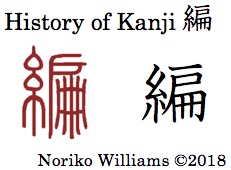 The seal style writing of the kanji 編 comprised 糸 “a skein of thread” and 扁 for /hen/ phonetically. 扁 comprised 戸 “door; family” and 冊 “bamboo or wooden tablets tied together for record keeping,” signifying “family registry record; to compile documents; edit.” Together they also meant “to knit (yarn); braid.” The kanji 編 means “to compile; edit; knit.” <Composition of the kanji 編: 糸 and 扁>
The seal style writing of the kanji 編 comprised 糸 “a skein of thread” and 扁 for /hen/ phonetically. 扁 comprised 戸 “door; family” and 冊 “bamboo or wooden tablets tied together for record keeping,” signifying “family registry record; to compile documents; edit.” Together they also meant “to knit (yarn); braid.” The kanji 編 means “to compile; edit; knit.” <Composition of the kanji 編: 糸 and 扁>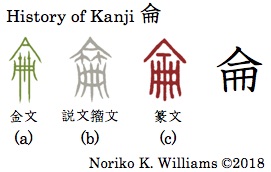 The third shape 侖 has the history shown on the right. (a), (b) and (c) had writing tablets that were linked with straps as a book rolled up for storage under a roof. From “bound writing tablets rolled up” 侖 signified “things in good order in a circular shape.”
The third shape 侖 has the history shown on the right. (a), (b) and (c) had writing tablets that were linked with straps as a book rolled up for storage under a roof. From “bound writing tablets rolled up” 侖 signified “things in good order in a circular shape.”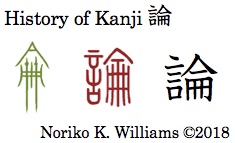 For the kanji 論 the bronze ware style writing was things in good order bound together in a circular shape (侖). The seal style writing comprised “word; language; to say” was added. Words that were arranged in good order meant “logic; argument.” The kanji 論 means “logic; argument.” <Composition of the kanji 論: 言 and 侖>
For the kanji 論 the bronze ware style writing was things in good order bound together in a circular shape (侖). The seal style writing comprised “word; language; to say” was added. Words that were arranged in good order meant “logic; argument.” The kanji 論 means “logic; argument.” <Composition of the kanji 論: 言 and 侖>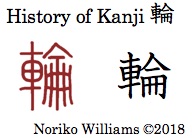 The seal style writing of the kanji 輪 comprised 車 “a wheel” and 侖 used phonetically for /rin/ to mean “many arrows arranged in a circular shape.” Together they meant “wheel; circle; loop.” <Composition of the kanji 輪: 車 and 侖>
The seal style writing of the kanji 輪 comprised 車 “a wheel” and 侖 used phonetically for /rin/ to mean “many arrows arranged in a circular shape.” Together they meant “wheel; circle; loop.” <Composition of the kanji 輪: 車 and 侖>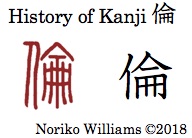 The seal style writing of the kanji 倫 had a “person; an act that one does” and 侖 used phoentically for /rin/ to mean “things ordered in good order.” Together “what a person should observe” means “ethics; principle.” The kanji 倫 means “ethics; principle.” <Composition of the kanji 倫: イ and 侖>
The seal style writing of the kanji 倫 had a “person; an act that one does” and 侖 used phoentically for /rin/ to mean “things ordered in good order.” Together “what a person should observe” means “ethics; principle.” The kanji 倫 means “ethics; principle.” <Composition of the kanji 倫: イ and 侖>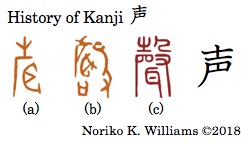 For the kanji 声 (a) in oracle bone style, in brown, was “a musical instrument with a hanging rope” and “an ear” below that. (b) and (c) in seal style, in red, had “a hand holding a stick to bang the hanging sound” board added. Together they meant “one listening to the sound of a hanging musical instrument that was banged by hand.” The kyuji 聲 in (d), in blue, contained all the components — “a banging instrument,” “a hand hitting with a tool” and “an ear to listen to.” But in the shinji 声only the top left was kept. Even though the origin was from an musical instrument and a person’s ear, it meant human “voice.” The kanji 声means “voice; fame; reputation; sound.”
For the kanji 声 (a) in oracle bone style, in brown, was “a musical instrument with a hanging rope” and “an ear” below that. (b) and (c) in seal style, in red, had “a hand holding a stick to bang the hanging sound” board added. Together they meant “one listening to the sound of a hanging musical instrument that was banged by hand.” The kyuji 聲 in (d), in blue, contained all the components — “a banging instrument,” “a hand hitting with a tool” and “an ear to listen to.” But in the shinji 声only the top left was kept. Even though the origin was from an musical instrument and a person’s ear, it meant human “voice.” The kanji 声means “voice; fame; reputation; sound.”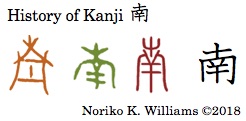 For the kanji 南 in oracle bone, bronze ware style, in green, and seal style it was a musical instrument called /nan/, which was hung with ropes at the top. The shape was similar to a hanging bell. The writing was borrowed to mean “south.” Some scholars suggested that the sound nanwas similar to dan 暖 “warm,” and it may have something to do with this choice. The kanji 南means “south.”
For the kanji 南 in oracle bone, bronze ware style, in green, and seal style it was a musical instrument called /nan/, which was hung with ropes at the top. The shape was similar to a hanging bell. The writing was borrowed to mean “south.” Some scholars suggested that the sound nanwas similar to dan 暖 “warm,” and it may have something to do with this choice. The kanji 南means “south.”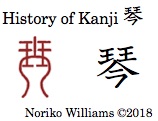 The seal style writing of the kanji 琴 was “a harp,” with a bowed body and bridges for strings. The kanji 琴 means “harp.”
The seal style writing of the kanji 琴 was “a harp,” with a bowed body and bridges for strings. The kanji 琴 means “harp.”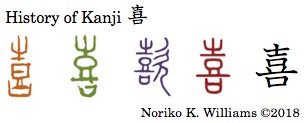 For the kanji 喜 the oracle bone style and bronze ware style writings had “a hand drum with a hanging device” at the top and 口 “a box of prayers and benedictions” at the bottom. They meant “pleasing a god with good drumming. The Old style writing, in purple, had a person who was singing or about to eat feast with his mouth wide open added but dropped in seal style. The kanji 喜 means “to rejoice; happy; be delighted.”
For the kanji 喜 the oracle bone style and bronze ware style writings had “a hand drum with a hanging device” at the top and 口 “a box of prayers and benedictions” at the bottom. They meant “pleasing a god with good drumming. The Old style writing, in purple, had a person who was singing or about to eat feast with his mouth wide open added but dropped in seal style. The kanji 喜 means “to rejoice; happy; be delighted.” For the kanji 樹 the bronze ware style writing, (a), comprised 壴 “a drum” and 寸 “hand” used phonetically for /chu; ju/ to mean “a tree; arbor.” (c) in seal style reflected (a), but in (b) 木 “tree” was added. “A hand holding a tree straight up” gave the meaning “to plant a tree” and “to establish” in a general sense. The kanji 樹 means “tree; to plant a tree; establish.”
For the kanji 樹 the bronze ware style writing, (a), comprised 壴 “a drum” and 寸 “hand” used phonetically for /chu; ju/ to mean “a tree; arbor.” (c) in seal style reflected (a), but in (b) 木 “tree” was added. “A hand holding a tree straight up” gave the meaning “to plant a tree” and “to establish” in a general sense. The kanji 樹 means “tree; to plant a tree; establish.”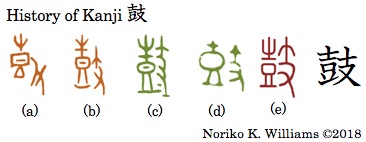 For the kanji 鼓(a) and (b) in oracle bone style and (c) and (d) in bronze ware style and (e) in seal style comprised “a drum with a hanging rope at the top” and “a hand hitting the drum with a drumstick.” Together they meant “a hand drum.” A hand hitting a drum gave the meaning “rhythemic; to stir up.” The kanji 鼓 means “a hand drum; to hit a drum; drum up.”
For the kanji 鼓(a) and (b) in oracle bone style and (c) and (d) in bronze ware style and (e) in seal style comprised “a drum with a hanging rope at the top” and “a hand hitting the drum with a drumstick.” Together they meant “a hand drum.” A hand hitting a drum gave the meaning “rhythemic; to stir up.” The kanji 鼓 means “a hand drum; to hit a drum; drum up.”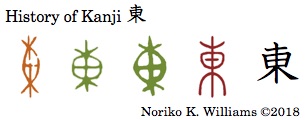 Any Japanese student knows the kanji 東 “east” because it is in the word Tokyo 東京 /tookyoo/. But the meaning “east” was a borrowing and had no relevance to its original meaning. In oracle bone style, in brown, and bronze ware style, in green, it was rolled stuff with a shaft going through that was tied on both ends and was wrapped around with a tie in the middle. In seal style, in red, it became more like the kanji 東. As a component it retained the meanings “through” and “rolled stuff,” but by itself it is used in the borrowed meaning “east.”
Any Japanese student knows the kanji 東 “east” because it is in the word Tokyo 東京 /tookyoo/. But the meaning “east” was a borrowing and had no relevance to its original meaning. In oracle bone style, in brown, and bronze ware style, in green, it was rolled stuff with a shaft going through that was tied on both ends and was wrapped around with a tie in the middle. In seal style, in red, it became more like the kanji 東. As a component it retained the meanings “through” and “rolled stuff,” but by itself it is used in the borrowed meaning “east.”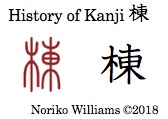 The seal style writing of the kanji 棟 comprised 木 “tree; wood” and 東 used phonetically for /too/ to mean “through.” A piece of wood that was placed across a house was “a ridgepole; ridge beam,” which is the highest part of a house where two sides of roof met. It was also used to mean “a house” and as a counter for houses. The kanji 棟 means “ridgepole; house; counter for houses.” [The composition of the kanji 棟: 木and 東]
The seal style writing of the kanji 棟 comprised 木 “tree; wood” and 東 used phonetically for /too/ to mean “through.” A piece of wood that was placed across a house was “a ridgepole; ridge beam,” which is the highest part of a house where two sides of roof met. It was also used to mean “a house” and as a counter for houses. The kanji 棟 means “ridgepole; house; counter for houses.” [The composition of the kanji 棟: 木and 東]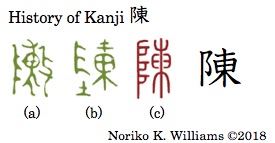 For the kanji 陳 (a) and (b) in bronze was style had “mounds of dirt; hills” (vertically placed) (阝) on the left and “rolled stuff tied on both ends and around” (東) signifying “a thing.” In addition to them, (a) had 攴“to cause an action; do something” whereas (b) had 土 “soil.” The sound /chin/ meant “to display.” Together they meant to display things on the ground or line up bags of dirt. When something in display was left for a long time, it became “old; stale.” In (c) in seal style neither 攴nor 土appeared. The kanji 陳 means “to line up; show; timeworn; outdated; old.” [The composition of the kanji 陳: 阝 and 東]
For the kanji 陳 (a) and (b) in bronze was style had “mounds of dirt; hills” (vertically placed) (阝) on the left and “rolled stuff tied on both ends and around” (東) signifying “a thing.” In addition to them, (a) had 攴“to cause an action; do something” whereas (b) had 土 “soil.” The sound /chin/ meant “to display.” Together they meant to display things on the ground or line up bags of dirt. When something in display was left for a long time, it became “old; stale.” In (c) in seal style neither 攴nor 土appeared. The kanji 陳 means “to line up; show; timeworn; outdated; old.” [The composition of the kanji 陳: 阝 and 東] The seal style writing of the kanji 凍 comprised “ice that has streaks” and 東 used phonetically for /too/ to mean “stuff tied” together signifying stuff freezing or a person freezing. It contrasts to the kanji 氷 “ice,” which was “water freezes; frozen ice.” The kanji 凍 means “to freeze; be numb with cold; be chilled to the bone.” [The composition of the kanji 凍: 冫and 東]
The seal style writing of the kanji 凍 comprised “ice that has streaks” and 東 used phonetically for /too/ to mean “stuff tied” together signifying stuff freezing or a person freezing. It contrasts to the kanji 氷 “ice,” which was “water freezes; frozen ice.” The kanji 凍 means “to freeze; be numb with cold; be chilled to the bone.” [The composition of the kanji 凍: 冫and 東]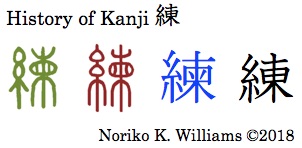 In bronze ware style and seal style the kanji 練 had “a skein of threads” (糸) on the left side. The right side 柬 used phonetically for /ren/was “bundle of threads inside a rolled bag tied on both ends and around to be softened.” Softening threads involved repeated steps of exposing them to direct sunlight and soaking them in water at night. From repeating a process of refining materials, it meant “knead; train.” The kyuji 練, in blue, retained 柬, but in the shinji 練 the right side 柬 became 東.The kanji 練 means “to refine; knead; train hard.” [The composition of the kanji 練: 糸 and 東]
In bronze ware style and seal style the kanji 練 had “a skein of threads” (糸) on the left side. The right side 柬 used phonetically for /ren/was “bundle of threads inside a rolled bag tied on both ends and around to be softened.” Softening threads involved repeated steps of exposing them to direct sunlight and soaking them in water at night. From repeating a process of refining materials, it meant “knead; train.” The kyuji 練, in blue, retained 柬, but in the shinji 練 the right side 柬 became 東.The kanji 練 means “to refine; knead; train hard.” [The composition of the kanji 練: 糸 and 東]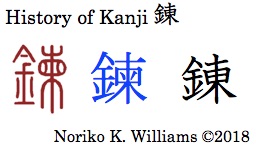 The kanji 錬 comprised 金 “metal” and 柬 “to refine; knead” used phonetically for /ren/. Together they meant “heating iron in a high temperature and remove the impure minerals.” The kyuji 鍊 retained 柬. The kanji 錬 means “to refine metal; train hard.”
The kanji 錬 comprised 金 “metal” and 柬 “to refine; knead” used phonetically for /ren/. Together they meant “heating iron in a high temperature and remove the impure minerals.” The kyuji 鍊 retained 柬. The kanji 錬 means “to refine metal; train hard.”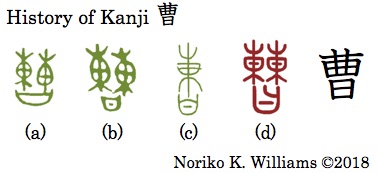 For the kanji 曹 in oracle bone style and bronze ware style the top had two pieces of stuff tied on both ends and around (東), signifying “two parties in a court – plaintiff and accused.” The bottom 曰 was “to speak.” (It is not 日 “the sun” but 曰 “to speak”). Together two parties standing to speak in court gave the meaning “companions; fellows.” It also meant “low-level officers; seargent.” The kanji 曹 means “low-level official; sergeant; fellows.”
For the kanji 曹 in oracle bone style and bronze ware style the top had two pieces of stuff tied on both ends and around (東), signifying “two parties in a court – plaintiff and accused.” The bottom 曰 was “to speak.” (It is not 日 “the sun” but 曰 “to speak”). Together two parties standing to speak in court gave the meaning “companions; fellows.” It also meant “low-level officers; seargent.” The kanji 曹 means “low-level official; sergeant; fellows.” The bronze ware style writing of the kanji 遭 was the same as 曹. The left side (辵) of the seal style writing had “a crossroad” and “a footstep,” together signifying “to move forward,” which eventually became a bushu shinnyooin kanji. The right side 曹 “fellows; companions” was also used phonetically for /soo/. “People meeting on their way unectectedly” meant “to encounter.” In kanji 遭 is associated with mishap such as “accident.” The kanji 遭 means “to encounter; meet by chance; mishap.” [The composition of the kanji 遭: 曹 and 辶]
The bronze ware style writing of the kanji 遭 was the same as 曹. The left side (辵) of the seal style writing had “a crossroad” and “a footstep,” together signifying “to move forward,” which eventually became a bushu shinnyooin kanji. The right side 曹 “fellows; companions” was also used phonetically for /soo/. “People meeting on their way unectectedly” meant “to encounter.” In kanji 遭 is associated with mishap such as “accident.” The kanji 遭 means “to encounter; meet by chance; mishap.” [The composition of the kanji 遭: 曹 and 辶]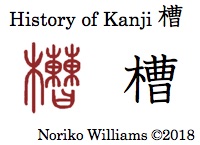 The seal style writing of the kanji 槽 comprised 木“tree; wood” and 曹 used phonetically for /soo/ to mean “tub” together signifying “a wooden tub.” The kanji 槽 means “tub; tank; vat.” [The composition of the kanji
The seal style writing of the kanji 槽 comprised 木“tree; wood” and 曹 used phonetically for /soo/ to mean “tub” together signifying “a wooden tub.” The kanji 槽 means “tub; tank; vat.” [The composition of the kanji  In the two earliest writing of kanji 量 also had rolled stuff tied on both ends and around signifying “stuff,” and a round shape at the top indicated an opening to put grains in to measure. Together they meant “a scale to weigh a bag of grain.” What was weighed meant “mass; amount.” An interesting thing was seen in Old style and seal style – they had土“dirt,” probably in a bag as a weight at the bottom, added. This combination of 東and 土will lead us to the next group of kanji starting with重“heavy” in the next post. In the kanji 量 the bottom took the shape 里. The kanji 量 means “mass; amount.” [The composition of the kanji 量: 曰, 一 and 里]
In the two earliest writing of kanji 量 also had rolled stuff tied on both ends and around signifying “stuff,” and a round shape at the top indicated an opening to put grains in to measure. Together they meant “a scale to weigh a bag of grain.” What was weighed meant “mass; amount.” An interesting thing was seen in Old style and seal style – they had土“dirt,” probably in a bag as a weight at the bottom, added. This combination of 東and 土will lead us to the next group of kanji starting with重“heavy” in the next post. In the kanji 量 the bottom took the shape 里. The kanji 量 means “mass; amount.” [The composition of the kanji 量: 曰, 一 and 里] For the kanji 糧 the bronze ware style writing is seen in other kanji such as 重 “heavy” and had “a tied bag” in the middle with “an opening” on top, which was 量 “a scale to measure grains.” The bottom was “rice.” Together they meant “food; provisions.” In seal style “rice” was moved to the left and became 米 a bushu komehenin kanji. The kanji 糧means “food; provisions.” [The composition of the kanji 糧: 米 and 量]
For the kanji 糧 the bronze ware style writing is seen in other kanji such as 重 “heavy” and had “a tied bag” in the middle with “an opening” on top, which was 量 “a scale to measure grains.” The bottom was “rice.” Together they meant “food; provisions.” In seal style “rice” was moved to the left and became 米 a bushu komehenin kanji. The kanji 糧means “food; provisions.” [The composition of the kanji 糧: 米 and 量]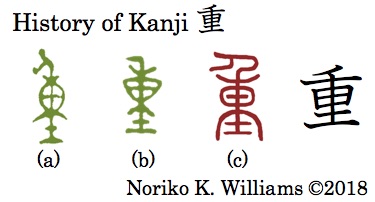 For the kanji 重 (a) in bronze ware style, in green, comprised “a person” at the top, “stuff wrapped in cloth tied around at both ends and in the middle with a shaft going through,” as in 東, and “soil” (土) signifying “weight” at the bottom. Together “a person standing on top of a heavy load stamping it down on the ground” meant “heavy.” Putting something over from the top also meant “to lay over; pile; repeat.” Something heavy should not be taken lightly and meant “important; previous.” The kanji 重 means “heavy; large; to treasure; to lay over.” [Composition of the kanji 重: ノ, 一 and 里 with the vertical line reaching ノ]
For the kanji 重 (a) in bronze ware style, in green, comprised “a person” at the top, “stuff wrapped in cloth tied around at both ends and in the middle with a shaft going through,” as in 東, and “soil” (土) signifying “weight” at the bottom. Together “a person standing on top of a heavy load stamping it down on the ground” meant “heavy.” Putting something over from the top also meant “to lay over; pile; repeat.” Something heavy should not be taken lightly and meant “important; previous.” The kanji 重 means “heavy; large; to treasure; to lay over.” [Composition of the kanji 重: ノ, 一 and 里 with the vertical line reaching ノ]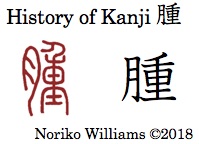 The seal style writing of the kanji 腫 comprised 月, a bushu nikuzuki “part of the body” and 重 used phonetically for /shu/ to mean something inside. The curved shape of tied stuff was applied to one’s body and meant “swelling; boil; tumor.” The kanji 腫 means “swelling; boil; tumor.” [Composition of the kanji 腫: 月 and 重]
The seal style writing of the kanji 腫 comprised 月, a bushu nikuzuki “part of the body” and 重 used phonetically for /shu/ to mean something inside. The curved shape of tied stuff was applied to one’s body and meant “swelling; boil; tumor.” The kanji 腫 means “swelling; boil; tumor.” [Composition of the kanji 腫: 月 and 重] For the kanji 種 in seal style (a) comprised 禾 “rice plant with crop” and 重 “heavy” used phonetically for /shu/. Grains that were full and heavy made good seeds and were kept for the next sowing. Seeds also differentiated plants. (The right side of (b) is the shape we look at in the next group.) The kanji 種 means “seed; kind; sort.” [Composition of the kanji 種: 禾 and 重]
For the kanji 種 in seal style (a) comprised 禾 “rice plant with crop” and 重 “heavy” used phonetically for /shu/. Grains that were full and heavy made good seeds and were kept for the next sowing. Seeds also differentiated plants. (The right side of (b) is the shape we look at in the next group.) The kanji 種 means “seed; kind; sort.” [Composition of the kanji 種: 禾 and 重]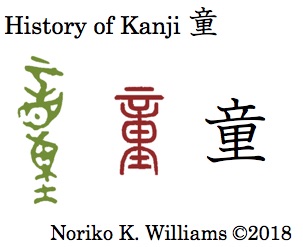 The bronze ware style writing of the kanji 童 was very long because it contained four separate components on top of another. The top had “a tattooing needle” (辛) and “an eye” (目), together signifying “a prisoner or slave who got tattooed above the eyes.” The bottom had “rolled stuff tied with a pole through” (東) and “dirt” (土), together making up 重 “heavy.” Altogether they signified “a prisoner or a slave who was made to do manual labor such as moving heavy dirt.” The meaning of punishment was dropped. Someone who was ignorant like a prisoner or slave meant “child.” The seal style writing dropped “an eye.” In kanji a needle became 立 and the bottom coalesced into 里 (no relation to the kanji 里). The kanji 童 means “young child.” [Composition of the kanji 童: 立 and 里]
The bronze ware style writing of the kanji 童 was very long because it contained four separate components on top of another. The top had “a tattooing needle” (辛) and “an eye” (目), together signifying “a prisoner or slave who got tattooed above the eyes.” The bottom had “rolled stuff tied with a pole through” (東) and “dirt” (土), together making up 重 “heavy.” Altogether they signified “a prisoner or a slave who was made to do manual labor such as moving heavy dirt.” The meaning of punishment was dropped. Someone who was ignorant like a prisoner or slave meant “child.” The seal style writing dropped “an eye.” In kanji a needle became 立 and the bottom coalesced into 里 (no relation to the kanji 里). The kanji 童 means “young child.” [Composition of the kanji 童: 立 and 里]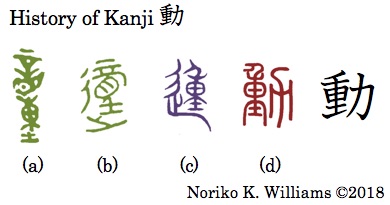 For the kanji 動 in bronze ware style (a) was the same as 童 “prisoner; slave” who moved heavy stuff. (b) had “a crossroad” on the left, 童 on the right and “a footprint” at the bottom. Together they meant “to move or push forward something heavy.” (c) in Old style a crossroad and a footprint became 辵, the precursor of a bushu shinnyoo, and 重. However, in (d) in seal style instead of 辵 力“a plough” was used to include strenuous work such as field work. The kanji 動 means “to move.” [Composition of the kanji 動: 重 and 力]
For the kanji 動 in bronze ware style (a) was the same as 童 “prisoner; slave” who moved heavy stuff. (b) had “a crossroad” on the left, 童 on the right and “a footprint” at the bottom. Together they meant “to move or push forward something heavy.” (c) in Old style a crossroad and a footprint became 辵, the precursor of a bushu shinnyoo, and 重. However, in (d) in seal style instead of 辵 力“a plough” was used to include strenuous work such as field work. The kanji 動 means “to move.” [Composition of the kanji 動: 重 and 力]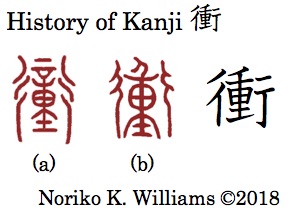 For the kanji 衝 the two seal style writings both had 行 “crossroad” signifying “to move forward.” Inside (a) was 童 used phonetically for /shoo/ to mean “to strike” while (b) had 重 used phonetically for /shoo/. The original meaning of a pole going through gave the meaning “to push something through.” Together “striking or to push something forward” meant “to collide; road.” The kanji 衝 means “to collide; crash.” [Composition of the kanji 衝: 彳, 重 and the right side of 行]
For the kanji 衝 the two seal style writings both had 行 “crossroad” signifying “to move forward.” Inside (a) was 童 used phonetically for /shoo/ to mean “to strike” while (b) had 重 used phonetically for /shoo/. The original meaning of a pole going through gave the meaning “to push something through.” Together “striking or to push something forward” meant “to collide; road.” The kanji 衝 means “to collide; crash.” [Composition of the kanji 衝: 彳, 重 and the right side of 行] For the kanji 鐘 (a), (b) and (c) comprised 金 “metal” and 童 used phonetically for shoo. It was a large bell for a festival and religious rite to strike with a stick. The kanji 鐘 means “a large bell.” [Composition of the kanji 鐘: 鐘 and 童]
For the kanji 鐘 (a), (b) and (c) comprised 金 “metal” and 童 used phonetically for shoo. It was a large bell for a festival and religious rite to strike with a stick. The kanji 鐘 means “a large bell.” [Composition of the kanji 鐘: 鐘 and 童]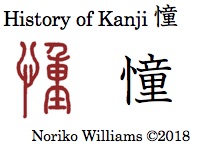 The seal style writing of the kanji 憧 comprised “a heart,” which became 忄, a bushu risshinben “heart” placed on the left side, and 童 used phonetically for /doo/. Together they meant “an unsettled heart.” It also means “to yearn after; admire.” The kanji 憧 means “unsettled; to yearn after; admire.”[Composition of the kanji 憧: 忄and 童]
The seal style writing of the kanji 憧 comprised “a heart,” which became 忄, a bushu risshinben “heart” placed on the left side, and 童 used phonetically for /doo/. Together they meant “an unsettled heart.” It also means “to yearn after; admire.” The kanji 憧 means “unsettled; to yearn after; admire.”[Composition of the kanji 憧: 忄and 童]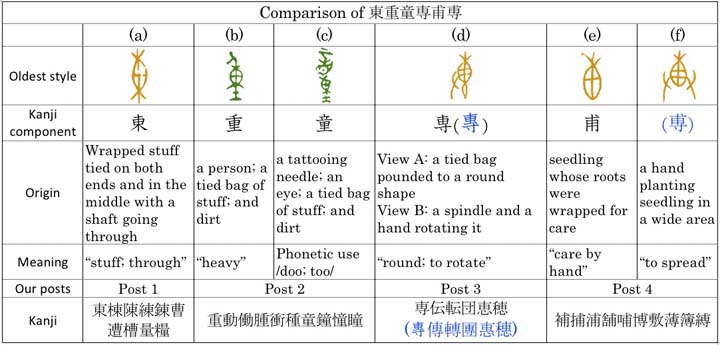
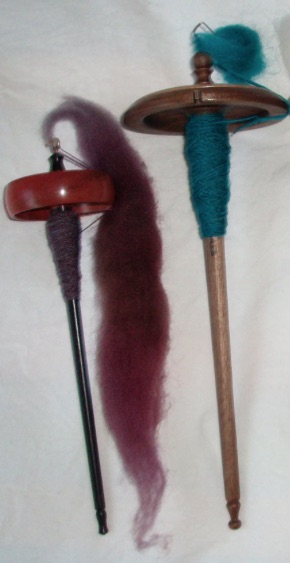 A spindle — What is a spindle 紡錘 /boosui/? “A spindle in weaving is a rod for spinning and winding natural fibers, consisting of a shaft and circular whorl at the end of the shaft.” I got this description a while ago (but do now remember from where now). The photo (taken from Wiki) is a modern version in which a whorl is at the top, unlike our ancient writing (d). I have also come across a video clip that shows the mechanism of a modern (Navaho drop spindle –
A spindle — What is a spindle 紡錘 /boosui/? “A spindle in weaving is a rod for spinning and winding natural fibers, consisting of a shaft and circular whorl at the end of the shaft.” I got this description a while ago (but do now remember from where now). The photo (taken from Wiki) is a modern version in which a whorl is at the top, unlike our ancient writing (d). I have also come across a video clip that shows the mechanism of a modern (Navaho drop spindle – 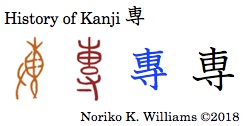 For the kanji 専, View A (by Shirakawa) takes the oracle bone style writing to be “a tied bag of stuff with the top opening tied that was pounded into a round shape by a hand,” signifying “to round; make a wad.” View B explains it as a spindle which had a whorl (weight attached at the bottom) and was turned by a hand, together signifying “to turn; rotate.” The two accounts viewed the source of “turning” differently but arrived at the same meaning “to rotate; round.” Multiple fibers converging into one forming a thread or yarn gave the meaning “solely; monopolize.” In seal style, in red, the hand at the bottom became寸. The kyuji 專, in blue, had the remnant of a small whorl in a spindle, but was dropped in the shinji 専. The kanji 専 means “solely; exclusively; entirely; to monopolize.” [The composition of the kanji 専: 十 and 曰 and 寸 (not the correct stroke order)]
For the kanji 専, View A (by Shirakawa) takes the oracle bone style writing to be “a tied bag of stuff with the top opening tied that was pounded into a round shape by a hand,” signifying “to round; make a wad.” View B explains it as a spindle which had a whorl (weight attached at the bottom) and was turned by a hand, together signifying “to turn; rotate.” The two accounts viewed the source of “turning” differently but arrived at the same meaning “to rotate; round.” Multiple fibers converging into one forming a thread or yarn gave the meaning “solely; monopolize.” In seal style, in red, the hand at the bottom became寸. The kyuji 專, in blue, had the remnant of a small whorl in a spindle, but was dropped in the shinji 専. The kanji 専 means “solely; exclusively; entirely; to monopolize.” [The composition of the kanji 専: 十 and 曰 and 寸 (not the correct stroke order)]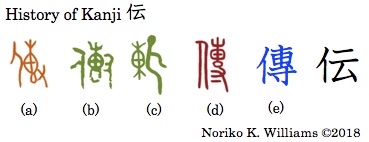 For the kanji 伝, (a) in oracle bone style and (b) and (c) in bronze ware style comprised “a person; an act that one does” (イ) and “a rolling motion” (專), also used phonetically for /den/. Together a person carrying on his back a load that rotated signified “to relay; hand down to another.” In the seal style (d) a hand “寸” returned, and the kyuji 傳 in (e), in blue. In the shinji 伝, the right side 專 was replaced by 云, one of the shapes used for simplification. The kanji 伝means “to relay; convey; hand down.” [The composition of the kanji 伝: イand 云]
For the kanji 伝, (a) in oracle bone style and (b) and (c) in bronze ware style comprised “a person; an act that one does” (イ) and “a rolling motion” (專), also used phonetically for /den/. Together a person carrying on his back a load that rotated signified “to relay; hand down to another.” In the seal style (d) a hand “寸” returned, and the kyuji 傳 in (e), in blue. In the shinji 伝, the right side 專 was replaced by 云, one of the shapes used for simplification. The kanji 伝means “to relay; convey; hand down.” [The composition of the kanji 伝: イand 云] For the kanji 転 in bronze ware style the top had “a vehicle with two wheels that were connected with a shaft with yokes or handles, signifying “to roll.” The bottom was “a rolling motion,” used phonetically for /ten/. Together they meant “to turn; roll.” Turning wheels of a vehicle transport something to a different place, and it also gave the meaning “to change to something else.” In seal style a vehicle was simplified to車. It meant “to roll over; fall; change.” The right side of the kyuji 轉, 專, was replaced by 云 in shinji style. The kanji 転 means “to roll; fall; change.” [The composition of the kanji 転: 車 and 云]
For the kanji 転 in bronze ware style the top had “a vehicle with two wheels that were connected with a shaft with yokes or handles, signifying “to roll.” The bottom was “a rolling motion,” used phonetically for /ten/. Together they meant “to turn; roll.” Turning wheels of a vehicle transport something to a different place, and it also gave the meaning “to change to something else.” In seal style a vehicle was simplified to車. It meant “to roll over; fall; change.” The right side of the kyuji 轉, 專, was replaced by 云 in shinji style. The kanji 転 means “to roll; fall; change.” [The composition of the kanji 転: 車 and 云]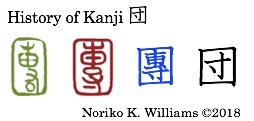 For the kanji 団the bronze ware style and seal style writings had 專, used phonetically for /dan/, inside 囗, a bushu kunigamae“enclosure.” A band of people also made a circle. From those, it meant “round” or “a group or band of people.” People sitting together in a circle also meant “harmony.” In shinji団, inside 囗, only the bottom half of 專, 寸“a hand,” is kept. The kanji 団 means “band; round; mellow; lump; mass.” [The composition of the kanji 団: 囗 and 寸 (the bottom line in 囗 comes last)]
For the kanji 団the bronze ware style and seal style writings had 專, used phonetically for /dan/, inside 囗, a bushu kunigamae“enclosure.” A band of people also made a circle. From those, it meant “round” or “a group or band of people.” People sitting together in a circle also meant “harmony.” In shinji団, inside 囗, only the bottom half of 專, 寸“a hand,” is kept. The kanji 団 means “band; round; mellow; lump; mass.” [The composition of the kanji 団: 囗 and 寸 (the bottom line in 囗 comes last)] The kanji 恵 had appeared in a many variations in the history. (a) in oracle bone style was a spindle, same as 専without a hand. (b) and (c) in bronze ware style can be viewed just variations of (a), and was used phonetically for /kee/. Something that rotated signified “all around; fullness.” In (d) and (e) “a heart” was added at the bottom. Together a heart that was full covering all around signified “generous and kind,” and it also meant “to bless; to give something in charity; be merciful.” The top of the kyuji 惠 in (h) was the same as the kanji 伝転団 without 寸. The kanji 恵 means “blessing; bounty; to confer benefits on one.” [The composition of the kanji 恵: 十, 曰 (not in this stroke order) and 心]
The kanji 恵 had appeared in a many variations in the history. (a) in oracle bone style was a spindle, same as 専without a hand. (b) and (c) in bronze ware style can be viewed just variations of (a), and was used phonetically for /kee/. Something that rotated signified “all around; fullness.” In (d) and (e) “a heart” was added at the bottom. Together a heart that was full covering all around signified “generous and kind,” and it also meant “to bless; to give something in charity; be merciful.” The top of the kyuji 惠 in (h) was the same as the kanji 伝転団 without 寸. The kanji 恵 means “blessing; bounty; to confer benefits on one.” [The composition of the kanji 恵: 十, 曰 (not in this stroke order) and 心]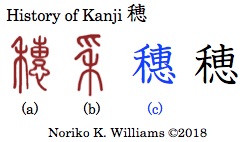 For the kanji 穂 in seal style (a) comprised 禾 “rice plant” and 惠 used phonetically for /sui/ to mean “hanging; drooping,” whereas (b) had “fingers from above” that were “picking up rice plant” whose tip was drooping with its own weight. They meant “ear or spear of rice plant.” As with other kanji that had 惠 in its kyuji, the kyuji 穗 was simplified to 穂. The kanji 穂 means “ear or spear of rice plants.” The two seal style writings (a) and (b) differed so much. (a) was a semantic-phonetic composite while b) was a semantic composite (会意文字/ kaii-mo’ji/). Personally since I am interested in how a shape formed the meaning, I find (b) make more sense, but the history chose (a). [The composition of the kanji 穂: 禾 and 恵]
For the kanji 穂 in seal style (a) comprised 禾 “rice plant” and 惠 used phonetically for /sui/ to mean “hanging; drooping,” whereas (b) had “fingers from above” that were “picking up rice plant” whose tip was drooping with its own weight. They meant “ear or spear of rice plant.” As with other kanji that had 惠 in its kyuji, the kyuji 穗 was simplified to 穂. The kanji 穂 means “ear or spear of rice plants.” The two seal style writings (a) and (b) differed so much. (a) was a semantic-phonetic composite while b) was a semantic composite (会意文字/ kaii-mo’ji/). Personally since I am interested in how a shape formed the meaning, I find (b) make more sense, but the history chose (a). [The composition of the kanji 穂: 禾 and 恵]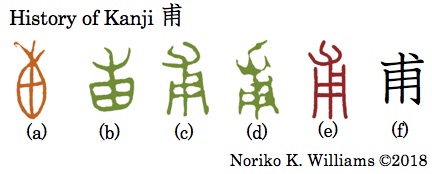 The shape 甫 “to protect” — It was a young plant whose roots were wrapped for protection in a net. Another view is that it was nursery of rice plant seedlings, giving the meaning “to spread.” It was used phonetically for /ho/. 甫 by itself is not used as kanji but it is a component of the kanji 補捕浦舗哺.
The shape 甫 “to protect” — It was a young plant whose roots were wrapped for protection in a net. Another view is that it was nursery of rice plant seedlings, giving the meaning “to spread.” It was used phonetically for /ho/. 甫 by itself is not used as kanji but it is a component of the kanji 補捕浦舗哺.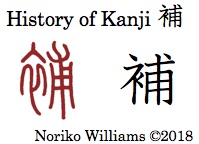 For the kanji 補 the seal style writing comprised 衣 “clothes” and 甫 “a young plant whose roots were wrapped around” or “rice plant nursery” used phonetically for /ho/, together signifying “mending a hole in clothes.” The meaning was extended for more general use. In kanji “clothes” (衣) became 衤, a bushu koromohen“clothes.” The kanji 補 means “to fill a gap; supplement; compensate.” [The composition of the kanji 補: 衤 and 甫]
For the kanji 補 the seal style writing comprised 衣 “clothes” and 甫 “a young plant whose roots were wrapped around” or “rice plant nursery” used phonetically for /ho/, together signifying “mending a hole in clothes.” The meaning was extended for more general use. In kanji “clothes” (衣) became 衤, a bushu koromohen“clothes.” The kanji 補 means “to fill a gap; supplement; compensate.” [The composition of the kanji 補: 衤 and 甫]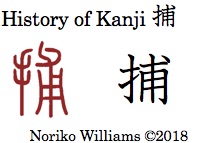 For the kanji 捕 the seal style writing comprised “hand; an act one does using a hand” (扌, a bushu tehen in kanji) and “roots of a young plant wrapped well” (甫) used phonetically for /ho/ to mean “to grab.” Together they signified “grabbing something by hand firmly.” The kanji 捕 means “to catch; seize.” [The composition of the kanji 捕: 扌 and 甫]
For the kanji 捕 the seal style writing comprised “hand; an act one does using a hand” (扌, a bushu tehen in kanji) and “roots of a young plant wrapped well” (甫) used phonetically for /ho/ to mean “to grab.” Together they signified “grabbing something by hand firmly.” The kanji 捕 means “to catch; seize.” [The composition of the kanji 捕: 扌 and 甫]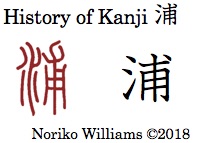 The seal style writing of the kanji 浦 comprised “water” (氵) and 甫 “to spread” used phonetically for /ho/, together signifying “a wide area along water.” The kanji 浦 means “creek; inlet; bay; seashore.” [The composition of the kanji 浦: 氵 and 甫]
The seal style writing of the kanji 浦 comprised “water” (氵) and 甫 “to spread” used phonetically for /ho/, together signifying “a wide area along water.” The kanji 浦 means “creek; inlet; bay; seashore.” [The composition of the kanji 浦: 氵 and 甫]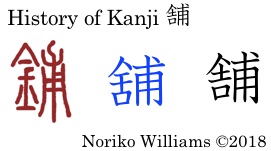 For the kanji 舗 the seal writing comprised 金 “metal” and 甫 used phonetically for /ho/, together signifying “a metal piece that was used on a door lock or handle.” Later it meant “shop,” and 金changed to 舍 “house.” The kyuji 舖, in blue, The component 舍changed to 舎 in the shinji, as was the case with other kanji that contained it. The kanji 舗 means “shop.” [The composition of the kanji 舗: 舎 and 甫]
For the kanji 舗 the seal writing comprised 金 “metal” and 甫 used phonetically for /ho/, together signifying “a metal piece that was used on a door lock or handle.” Later it meant “shop,” and 金changed to 舍 “house.” The kyuji 舖, in blue, The component 舍changed to 舎 in the shinji, as was the case with other kanji that contained it. The kanji 舗 means “shop.” [The composition of the kanji 舗: 舎 and 甫]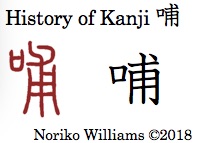 The seal style writing of the kanji comprised 口 “mouth,” and 甫 used phonetically for /ho/ to mean “to catch,” together meaning a parent bird giving food to its chick’s mouth” and “to chew in the mouth.” The kanji 哺 means “to take in one’s mouth.” [The composition of the kanji 哺: 口 and 甫]
The seal style writing of the kanji comprised 口 “mouth,” and 甫 used phonetically for /ho/ to mean “to catch,” together meaning a parent bird giving food to its chick’s mouth” and “to chew in the mouth.” The kanji 哺 means “to take in one’s mouth.” [The composition of the kanji 哺: 口 and 甫]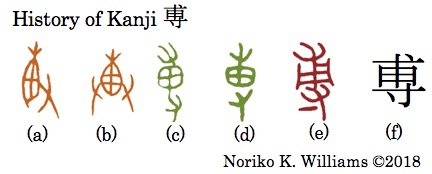 By adding a hand below 甫, the shape 尃 in the kyuji style, signified “a hand planting seedlings” or “nursery.” It meant “to spread” and further “wide.” The kanji are 博敷薄簿縛.
By adding a hand below 甫, the shape 尃 in the kyuji style, signified “a hand planting seedlings” or “nursery.” It meant “to spread” and further “wide.” The kanji are 博敷薄簿縛.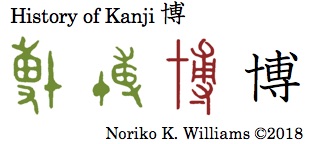 For the kanji 博 the bronze ware style writings comprised 尃 “young plant with its roots protected by a hand” used phonetically for /hu; haku/ and 十 “gathering many things into one,” together signifying “planting young seedlings in a wide area” or more generally “spreading; wide.” Later the kanji 博 came to mean “breadth of knowledge.” The right side of the seal style writing still retained the image of the original meaning. The kanji 博 means “spreading; wide.” [The composition of the kanji 博: 十 and 一,曰,丨, a dot and 寸]
For the kanji 博 the bronze ware style writings comprised 尃 “young plant with its roots protected by a hand” used phonetically for /hu; haku/ and 十 “gathering many things into one,” together signifying “planting young seedlings in a wide area” or more generally “spreading; wide.” Later the kanji 博 came to mean “breadth of knowledge.” The right side of the seal style writing still retained the image of the original meaning. The kanji 博 means “spreading; wide.” [The composition of the kanji 博: 十 and 一,曰,丨, a dot and 寸]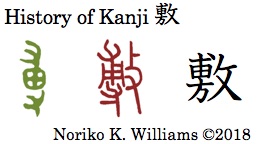 For the kanji 敷 the bronze ware style writing was “a young seedling (甫) with its roots protected” that was held by “a hand” (寸), and was used phonetically for /hu/. In seal style “a hand holding a stick” (攴, a bushu bokunyuu) was added to signify “an action.” Together they signified “to plant a seedling in the ground and level the ground” or “to lay spread.” In kanji the bottom left became 方 “four directions.” The kanji 敷 means “to spread out; stretch.” [The composition of the kanji 敷: 一, 曰, 丨, a dot, 方 and 攵]
For the kanji 敷 the bronze ware style writing was “a young seedling (甫) with its roots protected” that was held by “a hand” (寸), and was used phonetically for /hu/. In seal style “a hand holding a stick” (攴, a bushu bokunyuu) was added to signify “an action.” Together they signified “to plant a seedling in the ground and level the ground” or “to lay spread.” In kanji the bottom left became 方 “four directions.” The kanji 敷 means “to spread out; stretch.” [The composition of the kanji 敷: 一, 曰, 丨, a dot, 方 and 攵]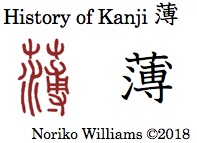 The seal style of the kanji 薄 comprised“plants” (艸), “water” (氵) and “wide; to spread flat” used phonetically for /haku/. Water or plants spread in a wide area made it thin. The kanji 薄 meant “thin; weak; watery.” [The composition of the kanji 薄: 艹, 氵and the right side of 博]
The seal style of the kanji 薄 comprised“plants” (艸), “water” (氵) and “wide; to spread flat” used phonetically for /haku/. Water or plants spread in a wide area made it thin. The kanji 薄 meant “thin; weak; watery.” [The composition of the kanji 薄: 艹, 氵and the right side of 博]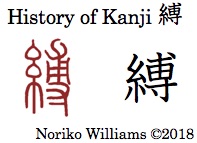 The seal style writing of the kanji 縛 comprised 糸 “skein of threads” and “a young seedling held in a hand” used phonetically for /baku/. Something constrained in one’s hand and bound in threads gave the meaning “to bind.” The kanji 縛 means “to restrain; bind.” [The composition of the kanji 縛: 糸 and the right side of 博]
The seal style writing of the kanji 縛 comprised 糸 “skein of threads” and “a young seedling held in a hand” used phonetically for /baku/. Something constrained in one’s hand and bound in threads gave the meaning “to bind.” The kanji 縛 means “to restrain; bind.” [The composition of the kanji 縛: 糸 and the right side of 博] For the kanji 束in (a) in oracle bone style, in brown, (b) and (c) in bronze ware style, in green, and (d) in seal style, in red, it was “a bundle of firewood tied around.” It meant “a bundle” or “things that were bound together.” In Japanese it also applies on time and means “a brief time.” The kanji 束 means “a bundle; to bind; a brief time.” [The composition of the kanji 束: 一, 口、丨 and two strokes like 八]
For the kanji 束in (a) in oracle bone style, in brown, (b) and (c) in bronze ware style, in green, and (d) in seal style, in red, it was “a bundle of firewood tied around.” It meant “a bundle” or “things that were bound together.” In Japanese it also applies on time and means “a brief time.” The kanji 束 means “a bundle; to bind; a brief time.” [The composition of the kanji 束: 一, 口、丨 and two strokes like 八] For the kanji 速 the bronze ware style writing had “stuff tied with a rope in the middle and at both ends” (after the last four posts we are now familiar with this shape as 東, aren’t we?) used phonetically for sokuto mean “quick; to rush.” The bottom had “a crossroad” and “a footprint,” which became 辵 in seal style, and further to 辶, a bushu shinnyoo “to go forward” in kanji. In seal style the tied stuff with strings around it was 束. Together they meant “fast.” The history of the kanji 速 having 東 and 束 suggests that it was likely that they were variations of things tied around. The kanji 速 means “fast; swift.” [The composition of the kanji 速: 束 and 辶]
For the kanji 速 the bronze ware style writing had “stuff tied with a rope in the middle and at both ends” (after the last four posts we are now familiar with this shape as 東, aren’t we?) used phonetically for sokuto mean “quick; to rush.” The bottom had “a crossroad” and “a footprint,” which became 辵 in seal style, and further to 辶, a bushu shinnyoo “to go forward” in kanji. In seal style the tied stuff with strings around it was 束. Together they meant “fast.” The history of the kanji 速 having 東 and 束 suggests that it was likely that they were variations of things tied around. The kanji 速 means “fast; swift.” [The composition of the kanji 速: 束 and 辶]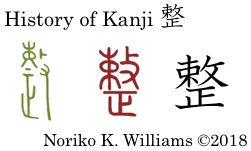 For the kanji 整 the left side of the bronze ware style writing had 束 “a bundle” and 正 “correct; just.” The right side had “a hand with a tool,” signifying “to cause something.” Together they signified “sorting things in bundles in good order.” In the seal style writing a hand holding a tool (攴) was shortened and became 敕 in the kanji. The kanji 整 means “to put in good order.” [The composition of the kanji 整: 束, 攵 and 正]
For the kanji 整 the left side of the bronze ware style writing had 束 “a bundle” and 正 “correct; just.” The right side had “a hand with a tool,” signifying “to cause something.” Together they signified “sorting things in bundles in good order.” In the seal style writing a hand holding a tool (攴) was shortened and became 敕 in the kanji. The kanji 整 means “to put in good order.” [The composition of the kanji 整: 束, 攵 and 正]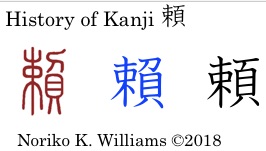 For the kanji 頼 the seal style writing comprised 束“a bundle” and 刀“a knife” and 貝 “a cowry; money” used phonetically for /rai; ra/ to mean “profit.” Together “a part of a bundle of valuable things was carved out with a knife” gave the meaning “extra profit.” Having extra fortune make one that others might “rely on.” The kyuji 賴, in blue, reflected the seal style writing. In the shinji 頼 the simplification of the right side resulted in an unrelated component 頁. The kanji 頼 means “dependable; to rely; request.” [The composition of the kanji 頼: 束and 頁]
For the kanji 頼 the seal style writing comprised 束“a bundle” and 刀“a knife” and 貝 “a cowry; money” used phonetically for /rai; ra/ to mean “profit.” Together “a part of a bundle of valuable things was carved out with a knife” gave the meaning “extra profit.” Having extra fortune make one that others might “rely on.” The kyuji 賴, in blue, reflected the seal style writing. In the shinji 頼 the simplification of the right side resulted in an unrelated component 頁. The kanji 頼 means “dependable; to rely; request.” [The composition of the kanji 頼: 束and 頁]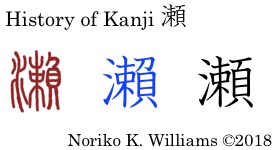 For the kanji 瀬 the seal style writing comprised “water” and 賴 used phonetically for rai. It was considered to be the sound of rapids in a river. Together they meant “rapids.” Rapids were in the shallows where banks made the water flow narrow. It also meant “one’s predicament; one’s narrow ground.” As in the case of 頼, the simplification of the right side brought in 頁. The kanji 瀬 means “rapids; one’s narrow ground.” [The composition of the kanji 瀬: 氵,束and頁]
For the kanji 瀬 the seal style writing comprised “water” and 賴 used phonetically for rai. It was considered to be the sound of rapids in a river. Together they meant “rapids.” Rapids were in the shallows where banks made the water flow narrow. It also meant “one’s predicament; one’s narrow ground.” As in the case of 頼, the simplification of the right side brought in 頁. The kanji 瀬 means “rapids; one’s narrow ground.” [The composition of the kanji 瀬: 氵,束and頁]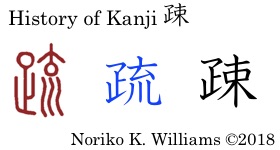 For the kanji 疎 the seal style writing (䟽) comprised “a leg” and “a fine-toothed comb,” as in 梳 “to comb; to untangle by separating hair.” In 疏, 2 in kyuji, the left side 疋 “leg” was used phonetically for sho. Together they meant “to go through between gaps” and meant “coarse; not close.” Not being close also gave the meaning “distant; to alienate“In kanji the right side was replaced by 束 “a bundle.” The kanji 疎 means “coarse; not close; distant; to alienate.”[The composition of the kanji 疎: a variation of 正 and 束]
For the kanji 疎 the seal style writing (䟽) comprised “a leg” and “a fine-toothed comb,” as in 梳 “to comb; to untangle by separating hair.” In 疏, 2 in kyuji, the left side 疋 “leg” was used phonetically for sho. Together they meant “to go through between gaps” and meant “coarse; not close.” Not being close also gave the meaning “distant; to alienate“In kanji the right side was replaced by 束 “a bundle.” The kanji 疎 means “coarse; not close; distant; to alienate.”[The composition of the kanji 疎: a variation of 正 and 束]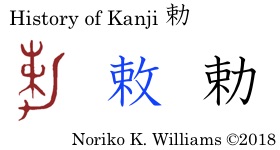 For the kanji 勅 the seal style writing had “a bundle” (束) and “a plough” (力) or “a hand.” Together they originally meant “to bundle things in good order.” The kyuji 敕 came to be used to mean “imperial edict.” Its informal kanji 勅 became the shinji. The kanji 勅 means “imperial edict.” [The composition of the kanji 勅: 束 and 力]
For the kanji 勅 the seal style writing had “a bundle” (束) and “a plough” (力) or “a hand.” Together they originally meant “to bundle things in good order.” The kyuji 敕 came to be used to mean “imperial edict.” Its informal kanji 勅 became the shinji. The kanji 勅 means “imperial edict.” [The composition of the kanji 勅: 束 and 力] or the kanji 必 in (a) and (b) in bronze ware style and (c) in seal style it was “a tool for straightening an arrow by tightening flush.” Something being tightly bound did not allow any move. From that it meant “without fail.” Having no other option also meant “inevitable,” and with a negative it means “not necessarily; not entirely.” The kanji 必 means “without fail; inevitable; (with negative) not necessarily.”
or the kanji 必 in (a) and (b) in bronze ware style and (c) in seal style it was “a tool for straightening an arrow by tightening flush.” Something being tightly bound did not allow any move. From that it meant “without fail.” Having no other option also meant “inevitable,” and with a negative it means “not necessarily; not entirely.” The kanji 必 means “without fail; inevitable; (with negative) not necessarily.”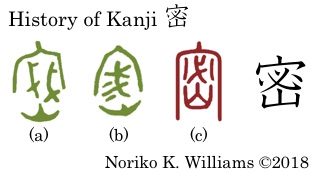 For the kanji 密 in (a) and (b) the top was “a tightly wrapped halberd inside a house or shrine,” and the bottom was a “fire.” A fire had a cleansing power in religious rite. From a rite that was conducted hidden inside meant “secret.” In (c) in seal style the bottom became a mountain, most likely miscopied from the original “a fire.” The kanji 密 means “secret; dense.” [The composition of the kanji 密: 宀, 必 and 山]
For the kanji 密 in (a) and (b) the top was “a tightly wrapped halberd inside a house or shrine,” and the bottom was a “fire.” A fire had a cleansing power in religious rite. From a rite that was conducted hidden inside meant “secret.” In (c) in seal style the bottom became a mountain, most likely miscopied from the original “a fire.” The kanji 密 means “secret; dense.” [The composition of the kanji 密: 宀, 必 and 山]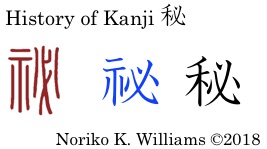 For the kanji 秘the seal style and the kyuji 祕comprised 示“an altar table with offering” and 必used phonetically for hito mean “secret.” Together they signified “a religious rite secretly performed” or “secret.” In the shinji 秘, 示was replaced by 禾, a bushu nogihen“rice plant” for a reason that was unclear. The kanji 秘means “secret; to hide.” [The composition of the kanji 秘:禾and 必]
For the kanji 秘the seal style and the kyuji 祕comprised 示“an altar table with offering” and 必used phonetically for hito mean “secret.” Together they signified “a religious rite secretly performed” or “secret.” In the shinji 秘, 示was replaced by 禾, a bushu nogihen“rice plant” for a reason that was unclear. The kanji 秘means “secret; to hide.” [The composition of the kanji 秘:禾and 必]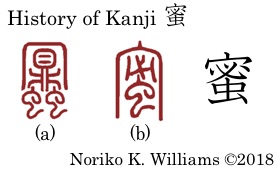 In seal style of the kanji 蜜 the top of (a) had “a tripod inside a house” and “two worms” signifying “bees.” Bees produced “honey,” which was kept in a pot. In (b) 貝was replaced by 必for /mitsu/. The kanji 蜜 means “honey; nector.” [The composition of the kanji 蜜: 宀, 必 and 虫]
In seal style of the kanji 蜜 the top of (a) had “a tripod inside a house” and “two worms” signifying “bees.” Bees produced “honey,” which was kept in a pot. In (b) 貝was replaced by 必for /mitsu/. The kanji 蜜 means “honey; nector.” [The composition of the kanji 蜜: 宀, 必 and 虫]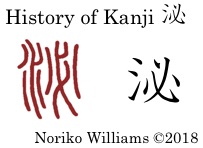 The seal style writing of the kanji 泌comprised “water” and 必used phonetically for hitsu. In the origin of 必things such as an arrow was bound tightly, leainvg little space in between. Together they meant “water running through a narrow path.” The sound was onomatopic. In Japan the kanji 泌is used to mean “to seep; ooze; run.” [The composition of the kanji 泌: 氵and 必]
The seal style writing of the kanji 泌comprised “water” and 必used phonetically for hitsu. In the origin of 必things such as an arrow was bound tightly, leainvg little space in between. Together they meant “water running through a narrow path.” The sound was onomatopic. In Japan the kanji 泌is used to mean “to seep; ooze; run.” [The composition of the kanji 泌: 氵and 必]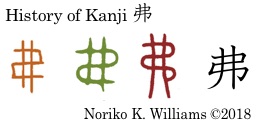 For the shape 弗 the history shown on the right in three different styles of ancient writing all had two bent lines and a rope around them. They signified that bent or crooked sticks were roped together in order to straighten, but the force of curling back was stronger and they would not stay straight and came apart. It meant “disperse” and it is used phonetically for /hutsu/ in kanji.
For the shape 弗 the history shown on the right in three different styles of ancient writing all had two bent lines and a rope around them. They signified that bent or crooked sticks were roped together in order to straighten, but the force of curling back was stronger and they would not stay straight and came apart. It meant “disperse” and it is used phonetically for /hutsu/ in kanji.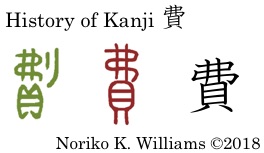 Forthe kanji 費 the bronze ware style writing, in green, comprised 弗 “to disperse” used phonetically for /hi/, 刂 “a knife” and 貝 “cowrie; money,” together signifying “to spend money.” In seal style, in red, the knife was dropped. It is also used for time, such as “spending time; wasting time.” Together they meant “cost; to spend money; require (time).” [Relating to this kanji, the top 弗 looks similar to the dollar sign $. So by itself it is customarily used to mean “dollar” in Japanese. [The composition of the kanji 費: 弗 and 貝]
Forthe kanji 費 the bronze ware style writing, in green, comprised 弗 “to disperse” used phonetically for /hi/, 刂 “a knife” and 貝 “cowrie; money,” together signifying “to spend money.” In seal style, in red, the knife was dropped. It is also used for time, such as “spending time; wasting time.” Together they meant “cost; to spend money; require (time).” [Relating to this kanji, the top 弗 looks similar to the dollar sign $. So by itself it is customarily used to mean “dollar” in Japanese. [The composition of the kanji 費: 弗 and 貝]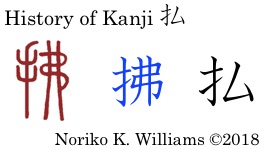 For the kanji 払t he seal style writing had “a hand; an act that one does using a hand” and 弗 “to come apart” used phonetically for /hutsu/. Together “a hand pushing something away” meant “to brush off.” It also meant “to pay money or attention.” The right side of the kyuji 拂, in blue, was simplified with ム, a segment often used for simplification in other kanji as well. The kanji 払 means “to pay money; pay attention; brush off.” [The composition of the kanji 払: 扌and ム]
For the kanji 払t he seal style writing had “a hand; an act that one does using a hand” and 弗 “to come apart” used phonetically for /hutsu/. Together “a hand pushing something away” meant “to brush off.” It also meant “to pay money or attention.” The right side of the kyuji 拂, in blue, was simplified with ム, a segment often used for simplification in other kanji as well. The kanji 払 means “to pay money; pay attention; brush off.” [The composition of the kanji 払: 扌and ム]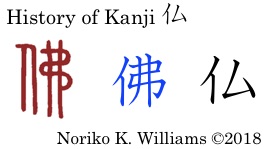 For the kanji 仏 the left side of the seal style writing was “a person; an act one does” and the right side (弗) was used phonetically for hutsu. When the Buddhism came to China from India, the Sanskrit word Buddha was written phonetically as 佛陀 Budda. The right side of the kyuji 佛 was replaced byム. Phonetically it is also used for 仏蘭西 “France” for having the first syllable /hu/. The kanji 仏 means “Buddha; Buddhism; France.” [The composition of the kanji 仏: イ and ム]
For the kanji 仏 the left side of the seal style writing was “a person; an act one does” and the right side (弗) was used phonetically for hutsu. When the Buddhism came to China from India, the Sanskrit word Buddha was written phonetically as 佛陀 Budda. The right side of the kyuji 佛 was replaced byム. Phonetically it is also used for 仏蘭西 “France” for having the first syllable /hu/. The kanji 仏 means “Buddha; Buddhism; France.” [The composition of the kanji 仏: イ and ム]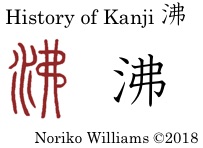 The seal style writing of the kanji 沸 comprised “water” and 弗 used phonetically for hutsuto mean “to boil.” (/Hutsu/ was the onomatopoeia of water boiling.) Together they meant water gushing out in a spring. Boiling water looks similar to a spring. It was used to mean “to boil.” The kanji 沸 means “to boil water; bubble up.” [The composition of the kanji 沸: 氵and 弗]
The seal style writing of the kanji 沸 comprised “water” and 弗 used phonetically for hutsuto mean “to boil.” (/Hutsu/ was the onomatopoeia of water boiling.) Together they meant water gushing out in a spring. Boiling water looks similar to a spring. It was used to mean “to boil.” The kanji 沸 means “to boil water; bubble up.” [The composition of the kanji 沸: 氵and 弗]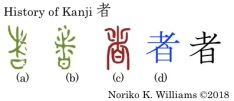 For the kanji 者 in (a), (b) and (c) twigs in a container or stove were being burned with sparkles of fire. From early times it was borrowed to mean “this; person.” The kyuji 者 (d) kept a dot in the middle as the remnant of sparkles of fire, but it was deleted in shinji. The kanji 者means “person.” (In modern use “this” as a demonstrative word is not used.” [The composition of the kanji 者: 耂 and 曰]
For the kanji 者 in (a), (b) and (c) twigs in a container or stove were being burned with sparkles of fire. From early times it was borrowed to mean “this; person.” The kyuji 者 (d) kept a dot in the middle as the remnant of sparkles of fire, but it was deleted in shinji. The kanji 者means “person.” (In modern use “this” as a demonstrative word is not used.” [The composition of the kanji 者: 耂 and 曰] There is no ancient writing for the kanji 着. (a) was an inscription on a stone stele and (b) was the Correct style writing 著. The kanji 着 was a variant of 著. In Japanese the two kanji have different use: 著 means “to author; stand out” whereas 着means “to attach; to put clothes on; wear; arrive (at a place).” [The composition of the kanji 着: 羊 without the vertical line going through, ノand 目]
There is no ancient writing for the kanji 着. (a) was an inscription on a stone stele and (b) was the Correct style writing 著. The kanji 着 was a variant of 著. In Japanese the two kanji have different use: 著 means “to author; stand out” whereas 着means “to attach; to put clothes on; wear; arrive (at a place).” [The composition of the kanji 着: 羊 without the vertical line going through, ノand 目]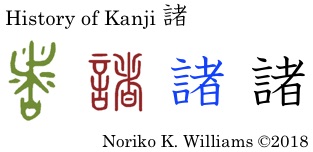 For the kanji 諸the bronze ware style writing was the same as 者. It was used phonetically for /sho/ to mean “many.” In 2 言 “word; language” was added. Together they meant “many words,” and also meant “many; various; all” in general. The kanji 諸 means “various; many; all.” [The composition of the kanji 諸: 言 and 者]
For the kanji 諸the bronze ware style writing was the same as 者. It was used phonetically for /sho/ to mean “many.” In 2 言 “word; language” was added. Together they meant “many words,” and also meant “many; various; all” in general. The kanji 諸 means “various; many; all.” [The composition of the kanji 諸: 言 and 者]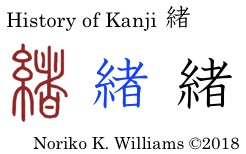 For the kanji 緒 the seal style writing comprised 糸 “a skein of threads” and 者 used phonetically for /sho/ to mean “beginning,” as in 初. Together they signified “the beginning of a long continuous thing, such as a string or rope.” A rope put things together and signified “together.” The kyuji 緖, 2, lost the dot in the middle in shinji. The kanji 緒 means “beginning; rope; string.” [The composition of the kanji 緒: 糸 and 者]
For the kanji 緒 the seal style writing comprised 糸 “a skein of threads” and 者 used phonetically for /sho/ to mean “beginning,” as in 初. Together they signified “the beginning of a long continuous thing, such as a string or rope.” A rope put things together and signified “together.” The kyuji 緖, 2, lost the dot in the middle in shinji. The kanji 緒 means “beginning; rope; string.” [The composition of the kanji 緒: 糸 and 者]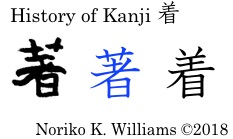 For the kanji 著 the seal style writing comprised 竹“bamboo” and 者 used phonetically for /sho; cho/. Bamboo stalks were versatile, and among them was the material for making a writing brush. It meant “to write a book.” In kyuji 著, 2, however, the bamboo top was replaced by 艹, a bushu kusakanmuri “plants.” It was also used to mean “to make meaning clear; to standout; conspicuous.” The kanji 著 means “to write a book; conspicuous; to stand out.” [The composition of the kanji 著: 艹 and 者]
For the kanji 著 the seal style writing comprised 竹“bamboo” and 者 used phonetically for /sho; cho/. Bamboo stalks were versatile, and among them was the material for making a writing brush. It meant “to write a book.” In kyuji 著, 2, however, the bamboo top was replaced by 艹, a bushu kusakanmuri “plants.” It was also used to mean “to make meaning clear; to standout; conspicuous.” The kanji 著 means “to write a book; conspicuous; to stand out.” [The composition of the kanji 著: 艹 and 者]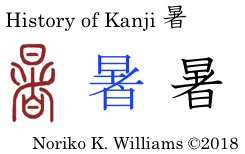 For the kanji 暑 in seal style “the sun” (日) was added to 者 “a bundle of wood sticks gathered in a stove to burn”used phonetically for /sho/. “The sun” and “burning fire” together made the kyuji 暑, 2, that meant “hot in atmospheric temperature.” The kanji 暑 means “(to feel) hot in atmospheric temperature.” [The composition of the kanji 暑: 日and 者]
For the kanji 暑 in seal style “the sun” (日) was added to 者 “a bundle of wood sticks gathered in a stove to burn”used phonetically for /sho/. “The sun” and “burning fire” together made the kyuji 暑, 2, that meant “hot in atmospheric temperature.” The kanji 暑 means “(to feel) hot in atmospheric temperature.” [The composition of the kanji 暑: 日and 者]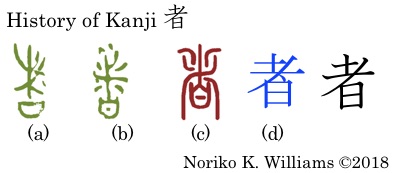 The history of the kanji 煮 intertwined with another kanji 庶. In (a) and (b) it had “a kitchen stove with a pot,” and was /sha/ phonetically. It would become the kanji 庶. It meant “to cook over a fire.” On the other hand the seal style writing (c) comprised “a stove with burning sticks” containing 者 at the top and “a storage tripod pot” at the bottom. Another seal style (d) would become 遮. The kyuji 煮 (e) comprised 者, with a dot, and 灬, a bushu rekka/renga “fire.” The kanji 煮 means “to cook over a fire; simmer; boil.” [The composition of the kanji 煮: 者 and 灬]
The history of the kanji 煮 intertwined with another kanji 庶. In (a) and (b) it had “a kitchen stove with a pot,” and was /sha/ phonetically. It would become the kanji 庶. It meant “to cook over a fire.” On the other hand the seal style writing (c) comprised “a stove with burning sticks” containing 者 at the top and “a storage tripod pot” at the bottom. Another seal style (d) would become 遮. The kyuji 煮 (e) comprised 者, with a dot, and 灬, a bushu rekka/renga “fire.” The kanji 煮 means “to cook over a fire; simmer; boil.” [The composition of the kanji 煮: 者 and 灬]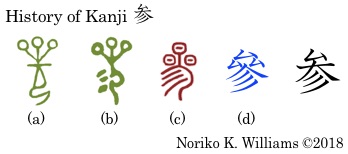 For the kanji 参 in bronze ware style, in green, (a) was “a kneeling woman with three shining hair-accessories while (b) had three lines which signified “bright reflections of light mingled each other” added. The mingling shines gave the meaning “to mingle; come.” The top of (c) in seal style, in red, had “three bright things” (日), and 彡 used phonetically for /san/. (d) in the kyuji 參, in blue,the three 日 became three ム shapes, which was further reduced to one ム in shinji. In Japan it is used for a humble style verb in 参 “to come; go,” and for a visit to a shrine, temple or cemetery. The kanji 参 means “to mingle; come; come/go in humble style.” [The composition of the kanji 参: ム, 一, 𠆢 and 彡]
For the kanji 参 in bronze ware style, in green, (a) was “a kneeling woman with three shining hair-accessories while (b) had three lines which signified “bright reflections of light mingled each other” added. The mingling shines gave the meaning “to mingle; come.” The top of (c) in seal style, in red, had “three bright things” (日), and 彡 used phonetically for /san/. (d) in the kyuji 參, in blue,the three 日 became three ム shapes, which was further reduced to one ム in shinji. In Japan it is used for a humble style verb in 参 “to come; go,” and for a visit to a shrine, temple or cemetery. The kanji 参 means “to mingle; come; come/go in humble style.” [The composition of the kanji 参: ム, 一, 𠆢 and 彡] The seal style writing of the kanji 診 had 言 “word; language” on the left. The right side had “a person” with 彡 “rash” used phonetically for /shin/ to mean “to check thoroughly.” The kanji 診 means “medical diagnose; examine.” [The composition of the kanji:言, 𠆢 and 彡]
The seal style writing of the kanji 診 had 言 “word; language” on the left. The right side had “a person” with 彡 “rash” used phonetically for /shin/ to mean “to check thoroughly.” The kanji 診 means “medical diagnose; examine.” [The composition of the kanji:言, 𠆢 and 彡]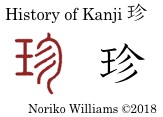 The seal style writing of the kanji 珍 comprised 王 “jewel” and “a person encircling something beautiful (彡)” used phonetically for /chin/. Together they meant “beautiful things such as jewels not being common.” The kanji 珍measn “rare; uncommon.” [The composition of the kanji : 王, 𠆢 and 彡]
The seal style writing of the kanji 珍 comprised 王 “jewel” and “a person encircling something beautiful (彡)” used phonetically for /chin/. Together they meant “beautiful things such as jewels not being common.” The kanji 珍measn “rare; uncommon.” [The composition of the kanji : 王, 𠆢 and 彡]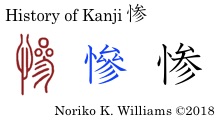 For the kanji 惨 the seal style writing had “a heart,” which became a bushu risshinbenin (忄) in the kyuji 慘. On the right side the shine 參 was used phonetically for /san/ to mean “to be impressed in one’s heart deeply.” Together they meant “one experiencing a deeply-felt emotion such as misery and cruelty.” The kanji 惨 means “to feel miserable; cruel.” [The composition of the kanji : 忄and 参]
For the kanji 惨 the seal style writing had “a heart,” which became a bushu risshinbenin (忄) in the kyuji 慘. On the right side the shine 參 was used phonetically for /san/ to mean “to be impressed in one’s heart deeply.” Together they meant “one experiencing a deeply-felt emotion such as misery and cruelty.” The kanji 惨 means “to feel miserable; cruel.” [The composition of the kanji : 忄and 参] For the kanji 乙 the writings in three anceint style were a bent shape on both ends. The shape was borrowed to mean “second; not the first” in combination of the kanji 甲 /ko’o/, which means “the first; good” and 丙 /he’e/ “third-rate: not good; poor.” [The composition of the kanji: a single stroke of 乙]
For the kanji 乙 the writings in three anceint style were a bent shape on both ends. The shape was borrowed to mean “second; not the first” in combination of the kanji 甲 /ko’o/, which means “the first; good” and 丙 /he’e/ “third-rate: not good; poor.” [The composition of the kanji: a single stroke of 乙]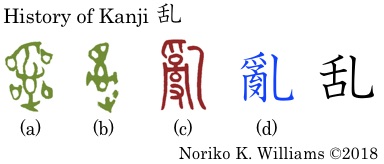 For the kanji 乱 (a) and (b) in bronze ware style may be better explained by the left side of (c) in seal style. It was a hand at the top and another hand at the bottom was straightening tangles threads on a spool in the middle. The right side was a bent shape that signified “to straighten.” Together they meant “hands trying to untangle threads to make them into a good order.” The kyuji 亂, (d), was replaced by drastically simpler 舌 in the shinji 乱. The kanji 乱 means “to be out of order; rebellion; battle.” [The composition of the kanji: 千, 口 and 乚]
For the kanji 乱 (a) and (b) in bronze ware style may be better explained by the left side of (c) in seal style. It was a hand at the top and another hand at the bottom was straightening tangles threads on a spool in the middle. The right side was a bent shape that signified “to straighten.” Together they meant “hands trying to untangle threads to make them into a good order.” The kyuji 亂, (d), was replaced by drastically simpler 舌 in the shinji 乱. The kanji 乱 means “to be out of order; rebellion; battle.” [The composition of the kanji: 千, 口 and 乚]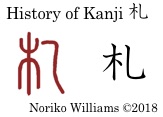 The seal style writing of the kanji 札 comprised 木 “wood” and 乚 “a bent shape that signified an act of flattening or straightening.” The writing meant “a thin flat piece of wood” such as a tag, a posted announcement and also paper money. The kanji 札means “a tag; name place; bank note.” [The composition of the kanji 札: 木 and 乚]
The seal style writing of the kanji 札 comprised 木 “wood” and 乚 “a bent shape that signified an act of flattening or straightening.” The writing meant “a thin flat piece of wood” such as a tag, a posted announcement and also paper money. The kanji 札means “a tag; name place; bank note.” [The composition of the kanji 札: 木 and 乚]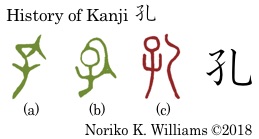 For the kanji 孔 (a) and (b) had “a child” on the left side. What the right side attached to the child’s head signified is clear, but many scholars view that it signified some sort of a hole. The kanji 孔 means “a hole; cavity.” [The composition of the kanji 孔: 子 and 乚]
For the kanji 孔 (a) and (b) had “a child” on the left side. What the right side attached to the child’s head signified is clear, but many scholars view that it signified some sort of a hole. The kanji 孔 means “a hole; cavity.” [The composition of the kanji 孔: 子 and 乚]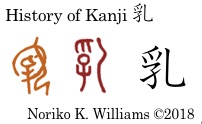 For the kanji 乳 in oracle bone style a woman on her knees was nursing or holding a child in her arms. It meant “to nurse; breast; milk.” In seal style it had “a hand from above” and “a child” on the left. For the right side (乚) there are different interpretations, including “a hand to care for a baby,” “a swallow,” which was believed to bring a baby, like a stork in Western folk tales, and “supporting an infant.” The kanji 乳 means “milk; milking; breast.” [The composition of the kanji 乳: 孚 and 乚]
For the kanji 乳 in oracle bone style a woman on her knees was nursing or holding a child in her arms. It meant “to nurse; breast; milk.” In seal style it had “a hand from above” and “a child” on the left. For the right side (乚) there are different interpretations, including “a hand to care for a baby,” “a swallow,” which was believed to bring a baby, like a stork in Western folk tales, and “supporting an infant.” The kanji 乳 means “milk; milking; breast.” [The composition of the kanji 乳: 孚 and 乚] For the kanji 凶 one view is that in the seal style writing, in red,the bottom凵was “a container that was empty.” Having no rice in the container signified “famine.” From that it meant “disaster; famine.” Another view is that the bottom (凵) was a chest. The inside shape was a tattooing on the deceased chest to prevent an evil to come near. It meant “misfortune; bad luck.”The kanji 凶 means “misfortune; disaster; bad luck.” [The composition of the kanji: メ and 凵]
For the kanji 凶 one view is that in the seal style writing, in red,the bottom凵was “a container that was empty.” Having no rice in the container signified “famine.” From that it meant “disaster; famine.” Another view is that the bottom (凵) was a chest. The inside shape was a tattooing on the deceased chest to prevent an evil to come near. It meant “misfortune; bad luck.”The kanji 凶 means “misfortune; disaster; bad luck.” [The composition of the kanji: メ and 凵]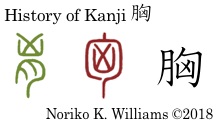 For the kanji 胸 the bronze ware style writing, in green, comprised “chest” (凶) used phonetically for kyooand “flesh; part of the body” (月), together signifying “a chest.” In seal style, 凶 was placed inside the shape 勹 “something that surrounds” or “a body bending over” without 月. In kanji 月returned to the left as the bushu nikuzuki. The kanji 胸 means “chest; bosom; mind.”
For the kanji 胸 the bronze ware style writing, in green, comprised “chest” (凶) used phonetically for kyooand “flesh; part of the body” (月), together signifying “a chest.” In seal style, 凶 was placed inside the shape 勹 “something that surrounds” or “a body bending over” without 月. In kanji 月returned to the left as the bushu nikuzuki. The kanji 胸 means “chest; bosom; mind.”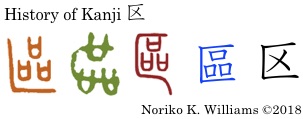 For the kanji 区 the oracle bone style writing, in light brown, had “three boxes (口) stashed away behind a screen.” A screen separated them from others or make smaller sections. It meant “to separate; divide; section.” In bronze ware style the boxes were linked together. In seal style and kyuji (區) three boxes remained, but in shinji they were replaced by a simplifying shape. In Japan in a larger city this is used in an address as /ku/ “ward.” The kanji 区means “to separate; divide; section; ward.” [The composition of the kanji: 凵 and メ]
For the kanji 区 the oracle bone style writing, in light brown, had “three boxes (口) stashed away behind a screen.” A screen separated them from others or make smaller sections. It meant “to separate; divide; section.” In bronze ware style the boxes were linked together. In seal style and kyuji (區) three boxes remained, but in shinji they were replaced by a simplifying shape. In Japan in a larger city this is used in an address as /ku/ “ward.” The kanji 区means “to separate; divide; section; ward.” [The composition of the kanji: 凵 and メ] For the kanji 枢 the seal style writing comprised 木 “tree; wood” and 區, which meant “something concealed.” A pivot to a wooden door” is not visible and yet it is important for the use of a door and it signified “essence; very important.” The kyuji 樞 reflected seal style, which was simplified to 枢 in the shinji. The kanji 枢 meant “pivot; center; essence.” A wooden box to cover the deceased is “coffin.” [The composition of the kanji: 木 and 区]
For the kanji 枢 the seal style writing comprised 木 “tree; wood” and 區, which meant “something concealed.” A pivot to a wooden door” is not visible and yet it is important for the use of a door and it signified “essence; very important.” The kyuji 樞 reflected seal style, which was simplified to 枢 in the shinji. The kanji 枢 meant “pivot; center; essence.” A wooden box to cover the deceased is “coffin.” [The composition of the kanji: 木 and 区]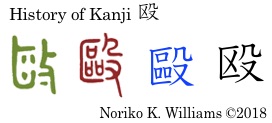 For the kanji 殴 the left side of the bronze ware style writing was used phonetically for /oo/, and the right side was “a hand holding a stick,” which would have become 攴 “to act; cause.” They meant “to hit.” In seal style a stick was replaced by weapon, forming 殳, a bushu hokozukuri“to strike.” The kyuji 毆 was replaced by the shinji 殴. The kanji 殴 means “to strike; assault; beat.” [The composition of the kanji: 匸,メ and 殳]
For the kanji 殴 the left side of the bronze ware style writing was used phonetically for /oo/, and the right side was “a hand holding a stick,” which would have become 攴 “to act; cause.” They meant “to hit.” In seal style a stick was replaced by weapon, forming 殳, a bushu hokozukuri“to strike.” The kyuji 毆 was replaced by the shinji 殴. The kanji 殴 means “to strike; assault; beat.” [The composition of the kanji: 匸,メ and 殳]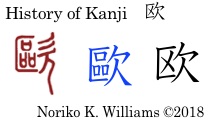 For the kanji 欧in seal style 區was used phonetically for /oo/ to mean “to groan; howl,” and the right side was “a person singing with his mouth open large.” Together they originally meant “to groan; howl.” It was used only phonetically to mean “Europe.” The kyuji 歐 reflected the seal style writing. The kanji 欧means “Europe; European.” [The composition of the kanji: 匸, メ and 欠]
For the kanji 欧in seal style 區was used phonetically for /oo/ to mean “to groan; howl,” and the right side was “a person singing with his mouth open large.” Together they originally meant “to groan; howl.” It was used only phonetically to mean “Europe.” The kyuji 歐 reflected the seal style writing. The kanji 欧means “Europe; European.” [The composition of the kanji: 匸, メ and 欠]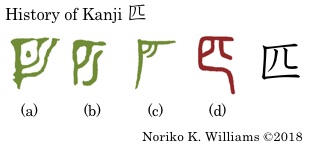 For the kanji 匹the origin is not clear. (a)(b) and (c) in bronze ware style all had the shape 厂 with a couple of curved lines underneath. Different accounts include “two pieces of cloth hanging down,” giving the meaning “to match,” and “horses bellies lining up.” The kanji 匹 is a counter of animal.[The composition of the kanji: 一, 儿 and an angle]
For the kanji 匹the origin is not clear. (a)(b) and (c) in bronze ware style all had the shape 厂 with a couple of curved lines underneath. Different accounts include “two pieces of cloth hanging down,” giving the meaning “to match,” and “horses bellies lining up.” The kanji 匹 is a counter of animal.[The composition of the kanji: 一, 儿 and an angle]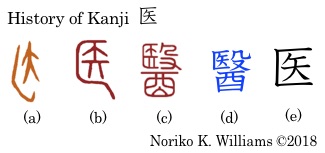 For the kanji 医, the two seal style writings, (b) and (c), were originally not related. (b) had its oracle bone style precursor (a), which had an arrow in a box that signified “to hide an arrow.” The other seal style writing (c) was more complex: It had 医 “a box of arrow,” 殳 “a hand holding a weapon or tool” together signifying “an injury caused by an arrow in battle.” The bottom 酉 was “a spirit jar” that signified “medicinal spirit.” Altogether “treating an injured person with medical spirit” meant “medicine.” The kyujitai (d) 醫 reflected (c). The shinjitai has retained “an arrow hidden in a box” only. The kanji 医 meant “medicine.” [The composition of the kanji: 凵 and 矢] (from the post on February 26, 2017)
For the kanji 医, the two seal style writings, (b) and (c), were originally not related. (b) had its oracle bone style precursor (a), which had an arrow in a box that signified “to hide an arrow.” The other seal style writing (c) was more complex: It had 医 “a box of arrow,” 殳 “a hand holding a weapon or tool” together signifying “an injury caused by an arrow in battle.” The bottom 酉 was “a spirit jar” that signified “medicinal spirit.” Altogether “treating an injured person with medical spirit” meant “medicine.” The kyujitai (d) 醫 reflected (c). The shinjitai has retained “an arrow hidden in a box” only. The kanji 医 meant “medicine.” [The composition of the kanji: 凵 and 矢] (from the post on February 26, 2017) For the kanji 匠, 斤 “an axe” was inside a box or container 匚. Together they meant “to make a craft work using an axe” or a person who made craft work using an axe. It also included someone who excelled in his art. [The composition of the kanji: 斤 and 凵] (from the post on November 27, 2016)
For the kanji 匠, 斤 “an axe” was inside a box or container 匚. Together they meant “to make a craft work using an axe” or a person who made craft work using an axe. It also included someone who excelled in his art. [The composition of the kanji: 斤 and 凵] (from the post on November 27, 2016)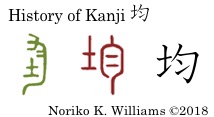 For the kanji 均 the bronze ware style writing, in green, had “a long arm with a hand at the top wrapping around two short lines of even length.” Inside was 土 “soil.” They signified that a person was trying “to make the ground even with his hand.” In the seal style writing, in red, the soil was moved out to the left. From “leveling the ground,” the kanji 均means “even; average.” [The composition of the kanji 均: 土へん, 勹 and 冫]
For the kanji 均 the bronze ware style writing, in green, had “a long arm with a hand at the top wrapping around two short lines of even length.” Inside was 土 “soil.” They signified that a person was trying “to make the ground even with his hand.” In the seal style writing, in red, the soil was moved out to the left. From “leveling the ground,” the kanji 均means “even; average.” [The composition of the kanji 均: 土へん, 勹 and 冫]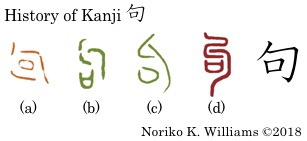 For the kanji 句 in (a) in oracle bone style, in brown, inside two hooks there was 口 “mouth.” They meant “speech that was enclosed.” In (b), (c) and (d) “speaking; words” was taken out of the two interlocking hooks. The kanji 句means “phrase.” [The composition of the kanji 句: 勹 and 口]
For the kanji 句 in (a) in oracle bone style, in brown, inside two hooks there was 口 “mouth.” They meant “speech that was enclosed.” In (b), (c) and (d) “speaking; words” was taken out of the two interlocking hooks. The kanji 句means “phrase.” [The composition of the kanji 句: 勹 and 口] The seal style writing of the kanji 拘 comprised “an act that one does using a hand” and 句 “something bent; crooked” used phonetically for /koo/. They signified “to seize (by hand); bind.” It also means the way in which one is particular about a certain thing. The kanji 拘 means “to seize; is particular about; adhere to.” [The composition of the kanji 拘:扌, 勹 and 口]
The seal style writing of the kanji 拘 comprised “an act that one does using a hand” and 句 “something bent; crooked” used phonetically for /koo/. They signified “to seize (by hand); bind.” It also means the way in which one is particular about a certain thing. The kanji 拘 means “to seize; is particular about; adhere to.” [The composition of the kanji 拘:扌, 勹 and 口] For the kanji 旬 the oracle bone style writing was a coiling shape with a short line crossing at the end, perhaps signifying “a cycle with its end marked.” The bronze ware style writing had “the sun” added inside a semi-circle that was similar to 勻. During the Yin (Shang) dynasty the calendar used then had a cycle of ten days. A rounded shape suggested “a cycle of ten days.” In seal style the two short lines inside 勻 dropped. The kanji 旬 means “ten days,” which is one third of a month. In Japan it is also used to mean produce and fish that is “in the season”- the best time to eat. [The composition of the kanji 旬: 勹 and 日]
For the kanji 旬 the oracle bone style writing was a coiling shape with a short line crossing at the end, perhaps signifying “a cycle with its end marked.” The bronze ware style writing had “the sun” added inside a semi-circle that was similar to 勻. During the Yin (Shang) dynasty the calendar used then had a cycle of ten days. A rounded shape suggested “a cycle of ten days.” In seal style the two short lines inside 勻 dropped. The kanji 旬 means “ten days,” which is one third of a month. In Japan it is also used to mean produce and fish that is “in the season”- the best time to eat. [The composition of the kanji 旬: 勹 and 日]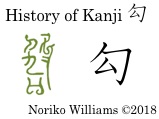 The bronze ware style writing looked incomprehensively complex. I cannot make out what this writing originally signified and there is no account in reference. The kanji 勾comprises 勹 “a hooked shape” or “a body bending down” and ム used phonetically for /koo/ to mean “to bend.” The kanji 勾 means “hook; to catch; hitch.” [The composition of the kanji 勾: 勹 and ム]
The bronze ware style writing looked incomprehensively complex. I cannot make out what this writing originally signified and there is no account in reference. The kanji 勾comprises 勹 “a hooked shape” or “a body bending down” and ム used phonetically for /koo/ to mean “to bend.” The kanji 勾 means “hook; to catch; hitch.” [The composition of the kanji 勾: 勹 and ム]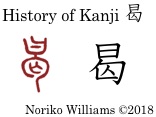 曷: The top was something coming out of a mouth, 曰 /etsu/, which meant “to say.” The bottom had a “person” (人) and a frame inside an semi enclosure 勹. The interpretations of this shape vary – (1) With “a box of prayers” on the top and “bones of a dead person” on the bottom together meant “praying so that the dead would grant a prayer’s wish” and 曷 was a voice of prayer (Shirakawa); (2) 曷 was “showing contempt and confining someone by a hand (勹)” (Kanjigen); and (3) it was used phonetically to meant “sound of scolding voice.”
曷: The top was something coming out of a mouth, 曰 /etsu/, which meant “to say.” The bottom had a “person” (人) and a frame inside an semi enclosure 勹. The interpretations of this shape vary – (1) With “a box of prayers” on the top and “bones of a dead person” on the bottom together meant “praying so that the dead would grant a prayer’s wish” and 曷 was a voice of prayer (Shirakawa); (2) 曷 was “showing contempt and confining someone by a hand (勹)” (Kanjigen); and (3) it was used phonetically to meant “sound of scolding voice.”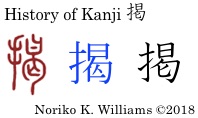 For the kanji 掲 the seal style writing comprised 扌 “an act that one does using a hand” and 曷 used phonetically for /kee/ to mean “to hoist.” Together a hand hoising something up means “to display; put up.” The kanji 掲 means “to display; hoist.” [The composition of the kanji 掲: 扌, 日and 匂]
For the kanji 掲 the seal style writing comprised 扌 “an act that one does using a hand” and 曷 used phonetically for /kee/ to mean “to hoist.” Together a hand hoising something up means “to display; put up.” The kanji 掲 means “to display; hoist.” [The composition of the kanji 掲: 扌, 日and 匂]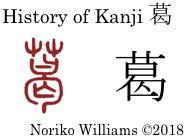 The seal style writing of the kanji 葛 comprised 艸 “plants” and 曷used phonetically for /katsu/. Together they meant “kuzuvine.” The fibers in the vine were used for weaving. Its root provides good starch for cooking. The kanji 葛 means “kuzu vine; kuzu root starch.” The kanji 葛 is the only Joyo kanji that retained the kyuji shape 曷, even though the kanji with 匂 at the bottom is seen as a popular informal shape. [The composition of the kanji 葛: 艹 and 曷]
The seal style writing of the kanji 葛 comprised 艸 “plants” and 曷used phonetically for /katsu/. Together they meant “kuzuvine.” The fibers in the vine were used for weaving. Its root provides good starch for cooking. The kanji 葛 means “kuzu vine; kuzu root starch.” The kanji 葛 is the only Joyo kanji that retained the kyuji shape 曷, even though the kanji with 匂 at the bottom is seen as a popular informal shape. [The composition of the kanji 葛: 艹 and 曷]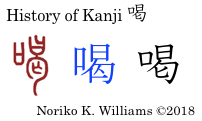 For the kani 喝 the seal style writing comprised 口 “mouth; to speak” and 曷 used phonetically for /katsu/ to mean “to scold in a loud voice.” The kanji 喝 meant “to shout; scold.” [The composition of the kanji 喝: 口, 日 and 匂]
For the kani 喝 the seal style writing comprised 口 “mouth; to speak” and 曷 used phonetically for /katsu/ to mean “to scold in a loud voice.” The kanji 喝 meant “to shout; scold.” [The composition of the kanji 喝: 口, 日 and 匂]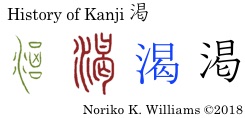 For the kanji 渇 the bronze ware style writing had “running water” on the left, and the right side was used phonetically for /katsu/ to mean “lack of.” The seal style writing had “a mouth open” (曰) and “a person disappearing” (亡) in 勹, but what those components meant is not clear. The kanji 渇 means “to be thirst; dry out; thirsty.” [The composition of the kanji 渇:氵, 日 and 匂]
For the kanji 渇 the bronze ware style writing had “running water” on the left, and the right side was used phonetically for /katsu/ to mean “lack of.” The seal style writing had “a mouth open” (曰) and “a person disappearing” (亡) in 勹, but what those components meant is not clear. The kanji 渇 means “to be thirst; dry out; thirsty.” [The composition of the kanji 渇:氵, 日 and 匂]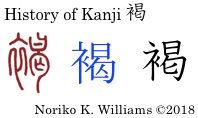 For the kanji 褐 the seal style writing comprised 衣 “clothes” and 曷 used phonetically for /katsu/ to mean “kuzu vine.” Clothes or footware made by weaving vines signified “humble simple clothes.” It also meant “brown” from the color of humble clothes dyed in dull color from vines and other plants. The kanji 褐 means “brown; (humble clothes).” [The composition of the kanji 褐: 衤, 日 and 匂]
For the kanji 褐 the seal style writing comprised 衣 “clothes” and 曷 used phonetically for /katsu/ to mean “kuzu vine.” Clothes or footware made by weaving vines signified “humble simple clothes.” It also meant “brown” from the color of humble clothes dyed in dull color from vines and other plants. The kanji 褐 means “brown; (humble clothes).” [The composition of the kanji 褐: 衤, 日 and 匂]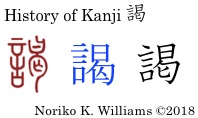 For the kanji 謁 the seal style writing comprised 言 “word; language; to say” and 曷 used phonetically for /etsu/. To say something to a ruler became the meaning “to be received in loyal audience.” [The composition of the kanji 謁: 言, 日 and 匂]
For the kanji 謁 the seal style writing comprised 言 “word; language; to say” and 曷 used phonetically for /etsu/. To say something to a ruler became the meaning “to be received in loyal audience.” [The composition of the kanji 謁: 言, 日 and 匂]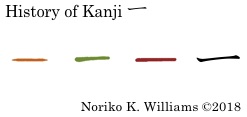 For the kanji 一a single bar was used to mean “one; single; only; first.” The kun-yomi /hito/ is in 一つ /hito’tsu/, 一人 “one person” /hito’ri/, 一人っ子 “only child” /hitori’kko/, 一人暮らし “living alone” /hitorigu’rashi/, 一息つく “to take a break” /hitoiki tsu’ku/. The on-yomi /ichi/ is in 一番 “first” /ichi’ban/ and “most” /ichiban/ and 一度 “once” /ichido/. Another on-yomi /itsu/ is in 均一 “uniform; even” /kin-itsu/, 統一する “to unify” /tooitsu-suru/, 同一 “the same; identical” /dooitsu/ and 一般的な “general; popular; common” /ippanteki-na/.
For the kanji 一a single bar was used to mean “one; single; only; first.” The kun-yomi /hito/ is in 一つ /hito’tsu/, 一人 “one person” /hito’ri/, 一人っ子 “only child” /hitori’kko/, 一人暮らし “living alone” /hitorigu’rashi/, 一息つく “to take a break” /hitoiki tsu’ku/. The on-yomi /ichi/ is in 一番 “first” /ichi’ban/ and “most” /ichiban/ and 一度 “once” /ichido/. Another on-yomi /itsu/ is in 均一 “uniform; even” /kin-itsu/, 統一する “to unify” /tooitsu-suru/, 同一 “the same; identical” /dooitsu/ and 一般的な “general; popular; common” /ippanteki-na/.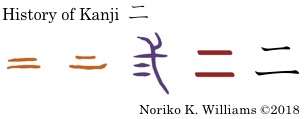 For the kanji 二, two bars placed side by side horizontally meant “two; double; second.“
For the kanji 二, two bars placed side by side horizontally meant “two; double; second.“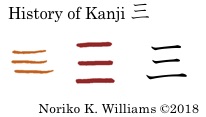 For the kanji 三, three bars placed horizontally meant “three; third.”
For the kanji 三, three bars placed horizontally meant “three; third.” For the kanji 四 four bars stacked up horizontally meant “four; all (directions).” Later on the shape 四was borrowed to mean “four.”
For the kanji 四 four bars stacked up horizontally meant “four; all (directions).” Later on the shape 四was borrowed to mean “four.”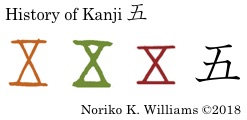 For the kanji 五the shape in which two sticks crossing with a bar at the top and the bottom was borrowed to mean “five.” Five divides ten equally so it also meant “equal.”
For the kanji 五the shape in which two sticks crossing with a bar at the top and the bottom was borrowed to mean “five.” Five divides ten equally so it also meant “equal.”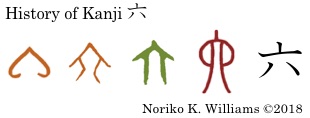 For the kanji 六the oracle bone style shape was the shape of a tent, but it is believed that the writing was never used for that meaning. Instead it was borrowed to mean “six.”
For the kanji 六the oracle bone style shape was the shape of a tent, but it is believed that the writing was never used for that meaning. Instead it was borrowed to mean “six.”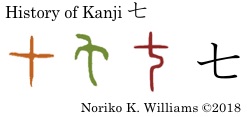 For the kanji 七, in oracle bone style, bronze ware style and seal style it was a bone being cut. But it was borrowed phonetically for /shichi/ to mean “seven.”
For the kanji 七, in oracle bone style, bronze ware style and seal style it was a bone being cut. But it was borrowed phonetically for /shichi/ to mean “seven.”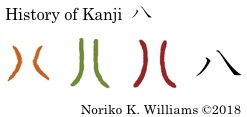 For the kanji 八it was the motion of splitting something into two. Eight is the multiples of two. It means “eight.”
For the kanji 八it was the motion of splitting something into two. Eight is the multiples of two. It means “eight.”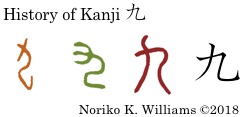 For the kanji 九 it was a bent elbow with fingers. One tried to thrust a hand into a hold to reach something but fell short of it. A number almost full but short of full is “nine.”
For the kanji 九 it was a bent elbow with fingers. One tried to thrust a hand into a hold to reach something but fell short of it. A number almost full but short of full is “nine.” For the kanji 十it was just a vertical line that had a thickness changing or a small dot added, signifying a bundle of ten. In seal style, the dot became a line. It meant “ten; full.”
For the kanji 十it was just a vertical line that had a thickness changing or a small dot added, signifying a bundle of ten. In seal style, the dot became a line. It meant “ten; full.”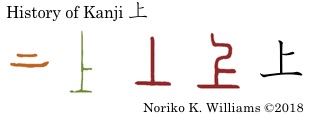 For the kanji 上 a spatial position above a line signified “above.” The kanji 上 means “top; above; to come up; superior; upper.”
For the kanji 上 a spatial position above a line signified “above.” The kanji 上 means “top; above; to come up; superior; upper.”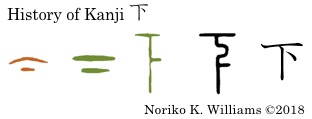 For the kanji 下a spatial position below a line signified “below.” The kanji 下means “bottom; below; to go down; lower; inferior.”
For the kanji 下a spatial position below a line signified “below.” The kanji 下means “bottom; below; to go down; lower; inferior.”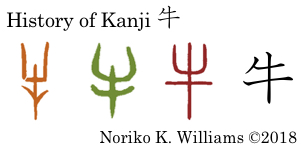 For the kanji 牛 in oracle bone style, in brown, bronze ware style, in green, and seal style, in red, the top was an ox head with its two horns growing upwards, and the bottom was its body. It meant “an ox; a cow.” In kanji a short-slanted stroke was added on the top left for an emphasis on the horns. The kanji 牛 means “cow; ox; cow.” [Composition of the kanji 牛: a short ノ, 二 and丨]
For the kanji 牛 in oracle bone style, in brown, bronze ware style, in green, and seal style, in red, the top was an ox head with its two horns growing upwards, and the bottom was its body. It meant “an ox; a cow.” In kanji a short-slanted stroke was added on the top left for an emphasis on the horns. The kanji 牛 means “cow; ox; cow.” [Composition of the kanji 牛: a short ノ, 二 and丨] For the kanji 物 there was an old view that the right side was streamers of different colors. Oxen had different coloration and signified “various or assorted.” From various things it meant “thing; stuff.” Another view (seen in Shirakawa) seems to explain the ancient writings here better. (a) was “a plough or hoe spattering the soil,” which was phonetically /butsu/. This eventually became the shape 勿 in kanji. In (b) and (c) “an ox,” a large animal, signifying all animals, was added. (d) had “a plough with spattering soil” only. (e) comprised “an ox” and “a plough.” Cows or oxen that pulled a plough for tilling the fields had different coloration, thus it meant “various or assorted.” Choosing from various things also signified “to select; make one’s choice.” The kanji 物 means “stuff; thing; various; to select.” [Composition of the kanji 物: 牛 and 勿]
For the kanji 物 there was an old view that the right side was streamers of different colors. Oxen had different coloration and signified “various or assorted.” From various things it meant “thing; stuff.” Another view (seen in Shirakawa) seems to explain the ancient writings here better. (a) was “a plough or hoe spattering the soil,” which was phonetically /butsu/. This eventually became the shape 勿 in kanji. In (b) and (c) “an ox,” a large animal, signifying all animals, was added. (d) had “a plough with spattering soil” only. (e) comprised “an ox” and “a plough.” Cows or oxen that pulled a plough for tilling the fields had different coloration, thus it meant “various or assorted.” Choosing from various things also signified “to select; make one’s choice.” The kanji 物 means “stuff; thing; various; to select.” [Composition of the kanji 物: 牛 and 勿] For the kanji 利 (a) comprised “a knife” or “a plough or hoe” and “a rice plant with crop.” (b), (c) and (d) comprised of “a rice plant” and “a plough or hoe spattering the soil.” A sharp pointed plough or hoe could dig up the soil effectively and be useful. It meant “useful; advantageous; sharp.” In (e) the plough or hoe became replaced by “a knife,” preserving the sense of a tool that was sharp. (On the other hand in 物 it became 勿.) In kanji it was replaced by 刂 a bushu rittoo “knife.” The kanji comprises 禾, a bushu nogihen, and刂 a bushu rittoo “knife.” The kanji 利 means “sharp; useful; advantageous.”
For the kanji 利 (a) comprised “a knife” or “a plough or hoe” and “a rice plant with crop.” (b), (c) and (d) comprised of “a rice plant” and “a plough or hoe spattering the soil.” A sharp pointed plough or hoe could dig up the soil effectively and be useful. It meant “useful; advantageous; sharp.” In (e) the plough or hoe became replaced by “a knife,” preserving the sense of a tool that was sharp. (On the other hand in 物 it became 勿.) In kanji it was replaced by 刂 a bushu rittoo “knife.” The kanji comprises 禾, a bushu nogihen, and刂 a bushu rittoo “knife.” The kanji 利 means “sharp; useful; advantageous.”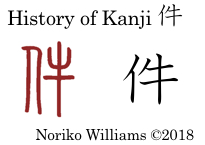 The seal style writing of the kanji 件 had イ “an act that a person does” and 牛 “an ox.” Together they signified “a person counting oxen in a herd” or “counting cases.” The kanji 件 means “case; matter.” [Composition of the kanji 件: イ and 牛]
The seal style writing of the kanji 件 had イ “an act that a person does” and 牛 “an ox.” Together they signified “a person counting oxen in a herd” or “counting cases.” The kanji 件 means “case; matter.” [Composition of the kanji 件: イ and 牛]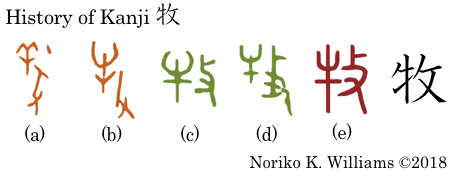 For the kanji 牧 at the top left (a) had “sheep” while (b), (c), (d) and (e) all had “ox.” (The direction of the horns differentiated the two animals.) The bottom in all was “a hand holding a stick to herd sheep or oxen” (攴攵, a bushu bokunyuu “to cause.”) Where animals grazed was “pasture.” The kanji 牧 means “to herd cattle; a place where cattle graze; pasture.” [Composition of the kanji 牧: 牛 and 攵]
For the kanji 牧 at the top left (a) had “sheep” while (b), (c), (d) and (e) all had “ox.” (The direction of the horns differentiated the two animals.) The bottom in all was “a hand holding a stick to herd sheep or oxen” (攴攵, a bushu bokunyuu “to cause.”) Where animals grazed was “pasture.” The kanji 牧 means “to herd cattle; a place where cattle graze; pasture.” [Composition of the kanji 牧: 牛 and 攵] For the kanji 牲 the oracle bone style writing comprised “a sheep” and “a new emerging plant” used phonetically for /see/ to mean “life.” Together they signified “live sheep that was offered to a god as a sacrificial animal.” From bronze ware style on, however “an ox” was used. An ox is a big animal, and a sacrificial ox was more valuable than a smaller animal. The kanji 牲 means “sacrifice; sacrificial animal.” [Composition of the kanji 牲: 牛 and 生]
For the kanji 牲 the oracle bone style writing comprised “a sheep” and “a new emerging plant” used phonetically for /see/ to mean “life.” Together they signified “live sheep that was offered to a god as a sacrificial animal.” From bronze ware style on, however “an ox” was used. An ox is a big animal, and a sacrificial ox was more valuable than a smaller animal. The kanji 牲 means “sacrifice; sacrificial animal.” [Composition of the kanji 牲: 牛 and 生] For the kanj 半 the top of bronze ware style and seal style writings was ハ “to divide something in half” used phonetically for /han/. The bottom was “an ox.” Together they signified an ox that was cut in half. In kanji ハ flipped upside down forming a sort of a truncated katakana ソ. The kanji 半 means “a half.” [Composition of the kanji 半: a truncated ソ,二 and丨]
For the kanj 半 the top of bronze ware style and seal style writings was ハ “to divide something in half” used phonetically for /han/. The bottom was “an ox.” Together they signified an ox that was cut in half. In kanji ハ flipped upside down forming a sort of a truncated katakana ソ. The kanji 半 means “a half.” [Composition of the kanji 半: a truncated ソ,二 and丨]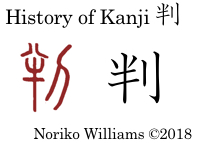 For the kanji 判 the seal style writing comprised 半 “half” used phonetically for /han/ and “a knife” adding the meaning dividing something in half. After signing a contract both parties took one half of the contract as proof. In a dispute of a contract, a judge decided which party was right. In kanji the knife became 刂, a bushu rittoo. The kanji 判means “a seal; to judge; discern.” [Composition of the kanji 判: 半 and 刂]
For the kanji 判 the seal style writing comprised 半 “half” used phonetically for /han/ and “a knife” adding the meaning dividing something in half. After signing a contract both parties took one half of the contract as proof. In a dispute of a contract, a judge decided which party was right. In kanji the knife became 刂, a bushu rittoo. The kanji 判means “a seal; to judge; discern.” [Composition of the kanji 判: 半 and 刂]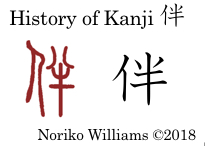 The seal style writing of the kanji 伴 comprised “an act that a person does,” which became イ, a bushu ninben in kanji, and 半 “half” used phonetically for /han/. They signified two people, each being a half of each other’s accompaniment. The kanji 伴 means “to accompany someone; companion.” [Composition of the kanji 伴: イ and 半]
The seal style writing of the kanji 伴 comprised “an act that a person does,” which became イ, a bushu ninben in kanji, and 半 “half” used phonetically for /han/. They signified two people, each being a half of each other’s accompaniment. The kanji 伴 means “to accompany someone; companion.” [Composition of the kanji 伴: イ and 半]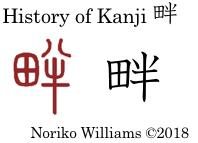 For the kanji 畔 the seal style writing comprised 田 “rice paddies” and 半 used phonetically for /han/ tomean “the side.” They meant the side or ridge of rice paddies, which was used for a walk path. It also meant “side.” The kanji 畔 means “a side; a ridge.” [Composition of the kanji 畔: 田 and 半]
For the kanji 畔 the seal style writing comprised 田 “rice paddies” and 半 used phonetically for /han/ tomean “the side.” They meant the side or ridge of rice paddies, which was used for a walk path. It also meant “side.” The kanji 畔 means “a side; a ridge.” [Composition of the kanji 畔: 田 and 半] There is no writing earlier than seal style in any of the three kanji that contain 弋. What it originated from is not clear, but it was used phonetically for /tai/ or /dai/ to mean “to change.” For the kanji 代, the seal style writing comprisedイ“an act that one does” and 弋 phonetically for tai or dai to mean “change,” together changing people meant “generations; to change.” The kanji 代 also meant “the duration of time; one’s lifetime; a substitute.” The kanji 代 means “to change; instead; time; generation; substitute.”
There is no writing earlier than seal style in any of the three kanji that contain 弋. What it originated from is not clear, but it was used phonetically for /tai/ or /dai/ to mean “to change.” For the kanji 代, the seal style writing comprisedイ“an act that one does” and 弋 phonetically for tai or dai to mean “change,” together changing people meant “generations; to change.” The kanji 代 also meant “the duration of time; one’s lifetime; a substitute.” The kanji 代 means “to change; instead; time; generation; substitute.”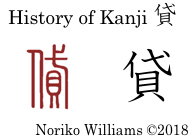 For the kanji 貸 the seal style writing comprised イ“an act that a person does” on the left and 弋 on the top right, forming 代 “to change” phonetically for tai. The bottom center was 貝“a cowrie; something valuable.” Together something valuable changing hands meant “to lend something to another person (and get it back).” The kanji 貸 means “to lend.”
For the kanji 貸 the seal style writing comprised イ“an act that a person does” on the left and 弋 on the top right, forming 代 “to change” phonetically for tai. The bottom center was 貝“a cowrie; something valuable.” Together something valuable changing hands meant “to lend something to another person (and get it back).” The kanji 貸 means “to lend.” The top of the seal style writing was 代used phonetically for tai. The bottom was 巾“cloth.” Together they signified “cloth bag.” In kanji 巾was replaced by 衣“clothes.” The kanji 袋means “bag.”
The top of the seal style writing was 代used phonetically for tai. The bottom was 巾“cloth.” Together they signified “cloth bag.” In kanji 巾was replaced by 衣“clothes.” The kanji 袋means “bag.”